Birds of Southern Africa in taxonomic hierarchy
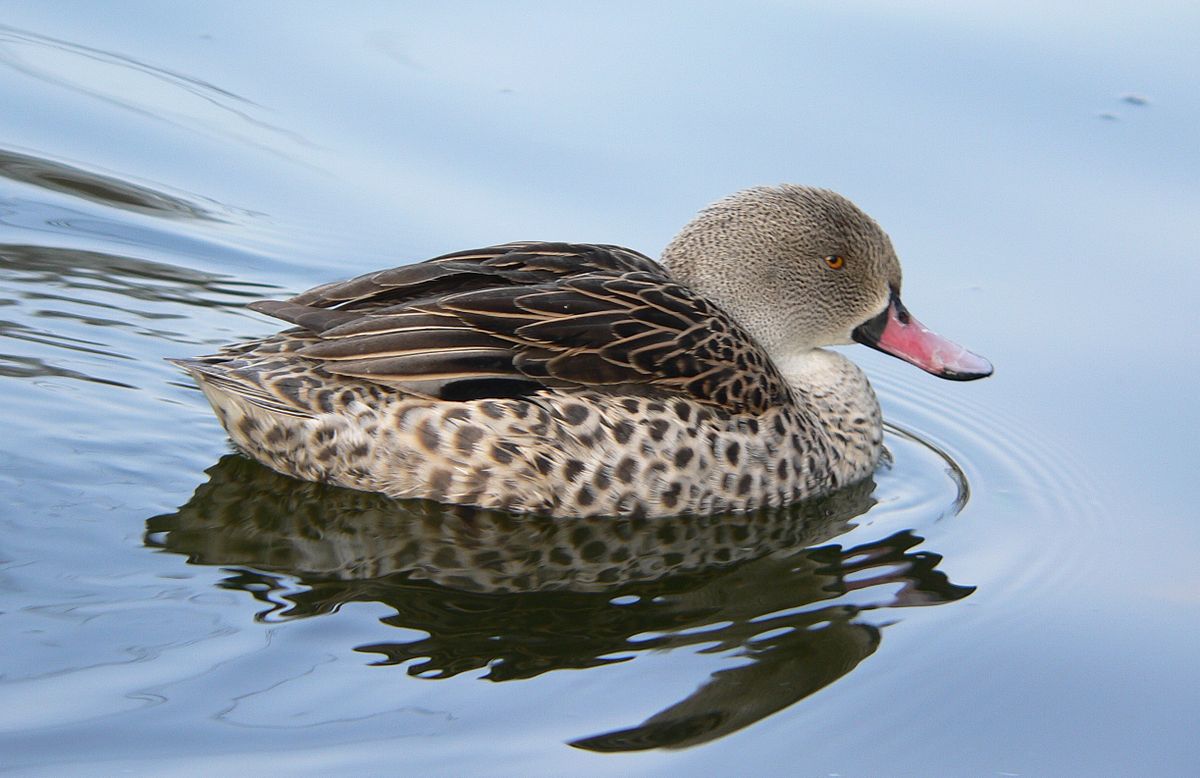
Wikipedia: Cape teal Source: OTHER
1200px-Kapente_schwimmend_Ausschnitt.jpg
General: ![]() The Cape teal (Anas capensis) is a 44–46 cm long dabbling duck of open wetlands in sub-Saharan Africa.
[more]
The Cape teal (Anas capensis) is a 44–46 cm long dabbling duck of open wetlands in sub-Saharan Africa.
[more]
Profile Wikipedia eBird Xeno-Canto

Wikipedia: Red-billed duck Source: OTHER
1200px-Red-billed_Pintail_%28Anas_erythrorhyncha%29_RWD1.jpg
![]() The red-billed teal or red-billed duck (Anas erythrorhyncha) is a dabbling duck which is an abundant resident breeder in southern and eastern Africa typically south of 10° S. This duck is not migratory, but will fly great distances to find suitable waters. It is highly gregarious outside the breeding season and forms large flocks.
[more]
The red-billed teal or red-billed duck (Anas erythrorhyncha) is a dabbling duck which is an abundant resident breeder in southern and eastern Africa typically south of 10° S. This duck is not migratory, but will fly great distances to find suitable waters. It is highly gregarious outside the breeding season and forms large flocks.
[more]
Profile Wikipedia eBird Xeno-Canto
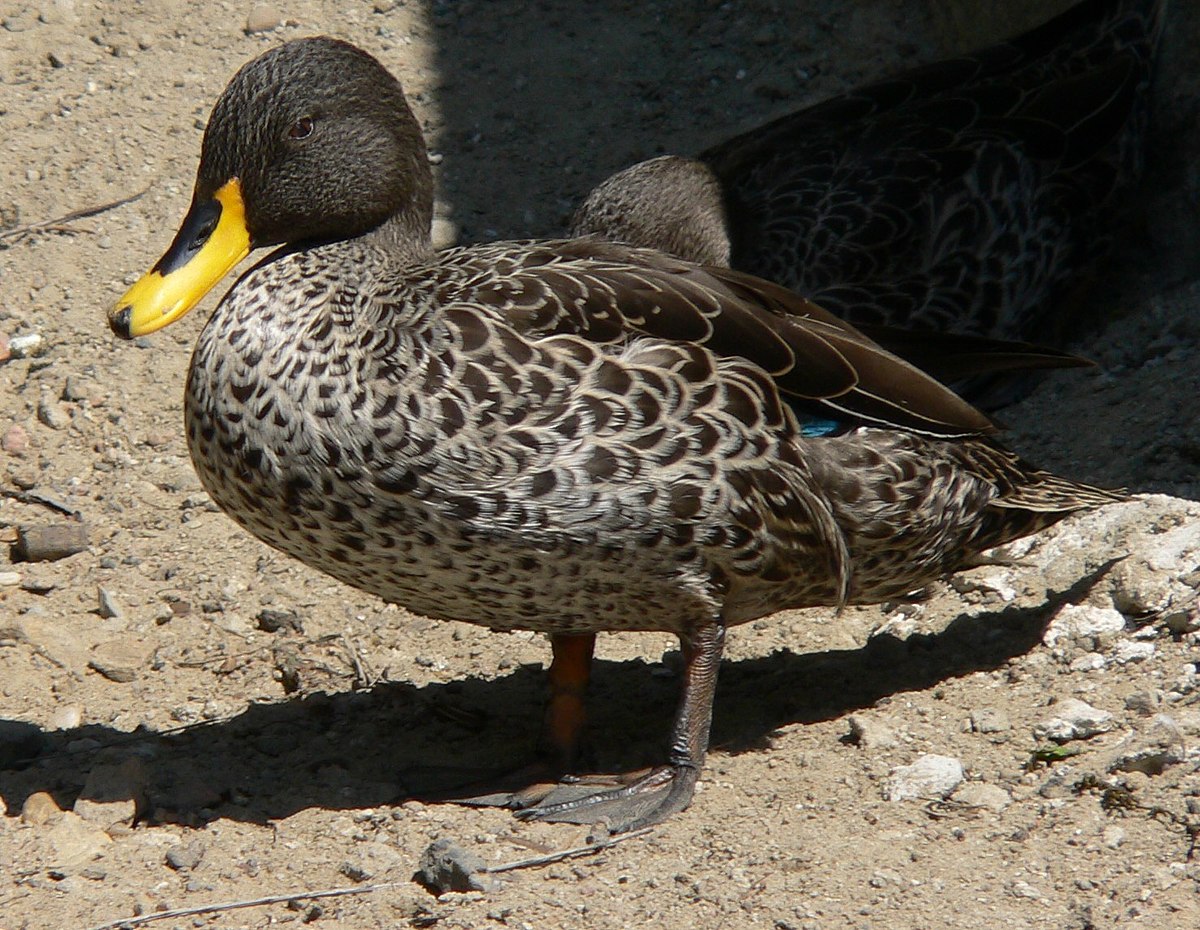
Wikipedia: Yellow-billed duck Source: OTHER
1200px-Gelbschnabelente_Anas_undulata_0505273_Wikiausschnitt.jpg
![]() The yellow-billed duck (Anas undulata) is a 51–58 cm long dabbling duck which is an abundant resident breeder in southern and eastern Africa.
[more]
The yellow-billed duck (Anas undulata) is a 51–58 cm long dabbling duck which is an abundant resident breeder in southern and eastern Africa.
[more]
Profile Wikipedia eBird Xeno-Canto

Wikipedia: African black duck Source: OTHER
African_Black_Duck.jpg
![]() The African black duck (Anas sparsa) is a species of duck of the genus Anas. It is genetically closest to the mallard group,[2] but shows some peculiarities in its behavior[3] and (as far as they can be discerned) plumage; it is accordingly placed in the subgenus Melananas pending further research.
[more]
The African black duck (Anas sparsa) is a species of duck of the genus Anas. It is genetically closest to the mallard group,[2] but shows some peculiarities in its behavior[3] and (as far as they can be discerned) plumage; it is accordingly placed in the subgenus Melananas pending further research.
[more]
Profile Wikipedia eBird Xeno-Canto

Wikipedia: Southern pochard Source: OTHER
1200px-Southern_Pochard_%28Netta_erythrophthalma%29_RWD1.jpg
This bird appears across the great seas in the following continents:
South America, Africa.
![]() The southern pochard (Netta erythrophthalma) is a species of duck, and a member of the genus Netta. There are two subspecies, the South American (southern) pochard N. e. erythrophthalma (Wied-Neuwied, 1833) and the African (southern) pochard N. e. brunnea (Eyton, 1838).
[more]
The southern pochard (Netta erythrophthalma) is a species of duck, and a member of the genus Netta. There are two subspecies, the South American (southern) pochard N. e. erythrophthalma (Wied-Neuwied, 1833) and the African (southern) pochard N. e. brunnea (Eyton, 1838).
[more]
Nilgans am Südende des Greifensee 2021-02-08 15.21.56
First observed in Botswana on 2016-09-24.
This bird appears across the great seas in the following continents:
Europe, North America, Africa.
Wintergast am Greifensee. Invasiv. Nach Vogelwarte.ch: 'als Ziervogel im 18. Jahrhundert in Europa eingeführt...
Ausgehend von einer in den 1970er Jahren in den Niederlanden und Belgien gebildeten Population breitete sich die Nilgans rasant dem Rhein und seinen Nebenflüssen entlang aus und hat inzwischen auch die Schweiz erreicht.
Vocalization: ![]() Quite vocal when interacting. [Link]
Quite vocal when interacting. [Link]
Calls: ![]() Female calls may resemble RS, but are coarser, harder and trills are more rolling. Single calls are longer, and falls markedly in pitch. Male calls quite different, with husky, wheezing or hissing "kaahhh", or with the same timbre in series lika a steam engine. [Link]
Female calls may resemble RS, but are coarser, harder and trills are more rolling. Single calls are longer, and falls markedly in pitch. Male calls quite different, with husky, wheezing or hissing "kaahhh", or with the same timbre in series lika a steam engine. [Link]
Physical details: length=63-73 cm,
wingspan=134-154 cm,
weight=1500-2250 g

Wikipedia: Knob-billed duck Source: OTHER
1200px-Knob-billed_duck_%28Sarkidiornis_melanotos%29_male.jpg
General: ![]() The knob-billed duck (Sarkidiornis melanotos), or African comb duck, is a duck found in tropical wetlands in Sub-Saharan Africa, Madagascar and the Indian Subcontinent from northern India to Laos and extreme southern China.
[more]
The knob-billed duck (Sarkidiornis melanotos), or African comb duck, is a duck found in tropical wetlands in Sub-Saharan Africa, Madagascar and the Indian Subcontinent from northern India to Laos and extreme southern China.
[more]
Profile Wikipedia eBird Xeno-Canto

Wikipedia: South African shelduck Source: OTHER
1200px-Tadorna_cana_-_01.jpg
![]() The South African shelduck or Cape shelduck (Tadorna cana) is a species of shelduck, a group of large goose-like birds which are part of the bird family Anatidae, which also includes the swans, geese and ducks. This is a common species native to southern Africa.[2]
[more]
The South African shelduck or Cape shelduck (Tadorna cana) is a species of shelduck, a group of large goose-like birds which are part of the bird family Anatidae, which also includes the swans, geese and ducks. This is a common species native to southern Africa.[2]
[more]
Profile Wikipedia eBird Xeno-Canto

Wikipedia: Maccoa duck Source: OTHER
1200px-Oxyura_maccoa.jpg
![]() The Maccoa duck (Oxyura maccoa) is a stiff-tailed diving duck found across Eastern and Southern Africa.[4]
[more]
The Maccoa duck (Oxyura maccoa) is a stiff-tailed diving duck found across Eastern and Southern Africa.[4]
[more]
Hottentot teal / Pünktchenente (Spatula hottentota)
Profile Wikipedia eBird Xeno-Canto

Wikipedia: Hottentot teal Source: OTHER
1200px-Anatra_ottentotta_%28Zurich_zoo%29.jpeg
![]() The blue-billed teal, spotted teal or Hottentot teal (Spatula hottentota) is a species of dabbling duck of the genus Spatula. It is migratory resident in eastern and southern Africa, from Sudan and Ethiopia west to Niger and Nigeria and south to South Africa and Namibia.[1][2] In west Africa and Madagascar it is sedentary.
[more]
The blue-billed teal, spotted teal or Hottentot teal (Spatula hottentota) is a species of dabbling duck of the genus Spatula. It is migratory resident in eastern and southern Africa, from Sudan and Ethiopia west to Niger and Nigeria and south to South Africa and Namibia.[1][2] In west Africa and Madagascar it is sedentary.
[more]
Cape shoveler / Kap-Löffelente (Spatula smithii)
Profile Wikipedia eBird Xeno-Canto

Wikipedia: Cape shoveler Source: OTHER
1200px-Cape_Shoveler_RWD.jpg
![]() The Cape shoveler or Cape shoveller (Spatula smithii) is a species of dabbling duck of the genus Spatula. It is resident in South Africa, and uncommon further north in Namibia, Botswana, Zimbabwe, southern Angola, Lesotho, Mozambique, and Zambia.[1][2]
[more]
The Cape shoveler or Cape shoveller (Spatula smithii) is a species of dabbling duck of the genus Spatula. It is resident in South Africa, and uncommon further north in Namibia, Botswana, Zimbabwe, southern Angola, Lesotho, Mozambique, and Zambia.[1][2]
[more]

Wikipedia: Fulvous whistling-duck Source: OTHER
1200px-Dendrocygna_bicolor_wilhelma.jpg
This bird appears across the great seas in the following continents:
North America, South America, Africa.
![]() The fulvous whistling duck or fulvous tree duck (Dendrocygna bicolor) is a species of whistling duck that breeds across the world's tropical regions in much of Mexico and South America, the West Indies, the southern United States, sub-Saharan Africa and the Indian subcontinent. It has plumage that is mainly reddish brown, long legs and a long grey bill, and shows a distinctive white band across its black tail in flight. Like other members of its ancient lineage, it has a whistling call which is given in flight or on the ground. Its preferred habitat consists of wetlands with plentiful vegetation, including shallow lakes and paddy fields.
The nest, built from plant material and unlined, is placed among dense vegetation or in a tree hole. The typical clutch is around ten whitish eggs. The breeding adults, which pair for life, take turns to incubate, and the eggs hatch in 24–29 days. The downy grey ducklings leave the nest within a day or so of hatching, but the parents continue to protect them until they fledge around nine weeks later.
[more]
The fulvous whistling duck or fulvous tree duck (Dendrocygna bicolor) is a species of whistling duck that breeds across the world's tropical regions in much of Mexico and South America, the West Indies, the southern United States, sub-Saharan Africa and the Indian subcontinent. It has plumage that is mainly reddish brown, long legs and a long grey bill, and shows a distinctive white band across its black tail in flight. Like other members of its ancient lineage, it has a whistling call which is given in flight or on the ground. Its preferred habitat consists of wetlands with plentiful vegetation, including shallow lakes and paddy fields.
The nest, built from plant material and unlined, is placed among dense vegetation or in a tree hole. The typical clutch is around ten whitish eggs. The breeding adults, which pair for life, take turns to incubate, and the eggs hatch in 24–29 days. The downy grey ducklings leave the nest within a day or so of hatching, but the parents continue to protect them until they fledge around nine weeks later.
[more]
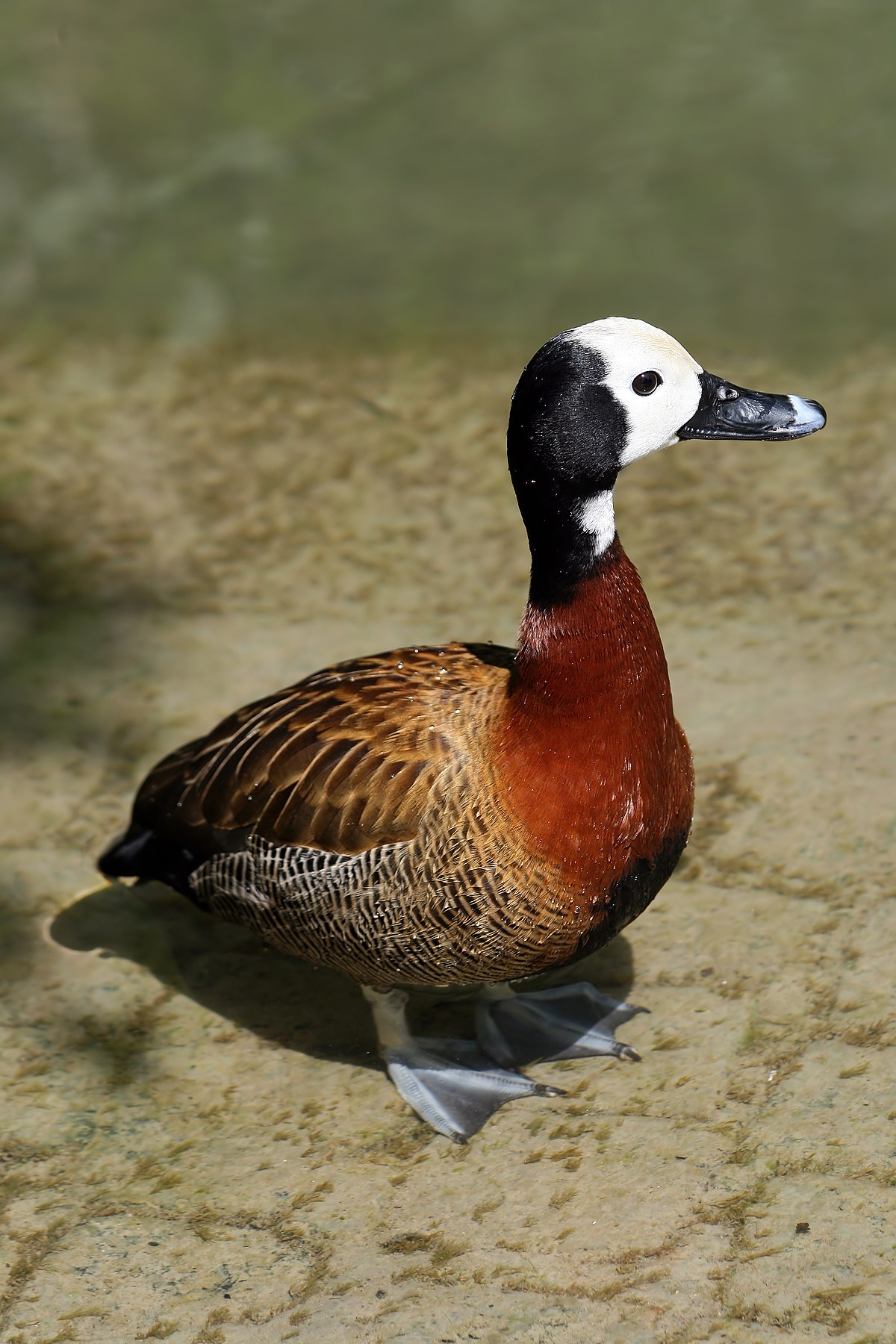
Wikipedia: White-faced whistling-duck Source: OTHER
1200px-Dendrocygna_viduata_upright.jpg
This bird appears across the great seas in the following continents:
South America, Africa.
![]() Anas viduata Linnaeus, 1766
[more]
Anas viduata Linnaeus, 1766
[more]
Profile Wikipedia eBird Xeno-Canto
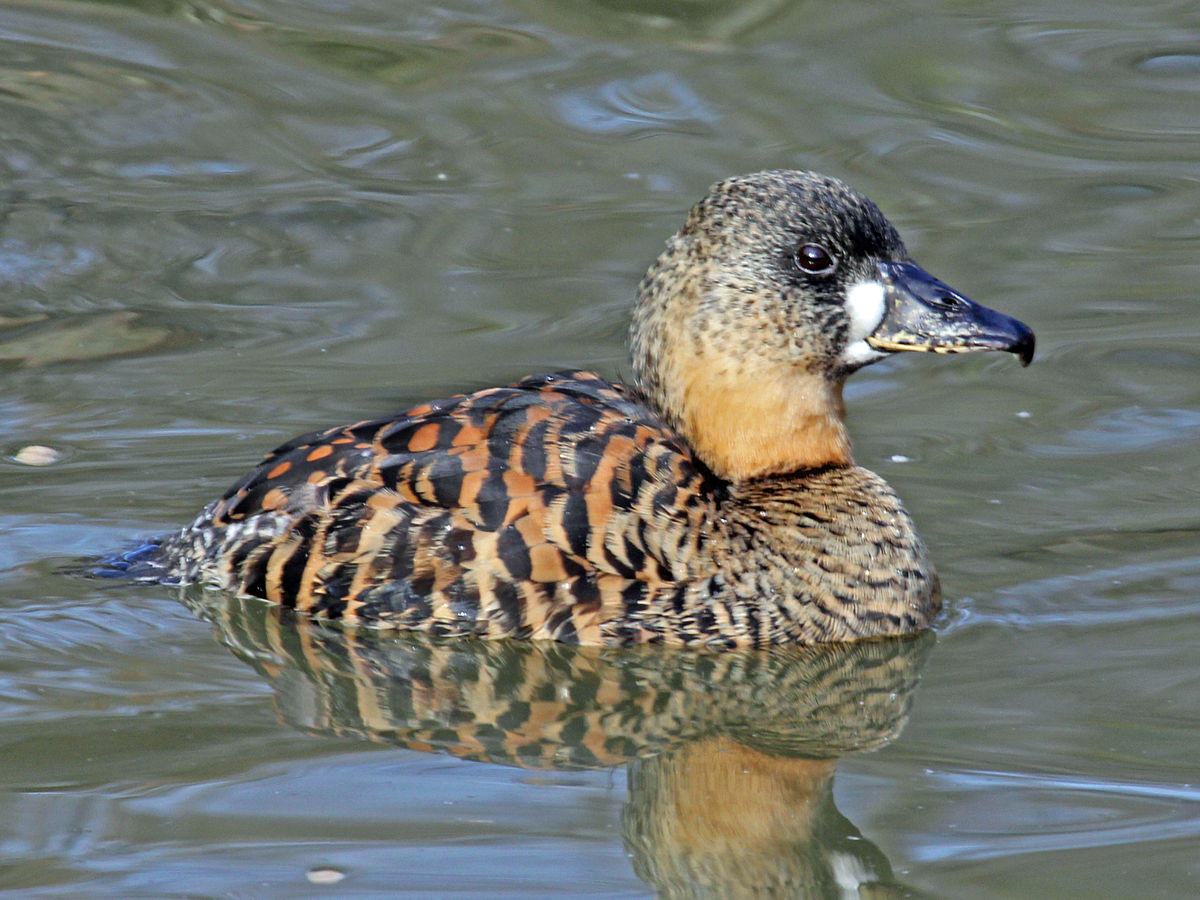
Wikipedia: White-backed duck Source: OTHER
1200px-White-backed_Duck_RWD2.jpg
![]() The white-backed duck (Thalassornis leuconotus) is a waterbird of the family Anatidae. It is distinct from all other ducks, but most closely related to the whistling ducks in the subfamily Dendrocygninae, though also showing some similarities to the stiff-tailed ducks in the subfamily Oxyurinae. It is the only member of the genus Thalassornis.
[more]
The white-backed duck (Thalassornis leuconotus) is a waterbird of the family Anatidae. It is distinct from all other ducks, but most closely related to the whistling ducks in the subfamily Dendrocygninae, though also showing some similarities to the stiff-tailed ducks in the subfamily Oxyurinae. It is the only member of the genus Thalassornis.
[more]
Profile Wikipedia eBird Xeno-Canto

Wikipedia: Spur-winged goose Source: OTHER
1200px-Spur-winged_goose_%28Plectropterus_gambensis%29.jpg
![]() The spur-winged goose (Plectropterus gambensis) is a large bird in the family Anatidae, related to the geese and the shelducks, but distinct from both of these in a number of anatomical features, and therefore treated in its own subfamily, the Plectropterinae. It occurs in wetlands throughout sub-Saharan Africa.
[more]
The spur-winged goose (Plectropterus gambensis) is a large bird in the family Anatidae, related to the geese and the shelducks, but distinct from both of these in a number of anatomical features, and therefore treated in its own subfamily, the Plectropterinae. It occurs in wetlands throughout sub-Saharan Africa.
[more]
African pygmy-goose / Afrikanische Zwergente (Nettapus auritus)
Profile Wikipedia eBird Xeno-Canto
African pygmy goose. 2016-09-23 09.50.38 Botswana
First observed in Botswana on 2016-09-23.
![]() The African pygmy goose (Nettapus auritus) is a perching duck from sub-Saharan Africa. It is the smallest of Africa's wildfowl, and one of the smallest in the world.[2]
[more]
The African pygmy goose (Nettapus auritus) is a perching duck from sub-Saharan Africa. It is the smallest of Africa's wildfowl, and one of the smallest in the world.[2]
[more]
Bank cormorant / Küstenscharbe (Phalacrocorax neglectus)
Profile Wikipedia eBird Xeno-Canto

Wikipedia: Bank cormorant Source: OTHER
Phalacrocoraxneglectus.jpg
![]() The bank cormorant (Phalacrocorax neglectus), also known as Wahlberg's cormorant, is a medium-sized cormorant that is endemic to Namibia and the western seaboard of South Africa, living in and around coastal waters; it is rarely recorded more than 15 km offshore.
[more]
The bank cormorant (Phalacrocorax neglectus), also known as Wahlberg's cormorant, is a medium-sized cormorant that is endemic to Namibia and the western seaboard of South Africa, living in and around coastal waters; it is rarely recorded more than 15 km offshore.
[more]
Cape cormorant / Kapscharbe (Phalacrocorax capensis)

Wikipedia: Cape cormorant Source: OTHER
1200px-Phalacrocorax_capensis_-_Namib_2013.jpg
![]() The Cape cormorant or Cape shag (Phalacrocorax capensis) is a bird endemic to the southwestern coasts of Africa.
[more]
The Cape cormorant or Cape shag (Phalacrocorax capensis) is a bird endemic to the southwestern coasts of Africa.
[more]
Long-tailed cormorant / Riedscharbe (Microcarbo africanus)
Profile Wikipedia eBird Xeno-Canto

Wikipedia: Long-tailed cormorant Source: OTHER
1200px-Cormor%C3%A1n_africano_%28Microcarbo_africanus%29%2C_parque_nacional_de_Chobe%2C_Botsuana%2C_2018-07-28%2C_DD_48.jpg
![]() The reed cormorant (Microcarbo africanus), also known as the long-tailed cormorant, is a bird in the cormorant family Phalacrocoracidae. It breeds in much of Africa south of the Sahara, and Madagascar. It is resident but undertakes some seasonal movements.
[more]
The reed cormorant (Microcarbo africanus), also known as the long-tailed cormorant, is a bird in the cormorant family Phalacrocoracidae. It breeds in much of Africa south of the Sahara, and Madagascar. It is resident but undertakes some seasonal movements.
[more]
Crowned cormorant (Microcarbo coronatus)
Profile Wikipedia eBird Xeno-Canto

Wikipedia: Crowned cormorant Source: OTHER
1200px-Crowned_Cormorant%2C_Phalacrocorax_coronatus.jpg
![]() The crowned cormorant (Microcarbo coronatus) is a small cormorant that is endemic to the waters of the cold Benguela Current of southern Africa. It is an exclusively coastal species and is not found more than 10 km (6 mi) away from land. This species is related to the reed cormorant, and was formerly considered to the same species.
[more]
The crowned cormorant (Microcarbo coronatus) is a small cormorant that is endemic to the waters of the cold Benguela Current of southern Africa. It is an exclusively coastal species and is not found more than 10 km (6 mi) away from land. This species is related to the reed cormorant, and was formerly considered to the same species.
[more]
Purple heron / Purpurreiher (Ardea purpurea)
Profile Wikipedia eBird Vogelwarte BirdLife ZH ornitho.ch Xeno-Canto BirdID NABU
Purple heron, Phnom Krom. 2024-03-03 06.13.38 Cambodia
First observed in Cambodia on 2024-03-03.
![]() The purple heron (Ardea purpurea) is a wide-ranging species of wading bird in the heron family, Ardeidae. The scientific name comes from Latin ardea "heron", and purpureus, "coloured purple".[2] It breeds in Africa, central and southern Europe, and southern and eastern Asia. The Western Palearctic populations migrate between breeding and wintering habitats whereas the African and tropical-Asian populations are primarily sedentary, except for occasional dispersive movements.
[more]
The purple heron (Ardea purpurea) is a wide-ranging species of wading bird in the heron family, Ardeidae. The scientific name comes from Latin ardea "heron", and purpureus, "coloured purple".[2] It breeds in Africa, central and southern Europe, and southern and eastern Asia. The Western Palearctic populations migrate between breeding and wintering habitats whereas the African and tropical-Asian populations are primarily sedentary, except for occasional dispersive movements.
[more]
Vocalization: ![]() Quite similar to Grey Heron, but not so vocal. [Link]
Quite similar to Grey Heron, but not so vocal. [Link]
Calls: ![]() Pitch slightly higher and remains stable throughout the short call. Volume muffled and timbre drier. [Link]
Pitch slightly higher and remains stable throughout the short call. Volume muffled and timbre drier. [Link]
Physical details: length=78-90 cm,
wingspan=120-150 cm,
weight=525-1218 g
Habitats:
Wetland
Call:
Automatically generated from Xeno-Canto recording
♫ XC878038 - Purple Heron - Ardea purpurea manilensis - flight call - Nonthaburi, Thailand. Source: XENOCANTO
XC878038 - Purple Heron - Ardea purpurea manilensis - flight call - Nonthaburi, Thailand.mp3
Thailand (flight call)
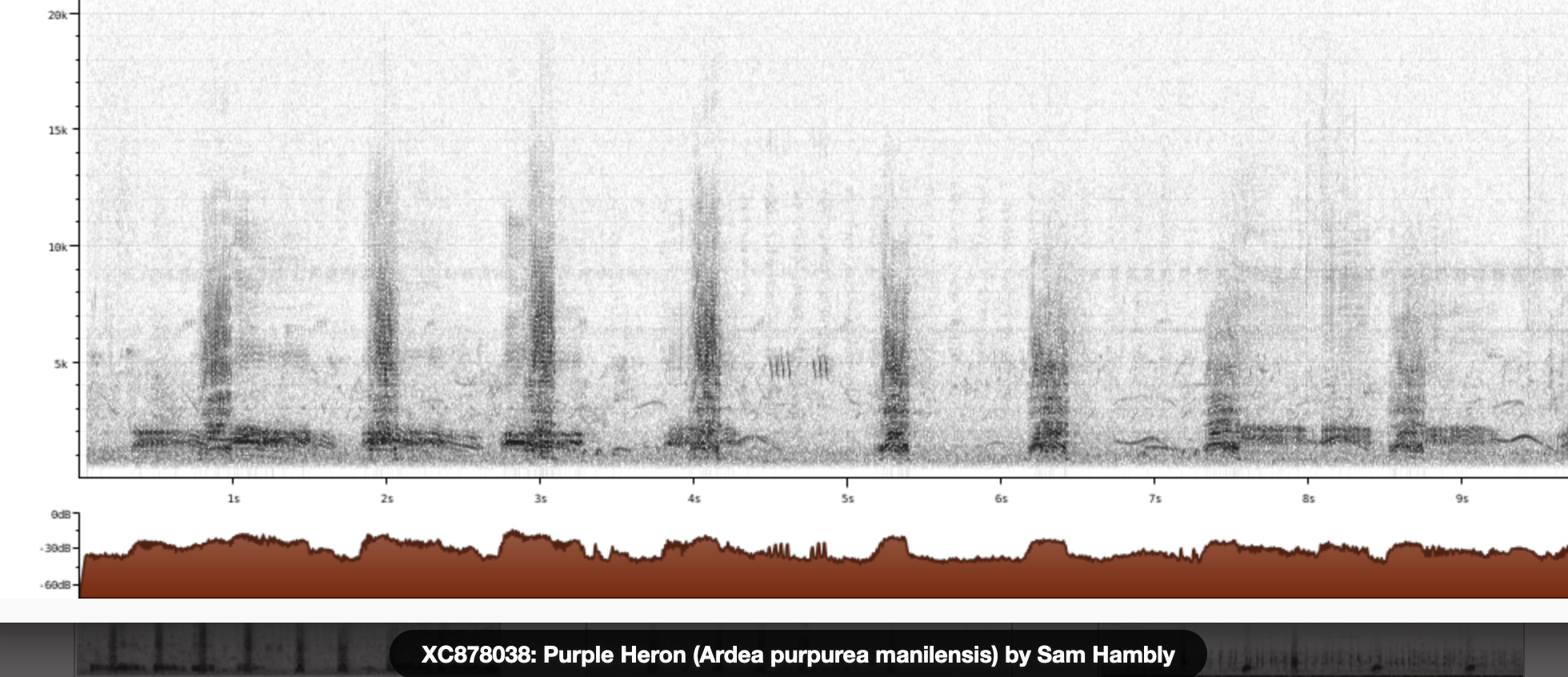
Call attributes:
flight call Frequency: ,
Medium egret / Mittelreiher (Ardea intermedia)
Could be a medium egret aka intermedian egret aka median egret with orange bill but dark legs but could also be a great egret, which we saw a lot. 2024-02-22 11.59.32 Laos
First observed in Laos on 2024-02-22.
General: ![]() The medium egret (Ardea intermedia), median egret, smaller egret or intermediate egret, is a medium-sized heron. Some taxonomists put the species in the genus Egretta or Mesophoyx. It is a resident breeder in southern and eastern Asia.
[more]
The medium egret (Ardea intermedia), median egret, smaller egret or intermediate egret, is a medium-sized heron. Some taxonomists put the species in the genus Egretta or Mesophoyx. It is a resident breeder in southern and eastern Asia.
[more]
Song:
Automatically generated from Xeno-Canto recording
Song attributes:
Frequency:
♫ XC460203 - Intermediate Egret - Ardea intermedia - call - Bharatpur, Rajasthan, India. Source: XENOCANTO
XC460203 - Intermediate Egret - Ardea intermedia - call - Bharatpur, Rajasthan, India.mp3
(call)
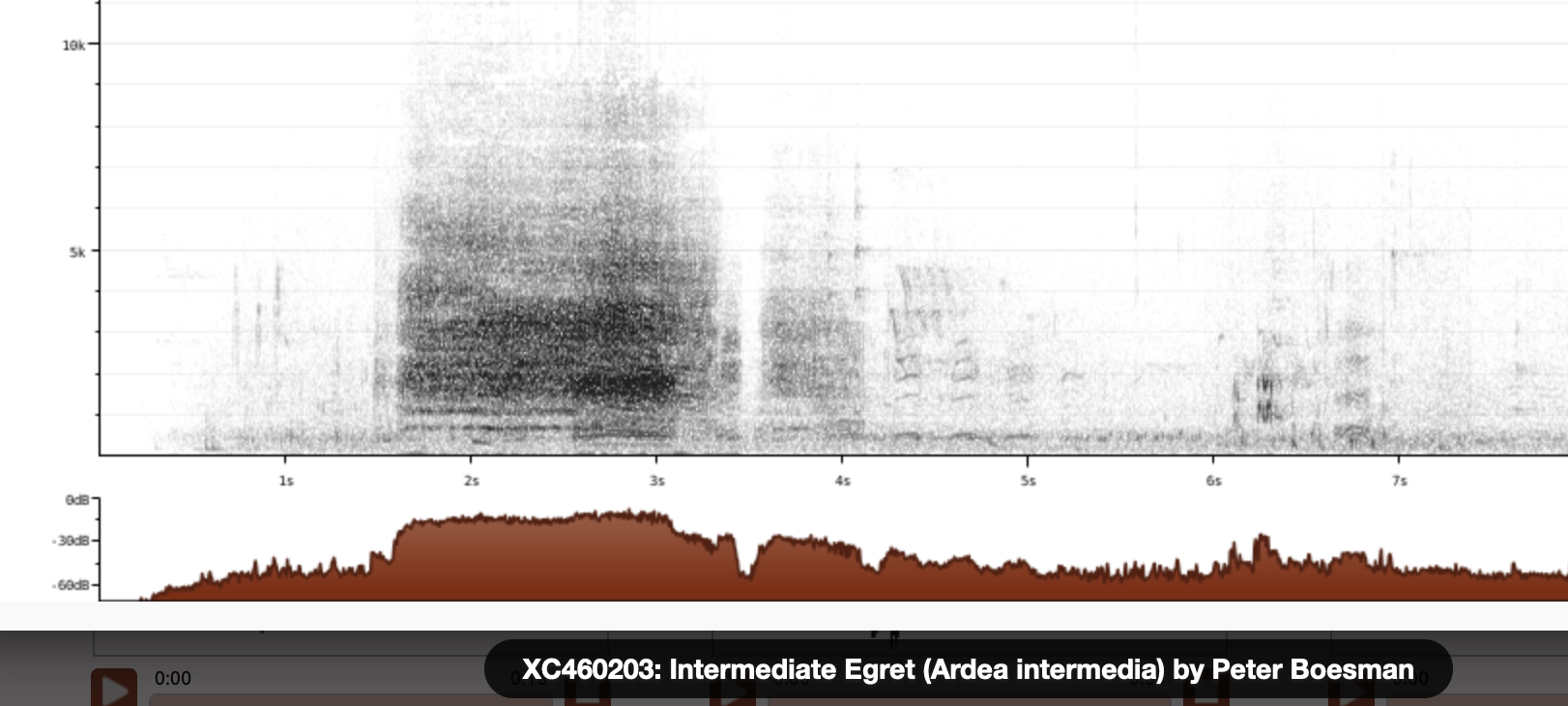
Goliath heron / Goliathreiher (Ardea goliath)
Profile Wikipedia eBird Xeno-Canto

Wikipedia: Goliath heron Source: OTHER
Ardea_goliath_-Lake_Baringo%2C_Kenya-8.jpg
![]() The Goliath heron (Ardea goliath), also known as the giant heron,[2] is a very large wading bird of the heron family, Ardeidae. It is found in sub-Saharan Africa, with smaller numbers in Southwest and South Asia.
[more]
The Goliath heron (Ardea goliath), also known as the giant heron,[2] is a very large wading bird of the heron family, Ardeidae. It is found in sub-Saharan Africa, with smaller numbers in Southwest and South Asia.
[more]
Black-headed heron / Schwarzhalsreiher (Ardea melanocephala)
Profile Wikipedia eBird Xeno-Canto NABU

Wikipedia: Black-headed heron Source: OTHER
1200px-Black-headed_Heron_%28Ardea_melanocephala%29.jpg
![]() The black-headed heron (Ardea melanocephala) is a wading bird of the heron family Ardeidae, common throughout much of sub-Saharan Africa and Madagascar. It is mainly resident, but some west African birds move further north in the rainy season.
[more]
The black-headed heron (Ardea melanocephala) is a wading bird of the heron family Ardeidae, common throughout much of sub-Saharan Africa and Madagascar. It is mainly resident, but some west African birds move further north in the rainy season.
[more]
Black-crowned night-heron / Nachtreiher (Nycticorax nycticorax)

Wikipedia: Black-crowned night-heron Source: OTHER
1200px-BCNH_CMCNJ_for_Wiki.png
This bird appears across the great seas in the following continents:
Europe, North America, South America, Africa, Asia.
![]() The black-crowned night heron (Nycticorax nycticorax), or black-capped night heron, commonly shortened to just night heron in Eurasia, is a medium-sized heron found throughout a large part of the world, except in the coldest regions and Australasia (where it is replaced by the closely related nankeen night heron, with which it has hybridized in the area of contact).
[more]
The black-crowned night heron (Nycticorax nycticorax), or black-capped night heron, commonly shortened to just night heron in Eurasia, is a medium-sized heron found throughout a large part of the world, except in the coldest regions and Australasia (where it is replaced by the closely related nankeen night heron, with which it has hybridized in the area of contact).
[more]
Calls: ![]() Most commonly hear call is a nasal, soft croaking "roack", like cross between Raven and frog. [Link]
Most commonly hear call is a nasal, soft croaking "roack", like cross between Raven and frog. [Link]
Physical details: length=58-65 cm,
wingspan=105-112 cm,
weight=500-800 g
Habitats:
Wetland
Black heron / Glockenreiher (Egretta ardesiaca)
Profile Wikipedia eBird Xeno-Canto
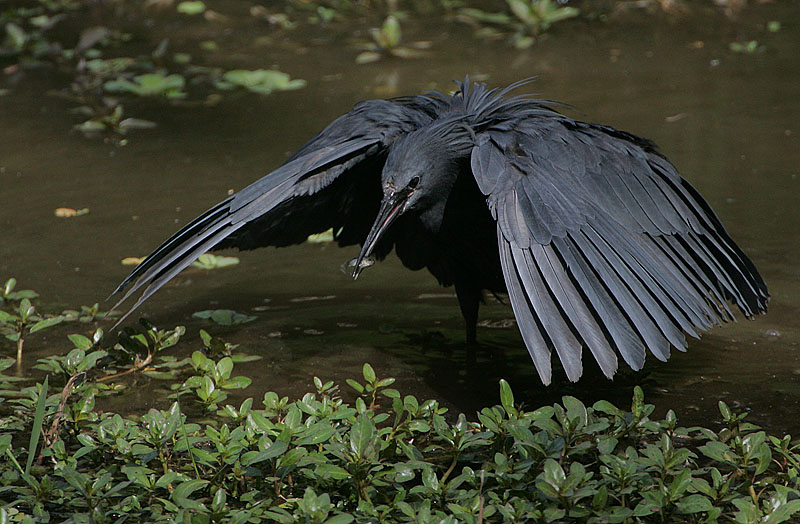
Wikipedia: Black heron Source: OTHER
Flickr_-_Rainbirder_-_Black_Egret_%28Egretta_ardesiaca%29.jpg
General: ![]() The black heron (Egretta ardesiaca) also known as the black egret, is an African heron. It is well known for its habit of using its wings to form a canopy when fishing.
[more]
The black heron (Egretta ardesiaca) also known as the black egret, is an African heron. It is well known for its habit of using its wings to form a canopy when fishing.
[more]
Slaty egret / Braunkehlreiher (Egretta vinaceigula)
Profile Wikipedia eBird Xeno-Canto

Wikipedia: Slaty egret Source: OTHER
1200px-Slaty_Egret_Egretta_vinaceigula.jpg
![]() The slaty egret (Egretta vinaceigula) is a small, dark egret. It is one of the species to which the Agreement on the Conservation of African-Eurasian Migratory Waterbirds (AEWA) applies. It is classified as Vulnerable, the biggest threat being habitat loss.
[more]
The slaty egret (Egretta vinaceigula) is a small, dark egret. It is one of the species to which the Agreement on the Conservation of African-Eurasian Migratory Waterbirds (AEWA) applies. It is classified as Vulnerable, the biggest threat being habitat loss.
[more]
Snowy egret / Schmuckreiher (Egretta thula)
Profile Wikipedia eBird Audubon AllAboutBirds Xeno-Canto
Snowy egret at John's Pass, Madeira Beach, Florida. 2023-09-27 11.51.14 Florida
First observed in Yucatan on 2023-04-15.
This bird appears across the great seas in the following continents:
North America, South America, Africa.
![]() The snowy egret (Egretta thula) is a small white heron. The genus name comes from Provençal French for the little egret, aigrette, which is a diminutive of aigron, 'heron'. The species name thula is the Araucano term for the black-necked swan, applied to this species in error by Chilean naturalist Juan Ignacio Molina in 1782.[3]
[more]
The snowy egret (Egretta thula) is a small white heron. The genus name comes from Provençal French for the little egret, aigrette, which is a diminutive of aigron, 'heron'. The species name thula is the Araucano term for the black-necked swan, applied to this species in error by Chilean naturalist Juan Ignacio Molina in 1782.[3]
[more]
Little blue heron / Blaureiher (Egretta caerulea)
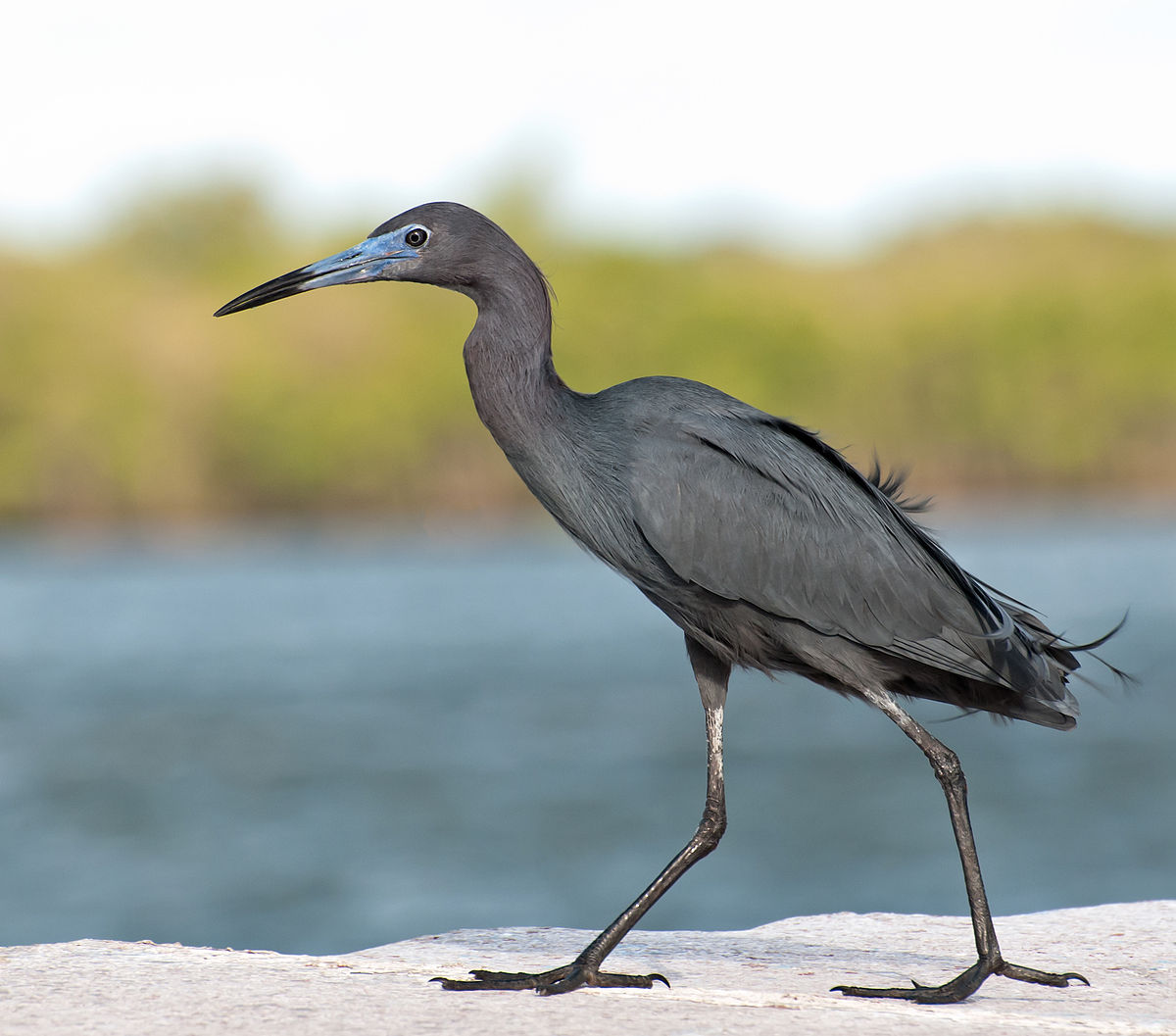
Wikipedia: Little blue heron Source: OTHER
1200px-Egretta_caerulea_-Cananeia%2C_Sao_Paulo%2C_Brasil-8.jpg
This bird appears across the great seas in the following continents:
North America, South America, Africa.
![]() The little blue heron (Egretta caerulea) is a small heron belonging to the family Ardeidae.
[more]
The little blue heron (Egretta caerulea) is a small heron belonging to the family Ardeidae.
[more]
Cattle egret / Kuhreiher (Bubulcus ibis)
Cow-plus-cattle egret. 2020-03-07 15.17.34 Panama
First observed in Costa Rica on 2018-02-27.
This bird appears across the great seas in the following continents:
Europe, North America, South America, Africa, Asia.
![]() The cattle egret (Bubulcus ibis) is a cosmopolitan species of heron (family Ardeidae) found in the tropics, subtropics, and warm-temperate zones. It is the only member of the monotypic genus Bubulcus, although some authorities regard two of its subspecies as full species, the western cattle egret and the eastern cattle egret. Despite the similarities in plumage to the egrets of the genus Egretta, it is more closely related to the herons of Ardea. Originally native to parts of Asia, Africa, and Europe, it has undergone a rapid expansion in its distribution and successfully colonised much of the rest of the world in the last century.
[more]
The cattle egret (Bubulcus ibis) is a cosmopolitan species of heron (family Ardeidae) found in the tropics, subtropics, and warm-temperate zones. It is the only member of the monotypic genus Bubulcus, although some authorities regard two of its subspecies as full species, the western cattle egret and the eastern cattle egret. Despite the similarities in plumage to the egrets of the genus Egretta, it is more closely related to the herons of Ardea. Originally native to parts of Asia, Africa, and Europe, it has undergone a rapid expansion in its distribution and successfully colonised much of the rest of the world in the last century.
[more]
Vocalization: ![]() Usually silent away from breeding ground. In the colonies a chorus of various coarse sounds can be heard. Most distinct is a disyllabic "rick-rack". Other sounds includes short, guttural utterings, or drawn, harsh shrieks. [Link]
Usually silent away from breeding ground. In the colonies a chorus of various coarse sounds can be heard. Most distinct is a disyllabic "rick-rack". Other sounds includes short, guttural utterings, or drawn, harsh shrieks. [Link]
Physical details: length=48-53 cm,
wingspan=90-96 cm,
weight=300-400 g
Song:
Automatically generated from Xeno-Canto recording
Song attributes:
Frequency:
♫ XC794287 - Eastern Cattle Egret - Bubulcus coromandus - call - Hong Kong, China. Source: XENOCANTO
XC794287 - Eastern Cattle Egret - Bubulcus coromandus - call - Hong Kong, China.mp3
(call)
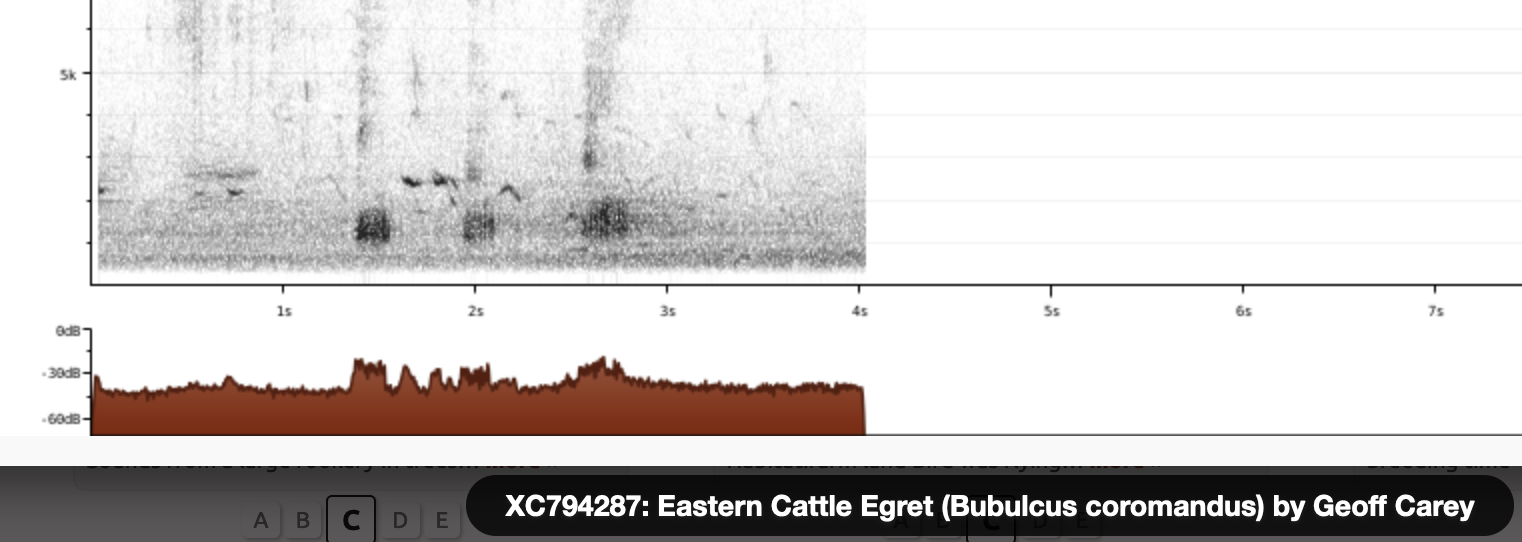
Call:
Automatically generated from Xeno-Canto recording
♫ XC353848 - Western Cattle Egret - Bubulcus ibis - flight call - sevilla, andalucía, Spain. Source: XENOCANTO
XC353848 - Western Cattle Egret - Bubulcus ibis - flight call - sevilla, andalucía, Spain.mp3
Spain (flight call)
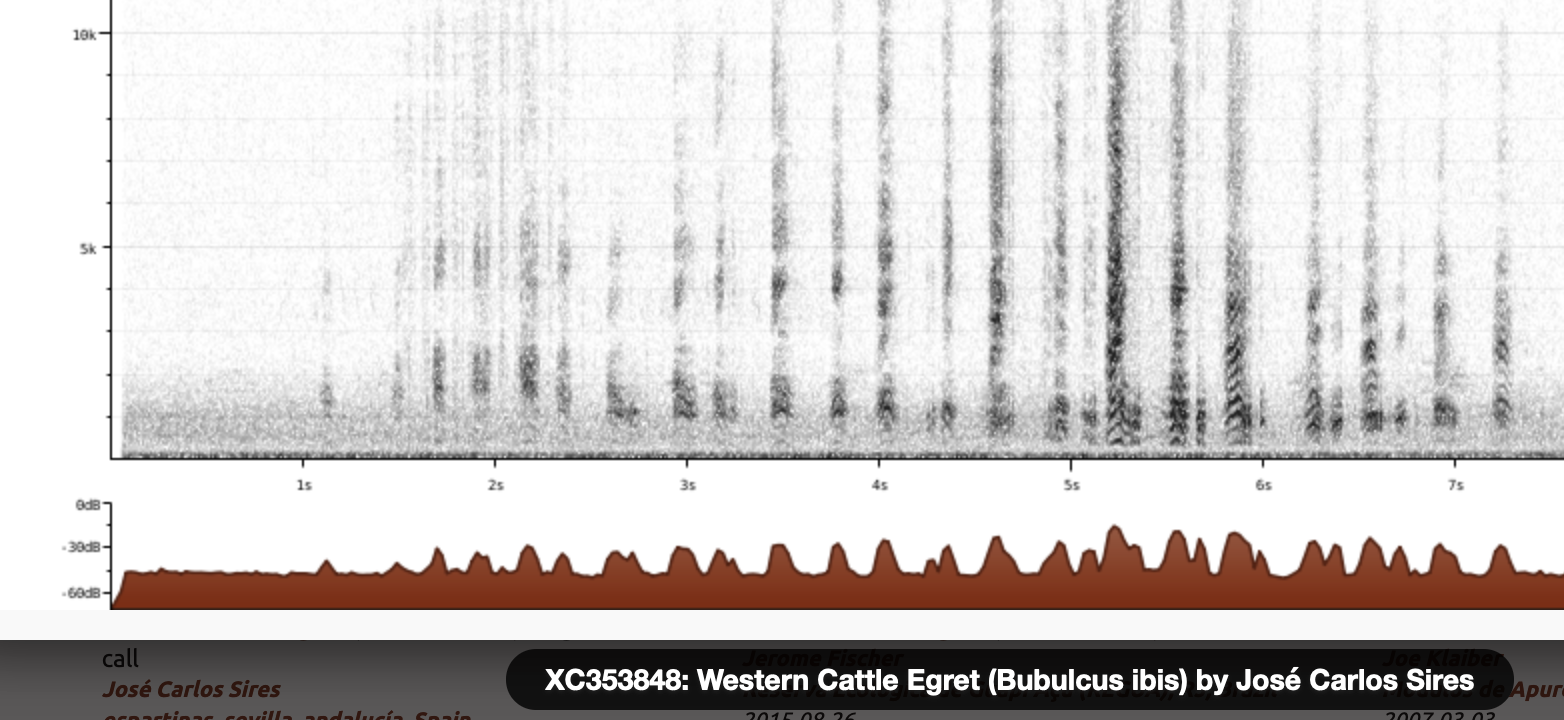
Call attributes:
flight call Frequency: ,
Green-backed heron (Butorides striata)
Striated heron. 2024-02-22 11.31.30 Laos
First observed in Laos on 2024-02-22.
This bird appears across the great seas in the following continents:
Europe, South America, Africa, Asia.
Song:
Automatically generated from Xeno-Canto recording
Song attributes:
Frequency:
♫ XC791519 - Striated Heron - Butorides striata - song, sounds like Ow plus pi-rol lhl, Copperbelt Province, Zambia. Source: XENOCANTO
XC791519 - Striated Heron - Butorides striata - song, sounds like Ow plus pi-rol lhl, Copperbelt Province, Zambia.mp3
(song)

Dwarf bittern / Graurückendommel (Ixobrychus sturmii)
Profile Wikipedia eBird Xeno-Canto

Wikipedia: Dwarf bittern Source: OTHER
BitternDwarf.jpg
General: ![]() The dwarf bittern (Ixobrychus sturmii) is a species of heron in the family Ardeidae.
[more]
The dwarf bittern (Ixobrychus sturmii) is a species of heron in the family Ardeidae.
[more]
Madagascar pond-heron / Dickschnabelreiher (Ardeola idae)

Wikipedia: Madagascar pond-heron Source: OTHER
Ardeola_idae.jpg
![]() The Malagasy pond heron (Ardeola idae) is a species of heron of the family Ardeidae. They are primarily seen in the outer islands of the Seychelles, Madagascar, and on the east coast of Africa including Kenya, Tanzania, and Uganda.[2] Being native to Madagascar, this species is often referred to as the Madagascar pond heron or Madagascar squacco heron. The population of this heron is estimated at 2,000–6,000 individuals, with only 1,300–4,000 being mature enough to mate.[3]
[more]
The Malagasy pond heron (Ardeola idae) is a species of heron of the family Ardeidae. They are primarily seen in the outer islands of the Seychelles, Madagascar, and on the east coast of Africa including Kenya, Tanzania, and Uganda.[2] Being native to Madagascar, this species is often referred to as the Madagascar pond heron or Madagascar squacco heron. The population of this heron is estimated at 2,000–6,000 individuals, with only 1,300–4,000 being mature enough to mate.[3]
[more]
Rufous-bellied heron / Rotbauchreiher (Ardeola rufiventris)
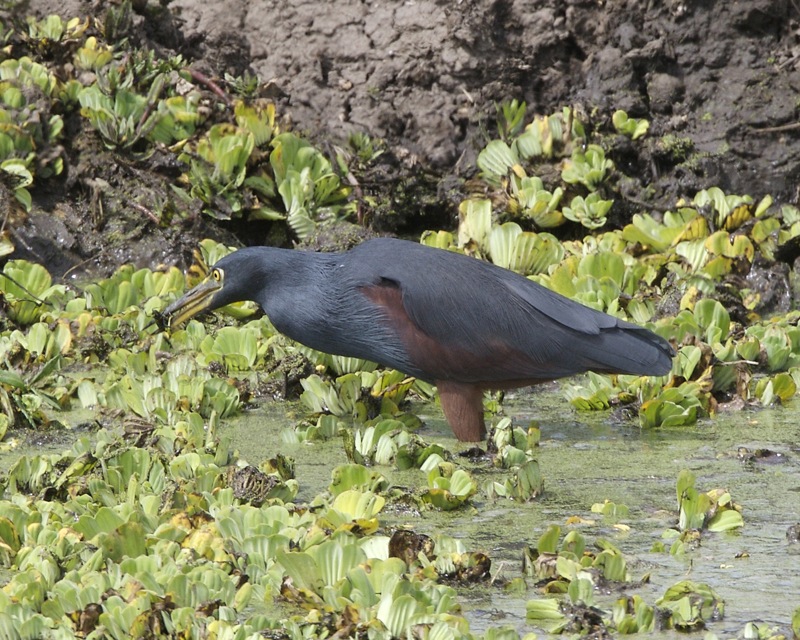
Wikipedia: Rufous-bellied heron Source: OTHER
Rufous-bellied_Heron_%28Ardeola_rufiventris%29.jpg
![]() The rufous-bellied heron (Ardeola rufiventris) is a species of heron in the genus Ardeola, the pond herons, of the family Ardeidae.
[more]
The rufous-bellied heron (Ardeola rufiventris) is a species of heron in the genus Ardeola, the pond herons, of the family Ardeidae.
[more]
Squacco heron / Rallenreiher (Ardeola ralloides)
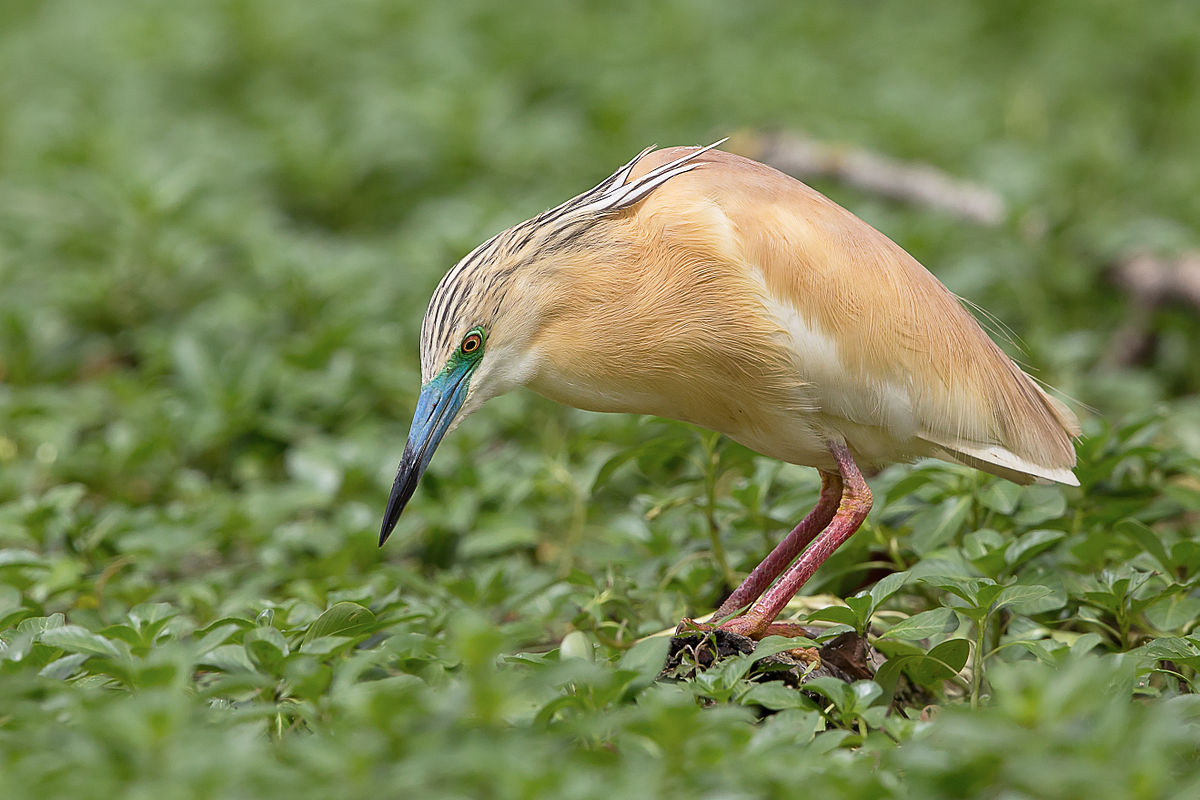
Wikipedia: Squacco heron Source: OTHER
1200px-Crabier_chevelu.jpg
![]() The squacco heron (Ardeola ralloides) is a small heron, 44–47 cm (17–19 in) long, of which the body is 20–23 cm (7.9–9.1 in), with 80–92 cm (31–36 in) wingspan.[2] It is of Old World origins, breeding in southern Europe and the Greater Middle East.
[more]
The squacco heron (Ardeola ralloides) is a small heron, 44–47 cm (17–19 in) long, of which the body is 20–23 cm (7.9–9.1 in), with 80–92 cm (31–36 in) wingspan.[2] It is of Old World origins, breeding in southern Europe and the Greater Middle East.
[more]
Habitats:
Wetland
White-backed night-heron (Gorsachius leuconotus)
Profile Wikipedia eBird Xeno-Canto

Wikipedia: White-backed night-heron Source: OTHER
1200px-White-backed_Night_Heron_%28Gorsachius_leuconotus%29_%286001840951%29.jpg
![]() The white-backed night heron (Gorsachius leuconotus) is a species of medium-sized heron in the family Ardeidae, found in sub-Saharan Africa.
[more]
The white-backed night heron (Gorsachius leuconotus) is a species of medium-sized heron in the family Ardeidae, found in sub-Saharan Africa.
[more]
African darter (Anhinga rufa)
African darter. 2016-09-23 09.06.10 Botswana
First observed in Botswana on 2016-09-23.
![]() The African darter (Anhinga rufa), sometimes called the snakebird, is a water bird of sub-Saharan Africa and Iraq.[1]
[more]
The African darter (Anhinga rufa), sometimes called the snakebird, is a water bird of sub-Saharan Africa and Iraq.[1]
[more]
Great frigatebird / Bindenfregattvogel (Fregata minor)
Profile Wikipedia eBird Audubon AllAboutBirds Xeno-Canto
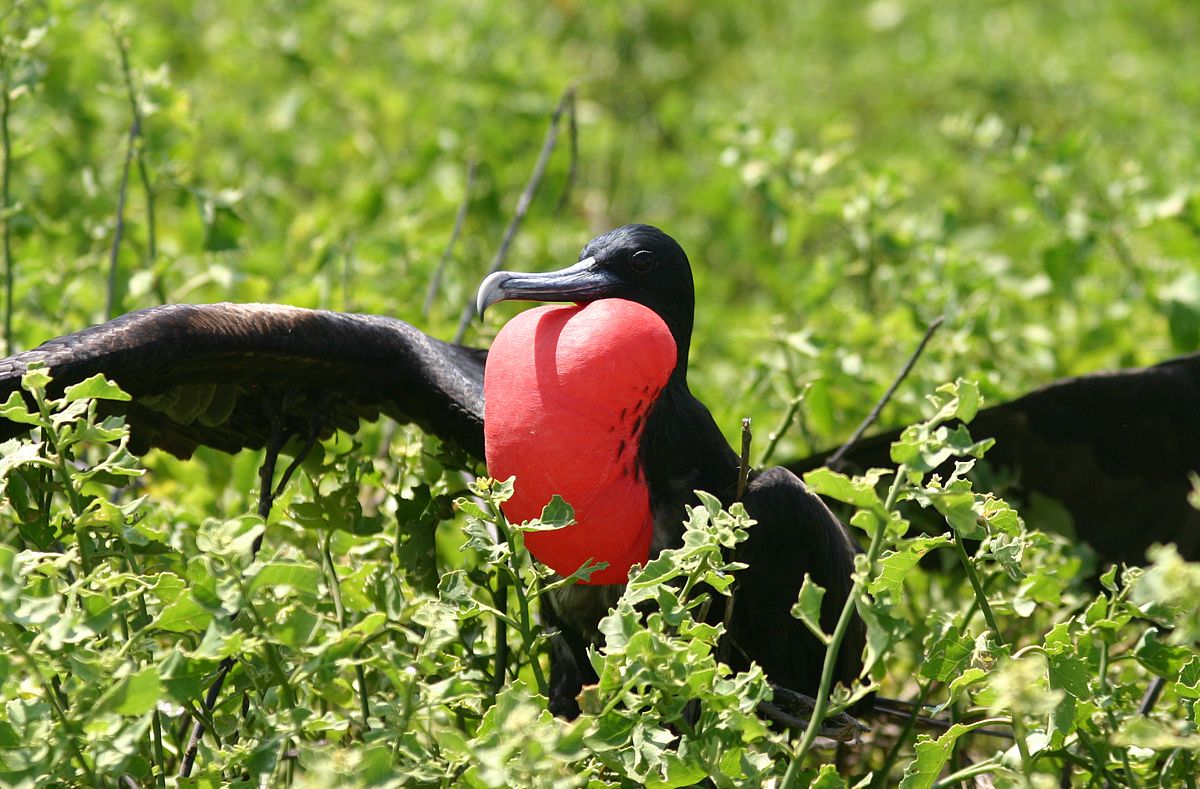
Wikipedia: Great frigatebird Source: OTHER
1200px-Male_greater_frigate_bird_displaying.jpg
This bird appears across the great seas in the following continents:
North America, South America, Africa, Asia.
![]() The great frigatebird (Fregata minor) is a large seabird in the frigatebird family. There are major nesting populations in the tropical Pacific (including the Galapagos Islands) and Indian Oceans, as well as a tiny population in the South Atlantic.
[more]
The great frigatebird (Fregata minor) is a large seabird in the frigatebird family. There are major nesting populations in the tropical Pacific (including the Galapagos Islands) and Indian Oceans, as well as a tiny population in the South Atlantic.
[more]
Lesser frigatebird / Arielfregattvogel (Fregata ariel)
Profile Wikipedia eBird Xeno-Canto

Wikipedia: Lesser frigatebird Source: OTHER
1200px-Lesser_Frigatebird_from_Indonesia.jpg
![]() The lesser frigatebird (Fregata ariel) is a seabird of the frigatebird family Fregatidae. At around 75 cm (30 in) in length, it is the smallest species of frigatebird. It occurs over tropical and subtropical waters across the Indian and Pacific Oceans as well as off the Atlantic coast of Brazil.
[more]
The lesser frigatebird (Fregata ariel) is a seabird of the frigatebird family Fregatidae. At around 75 cm (30 in) in length, it is the smallest species of frigatebird. It occurs over tropical and subtropical waters across the Indian and Pacific Oceans as well as off the Atlantic coast of Brazil.
[more]
Pink-backed pelican / Rötelpelikan (Pelecanus rufescens)
Profile Wikipedia eBird Xeno-Canto

Wikipedia: Pink-backed pelican Source: OTHER
1200px-Pink_backed_pelican_side_view.jpg
![]() The pink-backed pelican (Pelecanus rufescens) is a bird of the pelican family. It is a resident breeder in the swamps and shallow lakes of Africa, southern Arabia, and southern India; it has also apparently extirpated in Madagascar.
[more]
The pink-backed pelican (Pelecanus rufescens) is a bird of the pelican family. It is a resident breeder in the swamps and shallow lakes of Africa, southern Arabia, and southern India; it has also apparently extirpated in Madagascar.
[more]
Great white pelican / Rosapelikan (Pelecanus onocrotalus)
Profile Wikipedia eBird Xeno-Canto NABU

Wikipedia: Great white pelican Source: OTHER
1200px-Great_white_pelican_%28Pelecanus_onocrotalus%29.jpg
![]() The great white pelican (Pelecanus onocrotalus) also known as the eastern white pelican, rosy pelican or white pelican is a bird in the pelican family. It breeds from southeastern Europe through Asia and Africa, in swamps and shallow lakes.
[more]
The great white pelican (Pelecanus onocrotalus) also known as the eastern white pelican, rosy pelican or white pelican is a bird in the pelican family. It breeds from southeastern Europe through Asia and Africa, in swamps and shallow lakes.
[more]
Red-tailed tropicbird / Rotschwanz-Tropikvogel (Phaethon rubricauda)
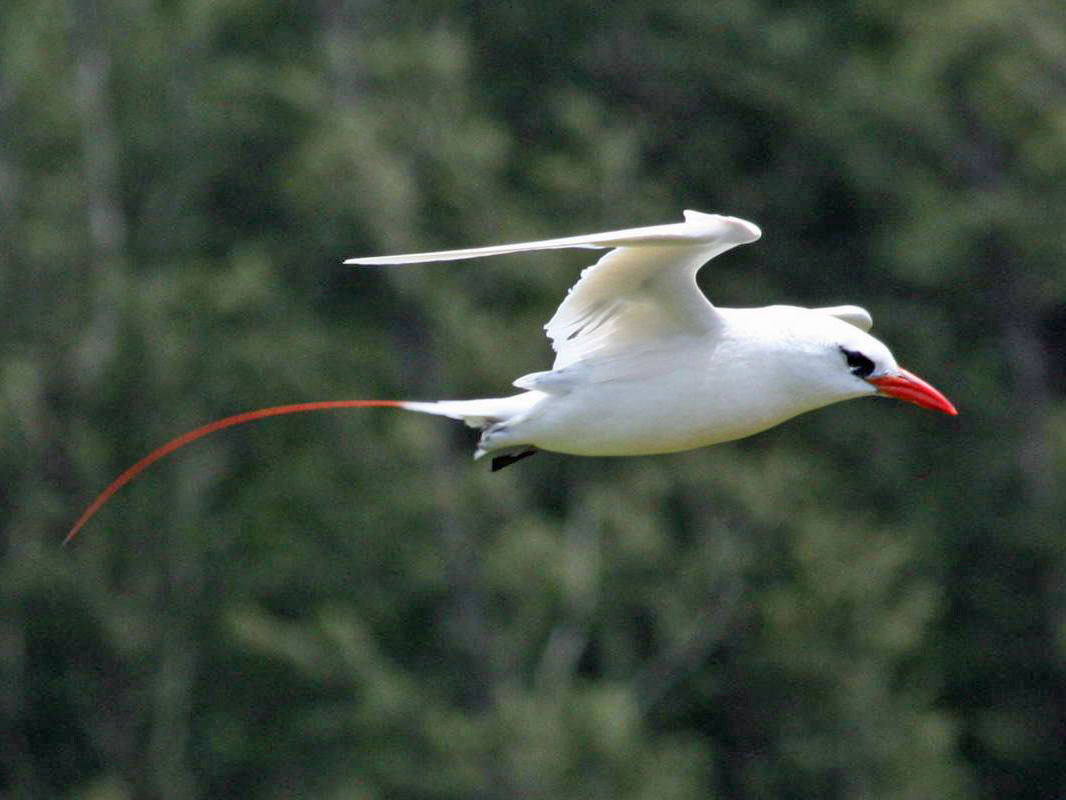
Wikipedia: Red-tailed tropicbird Source: OTHER
Red-tailed_Tropicbird_RWD2.jpg
This bird appears across the great seas in the following continents:
North America, Africa.
![]() The red-tailed tropicbird (Phaethon rubricauda) is a seabird native to tropical parts of the Indian and Pacific Oceans. One of three closely related species of tropicbird (Phaethontidae), it was described by Pieter Boddaert in 1783. Superficially resembling a tern in appearance, it has almost all-white plumage with a black mask and a red bill. The sexes have similar plumage. As referenced in the common name, adults have red tail streamers that are about twice their body length. Four subspecies are recognised, but there is evidence of clinal variation in body size—with smaller birds in the north and larger in the south—and hence no grounds for subspecies.
[more]
The red-tailed tropicbird (Phaethon rubricauda) is a seabird native to tropical parts of the Indian and Pacific Oceans. One of three closely related species of tropicbird (Phaethontidae), it was described by Pieter Boddaert in 1783. Superficially resembling a tern in appearance, it has almost all-white plumage with a black mask and a red bill. The sexes have similar plumage. As referenced in the common name, adults have red tail streamers that are about twice their body length. Four subspecies are recognised, but there is evidence of clinal variation in body size—with smaller birds in the north and larger in the south—and hence no grounds for subspecies.
[more]
Red-billed tropicbird / Rotschnabel-Tropikvogel (Phaethon aethereus)
Profile Wikipedia eBird Audubon AllAboutBirds Xeno-Canto

Wikipedia: Red-billed tropicbird Source: OTHER
1200px-Red-billed_tropicbird.jpg
This bird appears across the great seas in the following continents:
North America, South America, Africa.
![]() The red-billed tropicbird (Phaethon aethereus) is a tropicbird, one of three closely related species of seabird of tropical oceans. Superficially resembling a tern in appearance, it has mostly white plumage with some black markings on the wings and back, a black mask and, as its common name suggests, a red bill. Most adults have tail streamers that are about two times their body length, with those in males being generally longer than those in females. The red-billed tropicbird itself has three subspecies recognized, including the nominate. The subspecies mesonauta is distinguished from the nominate by the rosy tinge of its fresh plumage, and the subspecies indicus can be differentiated by its smaller size, more restricted mask, and more orange bill. This species ranges across the tropical Atlantic, eastern Pacific, and Indian Oceans. The nominate is found in the southern Atlantic Ocean, the subspecies indicus in the waters off of the Middle East and in the Indian Ocean, and the subspecies mesonauta in the eastern portions of both the Atlantic and the Pacific Oceans and in the Caribbean. It was one of the many species described by Carl Linnaeus in his 1758 10th edition of Systema Naturae.
[more]
The red-billed tropicbird (Phaethon aethereus) is a tropicbird, one of three closely related species of seabird of tropical oceans. Superficially resembling a tern in appearance, it has mostly white plumage with some black markings on the wings and back, a black mask and, as its common name suggests, a red bill. Most adults have tail streamers that are about two times their body length, with those in males being generally longer than those in females. The red-billed tropicbird itself has three subspecies recognized, including the nominate. The subspecies mesonauta is distinguished from the nominate by the rosy tinge of its fresh plumage, and the subspecies indicus can be differentiated by its smaller size, more restricted mask, and more orange bill. This species ranges across the tropical Atlantic, eastern Pacific, and Indian Oceans. The nominate is found in the southern Atlantic Ocean, the subspecies indicus in the waters off of the Middle East and in the Indian Ocean, and the subspecies mesonauta in the eastern portions of both the Atlantic and the Pacific Oceans and in the Caribbean. It was one of the many species described by Carl Linnaeus in his 1758 10th edition of Systema Naturae.
[more]
White-tailed tropicbird / Weißschwanz-Tropikvogel (Phaethon lepturus)
Profile Wikipedia eBird Audubon AllAboutBirds Xeno-Canto
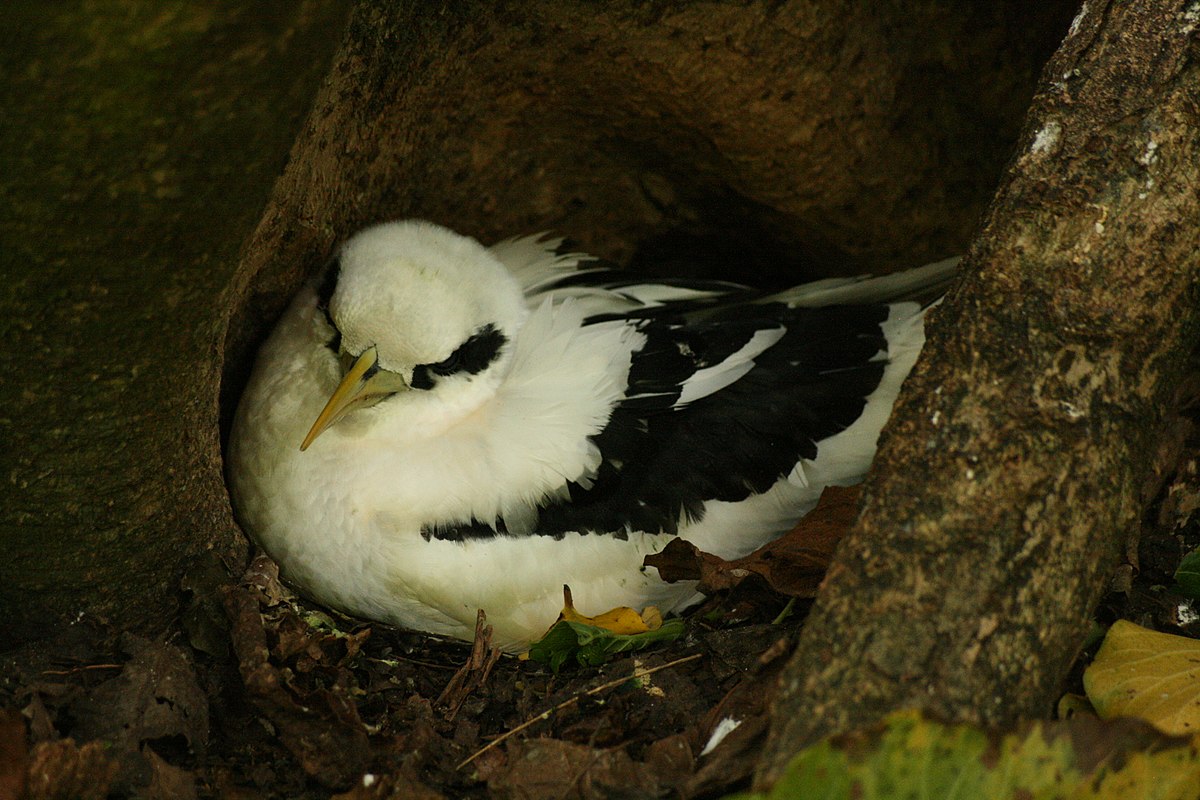
Wikipedia: White-tailed tropicbird Source: OTHER
1200px-White-tailed_Tropicbird_-_Phaeton_lepturus.jpg
This bird appears across the great seas in the following continents:
North America, Africa, Asia.
![]() The white-tailed tropicbird (Phaethon lepturus) is a species of tropicbird. It is the smallest of three closely related seabirds of the tropical oceans and smallest member of the order Phaethontiformes. It is found in the tropical Atlantic, western Pacific and Indian Oceans. It also breeds on some Caribbean islands, and a few pairs have started nesting recently on Little Tobago, joining the red-billed tropicbird colony. In addition to the tropical Atlantic, it nests as far north as Bermuda, where it is locally called a "longtail".[2]
[more]
The white-tailed tropicbird (Phaethon lepturus) is a species of tropicbird. It is the smallest of three closely related seabirds of the tropical oceans and smallest member of the order Phaethontiformes. It is found in the tropical Atlantic, western Pacific and Indian Oceans. It also breeds on some Caribbean islands, and a few pairs have started nesting recently on Little Tobago, joining the red-billed tropicbird colony. In addition to the tropical Atlantic, it nests as far north as Bermuda, where it is locally called a "longtail".[2]
[more]
Brown booby / Weißbauchtölpel (Sula leucogaster)
Profile Wikipedia eBird Audubon AllAboutBirds Xeno-Canto

Wikipedia: Brown booby Source: OTHER
1200px-Atob%C3%A1-pardo.jpg
This bird appears across the great seas in the following continents:
North America, South America, Africa, Asia.
![]() The brown booby (Sula leucogaster) is a large seabird of the booby family, Sulidae, of which it is perhaps the most common and widespread species.[3] It has a pantropical range, which overlaps with that of other booby species. The gregarious brown booby commutes and forages at low height over inshore waters. Flocks plunge-dive to take small fish, especially when these are driven near the surface by their predators. They only nest on the ground, and roost on solid objects rather than the water surface.[3]
[more]
The brown booby (Sula leucogaster) is a large seabird of the booby family, Sulidae, of which it is perhaps the most common and widespread species.[3] It has a pantropical range, which overlaps with that of other booby species. The gregarious brown booby commutes and forages at low height over inshore waters. Flocks plunge-dive to take small fish, especially when these are driven near the surface by their predators. They only nest on the ground, and roost on solid objects rather than the water surface.[3]
[more]
Red-footed booby / Rotfußtölpel (Sula sula)
Profile Wikipedia eBird Audubon AllAboutBirds Xeno-Canto
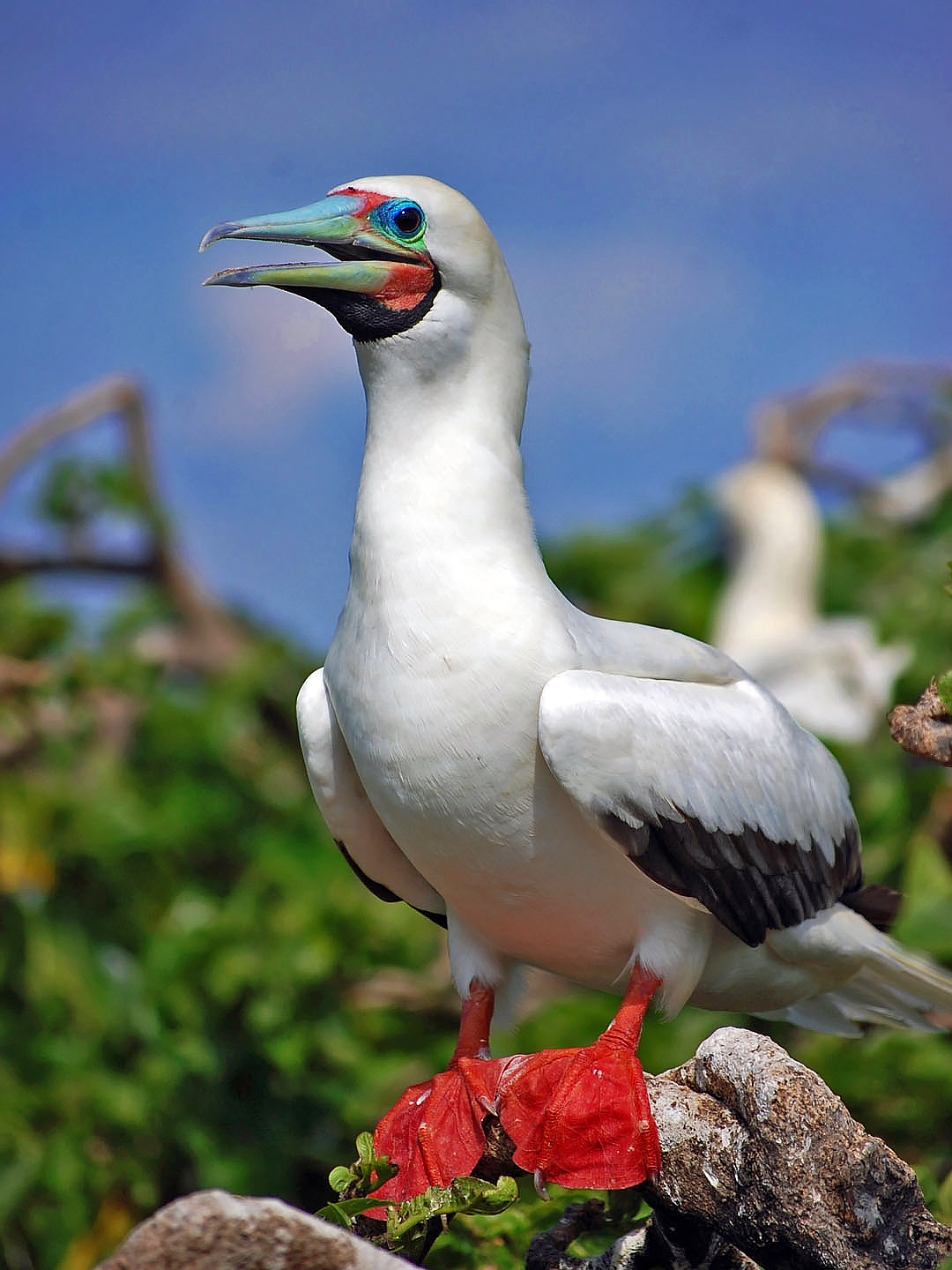
Wikipedia: Red-footed booby Source: OTHER
Sula_sula_by_Gregg_Yan_01.jpg
This bird appears across the great seas in the following continents:
North America, South America, Africa.
![]() The red-footed booby (Sula sula) is a large seabird of the booby family, Sulidae. Adults always have red feet, but the colour of the plumage varies. They are powerful and agile fliers, but they are clumsy in takeoffs and landings. They are found widely in the tropics, and breed colonially in coastal regions, especially islands. The species faces few natural or man-made threats, although its population is declining; it is considered to be a least-concern species by the International Union for Conservation of Nature (IUCN).
[more]
The red-footed booby (Sula sula) is a large seabird of the booby family, Sulidae. Adults always have red feet, but the colour of the plumage varies. They are powerful and agile fliers, but they are clumsy in takeoffs and landings. They are found widely in the tropics, and breed colonially in coastal regions, especially islands. The species faces few natural or man-made threats, although its population is declining; it is considered to be a least-concern species by the International Union for Conservation of Nature (IUCN).
[more]
Masked booby (Sula dactylatra)

Wikipedia: Masked booby Source: OTHER
1200px-Starr_080606-6808_Coronopus_didymus.jpg
This bird appears across the great seas in the following continents:
North America, South America, Africa, Asia.
![]() The masked booby (Sula dactylatra), also called the masked gannet or the blue-faced booby, is a large seabird of the booby and gannet family, Sulidae. First described by the French naturalist René-Primevère Lesson in 1831, the masked booby is one of six species of booby in the genus Sula. It has a typical sulid body shape, with a long pointed yellowish bill, long neck, aerodynamic body, long slender wings and pointed tail. The adult is bright white with black wings, a black tail and a dark face mask; at 75–85 cm (30–33 in) long, it is the largest species of booby. The sexes have similar plumage. This species ranges across tropical oceans, except in the eastern Atlantic and eastern Pacific. In the latter, it is replaced by the Nazca booby (Sula granti), which was formerly regarded as a subspecies of masked booby.
[more]
The masked booby (Sula dactylatra), also called the masked gannet or the blue-faced booby, is a large seabird of the booby and gannet family, Sulidae. First described by the French naturalist René-Primevère Lesson in 1831, the masked booby is one of six species of booby in the genus Sula. It has a typical sulid body shape, with a long pointed yellowish bill, long neck, aerodynamic body, long slender wings and pointed tail. The adult is bright white with black wings, a black tail and a dark face mask; at 75–85 cm (30–33 in) long, it is the largest species of booby. The sexes have similar plumage. This species ranges across tropical oceans, except in the eastern Atlantic and eastern Pacific. In the latter, it is replaced by the Nazca booby (Sula granti), which was formerly regarded as a subspecies of masked booby.
[more]
Cape gannet / Kaptölpel (Morus capensis)
Profile Wikipedia eBird Xeno-Canto

Wikipedia: Cape gannet Source: OTHER
1200px-Cape_Gannet_-_Morus_capensis.JPG
![]() The Cape gannet (Morus capensis) originally Sula capensis, is a large seabird of the gannet family, Sulidae.
[more]
The Cape gannet (Morus capensis) originally Sula capensis, is a large seabird of the gannet family, Sulidae.
[more]
Australasian gannet (Morus serrator)

Wikipedia: Australasian gannet Source: OTHER
1200px-Morus_serrator_-_Dunalley.jpg
![]() The Australasian gannet (Morus serrator), also known as the Australian gannet or tākapu, is a large seabird of the booby and gannet family, Sulidae. Adults are mostly white, with black flight feathers at the wingtips and lining the trailing edge of the wing. The central tail feathers are also black. The head is tinged buff-yellow, with a pale blue-grey bill edged in black, and blue-rimmed eyes. Young birds have mottled plumage in their first year, dark above and light below. The head is an intermediate mottled grey, with a dark bill. The birds gradually acquire more white in subsequent seasons until they reach maturity after five years.
[more]
The Australasian gannet (Morus serrator), also known as the Australian gannet or tākapu, is a large seabird of the booby and gannet family, Sulidae. Adults are mostly white, with black flight feathers at the wingtips and lining the trailing edge of the wing. The central tail feathers are also black. The head is tinged buff-yellow, with a pale blue-grey bill edged in black, and blue-rimmed eyes. Young birds have mottled plumage in their first year, dark above and light below. The head is an intermediate mottled grey, with a dark bill. The birds gradually acquire more white in subsequent seasons until they reach maturity after five years.
[more]
Glossy ibis / Brauner Sichler (Plegadis falcinellus)
Sichler nach ornitho, Brauner Sichler nach Wikipedia oder Plegadis falcinellus, Neeracherried. Source: WIKIPEDIA
20220904_071146-DSC_0059 Sichler nach ornitho, Brauner Sichler nach Wikipedia oder Plegadis falcinellus, Neeracherried.JPG
2022-09-04 07.11.46
First observed in 🇨🇭 on 2022-09-04.
This bird appears across the great seas in the following continents:
Europe, North America, South America, Africa, Asia.
![]() The glossy ibis (Plegadis falcinellus) is a water bird in the order Pelecaniformes and the ibis and spoonbill family Threskiornithidae. The scientific name derives from Ancient Greek plegados and Latin, falcis, both meaning "sickle" and referring to the distinctive shape of the bill.[2]
[more]
The glossy ibis (Plegadis falcinellus) is a water bird in the order Pelecaniformes and the ibis and spoonbill family Threskiornithidae. The scientific name derives from Ancient Greek plegados and Latin, falcis, both meaning "sickle" and referring to the distinctive shape of the bill.[2]
[more]
Vocalization: ![]() Generally silent away from breeding ground. Dry, crow-like "garr garr", may be heard occasionally in flight. At breeding ground various guttural grunts, and piping, hissing sounds. [Link]
Generally silent away from breeding ground. Dry, crow-like "garr garr", may be heard occasionally in flight. At breeding ground various guttural grunts, and piping, hissing sounds. [Link]
Physical details: length=55-65 cm,
wingspan=80-95 cm,
weight=530-768 g
African spoonbill / Rotgesichtlöffler (Platalea alba)
Profile Wikipedia eBird Xeno-Canto
African spoonbill makes shade with its wing to hunt. 2016-09-29 08.30.10 Botswana
First observed in Botswana on 2016-09-29.
General: ![]() The African spoonbill (Platalea alba) is a long-legged wading bird[2] of the ibis and spoonbill family Threskiornithidae. The species is widespread across Africa and Madagascar, including Botswana, Kenya, Mozambique, Namibia, South Africa, and Zimbabwe.[2]
[more]
The African spoonbill (Platalea alba) is a long-legged wading bird[2] of the ibis and spoonbill family Threskiornithidae. The species is widespread across Africa and Madagascar, including Botswana, Kenya, Mozambique, Namibia, South Africa, and Zimbabwe.[2]
[more]
Southern bald ibis / Glattnackenrapp (Geronticus calvus)
Profile Wikipedia eBird Xeno-Canto

Wikipedia: Southern bald ibis Source: OTHER
1200px-Geronticus.calvus.1.jpg
![]() The southern bald ibis (Geronticus calvus) is a large bird found in open grassland or semi-desert in the mountains of southern Africa. Taxonomically, it is most closely related to its counterpart in the northern regions of Africa, the waldrapp (Geronticus eremita).[2][3] As a species, it has a very restricted homerange, limited to the southern tips of South Africa in highland and mountainous regions.[3]
[more]
The southern bald ibis (Geronticus calvus) is a large bird found in open grassland or semi-desert in the mountains of southern Africa. Taxonomically, it is most closely related to its counterpart in the northern regions of Africa, the waldrapp (Geronticus eremita).[2][3] As a species, it has a very restricted homerange, limited to the southern tips of South Africa in highland and mountainous regions.[3]
[more]
Sacred ibis (Threskiornis aethiopicus)

Wikipedia: Sacred ibis Source: OTHER
1200px-Sacred_ibis_%28Threskiornis_aethiopicus%29.jpg
![]() The African sacred ibis (Threskiornis aethiopicus) is a species of ibis, a wading bird of the family Threskiornithidae. It is native to Africa and the Middle East. It is especially known for its role in the religion of the Ancient Egyptians, where it was linked to the god Thoth; despite this, the species is currently extirpated from Egypt.
[more]
The African sacred ibis (Threskiornis aethiopicus) is a species of ibis, a wading bird of the family Threskiornithidae. It is native to Africa and the Middle East. It is especially known for its role in the religion of the Ancient Egyptians, where it was linked to the god Thoth; despite this, the species is currently extirpated from Egypt.
[more]
Hadada ibis / Hagedasch (Bostrychia hagedash)

Wikipedia: Hadada ibis Source: OTHER
1200px-Hadeda_Ibis_Portrait.jpg
![]() The hadada ibis (Bostrychia hagedash), also called hadeda, is an ibis native to Sub-Saharan Africa. It is named for its loud three to four note calls uttered in flight especially in the mornings and evenings when they fly out or return to their roost trees. Although not as dependent on water as some ibises, they are found near wetlands and often live in close proximity to humans, foraging in cultivated land and gardens. A medium-sized ibis with stout legs and a typical down-curved bill, the wing coverts are iridescent with a green or purple sheen. They are non-migratory but are known to make nomadic movements in response to rain particularly during droughts. Their ranges in southern Africa have increased with an increase in tree cover and irrigation in human-altered habitats.
[more]
The hadada ibis (Bostrychia hagedash), also called hadeda, is an ibis native to Sub-Saharan Africa. It is named for its loud three to four note calls uttered in flight especially in the mornings and evenings when they fly out or return to their roost trees. Although not as dependent on water as some ibises, they are found near wetlands and often live in close proximity to humans, foraging in cultivated land and gardens. A medium-sized ibis with stout legs and a typical down-curved bill, the wing coverts are iridescent with a green or purple sheen. They are non-migratory but are known to make nomadic movements in response to rain particularly during droughts. Their ranges in southern Africa have increased with an increase in tree cover and irrigation in human-altered habitats.
[more]

Wikipedia: African reed-warbler Source: OTHER
African_Reed_Warbler_%28Acrocephalus_baeticatus%29_%288077249754%29.jpg
![]() The African reed warbler or African marsh warbler (Acrocephalus baeticatus) is an Old World warbler in the genus Acrocephalus. It breeds in much of Africa south of the Sahara. It is migratory within the continent, with southern breeding population moving to the tropics in the southern hemisphere's winter.
[more]
The African reed warbler or African marsh warbler (Acrocephalus baeticatus) is an Old World warbler in the genus Acrocephalus. It breeds in much of Africa south of the Sahara. It is migratory within the continent, with southern breeding population moving to the tropics in the southern hemisphere's winter.
[more]

Wikipedia: Basra reed warbler Source: OTHER
1200px-Naturalis_Biodiversity_Center_-_RMNH.AVES.37596_1_-_Acrocephalus_arundinaceus_griseldis_%28Hartlaub%2C_1891%29_-_Sylviidae_-_bird_skin_specimen.jpeg
![]() The Basra reed warbler (Acrocephalus griseldis) is a "warbler" of the genus Acrocephalus. It is an endemic breeder in East and southern Iraq, Kuwait, and Palestine[1] in extensive beds of papyrus and reeds. It is easily mistaken for the great reed warbler but is a bit smaller, has whiter under parts and has a narrower, longer and more pointed bill. It winters in East Africa. It is a very rare vagrant in Europe. The call is a gruff 'chaar', deeper than a reed warbler's.
[more]
The Basra reed warbler (Acrocephalus griseldis) is a "warbler" of the genus Acrocephalus. It is an endemic breeder in East and southern Iraq, Kuwait, and Palestine[1] in extensive beds of papyrus and reeds. It is easily mistaken for the great reed warbler but is a bit smaller, has whiter under parts and has a narrower, longer and more pointed bill. It winters in East Africa. It is a very rare vagrant in Europe. The call is a gruff 'chaar', deeper than a reed warbler's.
[more]

Wikipedia: Lesser swamp-warbler Source: OTHER
Lesser_swamp_warbler_%28Acrocephalus_gracilirostris%29%2C_Marievale%2C_3.jpg
![]() The lesser swamp warbler or Cape reed warbler (Acrocephalus gracilirostris) is an Old World warbler in the genus Acrocephalus. It is a resident breeder in Africa from the Democratic Republic of the Congo, the Chad and Ethiopia south to South Africa. This is a common species of reedbeds in standing water.
[more]
The lesser swamp warbler or Cape reed warbler (Acrocephalus gracilirostris) is an Old World warbler in the genus Acrocephalus. It is a resident breeder in Africa from the Democratic Republic of the Congo, the Chad and Ethiopia south to South Africa. This is a common species of reedbeds in standing water.
[more]
Profile Wikipedia eBird Xeno-Canto NABU

Wikipedia: Olive-tree warbler Source: OTHER
1200px-Olive-tree_warbler%2C_Hippolais_olivetorum%2C_at_Mkuze_Game_Reserve%2C_%2839230388474%29.jpg
![]() The olive-tree warbler (Hippolais olivetorum) is an Old World warbler in the tree warbler genus Hippolais. It breeds in southeast Europe and the near east. It is migratory, wintering in eastern and southern Africa, from Kenya south to South Africa.
[more]
The olive-tree warbler (Hippolais olivetorum) is an Old World warbler in the tree warbler genus Hippolais. It breeds in southeast Europe and the near east. It is migratory, wintering in eastern and southern Africa, from Kenya south to South Africa.
[more]
Profile Wikipedia eBird Xeno-Canto

Wikipedia: Upcher's warbler Source: OTHER
Upcher%27s_Warbler_%28Hippolais_languida%29_%288079442053%29.jpg
![]() Upcher's warbler (Hippolais languida) is an Old World warbler in the tree warbler genus Hippolais. It breeds in an area from Turkey south and east to Pakistan. It is migratory, wintering in eastern Africa, from Eritrea and Somalia south to Tanzania.
[more]
Upcher's warbler (Hippolais languida) is an Old World warbler in the tree warbler genus Hippolais. It breeds in an area from Turkey south and east to Pakistan. It is migratory, wintering in eastern Africa, from Eritrea and Somalia south to Tanzania.
[more]
Profile Wikipedia eBird Xeno-Canto

Wikipedia: Cape crombec Source: OTHER
Crombec_Longbilled_2011_05_16_09_Alan_Manson_Prieska.jpg
![]() The long-billed crombec or Cape crombec (Sylvietta rufescens) is an African warbler.
[more]
The long-billed crombec or Cape crombec (Sylvietta rufescens) is an African warbler.
[more]

Wikipedia: Karoo eremomela Source: OTHER
Eremomela_Karoo_2015_01_24_08_15_57_4357s.jpg
![]() The Karoo eremomela (Eremomela gregalis), also known as the yellow-rumped eremomela, is a species of bird formerly placed in the "Old World warbler" assemblage, but now placed in the family Cisticolidae.
It is found in Namibia and South Africa.
Its natural habitat is subtropical or tropical dry shrubland.
[more]
The Karoo eremomela (Eremomela gregalis), also known as the yellow-rumped eremomela, is a species of bird formerly placed in the "Old World warbler" assemblage, but now placed in the family Cisticolidae.
It is found in Namibia and South Africa.
Its natural habitat is subtropical or tropical dry shrubland.
[more]
Profile Wikipedia eBird Xeno-Canto

Wikipedia: Yellow-bellied eremomela Source: OTHER
Yellow-bellied_eremomela%2C_Eremomela_icteropygialis%2C_at_Mapungubwe_National_Park%2C_Limpopo%2C_South_Africa_%2817696689908%29%2C_crop.jpg
![]() The yellow-bellied eremomela (Eremomela icteropygialis) is an Old World warbler. However, the taxonomy of the "African warblers", an assemblage of usually species-poor and apparently rather ancient "odd warblers" from Africa is currently in a state of flux. Today, most taxonomists consider members in this genus members of the family Cisticolidae.
[more]
The yellow-bellied eremomela (Eremomela icteropygialis) is an Old World warbler. However, the taxonomy of the "African warblers", an assemblage of usually species-poor and apparently rather ancient "odd warblers" from Africa is currently in a state of flux. Today, most taxonomists consider members in this genus members of the family Cisticolidae.
[more]
Profile Wikipedia eBird Xeno-Canto
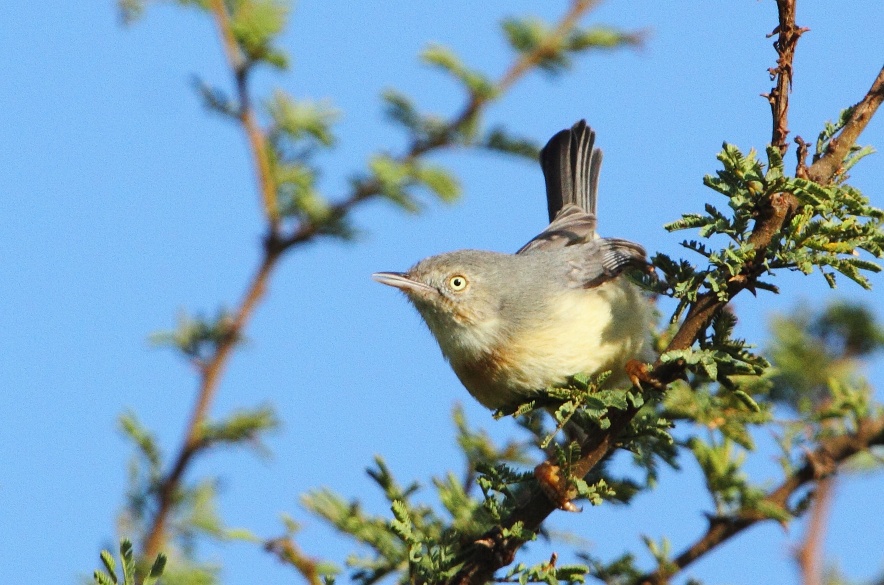
Wikipedia: Burnt-neck eremomela Source: OTHER
Eremomela_Burnt-necked_2015_06_02_08_21_35_5728.jpg
![]() The burnt-necked eremomela (Eremomela usticollis) is a species of bird formerly placed in the "Old World warbler" assemblage, but now placed in the family Cisticolidae. It is found in Angola, Botswana, Malawi, Mozambique, Namibia, South Africa, Swaziland, Zambia, and Zimbabwe. Its natural habitats are subtropical or tropical dry forests, dry savannah, and subtropical or tropical dry shrubland.
[more]
The burnt-necked eremomela (Eremomela usticollis) is a species of bird formerly placed in the "Old World warbler" assemblage, but now placed in the family Cisticolidae. It is found in Angola, Botswana, Malawi, Mozambique, Namibia, South Africa, Swaziland, Zambia, and Zimbabwe. Its natural habitats are subtropical or tropical dry forests, dry savannah, and subtropical or tropical dry shrubland.
[more]
Profile Wikipedia eBird Xeno-Canto

Wikipedia: Greencap eremomela Source: OTHER
Eremomela_scotops_scotops%2C_Cecil_Kop-natuurreservaat%2C_Birding_Weto%2C_a.jpg
![]() The green-capped eremomela or greencap eremomela (Eremomela scotops) is a species of bird formerly placed in the "Old World warbler" assemblage, but now placed in the family Cisticolidae.
[more]
The green-capped eremomela or greencap eremomela (Eremomela scotops) is a species of bird formerly placed in the "Old World warbler" assemblage, but now placed in the family Cisticolidae.
[more]

Wikipedia: Yellow flycatcher-warbler Source: OTHER
African_Yellow_Warbler_-_South_Africa_S4E7584_%2817123176947%29.jpg
![]() The African yellow warbler, Natal yellow warbler, dark-capped yellow warbler, or yellow flycatcher-warbler (Iduna natalensis) is a species of Acrocephalidae warblers; formerly, these were placed in the paraphyletic "Old World warblers".
[more]
The African yellow warbler, Natal yellow warbler, dark-capped yellow warbler, or yellow flycatcher-warbler (Iduna natalensis) is a species of Acrocephalidae warblers; formerly, these were placed in the paraphyletic "Old World warblers".
[more]
Profile Wikipedia eBird Xeno-Canto

Wikipedia: Layard's warbler Source: OTHER
Layard%27s_Tit-Babbler_2017_08_12_5272.jpg
![]() Layard's warbler (Curruca layardi) or Layard's tit-babbler, is a species of Old World warbler in the family Sylviidae. It is found in Lesotho, Namibia, and South Africa. Its natural habitat is subtropical or tropical dry shrubland.
[more]
Layard's warbler (Curruca layardi) or Layard's tit-babbler, is a species of Old World warbler in the family Sylviidae. It is found in Lesotho, Namibia, and South Africa. Its natural habitat is subtropical or tropical dry shrubland.
[more]
Profile Wikipedia eBird Xeno-Canto

Wikipedia: Bush blackcap Source: OTHER
Bush_Blackcap_2016_12_30_15_33_23_2771_crop.jpg
![]() The bush blackcap (Sylvia nigricapillus) is a species of bird in the family Sylviidae. It is endemic to South Africa and Swaziland. Its natural habitats are subtropical or tropical moist montane forests and subtropical or tropical high-altitude shrubland. It is threatened by habitat loss.[1]
[more]
The bush blackcap (Sylvia nigricapillus) is a species of bird in the family Sylviidae. It is endemic to South Africa and Swaziland. Its natural habitats are subtropical or tropical moist montane forests and subtropical or tropical high-altitude shrubland. It is threatened by habitat loss.[1]
[more]

Wikipedia: Rufous-vented warbler Source: OTHER
Titbabbler_Chestnut-vented_2010_07_18_09_Alan_Manson_Weenen.jpg
![]() The chestnut-vented warbler, chestnut-vented tit-babbler or rufous-vented warbler (Curruca subcoerulea) is an Old World warbler.
[more]
The chestnut-vented warbler, chestnut-vented tit-babbler or rufous-vented warbler (Curruca subcoerulea) is an Old World warbler.
[more]

Wikipedia: Sombre greenbul Source: OTHER
1200px-Sombre_greenbul%2C_Andropadus_importunus.jpg
![]() The sombre greenbul (Andropadus importunus) is a member of the bulbul family of passerine birds. It is a resident breeder in coastal bush, evergreen forest and dry shrub land in eastern and southern Africa. It is the only member of the genus Andropadus.
[more]
The sombre greenbul (Andropadus importunus) is a member of the bulbul family of passerine birds. It is a resident breeder in coastal bush, evergreen forest and dry shrub land in eastern and southern Africa. It is the only member of the genus Andropadus.
[more]
Profile Wikipedia eBird Xeno-Canto

Wikipedia: Terrestrial brownbul Source: OTHER
Brownbul_Terrestrial_2010_10_02_Alan_Manson_Ngwenya.jpg
![]() The terrestrial brownbul (Phyllastrephus terrestris) is a species of songbird in the bulbul family, Pycnonotidae.
It is found in eastern and south-eastern Africa. Its natural habitats are subtropical or tropical dry forest, subtropical or tropical moist lowland forest, and subtropical or tropical moist shrubland.
[more]
The terrestrial brownbul (Phyllastrephus terrestris) is a species of songbird in the bulbul family, Pycnonotidae.
It is found in eastern and south-eastern Africa. Its natural habitats are subtropical or tropical dry forest, subtropical or tropical moist lowland forest, and subtropical or tropical moist shrubland.
[more]

Wikipedia: Yellow-streaked greenbul Source: OTHER
1200px-Yellow-streaked_Greenbul_%28or_Yellow-streaked_Bulbul%29%2C_Phyllastrephus_flavostriatus_at_Agatha_Plantation%2C_Tzaneen%2C_South_Africa_%2814514831440%29.jpg
![]() The yellow-streaked greenbul or yellow-streaked bulbul (Phyllastrephus flavostriatus) is a species of songbird in the bulbul family, Pycnonotidae. It is found in eastern and south-eastern Africa. Its natural habitats are subtropical or tropical moist lowland forest and subtropical or tropical moist montane forest.
[more]
The yellow-streaked greenbul or yellow-streaked bulbul (Phyllastrephus flavostriatus) is a species of songbird in the bulbul family, Pycnonotidae. It is found in eastern and south-eastern Africa. Its natural habitats are subtropical or tropical moist lowland forest and subtropical or tropical moist montane forest.
[more]
Profile Wikipedia eBird Xeno-Canto

Wikipedia: Black-fronted bulbul Source: OTHER
1200px-African_red-eyed_bulbul_%28Pycnonotus_nigricans%29.jpg
![]() The African red-eyed bulbul or black-fronted bulbul (Pycnonotus nigricans) is a species of songbird in the family Pycnonotidae.
It is found in south-western Africa.
Its natural habitats are dry savanna, subtropical or tropical dry shrubland, and riverine scrub.[2][3][4] It feeds on fruit (including Ficus), flowers, nectar, and insects.[3][4]
[more]
The African red-eyed bulbul or black-fronted bulbul (Pycnonotus nigricans) is a species of songbird in the family Pycnonotidae.
It is found in south-western Africa.
Its natural habitats are dry savanna, subtropical or tropical dry shrubland, and riverine scrub.[2][3][4] It feeds on fruit (including Ficus), flowers, nectar, and insects.[3][4]
[more]
Profile Wikipedia eBird Xeno-Canto

Wikipedia: Cape bulbul Source: OTHER
1200px-Pycnonotus_capensis_2.jpg
![]() The Cape bulbul (Pycnonotus capensis) is a member of the bulbul family of passerine birds. It is an endemic resident breeder in coastal bush, open forest, gardens and fynbos in western and southern South Africa. This species nests mainly in the southern spring from September to November. The nest is thick walled cup concealed by foliage in a small tree or shrub.
[more]
The Cape bulbul (Pycnonotus capensis) is a member of the bulbul family of passerine birds. It is an endemic resident breeder in coastal bush, open forest, gardens and fynbos in western and southern South Africa. This species nests mainly in the southern spring from September to November. The nest is thick walled cup concealed by foliage in a small tree or shrub.
[more]

Wikipedia: Garden bulbul Source: OTHER
1200px-Common_bulbul_%28Pycnonotus_barbatus_barbatus%29.jpg
![]() The common bulbul (Pycnonotus barbatus) is a member of the bulbul family of passerine birds. It is found in north-eastern, northern, western and central Africa.
[more]
The common bulbul (Pycnonotus barbatus) is a member of the bulbul family of passerine birds. It is found in north-eastern, northern, western and central Africa.
[more]
Profile Wikipedia eBird Xeno-Canto

Wikipedia: Yellow-bellied greenbul Source: OTHER
1200px-Chlorocichla_flaviventris_-_Yellow-bellied_greenbul.jpg
![]() The yellow-bellied greenbul (Chlorocichla flaviventris) is a species of songbird in the bulbul family, Pycnonotidae. It is found in eastern, southern and west-central Africa. Its natural habitats are subtropical or tropical dry forests, subtropical or tropical moist lowland forests, and dry savanna.
[more]
The yellow-bellied greenbul (Chlorocichla flaviventris) is a species of songbird in the bulbul family, Pycnonotidae. It is found in eastern, southern and west-central Africa. Its natural habitats are subtropical or tropical dry forests, subtropical or tropical moist lowland forests, and dry savanna.
[more]
Profile Wikipedia eBird Xeno-Canto

Wikipedia: Eastern nicator Source: OTHER
Eastern_Nicator_%28Nicator_gularis%29.jpg
![]() The eastern nicator (Nicator gularis) is a species of songbird in the family Nicatoridae.
It is found in Kenya, Malawi, Mozambique, Somalia, South Africa, Swaziland, Tanzania, Zambia, and Zimbabwe.
Its natural habitats are subtropical or tropical dry forests, dry savanna, and subtropical or tropical moist shrubland. It occurs south to around Mtunzini in northern KwaZulu-Natal, South Africa, and is regularly reported from lowland areas north through to east Africa, including inland areas along the Zambezi River.[2]
[more]
The eastern nicator (Nicator gularis) is a species of songbird in the family Nicatoridae.
It is found in Kenya, Malawi, Mozambique, Somalia, South Africa, Swaziland, Tanzania, Zambia, and Zimbabwe.
Its natural habitats are subtropical or tropical dry forests, dry savanna, and subtropical or tropical moist shrubland. It occurs south to around Mtunzini in northern KwaZulu-Natal, South Africa, and is regularly reported from lowland areas north through to east Africa, including inland areas along the Zambezi River.[2]
[more]
Profile Wikipedia eBird Xeno-Canto

Wikipedia: African yellow white-eye Source: OTHER
1200px-Yellow_white-eye_%28Zosterops_senegalensis%29.jpg
![]() The northern yellow white-eye (Zosterops senegalensis), formerly the African yellow white-eye, is a species of bird in the family Zosteropidae. It is found across sub-Saharan Africa, from Senegal in the west across to southern Sudan in the east and south to northern Angola.
[more]
The northern yellow white-eye (Zosterops senegalensis), formerly the African yellow white-eye, is a species of bird in the family Zosteropidae. It is found across sub-Saharan Africa, from Senegal in the west across to southern Sudan in the east and south to northern Angola.
[more]

Wikipedia: Pale white-eye Source: OTHER
1200px-Zosterops_abyssinicus_%2817823062125%29.jpg
![]() The pale white-eye also known as Kenya white-eye[2] (Zosterops flavilateralis) is a bird species in the family Zosteropidae. It is found in central and eastern Kenya and in eastern Tanzania.
[more]
The pale white-eye also known as Kenya white-eye[2] (Zosterops flavilateralis) is a bird species in the family Zosteropidae. It is found in central and eastern Kenya and in eastern Tanzania.
[more]
Profile Wikipedia eBird Xeno-Canto

Wikipedia: Pearl-breasted swallow Source: OTHER
Pearl-breasted_Swallow_by_CraigAdam.jpg
![]() The pearl-breasted swallow (Hirundo dimidiata) is a small swallow. It breeds in southern Africa from Angola, southern Congo and Tanzania southwards. It is partially migratory with many birds from the south west of South Africa wintering further north.
[more]
The pearl-breasted swallow (Hirundo dimidiata) is a small swallow. It breeds in southern Africa from Angola, southern Congo and Tanzania southwards. It is partially migratory with many birds from the south west of South Africa wintering further north.
[more]
Profile Wikipedia eBird Xeno-Canto

Wikipedia: Wire-tailed swallow Source: OTHER
1200px-Wiretailed_swallowed_%2CChandigarh%2C_India.JPG
![]() The wire-tailed swallow (Hirundo smithii) is a small passerine bird in the swallow family. It has two subspecies: H. s. smithii, which occurs throughout Africa, and H. s. filifera, which is found in southern and southeastern Asia. It is mainly resident, but populations in Pakistan and northern India migrate further south in winter. The genus name Hirundo is the Latin word for swallow.[2] The species name smithii commemorates Christen Smith, a Norwegian botanist and geologist.[3]
[more]
The wire-tailed swallow (Hirundo smithii) is a small passerine bird in the swallow family. It has two subspecies: H. s. smithii, which occurs throughout Africa, and H. s. filifera, which is found in southern and southeastern Asia. It is mainly resident, but populations in Pakistan and northern India migrate further south in winter. The genus name Hirundo is the Latin word for swallow.[2] The species name smithii commemorates Christen Smith, a Norwegian botanist and geologist.[3]
[more]
Profile Wikipedia eBird Xeno-Canto

Wikipedia: White-throated swallow Source: OTHER
1200px-White-throated_Swallows_%28Hirundo_albigularis%29_%286817418149%29.jpg
![]() The white-throated swallow (Hirundo albigularis) is a small bird in the swallow family. It is a common species, found in southern Africa, which has benefited from the increased nesting opportunities presented by the construction of bridges and dams.
[more]
The white-throated swallow (Hirundo albigularis) is a small bird in the swallow family. It is a common species, found in southern Africa, which has benefited from the increased nesting opportunities presented by the construction of bridges and dams.
[more]
Profile Wikipedia eBird Xeno-Canto

Wikipedia: Montane blue swallow Source: OTHER
1200px-Blue_Swallow_-_Hirundo_atrocaerulea.jpg
![]() The blue swallow (Hirundo atrocaerulea) is a small bird within the swallow family which is in the order Passeriformes. Swallows are somewhat similar in habits and appearance to other aerial insectivores, such as the martins (also a passerine) and the swifts (order Apodiformes). It breeds in the Afromontane (from South Africa to Tanzania), wintering north of Lake Victoria.
[more]
The blue swallow (Hirundo atrocaerulea) is a small bird within the swallow family which is in the order Passeriformes. Swallows are somewhat similar in habits and appearance to other aerial insectivores, such as the martins (also a passerine) and the swifts (order Apodiformes). It breeds in the Afromontane (from South Africa to Tanzania), wintering north of Lake Victoria.
[more]

Wikipedia: Greater striped swallow Source: OTHER
Cecropis-cucullata-Drakensberg.jpg
![]() The greater striped swallow (Cecropis cucullata) is a large swallow that is native to Africa south of the equator.
[more]
The greater striped swallow (Cecropis cucullata) is a large swallow that is native to Africa south of the equator.
[more]

Wikipedia: Lesser striped swallow Source: OTHER
1200px-Hirundo_abyssinica.jpg
![]() The lesser striped swallow (Cecropis abyssinica) is a large swallow. It breeds in Sub-Saharan Africa from Sierra Leone and southern Sudan south into eastern South Africa. It is partially migratory with South African birds wintering further north. West African birds leave the north of the breeding range in the dry season.
[more]
The lesser striped swallow (Cecropis abyssinica) is a large swallow. It breeds in Sub-Saharan Africa from Sierra Leone and southern Sudan south into eastern South Africa. It is partially migratory with South African birds wintering further north. West African birds leave the north of the breeding range in the dry season.
[more]
Profile Wikipedia eBird Xeno-Canto

Wikipedia: Mosque swallow Source: OTHER
1200px-Mosque_Swallow.jpg
![]() The mosque swallow (Cecropis senegalensis) is a large swallow. It is a resident breeder in much of sub-Saharan Africa, although most common in the west. It does not migrate but follows the rains to some extent.
[more]
The mosque swallow (Cecropis senegalensis) is a large swallow. It is a resident breeder in much of sub-Saharan Africa, although most common in the west. It does not migrate but follows the rains to some extent.
[more]
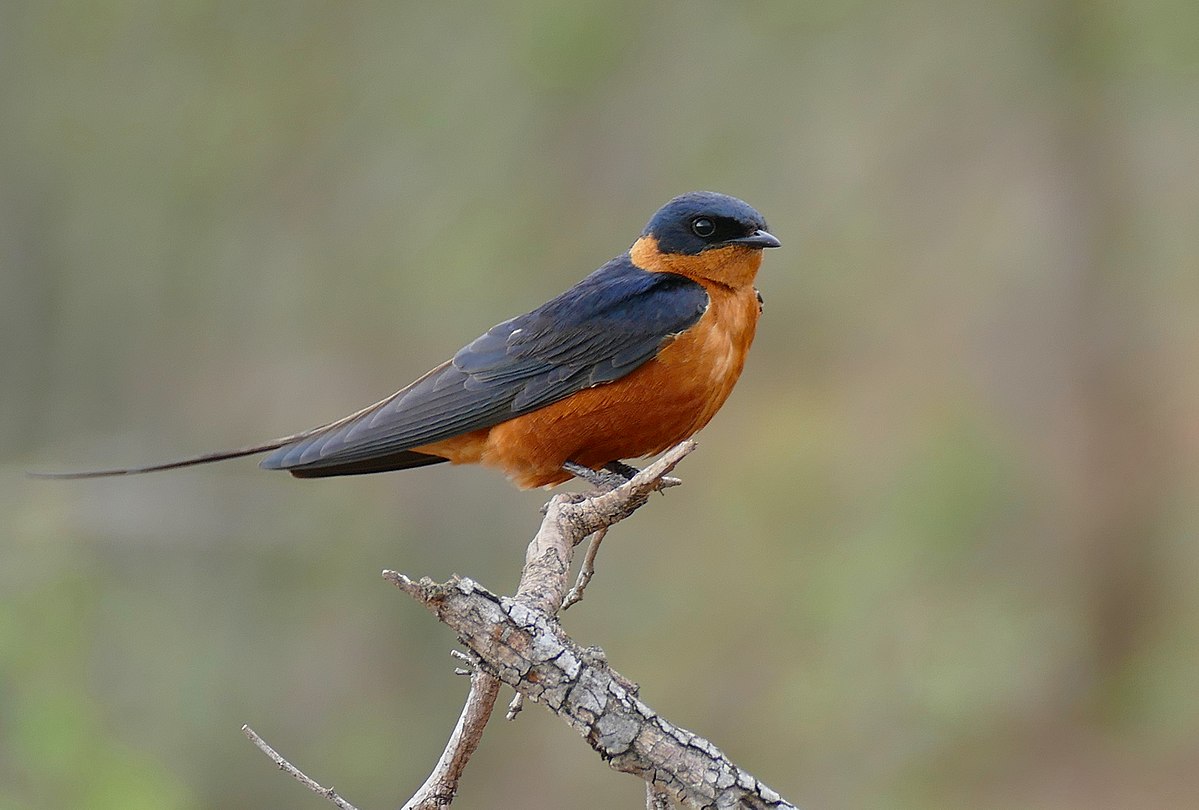
Wikipedia: Rufous-chested swallow Source: OTHER
1200px-Red-breasted_Swallow_%28Hirundo_semirufa%29_%2830987147586%29.jpg
![]() The red-breasted swallow (Cecropis semirufa), also known as the rufous-chested swallow, is a member of the family Hirundinidae, found in Sub-Saharan Africa. It is confined to the tropical rainforest during the wet season.
[more]
The red-breasted swallow (Cecropis semirufa), also known as the rufous-chested swallow, is a member of the family Hirundinidae, found in Sub-Saharan Africa. It is confined to the tropical rainforest during the wet season.
[more]
Profile Wikipedia eBird Xeno-Canto
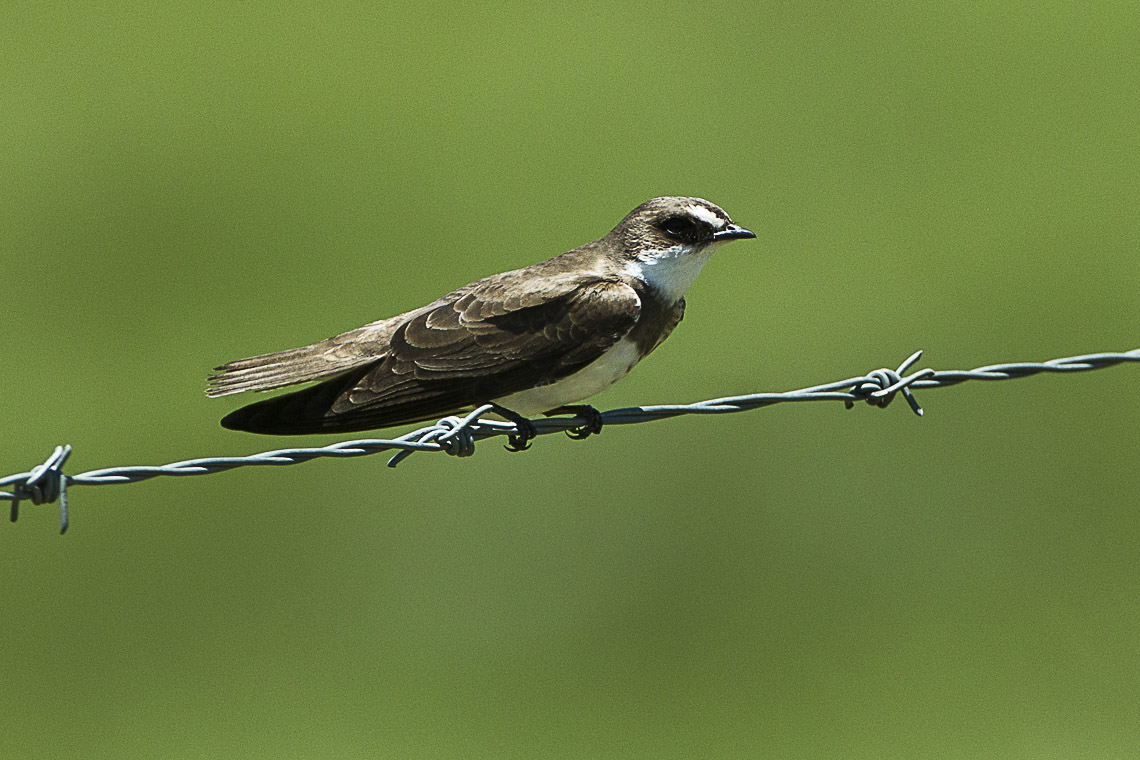
Wikipedia: Banded martin Source: OTHER
Banded_Martin_-_Natal_-_South_Africa_S4E6413_%2816792206620%29.jpg
![]() The banded martin or banded sand martin (Riparia cincta) is a small passerine bird in the swallow family Hirundinidae that is endemic to Africa.
[more]
The banded martin or banded sand martin (Riparia cincta) is a small passerine bird in the swallow family Hirundinidae that is endemic to Africa.
[more]
Profile Wikipedia eBird Xeno-Canto

Wikipedia: Black sawwing Source: OTHER
Black_Saw-wing.jpg
![]() The black saw-wing (Psalidoprocne pristoptera), also known as the blue saw-wing or black rough-winged swallow, is a small passerine bird in the swallow family.
[more]
The black saw-wing (Psalidoprocne pristoptera), also known as the blue saw-wing or black rough-winged swallow, is a small passerine bird in the swallow family.
[more]

Wikipedia: South African swallow Source: OTHER
1200px-South_African_cliff_swallow%2C_Petrochelidon_spilodera%2C_at_Suikerbosrand_Nature_Reserve%2C_Gauteng%2C_South_Africa_%2822747098474%29.jpg
![]() The South African cliff swallow (Petrochelidon spilodera), also known as the South African swallow, is a species of bird in the family Hirundinidae native to central−western and southern Africa.
[more]
The South African cliff swallow (Petrochelidon spilodera), also known as the South African swallow, is a species of bird in the family Hirundinidae native to central−western and southern Africa.
[more]
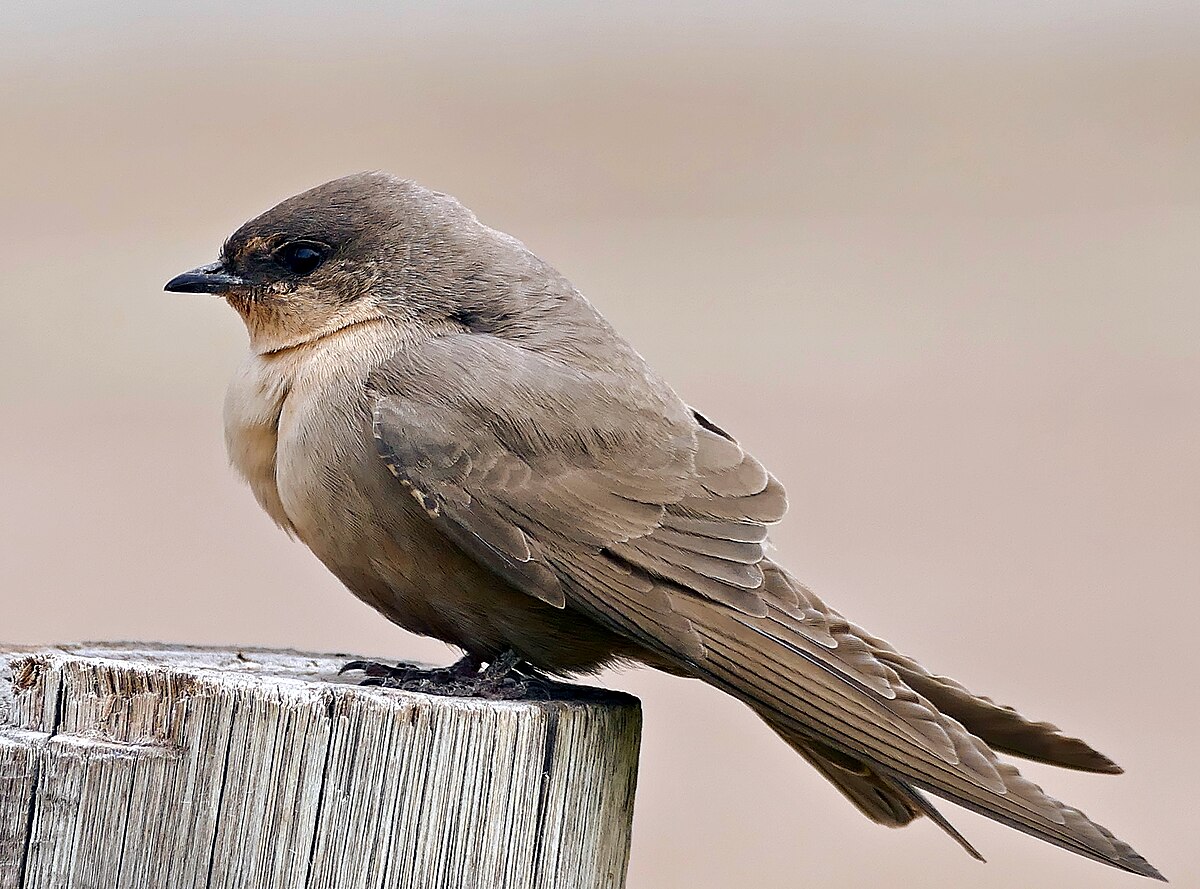
Wikipedia: Rock martin Source: OTHER
1200px-Rock_Martin_%28Hirundo_fuligula%29_%2832682255041%29.jpg
![]() The rock martin (Ptyonoprogne fuligula) is a small passerine bird in the swallow family that is resident in central and southern Africa. It breeds mainly in the mountains, but also at lower altitudes, especially in rocky areas and around towns, and, unlike most swallows, it is often found far from water. It is 12–15 cm (4.7–5.9 in) long, with mainly brown plumage, paler-toned on the upper breast and underwing coverts, and with white "windows" on the spread tail in flight. The sexes are similar in appearance, but juveniles have pale fringes to the upperparts and flight feathers. The former northern subspecies are smaller, paler, and whiter-throated than southern African forms, and are now usually split as a separate species, the pale crag martin. The rock martin hunts along cliff faces for flying insects using a slow flight with much gliding. Its call is a soft twitter.
[more]
The rock martin (Ptyonoprogne fuligula) is a small passerine bird in the swallow family that is resident in central and southern Africa. It breeds mainly in the mountains, but also at lower altitudes, especially in rocky areas and around towns, and, unlike most swallows, it is often found far from water. It is 12–15 cm (4.7–5.9 in) long, with mainly brown plumage, paler-toned on the upper breast and underwing coverts, and with white "windows" on the spread tail in flight. The sexes are similar in appearance, but juveniles have pale fringes to the upperparts and flight feathers. The former northern subspecies are smaller, paler, and whiter-throated than southern African forms, and are now usually split as a separate species, the pale crag martin. The rock martin hunts along cliff faces for flying insects using a slow flight with much gliding. Its call is a soft twitter.
[more]

Wikipedia: Grey-rumped swallow Source: OTHER
1200px-Pseudhirundo_griseopyga_Sharpe.jpg
![]() The grey-rumped swallow (Pseudhirundo griseopyga) is a species of bird in the monotypic genus, Pseudhirundo, in the family Hirundinidae.
[more]
The grey-rumped swallow (Pseudhirundo griseopyga) is a species of bird in the monotypic genus, Pseudhirundo, in the family Hirundinidae.
[more]
Profile Wikipedia eBird Xeno-Canto

Wikipedia: Short-clawed lark Source: OTHER
1200px-Certhilauda_chuana%2C_Pietersburg%2C_Kellermann%2C_a.jpg
![]() The short-clawed lark (Certhilauda chuana) or short-clawed bush-lark, is a species of lark in the family Alaudidae. It is found in Botswana and South Africa. Its natural habitat is dry savannah.
[more]
The short-clawed lark (Certhilauda chuana) or short-clawed bush-lark, is a species of lark in the family Alaudidae. It is found in Botswana and South Africa. Its natural habitat is dry savannah.
[more]
Profile Wikipedia eBird Xeno-Canto

Wikipedia: Cape lark Source: OTHER
1200px-Certhilauda_curvirostris_1838.jpg
![]() The Cape long-billed lark (Certhilauda curvirostris), also known as the Cape lark, Cape longbill or long-billed lark is a species of lark in the family Alaudidae. It is found in south-western Africa. Its natural habitats are semi-arid Karoo shrub and subtropical dry shrubland and subtropical or dry lowland and highveld grassland. This lark is also found in croplands, farmlands and coastal fynbos.
[more]
The Cape long-billed lark (Certhilauda curvirostris), also known as the Cape lark, Cape longbill or long-billed lark is a species of lark in the family Alaudidae. It is found in south-western Africa. Its natural habitats are semi-arid Karoo shrub and subtropical dry shrubland and subtropical or dry lowland and highveld grassland. This lark is also found in croplands, farmlands and coastal fynbos.
[more]
Profile Wikipedia eBird Xeno-Canto

Wikipedia: Agulhas lark Source: OTHER
Agulhas_Long-billed_Lark_%28Certhilauda_brevirostris%29_perched.jpg
![]() The Agulhas long-billed lark (Certhilauda brevirostris), also known as the Agulhas lark or Agulhas longbill is a small passerine bird. It is an endemic resident breeder in the Western Cape, South Africa. Its restricted range is centred on the Agulhas arable farmlands, from east of the Hottentots-Holland mountain range to Mossel Bay, and occupies a maximum of 15,000 km².
[more]
The Agulhas long-billed lark (Certhilauda brevirostris), also known as the Agulhas lark or Agulhas longbill is a small passerine bird. It is an endemic resident breeder in the Western Cape, South Africa. Its restricted range is centred on the Agulhas arable farmlands, from east of the Hottentots-Holland mountain range to Mossel Bay, and occupies a maximum of 15,000 km².
[more]
Profile Wikipedia eBird Xeno-Canto

Wikipedia: Eastern long-billed lark Source: OTHER
1200px-Eastern_Long-billed_Lark_%28Certhilauda_semitorquata%29_calling.jpg
![]() The eastern long-billed lark (Certhilauda semitorquata), also known as the Kaffrarian long-billed lark or Eastern longbill is a species of lark in the family Alaudidae. It is found in south-eastern Africa. Its natural habitat is subtropical or tropical dry lowland grassland.
[more]
The eastern long-billed lark (Certhilauda semitorquata), also known as the Kaffrarian long-billed lark or Eastern longbill is a species of lark in the family Alaudidae. It is found in south-eastern Africa. Its natural habitat is subtropical or tropical dry lowland grassland.
[more]
Profile Wikipedia eBird Xeno-Canto

Wikipedia: Karoo long-billed lark Source: OTHER
1200px-Karoo_Long-billed_Lark_%28Certhilauda_subcoronata%29_%2831737723963%29.jpg
![]() The Karoo long-billed lark (Certhilauda subcoronata) or Karoo longbill is a species of lark in the family Alaudidae. It is found in southern Africa in its natural habitat of subtropical or tropical dry shrubland.
[more]
The Karoo long-billed lark (Certhilauda subcoronata) or Karoo longbill is a species of lark in the family Alaudidae. It is found in southern Africa in its natural habitat of subtropical or tropical dry shrubland.
[more]
Profile Wikipedia eBird Xeno-Canto

Wikipedia: Black-eared sparrow-lark Source: OTHER
Eremopterix_australis_-Bushmanland%2C_South_Africa-8.jpg
![]() The black-eared sparrow-lark (Eremopterix australis) or black-eared finch lark is a species of lark in the family Alaudidae. It is found in southern Botswana, Namibia, and South Africa. Its natural habitats are subtropical or tropical dry shrubland and subtropical or tropical dry lowland grassland.
[more]
The black-eared sparrow-lark (Eremopterix australis) or black-eared finch lark is a species of lark in the family Alaudidae. It is found in southern Botswana, Namibia, and South Africa. Its natural habitats are subtropical or tropical dry shrubland and subtropical or tropical dry lowland grassland.
[more]
Profile Wikipedia eBird Xeno-Canto

Wikipedia: Chestnut-backed sparrow-lark Source: OTHER
1200px-Chestnut-backed_sparrow-lark_%28Eremopterix_leucotis_melanocephalus%29_male.jpg
![]() The chestnut-backed sparrow-lark (Eremopterix leucotis) is a passerine bird which is a resident breeder in Africa south of the Sahara Desert.
[more]
The chestnut-backed sparrow-lark (Eremopterix leucotis) is a passerine bird which is a resident breeder in Africa south of the Sahara Desert.
[more]

Wikipedia: Grey-backed sparrow-lark Source: OTHER
Eremopterix_verticalis_-Northern_Cape%2C_South_Africa_-male-8.jpg
![]() The grey-backed sparrow-lark (Eremopterix verticalis) or grey-backed finch-lark is a species of lark in the family Alaudidae. It is found in southern and south-central Africa. Its natural habitats are subtropical or tropical dry shrubland and subtropical or tropical dry lowland grassland. Sometimes, the name 'grey-backed sparrow-lark' is also used to describe the black-eared sparrow-lark.
[more]
The grey-backed sparrow-lark (Eremopterix verticalis) or grey-backed finch-lark is a species of lark in the family Alaudidae. It is found in southern and south-central Africa. Its natural habitats are subtropical or tropical dry shrubland and subtropical or tropical dry lowland grassland. Sometimes, the name 'grey-backed sparrow-lark' is also used to describe the black-eared sparrow-lark.
[more]
Profile Wikipedia eBird Xeno-Canto

Wikipedia: Large-billed lark Source: OTHER
Galerida_magnirostris_magnirostris%2C_De_Hoop-natuurreservaat%2C_Birding_Weto%2C_a.jpg
![]() The large-billed lark or southern thick-billed lark (Galerida magnirostris) is a small passerine bird found in southern Africa. The name "large-billed lark" may also refer to Bradfield's lark. The name "thick-billed lark" more commonly refers to the species of the same name (i.e. Rhamphocoris clotbey).
[more]
The large-billed lark or southern thick-billed lark (Galerida magnirostris) is a small passerine bird found in southern Africa. The name "large-billed lark" may also refer to Bradfield's lark. The name "thick-billed lark" more commonly refers to the species of the same name (i.e. Rhamphocoris clotbey).
[more]

Wikipedia: Red-capped lark Source: OTHER
1200px-Red-capped_lark%2C_Calandrella_cinerea%2C_at_Mapungubwe_National_Park%2C_Limpopo%2C_South_Africa_%2823514690044%29.jpg
![]() The red-capped lark, Calandrella cinerea, is a small passerine bird. This lark breeds in the highlands of eastern Africa southwards from Ethiopia and Somaliland. In the south, its range stretches across the continent to Angola and south to the Cape in South Africa.
[more]
The red-capped lark, Calandrella cinerea, is a small passerine bird. This lark breeds in the highlands of eastern Africa southwards from Ethiopia and Somaliland. In the south, its range stretches across the continent to Angola and south to the Cape in South Africa.
[more]
Profile Wikipedia eBird Xeno-Canto

Wikipedia: Cape clapper lark Source: OTHER
Mirafra_apiata_-Namaqua_National_Park%2C_South_Africa-8.jpg
![]() The Cape clapper lark (Mirafra apiata) is a small passerine bird which breeds in southern Africa. It derives its name from the wing clapping which forms part of the display flight. The Cape clapper lark is a species of open grassland and savannah, also inhabiting karoo, fynbos and fallow agricultural land.
[more]
The Cape clapper lark (Mirafra apiata) is a small passerine bird which breeds in southern Africa. It derives its name from the wing clapping which forms part of the display flight. The Cape clapper lark is a species of open grassland and savannah, also inhabiting karoo, fynbos and fallow agricultural land.
[more]
Profile Wikipedia eBird Xeno-Canto

Wikipedia: Flappet lark Source: OTHER
1200px-Flappet_Lark%2C_Sakania%2C_DR_Congo_%2816025285505%29%2C_crop.jpg
![]() The flappet lark (Mirafra rufocinnamomea) is a species of lark in the family Alaudidae, widespread across Sub-Saharan Africa.
[more]
The flappet lark (Mirafra rufocinnamomea) is a species of lark in the family Alaudidae, widespread across Sub-Saharan Africa.
[more]
Profile Wikipedia eBird Xeno-Canto

Wikipedia: Eastern clapper lark Source: OTHER
Eastern_clapper_lark_%28Mirafra_fasciolata_subsp_fasciolata%29%2C_crop.jpg
![]() The eastern clapper lark (Mirafra fasciolata) is a small passerine bird which breeds in southern Africa. It derives its name from the wing clapping which forms part of its display flight.
[more]
The eastern clapper lark (Mirafra fasciolata) is a small passerine bird which breeds in southern Africa. It derives its name from the wing clapping which forms part of its display flight.
[more]
Profile Wikipedia eBird Xeno-Canto

Wikipedia: Rufous-naped lark Source: OTHER
Mirafra_africana2.jpg
![]() The rufous-naped lark (Mirafra africana) or rufous-naped bush lark is a widespread and conspicuous species of lark in the lightly wooded grasslands, open savannas and farmlands of the Afrotropics. Males attract attention to themselves by their bold and repeated wing-fluttering displays from prominent perches, which is accompanied by a melodious and far-carrying whistled phrase.[2] This rudimentary display has been proposed as the precursor to the wing-clapping displays of other bush lark species.[3] They have consistently rufous outer wings and a short erectile crest,[2] but the remaining plumage hues and markings are individually and geographically variable. It has a straight lower, and longish, curved upper mandible.
[more]
The rufous-naped lark (Mirafra africana) or rufous-naped bush lark is a widespread and conspicuous species of lark in the lightly wooded grasslands, open savannas and farmlands of the Afrotropics. Males attract attention to themselves by their bold and repeated wing-fluttering displays from prominent perches, which is accompanied by a melodious and far-carrying whistled phrase.[2] This rudimentary display has been proposed as the precursor to the wing-clapping displays of other bush lark species.[3] They have consistently rufous outer wings and a short erectile crest,[2] but the remaining plumage hues and markings are individually and geographically variable. It has a straight lower, and longish, curved upper mandible.
[more]
Profile Wikipedia eBird Xeno-Canto

Wikipedia: Monotonous lark Source: OTHER
1200px-Mirafra_passerina.jpg
![]() The monotonous lark (Mirafra passerina) is a species of lark in the family Alaudidae found in southern Africa.
[more]
The monotonous lark (Mirafra passerina) is a species of lark in the family Alaudidae found in southern Africa.
[more]
Profile Wikipedia eBird Xeno-Canto

Wikipedia: Latakoo lark Source: OTHER
1200px-Mirafra_cheniana_cheniana_1838.jpg
![]() The melodious lark (Mirafra cheniana) is a species of lark in the family Alaudidae found in southern Africa. It is currently threatened by habitat loss.
[more]
The melodious lark (Mirafra cheniana) is a species of lark in the family Alaudidae found in southern Africa. It is currently threatened by habitat loss.
[more]
Profile Wikipedia eBird Xeno-Canto

Wikipedia: Pink-billed lark Source: OTHER
Pink-billed_Lark_%28Spizocorys_conirostris%29_%288077320401%29.jpg
![]() The pink-billed lark (Spizocorys conirostris) is a species of lark in the family Alaudidae found in southern Africa.
Its natural habitat is subtropical or tropical dry lowland grassland.
[more]
The pink-billed lark (Spizocorys conirostris) is a species of lark in the family Alaudidae found in southern Africa.
Its natural habitat is subtropical or tropical dry lowland grassland.
[more]
Profile Wikipedia eBird Xeno-Canto

Wikipedia: Stark's lark Source: OTHER
1200px-Stark%27s_Lark_001.jpg
![]() Stark's lark (Spizocorys starki) is a species of lark in the family Alaudidae. It is found in Angola, Botswana, Namibia, and South Africa. Its natural habitats are dry savannah and subtropical or tropical dry shrubland. Captain George Shelley named the species in honour of Arthur Stark.
[more]
Stark's lark (Spizocorys starki) is a species of lark in the family Alaudidae. It is found in Angola, Botswana, Namibia, and South Africa. Its natural habitats are dry savannah and subtropical or tropical dry shrubland. Captain George Shelley named the species in honour of Arthur Stark.
[more]
Profile Wikipedia eBird Xeno-Canto

Wikipedia: Sclater's lark Source: OTHER
1200px-Botha_Calandrella_Gronvold.jpg
![]() Sclater's lark (Spizocorys sclateri) is a species of lark in the family Alaudidae. It is found in Namibia and South Africa. Its natural habitat is subtropical or tropical dry shrubland. It is threatened by habitat loss.
[more]
Sclater's lark (Spizocorys sclateri) is a species of lark in the family Alaudidae. It is found in Namibia and South Africa. Its natural habitat is subtropical or tropical dry shrubland. It is threatened by habitat loss.
[more]

Wikipedia: Botha's lark Source: OTHER
1200px-Spizocorys_fringillaris_and_Mirafra_fasciolata_damarensis_1875_%28cropped%29.jpg
![]() Botha's lark (Spizocorys fringillaris) is a species of lark in the family Alaudidae.
[more]
Botha's lark (Spizocorys fringillaris) is a species of lark in the family Alaudidae.
[more]

Wikipedia: Spike-heeled lark Source: OTHER
1200px-Chersomanes_albofasciata_%28Etosha%29.jpg
![]() The spike-heeled lark (Chersomanes albofasciata) is a species of lark in the family Alaudidae.
It is found in southern Africa.[2]
[more]
The spike-heeled lark (Chersomanes albofasciata) is a species of lark in the family Alaudidae.
It is found in southern Africa.[2]
[more]

Wikipedia: Fawn-colored lark Source: OTHER
1200px-Fawn-coloured_lark_%28Calendulauda_africanoides_africanoides%29_2.jpg
![]() The fawn-coloured lark (Calendulauda africanoides) or fawn-coloured bush-lark is a species of lark in the family Alaudidae. It is found in south-central Africa.
[more]
The fawn-coloured lark (Calendulauda africanoides) or fawn-coloured bush-lark is a species of lark in the family Alaudidae. It is found in south-central Africa.
[more]

Wikipedia: Barlow's lark Source: OTHER
Calendulauda_barlowi_distribution_map.png
![]() Barlow's lark (Calendulauda barlowi) is a species of lark in the family Alaudidae. It is found in Namibia and South Africa where its natural habitat is subtropical or tropical dry shrubland. It is threatened by habitat loss.
[more]
Barlow's lark (Calendulauda barlowi) is a species of lark in the family Alaudidae. It is found in Namibia and South Africa where its natural habitat is subtropical or tropical dry shrubland. It is threatened by habitat loss.
[more]

Wikipedia: Sabota lark Source: OTHER
1200px-Sabota_Lark_%28Calendulauda_sabota%29_%2811421288184%29.jpg
![]() The sabota lark (Calendulauda sabota) is a species of lark in the family Alaudidae. It is found in southern Africa in its natural habitats of dry savannah, moist savannah, and subtropical or tropical dry shrubland.
[more]
The sabota lark (Calendulauda sabota) is a species of lark in the family Alaudidae. It is found in southern Africa in its natural habitats of dry savannah, moist savannah, and subtropical or tropical dry shrubland.
[more]

Wikipedia: Karoo lark Source: OTHER
Calendulauda_albescens.jpg
![]() The Karoo lark should not be confused with the similarly named Karoo long-billed lark.
[more]
The Karoo lark should not be confused with the similarly named Karoo long-billed lark.
[more]

Wikipedia: Red lark Source: OTHER
Certhilauda_burra_-near_Springbok%2C_Northern_Cape%2C_South_Africa-6.jpg
![]() The red lark (Calendulauda burra), also known as the ferruginous lark or ferruginous sand-lark, is a species of lark in the family Alaudidae. It is found in western South Africa and possibly Namibia. Its natural habitats are subtropical or tropical dry shrubland and subtropical or tropical dry lowland grassland. It is threatened by habitat loss.
[more]
The red lark (Calendulauda burra), also known as the ferruginous lark or ferruginous sand-lark, is a species of lark in the family Alaudidae. It is found in western South Africa and possibly Namibia. Its natural habitats are subtropical or tropical dry shrubland and subtropical or tropical dry lowland grassland. It is threatened by habitat loss.
[more]

Wikipedia: Rudd's lark Source: OTHER
Heteromirafra_ruddi%2C_Wakkerstroom%2C_Birding_Weto%2C_a.jpg
![]() Rudd's lark (Heteromirafra ruddi) is a species of lark in the family Alaudidae. It is endemic to South Africa. Its natural habitat is high-altitude grassland. It is threatened by habitat loss.
[more]
Rudd's lark (Heteromirafra ruddi) is a species of lark in the family Alaudidae. It is endemic to South Africa. Its natural habitat is high-altitude grassland. It is threatened by habitat loss.
[more]

Wikipedia: Dusky lark Source: OTHER
1200px-Dusky_Lark_%28Pinarocorys_nigricans%29_%286029254985%29_%28cropped%29.jpg
![]() The dusky lark (Pinarocorys nigricans), also known as the dusky bush lark or rufous-rumped bush lark, is a species of migratory lark in the family Alaudidae.[2] It is native to the southern Afrotropics.
[more]
The dusky lark (Pinarocorys nigricans), also known as the dusky bush lark or rufous-rumped bush lark, is a species of migratory lark in the family Alaudidae.[2] It is native to the southern Afrotropics.
[more]

Wikipedia: Piping cisticola Source: OTHER
1200px-Neddicky%2C_or_piping_cisticola%2C_Cisticola_fulvicapilla_at_Pilanesberg_National_Park%2C_Northwest_Province%2C_South_Africa_%2817454443855%29.jpg
![]() The neddicky, or piping cisticola (Cisticola fulvicapilla), is a small passerine bird in the family Cisticolidae, which is native to Africa, southwards of the equator. Its strongholds are the light woodlands and shrublands of the subtropics and temperate regions of southern Africa. The common name, neddicky, is the Afrikaans name for the species.
[more]
The neddicky, or piping cisticola (Cisticola fulvicapilla), is a small passerine bird in the family Cisticolidae, which is native to Africa, southwards of the equator. Its strongholds are the light woodlands and shrublands of the subtropics and temperate regions of southern Africa. The common name, neddicky, is the Afrikaans name for the species.
[more]
Profile Wikipedia eBird Xeno-Canto

Wikipedia: Red-faced cisticola Source: OTHER
Red-faced_Cisticola_%28Cisticola_erythrops%29.jpg
![]() The red-faced cisticola (Cisticola erythrops) is a species of bird in the family Cisticolidae. It is widely present across Sub-Saharan Africa (rare in southern Africa). Its natural habitats are subtropical or tropical seasonally wet or flooded lowland grassland and swamps.
[more]
The red-faced cisticola (Cisticola erythrops) is a species of bird in the family Cisticolidae. It is widely present across Sub-Saharan Africa (rare in southern Africa). Its natural habitats are subtropical or tropical seasonally wet or flooded lowland grassland and swamps.
[more]
Profile Wikipedia eBird Xeno-Canto

Wikipedia: Croaking cisticola Source: OTHER
1200px-Croaking_cisticola_%28Cisticola_natalensis%29.jpg
![]() The croaking cisticola (Cisticola natalensis) is an Old World warbler in the genus Cisticola. This genus is sometimes split off with various other southern warbler genera and given family status as the Cisticolidae.
[more]
The croaking cisticola (Cisticola natalensis) is an Old World warbler in the genus Cisticola. This genus is sometimes split off with various other southern warbler genera and given family status as the Cisticolidae.
[more]
Profile Wikipedia eBird Xeno-Canto

Wikipedia: Desert cisticola Source: OTHER
Desert_Cisticola_%28Cisticola_aridulus%29.jpg
![]() The desert cisticola (Cisticola aridulus) is a species of bird in the family Cisticolidae.
It is present throughout much of Sub-Saharan Africa, although relatively absent from central and coastal western areas of the continent.
[more]
The desert cisticola (Cisticola aridulus) is a species of bird in the family Cisticolidae.
It is present throughout much of Sub-Saharan Africa, although relatively absent from central and coastal western areas of the continent.
[more]

Wikipedia: Levaillant's cisticola Source: OTHER
Levaillant%27s_Cisticola_Cisticola_tinniens.jpg
![]() Levaillant's cisticola (Cisticola tinniens), also known as the tinkling cisticola, is a small passerine bird which is native to marshlands in the uplands of Africa, southwards of the equator.
[more]
Levaillant's cisticola (Cisticola tinniens), also known as the tinkling cisticola, is a small passerine bird which is native to marshlands in the uplands of Africa, southwards of the equator.
[more]
Profile Wikipedia eBird Xeno-Canto
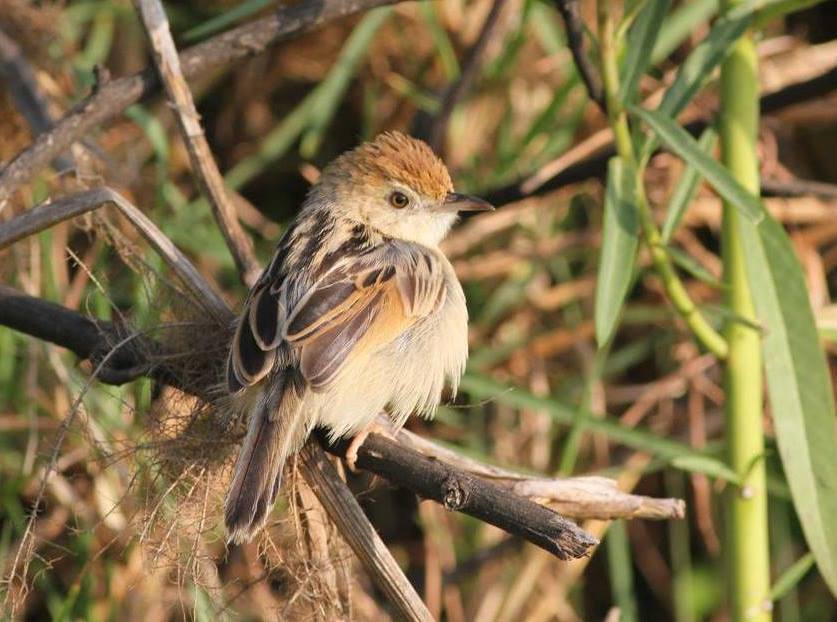
Wikipedia: Rufous-winged cisticola Source: OTHER
Cisticola_galactotes_subsp_isodactylus%2C_Pungwe-vloedvlakte%2C_Birding_Weto%2C_a.jpg
![]() The rufous-winged cisticola (Cisticola galactotes) is a species of bird in the family Cisticolidae. It is found on the east coast of southern Africa.[1][2]
[more]
The rufous-winged cisticola (Cisticola galactotes) is a species of bird in the family Cisticolidae. It is found on the east coast of southern Africa.[1][2]
[more]
Profile Wikipedia eBird Xeno-Canto

Wikipedia: Wailing cisticola Source: OTHER
Cisticola_lais_-Cedara%2C_KwaZulu-Natal%2C_South_Africa-8.jpg
![]() The wailing cisticola (Cisticola lais) is a species of bird in the family Cisticolidae. It is found in Angola, Lesotho, Malawi, Mozambique, South Africa, Swaziland, Tanzania, Zambia, and Zimbabwe. Its natural habitat is subtropical or tropical high-altitude grassland.
[more]
The wailing cisticola (Cisticola lais) is a species of bird in the family Cisticolidae. It is found in Angola, Lesotho, Malawi, Mozambique, South Africa, Swaziland, Tanzania, Zambia, and Zimbabwe. Its natural habitat is subtropical or tropical high-altitude grassland.
[more]
Profile Wikipedia eBird Xeno-Canto BirdID NABU
Zistensaenger in der Luft in Albufera. 2022-04-12 15.03.34 Mallorca
First observed in Mallorca on 2022-04-08.
![]() The zitting cisticola or streaked fantail warbler (Cisticola juncidis) is a widely distributed Old World warbler whose breeding range includes southern Europe, Africa (outside the deserts and rainforest), and southern Asia down to northern Australia. A small bird found mainly in grasslands, it is best identified by its rufous rump; as well, it lacks any gold on the collar and the brownish tail is tipped with white. During the breeding season, males have a zigzagging flight display accompanied by regular "zitting" calls that have been likened to repeated snips of a scissor. They build their pouch nest suspended within a clump of grass.
[more]
The zitting cisticola or streaked fantail warbler (Cisticola juncidis) is a widely distributed Old World warbler whose breeding range includes southern Europe, Africa (outside the deserts and rainforest), and southern Asia down to northern Australia. A small bird found mainly in grasslands, it is best identified by its rufous rump; as well, it lacks any gold on the collar and the brownish tail is tipped with white. During the breeding season, males have a zigzagging flight display accompanied by regular "zitting" calls that have been likened to repeated snips of a scissor. They build their pouch nest suspended within a clump of grass.
[more]
Song: ![]() Male song a diagnostic, monosyllabic, high-pitched "cist", repeated in an even rhythm about once every second, while in bounding song-flight or perched. [Link]
Male song a diagnostic, monosyllabic, high-pitched "cist", repeated in an even rhythm about once every second, while in bounding song-flight or perched. [Link]
Calls: ![]() Alarm call a short, clipping "witt", repeated in series. [Link]
Alarm call a short, clipping "witt", repeated in series. [Link]
Physical details: length=10 cm,
wingspan=12-14 cm,
weight=8-12 g
Song:
Automatically generated from Xeno-Canto recording
Song attributes:
Frequency:
♫ Source: BirdNet
20220408_144327 birdnet - Zistensänger - Zistensänger.mp3
2022-04-08 14.43.27 Mallorca (song)
Profile Wikipedia eBird Xeno-Canto

Wikipedia: Red-headed cisticola Source: OTHER
Cisticola_subruficapillus_-Namaqua_National_Park%2C_Northern_Cape%2C_South_Africa-6.jpg
General: ![]() The grey-backed cisticola or red-headed cisticola (Cisticola subruficapilla) is a small passerine bird. This cisticola is a resident breeder in southernmost Angola, Namibia and western South Africa.
[more]
The grey-backed cisticola or red-headed cisticola (Cisticola subruficapilla) is a small passerine bird. This cisticola is a resident breeder in southernmost Angola, Namibia and western South Africa.
[more]
Profile Wikipedia eBird Xeno-Canto

Wikipedia: Rock-loving cisticola Source: OTHER
Rock-loving_Cisticola_%28Cisticola_aberrans_minor%29.jpg
![]() The lazy cisticola (Cisticola aberrans) is a species of bird in the family Cisticolidae. It can be found mostly in Africa.
[more]
The lazy cisticola (Cisticola aberrans) is a species of bird in the family Cisticolidae. It can be found mostly in Africa.
[more]
Profile Wikipedia eBird Xeno-Canto

Wikipedia: Wing-snapping cisticola Source: OTHER
Wing-snapping_Cisticola_-_Kenya_S4E6079_%2817320718675%29.jpg
![]() The wing-snapping cisticola (Cisticola ayresii), also known as Ayres' cisticola, is a species of bird in the family Cisticolidae. Its scientific name honours South African ornithologist Thomas Ayres.
[more]
The wing-snapping cisticola (Cisticola ayresii), also known as Ayres' cisticola, is a species of bird in the family Cisticolidae. Its scientific name honours South African ornithologist Thomas Ayres.
[more]
Profile Wikipedia eBird Xeno-Canto

Wikipedia: Tinkling cisticola Source: OTHER
Hunter%27s_Cisticola_-_KenyaNH8O2433_%2816698263634%29.jpg
![]() The tinkling cisticola or grey cisticola (Cisticola rufilatus) is a species of bird in the family Cisticolidae. It is found in Angola, Botswana, Republic of the Congo, Democratic Republic of the Congo, Gabon, Malawi, Namibia, South Africa, Zambia, and Zimbabwe. Its natural habitat is dry savannah.
[more]
The tinkling cisticola or grey cisticola (Cisticola rufilatus) is a species of bird in the family Cisticolidae. It is found in Angola, Botswana, Republic of the Congo, Democratic Republic of the Congo, Gabon, Malawi, Namibia, South Africa, Zambia, and Zimbabwe. Its natural habitat is dry savannah.
[more]
Profile Wikipedia eBird Xeno-Canto

Wikipedia: Rattling cisticola Source: OTHER
Rattling_Cisticola_-_Kavango_-_Namibia0002_%2817320723895%29.jpg
![]() The rattling cisticola (Cisticola chiniana) is a species of bird in the family Cisticolidae which is native to Africa south of the equator, and parts of East Africa. It is a common to abundant species in open savanna and scrubland habitats, whether in arid, moist or upland regions. Especially during summer, it is highly conspicuous due to its strident and repetitive call-notes from prominent perches.[2]
[more]
The rattling cisticola (Cisticola chiniana) is a species of bird in the family Cisticolidae which is native to Africa south of the equator, and parts of East Africa. It is a common to abundant species in open savanna and scrubland habitats, whether in arid, moist or upland regions. Especially during summer, it is highly conspicuous due to its strident and repetitive call-notes from prominent perches.[2]
[more]
Profile Wikipedia eBird Xeno-Canto

Wikipedia: Pale-crowned cisticola Source: OTHER
Pale-crowned_Cisticola_%28Cisticola_cinnamomeus%29.jpg
![]() The pale-crowned cisticola (Cisticola cinnamomeus) is a species of bird in the family Cisticolidae.
[more]
The pale-crowned cisticola (Cisticola cinnamomeus) is a species of bird in the family Cisticolidae.
[more]
Profile Wikipedia eBird Xeno-Canto

Wikipedia: Cloud cisticola Source: OTHER
1200px-Cisticola_textrix_1838.jpg
![]() The cloud cisticola or tink-tink cisticola (Cisticola textrix) is a species of bird in the family Cisticolidae. It is found in Angola, Lesotho, Mozambique, South Africa, Swaziland, and Zambia, and its natural habitat is subtropical or tropical dry lowland grassland.
[more]
The cloud cisticola or tink-tink cisticola (Cisticola textrix) is a species of bird in the family Cisticolidae. It is found in Angola, Lesotho, Mozambique, South Africa, Swaziland, and Zambia, and its natural habitat is subtropical or tropical dry lowland grassland.
[more]
Profile Wikipedia eBird Xeno-Canto

Wikipedia: Drakensberg prinia Source: OTHER
Drakensberg_Prinia_-_South_Africa_S4E6311_%2817318861432%29.jpg
![]() The Drakensberg prinia or saffron-breasted prinia (Prinia hypoxantha) is a small passerine bird. It lives in eastern South Africa and Swaziland.
[more]
The Drakensberg prinia or saffron-breasted prinia (Prinia hypoxantha) is a small passerine bird. It lives in eastern South Africa and Swaziland.
[more]
Profile Wikipedia eBird Xeno-Canto
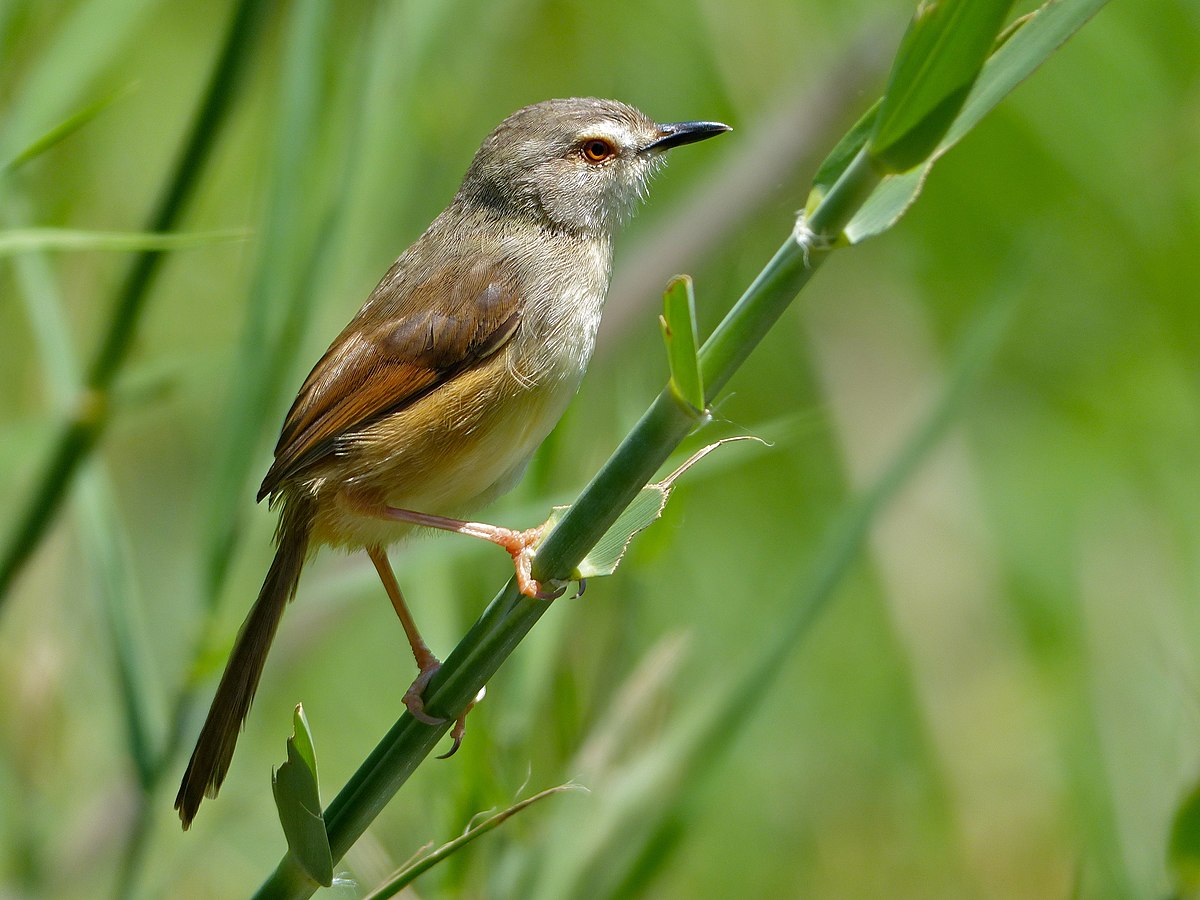
Wikipedia: Tawny-flanked prinia Source: OTHER
1200px-Tawny-flanked_Prinia_%28Prinia_subflava%29_%2811465162445%29.jpg
![]() The tawny-flanked prinia (Prinia subflava) is a small passerine bird belonging to the genus Prinia in the family Cisticolidae, a family of Old World warblers. It is widespread and common in most parts of Africa south of the Sahara. The plain prinia (P. inornata) of southern Asia was formerly included in this species but is now usually considered to be a separate species.
[more]
The tawny-flanked prinia (Prinia subflava) is a small passerine bird belonging to the genus Prinia in the family Cisticolidae, a family of Old World warblers. It is widespread and common in most parts of Africa south of the Sahara. The plain prinia (P. inornata) of southern Asia was formerly included in this species but is now usually considered to be a separate species.
[more]
Profile Wikipedia eBird Xeno-Canto

Wikipedia: Black-chested prinia Source: OTHER
1200px-Black-chested_prinia_%28Prinia_flavicans%29_breeding_female.jpg
![]() The black-chested prinia (Prinia flavicans) is a species of bird in the family Cisticolidae.
It is found in Angola, Botswana, Lesotho, Namibia, South Africa, Zambia, and Zimbabwe.
Its natural habitat is dry savanna.
[more]
The black-chested prinia (Prinia flavicans) is a species of bird in the family Cisticolidae.
It is found in Angola, Botswana, Lesotho, Namibia, South Africa, Zambia, and Zimbabwe.
Its natural habitat is dry savanna.
[more]
Profile Wikipedia eBird Xeno-Canto

Wikipedia: Karoo prinia Source: OTHER
1200px-Karoo_%28Spotted%29_Prinia_%2810537833606%29.jpg
![]() The Karoo prinia or spotted prinia (Prinia maculosa) is a small passerine bird. It is a resident breeder in South Africa, Lesotho and far southern Namibia.
[more]
The Karoo prinia or spotted prinia (Prinia maculosa) is a small passerine bird. It is a resident breeder in South Africa, Lesotho and far southern Namibia.
[more]
Profile Wikipedia eBird Xeno-Canto

Wikipedia: Green-backed camaroptera Source: OTHER
Green-backed_Cameroptera_-_Malawi_S4E3341_%2817142013720%29.jpg
![]() The green-backed camaroptera (Camaroptera brachyura), also known as the bleating camaroptera, is a small bird in the family Cisticolidae. This bird is a resident breeder in Africa south of the Sahara Desert. Recent studies suggest this species and the grey-backed camaroptera may be the same species.
[more]
The green-backed camaroptera (Camaroptera brachyura), also known as the bleating camaroptera, is a small bird in the family Cisticolidae. This bird is a resident breeder in Africa south of the Sahara Desert. Recent studies suggest this species and the grey-backed camaroptera may be the same species.
[more]

Wikipedia: Bar-throated apalis Source: OTHER
1200px-Bar-throated_Apalis%2C_Apalis_thoracica%2C_at_Marakele_National_Park%2C_Limpopo%2C_South_Africa_%2816216637960%29.jpg
![]() The bar-throated apalis (Apalis thoracica) is a small African passerine bird belonging to the genus Apalis of the family Cisticolidae. It is native to the eastern and southern Afrotropics.
[more]
The bar-throated apalis (Apalis thoracica) is a small African passerine bird belonging to the genus Apalis of the family Cisticolidae. It is native to the eastern and southern Afrotropics.
[more]
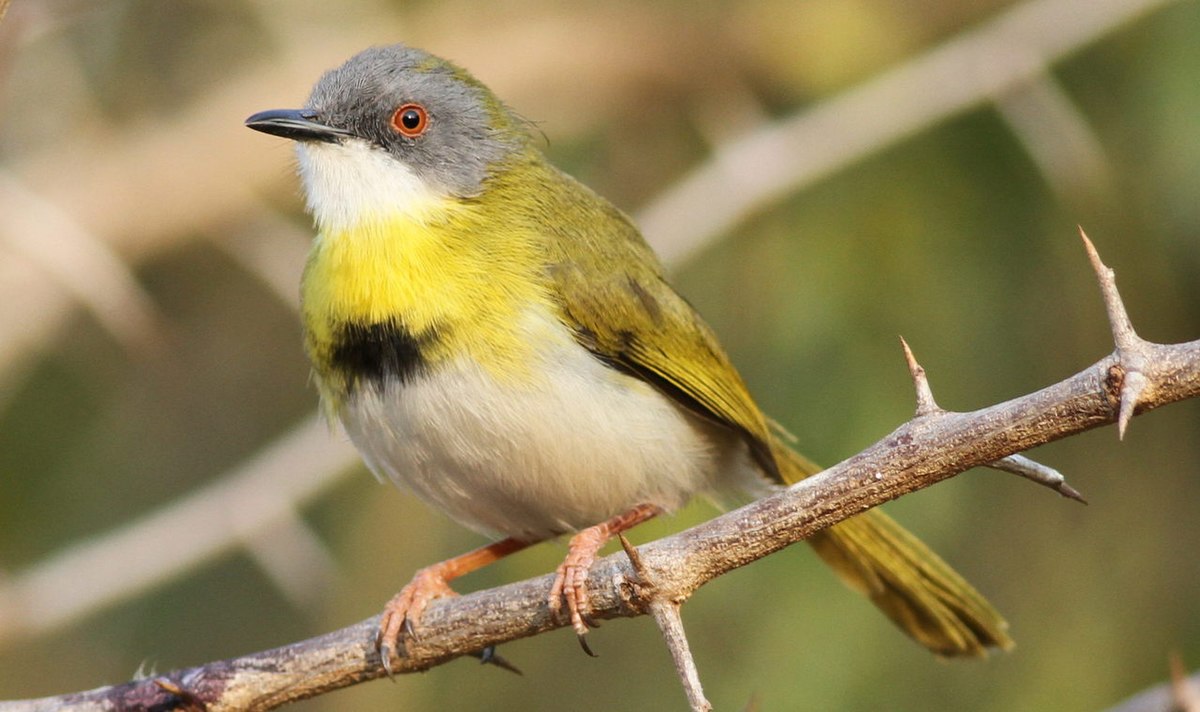
Wikipedia: Yellow-breasted apalis Source: OTHER
1200px-Yellow-breasted_apalis%2C_Apalis_flavida.jpg
![]() The yellow-breasted apalis (Apalis flavida) is a species of bird in the family Cisticolidae.
[more]
The yellow-breasted apalis (Apalis flavida) is a species of bird in the family Cisticolidae.
[more]
Profile Wikipedia eBird Xeno-Canto

Wikipedia: Rudd's apalis Source: OTHER
1200px-Rudd%27s_apalis%2C_Apalis_ruddi%2C_at_Ndumo_Nature_Reserve%2C_KwaZulu-Natal%2C_South_Africa_%2828319747984%29.jpg
![]() Rudd's apalis (Apalis ruddi) is a species of bird in the family Cisticolidae.
It is found primarily in Mozambique but also in southern Malawi and adjacent areas of South Africa and Swaziland.
Its natural habitats are subtropical or tropical dry forest and subtropical or tropical moist shrubland.
[more]
Rudd's apalis (Apalis ruddi) is a species of bird in the family Cisticolidae.
It is found primarily in Mozambique but also in southern Malawi and adjacent areas of South Africa and Swaziland.
Its natural habitats are subtropical or tropical dry forest and subtropical or tropical moist shrubland.
[more]
Profile Wikipedia eBird Xeno-Canto
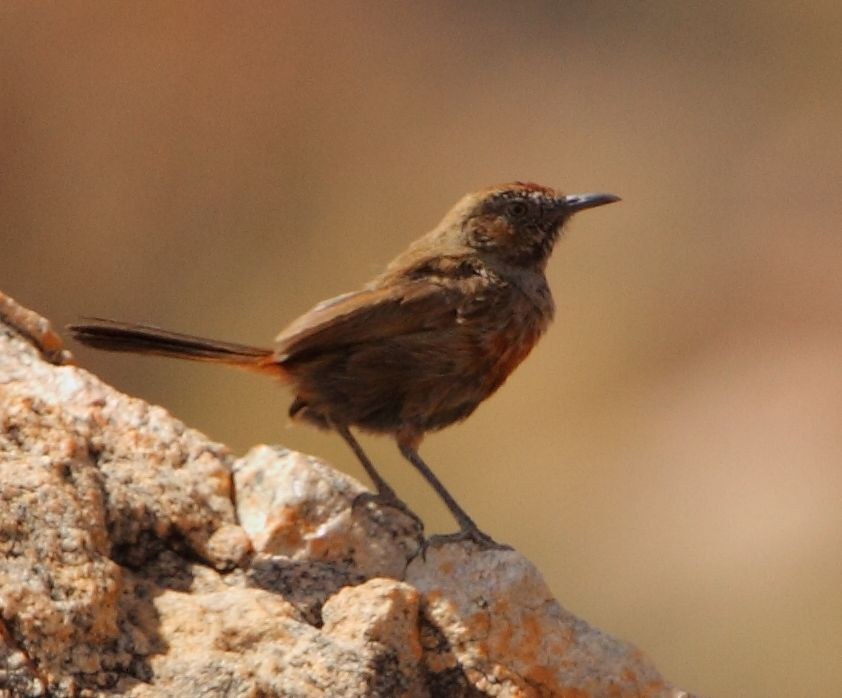
Wikipedia: Kopje warbler Source: OTHER
Euryptila_subcinnamomea_-near_Kamassies%2C_Kamiesberg%2C_Northern_Cape%2C_South_Africa-8.jpg
![]() The cinnamon-breasted warbler or kopje warbler (Euryptila subcinnamomea) is a species of bird in the family Cisticolidae. It is monotypic within the genus Euryptila.[2] It is found in Namibia and South Africa. Its natural habitat is subtropical or tropical dry shrubland.
[more]
The cinnamon-breasted warbler or kopje warbler (Euryptila subcinnamomea) is a species of bird in the family Cisticolidae. It is monotypic within the genus Euryptila.[2] It is found in Namibia and South Africa. Its natural habitat is subtropical or tropical dry shrubland.
[more]
Profile Wikipedia eBird Xeno-Canto

Wikipedia: Stierling's wren-warbler Source: OTHER
1200px-Naturalis_Biodiversity_Center_-_RMNH.AVES.37604_1_-_Calamonastes_stierlingi_stierlingi_Reichenow%2C_1901_-_Sylviidae_-_bird_skin_specimen.jpeg
![]() Stierling's wren-warbler (Calamonastes stierlingi), is a species of bird in the family Cisticolidae found in southern Africa. It is sometimes considered a subspecies of the miombo wren-warbler.
[more]
Stierling's wren-warbler (Calamonastes stierlingi), is a species of bird in the family Cisticolidae found in southern Africa. It is sometimes considered a subspecies of the miombo wren-warbler.
[more]
Profile Wikipedia eBird Xeno-Canto

Wikipedia: Barred wren-warbler Source: OTHER
1200px-Barred_wren-warbler%2C_Calamonastes_fasciolatus%2C_at_Pilanesberg_National_Park%2C_Northwest_Province%2C_South_Africa_%2816369976054%29.jpg
![]() The barred wren-warbler or southern barred warbler (Calamonastes fasciolatus) is a species of bird in the family Cisticolidae.
[more]
The barred wren-warbler or southern barred warbler (Calamonastes fasciolatus) is a species of bird in the family Cisticolidae.
[more]

Wikipedia: Rufous-eared warbler Source: OTHER
1200px-Rufous-eared_Warbler.jpg
![]() The rufous-eared warbler (Malcorus pectoralis) is a species of bird in the family Cisticolidae. It is found in Botswana, Namibia, and South Africa. It is the only species in the genus Malcorus.
Its natural habitats are subtropical or tropical dry shrubland and subtropical or tropical dry lowland grassland.
[more]
The rufous-eared warbler (Malcorus pectoralis) is a species of bird in the family Cisticolidae. It is found in Botswana, Namibia, and South Africa. It is the only species in the genus Malcorus.
Its natural habitats are subtropical or tropical dry shrubland and subtropical or tropical dry lowland grassland.
[more]

Wikipedia: Namaqua warbler Source: OTHER
Phragmacia_substriata%2C_Brandvlei%2C_Birding_Weto%2C_a.jpg
![]() The Namaqua warbler (Phragmacia substriata), also known as the Namaqua prinia or white-breasted prinia, is a small passerine bird, a cisticolid warbler and the sole member of the genus Phragmacia. It was formerly placed in the genus Prinia, but was found to be sufficiently distinct to warrant a genus of its own.
[more]
The Namaqua warbler (Phragmacia substriata), also known as the Namaqua prinia or white-breasted prinia, is a small passerine bird, a cisticolid warbler and the sole member of the genus Phragmacia. It was formerly placed in the genus Prinia, but was found to be sufficiently distinct to warrant a genus of its own.
[more]
Profile Wikipedia eBird Xeno-Canto

Wikipedia: Yellow-throated woodland-warbler Source: OTHER
Yellow-Throated_Woodland-Warbler_%28Phylloscopus_ruficapilla%29.jpg
![]() The yellow-throated woodland warbler (Phylloscopus ruficapilla) is a species of Old World warbler (the family Phylloscopidae). It is found in Kenya, Malawi, Mozambique, South Africa, Swaziland, Tanzania, Zambia, and Zimbabwe. Its natural habitats are subtropical or tropical dry forest and subtropical or tropical moist lowland forest.
[more]
The yellow-throated woodland warbler (Phylloscopus ruficapilla) is a species of Old World warbler (the family Phylloscopidae). It is found in Kenya, Malawi, Mozambique, South Africa, Swaziland, Tanzania, Zambia, and Zimbabwe. Its natural habitats are subtropical or tropical dry forest and subtropical or tropical moist lowland forest.
[more]

Wikipedia: Arrow-marked babbler Source: OTHER
1200px-Arrow-marked_Babbler%2CTurdoides_jardineii%2C_at_Hwange_National_Park%2C_Zimbabwe_%2835097040664%29.jpg
![]() The arrow-marked babbler (Turdoides jardineii) is a species of bird in the family Leiothrichidae. It is native to woodlands in the southern Afrotropics.
[more]
The arrow-marked babbler (Turdoides jardineii) is a species of bird in the family Leiothrichidae. It is native to woodlands in the southern Afrotropics.
[more]
Profile Wikipedia eBird Xeno-Canto
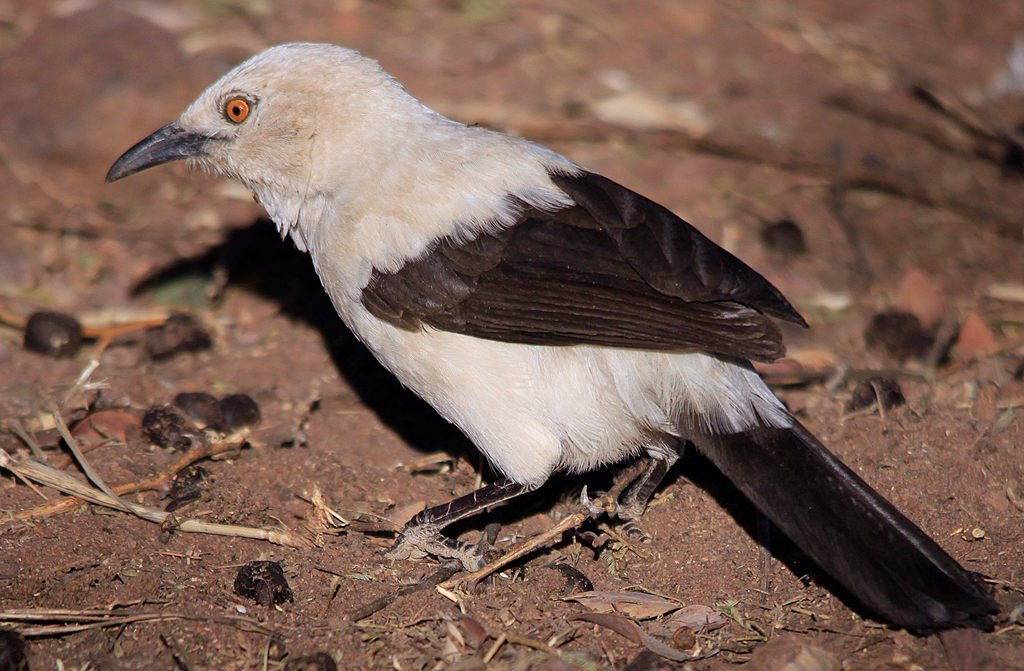
Wikipedia: Southern pied-babbler Source: OTHER
Southern_Pied_Babbler.jpg
![]() The southern pied babbler (Turdoides bicolor) is a species of bird in the family Leiothrichidae, found in dry savannah of Botswana, Namibia, South Africa, and Zimbabwe.
[more]
The southern pied babbler (Turdoides bicolor) is a species of bird in the family Leiothrichidae, found in dry savannah of Botswana, Namibia, South Africa, and Zimbabwe.
[more]

Wikipedia: Eurasian river warbler Source: OTHER
Flodsangare.jpg
![]() The river warbler (Locustella fluviatilis) is an Old World warbler in the grass warbler genus Locustella. It breeds in east and central Europe into the western Palearctic. It is migratory, wintering in inland southern Africa, from around the Zambezi River south to the vicinity of Pretoria in South Africa. The genus name Locustella is from Latin and is a diminutive of locusta, "grasshopper".[2] This refers to the song of the common grasshopper warbler and some others in this genus.[3] The specific fluviatilis is Latin for "of a river".[2]
[more]
The river warbler (Locustella fluviatilis) is an Old World warbler in the grass warbler genus Locustella. It breeds in east and central Europe into the western Palearctic. It is migratory, wintering in inland southern Africa, from around the Zambezi River south to the vicinity of Pretoria in South Africa. The genus name Locustella is from Latin and is a diminutive of locusta, "grasshopper".[2] This refers to the song of the common grasshopper warbler and some others in this genus.[3] The specific fluviatilis is Latin for "of a river".[2]
[more]
Song: ![]() Song an insectlike, buzzing like Grasshopper and Savi's Warbler, but easily distinguished from those by it's distinct steam locomotive-like rhythm. About 8 accents per second. Perhaps easier to confuse with certain species of ground crickets or cicadas than it's congeners. [Link]
Song an insectlike, buzzing like Grasshopper and Savi's Warbler, but easily distinguished from those by it's distinct steam locomotive-like rhythm. About 8 accents per second. Perhaps easier to confuse with certain species of ground crickets or cicadas than it's congeners. [Link]
Calls: ![]() Contact call a sharp "tsikk-tsikk", similar to Savi's Warbler. [Link]
Contact call a sharp "tsikk-tsikk", similar to Savi's Warbler. [Link]
Physical details: length=13 cm,
wingspan=19-22 cm,
weight=15-19 g
Profile Wikipedia eBird Xeno-Canto

Wikipedia: Knysna warbler Source: OTHER
BradypterusSylvaticusSmit.jpg
General: ![]() The Knysna warbler or Knysna scrub warbler (Bradypterus sylvaticus) is a very shy and cryptic warbler, endemic to the coastal regions of South Africa.[2] Its population is small and probably declining, due to natural and artificial fragmentation of its habitat, and limited dispersal and reproductive ability.[3]
[more]
The Knysna warbler or Knysna scrub warbler (Bradypterus sylvaticus) is a very shy and cryptic warbler, endemic to the coastal regions of South Africa.[2] Its population is small and probably declining, due to natural and artificial fragmentation of its habitat, and limited dispersal and reproductive ability.[3]
[more]

Wikipedia: African bush-warbler Source: OTHER
African_Bush-Warbler_-_South_Africa_S4E7737_%2816708155164%29%2C_crop.jpg
![]() The little rush warbler or African bush warbler (Bradypterus baboecala) is a species of Old World warbler in the family Locustellidae.
[more]
The little rush warbler or African bush warbler (Bradypterus baboecala) is a species of Old World warbler in the family Locustellidae.
[more]
Profile Wikipedia eBird Xeno-Canto

Wikipedia: Fan-tailed grassbird Source: OTHER
Schoenicola_brevirostris_2.jpg
![]() The fan-tailed grassbird or broad-tailed warbler (Catriscus brevirostris) is an African species of Old World warbler in the family Locustellidae. The species is closely related to the broad-tailed grassbird of India, and is sometimes treated as the same species,[2] although a 2018 study found that it and broad-tailed grassbird were not closely related with the Indian species being a sister of Chaetornis striata.[3]
[more]
The fan-tailed grassbird or broad-tailed warbler (Catriscus brevirostris) is an African species of Old World warbler in the family Locustellidae. The species is closely related to the broad-tailed grassbird of India, and is sometimes treated as the same species,[2] although a 2018 study found that it and broad-tailed grassbird were not closely related with the Indian species being a sister of Chaetornis striata.[3]
[more]
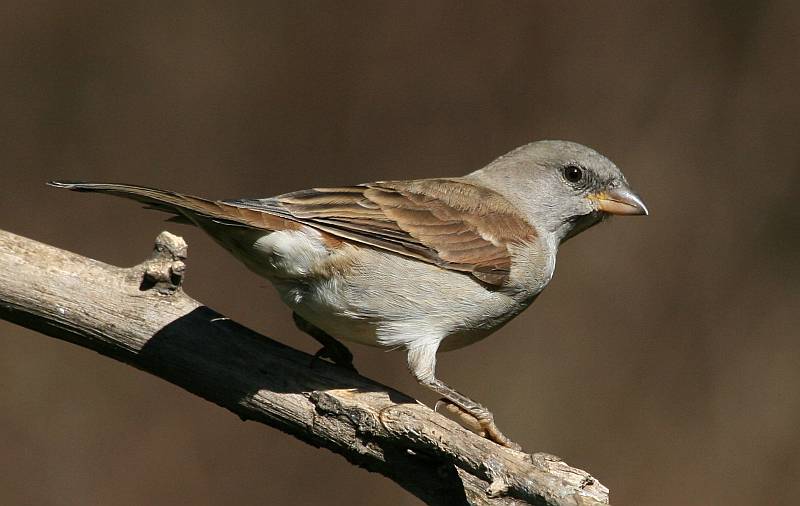
Wikipedia: Southern grey-headed sparrow Source: OTHER
Southern_Grey-headed_Sparrow_%28Passer_diffusus%29.jpg
![]() The southern grey-headed sparrow (Passer diffusus) is a passerine bird of the sparrow family Passeridae. It is sometimes treated as a subspecies of the grey-headed sparrow. It is found in savanna and woodland in Angola and Zambia southwards into South Africa, where it is expanding its range[2] and is kept as a caged bird, like its relative the white-rumped seedeater.[citation needed]
[more]
The southern grey-headed sparrow (Passer diffusus) is a passerine bird of the sparrow family Passeridae. It is sometimes treated as a subspecies of the grey-headed sparrow. It is found in savanna and woodland in Angola and Zambia southwards into South Africa, where it is expanding its range[2] and is kept as a caged bird, like its relative the white-rumped seedeater.[citation needed]
[more]
Profile Wikipedia eBird Xeno-Canto

Wikipedia: Great rufous sparrow Source: OTHER
Great_Sparrow.jpg
![]() The great sparrow (Passer motitensis), also known as the southern rufous sparrow, is found in southern Africa in dry, wooded savannah and towns.[1][3]
[more]
The great sparrow (Passer motitensis), also known as the southern rufous sparrow, is found in southern Africa in dry, wooded savannah and towns.[1][3]
[more]
Profile Wikipedia eBird Xeno-Canto
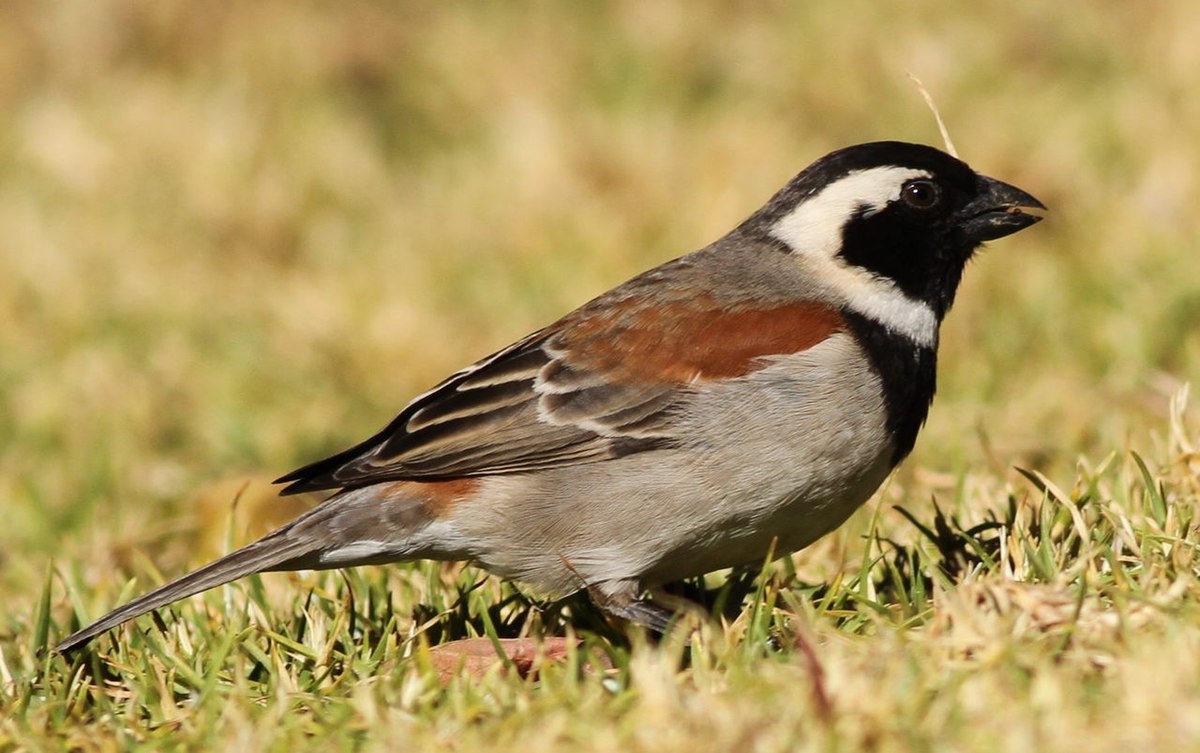
Wikipedia: Cape sparrow Source: OTHER
1200px-Cape_Sparrow%2C_Passer_melanurus_at_Walter_Sisulu_National_Botanical_Garden%2C_Johannesburg%2C_South_Africa_%2814727921265%29.jpg
![]() The Cape sparrow (Passer melanurus), or mossie, is a bird of the sparrow family Passeridae found in southern Africa. A medium-sized sparrow at 14–16 centimetres (5.5–6.3 in), it has distinctive plumage, including large pale head stripes in both sexes. Its plumage is mostly grey, brown, and chestnut, and the male has some bold black and white markings on its head and neck. The species inhabits semi-arid savannah, cultivated areas, and towns, and ranges from the central coast of Angola to eastern South Africa and Swaziland. Three subspecies are distinguished in different parts of its range.
[more]
The Cape sparrow (Passer melanurus), or mossie, is a bird of the sparrow family Passeridae found in southern Africa. A medium-sized sparrow at 14–16 centimetres (5.5–6.3 in), it has distinctive plumage, including large pale head stripes in both sexes. Its plumage is mostly grey, brown, and chestnut, and the male has some bold black and white markings on its head and neck. The species inhabits semi-arid savannah, cultivated areas, and towns, and ranges from the central coast of Angola to eastern South Africa and Swaziland. Three subspecies are distinguished in different parts of its range.
[more]
Profile Wikipedia eBird Xeno-Canto

Wikipedia: White-browed sparrow-weaver Source: OTHER
1200px-Plocepasser_mahali_-Baringo_Lake%2C_Kenya_-male-8.jpg
![]() The white-browed sparrow-weaver (Plocepasser mahali) is a predominantly brown, sparrow-sized bird found throughout central and north-central southern Africa.[2] It is found in groups of two to eleven individuals consisting of one breeding pair and other non-reproductive individuals.
[more]
The white-browed sparrow-weaver (Plocepasser mahali) is a predominantly brown, sparrow-sized bird found throughout central and north-central southern Africa.[2] It is found in groups of two to eleven individuals consisting of one breeding pair and other non-reproductive individuals.
[more]

Wikipedia: Parasitic weaver Source: OTHER
Parasitic_Weaver_%28Anomalospiza_imberbis%29.jpg
![]() The cuckoo-finch (Anomalospiza imberbis), also known as the parasitic weaver or cuckoo weaver, is a small passerine bird now placed in the family Viduidae with the indigobirds and whydahs. It occurs in grassland in Africa south of the Sahara. The male is mainly yellow and green while the female is buff with dark streaks. The eggs are laid in the nests of other birds.[2]
[more]
The cuckoo-finch (Anomalospiza imberbis), also known as the parasitic weaver or cuckoo weaver, is a small passerine bird now placed in the family Viduidae with the indigobirds and whydahs. It occurs in grassland in Africa south of the Sahara. The male is mainly yellow and green while the female is buff with dark streaks. The eggs are laid in the nests of other birds.[2]
[more]
Profile Wikipedia eBird Xeno-Canto
Sossusvlei - Sociable weaver eating crumbs. 2016-09-06 10.41.12 Namibia
First observed in Namibia on 2016-09-06.
![]() The sociable weaver (Philetairus socius) is a species of bird in the weaver family that is endemic to southern Africa.[2] It is the only species in the monotypic genus Philetairus. It is found in South Africa, Namibia, and Botswana.[1] but their range is centered within the Northern Cape Province of South Africa.[3] They build large compound community nests, a rarity among birds. These nests are perhaps the most spectacular structure built by any bird.[4]
[more]
The sociable weaver (Philetairus socius) is a species of bird in the weaver family that is endemic to southern Africa.[2] It is the only species in the monotypic genus Philetairus. It is found in South Africa, Namibia, and Botswana.[1] but their range is centered within the Northern Cape Province of South Africa.[3] They build large compound community nests, a rarity among birds. These nests are perhaps the most spectacular structure built by any bird.[4]
[more]

Wikipedia: Yellow-throated bush sparrow Source: OTHER
1200px-Petronia_superciliaris.jpg
![]() The yellow-throated bush sparrow (Gymnoris superciliaris), also known as the yellow-throated petronia,[2] is a species of bird in the sparrow family Passeridae. It is found in south-central and southern Africa in its natural habitats of subtropical or tropical dry forests, dry savanna, and subtropical or tropical dry shrubland.
[more]
The yellow-throated bush sparrow (Gymnoris superciliaris), also known as the yellow-throated petronia,[2] is a species of bird in the sparrow family Passeridae. It is found in south-central and southern Africa in its natural habitats of subtropical or tropical dry forests, dry savanna, and subtropical or tropical dry shrubland.
[more]
Profile Wikipedia eBird Xeno-Canto

Wikipedia: Black-headed canary Source: OTHER
Serinus_alario_-near_Rooifontein%2C_Northern_Cape%2C_South_Africa_-male-8.jpg
![]() The black-headed canary (Serinus alario) is a species of finch found in Lesotho, Namibia and South Africa. It is sometimes placed in the genus Alario as Alario alario
[more]
The black-headed canary (Serinus alario) is a species of finch found in Lesotho, Namibia and South Africa. It is sometimes placed in the genus Alario as Alario alario
[more]
Profile Wikipedia eBird Xeno-Canto

Wikipedia: Cape canary Source: OTHER
Cape_Canary_%28Serinus_canicollis%29_1.jpg
![]() The Cape canary (Serinus canicollis) is a small passerine bird in the finch family. It is a resident breeder in southern Africa and has been introduced to Mauritius and Réunion.
[more]
The Cape canary (Serinus canicollis) is a small passerine bird in the finch family. It is a resident breeder in southern Africa and has been introduced to Mauritius and Réunion.
[more]

Wikipedia: Lark-like bunting Source: OTHER
1200px-Lark-like_bunting_%28Emberiza_impetuani_impetuani%29.jpg
![]() The lark-like bunting (Emberiza impetuani) is a species of bird in the family Emberizidae, which is native to south-western Africa.
[more]
The lark-like bunting (Emberiza impetuani) is a species of bird in the family Emberizidae, which is native to south-western Africa.
[more]
Profile Wikipedia eBird Xeno-Canto

Wikipedia: Golden-breasted bunting Source: OTHER
Emberiza_flaviventris_-Hluhluwe-Umfolozi_Game_Reserve%2C_South_Africa-8.jpg
![]() The golden-breasted bunting (Emberiza flaviventris) is a passerine bird in the bunting family Emberizidae. It occurs in dry open woodlands and moist savanna in Africa south of the Sahara, but is absent from the equatorial forest belt.
[more]
The golden-breasted bunting (Emberiza flaviventris) is a passerine bird in the bunting family Emberizidae. It occurs in dry open woodlands and moist savanna in Africa south of the Sahara, but is absent from the equatorial forest belt.
[more]
Profile Wikipedia eBird Xeno-Canto

Wikipedia: Cape bunting Source: OTHER
Cape_Bunting%2C_Emberiza_capensis_at_Suikerbosrand_Nature_Reserve%2C_Gauteng%2C_South_Africa.jpg
![]() The Cape bunting (Emberiza capensis) is a passerine bird in the bunting family Emberizidae.
[more]
The Cape bunting (Emberiza capensis) is a passerine bird in the bunting family Emberizidae.
[more]

Wikipedia: Brimstone canary Source: OTHER
Brimstone_Canary_-_Uganda_H8O4066_%2822647799309%29.jpg
![]() The brimstone canary or bully canary (Crithagra sulphurata) is a small passerine bird in the finch family. It is a resident breeder in central and southern Africa.
[more]
The brimstone canary or bully canary (Crithagra sulphurata) is a small passerine bird in the finch family. It is a resident breeder in central and southern Africa.
[more]
Profile Wikipedia eBird Xeno-Canto

Wikipedia: Protea canary Source: OTHER
CrithagraLeucopteraHart.jpg
![]() The protea canary (Crithagra leucoptera), also known as the protea seedeater, white-winged seedeater or Layard's seedeater, is a small passerine bird in the finch family.
[more]
The protea canary (Crithagra leucoptera), also known as the protea seedeater, white-winged seedeater or Layard's seedeater, is a small passerine bird in the finch family.
[more]
Profile Wikipedia eBird Xeno-Canto

Wikipedia: Lemon-breasted seedeater Source: OTHER
1200px-Lemon-breasted_canary%2C_Crithagra_citrinipectus%2C_near_Pafuri_in_Kruger_National_Park%2C_South_Africa.jpg
![]() The lemon-breasted canary (Crithagra citrinipectus), also known as the lemon-breasted seedeater, is a species of finch in the family Fringillidae. It is found in Malawi, Mozambique, South Africa, Zambia, and Zimbabwe. Its natural habitats are dry savannah, subtropical or tropical dry shrubland, and rural gardens.
[more]
The lemon-breasted canary (Crithagra citrinipectus), also known as the lemon-breasted seedeater, is a species of finch in the family Fringillidae. It is found in Malawi, Mozambique, South Africa, Zambia, and Zimbabwe. Its natural habitats are dry savannah, subtropical or tropical dry shrubland, and rural gardens.
[more]

Wikipedia: Yellow canary Source: OTHER
Serinus_flaviventris_-Great_Karoo%2C_Northern_Cape%2C_South_Africa_-adult_male-8.jpg
![]() The yellow canary (Crithagra flaviventris) is a small passerine bird in the finch family. It is a resident breeder in much of the western and central regions of southern Africa and has been introduced to Ascension and St Helena islands.
[more]
The yellow canary (Crithagra flaviventris) is a small passerine bird in the finch family. It is a resident breeder in much of the western and central regions of southern Africa and has been introduced to Ascension and St Helena islands.
[more]
Profile Wikipedia eBird Xeno-Canto

Wikipedia: Streaky-headed seedeater Source: OTHER
Streaky-headed_Seedeater_%28Serinus_gularis%29.jpg
![]() The streaky-headed seedeater or streaky-headed canary (Crithagra gularis) is a small passerine bird in the finch family. It is a common resident breeder in suitable habitats in southern Africa.
[more]
The streaky-headed seedeater or streaky-headed canary (Crithagra gularis) is a small passerine bird in the finch family. It is a common resident breeder in suitable habitats in southern Africa.
[more]
Profile Wikipedia eBird Xeno-Canto

Wikipedia: Drakensberg siskin Source: OTHER
Male_Drakensberg_Siskin_2019_01_27_10_25_20_1129cr.jpg
![]() The Drakensberg siskin (Crithagra symonsi) is a small passerine bird in the finch family. It is an endemic resident breeder in the eastern Cape Province Transkei and western Natal in South Africa, and in Lesotho.
[more]
The Drakensberg siskin (Crithagra symonsi) is a small passerine bird in the finch family. It is an endemic resident breeder in the eastern Cape Province Transkei and western Natal in South Africa, and in Lesotho.
[more]
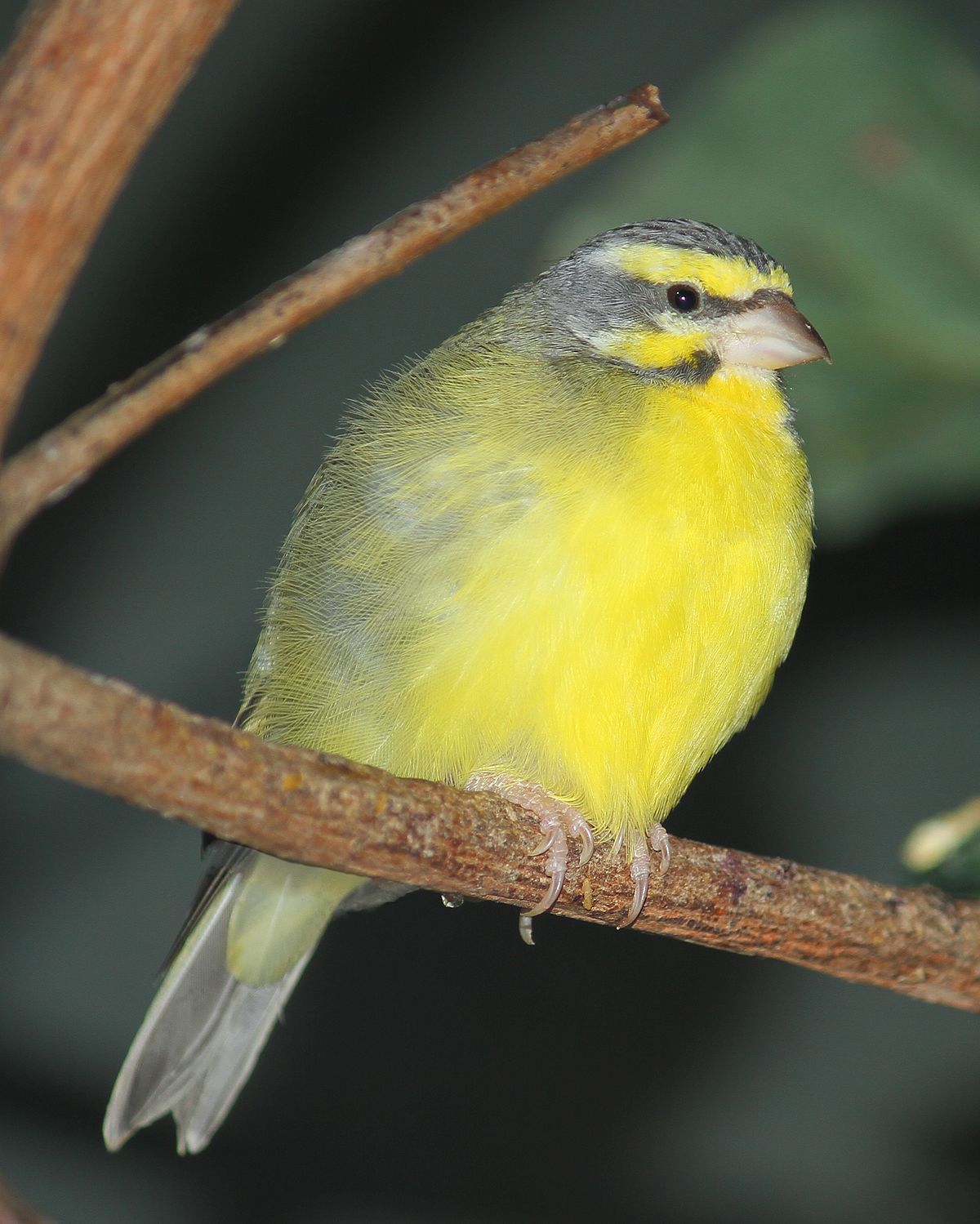
Wikipedia: Yellow-fronted canary Source: OTHER
1200px-Serinus_masambicus_25.jpg
This bird appears across the great seas in the following continents:
North America, Africa.
![]() The yellow-fronted canary (Crithagra mozambica), also called the yellow-eyed canary, is a small passerine bird in the finch family. It is known elsewhere and in aviculture as the green singing finch.
[more]
The yellow-fronted canary (Crithagra mozambica), also called the yellow-eyed canary, is a small passerine bird in the finch family. It is known elsewhere and in aviculture as the green singing finch.
[more]
Profile Wikipedia eBird Xeno-Canto

Wikipedia: White-throated canary Source: OTHER
1200px-White-throated_canary_%28Crithagra_albogularis_crocopygia%29%2C_crop.jpg
![]() The white-throated canary (Crithagra albogularis) is a species of finch in the family Fringillidae.
[more]
The white-throated canary (Crithagra albogularis) is a species of finch in the family Fringillidae.
[more]
Profile Wikipedia eBird Xeno-Canto

Wikipedia: Black-throated canary Source: OTHER
Canary_Black-throated_2012_01_15_08_09_00_4016.jpg
![]() The black-throated canary (Crithagra atrogularis), also known as the black-throated seedeater, is a species of finch in the family Fringillidae.
[more]
The black-throated canary (Crithagra atrogularis), also known as the black-throated seedeater, is a species of finch in the family Fringillidae.
[more]
Profile Wikipedia eBird Xeno-Canto

Wikipedia: Yellow-tufted pipit Source: OTHER
1200px-Naturalis_Biodiversity_Center_-_RMNH.AVES.123245_1_-_Anthus_crenatus_Finsch_%26_Hartlaub%2C_1870_-_Motacillidae_-_bird_skin_specimen.jpeg
![]() The African rock pipit (Anthus crenatus), also known as the yellow-tufted pipit, is a species of bird in the family Motacillidae. It is found in the high-altitude, rocky grasslands of South Africa and Lesotho.[2]
[more]
The African rock pipit (Anthus crenatus), also known as the yellow-tufted pipit, is a species of bird in the family Motacillidae. It is found in the high-altitude, rocky grasslands of South Africa and Lesotho.[2]
[more]

Wikipedia: Red-throated pipit Source: OTHER
1200px-Red-throated_Pipit.jpg
This bird appears across the great seas in the following continents:
Europe, North America, Africa, Asia.
![]() The red-throated pipit (Anthus cervinus) is a small passerine bird which breeds in the far north of Europe and the Palearctic, with a foothold in northern Alaska. It is a long-distance migrant moving in winter to Africa, south and east Asia and west coast United States. It is a vagrant to western Europe.
[more]
The red-throated pipit (Anthus cervinus) is a small passerine bird which breeds in the far north of Europe and the Palearctic, with a foothold in northern Alaska. It is a long-distance migrant moving in winter to Africa, south and east Asia and west coast United States. It is a vagrant to western Europe.
[more]
Profile Wikipedia eBird Xeno-Canto

Wikipedia: Plain-backed pipit Source: OTHER
Plain-backed_Pipit_-_Tanzania_0025_%2816999610272%29.jpg
![]() The plain-backed pipit or plain pipit (Anthus leucophrys) is a medium-sized passerine bird which is a resident breeder in Africa south of the Sahara Desert.
[more]
The plain-backed pipit or plain pipit (Anthus leucophrys) is a medium-sized passerine bird which is a resident breeder in Africa south of the Sahara Desert.
[more]
Profile Wikipedia eBird Xeno-Canto

Wikipedia: Short-tailed pipit Source: OTHER
Short-tailed_Pipit_2012_02_08_9427.jpg
![]() The short-tailed pipit (Anthus brachyurus) is a species of bird in the family Motacillidae.
It is found in Angola, Burundi, Republic of the Congo, Democratic Republic of the Congo, Gabon, Mozambique, Rwanda, Somalia, South Africa, Tanzania, Uganda, Zambia, and Zimbabwe.
Its natural habitats are subtropical or tropical dry lowland grassland and subtropical or tropical seasonally wet or flooded lowland grassland.
[more]
The short-tailed pipit (Anthus brachyurus) is a species of bird in the family Motacillidae.
It is found in Angola, Burundi, Republic of the Congo, Democratic Republic of the Congo, Gabon, Mozambique, Rwanda, Somalia, South Africa, Tanzania, Uganda, Zambia, and Zimbabwe.
Its natural habitats are subtropical or tropical dry lowland grassland and subtropical or tropical seasonally wet or flooded lowland grassland.
[more]
Profile Wikipedia eBird Xeno-Canto

Wikipedia: Buffy pipit Source: OTHER
Buffy_Pipit_2010_12_07_00469.jpg
![]() The buffy pipit (Anthus vaalensis) is a species of bird in the Motacillidae family. It is found in plains and open countryside in southern and eastern Africa. The IUCN has assessed its conservation status as being of least concern.
[more]
The buffy pipit (Anthus vaalensis) is a species of bird in the Motacillidae family. It is found in plains and open countryside in southern and eastern Africa. The IUCN has assessed its conservation status as being of least concern.
[more]
Profile Wikipedia eBird Xeno-Canto

Wikipedia: Long-billed pipit Source: OTHER
Long-billed_pipit.jpg
![]() The long-billed pipit or brown rock pipit (Anthus similis) is a passerine bird which has a wide distribution. A number of subspecies have been created for the populations in Africa, through the Arabian peninsula and South Asia. The systematics of this complex is yet to be clarified. Most birds are residents or short distance migrants.
[more]
The long-billed pipit or brown rock pipit (Anthus similis) is a passerine bird which has a wide distribution. A number of subspecies have been created for the populations in Africa, through the Arabian peninsula and South Asia. The systematics of this complex is yet to be clarified. Most birds are residents or short distance migrants.
[more]
Profile Wikipedia eBird Xeno-Canto

Wikipedia: Striped pipit Source: OTHER
Pipit_Striped_Alan_Manson_2011_06_18_ItalaGR.jpg
![]() The striped pipit (Anthus lineiventris) is a species of bird in the family Motacillidae, which is native to Africa southwards of the equator.
[more]
The striped pipit (Anthus lineiventris) is a species of bird in the family Motacillidae, which is native to Africa southwards of the equator.
[more]
Profile Wikipedia eBird Xeno-Canto

Wikipedia: African pipit Source: OTHER
African_Pipit%2C_Anthus_cinnamomeus_%28I_presume%29_%2812388148433%29.jpg
![]() The African pipit (Anthus cinnamomeus) is a fairly small passerine bird belonging to the pipit genus Anthus in the family Motacillidae. It is also known as the grassveld pipit or grassland pipit. It was formerly lumped together with the Richard's, Australasian, mountain and paddyfield pipits in a single species, Richard's pipit (Anthus novaeseelandiae), but is now often treated as a species in its own right.
[more]
The African pipit (Anthus cinnamomeus) is a fairly small passerine bird belonging to the pipit genus Anthus in the family Motacillidae. It is also known as the grassveld pipit or grassland pipit. It was formerly lumped together with the Richard's, Australasian, mountain and paddyfield pipits in a single species, Richard's pipit (Anthus novaeseelandiae), but is now often treated as a species in its own right.
[more]
Profile Wikipedia eBird Xeno-Canto

Wikipedia: Mountain pipit Source: OTHER
Mountain_Pipit_-_Natal_-_South_Africa_S4E7209_%2816378615434%29.jpg
![]() The mountain pipit (Anthus hoeschi) is a species of bird in the family Motacillidae.
[more]
The mountain pipit (Anthus hoeschi) is a species of bird in the family Motacillidae.
[more]
Profile Wikipedia eBird Xeno-Canto

Wikipedia: Bush pipit Source: OTHER
Pipit_Bushveld_2014_10_18_MkhuzeGR_9249.jpg
![]() The bushveld pipit, bush pipit or little pipit (Anthus caffer) is a species of bird in the pipit and wagtail family Motacillidae. It is found in Angola, Botswana, Ethiopia, Kenya, Malawi, Mozambique, South Africa, Swaziland, Tanzania, Zambia, and Zimbabwe. Its natural habitats are subtropical or tropical dry forests and dry savanna.
[more]
The bushveld pipit, bush pipit or little pipit (Anthus caffer) is a species of bird in the pipit and wagtail family Motacillidae. It is found in Angola, Botswana, Ethiopia, Kenya, Malawi, Mozambique, South Africa, Swaziland, Tanzania, Zambia, and Zimbabwe. Its natural habitats are subtropical or tropical dry forests and dry savanna.
[more]

Wikipedia: Cape wagtail Source: OTHER
1200px-Cape_wagtail_%28Motacilla_capensis%29.jpg
![]() The Cape wagtail (Motacilla capensis), also known as Wells's wagtail, is a small insectivorous bird which is widespread in southern Africa. It frequents water's edge, lawns and gardens. It is a mostly resident, territorial species, but has been known to undertake limited altitudinal migration or form flocks outside of the breeding season.[3] Like other wagtails they are passerine birds of the family Motacillidae, which also includes the pipits and longclaws.
[more]
The Cape wagtail (Motacilla capensis), also known as Wells's wagtail, is a small insectivorous bird which is widespread in southern Africa. It frequents water's edge, lawns and gardens. It is a mostly resident, territorial species, but has been known to undertake limited altitudinal migration or form flocks outside of the breeding season.[3] Like other wagtails they are passerine birds of the family Motacillidae, which also includes the pipits and longclaws.
[more]
Profile Wikipedia eBird Xeno-Canto BirdID NABU

Wikipedia: Citrine wagtail Source: OTHER
Citrine_Wagtail_%28Motacilla_citreola%29-_Breeding_Male_of_calcarata_race_at_Bharatpur_I_IMG_5752.jpg
![]() The citrine wagtail (Motacilla citreola) is a small songbird in the family Motacillidae.
[more]
The citrine wagtail (Motacilla citreola) is a small songbird in the family Motacillidae.
[more]
Song: ![]() The song is a loose repetition of phrases, comprised of disyllabic or monosyllabic contact calls. [Link]
The song is a loose repetition of phrases, comprised of disyllabic or monosyllabic contact calls. [Link]
Calls: ![]() Contact call resembles Yellow Wagtail, but is harsher with a more buzzing quality, and of shorter duration. The pitch is more constant, lacking the rise and fall of Yellow Wagtail. [Link]
Contact call resembles Yellow Wagtail, but is harsher with a more buzzing quality, and of shorter duration. The pitch is more constant, lacking the rise and fall of Yellow Wagtail. [Link]
Physical details: length=17 cm,
wingspan=24-27 cm,
weight=18-25 g
Profile Wikipedia eBird Xeno-Canto

Wikipedia: Mountain wagtail Source: OTHER
1200px-Mountain_wagtail%2C_Motacilla_clara.jpg
General: ![]() The mountain wagtail (Motacilla clara), also known as the long-tailed wagtail or grey-backed wagtail, is a species of wagtail of the family Motacillidae from sub-Saharan Africa.[2]
[more]
The mountain wagtail (Motacilla clara), also known as the long-tailed wagtail or grey-backed wagtail, is a species of wagtail of the family Motacillidae from sub-Saharan Africa.[2]
[more]
Profile Wikipedia eBird Xeno-Canto

Wikipedia: African pied wagtail Source: OTHER
1200px-African_pied_wagtail_%28Motacilla_aguimp_vidua%29.jpg
![]() The African pied wagtail, or African wagtail, (Motacilla aguimp) is a species of bird in the family Motacillidae.
[more]
The African pied wagtail, or African wagtail, (Motacilla aguimp) is a species of bird in the family Motacillidae.
[more]
Profile Wikipedia eBird Xeno-Canto

Wikipedia: Orange-throated longclaw Source: OTHER
1200px-Cape_Longclaw_%28Macronyx_capensis%29_%2831320650481%29.jpg
![]() The Cape longclaw or orange-throated longclaw (Macronyx capensis) is a passerine bird in the family Motacillidae, which comprises the longclaws, pipits and wagtails.[2] It occurs in Southern Africa in Zimbabwe and southern and eastern South Africa. This species is found in coastal and mountain grassland, often near water.[2]
[more]
The Cape longclaw or orange-throated longclaw (Macronyx capensis) is a passerine bird in the family Motacillidae, which comprises the longclaws, pipits and wagtails.[2] It occurs in Southern Africa in Zimbabwe and southern and eastern South Africa. This species is found in coastal and mountain grassland, often near water.[2]
[more]
Profile Wikipedia eBird Xeno-Canto
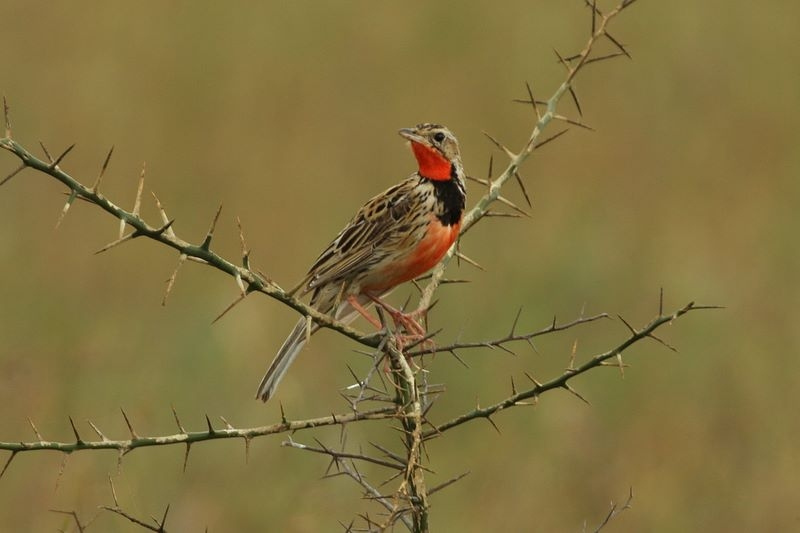
Wikipedia: Rosy-throated longclaw Source: OTHER
Macronyx_ameliae_-East_Africa-8.jpg
![]() The rosy-throated longclaw, also known as the rosy-breasted longclaw (Macronyx ameliae) is a species of bird in the family Motacillidae. It is found in Angola, Botswana, Democratic Republic of the Congo, Kenya, Malawi, Mozambique, Namibia, South Africa, Tanzania, Zambia, and Zimbabwe. Its natural habitat is subtropical or tropical seasonally wet or flooded lowland grassland.[1]
[more]
The rosy-throated longclaw, also known as the rosy-breasted longclaw (Macronyx ameliae) is a species of bird in the family Motacillidae. It is found in Angola, Botswana, Democratic Republic of the Congo, Kenya, Malawi, Mozambique, Namibia, South Africa, Tanzania, Zambia, and Zimbabwe. Its natural habitat is subtropical or tropical seasonally wet or flooded lowland grassland.[1]
[more]
Profile Wikipedia eBird Xeno-Canto

Wikipedia: Yellow-throated longclaw Source: OTHER
1200px-Serengeti_Gelbkehlpieper1.jpg
![]() The yellow-throated longclaw (Macronyx croceus) is a species of bird in the family Motacillidae. It is found in Angola, Benin, Burkina Faso, Burundi, Cameroon, Central African Republic, Chad, Republic of the Congo, Democratic Republic of the Congo, Ivory Coast, Gabon, Gambia, Ghana, Guinea, Guinea-Bissau, Kenya, Lesotho, Liberia, Malawi, Mali, Mozambique, Niger, Nigeria, Rwanda, Senegal, Sierra Leone, Somalia, South Africa, South Sudan, Swaziland, Tanzania, Togo, Uganda, Zambia, and Zimbabwe. Its natural habitats are dry savanna, subtropical or tropical seasonally wet or flooded lowland grassland, and sandy shores.
[more]
The yellow-throated longclaw (Macronyx croceus) is a species of bird in the family Motacillidae. It is found in Angola, Benin, Burkina Faso, Burundi, Cameroon, Central African Republic, Chad, Republic of the Congo, Democratic Republic of the Congo, Ivory Coast, Gabon, Gambia, Ghana, Guinea, Guinea-Bissau, Kenya, Lesotho, Liberia, Malawi, Mali, Mozambique, Niger, Nigeria, Rwanda, Senegal, Sierra Leone, Somalia, South Africa, South Sudan, Swaziland, Tanzania, Togo, Uganda, Zambia, and Zimbabwe. Its natural habitats are dry savanna, subtropical or tropical seasonally wet or flooded lowland grassland, and sandy shores.
[more]
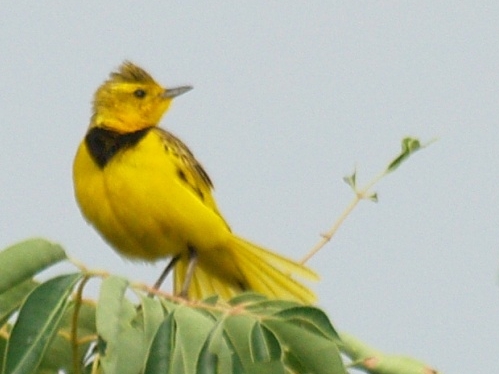
Wikipedia: Golden pipit Source: OTHER
Pipit_Golden_by_Mark_Tittley.jpg
![]() The golden pipit (Tmetothylacus tenellus) is a distinctive pipit of dry country grassland, savanna and shrubland in eastern Africa. It is native to Ethiopia, Kenya, Somalia, South Sudan, Tanzania and Uganda, and has occurred as a vagrant to Oman, South Africa and Zimbabwe.[1]
[more]
The golden pipit (Tmetothylacus tenellus) is a distinctive pipit of dry country grassland, savanna and shrubland in eastern Africa. It is native to Ethiopia, Kenya, Somalia, South Sudan, Tanzania and Uganda, and has occurred as a vagrant to Oman, South Africa and Zimbabwe.[1]
[more]

Wikipedia: Queen whydah Source: OTHER
Whydah_Shaft-tailed_2007_0107_1225_15AA.jpg
![]() The shaft-tailed whydah or queen whydah (Vidua regia) is a small, sparrow-like bird in the genus Vidua. During the breeding season the male has black crown and upper body plumage, golden breast and four elongated black tail shaft feathers with expanded tips. After the breeding season is over, the male sheds its long tail and grows olive brown female-like plumage.
[more]
The shaft-tailed whydah or queen whydah (Vidua regia) is a small, sparrow-like bird in the genus Vidua. During the breeding season the male has black crown and upper body plumage, golden breast and four elongated black tail shaft feathers with expanded tips. After the breeding season is over, the male sheds its long tail and grows olive brown female-like plumage.
[more]
Profile Wikipedia eBird Xeno-Canto

Wikipedia: Broad-tailed paradise-whydah Source: OTHER
Vidua_obtusa_male.jpg
![]() The broad-tailed paradise whydah (Vidua obtusa) is a species of bird in the family Viduidae.[2] It is found woodland and acacia savanna habitat in Sub-Saharan Africa from Angola to Uganda, Tanzania and Mozambique. A brood parasite, it has a wide range and the International Union for Conservation of Nature has assessed it as being of least concern.
[more]
The broad-tailed paradise whydah (Vidua obtusa) is a species of bird in the family Viduidae.[2] It is found woodland and acacia savanna habitat in Sub-Saharan Africa from Angola to Uganda, Tanzania and Mozambique. A brood parasite, it has a wide range and the International Union for Conservation of Nature has assessed it as being of least concern.
[more]
Profile Wikipedia eBird Audubon AllAboutBirds Xeno-Canto
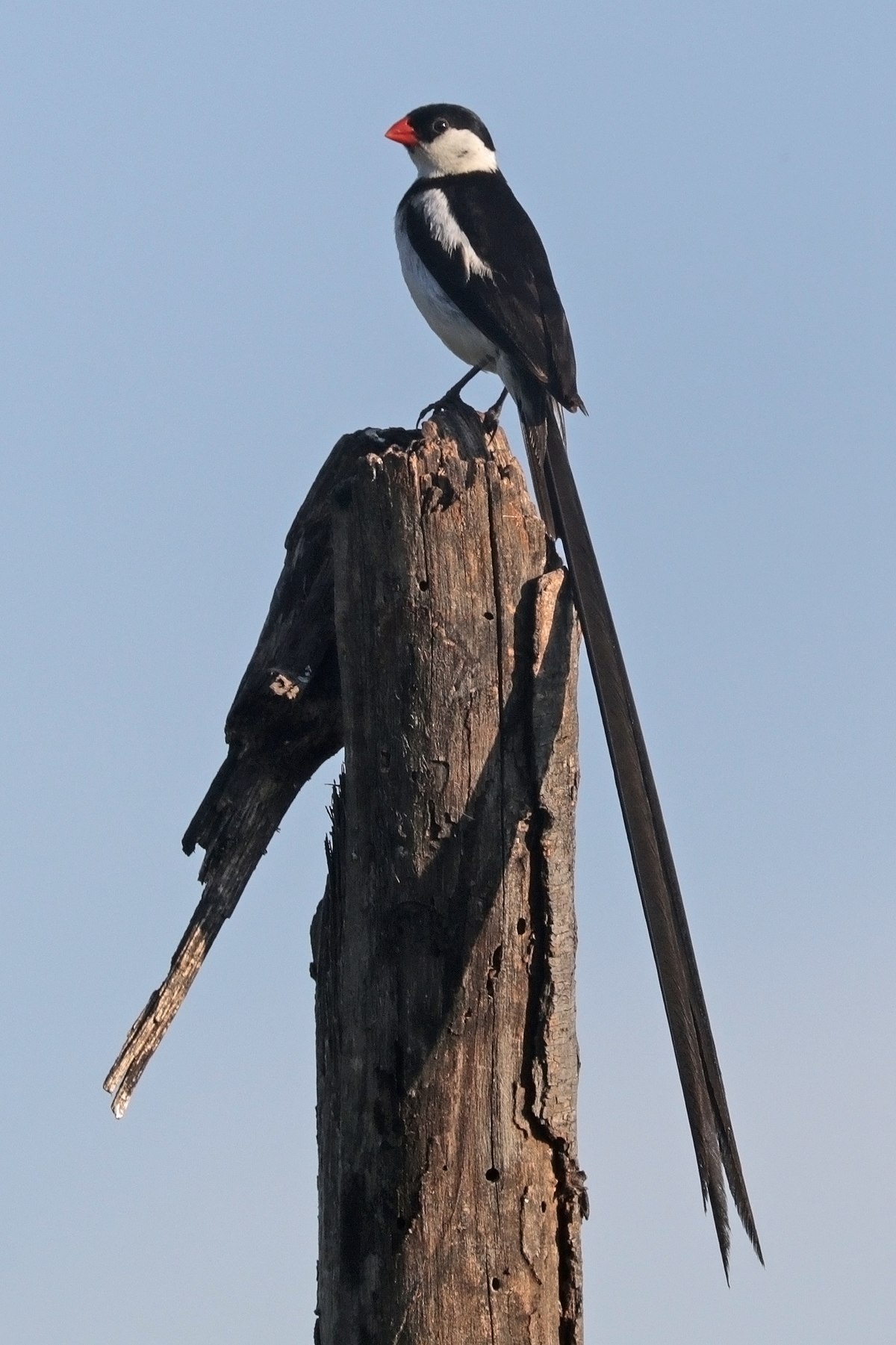
Wikipedia: Pin-tailed whydah Source: OTHER
1200px-Pin-tailed_whydah_%28Vidua_macroura%29_breeding_male.jpg
This bird appears across the great seas in the following continents:
North America, Africa.
![]() The pin-tailed whydah (Vidua macroura) is a small songbird with a conspicuous pennant-like tail in breeding males. It is a resident breeding bird in most of Africa south of the Sahara Desert.
[more]
The pin-tailed whydah (Vidua macroura) is a small songbird with a conspicuous pennant-like tail in breeding males. It is a resident breeding bird in most of Africa south of the Sahara Desert.
[more]
Profile Wikipedia eBird Xeno-Canto

Wikipedia: Village indigobird Source: OTHER
1200px-Village_indigobird%2C_Vidua_chalybeata%2C_at_Mapungubwe_National_Park%2C_Limpopo%2C_South_Africa_%28male%29_%2817849716130%29.jpg
![]() The village indigobird or the steelblue widowfinch (or in U.S. aviculture the Combassou finch) (Vidua chalybeata) is a small songbird belonging to the family Viduidae. It is distinguishable from other indigobird species by bill and leg colours, the colour tinge of the male's breeding plumage, song, and to lesser extent, the nestling's plumage and mouth pattern.[2] The bill colour can be red or white depending on the population, and there is some regional variation in the colour tone of the male's plumage.
[more]
The village indigobird or the steelblue widowfinch (or in U.S. aviculture the Combassou finch) (Vidua chalybeata) is a small songbird belonging to the family Viduidae. It is distinguishable from other indigobird species by bill and leg colours, the colour tinge of the male's breeding plumage, song, and to lesser extent, the nestling's plumage and mouth pattern.[2] The bill colour can be red or white depending on the population, and there is some regional variation in the colour tone of the male's plumage.
[more]
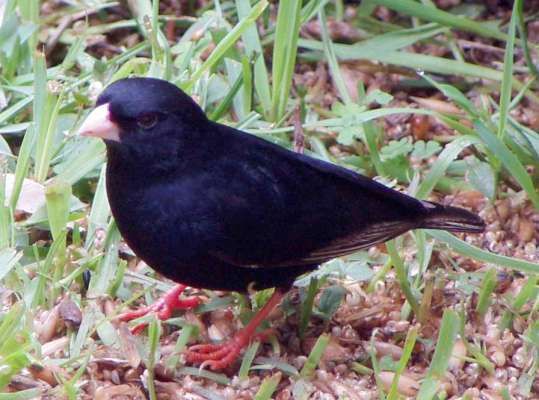
Wikipedia: Dusky indigobird Source: OTHER
Male_Variable_Indigobird_%28Vidua_funerea%29.jpg
![]() The dusky indigobird, variable indigobird, or black widowfinch (Vidua funerea) is a species of bird in the family Viduidae. It is found in Angola, Burundi, Cameroon, Republic of the Congo, Democratic Republic of the Congo, Guinea-Bissau, Malawi, Mozambique, Nigeria, Sierra Leone, South Africa, Swaziland, Tanzania, Zambia, and Zimbabwe. Its natural habitat is moist savanna.
[more]
The dusky indigobird, variable indigobird, or black widowfinch (Vidua funerea) is a species of bird in the family Viduidae. It is found in Angola, Burundi, Cameroon, Republic of the Congo, Democratic Republic of the Congo, Guinea-Bissau, Malawi, Mozambique, Nigeria, Sierra Leone, South Africa, Swaziland, Tanzania, Zambia, and Zimbabwe. Its natural habitat is moist savanna.
[more]
Profile Wikipedia eBird Xeno-Canto

Wikipedia: Variable indigobird Source: OTHER
Male_Variable_Indigobird_%28Vidua_funerea%29.jpg
![]() The dusky indigobird, variable indigobird, or black widowfinch (Vidua funerea) is a species of bird in the family Viduidae. It is found in Angola, Burundi, Cameroon, Republic of the Congo, Democratic Republic of the Congo, Guinea-Bissau, Malawi, Mozambique, Nigeria, Sierra Leone, South Africa, Swaziland, Tanzania, Zambia, and Zimbabwe. Its natural habitat is moist savanna.
[more]
The dusky indigobird, variable indigobird, or black widowfinch (Vidua funerea) is a species of bird in the family Viduidae. It is found in Angola, Burundi, Cameroon, Republic of the Congo, Democratic Republic of the Congo, Guinea-Bissau, Malawi, Mozambique, Nigeria, Sierra Leone, South Africa, Swaziland, Tanzania, Zambia, and Zimbabwe. Its natural habitat is moist savanna.
[more]
Profile Wikipedia eBird Audubon AllAboutBirds Xeno-Canto

Wikipedia: Bronze mannikin Source: OTHER
1200px-Bronze_Mannikin_%288568589949%29%2C_crop.jpg
This bird appears across the great seas in the following continents:
North America, Africa.
![]() The bronze mannikin or bronze munia (Spermestes cucullata) is a small passerine (i.e. perching) bird of the Afrotropics. This very social estrildid finch is an uncommon to locally abundant bird in much of Africa south of the Sahara Desert, where it is resident, nomadic or irruptive in mesic savanna or forest margin habitats.[5][6] It has an estimated global extent of occurrence of 8,100,000 km2. It is the smallest and most widespread of four munia species on the African mainland, the other being black-and-white, red-backed and magpie mannikin. It co-occurs with the Madagascan mannikin on the Comoro Islands, and was introduced to Puerto Rico. Especially in the West Africa, it is considered a pest in grain and rice fields. It is locally trapped for the pet bird trade.[4]
[more]
The bronze mannikin or bronze munia (Spermestes cucullata) is a small passerine (i.e. perching) bird of the Afrotropics. This very social estrildid finch is an uncommon to locally abundant bird in much of Africa south of the Sahara Desert, where it is resident, nomadic or irruptive in mesic savanna or forest margin habitats.[5][6] It has an estimated global extent of occurrence of 8,100,000 km2. It is the smallest and most widespread of four munia species on the African mainland, the other being black-and-white, red-backed and magpie mannikin. It co-occurs with the Madagascan mannikin on the Comoro Islands, and was introduced to Puerto Rico. Especially in the West Africa, it is considered a pest in grain and rice fields. It is locally trapped for the pet bird trade.[4]
[more]
Wikipedia: Magpie mannikin Source: OTHER
Nonnetto.JPG
![]() The magpie mannikin or magpie munia (Spermestes fringilloides) is a species of estrildid finch, sparsely present across Sub-Saharan Africa. It has an estimated global extent of occurrence of 1,400,000 km².
[more]
The magpie mannikin or magpie munia (Spermestes fringilloides) is a species of estrildid finch, sparsely present across Sub-Saharan Africa. It has an estimated global extent of occurrence of 1,400,000 km².
[more]

Wikipedia: Black-and-white munia Source: OTHER
Black-and-white_Mannikin_%28Spermestes_bicolor%29_%287699911414%29%2C_crop.jpg
![]() The black-and-white mannikin (Spermestes bicolor) or black-and-white munia, is a species of estrildid finch, widely occurring throughout the African tropical rainforest. It has an estimated global extent of occurrence of 4,200,000 km2.
It is found in moist savanna and subtropical or tropical moist lowland forest habitat. The status of the species is evaluated as least concern. They are seedeaters, but are known to feed on algae.[3]
[more]
The black-and-white mannikin (Spermestes bicolor) or black-and-white munia, is a species of estrildid finch, widely occurring throughout the African tropical rainforest. It has an estimated global extent of occurrence of 4,200,000 km2.
It is found in moist savanna and subtropical or tropical moist lowland forest habitat. The status of the species is evaluated as least concern. They are seedeaters, but are known to feed on algae.[3]
[more]
Profile Wikipedia eBird Audubon AllAboutBirds Xeno-Canto NABU

Wikipedia: Common waxbill Source: OTHER
1200px-Estrilda_astrild_-Gran_Canaria%2C_Canary_Islands%2C_Spain-8_%281%29.jpg
This bird appears across the great seas in the following continents:
Europe, North America, Africa.
![]() The common waxbill (Estrilda astrild), also known as the St Helena waxbill, is a small passerine bird belonging to the estrildid finch family. It is native to sub-Saharan Africa but has been introduced to many other regions of the world and now has an estimated global extent of occurrence of 10,000,000 km2. It is popular and easy to keep in captivity.
[more]
The common waxbill (Estrilda astrild), also known as the St Helena waxbill, is a small passerine bird belonging to the estrildid finch family. It is native to sub-Saharan Africa but has been introduced to many other regions of the world and now has an estimated global extent of occurrence of 10,000,000 km2. It is popular and easy to keep in captivity.
[more]
Profile Wikipedia eBird Xeno-Canto

Wikipedia: Black-tailed waxbill Source: OTHER
1200px-Black-tailed_Waxbill%2C_Sakania%2C_DRC_%288085664974%29.jpg
![]() The grey waxbill or black-tailed waxbill (Glaucestrilda perreini) is a common species of estrildid finch found in wetter land of Southern Africa. It has an estimated global extent of occurrence of 670,000 km².
[more]
The grey waxbill or black-tailed waxbill (Glaucestrilda perreini) is a common species of estrildid finch found in wetter land of Southern Africa. It has an estimated global extent of occurrence of 670,000 km².
[more]

Wikipedia: Black-cheeked waxbill Source: OTHER
Crimson-rumped_Waxbill_specimen_RWD.jpg
![]() The black-cheeked waxbill or red-rumped waxbill (Brunhilda charmosyna) is a common species of estrildid finch found in east Africa. It has an estimated global extent of occurrence of 400,000 km2.
[more]
The black-cheeked waxbill or red-rumped waxbill (Brunhilda charmosyna) is a common species of estrildid finch found in east Africa. It has an estimated global extent of occurrence of 400,000 km2.
[more]
Profile Wikipedia eBird Xeno-Canto

Wikipedia: Swee waxbill Source: OTHER
1200px-Swee_Waxbill_-_Natal_-_South_Africa_S4E7543_%2822568979507%29.jpg
![]() The swee waxbill (Coccopygia melanotis), is a common species of estrildid finch native to Southern Africa.
[more]
The swee waxbill (Coccopygia melanotis), is a common species of estrildid finch native to Southern Africa.
[more]
Profile Wikipedia eBird Xeno-Canto

Wikipedia: Peters's twinspot Source: OTHER
1200px-Peters%27s_Twinspot%2C_Sakania%2C_DRC_%289999020853%29.jpg
![]() The red-throated twinspot (Hypargos niveoguttatus) or Peters's twinspot is a common species of bird found in sub-saharan Africa. This species has a large range, with an estimated global extent of occurrence of 2,000,000 km2.
[more]
The red-throated twinspot (Hypargos niveoguttatus) or Peters's twinspot is a common species of bird found in sub-saharan Africa. This species has a large range, with an estimated global extent of occurrence of 2,000,000 km2.
[more]
Profile Wikipedia eBird Xeno-Canto

Wikipedia: Pink-throated twinspot Source: OTHER
Hypargos_margaritatus_-Mkhuze_Game_Reserve_-South_Africa-8.jpg
![]() The pink-throated twinspot (Hypargos margaritatus) is an estrildid finch. It inhabits dry savanna and moist, subtropical/tropical (lowland) shrubland habitats near the southeast African coast in Mozambique, South Africa and Swaziland. It has a large range, with an estimated global extent of occurrence of 160,000 km².[2]
[more]
The pink-throated twinspot (Hypargos margaritatus) is an estrildid finch. It inhabits dry savanna and moist, subtropical/tropical (lowland) shrubland habitats near the southeast African coast in Mozambique, South Africa and Swaziland. It has a large range, with an estimated global extent of occurrence of 160,000 km².[2]
[more]
Profile Wikipedia eBird Xeno-Canto

Wikipedia: Red-billed firefinch Source: OTHER
1200px-Red-billed_firefinch_%28Lagonosticta_senegala_senegala%29_male.jpg
![]() The red-billed firefinch or Senegal firefinch (Lagonosticta senegala) is a small passerine bird. This estrildid finch is a resident breeding bird in most of Sub-Saharan Africa with an estimated global extent of occurrence of 10,000,000 km2. The species was introduced to Egypt, however, the introduced population has become extinct. It was also introduced to southern Algeria where it is currently expanding northward.
[2]
[more]
The red-billed firefinch or Senegal firefinch (Lagonosticta senegala) is a small passerine bird. This estrildid finch is a resident breeding bird in most of Sub-Saharan Africa with an estimated global extent of occurrence of 10,000,000 km2. The species was introduced to Egypt, however, the introduced population has become extinct. It was also introduced to southern Algeria where it is currently expanding northward.
[2]
[more]
Profile Wikipedia eBird Xeno-Canto
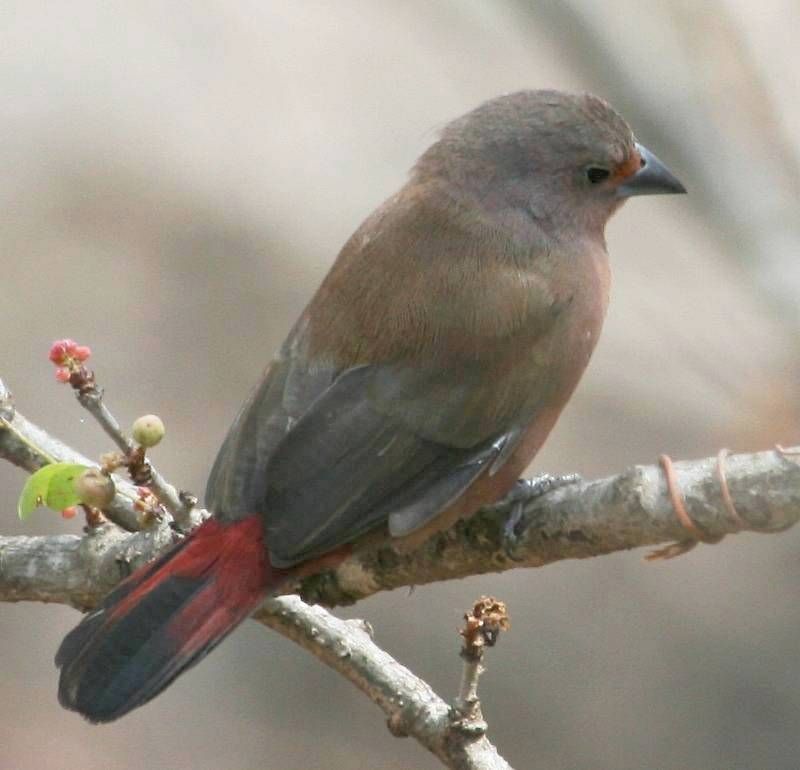
Wikipedia: Jameson's firefinch Source: OTHER
Female_Jamesons_Firefinch_%28Lagonosticta_rhodopareia%29.jpg
![]() Jameson's firefinch (Lagonosticta rhodopareia) is a common species of estrildid finch found in Sub-Saharan Africa. It has an estimated global extent of occurrence of 2,600,000 km2.
[more]
Jameson's firefinch (Lagonosticta rhodopareia) is a common species of estrildid finch found in Sub-Saharan Africa. It has an estimated global extent of occurrence of 2,600,000 km2.
[more]
Profile Wikipedia eBird Xeno-Canto

Wikipedia: African firefinch Source: OTHER
1200px-Firefinch_African_2017_07_02_11_45_37_0106c.jpg
![]() The African firefinch (Lagonosticta rubricata), also called the dark firefinch or blue-billed firefinch due to the color of its bill,[3] is a common species of estrildid finch found in almost all parts of Africa. It has an estimated global extent of occurrence of 5,400,000 km2.
[more]
The African firefinch (Lagonosticta rubricata), also called the dark firefinch or blue-billed firefinch due to the color of its bill,[3] is a common species of estrildid finch found in almost all parts of Africa. It has an estimated global extent of occurrence of 5,400,000 km2.
[more]
Profile Wikipedia eBird Xeno-Canto

Wikipedia: Quailfinch Source: OTHER
Flickr_-_Rainbirder_-_African_Quailfinch_%28Ortygospiza_atricollis%29_male.jpg
![]() The quailfinch (Ortygospiza atricollis) is a species of the estrildid finch. It is found in open grasslands in Africa. They are gregarious seed-eaters with short, thick, red bills. They are very terrestrial, with lark-like feet and claws.
[more]
The quailfinch (Ortygospiza atricollis) is a species of the estrildid finch. It is found in open grasslands in Africa. They are gregarious seed-eaters with short, thick, red bills. They are very terrestrial, with lark-like feet and claws.
[more]
Profile Wikipedia eBird Xeno-Canto
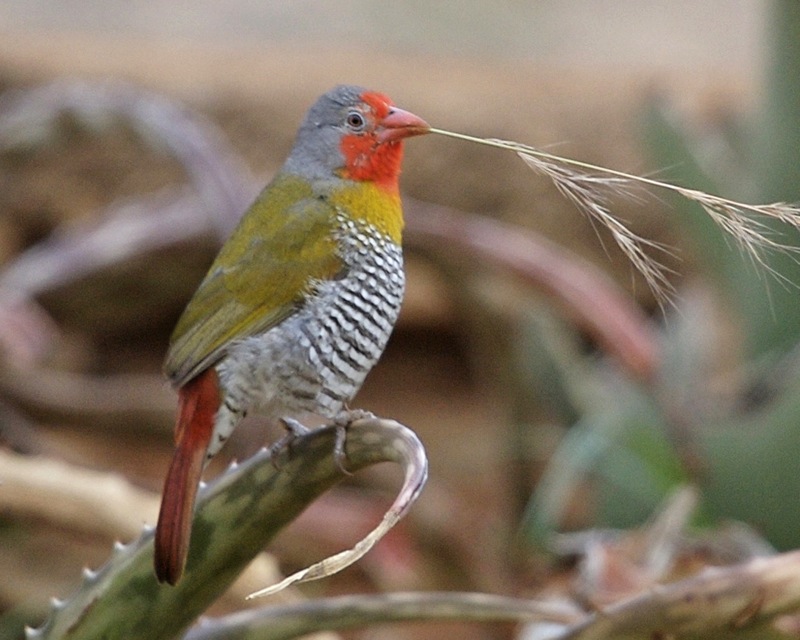
Wikipedia: Green-winged pytilia Source: OTHER
Green-winged_Pytilia_%28Pytilia_melba%29.jpg
![]() The green-winged pytilia (Pytilia melba) is a common species of estrildid finch found in Africa. It has an estimated global extent of occurrence of 6,000,000 square kilometres (2,300,000 sq mi).[2]
[more]
The green-winged pytilia (Pytilia melba) is a common species of estrildid finch found in Africa. It has an estimated global extent of occurrence of 6,000,000 square kilometres (2,300,000 sq mi).[2]
[more]
Profile Wikipedia eBird Xeno-Canto

Wikipedia: Orange-winged pytilia Source: OTHER
1200px-PytiliaAfraSmit.jpg
![]() The orange-winged pytilia (Pytilia afra), also known as the golden-backed pytilia,[2] is a species of estrildid finch found in Africa. It has a wide range and the International Union for Conservation of Nature has assessed it as being of least concern.
[more]
The orange-winged pytilia (Pytilia afra), also known as the golden-backed pytilia,[2] is a species of estrildid finch found in Africa. It has a wide range and the International Union for Conservation of Nature has assessed it as being of least concern.
[more]
Blue waxbill copy. 2016-09-28 06.54.58 Botswana
First observed in Botswana on 2016-09-28.
![]() The blue waxbill (Uraeginthus angolensis), also called southern blue waxbill, blue-breasted waxbill, southern cordon-bleu, blue-cheeked cordon-bleu, blue-breasted cordon-bleu and Angola cordon-bleu, is a common species of estrildid finch found in Southern Africa.[3] It is also relatively commonly kept as an aviary bird.[4]
[more]
The blue waxbill (Uraeginthus angolensis), also called southern blue waxbill, blue-breasted waxbill, southern cordon-bleu, blue-cheeked cordon-bleu, blue-breasted cordon-bleu and Angola cordon-bleu, is a common species of estrildid finch found in Southern Africa.[3] It is also relatively commonly kept as an aviary bird.[4]
[more]
Profile Wikipedia eBird Xeno-Canto

Wikipedia: Green-backed twinspot Source: OTHER
1200px-PyteliaNitidulaGronvold.jpg
![]() The green-backed twinspot or green twinspot (Mandingoa nitidula) is an estrildid finch found in many parts of Sub-Saharan Africa. The IUCN has classified the species as being of least concern.
[more]
The green-backed twinspot or green twinspot (Mandingoa nitidula) is an estrildid finch found in many parts of Sub-Saharan Africa. The IUCN has classified the species as being of least concern.
[more]

Wikipedia: Red-headed finch Source: OTHER
1200px-Amadina_erythrocephala_%28l%29_edit.jpg
![]() The red-headed finch (Amadina erythrocephala) (also known as the paradise finch or the red-headed weaver) is a common species of estrildid finch found in Africa. It has an estimated global extent of occurrence of 1,600,000 km2. It is found in Angola, Botswana, Lesotho, Namibia, South Africa and Zimbabwe.
[more]
The red-headed finch (Amadina erythrocephala) (also known as the paradise finch or the red-headed weaver) is a common species of estrildid finch found in Africa. It has an estimated global extent of occurrence of 1,600,000 km2. It is found in Angola, Botswana, Lesotho, Namibia, South Africa and Zimbabwe.
[more]

Wikipedia: Malachite sunbird Source: OTHER
Nectarinia_famosa_%28Malachite_Sunbird%29.jpg
![]() The malachite sunbird (Nectarinia famosa) is a small nectarivorous bird found from the highlands of Ethiopia southwards to South Africa. They pollinate many flowering plants, particularly those with long corolla tubes, in the Fynbos.
[more]
The malachite sunbird (Nectarinia famosa) is a small nectarivorous bird found from the highlands of Ethiopia southwards to South Africa. They pollinate many flowering plants, particularly those with long corolla tubes, in the Fynbos.
[more]
Profile Wikipedia eBird Xeno-Canto

Wikipedia: Plain-backed sunbird Source: OTHER
Flickr_-_Rainbirder_-_Plain-backed_Sunbird_male_%28Anthreptes_reichenowi%29.jpg
![]() The plain-backed sunbird, also known as blue-throated sunbird (Anthreptes reichenowi) is a sunbird. The sunbirds are a group of very small Old World passerine birds which feed largely on nectar, although they will also take insects, especially when feeding young. Flight is fast and direct on their short wings. Most species can take nectar by hovering like a hummingbird, but usually perch to feed most of the time.
[more]
The plain-backed sunbird, also known as blue-throated sunbird (Anthreptes reichenowi) is a sunbird. The sunbirds are a group of very small Old World passerine birds which feed largely on nectar, although they will also take insects, especially when feeding young. Flight is fast and direct on their short wings. Most species can take nectar by hovering like a hummingbird, but usually perch to feed most of the time.
[more]
Profile Wikipedia eBird Xeno-Canto

Wikipedia: Cape sugarbird Source: OTHER
Cape_Sugarbird_%28Promerops_cafer%29.jpg
![]() The Cape sugarbird (Promerops cafer)[2] is one of the eight bird species endemic to the Fynbos biome of the Western Cape and Eastern Cape provinces of South Africa.[3]
[more]
The Cape sugarbird (Promerops cafer)[2] is one of the eight bird species endemic to the Fynbos biome of the Western Cape and Eastern Cape provinces of South Africa.[3]
[more]
Profile Wikipedia eBird Xeno-Canto

Wikipedia: Gurney's sugarbird Source: OTHER
1200px-Gurney%27s_Sugarbird_%28Promerops_gurneyi%29.jpg
![]() Gurney's sugarbird has a long, decurved bill characteristic of nectarivores. It has a chestnut-coloured forehead, along with a faint white eyestripe and white mustachial stripe.[1] A white throat stands out against the russet breast.[1] This species of sugarbird has a dark grey back, and a conspicuous bright yellow rump makes this bird easy to spot.[1] The tail is long and graduated, ranging from 11 to 19.3 cm in length.[1] This species measures between 23 and 29 cm in total, and body mass ranges from 30 to 46.5 g in males and 23 to 43 g in females.[1] Females are smaller than males, with shorter bills and tail feathers.[4] Males also have triangular-shaped bulge on the sixth primary feather, used in mating displays.[5] Immature individuals are duller than adults and have a greenish tinge to both their breast and yellow rump.[1] Further, their secondary feathers are edged with a brownish colour.[1]
[more]
Gurney's sugarbird has a long, decurved bill characteristic of nectarivores. It has a chestnut-coloured forehead, along with a faint white eyestripe and white mustachial stripe.[1] A white throat stands out against the russet breast.[1] This species of sugarbird has a dark grey back, and a conspicuous bright yellow rump makes this bird easy to spot.[1] The tail is long and graduated, ranging from 11 to 19.3 cm in length.[1] This species measures between 23 and 29 cm in total, and body mass ranges from 30 to 46.5 g in males and 23 to 43 g in females.[1] Females are smaller than males, with shorter bills and tail feathers.[4] Males also have triangular-shaped bulge on the sixth primary feather, used in mating displays.[5] Immature individuals are duller than adults and have a greenish tinge to both their breast and yellow rump.[1] Further, their secondary feathers are edged with a brownish colour.[1]
[more]

Wikipedia: Mouse-coloured sunbird Source: OTHER
Sunbird_Grey_2010_07_17_09_Alan_Manson_Queen_Elizabeth_Park.jpg
![]() The grey sunbird or mouse-coloured sunbird (Cyanomitra verreauxii) is a species of bird in the family Nectariniidae.
It is found in Kenya, Malawi, Mozambique, Somalia, South Africa, Swaziland, and Tanzania.
[more]
The grey sunbird or mouse-coloured sunbird (Cyanomitra verreauxii) is a species of bird in the family Nectariniidae.
It is found in Kenya, Malawi, Mozambique, Somalia, South Africa, Swaziland, and Tanzania.
[more]

Wikipedia: Olive sunbird Source: OTHER
Eastern_Olive_Sunbird_%28Nectarinia_olivacea%29.jpg
![]() The olive sunbird (Cyanomitra olivacea) is a species of sunbird found in a large part of Africa south of the Sahel. It prefers forested regions, and is absent from drier, more open regions such as the Horn of Africa and most of south-central and south-western Africa. It is sometimes placed in the genus Nectarinia.
[more]
The olive sunbird (Cyanomitra olivacea) is a species of sunbird found in a large part of Africa south of the Sahel. It prefers forested regions, and is absent from drier, more open regions such as the Horn of Africa and most of south-central and south-western Africa. It is sometimes placed in the genus Nectarinia.
[more]
Profile Wikipedia eBird Xeno-Canto

Wikipedia: Scarlet-chested sunbird Source: OTHER
1200px-Scarlet-chested_sunbird%2C_Chalcomitra_senegalensis%2C_at_Lake_Chivero%2C_Harare%2C_Zimbabwe_-_male_%2821247780653%29.jpg
![]() The scarlet-chested sunbird (Chalcomitra senegalensis) is a species of bird in the family Nectariniidae. It is found in Angola, Benin, Botswana, Burkina Faso, Burundi, Cameroon, Central African Republic, Chad, Democratic Republic of the Congo, Ivory Coast, Eritrea, Ethiopia, Gambia, Ghana, Guinea, Guinea-Bissau, Kenya, Malawi, Mali, Mauritania, Mozambique, Namibia, Niger, Nigeria, Rwanda, Senegal, Sierra Leone, South Africa, Sudan, Swaziland, Tanzania, Togo, Uganda, Zambia, and Zimbabwe.
[more]
The scarlet-chested sunbird (Chalcomitra senegalensis) is a species of bird in the family Nectariniidae. It is found in Angola, Benin, Botswana, Burkina Faso, Burundi, Cameroon, Central African Republic, Chad, Democratic Republic of the Congo, Ivory Coast, Eritrea, Ethiopia, Gambia, Ghana, Guinea, Guinea-Bissau, Kenya, Malawi, Mali, Mauritania, Mozambique, Namibia, Niger, Nigeria, Rwanda, Senegal, Sierra Leone, South Africa, Sudan, Swaziland, Tanzania, Togo, Uganda, Zambia, and Zimbabwe.
[more]
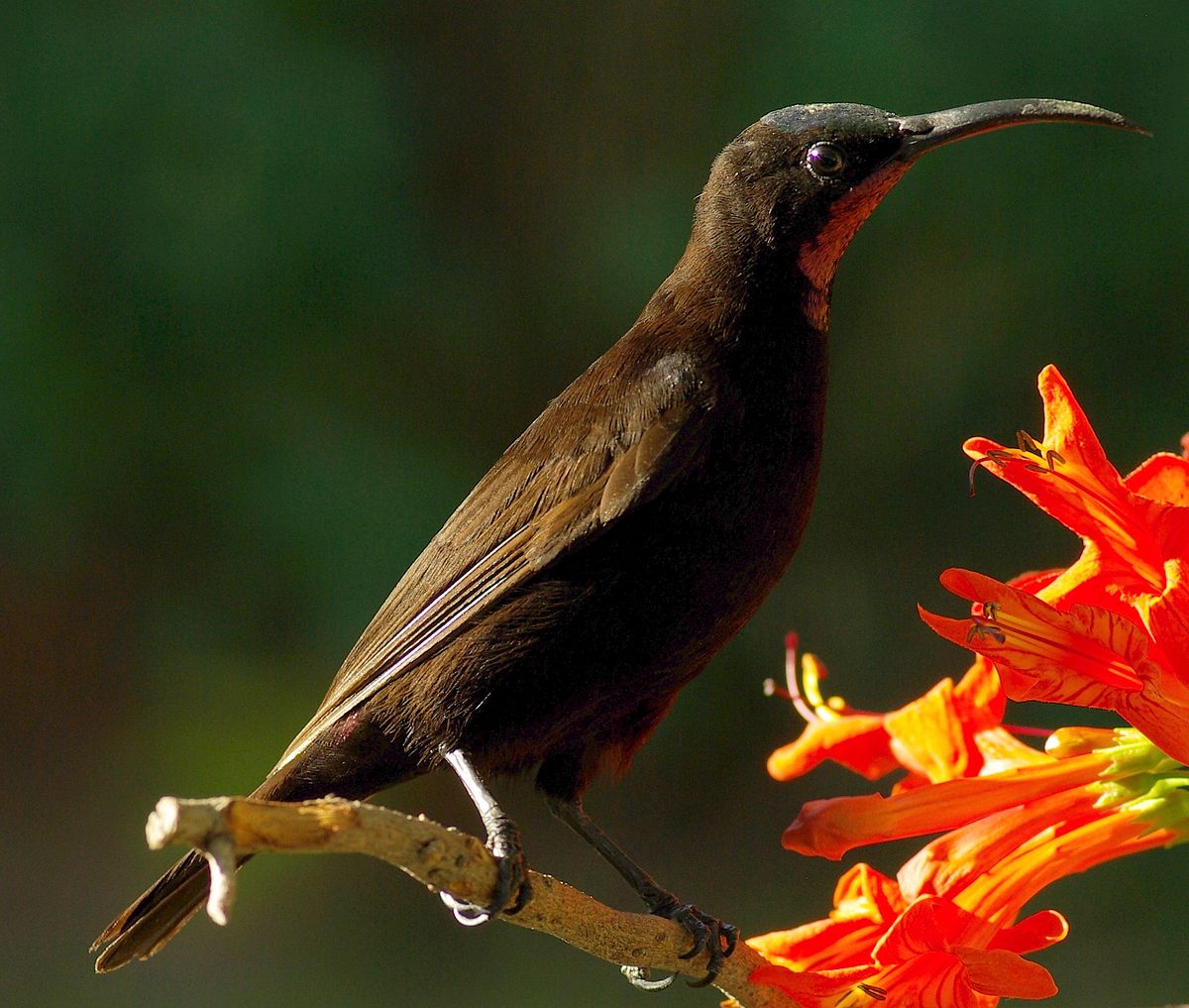
Wikipedia: Amethyst sunbird Source: OTHER
1200px-Amethyst_sunbird.jpg
![]() The amethyst sunbird, also called the black sunbird (Chalcomitra amethystina), is a species of passerine bird in the family Nectariniidae. It is native to the Afrotropics, mostly south of the equator.[2] They are commonly found in well-watered habitats, and undertake seasonal movements to visit flowering woodlands. The demise of some woodlands have impacted their numbers locally, but their range has also expanded along with the spread of wooded gardens.
[more]
The amethyst sunbird, also called the black sunbird (Chalcomitra amethystina), is a species of passerine bird in the family Nectariniidae. It is native to the Afrotropics, mostly south of the equator.[2] They are commonly found in well-watered habitats, and undertake seasonal movements to visit flowering woodlands. The demise of some woodlands have impacted their numbers locally, but their range has also expanded along with the spread of wooded gardens.
[more]
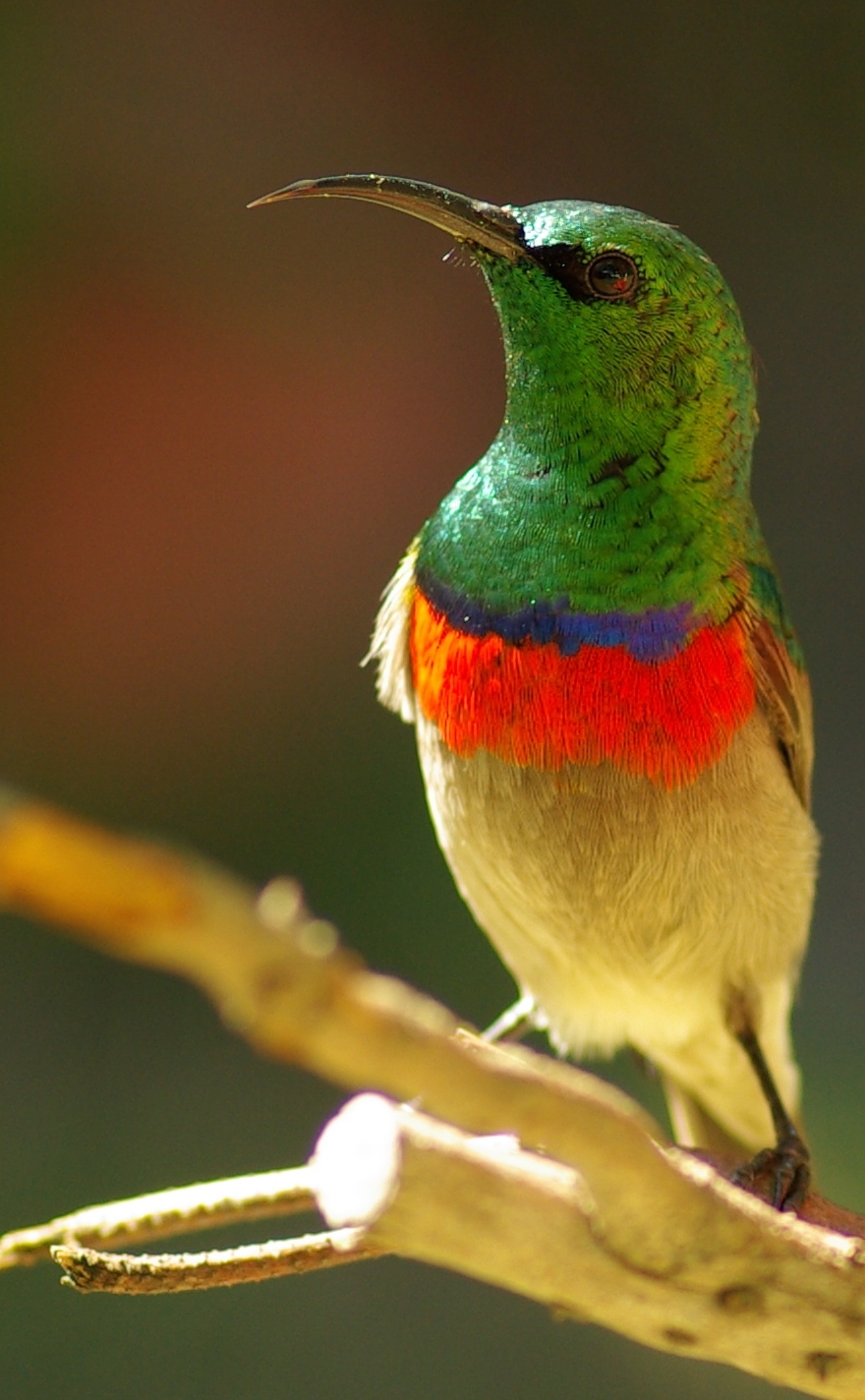
Wikipedia: Southern double-collared sunbird Source: OTHER
Lesser_Double-collared_sunbird.jpg
![]() The southern double-collared sunbird or lesser double-collared sunbird (Cinnyris chalybeus) is a small passerine bird which breeds in southern Africa. It is mainly resident, but partially migratory in the north-east of its range.
[more]
The southern double-collared sunbird or lesser double-collared sunbird (Cinnyris chalybeus) is a small passerine bird which breeds in southern Africa. It is mainly resident, but partially migratory in the north-east of its range.
[more]

Wikipedia: Greater double-collared sunbird Source: OTHER
1200px-Greater_Double-collared_sunbird.jpg
![]() The greater double-collared sunbird (Cinnyris afer) (formerly placed in the genus Nectarinia), is a small bird in the sunbird family.
[more]
The greater double-collared sunbird (Cinnyris afer) (formerly placed in the genus Nectarinia), is a small bird in the sunbird family.
[more]
Profile Wikipedia eBird Xeno-Canto

Wikipedia: Dusky sunbird Source: OTHER
Nectarinia_fusca_-Northern_Cape%2C_South_Africa-8.jpg
![]() The dusky sunbird (Cinnyris fuscus) is a species of bird in the family Nectariniidae. This relatively dull sunbird is found in arid savanna, thickets and shrubland (e.g. Karoo) in Angola, Botswana, Namibia, and South Africa.
[more]
The dusky sunbird (Cinnyris fuscus) is a species of bird in the family Nectariniidae. This relatively dull sunbird is found in arid savanna, thickets and shrubland (e.g. Karoo) in Angola, Botswana, Namibia, and South Africa.
[more]
Profile Wikipedia eBird Xeno-Canto

Wikipedia: Neergaard's sunbird Source: OTHER
1200px-CinnyrisNeergaardiGronvold.jpg
![]() Neergaard's sunbird (Cinnyris neergaardi) is a species of bird in the family Nectariniidae. It is found in Mozambique and South Africa. Its natural habitat is subtropical or tropical dry forest near the coast, where it is threatened by habitat loss. It is named after Paul Neergaard, a Danish recruiting officer for the Wenela agency, who was stationed in southern Mozambique.[5][6]
[more]
Neergaard's sunbird (Cinnyris neergaardi) is a species of bird in the family Nectariniidae. It is found in Mozambique and South Africa. Its natural habitat is subtropical or tropical dry forest near the coast, where it is threatened by habitat loss. It is named after Paul Neergaard, a Danish recruiting officer for the Wenela agency, who was stationed in southern Mozambique.[5][6]
[more]

Wikipedia: Mariqua sunbird Source: OTHER
1200px-Marico_sunbird%2C_Cinnyris_mariquensis_%28male%29_at_Marakele_National_Park%2C_Limpopo%2C_South_Africa_%2816301138095%29.jpg
![]() It is found in Angola, Botswana, Burundi, Eritrea, Ethiopia, Kenya, Mozambique, Namibia, Rwanda, Somalia, South Africa, South Sudan, Swaziland, Tanzania, Uganda, Zambia, and Zimbabwe.[1]
[more]
It is found in Angola, Botswana, Burundi, Eritrea, Ethiopia, Kenya, Mozambique, Namibia, Rwanda, Somalia, South Africa, South Sudan, Swaziland, Tanzania, Uganda, Zambia, and Zimbabwe.[1]
[more]
Profile Wikipedia eBird Xeno-Canto

Wikipedia: Purple-banded sunbird Source: OTHER
Purple-banded_Sunbird_%28Cinnyris_bifasciatus%29.jpg
![]() The purple-banded sunbird (Cinnyris bifasciatus) is a species of bird in the family Nectariniidae.
It is found in Angola, Botswana, Republic of the Congo, Democratic Republic of the Congo, Ethiopia, Gabon, Kenya, Malawi, Mozambique, Namibia, Rwanda, Somalia, South Africa, Swaziland, Tanzania, Uganda, Zambia, and Zimbabwe.
[more]
The purple-banded sunbird (Cinnyris bifasciatus) is a species of bird in the family Nectariniidae.
It is found in Angola, Botswana, Republic of the Congo, Democratic Republic of the Congo, Ethiopia, Gabon, Kenya, Malawi, Mozambique, Namibia, Rwanda, Somalia, South Africa, Swaziland, Tanzania, Uganda, Zambia, and Zimbabwe.
[more]

Wikipedia: Variable sunbird
![]() The variable sunbird (or yellow-bellied sunbird), Cinnyris venustus (formerly Nectarinia venusta), is a sunbird. The sunbirds are a group of small Old World passerine birds which feed largely on nectar, although they will also take insects, especially when feeding young. Flight is fast and direct on their short wings. Most species can take nectar by hovering like a hummingbird, but usually perch to feed most of the time.
[more]
The variable sunbird (or yellow-bellied sunbird), Cinnyris venustus (formerly Nectarinia venusta), is a sunbird. The sunbirds are a group of small Old World passerine birds which feed largely on nectar, although they will also take insects, especially when feeding young. Flight is fast and direct on their short wings. Most species can take nectar by hovering like a hummingbird, but usually perch to feed most of the time.
[more]

Wikipedia: Orange-breasted sunbird Source: OTHER
1200px-SunBird_capetown.jpg
![]() The orange-breasted sunbird (Anthobaphes violacea) is the only member of the bird genus Anthobaphes; however, it is sometimes placed in the genus Nectarinia. This sunbird is endemic to the fynbos habitat of southwestern South Africa. They are sexually dimorphic with females being olive green while the males are orange to yellow on the underside with bright green, blue and purple on the head and neck.
[more]
The orange-breasted sunbird (Anthobaphes violacea) is the only member of the bird genus Anthobaphes; however, it is sometimes placed in the genus Nectarinia. This sunbird is endemic to the fynbos habitat of southwestern South Africa. They are sexually dimorphic with females being olive green while the males are orange to yellow on the underside with bright green, blue and purple on the head and neck.
[more]
Profile Wikipedia eBird Xeno-Canto

Wikipedia: Southern brown-throated weaver Source: OTHER
Southern_Brown-throated_Weaver_-_Malawi_S4E3666_%2822836900792%29.jpg
![]() The southern brown-throated weaver (Ploceus xanthopterus) is a species of bird in the family Ploceidae.
It is found in southern Africa.
[more]
The southern brown-throated weaver (Ploceus xanthopterus) is a species of bird in the family Ploceidae.
It is found in southern Africa.
[more]
Profile Wikipedia eBird Xeno-Canto

Wikipedia: Cape weaver Source: OTHER
Ploceus_capensis_-Johannesburg%2C_South_Africa_-male-8.jpg
![]() The Cape weaver (Ploceus capensis) is a species of bird in the weaver family, Ploceidae, found in southern Africa.
[more]
The Cape weaver (Ploceus capensis) is a species of bird in the weaver family, Ploceidae, found in southern Africa.
[more]
Profile Wikipedia eBird Xeno-Canto

Wikipedia: Chestnut weaver Source: OTHER
1200px-Chestnut_weaver_%28Ploceus_rubiginosus%29_male.jpg
![]() The chestnut weaver (Ploceus rubiginosus) is a species of bird in the family Ploceidae.
It is found in eastern and south-western Africa.
[more]
The chestnut weaver (Ploceus rubiginosus) is a species of bird in the family Ploceidae.
It is found in eastern and south-western Africa.
[more]
Profile Wikipedia eBird Xeno-Canto

Wikipedia: Holub's golden-weaver Source: OTHER
1200px-Holub%27s_golden_weaver_%28Ploceus_xanthops%29_%2822561083782%29.jpg
![]() Holub's golden weaver (Ploceus xanthops), also known as the African golden weaver, is a species of bird in the family Ploceidae.[2] It is found from Gabon to Uganda and Kenya, south to northern Namibia, northern Botswana and eastern South Africa.[1]
[more]
Holub's golden weaver (Ploceus xanthops), also known as the African golden weaver, is a species of bird in the family Ploceidae.[2] It is found from Gabon to Uganda and Kenya, south to northern Namibia, northern Botswana and eastern South Africa.[1]
[more]

Wikipedia: Lesser masked weaver Source: OTHER
Lesser_Masked_Weaver_-_Baringo_-_Kenya_NH8O1107_%2822662509730%29.jpg
![]() The lesser masked weaver (Ploceus intermedius) is a species of bird in the family Ploceidae. It builds its nests in large colonies, often alongside the village weaver and sometimes the red-billed buffalo weaver. This species is commonly parasitised by the Diederik cuckoo. It is found in eastern, south-eastern and southern Africa.
[more]
The lesser masked weaver (Ploceus intermedius) is a species of bird in the family Ploceidae. It builds its nests in large colonies, often alongside the village weaver and sometimes the red-billed buffalo weaver. This species is commonly parasitised by the Diederik cuckoo. It is found in eastern, south-eastern and southern Africa.
[more]
Probably a village weaver near Addo Elephant Park. 2009-10-25 11.59.10 Gqeberha (former Port Elisabeth)
First observed in Gqeberha (former Port Elisabeth) on 2009-10-20.
![]() The village weaver (Ploceus cucullatus), also known as the spotted-backed weaver or black-headed weaver (the latter leading to easy confusion with P. melanocephalus), is a species of bird in the family Ploceidae found in much of sub-Saharan Africa. It has also been introduced to Hispaniola, Mauritius and Réunion.[1]
[more]
The village weaver (Ploceus cucullatus), also known as the spotted-backed weaver or black-headed weaver (the latter leading to easy confusion with P. melanocephalus), is a species of bird in the family Ploceidae found in much of sub-Saharan Africa. It has also been introduced to Hispaniola, Mauritius and Réunion.[1]
[more]
Profile Wikipedia eBird Xeno-Canto

Wikipedia: Forest weaver Source: OTHER
1200px-Dark-backed_weaver%2C_Ploceus_bicolor%2C_also_known_as_the_forest_weaver_at_Ndumo_Nature_Reserve%2C_KwaZulu-Natal%2C_South_Africa_%2828841131011%29.jpg
![]() The dark-backed weaver (Ploceus bicolor), also known as the forest weaver, is a species of bird in the family Ploceidae.
It is found in Angola, Burundi, Cameroon, Republic of the Congo, Democratic Republic of the Congo, Equatorial Guinea, Eswatini, Gabon, Kenya, Malawi, Mozambique, Nigeria, Rwanda, Somalia, South Africa, South Sudan, Tanzania, Uganda, Zambia, and Zimbabwe.
[more]
The dark-backed weaver (Ploceus bicolor), also known as the forest weaver, is a species of bird in the family Ploceidae.
It is found in Angola, Burundi, Cameroon, Republic of the Congo, Democratic Republic of the Congo, Equatorial Guinea, Eswatini, Gabon, Kenya, Malawi, Mozambique, Nigeria, Rwanda, Somalia, South Africa, South Sudan, Tanzania, Uganda, Zambia, and Zimbabwe.
[more]
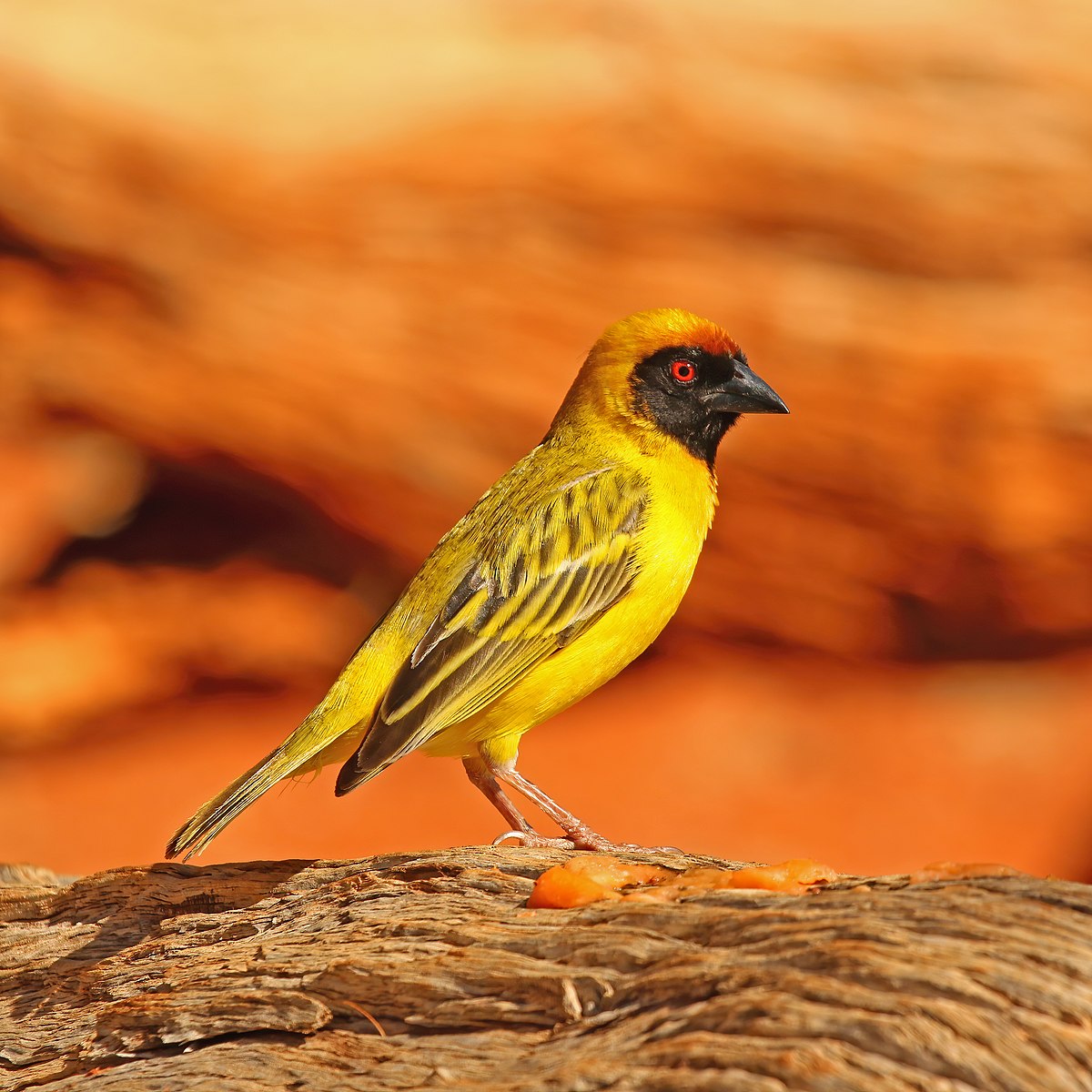
Wikipedia: Southern masked weaver Source: OTHER
1200px-Southern_masked_weaver_%28Ploceus_velatus%29_male.jpg
![]() The southern masked weaver (Ploceus velatus), or African masked weaver, is a resident breeding bird species common throughout southern Africa.
[more]
The southern masked weaver (Ploceus velatus), or African masked weaver, is a resident breeding bird species common throughout southern Africa.
[more]
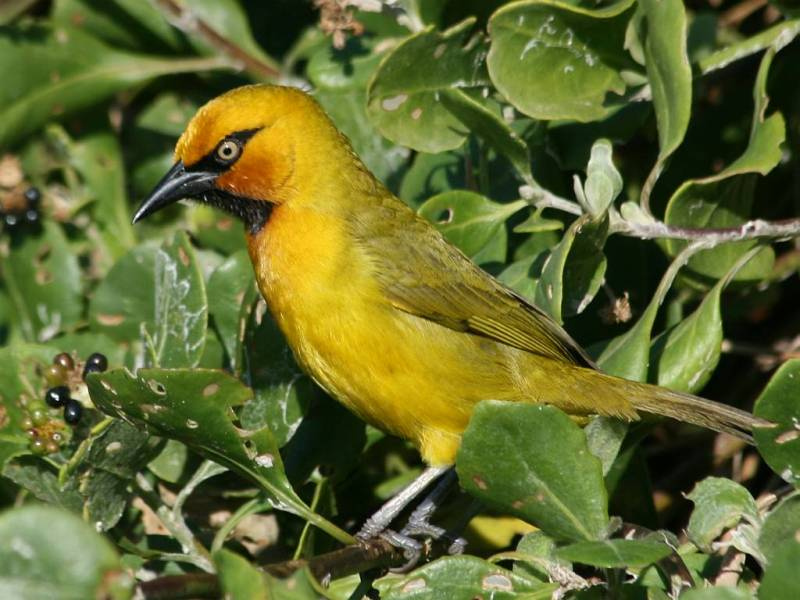
Wikipedia: Spectacled weaver Source: OTHER
Ploceus_ocularis_-Umhlanga%2C_KwaZulu-Natal%2C_South_Africa-8.jpg
![]() The spectacled weaver (Ploceus ocularis) is a species of bird in the family Ploceidae. It is found widely in woodland, forest edge and gardens of central, eastern and south-eastern Africa, but is absent from the most arid regions (such as the Karoo) and dense, primary rainforest. This common species breeds in solitary pairs, and both sexes are bright yellow, have an olive-yellow back, black "spectacles" and pale eyes. The male has a black throat.
[more]
The spectacled weaver (Ploceus ocularis) is a species of bird in the family Ploceidae. It is found widely in woodland, forest edge and gardens of central, eastern and south-eastern Africa, but is absent from the most arid regions (such as the Karoo) and dense, primary rainforest. This common species breeds in solitary pairs, and both sexes are bright yellow, have an olive-yellow back, black "spectacles" and pale eyes. The male has a black throat.
[more]
Profile Wikipedia eBird Xeno-Canto

Wikipedia: African golden-weaver Source: OTHER
1200px-Ploceus_subaureus_Zanzibar.jpg
![]() The eastern golden weaver (Ploceus subaureus) is a species of bird in the family Ploceidae.
It is found in eastern and south-eastern Africa. Alternative names used for the eastern golden weaver include yellow weaver, olive-headed golden weaver, and African golden weaver.
[more]
The eastern golden weaver (Ploceus subaureus) is a species of bird in the family Ploceidae.
It is found in eastern and south-eastern Africa. Alternative names used for the eastern golden weaver include yellow weaver, olive-headed golden weaver, and African golden weaver.
[more]
Profile Wikipedia eBird Xeno-Canto

Wikipedia: Red-billed quelea Source: OTHER
1200px-Red-billed_Quelea_%28Quelea_quelea%29_%286040990915%29.jpg
![]() The red-billed quelea (/ˈkwiːliə/;[3] Quelea quelea), also known as the red-billed weaver or red-billed dioch, is a small—approximately 12 cm (4.7 in) long and weighing 15–26 g (0.53–0.92 oz)—migratory, sparrow-like bird of the weaver family, Ploceidae, native to Sub-Saharan Africa.
[more]
The red-billed quelea (/ˈkwiːliə/;[3] Quelea quelea), also known as the red-billed weaver or red-billed dioch, is a small—approximately 12 cm (4.7 in) long and weighing 15–26 g (0.53–0.92 oz)—migratory, sparrow-like bird of the weaver family, Ploceidae, native to Sub-Saharan Africa.
[more]
Profile Wikipedia eBird Xeno-Canto

Wikipedia: Red-headed quelea Source: OTHER
Red-headed_Quelea_-_Natal_-_South_Africa_S4E7723_%2822432117487%29.jpg
![]() The red-headed quelea (Quelea erythrops) is a species of bird in the family Ploceidae.
It is found in Angola, Benin, Botswana, Burkina Faso, Burundi, Cameroon, Central African Republic, Chad, Republic of the Congo, Democratic Republic of the Congo, Ivory Coast, Equatorial Guinea, Ethiopia, Gabon, Gambia, Ghana, Guinea, Guinea-Bissau, Kenya, Liberia, Malawi, Mali, Mozambique, Niger, Nigeria, Rwanda, São Tomé and Príncipe, Senegal, Sierra Leone, South Africa, South Sudan, Swaziland, Tanzania, Togo, Uganda, Zambia, and Zimbabwe.
[more]
The red-headed quelea (Quelea erythrops) is a species of bird in the family Ploceidae.
It is found in Angola, Benin, Botswana, Burkina Faso, Burundi, Cameroon, Central African Republic, Chad, Republic of the Congo, Democratic Republic of the Congo, Ivory Coast, Equatorial Guinea, Ethiopia, Gabon, Gambia, Ghana, Guinea, Guinea-Bissau, Kenya, Liberia, Malawi, Mali, Mozambique, Niger, Nigeria, Rwanda, São Tomé and Príncipe, Senegal, Sierra Leone, South Africa, South Sudan, Swaziland, Tanzania, Togo, Uganda, Zambia, and Zimbabwe.
[more]

Wikipedia: Red-headed weaver Source: OTHER
1200px-Red-headed_Weaver%2C_Anaplectes_rubriceps_at_Marakele_National_Park%2C_Limpopo_Province%2C_South_Africa_%28male_in_breeding_plumage%29_%2815679994373%29.jpg
![]() The red-headed weaver (Anaplectes rubriceps[2][note 1]) is a species of bird in the family Ploceidae. It is placed in the monotypic genus Anaplectes and is found throughout the Afrotropics.[citation needed]
[more]
The red-headed weaver (Anaplectes rubriceps[2][note 1]) is a species of bird in the family Ploceidae. It is placed in the monotypic genus Anaplectes and is found throughout the Afrotropics.[citation needed]
[more]

Wikipedia: Grosbeak weaver Source: OTHER
Amblyospiza_albifrons_-Pretoria%2C_South_Africa_-male-8%2C_crop.jpg
![]() The thick-billed weaver (Amblyospiza albifrons), or grosbeak weaver, is a distinctive and bold species of weaver bird that is native to the Afrotropics. It comprises the monotypic genus Amblyospiza[2] and subfamily Amblyospizinae.[3]
[more]
The thick-billed weaver (Amblyospiza albifrons), or grosbeak weaver, is a distinctive and bold species of weaver bird that is native to the Afrotropics. It comprises the monotypic genus Amblyospiza[2] and subfamily Amblyospizinae.[3]
[more]
Profile Wikipedia eBird Xeno-Canto

Wikipedia: Red-billed buffalo-weaver Source: OTHER
1200px-Red-billed_Buffalo_Weaver.jpg
![]() The red-billed buffalo weaver (Bubalornis niger) is a species of bird in the family Ploceidae. It is found in eastern and southern Africa. Its natural habitat is the dry savanna.[1]
[more]
The red-billed buffalo weaver (Bubalornis niger) is a species of bird in the family Ploceidae. It is found in eastern and southern Africa. Its natural habitat is the dry savanna.[1]
[more]
Profile Wikipedia eBird Xeno-Canto

Wikipedia: Long-tailed widowbird Source: OTHER
1200px-Long-tailed_Widowbird_%28Euplectes_progne%29_male_...._%2846718360972%29.jpg
![]() The long-tailed widowbird (Euplectes progne), also known as the "Sakabula", is a species of bird in the family Ploceidae.[2] The species are found in Angola, Botswana, the DRCongo, Kenya, Lesotho, South Africa, Swaziland, and Zambia.[3] The long-tailed widowbird is a medium-sized bird and one of the most common in the territories it inhabits.[4] Adult breeding males are almost entirely black with orange and white shoulders (epaulets), long, wide tails, and a bluish white bill.[2] Females are rather inconspicuous, their feathers streaked tawny and black with pale patches on the chest, breast and back, narrow tail feathers, and horn-colored bills.[2]
[more]
The long-tailed widowbird (Euplectes progne), also known as the "Sakabula", is a species of bird in the family Ploceidae.[2] The species are found in Angola, Botswana, the DRCongo, Kenya, Lesotho, South Africa, Swaziland, and Zambia.[3] The long-tailed widowbird is a medium-sized bird and one of the most common in the territories it inhabits.[4] Adult breeding males are almost entirely black with orange and white shoulders (epaulets), long, wide tails, and a bluish white bill.[2] Females are rather inconspicuous, their feathers streaked tawny and black with pale patches on the chest, breast and back, narrow tail feathers, and horn-colored bills.[2]
[more]
Profile Wikipedia eBird Xeno-Canto

Wikipedia: Red-collared widowbird Source: OTHER
1200px-Red-collared_Widowbird%2C_Sakania%2C_DR_Congo_%287147889925%29.jpg
![]() The red-collared widowbird (Euplectes ardens) is a species of bird in the family Ploceidae. Red-collared widowbirds are found in grasslands and bush clearings in Eastern and Southern Africa. They are known for their long tails and brilliant red badges, both which act as sexual ornaments. They are often associated with other widowbird and bishop species. They are polygynous, where males acquisition of territory is an important determinant in their access to mates. Red-collared widowbirds have a wide range and there is little concern in terms of conservation status.
[more]
The red-collared widowbird (Euplectes ardens) is a species of bird in the family Ploceidae. Red-collared widowbirds are found in grasslands and bush clearings in Eastern and Southern Africa. They are known for their long tails and brilliant red badges, both which act as sexual ornaments. They are often associated with other widowbird and bishop species. They are polygynous, where males acquisition of territory is an important determinant in their access to mates. Red-collared widowbirds have a wide range and there is little concern in terms of conservation status.
[more]

Wikipedia: Red bishop Source: OTHER
Euplectes_sp_PLW_crop.jpg
![]() The southern red bishop or red bishop (Euplectes orix) is a small passerine bird belonging to the bishop and widowbird genus Euplectes in the weaver family, the Ploceidae. It is common in wetlands and grassland in Africa south of the Equator. North of the Equator, it is replaced by the northern red bishop or orange bishop (E. franciscanus) which was formerly regarded as a subspecies of this species.
[more]
The southern red bishop or red bishop (Euplectes orix) is a small passerine bird belonging to the bishop and widowbird genus Euplectes in the weaver family, the Ploceidae. It is common in wetlands and grassland in Africa south of the Equator. North of the Equator, it is replaced by the northern red bishop or orange bishop (E. franciscanus) which was formerly regarded as a subspecies of this species.
[more]
Profile Wikipedia eBird Xeno-Canto

Wikipedia: White-winged widowbird Source: OTHER
Spiegelwida.jpg
![]() The white-winged widowbird (Euplectes albonotatus) is a species of passerine bird in the family Ploceidae native to Africa south of the Sahara.[2] It is highly sexually dimorphic in its breeding season, during which the male's yellow plumage turns dark and he gains more white feathers, contrasting with the female's predominantly pale coloration. Three subspecies are recognised.
[more]
The white-winged widowbird (Euplectes albonotatus) is a species of passerine bird in the family Ploceidae native to Africa south of the Sahara.[2] It is highly sexually dimorphic in its breeding season, during which the male's yellow plumage turns dark and he gains more white feathers, contrasting with the female's predominantly pale coloration. Three subspecies are recognised.
[more]
Profile Wikipedia eBird Xeno-Canto
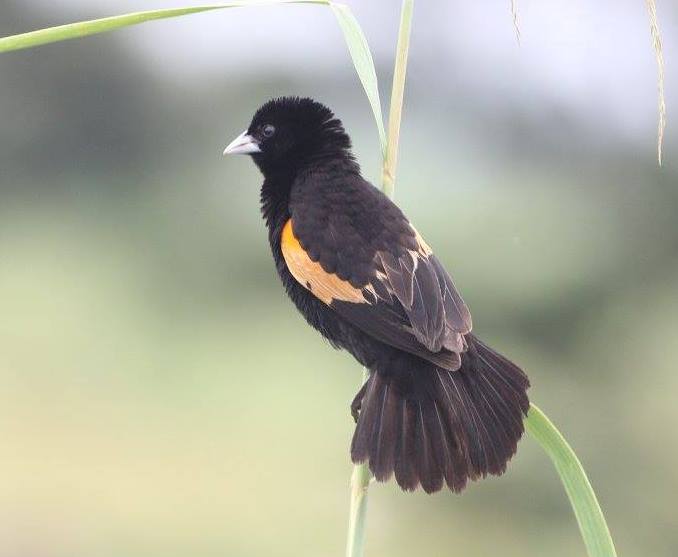
Wikipedia: Fan-tailed widowbird Source: OTHER
Euplectes_axillaris%2C_Linunga%2C_Birding_Weto%2C_a.jpg
![]() The fan-tailed widowbird (Euplectes axillaris), also known as the red-shouldered widowbird, is a species of bird in the family Ploceidae, which is native to grassy and swampy areas of the tropical and subtropical Afrotropics.
[more]
The fan-tailed widowbird (Euplectes axillaris), also known as the red-shouldered widowbird, is a species of bird in the family Ploceidae, which is native to grassy and swampy areas of the tropical and subtropical Afrotropics.
[more]
Profile Wikipedia eBird Xeno-Canto

Wikipedia: Yellow bishop Source: OTHER
Yellow_Bishop_-_Kenya_S4E8557_%2822662474520%29.jpg
![]() The yellow bishop, Cape bishop, Cape widow[2] or yellow-rumped widow (Euplectes capensis) is a resident breeding bird species in Angola, Botswana, Burundi, Cameroon, Congo, Equatorial Guinea, Eswatini, Ethiopia, Kenya, Lesotho, Malawi, Mozambique, Nigeria, Rwanda, South Africa, South Sudan, Tanzania, Uganda, Zambia and Zimbabwe.[1]
[more]
The yellow bishop, Cape bishop, Cape widow[2] or yellow-rumped widow (Euplectes capensis) is a resident breeding bird species in Angola, Botswana, Burundi, Cameroon, Congo, Equatorial Guinea, Eswatini, Ethiopia, Kenya, Lesotho, Malawi, Mozambique, Nigeria, Rwanda, South Africa, South Sudan, Tanzania, Uganda, Zambia and Zimbabwe.[1]
[more]
Profile Wikipedia eBird Audubon AllAboutBirds Xeno-Canto NABU

Wikipedia: Yellow-crowned bishop Source: OTHER
Euplectes_afer_-Lake_Baringo%2C_Kenya_-male-8_CROP.jpg
This bird appears across the great seas in the following continents:
Europe, North America, Africa.
![]() The yellow-crowned bishop (Euplectes afer) is a species of passerine bird in the family Ploceidae native to Africa south of the Sahara.[2] It is highly sexually dimorphic in its breeding season, during which the male adopts a distinctive yellow and black plumage, contrasting with the female's predominantly brown coloration. Three subspecies are recognised.
[more]
The yellow-crowned bishop (Euplectes afer) is a species of passerine bird in the family Ploceidae native to Africa south of the Sahara.[2] It is highly sexually dimorphic in its breeding season, during which the male adopts a distinctive yellow and black plumage, contrasting with the female's predominantly brown coloration. Three subspecies are recognised.
[more]
Profile Wikipedia eBird Xeno-Canto
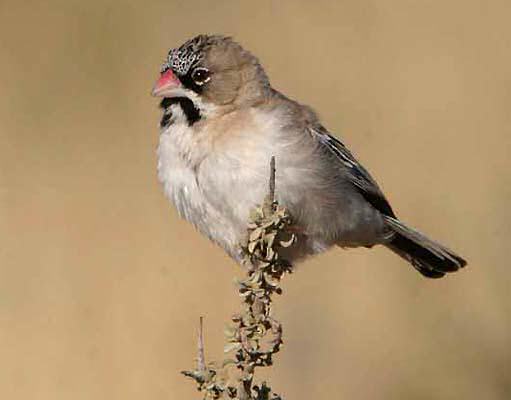
Wikipedia: Scaly weaver Source: OTHER
Scaly-feathered_Weaver.jpg
![]() The scaly-feathered weaver (Sporopipes squamifrons), also known as the scaly-feathered finch, is a species of bird in the family Ploceidae.
[more]
The scaly-feathered weaver (Sporopipes squamifrons), also known as the scaly-feathered finch, is a species of bird in the family Ploceidae.
[more]
African penduline-tit (Anthoscopus caroli)
Profile Wikipedia eBird Xeno-Canto

Wikipedia: African penduline-tit Source: OTHER
African_Penduline-Tit_%28Anthoscopus_caroli%29.jpg
![]() The grey penduline tit (Anthoscopus caroli), also known as the African penduline-tit, is a species of bird in the family Remizidae. It is found in Angola, Botswana, Burundi, Republic of the Congo, Democratic Republic of the Congo, Kenya, Malawi, Mozambique, Namibia, Rwanda, South Africa, Swaziland, Tanzania, Uganda, Zambia, and Zimbabwe. Its natural habitats are subtropical or tropical dry forests, dry savanna, and moist savanna. At 8 to 9 cm (3.1 to 3.5 in) in length and a weight of 6.5 g (0.23 oz), it is one of the smallest species of bird found in Africa, along with its cousin the Cape penduline tit and the perhaps smaller mouse-colored penduline tit and the tit hylia.[2][3]
[more]
The grey penduline tit (Anthoscopus caroli), also known as the African penduline-tit, is a species of bird in the family Remizidae. It is found in Angola, Botswana, Burundi, Republic of the Congo, Democratic Republic of the Congo, Kenya, Malawi, Mozambique, Namibia, Rwanda, South Africa, Swaziland, Tanzania, Uganda, Zambia, and Zimbabwe. Its natural habitats are subtropical or tropical dry forests, dry savanna, and moist savanna. At 8 to 9 cm (3.1 to 3.5 in) in length and a weight of 6.5 g (0.23 oz), it is one of the smallest species of bird found in Africa, along with its cousin the Cape penduline tit and the perhaps smaller mouse-colored penduline tit and the tit hylia.[2][3]
[more]
Southern penduline-tit (Anthoscopus minutus)

Wikipedia: Southern penduline-tit Source: OTHER
Southern_Penduline-Tit_%28Anthoscopus_minutus%29.jpg
![]() The Cape penduline tit or southern penduline tit (Anthoscopus minutus) is a species of bird in the family Remizidae.
It is found in Angola, Botswana, Namibia, South Africa, and Zimbabwe.
Its natural habitats are dry savannah, subtropical or tropical dry shrubland, and Mediterranean-type shrubby vegetation. At 8 cm (3.1 in) in length, it is one of the smallest species of bird found in Africa, along with its cousins the grey penduline tit and the mouse-coloured penduline tit.[2][3]
[more]
The Cape penduline tit or southern penduline tit (Anthoscopus minutus) is a species of bird in the family Remizidae.
It is found in Angola, Botswana, Namibia, South Africa, and Zimbabwe.
Its natural habitats are dry savannah, subtropical or tropical dry shrubland, and Mediterranean-type shrubby vegetation. At 8 cm (3.1 in) in length, it is one of the smallest species of bird found in Africa, along with its cousins the grey penduline tit and the mouse-coloured penduline tit.[2][3]
[more]
Southern black-tit (Melaniparus niger)
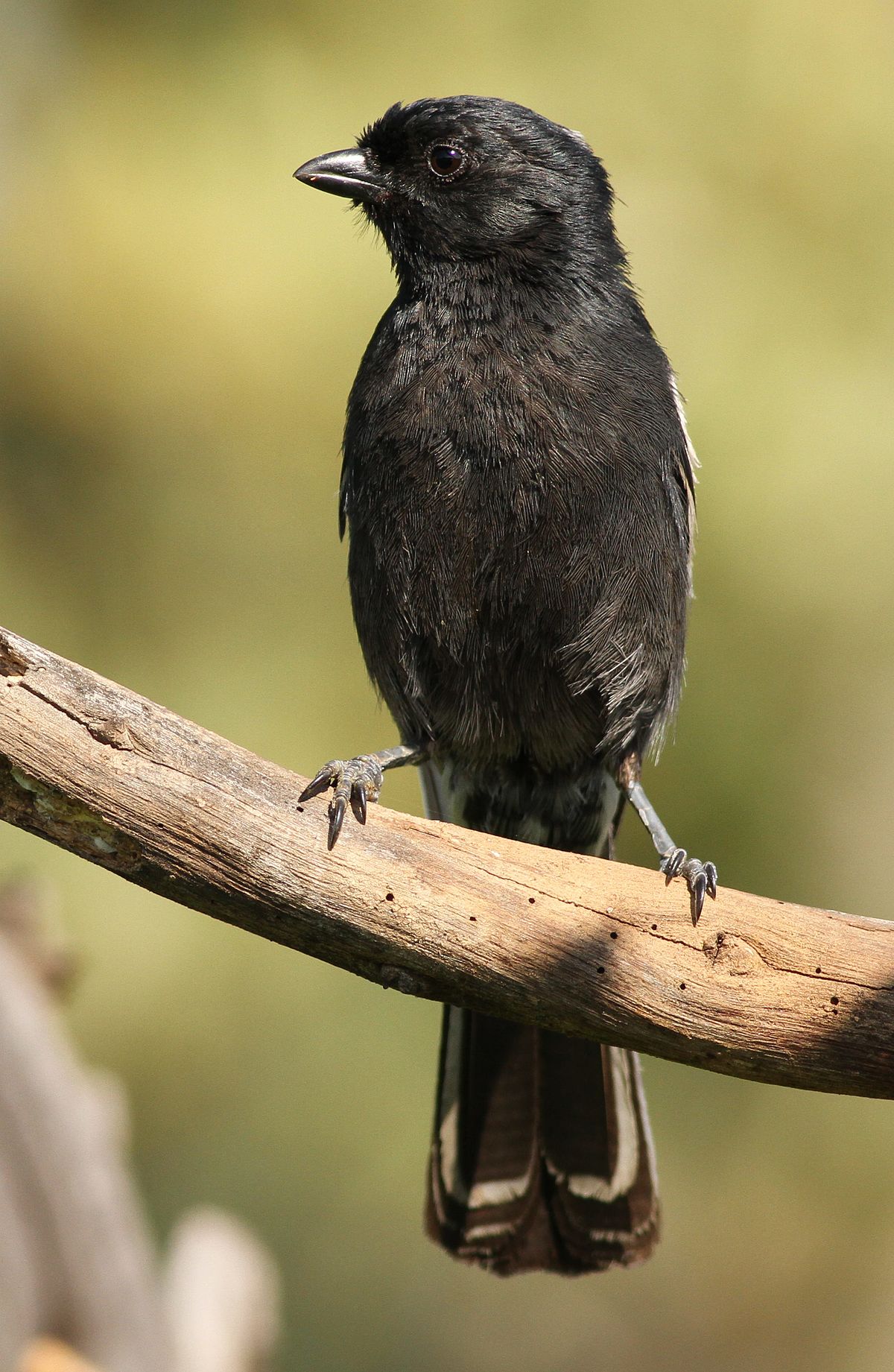
Wikipedia: Southern black-tit Source: OTHER
1200px-Southern_Black_Tit%2C_Parus_niger%2C_at_Pilanesberg_National_Park%2C_Northwest_Province%2C_South_Africa_%2816834192359%29.jpg
![]() The southern black tit or simply black tit (Melaniparus niger) is a species of bird in the tit family Paridae, which is native to woodland habitats in southern Africa.
[more]
The southern black tit or simply black tit (Melaniparus niger) is a species of bird in the tit family Paridae, which is native to woodland habitats in southern Africa.
[more]
Grey tit (Melaniparus afer)

Wikipedia: Grey tit Source: OTHER
Parus_afer_-Namaqua_National_Park%2C_Northern_Cape%2C_South_Africa_-adult-6.jpg
![]() The grey tit (Melaniparus afer) is a species of bird in the family Paridae.
It is found in Lesotho and South Africa.
Its natural habitats are subtropical or tropical dry shrubland and Mediterranean-type shrubby vegetation.
[more]
The grey tit (Melaniparus afer) is a species of bird in the family Paridae.
It is found in Lesotho and South Africa.
Its natural habitats are subtropical or tropical dry shrubland and Mediterranean-type shrubby vegetation.
[more]
Ashy tit (Melaniparus cinerascens)

Wikipedia: Ashy tit Source: OTHER
1200px-Melaniparus_cinerascens_%28cropped%29.jpg
![]() The ashy tit (Melaniparus cinerascens) is a species of bird in the family Paridae. It is found in Angola, Botswana, Namibia, South Africa, and Zimbabwe. Its natural habitats are subtropical or tropical dry forests and dry savanna.
[more]
The ashy tit (Melaniparus cinerascens) is a species of bird in the family Paridae. It is found in Angola, Botswana, Namibia, South Africa, and Zimbabwe. Its natural habitats are subtropical or tropical dry forests and dry savanna.
[more]
African pitta / Angolapitta (Pitta angolensis)
Profile Wikipedia eBird Xeno-Canto

Wikipedia: African pitta Source: OTHER
1200px-African_Pitta_%28Pitta_angolensis%29%2C_Hwange_National_Park%2C_Zimbabwe.jpg
![]() The African pitta (Pitta angolensis) is an Afrotropical bird of the family Pittidae. It is a locally common[2] to uncommon species, resident and migratory in the west, and an intra-African migrant between equatorial and southeastern Africa.[3] They are elusive and hard to observe despite their brightly coloured plumage,[4] and their loud, explosive calls are infrequently heard. The plump, somewhat thrush-like birds[5] forage on leaf litter under the canopy of riparian or coastal forest and thickets,[6] or in climax miombo forest. They spend much time during mornings and at dusk scratching in leaf litter or around termitaria,[7] or may stand motionless for long periods.[8] Following rains[9] breeding birds call and display from the mid-canopy.[8]
[more]
The African pitta (Pitta angolensis) is an Afrotropical bird of the family Pittidae. It is a locally common[2] to uncommon species, resident and migratory in the west, and an intra-African migrant between equatorial and southeastern Africa.[3] They are elusive and hard to observe despite their brightly coloured plumage,[4] and their loud, explosive calls are infrequently heard. The plump, somewhat thrush-like birds[5] forage on leaf litter under the canopy of riparian or coastal forest and thickets,[6] or in climax miombo forest. They spend much time during mornings and at dusk scratching in leaf litter or around termitaria,[7] or may stand motionless for long periods.[8] Following rains[9] breeding birds call and display from the mid-canopy.[8]
[more]
Rosy starling / Rosenstar (Pastor roseus)

Wikipedia: Rosy starling Source: OTHER
Rosy_Starling_-_Almaty_-_Kazakstan_S4E1244_%2822382991808%29.jpg
![]() The rosy starling (Pastor roseus) is a passerine bird in the starling family, Sturnidae, also known as the rose-coloured starling or rose-coloured pastor.[2] The species was recently placed in its own monotypic genus, Pastor, and split from Sturnus. This split is supported by recent studies, though other related species within its new genus are not yet known for certain.[3]
[more]
The rosy starling (Pastor roseus) is a passerine bird in the starling family, Sturnidae, also known as the rose-coloured starling or rose-coloured pastor.[2] The species was recently placed in its own monotypic genus, Pastor, and split from Sturnus. This split is supported by recent studies, though other related species within its new genus are not yet known for certain.[3]
[more]
Lesser blue-eared starling / Messingglanzstar (Lamprotornis chloropterus)
Profile Wikipedia eBird Xeno-Canto

Wikipedia: Lesser blue-eared starling Source: OTHER
1200px-Lesser_Blue-eared_Starling_%28Lamprotornis_chloropterus%29%2C_Koubalan%2C_Senegal.jpg
![]() The lesser blue-eared starling or lesser blue-eared glossy-starling (Lamprotornis chloropterus) is a species of starling in the family Sturnidae.
It is found in Benin, Burkina Faso, Burundi, Cameroon, the Central African Republic, Chad, the Democratic Republic of the Congo, Eritrea, Ethiopia, Gambia, Ghana, Guinea, Guinea-Bissau, Ivory Coast, Kenya, Liberia, Malawi, Mali, Mozambique, Namibia, Nigeria, Senegal, Sierra Leone, South Sudan, Sudan, Tanzania, Togo, Uganda, Zambia, and Zimbabwe.
[more]
The lesser blue-eared starling or lesser blue-eared glossy-starling (Lamprotornis chloropterus) is a species of starling in the family Sturnidae.
It is found in Benin, Burkina Faso, Burundi, Cameroon, the Central African Republic, Chad, the Democratic Republic of the Congo, Eritrea, Ethiopia, Gambia, Ghana, Guinea, Guinea-Bissau, Ivory Coast, Kenya, Liberia, Malawi, Mali, Mozambique, Namibia, Nigeria, Senegal, Sierra Leone, South Sudan, Sudan, Tanzania, Togo, Uganda, Zambia, and Zimbabwe.
[more]
Meves's glossy-starling (Lamprotornis mevesii)

Wikipedia: Meves's glossy-starling Source: OTHER
Lamprotornis_mevesii_-Mapungubwe_National_Park%2C_Limpopo%2C_South_Africa-8.jpg
![]() Meves's starling (Lamprotornis mevesii) or Meves's glossy-starling, is a species of starling in the family Sturnidae. It is found in Angola, Botswana, Malawi, Mozambique, Namibia, South Africa, Zambia, and Zimbabwe.
[more]
Meves's starling (Lamprotornis mevesii) or Meves's glossy-starling, is a species of starling in the family Sturnidae. It is found in Angola, Botswana, Malawi, Mozambique, Namibia, South Africa, Zambia, and Zimbabwe.
[more]
Greater blue-eared starling (Lamprotornis chalybaeus)
Profile Wikipedia eBird Xeno-Canto
Probably Greater blue-eared starling. 2016-09-28 16.56.56 Botswana
First observed in Botswana on 2016-09-28.
![]() The greater blue-eared starling or greater blue-eared glossy-starling (Lamprotornis chalybaeus) is a bird that breeds from Senegal east to Ethiopia and south through eastern Africa to northeastern South Africa and Angola. It is a very common species of open woodland bird, and undertakes some seasonal migration.
[more]
The greater blue-eared starling or greater blue-eared glossy-starling (Lamprotornis chalybaeus) is a bird that breeds from Senegal east to Ethiopia and south through eastern Africa to northeastern South Africa and Angola. It is a very common species of open woodland bird, and undertakes some seasonal migration.
[more]
Burchell's glossy-starling / Riesenglanzstar (Lamprotornis australis)

Wikipedia: Burchell's glossy-starling Source: OTHER
1200px-Burchell%27s_Starling_%28Lamprotornis_australis%29_%2816394703987%29.jpg
![]() Burchell's starling (Lamprotornis australis) or Burchell's glossy-starling, is a species of starling in the family Sturnidae. The monogamous and presumably sedentary[2] species is native to dry and mesic woodlands and savannah of southern Africa. The name of this bird commemorates the English naturalist William John Burchell.[3]
[more]
Burchell's starling (Lamprotornis australis) or Burchell's glossy-starling, is a species of starling in the family Sturnidae. The monogamous and presumably sedentary[2] species is native to dry and mesic woodlands and savannah of southern Africa. The name of this bird commemorates the English naturalist William John Burchell.[3]
[more]
Red-shouldered glossy-starling (Lamprotornis nitens)
Cape starling or black-bellied or even burchells. 2016-09-24 09.10.06 Botswana
First observed in Botswana on 2016-09-24.
![]() The Cape starling, red-shouldered glossy-starling or Cape glossy starling (Lamprotornis nitens) is a species of starling in the family Sturnidae. It is found in southern Africa, where it lives in woodlands, bushveld and in suburbs.[4]
[more]
The Cape starling, red-shouldered glossy-starling or Cape glossy starling (Lamprotornis nitens) is a species of starling in the family Sturnidae. It is found in southern Africa, where it lives in woodlands, bushveld and in suburbs.[4]
[more]
African pied starling (Lamprotornis bicolor)
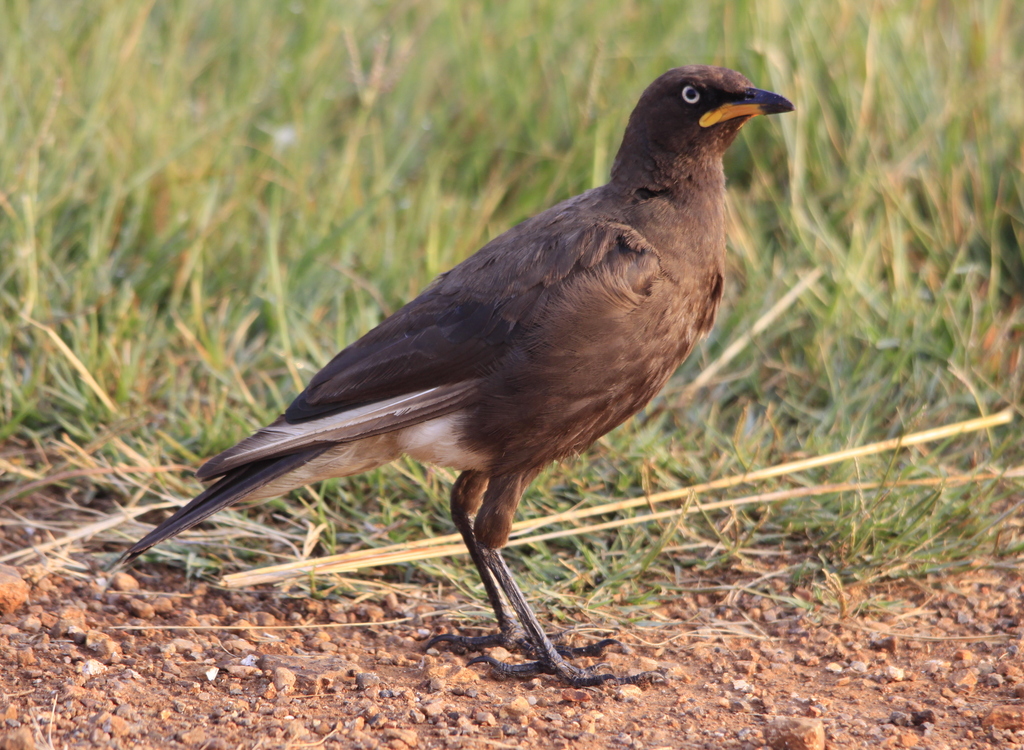
Wikipedia: African pied starling Source: OTHER
Lamprotornis_bicolor_-Rietvlei_Nature_Reserve%2C_Pretoria%2C_South_Africa_-adult-8.jpg
![]() The pied starling or African pied starling, (Lamprotornis bicolor) is a bird endemic to South Africa, Lesotho and Swaziland. It is common in most of its range, but largely absent from the arid northwest and the eastern lowlands of South Africa. It is found in open habitats such as grassland, karoo scrub, thornbush and agricultural land, and often associates with farm animals.[2]
[more]
The pied starling or African pied starling, (Lamprotornis bicolor) is a bird endemic to South Africa, Lesotho and Swaziland. It is common in most of its range, but largely absent from the arid northwest and the eastern lowlands of South Africa. It is found in open habitats such as grassland, karoo scrub, thornbush and agricultural land, and often associates with farm animals.[2]
[more]
Wattled starling / Lappenstar (Creatophora cinerea)
Profile Wikipedia eBird Xeno-Canto

Wikipedia: Wattled starling Source: OTHER
1200px-Wattled_Starling_%28Creatophora_cinerea%29_%286017306206%29%2C_crop.jpg
![]() The wattled starling (Creatophora cinerea) is a nomadic resident bird in eastern and southern Africa. It is a species of grassland, open woodland, and cultivation.
[more]
The wattled starling (Creatophora cinerea) is a nomadic resident bird in eastern and southern Africa. It is a species of grassland, open woodland, and cultivation.
[more]
Common myna (Acridotheres tristis)
First common myna seen on trip to SE Asia, in Wat Pho, Bangkok. 2024-01-19 17.00.32 Thailand
First observed in Thailand on 2024-01-19.
This bird appears across the great seas in the following continents:
North America, Africa, Asia.
![]() The common myna or Indian myna (Acridotheres tristis), sometimes spelled mynah,[2] is a member of the family Sturnidae (starlings and mynas) native to Asia. An omnivorous open woodland bird with a strong territorial instinct, the common myna has adapted extremely well to urban environments.
[more]
The common myna or Indian myna (Acridotheres tristis), sometimes spelled mynah,[2] is a member of the family Sturnidae (starlings and mynas) native to Asia. An omnivorous open woodland bird with a strong territorial instinct, the common myna has adapted extremely well to urban environments.
[more]
Song:
Automatically generated from Xeno-Canto recording
Song attributes:
Frequency:
♫ XC729094 - Common Myna - Acridotheres tristis tristis. Source: XENOCANTO
XC729094 - Common Myna - Acridotheres tristis tristis.mp3
(song)
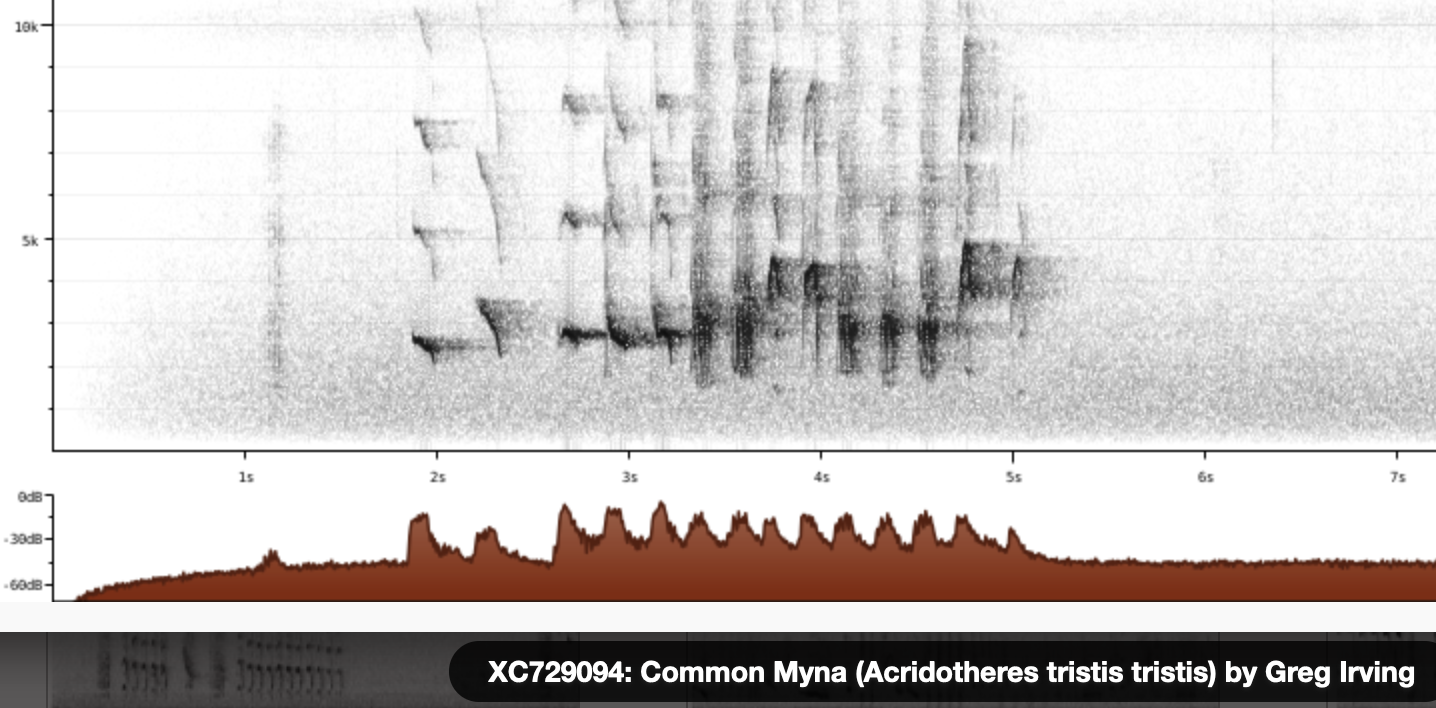
Yellow-billed oxpecker (Buphagus africanus)
Profile Wikipedia eBird Xeno-Canto

Wikipedia: Yellow-billed oxpecker Source: OTHER
Flickr_-_Rainbirder_-_Yellow-billed_Oxpecker_%28Buphagus_africanus%29.jpg
![]() The yellow-billed oxpecker (Buphagus africanus) is a passerine bird in the family Buphagidae. It was previously placed in the starling and myna family, Sturnidae.
[more]
The yellow-billed oxpecker (Buphagus africanus) is a passerine bird in the family Buphagidae. It was previously placed in the starling and myna family, Sturnidae.
[more]
Violet-backed starling (Cinnyricinclus leucogaster)
Profile Wikipedia eBird Xeno-Canto

Wikipedia: Violet-backed starling Source: OTHER
1200px-Violet-backed_starling_%28Cinnyricinclus_leucogaster_verreauxi%29_male.jpg
![]() The violet-backed starling (Cinnyricinclus leucogaster), also known as the plum-coloured starling or amethyst starling, is a relatively small species (17 cm) of starling in the family Sturnidae. It is the only member of the genus Cinnyricinclus. This strongly sexually dimorphic species is found widely in the woodlands and savannah forest edges of mainland sub-Saharan Africa. It is rarely seen on the ground, but instead found in trees and other locations away from the ground.
[more]
The violet-backed starling (Cinnyricinclus leucogaster), also known as the plum-coloured starling or amethyst starling, is a relatively small species (17 cm) of starling in the family Sturnidae. It is the only member of the genus Cinnyricinclus. This strongly sexually dimorphic species is found widely in the woodlands and savannah forest edges of mainland sub-Saharan Africa. It is rarely seen on the ground, but instead found in trees and other locations away from the ground.
[more]
Pale-winged starling (Onychognathus nabouroup)
Profile Wikipedia eBird Xeno-Canto

Wikipedia: Pale-winged starling Source: OTHER
1200px-Pale-winged_starling_%28Onychognathus_nabouroup%29.jpg
![]() The pale-winged starling (Onychognathus nabouroup) is a species of starling in the family Sturnidae. It is found in Angola, Botswana, Namibia, and South Africa.
[more]
The pale-winged starling (Onychognathus nabouroup) is a species of starling in the family Sturnidae. It is found in Angola, Botswana, Namibia, and South Africa.
[more]
Red-winged starling (Onychognathus morio)
Profile Wikipedia eBird Xeno-Canto
Red-winged starlings bickering or merely chattering. 2009-11-04 12.18.10 Gqeberha (former Port Elisabeth)
First observed in Gqeberha (former Port Elisabeth) on 2009-11-04.
![]() The red-winged starling (Onychognathus morio) is a bird of the starling family Sturnidae native to eastern Africa from Ethiopia to the Cape in South Africa. An omnivorous, generalist species, it prefers cliffs and mountainous areas for nesting, and has moved into cities and towns due to similarity to its original habitat.
[more]
The red-winged starling (Onychognathus morio) is a bird of the starling family Sturnidae native to eastern Africa from Ethiopia to the Cape in South Africa. An omnivorous, generalist species, it prefers cliffs and mountainous areas for nesting, and has moved into cities and towns due to similarity to its original habitat.
[more]
Black-bellied glossy-starling (Notopholia corusca)

Wikipedia: Black-bellied glossy-starling Source: OTHER
Black-bellied_Glossy-Starling_-_Mkuze_-_Natal_S4E8977_%2822775346556%29.jpg
![]() The black-bellied starling (Notopholia corusca) is a species of starling in the family Sturnidae. It is found in Kenya, Mozambique, Somalia, South Africa, Swaziland, Tanzania, and Zimbabwe.
[more]
The black-bellied starling (Notopholia corusca) is a species of starling in the family Sturnidae. It is found in Kenya, Mozambique, Somalia, South Africa, Swaziland, Tanzania, and Zimbabwe.
[more]
Kurrichane thrush (Turdus libonyana)

Wikipedia: Kurrichane thrush Source: OTHER
1200px-Kurrichane_Thrush%2C_Sakania%2C_DRC_%287001803096%29.jpg
![]() The Kurrichane thrush (Turdus libonyana) is a species of bird in the thrush family Turdidae. The species is found from central through to southern Africa. Its natural habitat is dry savanna and woodland, predominantly miombo woodland.
[more]
The Kurrichane thrush (Turdus libonyana) is a species of bird in the thrush family Turdidae. The species is found from central through to southern Africa. Its natural habitat is dry savanna and woodland, predominantly miombo woodland.
[more]
Olive thrush (Turdus olivaceus)
Profile Wikipedia eBird Xeno-Canto

Wikipedia: Olive thrush Source: OTHER
1200px-Olive_Thrush_RWD.jpg
![]() The olive thrush (Turdus olivaceus) is, in its range, one of the most common members of the thrush family (Turdidae). It occurs in African highlands from southern Malawi and Mozambique in the north to the Cape of Good Hope in the south.[2] It is a bird of forest and woodland, but has locally adapted to parks and large gardens in suburban areas.
[more]
The olive thrush (Turdus olivaceus) is, in its range, one of the most common members of the thrush family (Turdidae). It occurs in African highlands from southern Malawi and Mozambique in the north to the Cape of Good Hope in the south.[2] It is a bird of forest and woodland, but has locally adapted to parks and large gardens in suburban areas.
[more]
Karoo thrush (Turdus smithi)

Wikipedia: Karoo thrush Source: OTHER
1200px-Turdus_smithi_%28Karoo_Thrush%29_on_lawn_%28crop%29.jpg
![]() The Karoo thrush (Turdus smithi) also known as Smith's thrush, is a member of the thrush family in Africa. It has traditionally been considered a subspecies of the olive thrush (with which it is known to hybridize), but is increasingly treated as a separate species.
[more]
The Karoo thrush (Turdus smithi) also known as Smith's thrush, is a member of the thrush family in Africa. It has traditionally been considered a subspecies of the olive thrush (with which it is known to hybridize), but is increasingly treated as a separate species.
[more]
Short-toed rock-thrush (Monticola brevipes)
Profile Wikipedia eBird Xeno-Canto

Wikipedia: Short-toed rock-thrush Source: OTHER
Monticola_brevipes.jpg
![]() The short-toed rock thrush (Monticola brevipes) is a species of bird in the family Muscicapidae. It is found in Angola, Botswana, Namibia, and South Africa. Its natural habitat is subtropical or tropical dry shrubland.
[more]
The short-toed rock thrush (Monticola brevipes) is a species of bird in the family Muscicapidae. It is found in Angola, Botswana, Namibia, and South Africa. Its natural habitat is subtropical or tropical dry shrubland.
[more]
Sentinel rock-thrush (Monticola explorator)
Profile Wikipedia eBird Xeno-Canto

Wikipedia: Sentinel rock-thrush Source: OTHER
1200px-Monticola_explorator_-Cape_Town%2C_Western_Cape%2C_South_Africa_-male-8.jpg
![]() The sentinel rock thrush (Monticola explorator) is a species of bird in the family Muscicapidae.[2]
It is found in Lesotho, South Africa, and Swaziland.
Its natural habitat is subtropical or tropical high-altitude grassland.
[more]
The sentinel rock thrush (Monticola explorator) is a species of bird in the family Muscicapidae.[2]
It is found in Lesotho, South Africa, and Swaziland.
Its natural habitat is subtropical or tropical high-altitude grassland.
[more]
Cape rock-thrush (Monticola rupestris)
Profile Wikipedia eBird Xeno-Canto

Wikipedia: Cape rock-thrush Source: OTHER
Monticola_rupestris_-Marakele_National_Park%2C_South_Africa_-male-8_%281%29.jpg
![]() The Cape rock thrush (Monticola rupestris) is a member of the bird family Muscicapidae. This rock thrush breeds in eastern and southern South Africa, Lesotho and Swaziland. It is a common endemic resident, non-migratory apart from seasonal altitudinal movements in some areas.
[more]
The Cape rock thrush (Monticola rupestris) is a member of the bird family Muscicapidae. This rock thrush breeds in eastern and southern South Africa, Lesotho and Swaziland. It is a common endemic resident, non-migratory apart from seasonal altitudinal movements in some areas.
[more]
Orange ground-thrush (Geokichla gurneyi)
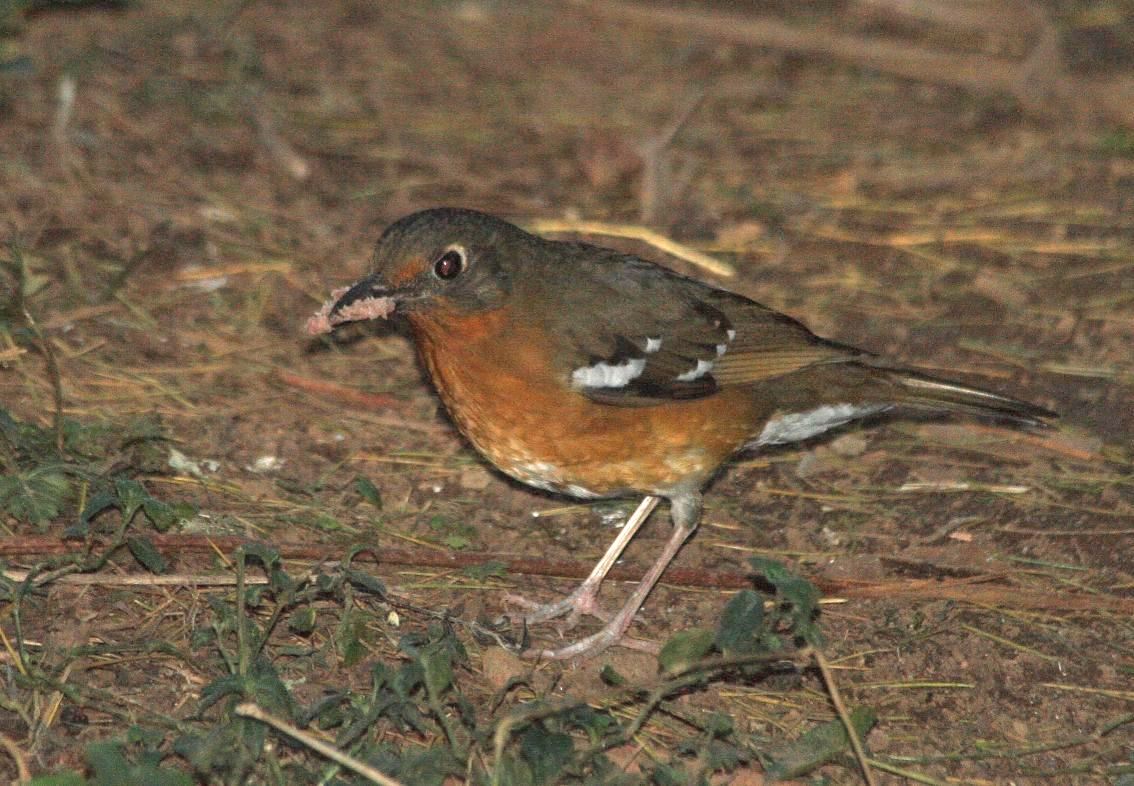
Wikipedia: Orange ground-thrush Source: OTHER
Orange_Ground-Thrush_2008_09_14_07_07_15_1026.jpg
![]() The orange ground thrush (Geokichla gurneyi) is a species of bird in the family Turdidae.
[more]
The orange ground thrush (Geokichla gurneyi) is a species of bird in the family Turdidae.
[more]
Spotted ground-thrush (Geokichla guttata)
Profile Wikipedia eBird Xeno-Canto

Wikipedia: Spotted ground-thrush Source: OTHER
Spotted_Ground_Thrush.jpg
![]() The spotted ground thrush (Geokichla guttata) is a species of bird in the family Turdidae. It is found in the Democratic Republic of the Congo, Kenya, Malawi, South Africa, Sudan, Tanzania, and possibly Mozambique.
[more]
The spotted ground thrush (Geokichla guttata) is a species of bird in the family Turdidae. It is found in the Democratic Republic of the Congo, Kenya, Malawi, South Africa, Sudan, Tanzania, and possibly Mozambique.
[more]
Dusky alseonax (Muscicapa adusta)

Wikipedia: Dusky alseonax Source: OTHER
1200px-African_Dusky_Flycatcher.jpg
![]() The African dusky flycatcher (Muscicapa adusta), dusky-brown flycatcher or dusky alseonax, is a small passerine bird of the Old World flycatcher family, Muscicapidae. It is a resident breeder in Africa from Nigeria, the Central African Republic, South Sudan and Ethiopia south to South Africa. It is very common in its woodland habitat, which includes riverine forests, evergreen forest edges and clearings, especially near water bodies such as lakes, dams and streams, and well-wooded suburban gardens.
[more]
The African dusky flycatcher (Muscicapa adusta), dusky-brown flycatcher or dusky alseonax, is a small passerine bird of the Old World flycatcher family, Muscicapidae. It is a resident breeder in Africa from Nigeria, the Central African Republic, South Sudan and Ethiopia south to South Africa. It is very common in its woodland habitat, which includes riverine forests, evergreen forest edges and clearings, especially near water bodies such as lakes, dams and streams, and well-wooded suburban gardens.
[more]
Common stonechat / Afrikanische Schwarzkehlchen (Saxicola torquatus)
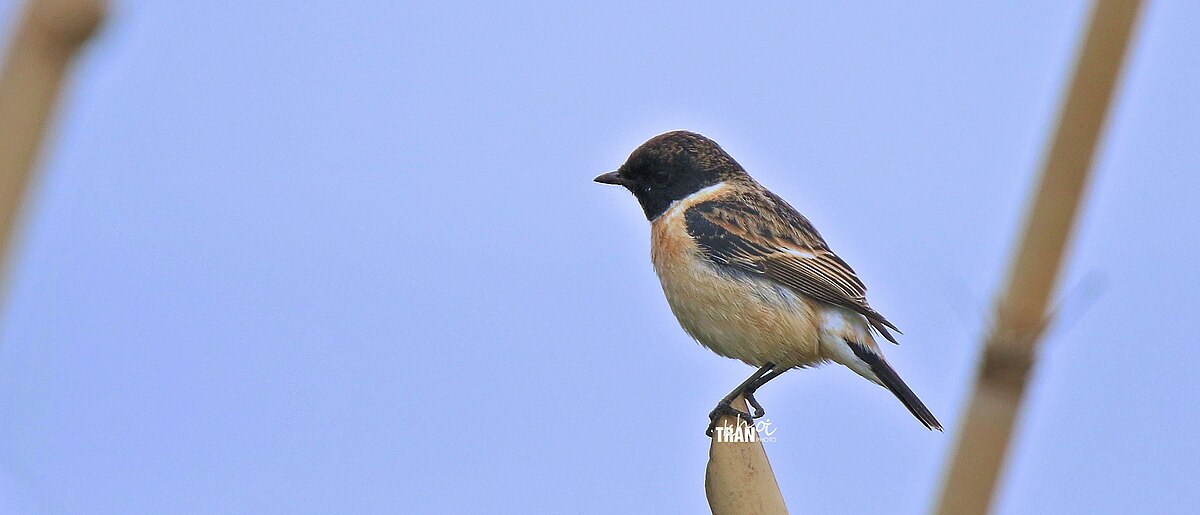
Wikipedia: Common stonechat Source: OTHER
1200px-Saxicola_stejnegeri%2C_Hanoi%2C_Vietnam_4G4A3231.jpg
Song:
Automatically generated from Xeno-Canto recording
Song attributes:
Frequency:
♫ XC710467 - European Stonechat - Saxicola rubicola rubicola. Source: XENOCANTO
XC710467 - European Stonechat - Saxicola rubicola rubicola.mp3
(song)
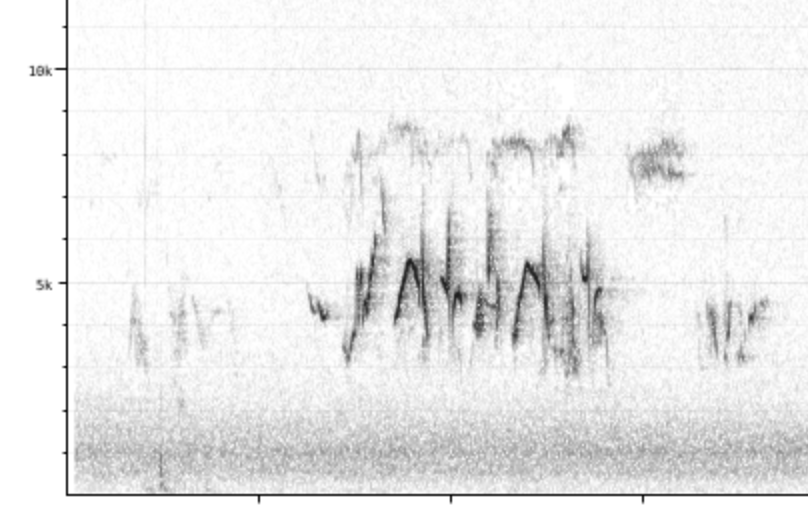
Bearded scrub-robin (Cercotrichas quadrivirgata)

Wikipedia: Bearded scrub-robin Source: OTHER
1200px-Bearded_scrub_robin_%28Cercotrichas_quadrivirgata%29.jpg
![]() The bearded scrub robin (Cercotrichas quadrivirgata), also known as the eastern bearded scrub robin,[1][2] is a species of bird in the family Muscicapidae. It is found in eastern and southern Africa.
[more]
The bearded scrub robin (Cercotrichas quadrivirgata), also known as the eastern bearded scrub robin,[1][2] is a species of bird in the family Muscicapidae. It is found in eastern and southern Africa.
[more]
Karoo scrub-robin (Cercotrichas coryphoeus)

Wikipedia: Karoo scrub-robin Source: OTHER
Cercotrichas_coryphoeus%2C_Namaqua_National_Park%2C_South_Africa.jpg
![]() The Karoo scrub robin (Cercotrichas coryphaeus) or Karoo Robin, is a species of bird in the family Muscicapidae. It is found in Lesotho, Namibia, and South Africa. Its natural habitats are dry shrubland and Mediterranean-type shrubby vegetation.
[more]
The Karoo scrub robin (Cercotrichas coryphaeus) or Karoo Robin, is a species of bird in the family Muscicapidae. It is found in Lesotho, Namibia, and South Africa. Its natural habitats are dry shrubland and Mediterranean-type shrubby vegetation.
[more]
Kalahari scrub-robin (Cercotrichas paena)
Profile Wikipedia eBird Xeno-Canto

Wikipedia: Kalahari scrub-robin Source: OTHER
1200px-Kalahari_scrub_robin%2C_Erythropygia_paena_at_Pilanesberg_National_Park%2C_Northwest_Province%2C_South_Africa_%2817455045501%29.jpg
![]() The Kalahari scrub robin (Cercotricha paena) is a species of bird in the family Muscicapidae. It is sometimes known as the sandy scrub robin.
[more]
The Kalahari scrub robin (Cercotricha paena) is a species of bird in the family Muscicapidae. It is sometimes known as the sandy scrub robin.
[more]
Brown scrub-robin (Cercotrichas signata)

Wikipedia: Brown scrub-robin Source: OTHER
Cercotrichas_signata_tongensis%2C_volwassene%2C_St_Lucia%2C_Birding_Weto%2C_a.jpg
![]() The brown scrub robin (Cercotrichas signata) is a species of bird in the family Muscicapidae. It is found in Mozambique, South Africa, and Swaziland. Its natural habitat is subtropical dry or moist forests.
[more]
The brown scrub robin (Cercotrichas signata) is a species of bird in the family Muscicapidae. It is found in Mozambique, South Africa, and Swaziland. Its natural habitat is subtropical dry or moist forests.
[more]
Rufous-tailed scrub-robin (Cercotrichas galactotes)
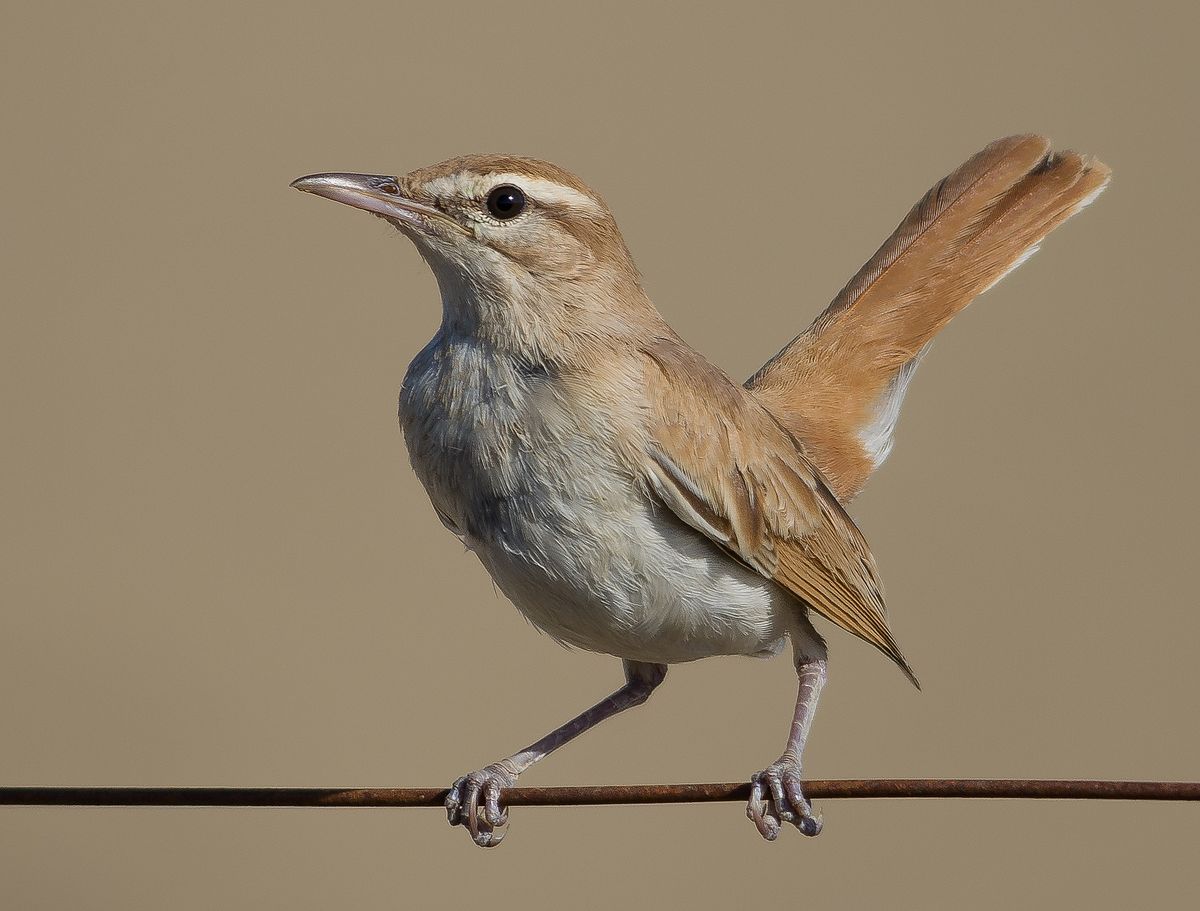
Wikipedia: Rufous-tailed scrub-robin Source: OTHER
1200px-Agrobate_roux_au_Parc_National_de_l%27Ichkeul_%28Tunisia%29%2C_crop.jpg
![]() The rufous-tailed scrub robin (Cercotrichas galactotes) is a medium-sized member of the family Muscicapidae. Other common names include the rufous scrub robin, rufous bush chat, rufous bush robin[2] and the rufous warbler.[3] It breeds around the Mediterranean and east to Pakistan. It also breeds south of the Sahara from the Sahel region east to Somalia; these African birds are sometimes considered to be a separate species, the African scrub robin (C. minor). It is partially migratory, wintering in Africa (Kenya, South Sudan, Ethiopia, Somalia) and India. This is a very rare visitor to northern Europe.
[more]
The rufous-tailed scrub robin (Cercotrichas galactotes) is a medium-sized member of the family Muscicapidae. Other common names include the rufous scrub robin, rufous bush chat, rufous bush robin[2] and the rufous warbler.[3] It breeds around the Mediterranean and east to Pakistan. It also breeds south of the Sahara from the Sahel region east to Somalia; these African birds are sometimes considered to be a separate species, the African scrub robin (C. minor). It is partially migratory, wintering in Africa (Kenya, South Sudan, Ethiopia, Somalia) and India. This is a very rare visitor to northern Europe.
[more]
White-browed robin-chat (Cossypha heuglini)
Profile Wikipedia eBird Xeno-Canto

Wikipedia: White-browed robin-chat Source: OTHER
White-browed_Robin-Chat_%28Cossypha_heuglini%29.jpg
![]() The white-browed robin-chat (Cossypha heuglini), also known as Heuglin's robin,[2] is a species of bird in the family Muscicapidae. Found in east, central and southern Africa,[3] its natural habitats include riverine forest and thickets, and it is also found near humans. The IUCN classifies it as a least-concern species.
[more]
The white-browed robin-chat (Cossypha heuglini), also known as Heuglin's robin,[2] is a species of bird in the family Muscicapidae. Found in east, central and southern Africa,[3] its natural habitats include riverine forest and thickets, and it is also found near humans. The IUCN classifies it as a least-concern species.
[more]
Chorister robin-chat (Cossypha dichroa)
Profile Wikipedia eBird Xeno-Canto

Wikipedia: Chorister robin-chat Source: OTHER
1200px-Chorister_Robin-Chat_2016_06_11_6798.jpg
![]() The chorister robin-chat (Cossypha dichroa) (previously known as the chorister robin) is a species of bird in the family Muscicapidae.
It is found in South Africa and Swaziland. Its distribution stretches from the southern Western Cape through the Eastern Cape, KwaZulu-Natal, Swaziland and Mpumalanga to northern Limpopo.
[more]
The chorister robin-chat (Cossypha dichroa) (previously known as the chorister robin) is a species of bird in the family Muscicapidae.
It is found in South Africa and Swaziland. Its distribution stretches from the southern Western Cape through the Eastern Cape, KwaZulu-Natal, Swaziland and Mpumalanga to northern Limpopo.
[more]
Red-capped robin-chat (Cossypha natalensis)
Profile Wikipedia eBird Xeno-Canto

Wikipedia: Red-capped robin-chat Source: OTHER
Red-capped_Robin-Chat_%28Cossypha_natalensis%29.jpg
![]() The red-capped robin-chat or Natal robin (Cossypha natalensis) is a species of bird in the family Muscicapidae.
[more]
The red-capped robin-chat or Natal robin (Cossypha natalensis) is a species of bird in the family Muscicapidae.
[more]
Cape robin-chat / Kaprötel (Cossypha caffra)
Profile Wikipedia eBird Xeno-Canto
Hmm, maybe Cape robin-chat. 2009-10-20 14.48.06 Gqeberha (former Port Elisabeth)
First observed in Gqeberha (former Port Elisabeth) on 2009-10-20.
![]() The Cape robin-chat (Cossypha caffra) is a small passerine bird of the Old World flycatcher family Muscicapidae. It has a disjunct range from South Sudan to South Africa.[3] The locally familiar and confiding species[6] has colonized and benefited from a range of man-altered habitats, including city suburbs and farmstead woodlots.[7] It is an accomplished songster like other robin-chats, but is rather less colourful than most, and frequents either dryer settings or higher altitudes. It forages in the proximity of cover, in the open or in fairly well-lit environments. Its distribution resembles that of the karoo–olive complex of thrushes, but it prefers the bracken-briar fringes of Afromontane forest,[7] and does not enter far into forest proper.[8] It is altitudinally segregated from the red-capped robin-chat,[8] and is less of a skulker.
[more]
The Cape robin-chat (Cossypha caffra) is a small passerine bird of the Old World flycatcher family Muscicapidae. It has a disjunct range from South Sudan to South Africa.[3] The locally familiar and confiding species[6] has colonized and benefited from a range of man-altered habitats, including city suburbs and farmstead woodlots.[7] It is an accomplished songster like other robin-chats, but is rather less colourful than most, and frequents either dryer settings or higher altitudes. It forages in the proximity of cover, in the open or in fairly well-lit environments. Its distribution resembles that of the karoo–olive complex of thrushes, but it prefers the bracken-briar fringes of Afromontane forest,[7] and does not enter far into forest proper.[8] It is altitudinally segregated from the red-capped robin-chat,[8] and is less of a skulker.
[more]
White-throated robin-chat (Cossypha humeralis)
Profile Wikipedia eBird Xeno-Canto
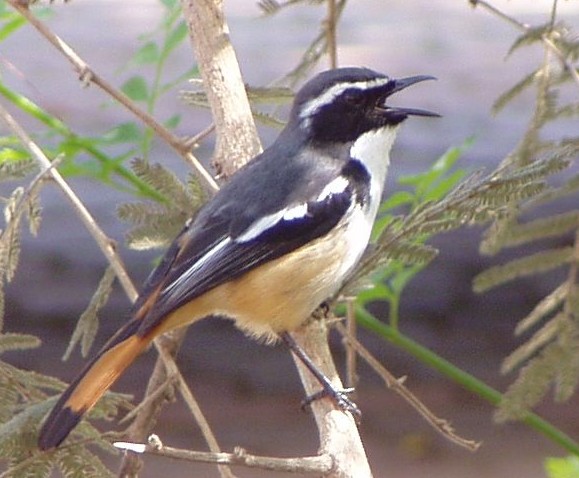
Wikipedia: White-throated robin-chat Source: OTHER
White-throated_Robin-Chat_%28Cossypha_humeralis%29.jpg
![]() The white-throated robin-chat or white-throated robin (Cossypha humeralis) is a species of bird in the family Muscicapidae. It is endemic to Botswana, Mozambique, South Africa, Swaziland, and Zimbabwe. Its natural habitats are dry savannah and subtropical or tropical dry shrubland.
[more]
The white-throated robin-chat or white-throated robin (Cossypha humeralis) is a species of bird in the family Muscicapidae. It is endemic to Botswana, Mozambique, South Africa, Swaziland, and Zimbabwe. Its natural habitats are dry savannah and subtropical or tropical dry shrubland.
[more]
White-starred robin (Pogonocichla stellata)
Profile Wikipedia eBird Xeno-Canto

Wikipedia: White-starred robin Source: OTHER
White-starred_Robin_%28Pogonocichla_stellata%29.jpg
![]() The white-starred robin (Pogonocichla stellata) is a species of bird in the Old World flycatcher and chat family Muscicapidae. It is also sometimes more simply called the starred robin. It is monotypic within the genus Pogonocichla. There are around twelve subspecies. The species is found in East and southern Africa. It is a forest species, occurring in montane forest in the north of its range but closer to sea level further south. This is a brightly coloured robin with a bright yellow breast and belly, a slate coloured head with spots on the eyes and throat and blueish wings.
[more]
The white-starred robin (Pogonocichla stellata) is a species of bird in the Old World flycatcher and chat family Muscicapidae. It is also sometimes more simply called the starred robin. It is monotypic within the genus Pogonocichla. There are around twelve subspecies. The species is found in East and southern Africa. It is a forest species, occurring in montane forest in the north of its range but closer to sea level further south. This is a brightly coloured robin with a bright yellow breast and belly, a slate coloured head with spots on the eyes and throat and blueish wings.
[more]
Southern black-flycatcher (Melaenornis pammelaina)
Profile Wikipedia eBird Xeno-Canto

Wikipedia: Southern black-flycatcher Source: OTHER
Southern_Black-Flycatcher_%28Melaenornis_pammelaina%29.jpg
![]() The southern black flycatcher (Melaenornis pammelaina) is a small passerine bird of the genus Melaenornis in the flycatcher family, Muscicapidae, native to open and lightly wooded areas of eastern and southern Africa.[2][3]
[more]
The southern black flycatcher (Melaenornis pammelaina) is a small passerine bird of the genus Melaenornis in the flycatcher family, Muscicapidae, native to open and lightly wooded areas of eastern and southern Africa.[2][3]
[more]
Fiscal flycatcher (Melaenornis silens)

Wikipedia: Fiscal flycatcher Source: OTHER
1200px-Fiscal_Flycatcher%2C_Sigelus_silens_-_male%2C_at_Suikerbosrand_Nature_Reserve%2C_Gauteng%2C_South_Africa.jpg
![]() The fiscal flycatcher (Melaenornis silens) is a small passerine bird in the Old World flycatcher family. It is a resident breeder in Botswana, South Africa, Lesotho, Mozambique and Swaziland, and a vagrant to Namibia.
[more]
The fiscal flycatcher (Melaenornis silens) is a small passerine bird in the Old World flycatcher family. It is a resident breeder in Botswana, South Africa, Lesotho, Mozambique and Swaziland, and a vagrant to Namibia.
[more]
Capped wheatear (Oenanthe pileata)
Profile Wikipedia eBird Xeno-Canto
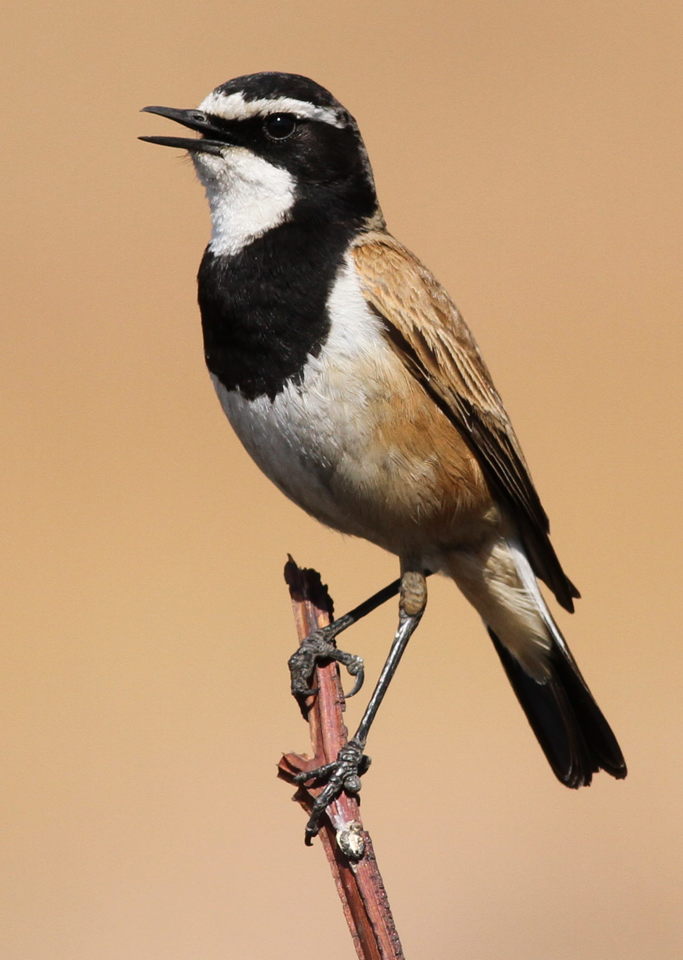
Wikipedia: Capped wheatear Source: OTHER
Capped_Wheatear%2C_Oenanthe_pileata_at_Suikerbosrand_Nature_Reserve%2C_Gauteng%2C_South_Africa.jpg
![]() The capped wheatear (Oenanthe pileata) is a small insectivorous passerine bird that was formerly classed as a member of the thrush family Turdidae, but is now more generally considered to be an Old World flycatcher, Muscicapidae.
[more]
The capped wheatear (Oenanthe pileata) is a small insectivorous passerine bird that was formerly classed as a member of the thrush family Turdidae, but is now more generally considered to be an Old World flycatcher, Muscicapidae.
[more]
Familiar chat (Oenanthe familiaris)
Profile Wikipedia eBird Xeno-Canto

Wikipedia: Familiar chat Source: OTHER
1200px-Familiar_Chat_%28Cercomela_familiaris%29_%2832594787952%29.jpg
![]() The familiar chat (Oenanthe familiaris), is a small passerine bird of the Old World flycatcher family Muscicapidae. It is a common resident breeder in Africa south of the Sahara in rocky and mountainous habitat and around human habitation.
[more]
The familiar chat (Oenanthe familiaris), is a small passerine bird of the Old World flycatcher family Muscicapidae. It is a common resident breeder in Africa south of the Sahara in rocky and mountainous habitat and around human habitation.
[more]
Pied wheatear (Oenanthe pleschanka)
Profile Wikipedia eBird Xeno-Canto NABU

Wikipedia: Pied wheatear Source: OTHER
Pied_Wheatear_%28Oenanthe_pleschanka%29_%288079431820%29.jpg
![]() The pied wheatear (Oenanthe pleschanka) is a wheatear, a small insectivorous passerine bird that was formerly classed as a member of the thrush family Turdidae, but is now more generally considered to be an Old World flycatcher (family Muscicapidae). This migratory central Asiatic wheatear occurs from the extreme southeast of Europe to China, and has been found wintering in India and northeastern Africa. It is a very rare vagrant to western Europe.
[more]
The pied wheatear (Oenanthe pleschanka) is a wheatear, a small insectivorous passerine bird that was formerly classed as a member of the thrush family Turdidae, but is now more generally considered to be an Old World flycatcher (family Muscicapidae). This migratory central Asiatic wheatear occurs from the extreme southeast of Europe to China, and has been found wintering in India and northeastern Africa. It is a very rare vagrant to western Europe.
[more]
Groundscraper thrush (Psophocichla litsitsirupa)
Profile Wikipedia eBird Xeno-Canto

Wikipedia: Groundscraper thrush Source: OTHER
1200px-Psophocichla_litsitsirupa_%28Etosha%29.jpg
![]() The groundscraper thrush (Psophocichla litsitsirupa)[3] is a passerine bird of southern and eastern Africa belonging to the thrush family, Turdidae. It is the only member of the genus Psophocichla.
[more]
The groundscraper thrush (Psophocichla litsitsirupa)[3] is a passerine bird of southern and eastern Africa belonging to the thrush family, Turdidae. It is the only member of the genus Psophocichla.
[more]
Ashy flycatcher (Fraseria caerulescens)
Profile Wikipedia eBird Xeno-Canto

Wikipedia: Ashy flycatcher Source: OTHER
1200px-Muscicapa_caerulescens.jpg
![]() The ashy flycatcher, blue-grey flycatcher[2] or ashy alseonax (Muscicapa caerulescens) is a species of bird in the family Muscicapidae. It is found throughout sub-Saharan Africa, excluding the drier areas of South Africa, Botswana, and Namibia. It inhabits subtropical or tropical dry forest, subtropical or tropical moist lowland forest, and savanna.[3] The species does not display sexual dimorphism, with both sexes being grey in colour with pale grey or white underparts. Different subspecies show minute differences in appearance.
[more]
The ashy flycatcher, blue-grey flycatcher[2] or ashy alseonax (Muscicapa caerulescens) is a species of bird in the family Muscicapidae. It is found throughout sub-Saharan Africa, excluding the drier areas of South Africa, Botswana, and Namibia. It inhabits subtropical or tropical dry forest, subtropical or tropical moist lowland forest, and savanna.[3] The species does not display sexual dimorphism, with both sexes being grey in colour with pale grey or white underparts. Different subspecies show minute differences in appearance.
[more]
Southern anteater-chat (Myrmecocichla formicivora)
Profile Wikipedia eBird Xeno-Canto

Wikipedia: Southern anteater-chat Source: OTHER
1200px-Southern_Anteater-Chat.jpg
![]() The ant-eating chat or southern anteater-chat (Myrmecocichla formicivora) is a species of bird in the family Muscicapidae.
It is found in Botswana, Eswatini, Lesotho, Namibia, South Africa, and Zimbabwe.
Its natural habitats are subtropical or tropical dry shrubland and subtropical or tropical dry lowland grassland.
[more]
The ant-eating chat or southern anteater-chat (Myrmecocichla formicivora) is a species of bird in the family Muscicapidae.
It is found in Botswana, Eswatini, Lesotho, Namibia, South Africa, and Zimbabwe.
Its natural habitats are subtropical or tropical dry shrubland and subtropical or tropical dry lowland grassland.
[more]
White-headed black-chat (Myrmecocichla arnotti)

Wikipedia: White-headed black-chat Source: OTHER
1200px-Arnot%27s_Chat_%28Myrmecocichla_arnotti%29%2C_Hwange_National_Park%2C_Zimbabwe.jpg
![]() Arnot's chat (Myrmecocichla arnotti), also known as the white-headed black-chat, is a species of bird in the chat and flycatcher family Muscicapidae. The species is found in southern Africa from Rwanda and Angola to South Africa.
[more]
Arnot's chat (Myrmecocichla arnotti), also known as the white-headed black-chat, is a species of bird in the chat and flycatcher family Muscicapidae. The species is found in southern Africa from Rwanda and Angola to South Africa.
[more]
Mocking cliff-chat (Thamnolaea cinnamomeiventris)

Wikipedia: Mocking cliff-chat Source: OTHER
1200px-Thamnolaea_cinnamomeiventris_2010_10_07_11622.jpg
![]() The mocking cliff chat, mocking chat or cliff chat, (Thamnolaea cinnamomeiventris) is a species of chat in the family Muscicapidae which occurs in rocky habitats in much of eastern Sub-Saharan Africa.
[more]
The mocking cliff chat, mocking chat or cliff chat, (Thamnolaea cinnamomeiventris) is a species of chat in the family Muscicapidae which occurs in rocky habitats in much of eastern Sub-Saharan Africa.
[more]
Buff-streaked chat (Campicoloides bifasciatus)

Wikipedia: Buff-streaked chat Source: OTHER
Campicoloides_bifasciatus.jpg
![]() The buff-streaked chat or buff-streaked bushchat, (Campicoloides bifasciatus) is a species of bird in the family Muscicapidae. It is found in Lesotho, South Africa, and Swaziland.
Its natural habitat is subtropical or tropical dry lowland grassland.
[more]
The buff-streaked chat or buff-streaked bushchat, (Campicoloides bifasciatus) is a species of bird in the family Muscicapidae. It is found in Lesotho, South Africa, and Swaziland.
Its natural habitat is subtropical or tropical dry lowland grassland.
[more]
Collared palm-thrush (Cichladusa arquata)
Profile Wikipedia eBird Xeno-Canto

Wikipedia: Collared palm-thrush Source: OTHER
1200px-Cichladusa_arquata_-near_Jongomero%2C_Ruaha_National_Park%2C_Tanzania_-two-8.jpg
![]() The collared palm thrush (Cichladusa arquata) is a species of bird in the family Muscicapidae.
It is found in Botswana, Burundi, Democratic Republic of the Congo, Kenya, Malawi, Mozambique, Rwanda, Tanzania, Uganda, Zambia, and Zimbabwe.
Its natural habitats are dry savannah and subtropical or tropical moist shrubland.
[more]
The collared palm thrush (Cichladusa arquata) is a species of bird in the family Muscicapidae.
It is found in Botswana, Burundi, Democratic Republic of the Congo, Kenya, Malawi, Mozambique, Rwanda, Tanzania, Uganda, Zambia, and Zimbabwe.
Its natural habitats are dry savannah and subtropical or tropical moist shrubland.
[more]
White-throated robin (Irania gutturalis)

Wikipedia: White-throated robin Source: OTHER
BessornisAlbigularisWolf%2C_crop.jpg
![]() The white-throated robin (Irania gutturalis), or irania, is a small, sexually dimorphic, migratory passerine bird.[2] The vernacular and genus name Irania alludes to Iran, its type locality, while the specific name gutturalis is Medieval Latin for "of the throat".[3] It breeds in western Asia and overwinters in East Africa.
[more]
The white-throated robin (Irania gutturalis), or irania, is a small, sexually dimorphic, migratory passerine bird.[2] The vernacular and genus name Irania alludes to Iran, its type locality, while the specific name gutturalis is Medieval Latin for "of the throat".[3] It breeds in western Asia and overwinters in East Africa.
[more]

Wikipedia: African spotted creeper Source: OTHER
1200px-SalpornisEminiKeulemans.jpg
![]() The African spotted creeper (Salpornis salvadori) is a small passerine bird, which is a member of the subfamily Salpornithinae of the treecreeper family Certhiidae. It is found in sub-Saharan Africa in open deciduous forest and mango groves. It does not migrate other than local movements.
[more]
The African spotted creeper (Salpornis salvadori) is a small passerine bird, which is a member of the subfamily Salpornithinae of the treecreeper family Certhiidae. It is found in sub-Saharan Africa in open deciduous forest and mango groves. It does not migrate other than local movements.
[more]
African broadbill (Smithornis capensis)
Profile Wikipedia eBird Xeno-Canto

Wikipedia: African broadbill Source: OTHER
1200px-African_broadbill%2C_Smithornis_capensis.jpg
![]() The African broadbill, also known as the black-capped broadbill or Delacour's broadbill[4] (Smithornis capensis) is a species of bird in the sub-oscine family Calyptomenidae.
[more]
The African broadbill, also known as the black-capped broadbill or Delacour's broadbill[4] (Smithornis capensis) is a species of bird in the sub-oscine family Calyptomenidae.
[more]
Drakensberg rockjumper (Chaetops aurantius)
Profile Wikipedia eBird Xeno-Canto

Wikipedia: Drakensberg rockjumper Source: OTHER
1200px-Drakensberg_rockjumper_2012_11_11_2064_crop.jpg
![]() The Drakensberg rockjumper or orange-breasted rockjumper (Chaetops aurantius) is a medium-sized insectivorous passerine bird endemic to the alpine grasslands and rock outcrops of the Drakensberg Mountains of southeastern South Africa and Lesotho. This taxon is closely related to the allopatric Cape rockjumper Chaetops frenatus; the two species of Chaetops are the only living members of the Chaetopidae (rockjumper family).
[more]
The Drakensberg rockjumper or orange-breasted rockjumper (Chaetops aurantius) is a medium-sized insectivorous passerine bird endemic to the alpine grasslands and rock outcrops of the Drakensberg Mountains of southeastern South Africa and Lesotho. This taxon is closely related to the allopatric Cape rockjumper Chaetops frenatus; the two species of Chaetops are the only living members of the Chaetopidae (rockjumper family).
[more]
Rufous rock-jumper (Chaetops frenatus)

Wikipedia: Rufous rock-jumper Source: OTHER
Cape_Rock-Jumper.jpg
![]() The Cape Rockjumper or rufous rockjumper (Chaetops frenatus) is a medium-sized insectivorous passerine bird endemic to the mountain Fynbos of southernmost South Africa.
[more]
The Cape Rockjumper or rufous rockjumper (Chaetops frenatus) is a medium-sized insectivorous passerine bird endemic to the mountain Fynbos of southernmost South Africa.
[more]
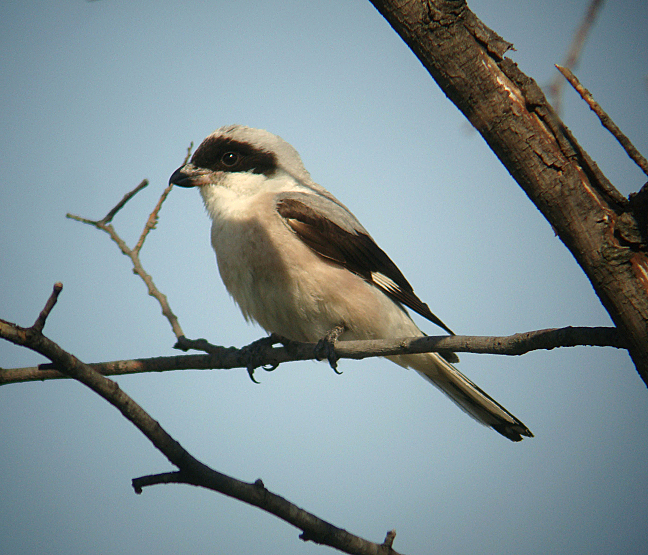
Wikipedia: Lesser grey shrike Source: OTHER
Lesser_Grey_Shrike_by_Daniel_Bastaja.jpg
![]() The lesser grey shrike (Lanius minor) is a member of the shrike family Laniidae. It breeds in South and Central Europe and western Asia in the summer and migrates to winter quarters in southern Africa in the early autumn, returning in spring. It is a scarce vagrant to western Europe, including Great Britain, usually as a spring or autumn erratic.
[more]
The lesser grey shrike (Lanius minor) is a member of the shrike family Laniidae. It breeds in South and Central Europe and western Asia in the summer and migrates to winter quarters in southern Africa in the early autumn, returning in spring. It is a scarce vagrant to western Europe, including Great Britain, usually as a spring or autumn erratic.
[more]
Song: ![]() Two very different types of territorial song: Most diagnostic is the short song which consists of a single, parakeet-like "irtscha". Like in a sneeze, with rapidly rising and falling pitch. Given monosyllabic, disyllabic or in series. Other song type very varied with lots of mimicry of other birds and mammals. Similar to Woodchat Shrike but usually also includes the call from the short song. The varied song is more subdued in mated males. [Link]
Two very different types of territorial song: Most diagnostic is the short song which consists of a single, parakeet-like "irtscha". Like in a sneeze, with rapidly rising and falling pitch. Given monosyllabic, disyllabic or in series. Other song type very varied with lots of mimicry of other birds and mammals. Similar to Woodchat Shrike but usually also includes the call from the short song. The varied song is more subdued in mated males. [Link]
Calls: ![]() Contact call a series of Magpie-like "che-che-che". [Link]
Contact call a series of Magpie-like "che-che-che". [Link]
Physical details: length=20 cm,
wingspan=32-34 cm,
weight=41-50 g
Profile Wikipedia eBird Xeno-Canto

Wikipedia: Southern fiscal Source: OTHER
1200px-Common_fiscal_%28Lanius_collaris_subcoronatus%29.jpg
General: ![]() The southern fiscal, common fiscal or fiscal shrike (Lanius collaris) is a member of the shrike family found through most of Sub-Saharan Africa. It is also sometimes named jackie hangman or butcher bird due to its habit of impaling its prey on acacia thorns to store the food for later consumption. It was previously lumped together with the northern fiscal (Lanius humeralis).[2] Together they were known as the common fiscal.
[more]
The southern fiscal, common fiscal or fiscal shrike (Lanius collaris) is a member of the shrike family found through most of Sub-Saharan Africa. It is also sometimes named jackie hangman or butcher bird due to its habit of impaling its prey on acacia thorns to store the food for later consumption. It was previously lumped together with the northern fiscal (Lanius humeralis).[2] Together they were known as the common fiscal.
[more]
Profile Wikipedia eBird Xeno-Canto

Wikipedia: Magpie shrike Source: OTHER
1200px-Urolestes_melanoleucus_-Limpopo%2C_South_Africa-8.jpg
![]() The magpie shrike (Urolestes melanoleucus), also known as the African long-tailed shrike, is a species of bird in the family Laniidae. It is monotypic within the genus Urolestes.[2] It is native to the grasslands of eastern and southeastern Africa, where its natural habitats are dry savannah, moist savannah, and subtropical or tropical dry shrubland. It has a very wide range and is common in places, and the International Union for Conservation of Nature has assessed its conservation status as being of "least concern".[1]
[more]
The magpie shrike (Urolestes melanoleucus), also known as the African long-tailed shrike, is a species of bird in the family Laniidae. It is monotypic within the genus Urolestes.[2] It is native to the grasslands of eastern and southeastern Africa, where its natural habitats are dry savannah, moist savannah, and subtropical or tropical dry shrubland. It has a very wide range and is common in places, and the International Union for Conservation of Nature has assessed its conservation status as being of "least concern".[1]
[more]
Profile Wikipedia eBird Xeno-Canto

Wikipedia: White-crowned shrike Source: OTHER
1200px-Southern_White-crowned_Shrike%2C_Eurocephalus_anguitimens%2C_gleaning_ants_from_the_early_morning_soil_at_Marakele_National_Park%2C_South_Africa_%2813952312157%29.jpg
![]() The southern white-crowned shrike (Eurocephalus anguitimens) is a species of bird in the family Laniidae. It is found in Angola, Botswana, Mozambique, Namibia, South Africa, and Zimbabwe. Its natural habitats are subtropical or tropical dry forests and dry savannah.[1]
[more]
The southern white-crowned shrike (Eurocephalus anguitimens) is a species of bird in the family Laniidae. It is found in Angola, Botswana, Mozambique, Namibia, South Africa, and Zimbabwe. Its natural habitats are subtropical or tropical dry forests and dry savannah.[1]
[more]
Profile Wikipedia eBird Xeno-Canto
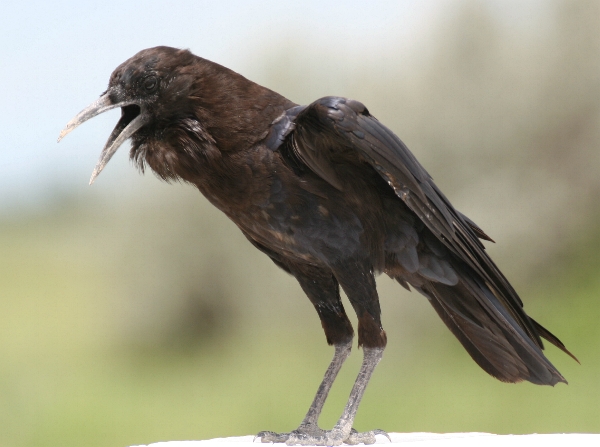
Wikipedia: Cape crow Source: OTHER
Cape_crow.jpg
![]() The Cape crow or black crow (Corvus capensis) is slightly larger (48–50 cm in length) than the carrion crow and is completely black with a slight gloss of purple in its feathers. It has proportionately longer legs, wings and tail too and has a much longer, slimmer bill that seems to be adapted for probing into the ground for invertebrates. The head feathers have a coppery-purple gloss and the throat feathers are quite long and fluffed out in some calls and displays.
[more]
The Cape crow or black crow (Corvus capensis) is slightly larger (48–50 cm in length) than the carrion crow and is completely black with a slight gloss of purple in its feathers. It has proportionately longer legs, wings and tail too and has a much longer, slimmer bill that seems to be adapted for probing into the ground for invertebrates. The head feathers have a coppery-purple gloss and the throat feathers are quite long and fluffed out in some calls and displays.
[more]
Profile Wikipedia eBird Xeno-Canto

Wikipedia: House crow Source: OTHER
1200px-Crow_eating_and_slobbering_on_dead_fish.jpg
![]()
![]() [more]
[more]
Profile Wikipedia eBird Xeno-Canto

Wikipedia: Pied crow Source: OTHER
1200px-Corvus_albus_-Etosha_National_Park%2C_Namibia-8.jpg
![]() The pied crow (Corvus albus) is a widely distributed African bird species in the crow genus.
[more]
The pied crow (Corvus albus) is a widely distributed African bird species in the crow genus.
[more]

Wikipedia: White-necked raven Source: OTHER
1200px-2009-white-necked-raven.jpg
![]() The white-necked raven (Corvus albicollis) is somewhat smaller (50–54 cm in length) than the common raven or its nearest relative, the thick-billed raven C. crassirostris. It is native to eastern and southern Africa.
[more]
The white-necked raven (Corvus albicollis) is somewhat smaller (50–54 cm in length) than the common raven or its nearest relative, the thick-billed raven C. crassirostris. It is native to eastern and southern Africa.
[more]

Wikipedia: African golden-oriole Source: OTHER
1200px-African_golden_oriole_%28Oriolus_auratus_notatus%29.jpg
![]()
The African golden oriole (Oriolus auratus), or African oriole, is a member of the oriole family of passerine birds which is a resident breeder in Africa south of the Sahara desert.
[more]
Profile Wikipedia eBird Xeno-Canto

Wikipedia: African black-headed oriole Source: OTHER
1200px-Orop%C3%A9ndola_enmascarada_%28Oriolus_larvatus%29%2C_parque_nacional_Kruger%2C_Sud%C3%A1frica%2C_2018-07-25%2C_DD_44.jpg
![]() The black-headed oriole (Oriolus larvatus) is a species of bird in the family Oriolidae. It is found in Africa and has a very striking appearance with a bright yellow body, contrasting black head and flesh-coloured beak.
[more]
The black-headed oriole (Oriolus larvatus) is a species of bird in the family Oriolidae. It is found in Africa and has a very striking appearance with a bright yellow body, contrasting black head and flesh-coloured beak.
[more]

Wikipedia: Tropical boubou Source: OTHER
1200px-Tropical_Boubou%2C_Sakania%2C_DRC_%289436772164%29.jpg
![]() The tropical boubou or bell shrike (Laniarius major) is a medium-sized passerine bird of sub-Saharan Africa. This very diverse "species" with its numerous subspecies and morphs has since long posed a taxonomic problem, and recent research suggests it is a cryptic species complex that has now been split into several species.[2]
[more]
The tropical boubou or bell shrike (Laniarius major) is a medium-sized passerine bird of sub-Saharan Africa. This very diverse "species" with its numerous subspecies and morphs has since long posed a taxonomic problem, and recent research suggests it is a cryptic species complex that has now been split into several species.[2]
[more]
Profile Wikipedia eBird Xeno-Canto

Wikipedia: Southern boubou Source: OTHER
1200px-Laniarius_ferrugineus00.jpg
![]() The southern boubou (Laniarius ferrugineus) ('ferrugineus' - rust-coloured) is a bushshrike. Though these passerine birds and their relations were once included with true shrikes in the Laniidae, they are not closely related to that family.
[more]
The southern boubou (Laniarius ferrugineus) ('ferrugineus' - rust-coloured) is a bushshrike. Though these passerine birds and their relations were once included with true shrikes in the Laniidae, they are not closely related to that family.
[more]
Profile Wikipedia eBird Xeno-Canto

Wikipedia: Crimson-breasted gonolek Source: OTHER
Laniarius_atrococcineus_-Pretoria%2C_South_Africa-8_%282%29.jpg
![]() The crimson-breasted shrike (Laniarius atrococcineus) or the crimson-breasted gonolek, ('gonolek' - supposedly imitative of its call),[2] or the crimson-breasted boubou, is a southern African bird. It has black upper parts with a white flash on the wing, and bright scarlet underparts. The International Union for Conservation of Nature has rated it as a "least-concern species".[1]
[more]
The crimson-breasted shrike (Laniarius atrococcineus) or the crimson-breasted gonolek, ('gonolek' - supposedly imitative of its call),[2] or the crimson-breasted boubou, is a southern African bird. It has black upper parts with a white flash on the wing, and bright scarlet underparts. The International Union for Conservation of Nature has rated it as a "least-concern species".[1]
[more]
Profile Wikipedia eBird Xeno-Canto
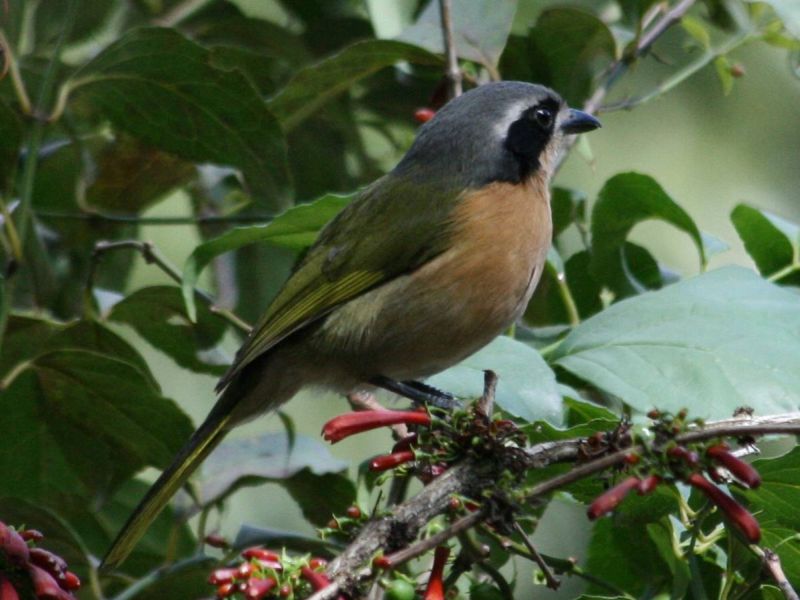
Wikipedia: Olive bushshrike Source: OTHER
Olive_Bushshrike_%28Telophorus_olivaceus%29.jpg
![]() The olive bushshrike (Chlorophoneus olivaceus) is a species of bird in the family Malaconotidae.
It is found in Malawi, Mozambique, South Africa, Swaziland, and Zimbabwe.
Its natural habitats are subtropical or tropical dry forest, subtropical or tropical moist lowland forest, subtropical or tropical moist montane forest, and subtropical or tropical dry shrubland.
[more]
The olive bushshrike (Chlorophoneus olivaceus) is a species of bird in the family Malaconotidae.
It is found in Malawi, Mozambique, South Africa, Swaziland, and Zimbabwe.
Its natural habitats are subtropical or tropical dry forest, subtropical or tropical moist lowland forest, subtropical or tropical moist montane forest, and subtropical or tropical dry shrubland.
[more]

Wikipedia: Four-coloured bushshrike Source: OTHER
1200px-Telophorus_quadricolor_1884.jpg
![]() The gorgeous bushshrike (Telophorus viridis) is a species of bird in the family Malaconotidae. It is also known as the four-coloured bushshrike. Some use the name gorgeous bushshrike for the subspecies Telophorus viridis viridis only.
[more]
The gorgeous bushshrike (Telophorus viridis) is a species of bird in the family Malaconotidae. It is also known as the four-coloured bushshrike. Some use the name gorgeous bushshrike for the subspecies Telophorus viridis viridis only.
[more]
Profile Wikipedia eBird Xeno-Canto

Wikipedia: Black-backed puffback Source: OTHER
690V4679_-_Flickr_-_Lip_Kee%2C_crop.jpg
![]() The black-backed puffback (Dryoscopus cubla) is a species of passerine bird in the family Malaconotidae. They are common to fairly common sedentary bushshrikes in various wooded habitats in Africa south of the equator. They restlessly move about singly, in pairs or family groups, and generally frequent tree canopies. Like others of its genus, the males puff out the loose rump and lower back feathers in display, to assume a remarkable ball-like appearance.[2] They draw attention to themselves by their varied repertoire of whistling, clicking and rasping sounds. Their specific name cubla, originated with Francois Levaillant, who derived it from a native southern African name, where the "c" is an onomatopoeic click sound.[3] None of the other five puffback species occur in southern Africa.
[more]
The black-backed puffback (Dryoscopus cubla) is a species of passerine bird in the family Malaconotidae. They are common to fairly common sedentary bushshrikes in various wooded habitats in Africa south of the equator. They restlessly move about singly, in pairs or family groups, and generally frequent tree canopies. Like others of its genus, the males puff out the loose rump and lower back feathers in display, to assume a remarkable ball-like appearance.[2] They draw attention to themselves by their varied repertoire of whistling, clicking and rasping sounds. Their specific name cubla, originated with Francois Levaillant, who derived it from a native southern African name, where the "c" is an onomatopoeic click sound.[3] None of the other five puffback species occur in southern Africa.
[more]

Wikipedia: Grey-headed bushshrike Source: OTHER
1200px-Grey-headed_Bushshrike_%28Malaconotus_blanchoti%29_in_tree.jpg
![]() The grey-headed bushshrike (Malaconotus blanchoti) is a species of bird in the family Malaconotidae.
It is widespread throughout Sub-Saharan Africa, although relatively absent in Central and Southern Africa.
Its natural habitats are dry savannah and moist savannah.
[more]
The grey-headed bushshrike (Malaconotus blanchoti) is a species of bird in the family Malaconotidae.
It is widespread throughout Sub-Saharan Africa, although relatively absent in Central and Southern Africa.
Its natural habitats are dry savannah and moist savannah.
[more]
Profile Wikipedia eBird Xeno-Canto
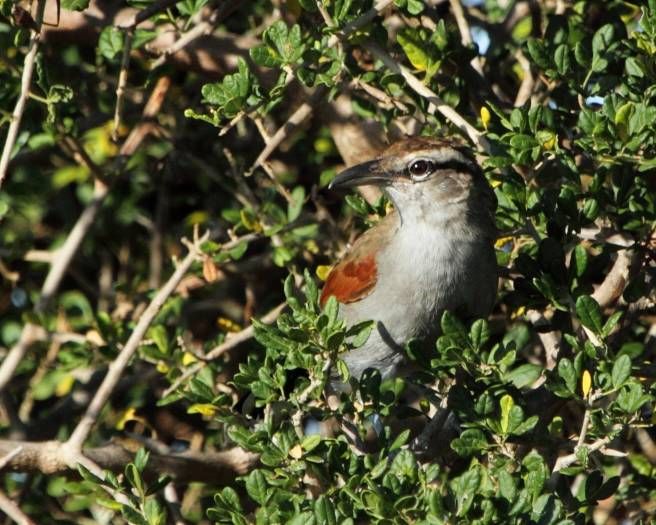
Wikipedia: Southern tchagra Source: OTHER
Tchagra_Southern_2013_02_24a.jpg
![]() The southern tchagra (Tchagra tchagra) is a passerine bird found in dense scrub and coastal bush in southern and south-eastern South Africa and Swaziland.
[more]
The southern tchagra (Tchagra tchagra) is a passerine bird found in dense scrub and coastal bush in southern and south-eastern South Africa and Swaziland.
[more]
Profile Wikipedia eBird Xeno-Canto

Wikipedia: Brown-crowned tchagra Source: OTHER
Brown-crowned_Tchagra.jpg
![]() The brown-crowned tchagra (Tchagra australis) is a species of bird in the family Malaconotidae.
[more]
The brown-crowned tchagra (Tchagra australis) is a species of bird in the family Malaconotidae.
[more]

Wikipedia: Black-crowned tchagra Source: OTHER
1200px-Black-crowned_Tchagra%2C_Tchagra_senegala.jpg
![]() The black-crowned tchagra (Tchagra senegalus) is a bushshrike. This family of passerine birds is closely related to the true shrikes in the family Laniidae, and was once included in that group.
[more]
The black-crowned tchagra (Tchagra senegalus) is a bushshrike. This family of passerine birds is closely related to the true shrikes in the family Laniidae, and was once included in that group.
[more]
Profile Wikipedia eBird Xeno-Canto

Wikipedia: Brubru Source: OTHER
1200px-Brubru.jpg
![]() The brubru (Nilaus afer) is a species of bushshrike (family Malconotidae) found in most of Sub-Saharan Africa. It is the only member of the genus Nilaus.
[more]
The brubru (Nilaus afer) is a species of bushshrike (family Malconotidae) found in most of Sub-Saharan Africa. It is the only member of the genus Nilaus.
[more]

Wikipedia: Sulphur-breasted bushshrike Source: OTHER
Chlorophoneus_sulfureopectus%2C_Polokwane_Wildtuin.jpg
![]() The orange-breasted bushshrike or sulphur-breasted bushshrike (Chlorophoneus sulfureopectus) is a species of bird in the family Malaconotidae.
It is widespread throughout Sub-Saharan Africa (relatively absent from most of Central, Southern and the Horn of Africa).
Its natural habitats are subtropical or tropical dry forests, dry savanna and moist savanna. Another species, Braun's bushshrike, is sometimes called orange-breasted bushshrike, as well.
[more]
The orange-breasted bushshrike or sulphur-breasted bushshrike (Chlorophoneus sulfureopectus) is a species of bird in the family Malaconotidae.
It is widespread throughout Sub-Saharan Africa (relatively absent from most of Central, Southern and the Horn of Africa).
Its natural habitats are subtropical or tropical dry forests, dry savanna and moist savanna. Another species, Braun's bushshrike, is sometimes called orange-breasted bushshrike, as well.
[more]

Wikipedia: Black-fronted bushshrike Source: OTHER
1200px-MalaconotusManningiKeulemans.jpg
![]() The black-fronted bushshrike (Chlorophoneus nigrifrons) is a passerine bird of the bushshrike family, Malaconotidae. It inhabits forests mainly in East Africa. It forms a superspecies with the many-colored bushshrike (C. multicolor) and the two are sometimes considered to be a single species.
[more]
The black-fronted bushshrike (Chlorophoneus nigrifrons) is a passerine bird of the bushshrike family, Malaconotidae. It inhabits forests mainly in East Africa. It forms a superspecies with the many-colored bushshrike (C. multicolor) and the two are sometimes considered to be a single species.
[more]

Wikipedia: Common square-tailed drongo Source: OTHER
Square-tailed_Drongo_%28Dicrurus_ludwigii%29.jpg
![]() The common square-tailed drongo (Dicrurus ludwigii), formerly the square-tailed drongo, is a passerine bird in the family Dicruridae. It is a common resident breeder in parts of southern Africa.
[more]
The common square-tailed drongo (Dicrurus ludwigii), formerly the square-tailed drongo, is a passerine bird in the family Dicruridae. It is a common resident breeder in parts of southern Africa.
[more]
Profile Wikipedia eBird Xeno-Canto

Wikipedia: Fork-tailed drongo Source: OTHER
Fork-tailed_Drongo_%28Dicrurus_adsimilis%29_2.jpg
![]() The fork-tailed drongo, also called the common drongo, African drongo, or savanna drongo (Dicrurus adsimilis), is a species of drongo in the family Dicruridae, which are medium-sized[2] passerine birds of the Old World. It is native to the tropics, subtropics and temperate zones of the Afrotropics. Its range was formerly considered to include Asia, but the Asian species is now called the black drongo (Dicrurus macrocercus).
[more]
The fork-tailed drongo, also called the common drongo, African drongo, or savanna drongo (Dicrurus adsimilis), is a species of drongo in the family Dicruridae, which are medium-sized[2] passerine birds of the Old World. It is native to the tropics, subtropics and temperate zones of the Afrotropics. Its range was formerly considered to include Asia, but the Asian species is now called the black drongo (Dicrurus macrocercus).
[more]
Profile Wikipedia eBird Xeno-Canto

Wikipedia: Livingstone's flycatcher Source: OTHER
Livingstone%27s_Flycatcher_-_Malawi_S4E3726_%2818824261563%29.jpg
![]() Livingstone's flycatcher (Erythrocercus livingstonei) is a species of bird in the family Erythrocercidae.
It is found in Malawi, Mozambique, Tanzania, Zambia, and Zimbabwe.
Its natural habitats are subtropical or tropical dry forests and subtropical or tropical moist shrubland.
[more]
Livingstone's flycatcher (Erythrocercus livingstonei) is a species of bird in the family Erythrocercidae.
It is found in Malawi, Mozambique, Tanzania, Zambia, and Zimbabwe.
Its natural habitats are subtropical or tropical dry forests and subtropical or tropical moist shrubland.
[more]
Profile Wikipedia eBird Xeno-Canto
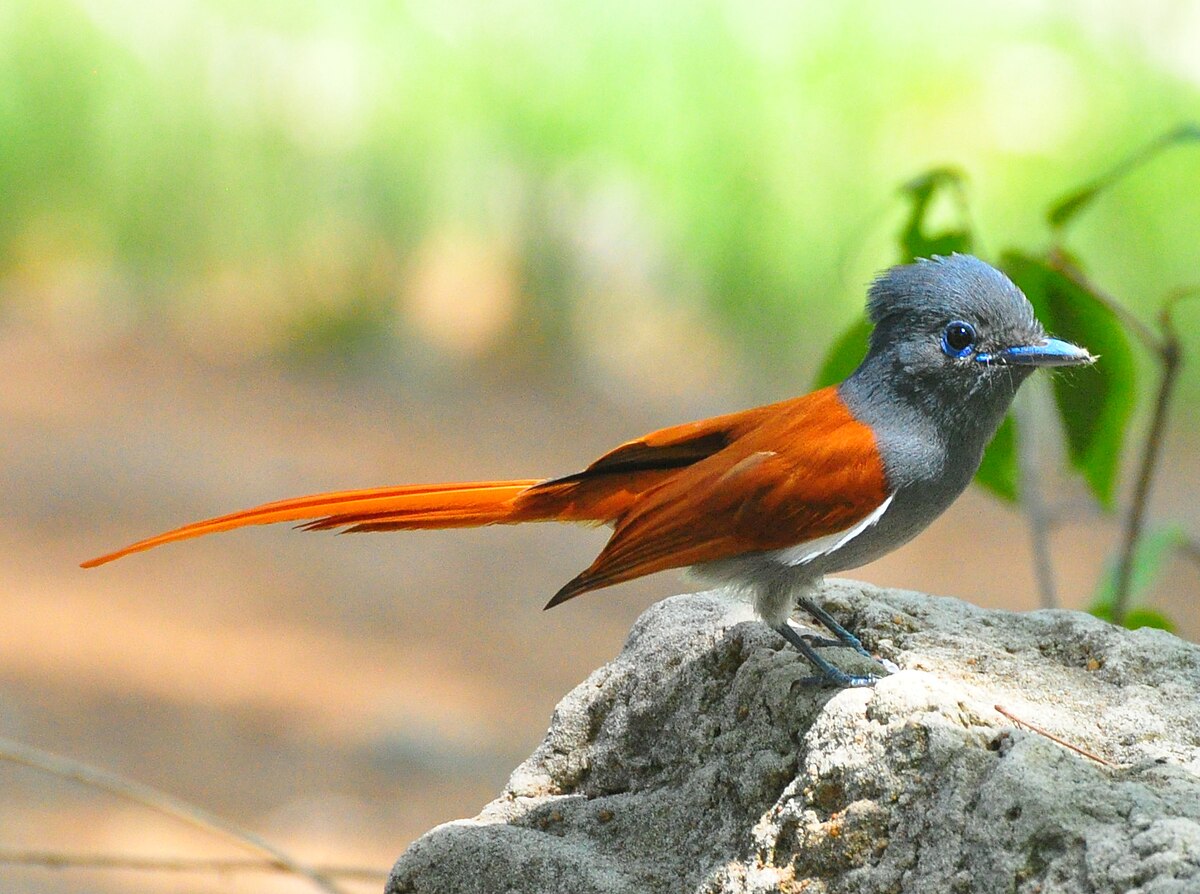
Wikipedia: African paradise-flycatcher Source: OTHER
1200px-Terpsiphone_viridis_-_African_Paradise_Flycatcher.jpg
![]() The African paradise flycatcher (Terpsiphone viridis) is a medium-sized passerine bird. The two central tail feathers of the male are extended into streamers that commonly are more than twice as long as the body. The female tail feathers are of moderate length and without streamers. The upper parts of the male body, wings, and tail are boldly coloured in chestnut or rusty shades, but the underparts and the head are variably grey to blue-gray, with the head of the mature male being darker, commonly glossy black with greenish highlights. The beak and other bare areas, including a wattle ring round the eye, match the colour of the surrounding feathers. The female coloration is similar, though not so showy and glossy and with the head paler.
[more]
The African paradise flycatcher (Terpsiphone viridis) is a medium-sized passerine bird. The two central tail feathers of the male are extended into streamers that commonly are more than twice as long as the body. The female tail feathers are of moderate length and without streamers. The upper parts of the male body, wings, and tail are boldly coloured in chestnut or rusty shades, but the underparts and the head are variably grey to blue-gray, with the head of the mature male being darker, commonly glossy black with greenish highlights. The beak and other bare areas, including a wattle ring round the eye, match the colour of the surrounding feathers. The female coloration is similar, though not so showy and glossy and with the head paler.
[more]
Profile Wikipedia eBird Xeno-Canto

Wikipedia: African crested-flycatcher Source: OTHER
African_Crested-Flycatcher_%28Trochocercus_cyanomelas%29.jpg
![]() The blue-mantled crested flycatcher or African crested flycatcher (Trochocercus cyanomelas) is a species of bird in the family Monarchidae found in eastern and south-eastern Africa.
[more]
The blue-mantled crested flycatcher or African crested flycatcher (Trochocercus cyanomelas) is a species of bird in the family Monarchidae found in eastern and south-eastern Africa.
[more]

Wikipedia: White helmetshrike Source: OTHER
1200px-White_Helmetshrike.jpg
![]() The white-crested helmetshrike (Prionops plumatus), also known as the white helmetshrike, is a species of passerine bird in the Vanga family Vangidae, formerly usually included in the Malaconotidae.
[more]
The white-crested helmetshrike (Prionops plumatus), also known as the white helmetshrike, is a species of passerine bird in the Vanga family Vangidae, formerly usually included in the Malaconotidae.
[more]
Profile Wikipedia eBird Xeno-Canto

Wikipedia: Black-throated wattle-eye Source: OTHER
Female_Black-throated_Wattle-eye_%28Platysteira_peltata%29_front_view.jpg
![]() The black-throated wattle-eye (Platysteira peltata) is a species of bird in the family Platysteiridae.
It is found in Angola, Burundi, Democratic Republic of the Congo, Eswatini, Kenya, Malawi, Mozambique, Somalia, South Africa, Tanzania, Uganda, Zambia, and Zimbabwe.
[more]
The black-throated wattle-eye (Platysteira peltata) is a species of bird in the family Platysteiridae.
It is found in Angola, Burundi, Democratic Republic of the Congo, Eswatini, Kenya, Malawi, Mozambique, Somalia, South Africa, Tanzania, Uganda, Zambia, and Zimbabwe.
[more]
Profile Wikipedia eBird Xeno-Canto
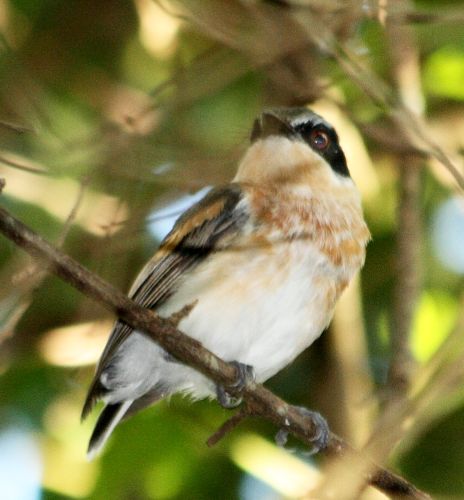
Wikipedia: Woodward's batis Source: OTHER
Woodwards_Batis_%28Batis_fratrum%29.jpg
![]() Woodward's batis (Batis fratrum), also known as Woodwards' batis or the Zululand batis, is a species of small bird in the wattle-eyes family, Platysteiridae. It occurs in southeastern Africa where it is found in woodlands and forests.
[more]
Woodward's batis (Batis fratrum), also known as Woodwards' batis or the Zululand batis, is a species of small bird in the wattle-eyes family, Platysteiridae. It occurs in southeastern Africa where it is found in woodlands and forests.
[more]

Wikipedia: Cape batis Source: OTHER
Bosbontrokkie_vroulik.png
![]() The Cape batis (Batis capensis) is a small, stout insect-eating passerine bird in the wattle-eye family. It is endemic to the Afromontane forests of southern Africa.
[more]
The Cape batis (Batis capensis) is a small, stout insect-eating passerine bird in the wattle-eye family. It is endemic to the Afromontane forests of southern Africa.
[more]
Profile Wikipedia eBird Xeno-Canto

Wikipedia: Chinspot batis Source: OTHER
1200px-Chinspot_batis%2C_Batis_molitor%2C_at_Pilanesberg_National_Park%2C_Northwest_Province%2C_South_Africa_%2828202590270%29%2C_crop.jpg
![]() The chinspot batis (Batis molitor) is a small songbird of the genus Batis in the family Platysteiridae which is a common and widespread species in the woodlands of southern Africa from the Eastern Cape north to 3°N in southern Kenya and Gabon. It forms a superspecies with other rather similar members of the genus Batis.
[more]
The chinspot batis (Batis molitor) is a small songbird of the genus Batis in the family Platysteiridae which is a common and widespread species in the woodlands of southern Africa from the Eastern Cape north to 3°N in southern Kenya and Gabon. It forms a superspecies with other rather similar members of the genus Batis.
[more]

Wikipedia: Pririt batis Source: OTHER
1200px-Pririt_batis_%28Batis_pririt_affinis%29_male.jpg
![]() The pririt batis (Batis pririt) also known as the pririt puff-back flycatcher or pririt puffback, is a small passerine bird in the wattle-eye family. It is resident in Southern Africa and southwestern Angola.
[more]
The pririt batis (Batis pririt) also known as the pririt puff-back flycatcher or pririt puffback, is a small passerine bird in the wattle-eye family. It is resident in Southern Africa and southwestern Angola.
[more]
Profile Wikipedia eBird Xeno-Canto

Wikipedia: White-breasted cuckooshrike Source: OTHER
1200px-Coracina_pectoralis%2C_Groenkloof_NR.jpg
![]() The white-breasted cuckooshrike (Ceblepyris pectoralis) is a species of bird in the family Campephagidae.
It is found in Angola, Benin, Botswana, Burkina Faso, Burundi, Cameroon, Central African Republic, Democratic Republic of the Congo, Ivory Coast, Ethiopia, Gambia, Ghana, Guinea, Guinea-Bissau, Kenya, Malawi, Mali, Mauritania, Mozambique, Namibia, Nigeria, Rwanda, Senegal, Sierra Leone, South Africa, Sudan, Swaziland, Tanzania, Togo, Uganda, Zambia, and Zimbabwe.
Its natural habitats are subtropical or tropical dry forest and dry savanna.
[more]
The white-breasted cuckooshrike (Ceblepyris pectoralis) is a species of bird in the family Campephagidae.
It is found in Angola, Benin, Botswana, Burkina Faso, Burundi, Cameroon, Central African Republic, Democratic Republic of the Congo, Ivory Coast, Ethiopia, Gambia, Ghana, Guinea, Guinea-Bissau, Kenya, Malawi, Mali, Mauritania, Mozambique, Namibia, Nigeria, Rwanda, Senegal, Sierra Leone, South Africa, Sudan, Swaziland, Tanzania, Togo, Uganda, Zambia, and Zimbabwe.
Its natural habitats are subtropical or tropical dry forest and dry savanna.
[more]

Wikipedia: Grey cuckooshrike Source: OTHER
Greycuckooshrike.jpg
![]() The grey cuckooshrike (Ceblepyris caesius) is a species of bird in the cuckooshrike family Campephagidae. It is a medium-sized forest bird, with grey to blue-grey plumage and large black eyes. There are two subspecies that occur in forest patches of southern and central Africa respectively.
[more]
The grey cuckooshrike (Ceblepyris caesius) is a species of bird in the cuckooshrike family Campephagidae. It is a medium-sized forest bird, with grey to blue-grey plumage and large black eyes. There are two subspecies that occur in forest patches of southern and central Africa respectively.
[more]

Wikipedia: Black cuckoo-shrike Source: OTHER
Black_Cuckoo-Shrike_fem_-_Kenya_0322_%2816840367358%29.jpg
![]() The black cuckooshrike (Campephaga flava) is a species of bird in the cuckooshrike family Campephagidae. The species is closely related to Petit's cuckooshrike and the red-shouldered cuckooshrike, and forms a superspecies with them. It is also known as the African black cuckooshrike.[2]
[more]
The black cuckooshrike (Campephaga flava) is a species of bird in the cuckooshrike family Campephagidae. The species is closely related to Petit's cuckooshrike and the red-shouldered cuckooshrike, and forms a superspecies with them. It is also known as the African black cuckooshrike.[2]
[more]
Fairy flycatcher (Stenostira scita)

Wikipedia: Fairy flycatcher Source: OTHER
Fairy_Warbler_-_South_Africa_S4E7312_%2817143048570%29.jpg
![]() The fairy flycatcher or fairy warbler (Stenostira scita) is a small passerine bird. Formerly placed in the Old World flycatcher family, Muscicapidae, it is now separated with some other "odd flycatchers" as the new family Stenostiridae (Beresford et al. 2005, Fuchs et al. 2006). It is the only member of the genus Stenostira.
[more]
The fairy flycatcher or fairy warbler (Stenostira scita) is a small passerine bird. Formerly placed in the Old World flycatcher family, Muscicapidae, it is now separated with some other "odd flycatchers" as the new family Stenostiridae (Beresford et al. 2005, Fuchs et al. 2006). It is the only member of the genus Stenostira.
[more]
Southern hyliota (Hyliota australis)
Profile Wikipedia eBird Xeno-Canto

Wikipedia: Southern hyliota Source: OTHER
1200px-Southern_Hyliota_specimen_RWD.jpg
![]() The southern hyliota (Hyliota australis) is a species of Hyliota.
It is found in Angola, Cameroon, Democratic Republic of the Congo, Kenya, Malawi, Mozambique, South Africa, Tanzania, Uganda, Zambia, and Zimbabwe.
Its natural habitats are subtropical or tropical dry forests and dry savanna.
[more]
The southern hyliota (Hyliota australis) is a species of Hyliota.
It is found in Angola, Cameroon, Democratic Republic of the Congo, Kenya, Malawi, Mozambique, South Africa, Tanzania, Uganda, Zambia, and Zimbabwe.
Its natural habitats are subtropical or tropical dry forests and dry savanna.
[more]
Profile Wikipedia eBird Xeno-Canto

Wikipedia: Kelp gull Source: OTHER
1200px-SouthShetland-2016-Livingston_Island_%28Hannah_Point%29%E2%80%93Kelp_gull_%28Larus_dominicanus%29.jpg
This bird appears across the great seas in the following continents:
South America, Africa.
![]() The kelp gull (Larus dominicanus), also known as the Dominican gull, is a gull that breeds on coasts and islands through much of the Southern Hemisphere. The nominate L. d. dominicanus is the subspecies found around South America, parts of Australia (where it overlaps with the Pacific gull), and New Zealand (where it is known as the black-backed gull, the southern black-backed gull, mollyhawk[2] – particularly the juveniles,[3] or by its Māori name karoro). L. d. vetula (known as the Cape gull) is a subspecies occurring around Southern Africa.
[more]
The kelp gull (Larus dominicanus), also known as the Dominican gull, is a gull that breeds on coasts and islands through much of the Southern Hemisphere. The nominate L. d. dominicanus is the subspecies found around South America, parts of Australia (where it overlaps with the Pacific gull), and New Zealand (where it is known as the black-backed gull, the southern black-backed gull, mollyhawk[2] – particularly the juveniles,[3] or by its Māori name karoro). L. d. vetula (known as the Cape gull) is a subspecies occurring around Southern Africa.
[more]
Profile Wikipedia eBird Vogelwarte BirdLife ZH ornitho.ch Audubon AllAboutBirds Xeno-Canto NABU
Lesser black-backed gull - yellow legs, yellow break with red under tip, black back but white shoulders. 2023-09-27 12.40.12 Florida
This bird appears across the great seas in the following continents:
Europe, North America, Africa.
![]() The lesser black-backed gull (Larus fuscus) is a large gull that breeds on the Atlantic coasts of Europe. It is migratory, wintering from the British Isles south to West Africa. It is a regular winter visitor to the east coast of North America, probably from the breeding population in Iceland.
[more]
The lesser black-backed gull (Larus fuscus) is a large gull that breeds on the Atlantic coasts of Europe. It is migratory, wintering from the British Isles south to West Africa. It is a regular winter visitor to the east coast of North America, probably from the breeding population in Iceland.
[more]
Habitats:
River and lake

Wikipedia: Slender-billed gull Source: OTHER
Larus_genei.jpg
![]() The slender-billed gull (Chroicocephalus genei) is a mid-sized gull which breeds very locally around the Mediterranean and the north of the western Indian Ocean (e.g. Pakistan) on islands and coastal lagoons. Most of the population is somewhat migratory, wintering further south to north Africa and India, and a few birds have wandered to western Europe. A vagrant individual was reportedly seen on Antigua, April 24, 1976 (AOU, 2000).
[more]
The slender-billed gull (Chroicocephalus genei) is a mid-sized gull which breeds very locally around the Mediterranean and the north of the western Indian Ocean (e.g. Pakistan) on islands and coastal lagoons. Most of the population is somewhat migratory, wintering further south to north Africa and India, and a few birds have wandered to western Europe. A vagrant individual was reportedly seen on Antigua, April 24, 1976 (AOU, 2000).
[more]
Profile Wikipedia eBird Xeno-Canto

Wikipedia: Hartlaub's gull Source: OTHER
1200px-Chroicocephalus_hartlaubii.jpg
![]() Hartlaub's gull (Chroicocephalus hartlaubii), also known as the king gull, is a small gull, which is a non-migratory breeding resident endemic to the Atlantic Ocean coastline of South Africa and Namibia. Although it is predominantly coastal or estuarine, it is not a pelagic species, and is rarely seen at sea far from land. It was formerly sometimes considered to be a subspecies of the silver gull (C. novaehollandiae), and, as is the case with many gulls, it has traditionally been placed in the genus Larus but is now placed in the genus Chroicocephalus.
[more]
Hartlaub's gull (Chroicocephalus hartlaubii), also known as the king gull, is a small gull, which is a non-migratory breeding resident endemic to the Atlantic Ocean coastline of South Africa and Namibia. Although it is predominantly coastal or estuarine, it is not a pelagic species, and is rarely seen at sea far from land. It was formerly sometimes considered to be a subspecies of the silver gull (C. novaehollandiae), and, as is the case with many gulls, it has traditionally been placed in the genus Larus but is now placed in the genus Chroicocephalus.
[more]

Wikipedia: Grey-headed gull Source: OTHER
1200px-Graukopf-M%C3%B6we_Larus_cirrocephalus_090501_We_150.JPG
This bird appears across the great seas in the following continents:
South America, Africa.
![]() The grey-headed gull (Chroicocephalus cirrocephalus), also known as the grey-hooded gull, is a small gull which breeds patchily in South America and Africa south of the Sahara. It is not truly migratory, but is more widespread in winter. This species has occurred as a rare vagrant to North America, Italy and Spain. As is the case with many gulls, it has traditionally been placed in the genus Larus.
[more]
The grey-headed gull (Chroicocephalus cirrocephalus), also known as the grey-hooded gull, is a small gull which breeds patchily in South America and Africa south of the Sahara. It is not truly migratory, but is more widespread in winter. This species has occurred as a rare vagrant to North America, Italy and Spain. As is the case with many gulls, it has traditionally been placed in the genus Larus.
[more]
Black-legged kittiwake / Dreizehenmöwe (Rissa tridactyla)
Profile Wikipedia eBird Vogelwarte BirdLife ZH ornitho.ch Audubon AllAboutBirds Xeno-Canto BirdID NABU

Wikipedia: Black-legged kittiwake Source: OTHER
1200px-Rissa_tridactyla_%28Vard%C3%B8%2C_2012%29.jpg
This bird appears across the great seas in the following continents:
Europe, North America, Africa.
![]() The black-legged kittiwake (Rissa tridactyla) is a seabird species in the gull family Laridae.
[more]
The black-legged kittiwake (Rissa tridactyla) is a seabird species in the gull family Laridae.
[more]
Vocalization: ![]() Highly vocal at breeding ground. A mewing "kitti-wake", with the pitch rising on the second drawn out syllable, and then falling. Generally silent elsewhere, except when squabbling over food. [Link]
Highly vocal at breeding ground. A mewing "kitti-wake", with the pitch rising on the second drawn out syllable, and then falling. Generally silent elsewhere, except when squabbling over food. [Link]
Physical details: length=38-40 cm,
wingspan=95-105 cm,
weight=310-500 g
Gull-billed tern / Lachseeschwalbe (Gelochelidon nilotica)
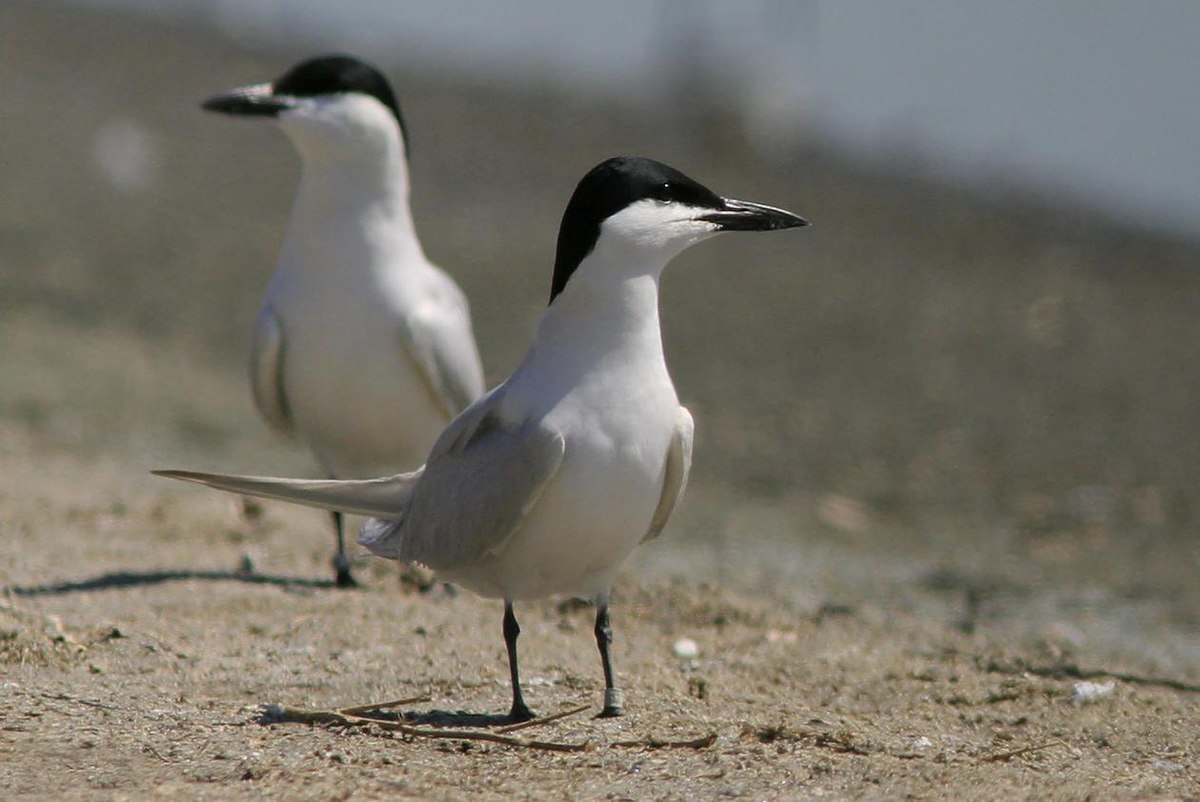
Wikipedia: Gull-billed tern Source: OTHER
1200px-Gelochelidon_nilotica_vanrossemi.jpg
This bird appears across the great seas in the following continents:
Europe, North America, South America, Africa, Asia.
General: ![]() The gull-billed tern (Gelochelidon nilotica), formerly Sterna nilotica,[2] is a tern in the family Laridae. The genus name is from Ancient Greek gelao, "to laugh", and khelidon, "swallow". The specific niloticus is from Latin and means of the Nile.[3] The Australian gull-billed tern was previously considered a subspecies.
[more]
The gull-billed tern (Gelochelidon nilotica), formerly Sterna nilotica,[2] is a tern in the family Laridae. The genus name is from Ancient Greek gelao, "to laugh", and khelidon, "swallow". The specific niloticus is from Latin and means of the Nile.[3] The Australian gull-billed tern was previously considered a subspecies.
[more]
Sabine's gull / Schwalbenmöwe (Xema sabini)

Wikipedia: Sabine's gull Source: OTHER
Xema_sabini_-Iceland_-swimming-8_%281%29.jpg
This bird appears across the great seas in the following continents:
Europe, North America, South America, Africa.
![]() Sabine's gull (/ˈseɪbɪn/ SAY-bin; Xema sabini), also known as the fork-tailed gull or xeme, is a small gull. Its generic placement is disputed; some authors treat it as the sole species in the genus Xema as Xema sabini,[2] while others retain it in the genus Larus as Larus sabini.[3][4]
[more]
Sabine's gull (/ˈseɪbɪn/ SAY-bin; Xema sabini), also known as the fork-tailed gull or xeme, is a small gull. Its generic placement is disputed; some authors treat it as the sole species in the genus Xema as Xema sabini,[2] while others retain it in the genus Larus as Larus sabini.[3][4]
[more]
African skimmer / Braunmantel-Scherenschnabel (Rynchops flavirostris)
Profile Wikipedia eBird Xeno-Canto
Nesting bird, perhaps african skimmer. 2016-09-29 15.07.02 Botswana
First observed in Botswana on 2016-09-29.
![]() The African skimmer (Rynchops flavirostris) is a near-threatened species of bird belonging to the skimmer genus Rynchops in the family Laridae. It is found along rivers, lakes and lagoons in Sub-Saharan Africa.[1]
[more]
The African skimmer (Rynchops flavirostris) is a near-threatened species of bird belonging to the skimmer genus Rynchops in the family Laridae. It is found along rivers, lakes and lagoons in Sub-Saharan Africa.[1]
[more]
Black skimmer / Schwarzmantel-Scherenschnabel (Rynchops niger)
Profile Wikipedia eBird Xeno-Canto
Black skimmers near Las Coloradas. 2023-04-15 10.11.18 Yucatan
First observed in Yucatan on 2023-04-15.
This bird appears across the great seas in the following continents:
North America, South America, Africa.
![]() The black skimmer (Rynchops niger) is a tern-like seabird, one of three very similar birds species in the skimmer genus Rynchops in the gull family Laridae. It breeds in North and South America. Northern populations winter in the warmer waters of the Caribbean and the tropical and subtropical Pacific coasts, but the South American races make only shorter movements in response to annual floods which extend their feeding areas in the river shallows.
[more]
The black skimmer (Rynchops niger) is a tern-like seabird, one of three very similar birds species in the skimmer genus Rynchops in the gull family Laridae. It breeds in North and South America. Northern populations winter in the warmer waters of the Caribbean and the tropical and subtropical Pacific coasts, but the South American races make only shorter movements in response to annual floods which extend their feeding areas in the river shallows.
[more]
Whiskered tern / Weissbart-Seeschwalbe (Chlidonias hybrida)
Whiskered tern, Phnom Krom. 2024-03-03 08.33.04 Cambodia
First observed in Cambodia on 2024-03-03.
![]() The whiskered tern (Chlidonias hybrida) is a tern in the family Laridae. The genus name is from Ancient Greek khelidonios, "swallow-like", from khelidon, "swallow". The specific hybridus is Latin for hybrid; Pallas thought it might be a hybrid of white-winged black tern and common tern, writing "Sterna fissipes [Chlidonias leucopterus] et Hirundine [Sterna hirundo] natam”.[2]
[more]
The whiskered tern (Chlidonias hybrida) is a tern in the family Laridae. The genus name is from Ancient Greek khelidonios, "swallow-like", from khelidon, "swallow". The specific hybridus is Latin for hybrid; Pallas thought it might be a hybrid of white-winged black tern and common tern, writing "Sterna fissipes [Chlidonias leucopterus] et Hirundine [Sterna hirundo] natam”.[2]
[more]
Calls: ![]() Contact call freely used and fairly distinct: An extremely hoarse, and rasping "krreek" in various moods. Timbre comparable to Corncrake. Sometimes uttered in stuttering series "kr-kr-kr-kr-kr". [Link]
Contact call freely used and fairly distinct: An extremely hoarse, and rasping "krreek" in various moods. Timbre comparable to Corncrake. Sometimes uttered in stuttering series "kr-kr-kr-kr-kr". [Link]
Physical details: length=23-25 cm,
wingspan=74-78 cm,
weight=79-94 g
Habitats:
River and lake
Call:
Automatically generated from Xeno-Canto recording
♫ XC770351 - Whiskered Tern - Chlidonias hybrida - call, flight call - Heves County, Hungary. Source: XENOCANTO
XC770351 - Whiskered Tern - Chlidonias hybrida - call, flight call - Heves County, Hungary.mp3
(flight call)

Call attributes:
flight call Frequency: ,
White-winged tern / Weissflügelseeschwalbe (Chlidonias leucopterus)

Wikipedia: White-winged tern Source: OTHER
Chlidonias_leucopterus_Mai_Po.jpg
General: ![]() The white-winged tern, or white-winged black tern (Chlidonias leucopterus or Chlidonias leucoptera), is a species of tern in the family Laridae. It is a small species generally found in or near bodies of fresh water across much of the world, including Europe, Africa, Asia, and Australia. The genus name is from Ancient Greek khelidonios, "swallow-like", from khelidon, "swallow".
[more]
The white-winged tern, or white-winged black tern (Chlidonias leucopterus or Chlidonias leucoptera), is a species of tern in the family Laridae. It is a small species generally found in or near bodies of fresh water across much of the world, including Europe, Africa, Asia, and Australia. The genus name is from Ancient Greek khelidonios, "swallow-like", from khelidon, "swallow".
[more]
Habitats:
River and lake
Black tern / Trauerseeschwalbe (Chlidonias niger)
Profile Wikipedia eBird Vogelwarte BirdLife ZH ornitho.ch Audubon AllAboutBirds Xeno-Canto BirdID NABU

Wikipedia: Black tern Source: OTHER
1200px-%C4%8Cor%C3%ADk_%C4%8Dierny_%28Chlidonias_niger%29_a_%284644831482%29.jpg
This bird appears across the great seas in the following continents:
Europe, North America, South America, Africa.
![]() The black tern (Chlidonias niger) is a small tern generally found in or near inland water in Europe, Western Asia and North America. As its name suggests, it has predominantly dark plumage. In some lights it can appear blue in the breeding season, hence the old English name "blue darr".[2] The genus name is from Ancient Greek khelidonios, "swallow-like", from khelidon, "swallow": another old English name for the black tern is "carr (i.e. lake) swallow".[3] The species name is from Latin niger "shining black".[4]
[more]
The black tern (Chlidonias niger) is a small tern generally found in or near inland water in Europe, Western Asia and North America. As its name suggests, it has predominantly dark plumage. In some lights it can appear blue in the breeding season, hence the old English name "blue darr".[2] The genus name is from Ancient Greek khelidonios, "swallow-like", from khelidon, "swallow": another old English name for the black tern is "carr (i.e. lake) swallow".[3] The species name is from Latin niger "shining black".[4]
[more]
Vocalization: ![]() Moderately vocal. [Link]
Moderately vocal. [Link]
Calls: ![]() Flight call a more or less clear "kleck, or a disyllabic "klee-ake" with accented first syllable. Sometimes slightly rolling "klirr-eke", but never as much as in White-winged Tern. Also a slightly harsher "kreek", but not as raspy as in Whiskered Tern. [Link]
Flight call a more or less clear "kleck, or a disyllabic "klee-ake" with accented first syllable. Sometimes slightly rolling "klirr-eke", but never as much as in White-winged Tern. Also a slightly harsher "kreek", but not as raspy as in Whiskered Tern. [Link]
Physical details: length=22-24 cm,
wingspan=64-68 cm,
weight=60-86 g
Habitats:
River and lake
Lesser noddy (Anous tenuirostris)

Wikipedia: Lesser noddy Source: OTHER
1200px-Anous_tenuirostris_01.jpg
General: ![]() The lesser noddy (Anous tenuirostris), also known as the sooty noddy, is a seabird in the family Laridae. It is found near the coastlines of Comoros, Kenya, India, Maldives, Mauritius, Seychelles, Sri Lanka and United Arab Emirates.
[more]
The lesser noddy (Anous tenuirostris), also known as the sooty noddy, is a seabird in the family Laridae. It is found near the coastlines of Comoros, Kenya, India, Maldives, Mauritius, Seychelles, Sri Lanka and United Arab Emirates.
[more]
Brown noddy / Noddi (Anous stolidus)

Wikipedia: Brown noddy Source: OTHER
1200px-Common_Noddy_1_-_Michaelmas.jpg
This bird appears across the great seas in the following continents:
North America, South America, Africa, Asia.
![]() The brown noddy or common noddy (Anous stolidus) is a seabird in the family Laridae. The largest of the noddies, it can be told from the closely related black noddy by its larger size and plumage, which is dark brown rather than black. The brown noddy is a tropical seabird with a worldwide distribution, ranging from Hawaii to the Tuamotu Archipelago and Australia in the Pacific Ocean, from the Red Sea to the Seychelles and Australia in the Indian Ocean and in the Caribbean to Tristan da Cunha in the Atlantic Ocean. The brown noddy is colonial, usually nesting on elevated situations on cliffs or in short trees or shrubs. It only occasionally nests on the ground. A single egg is laid by the female of a pair each breeding season. In India the brown noddy is protected in the PM Sayeed Marine Birds Conservation Reserve.[2]
[more]
The brown noddy or common noddy (Anous stolidus) is a seabird in the family Laridae. The largest of the noddies, it can be told from the closely related black noddy by its larger size and plumage, which is dark brown rather than black. The brown noddy is a tropical seabird with a worldwide distribution, ranging from Hawaii to the Tuamotu Archipelago and Australia in the Pacific Ocean, from the Red Sea to the Seychelles and Australia in the Indian Ocean and in the Caribbean to Tristan da Cunha in the Atlantic Ocean. The brown noddy is colonial, usually nesting on elevated situations on cliffs or in short trees or shrubs. It only occasionally nests on the ground. A single egg is laid by the female of a pair each breeding season. In India the brown noddy is protected in the PM Sayeed Marine Birds Conservation Reserve.[2]
[more]
Common white-tern / Feenseeschwalbe (Gygis alba)
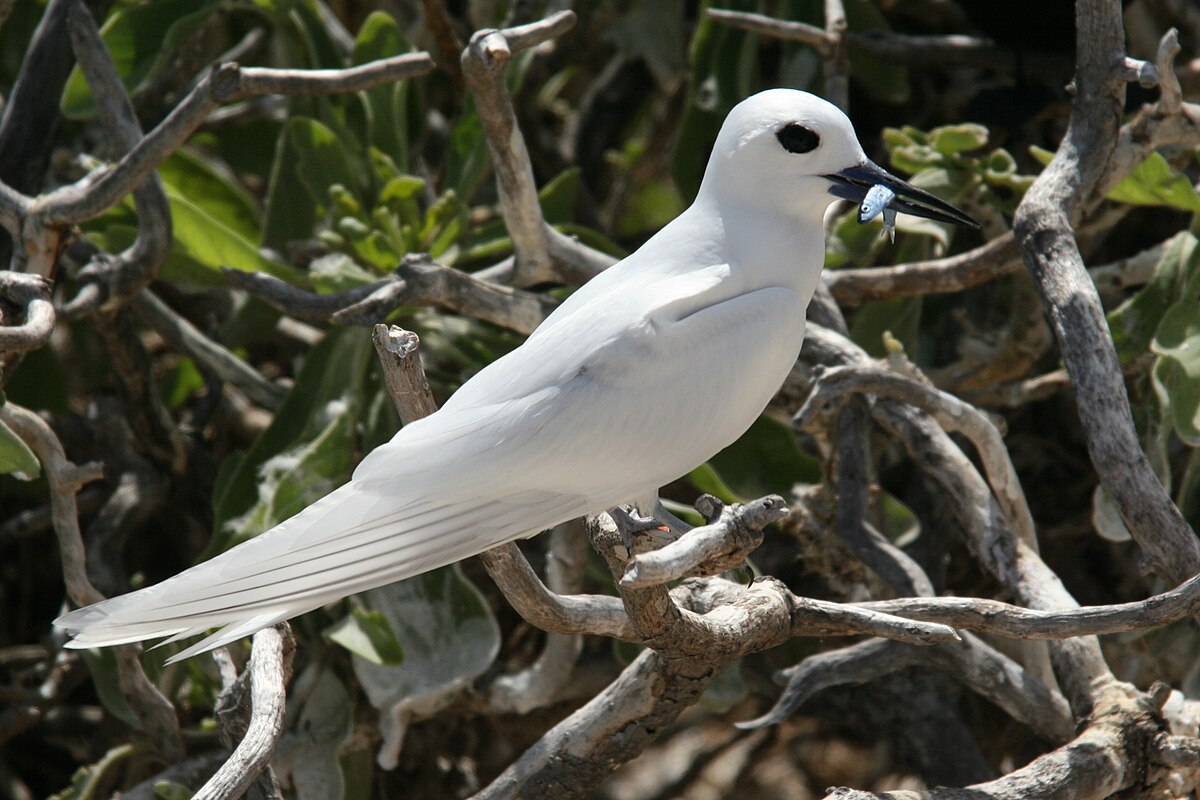
Wikipedia: Common white-tern Source: OTHER
1200px-White_tern_with_fish.jpg
This bird appears across the great seas in the following continents:
North America, Africa.
![]() The white tern (Gygis alba) is a small seabird found across the tropical oceans of the world. It is sometimes known as the fairy tern although this name is potentially confusing as it is also the common name of Sternula nereis. Other names for the species include angel tern and white noddy in English, and manu-o-Kū in Hawaiian.
[more]
The white tern (Gygis alba) is a small seabird found across the tropical oceans of the world. It is sometimes known as the fairy tern although this name is potentially confusing as it is also the common name of Sternula nereis. Other names for the species include angel tern and white noddy in English, and manu-o-Kū in Hawaiian.
[more]
Franklin's gull / Präriemöwe (Leucophaeus pipixcan)

Wikipedia: Franklin's gull Source: OTHER
Franklin%27s_Gull%2C_Calgary.jpg
This bird appears across the great seas in the following continents:
North America, South America, Africa.
![]() Franklin's gull (Leucophaeus pipixcan) is a small (length 12.6–14.2 in, 32–36 cm) gull.[2] The genus name Leucophaeus is from Ancient Greek leukos, "white", and phaios, "dusky". The specific pipixcan is a Nahuatl name for a type of gull.[3][4]
[more]
Franklin's gull (Leucophaeus pipixcan) is a small (length 12.6–14.2 in, 32–36 cm) gull.[2] The genus name Leucophaeus is from Ancient Greek leukos, "white", and phaios, "dusky". The specific pipixcan is a Nahuatl name for a type of gull.[3][4]
[more]
Caspian tern / Raubseeschwalbe (Hydroprogne caspia)

Wikipedia: Caspian tern Source: OTHER
1200px-Sterna-caspia-010.jpg
This bird appears across the great seas in the following continents:
Europe, North America, South America, Africa, Asia.
![]() The Caspian tern (Hydroprogne caspia)[2] is a species of tern, with a subcosmopolitan but scattered distribution. Despite its extensive range, it is monotypic of its genus, and has no accepted subspecies.[3] The genus name is from Ancient Greek hudros, "water", and Latin progne, "swallow". The specific caspia is from Latin and, like the English name, refers to the Caspian Sea.[4]
[more]
The Caspian tern (Hydroprogne caspia)[2] is a species of tern, with a subcosmopolitan but scattered distribution. Despite its extensive range, it is monotypic of its genus, and has no accepted subspecies.[3] The genus name is from Ancient Greek hudros, "water", and Latin progne, "swallow". The specific caspia is from Latin and, like the English name, refers to the Caspian Sea.[4]
[more]
Calls: ![]() Easily recognized by its very harsh calls. Sometimes likened to the sound of a plate of steel being dragged across a concrete floor. Similar in harshness to Grey Heron, but more drawn, with an accented middle; "Kraaeeet", or with a double syllable start "ka-ha-kraaaeet". Immature birds begs with a penetrating, sharp whistle. [Link]
Easily recognized by its very harsh calls. Sometimes likened to the sound of a plate of steel being dragged across a concrete floor. Similar in harshness to Grey Heron, but more drawn, with an accented middle; "Kraaeeet", or with a double syllable start "ka-ha-kraaaeet". Immature birds begs with a penetrating, sharp whistle. [Link]
Physical details: length=47-54 cm,
wingspan=130-145 cm,
weight=500-750 g
Habitats:
River and lake
Sooty tern / Rußseeschwalbe (Onychoprion fuscatus)

Wikipedia: Sooty tern Source: OTHER
1200px-Sterna_fuscata.JPG
This bird appears across the great seas in the following continents:
North America, South America, Africa.
General: ![]() The sooty tern (Onychoprion fuscatus) is a seabird in the family Laridae. It is a bird of the tropical oceans which sleeps on the wing, returning to land only to breed on islands throughout the equatorial zone.
[more]
The sooty tern (Onychoprion fuscatus) is a seabird in the family Laridae. It is a bird of the tropical oceans which sleeps on the wing, returning to land only to breed on islands throughout the equatorial zone.
[more]
Bridled tern / Zügelseeschwalbe (Onychoprion anaethetus)
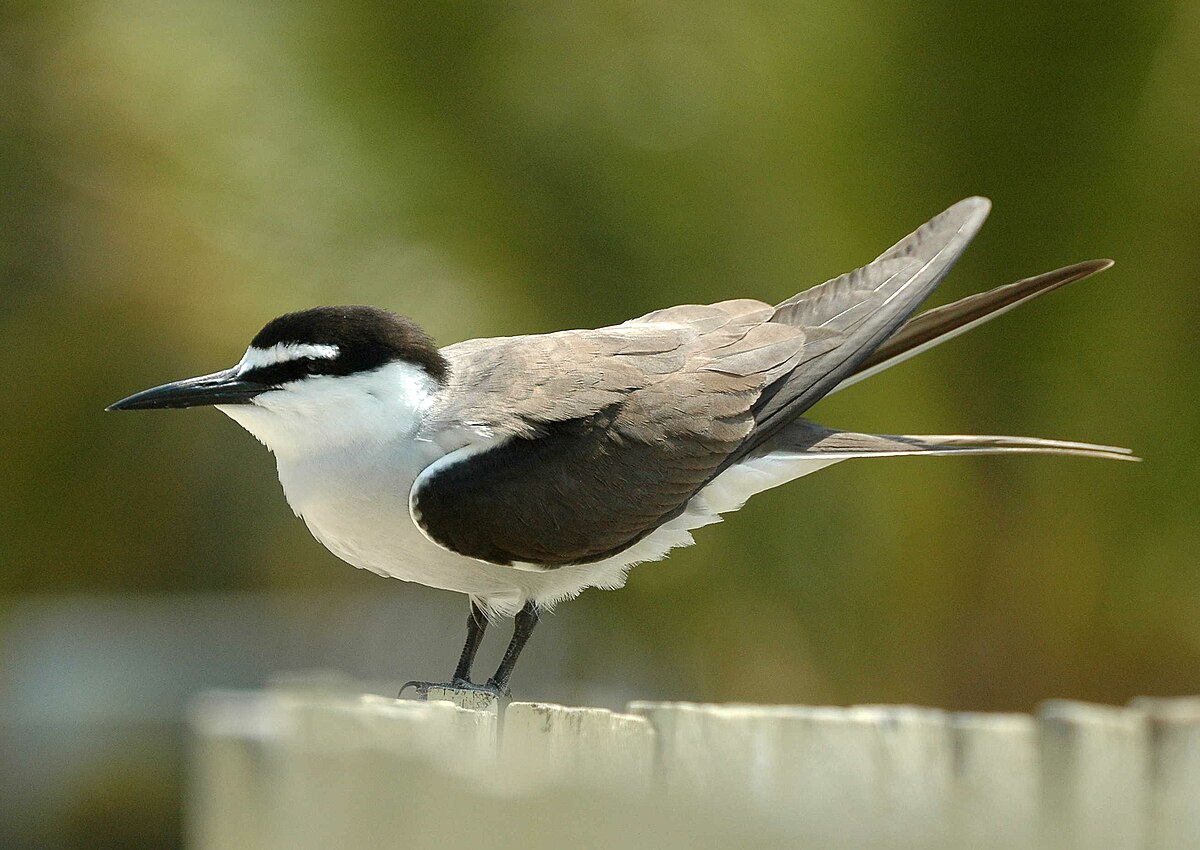
Wikipedia: Bridled tern Source: OTHER
1200px-Bridled_Tern_LEI_Nov06.JPG
This bird appears across the great seas in the following continents:
North America, South America, Africa, Asia.
![]() The bridled tern (Onychoprion anaethetus)[2] is a seabird of the family Laridae. It is a bird of the tropical oceans. The scientific name is from Ancient Greek. The genus comes from onux meaning "claw" or "nail", and prion, meaning "saw". The specific anaethetus means "senseless, stupid".[3]
[more]
The bridled tern (Onychoprion anaethetus)[2] is a seabird of the family Laridae. It is a bird of the tropical oceans. The scientific name is from Ancient Greek. The genus comes from onux meaning "claw" or "nail", and prion, meaning "saw". The specific anaethetus means "senseless, stupid".[3]
[more]
Little tern / Zwergseeschwalbe (Sternula albifrons)
Little Tern, Reykjavik, Iceland. 2015-05-29 11.18.30 Iceland
First observed in Iceland on 2015-05-29.
![]() The little tern (Sternula albifrons) is a seabird of the family Laridae. It was formerly placed into the genus Sterna, which now is restricted to the large white terns.[2] The genus name is a diminutive of Sterna, "tern". The specific albifrons is from Latin albus, "white", and "frons", forehead.[3] The former North American (S. a. antillarum) and Red Sea S. a. saundersi subspecies are now considered to be separate species, the least tern (Sternula antillarum) and Saunders's tern (Sternula saundersi).
[more]
The little tern (Sternula albifrons) is a seabird of the family Laridae. It was formerly placed into the genus Sterna, which now is restricted to the large white terns.[2] The genus name is a diminutive of Sterna, "tern". The specific albifrons is from Latin albus, "white", and "frons", forehead.[3] The former North American (S. a. antillarum) and Red Sea S. a. saundersi subspecies are now considered to be separate species, the least tern (Sternula antillarum) and Saunders's tern (Sternula saundersi).
[more]
Vocalization: ![]() Fairly distinct voice. [Link]
Fairly distinct voice. [Link]
Calls: ![]() Contact call a sharp "kitt", often combined to form undulating, rolling series. Not as sharp and penetrating as Common- and Arctic Tern. [Link]
Contact call a sharp "kitt", often combined to form undulating, rolling series. Not as sharp and penetrating as Common- and Arctic Tern. [Link]
Physical details: length=22-24 cm,
wingspan=48-55 cm,
weight=49-63 g
Habitats:
River and lake
Damara tern / Damaraseeschwalbe (Sternula balaenarum)
Profile Wikipedia eBird Xeno-Canto

Wikipedia: Damara tern Source: OTHER
Damara_Tern_%288077271589%29.jpg
General: ![]() The Damara tern (Sternula balaenarum) is a species of small tern in the family Laridae which breeds in the southern summer in southern Africa and migrates to tropical African coasts to winter.
[more]
The Damara tern (Sternula balaenarum) is a species of small tern in the family Laridae which breeds in the southern summer in southern Africa and migrates to tropical African coasts to winter.
[more]
Elegant tern (Thalasseus elegans)

Wikipedia: Elegant tern Source: OTHER
1200px-Elegant_Tern_Bolsa_Chica.jpg
This bird appears across the great seas in the following continents:
North America, South America, Africa.
![]() The elegant tern (Thalasseus elegans) is a tern in the family Laridae. It breeds on the Pacific coasts of the southern United States and Mexico and winters south to Peru, Ecuador and Chile.
[more]
The elegant tern (Thalasseus elegans) is a tern in the family Laridae. It breeds on the Pacific coasts of the southern United States and Mexico and winters south to Peru, Ecuador and Chile.
[more]
Sandwich tern / Brandseeschwalbe (Thalasseus sandvicensis)
Sandwich tern in flight with distinct yellow tipped bill. 2023-09-27 12.28.34 Florida
First observed in Costa Rica on 2018-03-11.
This bird appears across the great seas in the following continents:
Europe, North America, South America, Africa.
![]() The Sandwich tern (Thalasseus sandvicensis)[2] is a tern in the family Laridae. It is very closely related to the lesser crested tern (T. bengalensis), Chinese crested tern (T. bernsteini), Cabot's tern (T. acuflavidus), and elegant tern (T. elegans) and has been known to interbreed with the lesser crested. It breeds in the Palearctic from Europe to the Caspian Sea wintering to South Africa, India and Sri Lanka.
[more]
The Sandwich tern (Thalasseus sandvicensis)[2] is a tern in the family Laridae. It is very closely related to the lesser crested tern (T. bengalensis), Chinese crested tern (T. bernsteini), Cabot's tern (T. acuflavidus), and elegant tern (T. elegans) and has been known to interbreed with the lesser crested. It breeds in the Palearctic from Europe to the Caspian Sea wintering to South Africa, India and Sri Lanka.
[more]
Calls: ![]() Contact call a sharp and grating "keeree-eek". Often compared to the pressing of amalgam into a tooth. [Link]
Contact call a sharp and grating "keeree-eek". Often compared to the pressing of amalgam into a tooth. [Link]
Physical details: length=36-41 cm,
wingspan=95-105 cm,
weight=215-275 g
Habitats:
River and lake
Great crested-tern / Eilseeschwalbe (Thalasseus bergii)

Wikipedia: Great crested-tern Source: OTHER
1200px-Crested_Tern_Tasmania.jpg
General: ![]() The greater crested tern[3] (Thalasseus bergii), also called crested tern or swift tern, is a tern in the family Laridae that nests in dense colonies on coastlines and islands in the tropical and subtropical Old World. Its five subspecies breed in the area from South Africa around the Indian Ocean to the central Pacific and Australia, all populations dispersing widely from the breeding range after nesting. This large tern is closely related to the royal and lesser crested terns, but can be distinguished by its size and bill colour.
[more]
The greater crested tern[3] (Thalasseus bergii), also called crested tern or swift tern, is a tern in the family Laridae that nests in dense colonies on coastlines and islands in the tropical and subtropical Old World. Its five subspecies breed in the area from South Africa around the Indian Ocean to the central Pacific and Australia, all populations dispersing widely from the breeding range after nesting. This large tern is closely related to the royal and lesser crested terns, but can be distinguished by its size and bill colour.
[more]
Lesser crested-tern (Thalasseus bengalensis)

Wikipedia: Lesser crested-tern Source: OTHER
Lesser_crested_terns_%28Thalasseus_bengalensis%29_by_Shantanu_Kuveskar.jpg
![]() The lesser crested tern (Thalasseus bengalensis)[2] is a tern in the family, Laridae.
[more]
The lesser crested tern (Thalasseus bengalensis)[2] is a tern in the family, Laridae.
[more]
Black-winged lapwing (Vanellus melanopterus)
Profile Wikipedia eBird Xeno-Canto

Wikipedia: Black-winged lapwing Source: OTHER
Black-winged_Lapwing_-_Mara_-_KenyaIMG_3644.jpg
![]() The black-winged lapwing or greater black-winged lapwing (Vanellus melanopterus) is an east African species that is found from the Ethiopian highlands in the north to central Kenya (race V. m. melanopterus), and again at middle to coastal elevations in eastern South Africa (race V. m. minor). It is a habitat specialist of short grass in well-watered temperate grasslands. They may move about locally to find ideal situations, often at night. In their tightly grouped flying flocks they resemble plovers.
[more]
The black-winged lapwing or greater black-winged lapwing (Vanellus melanopterus) is an east African species that is found from the Ethiopian highlands in the north to central Kenya (race V. m. melanopterus), and again at middle to coastal elevations in eastern South Africa (race V. m. minor). It is a habitat specialist of short grass in well-watered temperate grasslands. They may move about locally to find ideal situations, often at night. In their tightly grouped flying flocks they resemble plovers.
[more]
Wattled lapwing (Vanellus senegallus)
Profile Wikipedia eBird Xeno-Canto

Wikipedia: Wattled lapwing Source: OTHER
1200px-African_wattled_lapwing_%28Vanellus_senegallus_senegallus%29.jpg
![]() The African wattled lapwing (Vanellus senegallus), also known as the Senegal wattled plover or simply wattled lapwing, is a large lapwing, a group of largish waders in the family Charadriidae. It is a resident breeder in most of sub-Saharan Africa outside the rainforests, although it has seasonal movements.
[more]
The African wattled lapwing (Vanellus senegallus), also known as the Senegal wattled plover or simply wattled lapwing, is a large lapwing, a group of largish waders in the family Charadriidae. It is a resident breeder in most of sub-Saharan Africa outside the rainforests, although it has seasonal movements.
[more]
Crowned lapwing / Kronenkiebitz (Vanellus coronatus)
Profile Wikipedia eBird Xeno-Canto

Wikipedia: Crowned lapwing Source: OTHER
1200px-Avefr%C3%ADa_coronada_%28Vanellus_coronatus%29%2C_Santuario_de_Rinocerontes_Khama%2C_Botsuana%2C_2018-08-02%2C_DD_22.jpg
![]() The crowned lapwing (Vanellus coronatus), or crowned plover, is a bird of the lapwing subfamily that occurs contiguously from the Red Sea coast of Somalia to southern and southwestern Africa. It is an adaptable and numerous species, with bold and noisy habits. It is related to the more localized black-winged and Senegal lapwings, with which it shares some plumage characteristics.
[more]
The crowned lapwing (Vanellus coronatus), or crowned plover, is a bird of the lapwing subfamily that occurs contiguously from the Red Sea coast of Somalia to southern and southwestern Africa. It is an adaptable and numerous species, with bold and noisy habits. It is related to the more localized black-winged and Senegal lapwings, with which it shares some plumage characteristics.
[more]
Senegal lapwing (Vanellus lugubris)
Profile Wikipedia eBird Xeno-Canto

Wikipedia: Senegal lapwing Source: OTHER
1200px-Senegal_Lapwing_-_Vanellus_lugubris.jpg
![]() The Senegal lapwing or lesser black-winged lapwing (Vanellus lugubris) is a species of bird in the family Charadriidae.
It is found in Angola, Burundi, Cameroon, Republic of the Congo, Democratic Republic of the Congo, Ivory Coast, Gabon, Gambia, Ghana, Guinea, Kenya, Liberia, Malawi, Mali, Mozambique, Nigeria, Rwanda, Senegal, Sierra Leone, Somalia, South Africa, Swaziland, Tanzania, Togo, Uganda, Zambia, and Zimbabwe.
[more]
The Senegal lapwing or lesser black-winged lapwing (Vanellus lugubris) is a species of bird in the family Charadriidae.
It is found in Angola, Burundi, Cameroon, Republic of the Congo, Democratic Republic of the Congo, Ivory Coast, Gabon, Gambia, Ghana, Guinea, Kenya, Liberia, Malawi, Mali, Mozambique, Nigeria, Rwanda, Senegal, Sierra Leone, Somalia, South Africa, Swaziland, Tanzania, Togo, Uganda, Zambia, and Zimbabwe.
[more]
White-headed lapwing (Vanellus albiceps)

Wikipedia: White-headed lapwing Source: OTHER
1200px-White-crowned_Lapwing_%287281408152%29%2C_crop.jpg
![]() The white-crowned lapwing, white-headed lapwing, white-headed plover or white-crowned plover (Vanellus albiceps) is a medium-sized wader. It is resident throughout tropical Africa, usually near large rivers.
[more]
The white-crowned lapwing, white-headed lapwing, white-headed plover or white-crowned plover (Vanellus albiceps) is a medium-sized wader. It is resident throughout tropical Africa, usually near large rivers.
[more]
Long-toed lapwing (Vanellus crassirostris)
Profile Wikipedia eBird Xeno-Canto

Wikipedia: Long-toed lapwing Source: OTHER
Long-toed_Lapwing_-_Mara_-_KenyaIMG_4271.jpg
![]() The long-toed lapwing (Vanellus crassirostris) is a species of bird in the family Charadriidae.
It is found in Angola, Botswana, Burundi, Cameroon, Chad, Democratic Republic of the Congo, Ethiopia, Kenya, Malawi, Mozambique, Namibia, Nigeria, Rwanda, South Africa, Sudan, Tanzania, Uganda, Zambia, and Zimbabwe.
[more]
The long-toed lapwing (Vanellus crassirostris) is a species of bird in the family Charadriidae.
It is found in Angola, Botswana, Burundi, Cameroon, Chad, Democratic Republic of the Congo, Ethiopia, Kenya, Malawi, Mozambique, Namibia, Nigeria, Rwanda, South Africa, Sudan, Tanzania, Uganda, Zambia, and Zimbabwe.
[more]
Blacksmith lapwing (Vanellus armatus)

Wikipedia: Blacksmith lapwing Source: OTHER
1200px-Vanellus_armatus_-_Etosha_2014.jpg
![]() The blacksmith lapwing or blacksmith plover (Vanellus armatus) is a lapwing species that occurs commonly from Kenya through central Tanzania to southern and southwestern Africa. The vernacular name derives from the repeated metallic 'tink, tink, tink' alarm call, which suggests a blacksmith's hammer striking an anvil.
[more]
The blacksmith lapwing or blacksmith plover (Vanellus armatus) is a lapwing species that occurs commonly from Kenya through central Tanzania to southern and southwestern Africa. The vernacular name derives from the repeated metallic 'tink, tink, tink' alarm call, which suggests a blacksmith's hammer striking an anvil.
[more]
Lesser sand-plover (Charadrius mongolus)

Wikipedia: Lesser sand-plover Source: OTHER
1200px-Charadrius_mongolus_-_Laem_Phak_Bia.jpg
This bird appears across the great seas in the following continents:
North America, Africa, Asia.
![]() The lesser sand plover (Charadrius mongolus) is a small wader in the plover family of birds. The spelling is commonly given as lesser sand-plover, but the official British Ornithologists' Union spelling is "lesser sand plover". The genus name Charadrius is a Late Latin word for a yellowish bird mentioned in the fourth-century Vulgate. It derives from Ancient Greek kharadrios a bird found in ravines and river valleys (kharadra, "ravine"). The specific mongolus is Latin and refers to Mongolia which at the time of naming referred to a larger area than the present country.[2]
[more]
The lesser sand plover (Charadrius mongolus) is a small wader in the plover family of birds. The spelling is commonly given as lesser sand-plover, but the official British Ornithologists' Union spelling is "lesser sand plover". The genus name Charadrius is a Late Latin word for a yellowish bird mentioned in the fourth-century Vulgate. It derives from Ancient Greek kharadrios a bird found in ravines and river valleys (kharadra, "ravine"). The specific mongolus is Latin and refers to Mongolia which at the time of naming referred to a larger area than the present country.[2]
[more]
Caspian plover (Charadrius asiaticus)

Wikipedia: Caspian plover Source: OTHER
Charadrius_asiaticus.jpg
![]() The Caspian plover (Charadrius asiaticus) is a wader in the plover family of birds. The genus name Charadrius is a Late Latin word for a yellowish bird mentioned in the fourth-century Vulgate. It derives from Ancient Greek kharadrios a bird found in ravines and river valleys (kharadra, "ravine"). The specific asiaticus is Latin and means "Asian", although in binomials it usually means the type locality was India.[2]
[more]
The Caspian plover (Charadrius asiaticus) is a wader in the plover family of birds. The genus name Charadrius is a Late Latin word for a yellowish bird mentioned in the fourth-century Vulgate. It derives from Ancient Greek kharadrios a bird found in ravines and river valleys (kharadra, "ravine"). The specific asiaticus is Latin and means "Asian", although in binomials it usually means the type locality was India.[2]
[more]
White-fronted plover (Charadrius marginatus)
Profile Wikipedia eBird Xeno-Canto

Wikipedia: White-fronted plover Source: OTHER
1200px-White-fronted_plover_%28Charadrius_marginatus%29.jpg
![]() The white-fronted plover or white-fronted sandplover (Charadrius marginatus) is a small (45-50 g) shorebird of the family Charadriidae that inhabits sandy beaches, dunes, mudflats and the shores of rivers and lakes in sub-saharan Africa and Madagascar. It nests in small shallow scrapes in the ground and lays clutches of 1-3 eggs. The species is monogamous and long-lived, with a life expectancy of approximately 11 years. The vast majority of pairs that mate together stay together during the following years of breeding and retain the same territory. The white-fronted plover has a similar appearance to the Kentish plover, with a white fore crown and dark bands connecting the eyes to the bill.
[more]
The white-fronted plover or white-fronted sandplover (Charadrius marginatus) is a small (45-50 g) shorebird of the family Charadriidae that inhabits sandy beaches, dunes, mudflats and the shores of rivers and lakes in sub-saharan Africa and Madagascar. It nests in small shallow scrapes in the ground and lays clutches of 1-3 eggs. The species is monogamous and long-lived, with a life expectancy of approximately 11 years. The vast majority of pairs that mate together stay together during the following years of breeding and retain the same territory. The white-fronted plover has a similar appearance to the Kentish plover, with a white fore crown and dark bands connecting the eyes to the bill.
[more]
Little ringed plover / Flussregenpfeifer (Charadrius dubius)
Profile Wikipedia eBird Vogelwarte BirdLife ZH ornitho.ch Xeno-Canto BirdID NABU
Little Ringed Plovers, Phnom Krom. 2024-03-03 09.12.46 Cambodia
First observed in Mallorca on 2022-04-10.
![]() The little ringed plover (Charadrius dubius) is a small plover. The genus name Charadrius is a Late Latin word for a yellowish bird mentioned in the fourth-century Vulgate. It derives from Ancient Greek kharadrios a bird found in river valleys (kharadra, "ravine"). The specific dubius is Latin for doubtful, since Sonnerat, writing in 1776, thought this bird might be just a variant of common ringed plover.[2]
[more]
The little ringed plover (Charadrius dubius) is a small plover. The genus name Charadrius is a Late Latin word for a yellowish bird mentioned in the fourth-century Vulgate. It derives from Ancient Greek kharadrios a bird found in river valleys (kharadra, "ravine"). The specific dubius is Latin for doubtful, since Sonnerat, writing in 1776, thought this bird might be just a variant of common ringed plover.[2]
[more]
Vocalization: ![]() Quite different from Ringed Plover. Sharper sounding, lacking Ringed's soft tone. Often starts with a rolling "r". [Link]
Quite different from Ringed Plover. Sharper sounding, lacking Ringed's soft tone. Often starts with a rolling "r". [Link]
Calls: ![]() Common calls are a two syllable "krrll-uuit" with a rising pitch or just a sharp, rolling "krrri-krrri". Also a longer rolling "krree-looo" with pitch rising in first syllable and falling in the second. [Link]
Common calls are a two syllable "krrll-uuit" with a rising pitch or just a sharp, rolling "krrri-krrri". Also a longer rolling "krree-looo" with pitch rising in first syllable and falling in the second. [Link]
Physical details: length=14-15 cm,
wingspan=42-48 cm,
weight=32-48 g
Habitats:
Wetland
Song:
Automatically generated from Xeno-Canto recording
Song attributes:
Frequency:
♫ Source: BirdNet
20220410_111023 birdnet - Flussregenpfeifer - Flussregenpfeifer - Felanitx.mp3
2022-04-10 11.10.23 Mallorca (song)
Call:
Automatically generated from Xeno-Canto recording
♫ XC835676 - Little Ringed Plover - Charadrius dubius - flight call, song - Dundgovi, Mongolia. Source: XENOCANTO
XC835676 - Little Ringed Plover - Charadrius dubius - flight call, song - Dundgovi, Mongolia.mp3
(flight call)
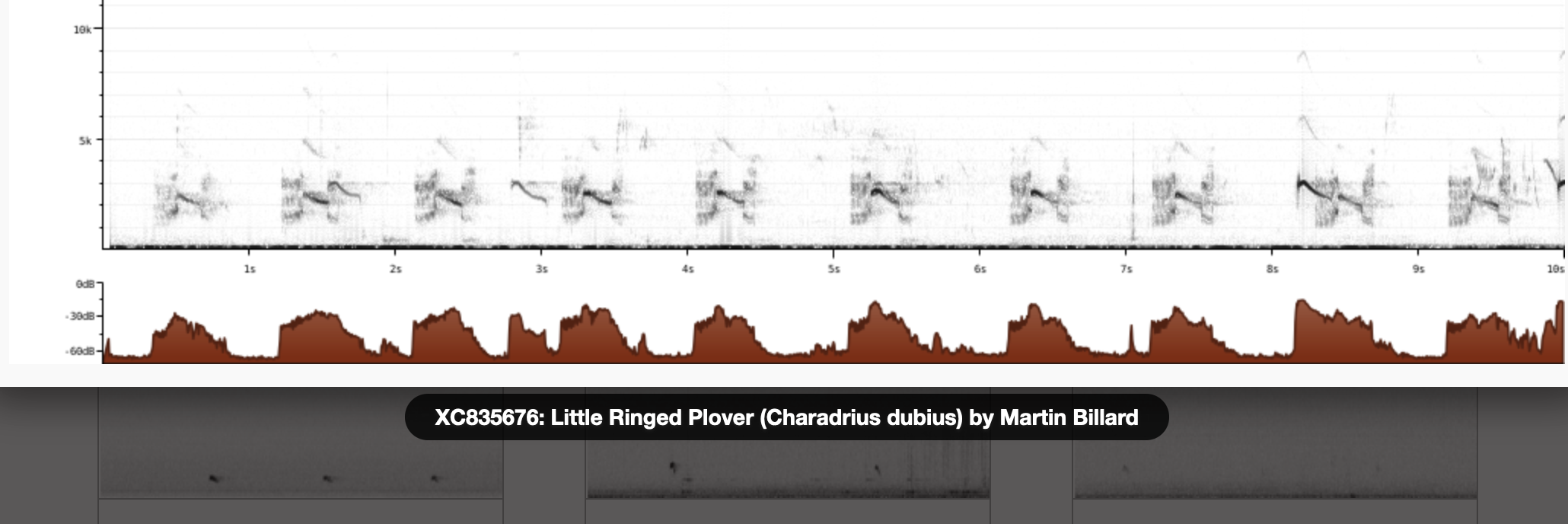
Call attributes:
flight call Frequency: ,
Kittlitz's plover (Charadrius pecuarius)
Profile Wikipedia eBird Xeno-Canto

Wikipedia: Kittlitz's plover Source: OTHER
1200px-Kittlitz%27s_plover_%28Charadrius_pecuarius%29.jpg
General: ![]() Kittlitz's plover (Charadrius pecuarius) is a small shorebird (35-40 g) in the family Charadriidae that breeds near coastal and inland saltmarshes, sandy or muddy riverbanks or alkaline grasslands with short vegetation. It is native to much of Sub-Saharan Africa, the Nile Delta and Madagascar. It is thought to be mainly monogamous and has monomorphic plumage.
[more]
Kittlitz's plover (Charadrius pecuarius) is a small shorebird (35-40 g) in the family Charadriidae that breeds near coastal and inland saltmarshes, sandy or muddy riverbanks or alkaline grasslands with short vegetation. It is native to much of Sub-Saharan Africa, the Nile Delta and Madagascar. It is thought to be mainly monogamous and has monomorphic plumage.
[more]
Three-banded plover / Dreibandregenpfeifer (Charadrius tricollaris)
Profile Wikipedia eBird Xeno-Canto

Wikipedia: Three-banded plover Source: OTHER
1200px-Three-banded_plover_%28Charadrius_tricollaris%29.jpg
![]() The three-banded plover, or three-banded sandplover (Charadrius tricollaris), is a small wader. This plover is resident in much of eastern and southern Africa and Madagascar, mainly on inland rivers, pools, and lakes. Its nest is a bare scrape on shingle. This species is often seen as single individuals, but it will form small flocks. It hunts by sight for insects, worms and other invertebrates. Three-banded plovers have a sharp whistled weeet-weet call.
[more]
The three-banded plover, or three-banded sandplover (Charadrius tricollaris), is a small wader. This plover is resident in much of eastern and southern Africa and Madagascar, mainly on inland rivers, pools, and lakes. Its nest is a bare scrape on shingle. This species is often seen as single individuals, but it will form small flocks. It hunts by sight for insects, worms and other invertebrates. Three-banded plovers have a sharp whistled weeet-weet call.
[more]
Common ringed plover / Sandregenpfeifer (Charadrius hiaticula)
Profile Wikipedia eBird Vogelwarte BirdLife ZH ornitho.ch Audubon AllAboutBirds Xeno-Canto BirdID NABU
Sandregenpfeifer im Profil, Neeracherried. 2022-09-04 07.25.18 Neeracherried
First observed in 🇨🇭 on 2022-09-04.
This bird appears across the great seas in the following continents:
Europe, North America, Africa.
![]() The common ringed plover or ringed plover (Charadrius hiaticula) is a small plover that breeds in Arctic Eurasia. The genus name Charadrius is a Late Latin word for a yellowish bird mentioned in the fourth-century Vulgate. It derives from Ancient Greek kharadrios a bird found in ravines and river valleys (kharadra, "ravine"). The specific hiaticula is Latin and has a similar meaning to the Greek term, coming from hiatus, "cleft" and -cola, "dweller" (colere, "to dwell").[2]
[more]
The common ringed plover or ringed plover (Charadrius hiaticula) is a small plover that breeds in Arctic Eurasia. The genus name Charadrius is a Late Latin word for a yellowish bird mentioned in the fourth-century Vulgate. It derives from Ancient Greek kharadrios a bird found in ravines and river valleys (kharadra, "ravine"). The specific hiaticula is Latin and has a similar meaning to the Greek term, coming from hiatus, "cleft" and -cola, "dweller" (colere, "to dwell").[2]
[more]
Vocalization: ![]() Usually heard before seen. [Link]
Usually heard before seen. [Link]
Song: ![]() Song a cyclic repetition of the contact call. Sometimes with a shortened phrases and a more creaking timbre. [Link]
Song a cyclic repetition of the contact call. Sometimes with a shortened phrases and a more creaking timbre. [Link]
Calls: ![]() Contact call a short, soft "koo-eep", with the emphasised second part higher and rising in pitch. [Link]
Contact call a short, soft "koo-eep", with the emphasised second part higher and rising in pitch. [Link]
Physical details: length=18-20 cm,
wingspan=48-57 cm,
weight=55-73 g
Habitats:
Wetland
Chestnut-banded plover / Fahlregenpfeifer (Charadrius pallidus)
Profile Wikipedia eBird Xeno-Canto

Wikipedia: Chestnut-banded plover Source: OTHER
Chestnut-banded_Plover_-_Ndutu_-_Tanzania_0263.jpg
General: ![]() The chestnut-banded plover (Charadrius pallidus) is a species of bird in the family Charadriidae. This species has a large range, being distributed across Southern Africa. However, it occupies a rather small area.
[more]
The chestnut-banded plover (Charadrius pallidus) is a species of bird in the family Charadriidae. This species has a large range, being distributed across Southern Africa. However, it occupies a rather small area.
[more]
Greater sand plover / Wüstenregenpfeifer (Charadrius leschenaultii)

Wikipedia: Greater sand plover Source: OTHER
1200px-Greater_Sand_Plover_1_-_Lee_Point.jpg
![]() The greater sand plover (Charadrius leschenaultii) is a small wader in the plover family of birds. The spelling is commonly given as "greater sandplover" or "greater sand-plover", but the official British Ornithologists' Union spelling is "Greater Sand Plover".[2] The genus name Charadrius is a Late Latin word for a yellowish bird mentioned in the fourth-century Vulgate. It derives from Ancient Greek kharadrios a bird found in ravines and river valleys (kharadra, "ravine"). The specific leschenaultii commemorates the French botanist Jean Baptiste Leschenault de la Tour.[3]
[more]
The greater sand plover (Charadrius leschenaultii) is a small wader in the plover family of birds. The spelling is commonly given as "greater sandplover" or "greater sand-plover", but the official British Ornithologists' Union spelling is "Greater Sand Plover".[2] The genus name Charadrius is a Late Latin word for a yellowish bird mentioned in the fourth-century Vulgate. It derives from Ancient Greek kharadrios a bird found in ravines and river valleys (kharadra, "ravine"). The specific leschenaultii commemorates the French botanist Jean Baptiste Leschenault de la Tour.[3]
[more]
American golden-plover (Pluvialis dominica)
Profile Wikipedia eBird Audubon AllAboutBirds Xeno-Canto
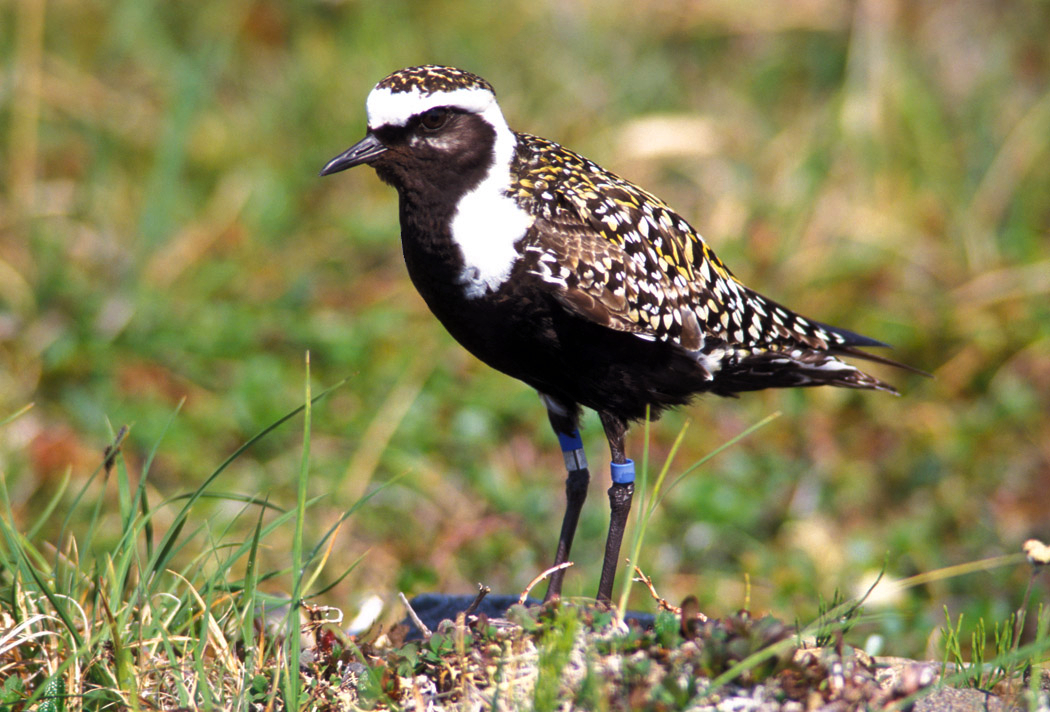
Wikipedia: American golden-plover Source: OTHER
Pluvialis_dominica1.jpg
This bird appears across the great seas in the following continents:
North America, South America, Africa.
![]() The American golden plover (Pluvialis dominica), or American golden-plover is a medium-sized plover. The genus name is Latin and means relating to rain, from pluvia, "rain". It was believed that golden plovers flocked when rain was imminent. The species name dominica refers to Santo Domingo, now Hispaniola, in the West Indies.[2]
[more]
The American golden plover (Pluvialis dominica), or American golden-plover is a medium-sized plover. The genus name is Latin and means relating to rain, from pluvia, "rain". It was believed that golden plovers flocked when rain was imminent. The species name dominica refers to Santo Domingo, now Hispaniola, in the West Indies.[2]
[more]
Black-bellied plover / Kiebitzregenpfeifer (Pluvialis squatarola)
Black-bellied plover eggs. 2016-09-25 16.51.00 Botswana
First observed in Botswana on 2016-09-25.
This bird appears across the great seas in the following continents:
Europe, North America, South America, Africa, Asia.
![]() The grey plover or black-bellied plover (Pluvialis squatarola) is a medium-sized plover breeding in Arctic regions. It is a long-distance migrant, with a nearly worldwide coastal distribution when not breeding.[2] The genus name is Latin and means relating to rain, from pluvia, "rain". It was believed that golden plovers flocked when rain was imminent. The species name squatarola is a Latinised version of Sgatarola, a Venetian name for some kind of plover.[3]
[more]
The grey plover or black-bellied plover (Pluvialis squatarola) is a medium-sized plover breeding in Arctic regions. It is a long-distance migrant, with a nearly worldwide coastal distribution when not breeding.[2] The genus name is Latin and means relating to rain, from pluvia, "rain". It was believed that golden plovers flocked when rain was imminent. The species name squatarola is a Latinised version of Sgatarola, a Venetian name for some kind of plover.[3]
[more]
Calls: ![]() Contact call diagnostic. A plaintive, drawn and trisyllabic (but continuous) "kleeooowee". Pitch falls on second syllable and rises on last. [Link]
Contact call diagnostic. A plaintive, drawn and trisyllabic (but continuous) "kleeooowee". Pitch falls on second syllable and rises on last. [Link]
Physical details: length=27-30 cm,
wingspan=71-83 cm,
weight=190-280 g
Habitats:
Wetland
Pacific golden plover / Sibirischer Goldregenpfeifer (Pluvialis fulva)

Wikipedia: Pacific golden plover Source: OTHER
Pluvialis_fulva_-Bering_Land_Bridge_National_Preserve%2C_Alaska%2C_USA-8.jpg
This bird appears across the great seas in the following continents:
North America, Africa, Asia.
General: ![]() The Pacific golden plover (Pluvialis fulva), or Pacific golden-plover is a medium-sized plover. The genus name is Latin and means relating to rain, from pluvia, "rain". It was believed that golden plovers flocked when rain was imminent. The species name fulva is Latin and refers to a tawny colour.[2]
[more]
The Pacific golden plover (Pluvialis fulva), or Pacific golden-plover is a medium-sized plover. The genus name is Latin and means relating to rain, from pluvia, "rain". It was believed that golden plovers flocked when rain was imminent. The species name fulva is Latin and refers to a tawny colour.[2]
[more]
White-rumped sandpiper / Weißbürzelstrandläufer (Calidris fuscicollis)
Profile Wikipedia eBird Audubon AllAboutBirds Xeno-Canto

Wikipedia: White-rumped sandpiper Source: OTHER
1200px-Calidris_fuscicollis_PLAYERO_RABADILLA_BLANCA.jpg
This bird appears across the great seas in the following continents:
North America, South America, Africa.
![]() The white-rumped sandpiper (Calidris fuscicollis) is a small shorebird that breeds in the northern tundra of Canada and Alaska. This bird can be difficult to distinguish from other similar tiny shorebirds; these are known collectively as "peeps" or "stints".
[more]
The white-rumped sandpiper (Calidris fuscicollis) is a small shorebird that breeds in the northern tundra of Canada and Alaska. This bird can be difficult to distinguish from other similar tiny shorebirds; these are known collectively as "peeps" or "stints".
[more]
Broad-billed sandpiper / Sumpfläufer (alternate) (Calidris falcinellus)
Profile Wikipedia eBird Xeno-Canto NABU

Wikipedia: Broad-billed sandpiper Source: OTHER
1200px-Broad_billed_sandpiper_by_Sreedev_Puthur.jpg
![]() The broad-billed sandpiper (Calidris falcinellus) is a small wading bird. The scientific name is from Latin. The specific name falcinella is from falx, falcis, "a sickle.[2] Some research suggests that it should rather go into the genus Philomachus.[3]
[more]
The broad-billed sandpiper (Calidris falcinellus) is a small wading bird. The scientific name is from Latin. The specific name falcinella is from falx, falcis, "a sickle.[2] Some research suggests that it should rather go into the genus Philomachus.[3]
[more]
Temminck's stint / Temminckstrandläufer (Calidris temminckii)
Profile Wikipedia eBird Vogelwarte BirdLife ZH ornitho.ch Xeno-Canto NABU

Wikipedia: Temminck's stint Source: OTHER
1200px-Temmincks_Stint.jpg
![]() Temminck's stint (Calidris temminckii) is a small wader. This bird's common name and Latin binomial commemorate the Dutch naturalist Coenraad Jacob Temminck.[3] The genus name is from Ancient Greek kalidris or skalidris, a term used by Aristotle for some grey-coloured waterside birds.[4]
[more]
Temminck's stint (Calidris temminckii) is a small wader. This bird's common name and Latin binomial commemorate the Dutch naturalist Coenraad Jacob Temminck.[3] The genus name is from Ancient Greek kalidris or skalidris, a term used by Aristotle for some grey-coloured waterside birds.[4]
[more]
Habitats:
Wetland
Red knot / Knutt (Calidris canutus)
Profile Wikipedia eBird Vogelwarte BirdLife ZH ornitho.ch Audubon AllAboutBirds Xeno-Canto BirdID NABU
Red knots, according to MerlinBirdID - underway to somewhere better at Las Coloradas. 2023-04-15 09.34.08 Yucatan
First observed in Yucatan on 2023-04-15.
This bird appears across the great seas in the following continents:
Europe, North America, South America, Africa, Asia.
![]() The red knot (Calidris canutus) (just knot in English-speaking Europe) is a medium-sized shorebird which breeds in tundra and the Arctic Cordillera in the far north of Canada, Europe, and Russia. It is a large member of the Calidris sandpipers, second only to the great knot.[2] Six subspecies are recognised.
[more]
The red knot (Calidris canutus) (just knot in English-speaking Europe) is a medium-sized shorebird which breeds in tundra and the Arctic Cordillera in the far north of Canada, Europe, and Russia. It is a large member of the Calidris sandpipers, second only to the great knot.[2] Six subspecies are recognised.
[more]
Song: ![]() Song an undulating, nasal mewing "poooor-mee", or "po-hor-mee". [Link]
Song an undulating, nasal mewing "poooor-mee", or "po-hor-mee". [Link]
Calls: ![]() Most commonly heard migratory call, a short "kut" or "knot". Sometimes given in stuttering series. [Link]
Most commonly heard migratory call, a short "kut" or "knot". Sometimes given in stuttering series. [Link]
Physical details: length=23-25 cm,
wingspan=57-61 cm,
weight=110-160 g
Habitats:
Wetland
Long-toed stint / Langzehenstrandläufer (Calidris subminuta)
Profile Wikipedia eBird Audubon AllAboutBirds Xeno-Canto

Wikipedia: Long-toed stint Source: OTHER
1200px-Calidris_subminuta_-_Pak_Thale.jpg
This bird appears across the great seas in the following continents:
North America, Africa, Asia.
General: ![]() The long-toed stint, Calidris subminuta, is a small wader. The genus name is from Ancient Greek kalidris or skalidris, a term used by Aristotle for some grey-coloured waterside birds. The specific subminuta is from Latin sub, "near to" and minuta, "small" from its similarity to the little stint, Calidris minuta.[2]
[more]
The long-toed stint, Calidris subminuta, is a small wader. The genus name is from Ancient Greek kalidris or skalidris, a term used by Aristotle for some grey-coloured waterside birds. The specific subminuta is from Latin sub, "near to" and minuta, "small" from its similarity to the little stint, Calidris minuta.[2]
[more]
Baird's sandpiper / Bairdstrandläufer (Calidris bairdii)
Profile Wikipedia eBird Audubon AllAboutBirds Xeno-Canto

Wikipedia: Baird's sandpiper Source: OTHER
Calidris_bairdii_-Gullbringusysla%2C_Iceland-8.jpg
This bird appears across the great seas in the following continents:
North America, South America, Africa.
![]() Baird's sandpiper (Calidris bairdii) is a small shorebird. It is among those calidrids which were formerly included in the genus Erolia, which was subsumed into the genus Calidris in 1973.[2] The genus name is from Ancient Greek kalidris or skalidris, a term used by Aristotle for some grey-coloured waterside birds. The English name and specific bairdii commemorate Spencer Fullerton Baird, 19th-century naturalist and assistant secretary of the Smithsonian Institution.[3]
[more]
Baird's sandpiper (Calidris bairdii) is a small shorebird. It is among those calidrids which were formerly included in the genus Erolia, which was subsumed into the genus Calidris in 1973.[2] The genus name is from Ancient Greek kalidris or skalidris, a term used by Aristotle for some grey-coloured waterside birds. The English name and specific bairdii commemorate Spencer Fullerton Baird, 19th-century naturalist and assistant secretary of the Smithsonian Institution.[3]
[more]
Buff-breasted sandpiper / Grasläufer (Calidris subruficollis)

Wikipedia: Buff-breasted sandpiper Source: OTHER
1200px-Tryngites_subruficollis_-USA-8.jpg
This bird appears across the great seas in the following continents:
North America, South America, Africa.
![]() The buff-breasted sandpiper (Calidris subruficollis) is a small shorebird. The species name subruficollis is from Latin subrufus, "reddish" (from sub, "somewhat", and rufus, "rufous") and collis, "-necked/-throated" (from collum, "neck").[2] It is a calidrid sandpiper.
[more]
The buff-breasted sandpiper (Calidris subruficollis) is a small shorebird. The species name subruficollis is from Latin subrufus, "reddish" (from sub, "somewhat", and rufus, "rufous") and collis, "-necked/-throated" (from collum, "neck").[2] It is a calidrid sandpiper.
[more]
Sanderling / Sanderling (Calidris alba)
Profile Wikipedia eBird Vogelwarte BirdLife ZH ornitho.ch Audubon AllAboutBirds Xeno-Canto BirdID NABU
Sanderling. 2023-09-27 12.12.20 Florida
First observed in Yucatan on 2023-03-27.
This bird appears across the great seas in the following continents:
Europe, North America, South America, Africa, Asia.
![]() The sanderling (Calidris alba) is a small wading bird. The name derives from Old English sand-yrðling, "sand-ploughman".[2] The genus name is from Ancient Greek kalidris or skalidris, a term used by Aristotle for some grey-coloured waterside birds. The specific alba is Latin for "white".[3]
[more]
The sanderling (Calidris alba) is a small wading bird. The name derives from Old English sand-yrðling, "sand-ploughman".[2] The genus name is from Ancient Greek kalidris or skalidris, a term used by Aristotle for some grey-coloured waterside birds. The specific alba is Latin for "white".[3]
[more]
Calls: ![]() Call not very diagnostic; a short and soft "pleet" or "keek". [Link]
Call not very diagnostic; a short and soft "pleet" or "keek". [Link]
Physical details: length=20-21 cm,
wingspan=40-45 cm,
weight=44-70 g
Habitats:
Wetland
Dunlin / Alpenstrandläufer (Calidris alpina)
Profile Wikipedia eBird Vogelwarte BirdLife ZH ornitho.ch Audubon AllAboutBirds Xeno-Canto BirdID NABU
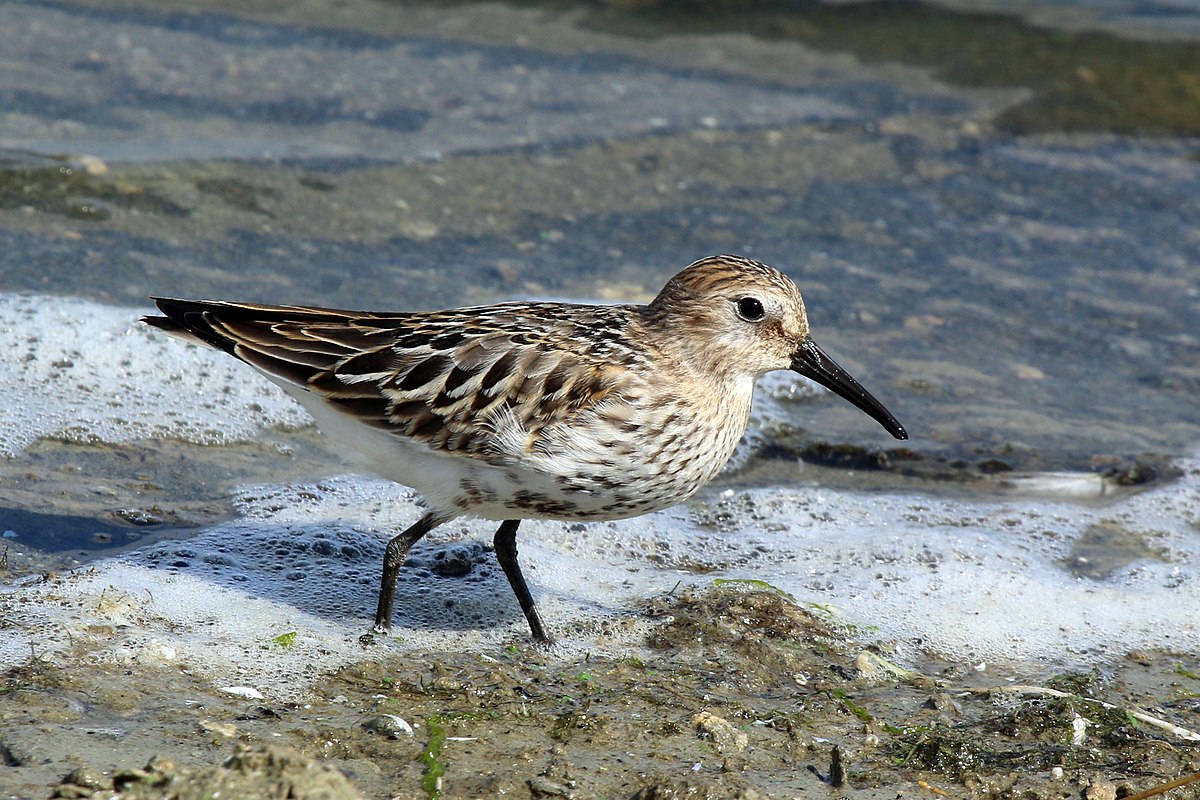
Wikipedia: Dunlin Source: OTHER
1200px-Dunlin_%28Calidris_alpina%29_juvenile.jpg
This bird appears across the great seas in the following continents:
Europe, North America, South America, Africa.
General: ![]() The dunlin (Calidris alpina) is a small wader, sometimes separated with the other "stints" in Erolia. The English name is a dialect form of "dunling", first recorded in 1531–2. It derives from dun, "dull brown", with the suffix -ling, meaning a person or thing with the given quality.[2] The genus name is from Ancient Greek kalidris or skalidris, a term used by Aristotle for some grey-coloured waterside birds. The specific alpina is from Latin and means "of high mountains", in this case referring to the Alps.[3]
[more]
The dunlin (Calidris alpina) is a small wader, sometimes separated with the other "stints" in Erolia. The English name is a dialect form of "dunling", first recorded in 1531–2. It derives from dun, "dull brown", with the suffix -ling, meaning a person or thing with the given quality.[2] The genus name is from Ancient Greek kalidris or skalidris, a term used by Aristotle for some grey-coloured waterside birds. The specific alpina is from Latin and means "of high mountains", in this case referring to the Alps.[3]
[more]
Song: ![]() Song: A drawn out, nasal "tweeet", and ringing variations on the contact call in decrescendo. Low chattering heard from feeding birds. [Link]
Song: A drawn out, nasal "tweeet", and ringing variations on the contact call in decrescendo. Low chattering heard from feeding birds. [Link]
Calls: ![]() Contact call a diagnostic, very nasal "trrreeet" . Given throughout the year and in many situations, including when being flushed. [Link]
Contact call a diagnostic, very nasal "trrreeet" . Given throughout the year and in many situations, including when being flushed. [Link]
Physical details: length=16-20 cm,
wingspan=38-43 cm,
weight=35-60 g
Habitats:
Wetland
Great knot (Calidris tenuirostris)
Profile Wikipedia eBird Xeno-Canto

Wikipedia: Great knot Source: OTHER
1200px-Calidris_tenuirostris_-_Laem_Phak_Bia.jpg
General: ![]() The great knot (Calidris tenuirostris) is a small wader. It is the largest of the calidrid species. The genus name is from Ancient Greek kalidris or skalidris, a term used by Aristotle for some grey-coloured waterside birds. The specific tenuirostris is from Latin tenuis "slender" and rostrum "bill".[2]
[more]
The great knot (Calidris tenuirostris) is a small wader. It is the largest of the calidrid species. The genus name is from Ancient Greek kalidris or skalidris, a term used by Aristotle for some grey-coloured waterside birds. The specific tenuirostris is from Latin tenuis "slender" and rostrum "bill".[2]
[more]
Rufous-necked stint / Rotkehlstrandläufer (Calidris ruficollis)
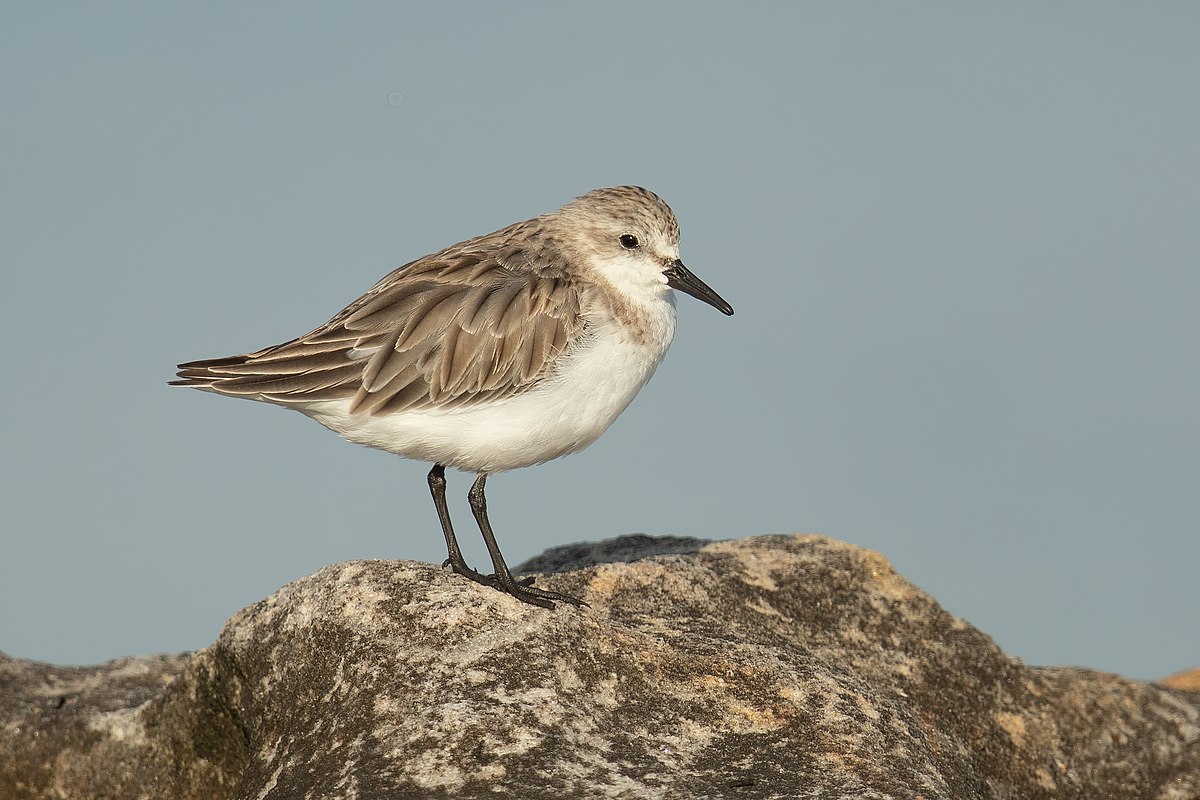
Wikipedia: Rufous-necked stint Source: OTHER
1200px-Red-necked_Stint_-_Boat_Harbour.jpg
This bird appears across the great seas in the following continents:
North America, Africa, Asia.
![]() The red-necked stint (Calidris ruficollis) is a small migratory wader. The genus name is from Ancient Greek kalidris or skalidris, a term used by Aristotle for some grey-coloured waterside birds. The specific ruficollis is from Latin rufus, "red" and collum, "neck".[2]
[more]
The red-necked stint (Calidris ruficollis) is a small migratory wader. The genus name is from Ancient Greek kalidris or skalidris, a term used by Aristotle for some grey-coloured waterside birds. The specific ruficollis is from Latin rufus, "red" and collum, "neck".[2]
[more]
Little stint / Zwergstrandläufer (Calidris minuta)
Profile Wikipedia eBird Vogelwarte BirdLife ZH ornitho.ch Xeno-Canto BirdID NABU

Wikipedia: Little stint Source: OTHER
Little_Stint_%28Calidris_minuta%29_2.jpg
![]() The little stint (Calidris minuta) (or Erolia minuta), is a very small wader. It breeds in arctic Europe and Asia, and is a long-distance migrant, wintering south to Africa and south Asia. It occasionally is a vagrant to North America and to Australia. The genus name is from Ancient Greek kalidris or skalidris, a term used by Aristotle for some grey-coloured waterside birds. The specific minuta is Latin for "small.[2]
[more]
The little stint (Calidris minuta) (or Erolia minuta), is a very small wader. It breeds in arctic Europe and Asia, and is a long-distance migrant, wintering south to Africa and south Asia. It occasionally is a vagrant to North America and to Australia. The genus name is from Ancient Greek kalidris or skalidris, a term used by Aristotle for some grey-coloured waterside birds. The specific minuta is Latin for "small.[2]
[more]
Song: ![]() Song a cyclic series of thin "peee-peee-peee" rising and falling in pitch. [Link]
Song a cyclic series of thin "peee-peee-peee" rising and falling in pitch. [Link]
Calls: ![]() Contact call a quite soft, short, high pitched "pit". Sometimes uttered in series, or as soft chattering. [Link]
Contact call a quite soft, short, high pitched "pit". Sometimes uttered in series, or as soft chattering. [Link]
Physical details: length=12-14 cm,
wingspan=34-37 cm,
weight=18-30 g
Habitats:
Wetland
Pectoral sandpiper / Graubrust-Strandläufer (Calidris melanotos)
Profile Wikipedia eBird Audubon AllAboutBirds Xeno-Canto

Wikipedia: Pectoral sandpiper Source: OTHER
1200px-Pectoral_Sandpiper3.jpg
This bird appears across the great seas in the following continents:
North America, South America, Africa.
General: ![]() The pectoral sandpiper (Calidris melanotos) is a small, migratory wader that breeds in North America and Asia, wintering in South America and Oceania. It eats small invertebrates. Its nest, a hole scraped in the ground and with a thick lining, is deep enough to protect its four eggs from the cool breezes of its breeding grounds. The pectoral sandpiper is 21 cm (8.3 in) long, with a wingspan of 46 cm (18 in).
[more]
The pectoral sandpiper (Calidris melanotos) is a small, migratory wader that breeds in North America and Asia, wintering in South America and Oceania. It eats small invertebrates. Its nest, a hole scraped in the ground and with a thick lining, is deep enough to protect its four eggs from the cool breezes of its breeding grounds. The pectoral sandpiper is 21 cm (8.3 in) long, with a wingspan of 46 cm (18 in).
[more]
Whimbrel / Regenbrachvogel (Numenius phaeopus)
Regenbrachvogel oder Grosser Brachvogel - dunkle Schwanzfedern ein moegliches Zeichen. 2022-06-23 16.53.34 La Sauge
First observed in Canary Islands on 2022-03-19.
This bird appears across the great seas in the following continents:
Europe, North America, South America, Africa, Asia.
![]() Der Regenbrachvogel (Numenius phaeopus) ist mit einer Spannweite um die 80 cm viel kleiner als der Große Brachvogel, auch der Schnabel ist kürzer und der Oberkopf ist hell und dunkel gestreift. Der Ruf dieser Vogelart ähnelt einem hellen Trillern.
[more]
Der Regenbrachvogel (Numenius phaeopus) ist mit einer Spannweite um die 80 cm viel kleiner als der Große Brachvogel, auch der Schnabel ist kürzer und der Oberkopf ist hell und dunkel gestreift. Der Ruf dieser Vogelart ähnelt einem hellen Trillern.
[more]
Song: ![]() Song starts similar to Curlew with long wailing notes "kluuueee", which then accelerates to a continuous, vibrating single note. Lacks the cyclic phrase ending of Curlew. [Link]
Song starts similar to Curlew with long wailing notes "kluuueee", which then accelerates to a continuous, vibrating single note. Lacks the cyclic phrase ending of Curlew. [Link]
Physical details: length=40-42 cm,
wingspan=76-89 cm,
weight=300-660 g
Habitats:
Wetland
Ruddy turnstone / Steinwälzer (Arenaria interpres)
Ruddy turnstone near Las Coloradas. 2023-04-15 10.06.32 Yucatan
First observed in Canary Islands on 2022-03-19.
This bird appears across the great seas in the following continents:
Europe, North America, South America, Africa, Asia.
General: ![]() The ruddy turnstone (Arenaria interpres) is a small wading bird, one of two species of turnstone in the genus Arenaria. The scientific name is from Latin. The genus name arenaria derives from arenarius, "inhabiting sand, from arena, "sand". The specific interpres means "messenger"; when visiting Gotland in 1741, Linnaeus thought that the Swedish word Tolk "interpreter" applied to this species, but in the local dialect the word means "legs" and is used for the redshank.[2]
[more]
The ruddy turnstone (Arenaria interpres) is a small wading bird, one of two species of turnstone in the genus Arenaria. The scientific name is from Latin. The genus name arenaria derives from arenarius, "inhabiting sand, from arena, "sand". The specific interpres means "messenger"; when visiting Gotland in 1741, Linnaeus thought that the Swedish word Tolk "interpreter" applied to this species, but in the local dialect the word means "legs" and is used for the redshank.[2]
[more]
Song: ![]() Alarm call/song more "wader-like", a staccato "kuvi-kuvi-vit-vit-vitua". [Link]
Alarm call/song more "wader-like", a staccato "kuvi-kuvi-vit-vit-vitua". [Link]
Calls: ![]() Characteristic call: An explosive, hard, resonant and short "koi" or "kott" with a peculiar timbre, usually given in rapid or accelerating series. [Link]
Characteristic call: An explosive, hard, resonant and short "koi" or "kott" with a peculiar timbre, usually given in rapid or accelerating series. [Link]
Physical details: length=22-24 cm,
wingspan=50-57 cm,
weight=85-150 g
Habitats:
Wetland
Great snipe / Doppelschnepfe (Gallinago media)
Profile Wikipedia eBird Vogelwarte BirdLife ZH ornitho.ch Xeno-Canto BirdID NABU

Wikipedia: Great snipe Source: OTHER
Greatsnipe_1000.jpg
General: ![]() The great snipe (Gallinago media) is a small stocky wader in the genus Gallinago. This bird's breeding habitat is marshes and wet meadows with short vegetation in north-eastern Europe, including north-western Russia. Great snipes are migratory, wintering in Africa. The European breeding population is in steep decline.
[more]
The great snipe (Gallinago media) is a small stocky wader in the genus Gallinago. This bird's breeding habitat is marshes and wet meadows with short vegetation in north-eastern Europe, including north-western Russia. Great snipes are migratory, wintering in Africa. The European breeding population is in steep decline.
[more]
Vocalization: ![]() Sometimes utters a faint grunt when flushed, but is generally silent when not lekking. [Link]
Sometimes utters a faint grunt when flushed, but is generally silent when not lekking. [Link]
Calls: ![]() Display call unique: A bubbling, clappering and whistling sequence that accelerates into a crescendo followed by a decrescendo. [Link]
Display call unique: A bubbling, clappering and whistling sequence that accelerates into a crescendo followed by a decrescendo. [Link]
Physical details: length=27-29 cm,
wingspan=47-50 cm,
weight=150-225 g
African snipe / Afrikanische Schnepfe (Gallinago nigripennis)
Profile Wikipedia eBird Xeno-Canto

Wikipedia: African snipe Source: OTHER
1200px-African_snipe_%28Gallinago_nigripennis_aequatorialis%29.jpg
General: ![]() The African snipe (Gallinago nigripennis) also known as the Ethiopian snipe, is a small stocky wader. It breeds in eastern and southern Africa in wet mountain moorland and swamps at altitudes of 1,700–4,000 m (5,600–13,100 ft). When not breeding it disperses widely, including into coastal lowlands.
[more]
The African snipe (Gallinago nigripennis) also known as the Ethiopian snipe, is a small stocky wader. It breeds in eastern and southern Africa in wet mountain moorland and swamps at altitudes of 1,700–4,000 m (5,600–13,100 ft). When not breeding it disperses widely, including into coastal lowlands.
[more]
Asian dowitcher (Limnodromus semipalmatus)

Wikipedia: Asian dowitcher Source: OTHER
Asian_Dowitcher_6436.jpg
![]() The Asian dowitcher (Limnodromus semipalmatus) is a rare medium-large wader.
[more]
The Asian dowitcher (Limnodromus semipalmatus) is a rare medium-large wader.
[more]
Hudsonian godwit / Hudsonschnepfe (Limosa haemastica)
Profile Wikipedia eBird Audubon AllAboutBirds Xeno-Canto

Wikipedia: Hudsonian godwit Source: OTHER
1200px-Limosa_haemastica_-_Kogarah_Bay.jpg
This bird appears across the great seas in the following continents:
North America, South America, Africa.
![]() The Hudsonian godwit (Limosa haemastica) is a large shorebird in the sandpiper family, Scolopacidae. The genus name Limosa is from Latin and means "muddy", from limus, "mud". The specific haemastica is from Ancient Greek and means "bloody". An 18th century name for this bird was red-breasted godwit.[2] The English term "godwit" was first recorded in about 1416–7 and is believed to imitate the bird's call.[3]
[more]
The Hudsonian godwit (Limosa haemastica) is a large shorebird in the sandpiper family, Scolopacidae. The genus name Limosa is from Latin and means "muddy", from limus, "mud". The specific haemastica is from Ancient Greek and means "bloody". An 18th century name for this bird was red-breasted godwit.[2] The English term "godwit" was first recorded in about 1416–7 and is believed to imitate the bird's call.[3]
[more]
Black-tailed godwit / Uferschnepfe (Limosa limosa)
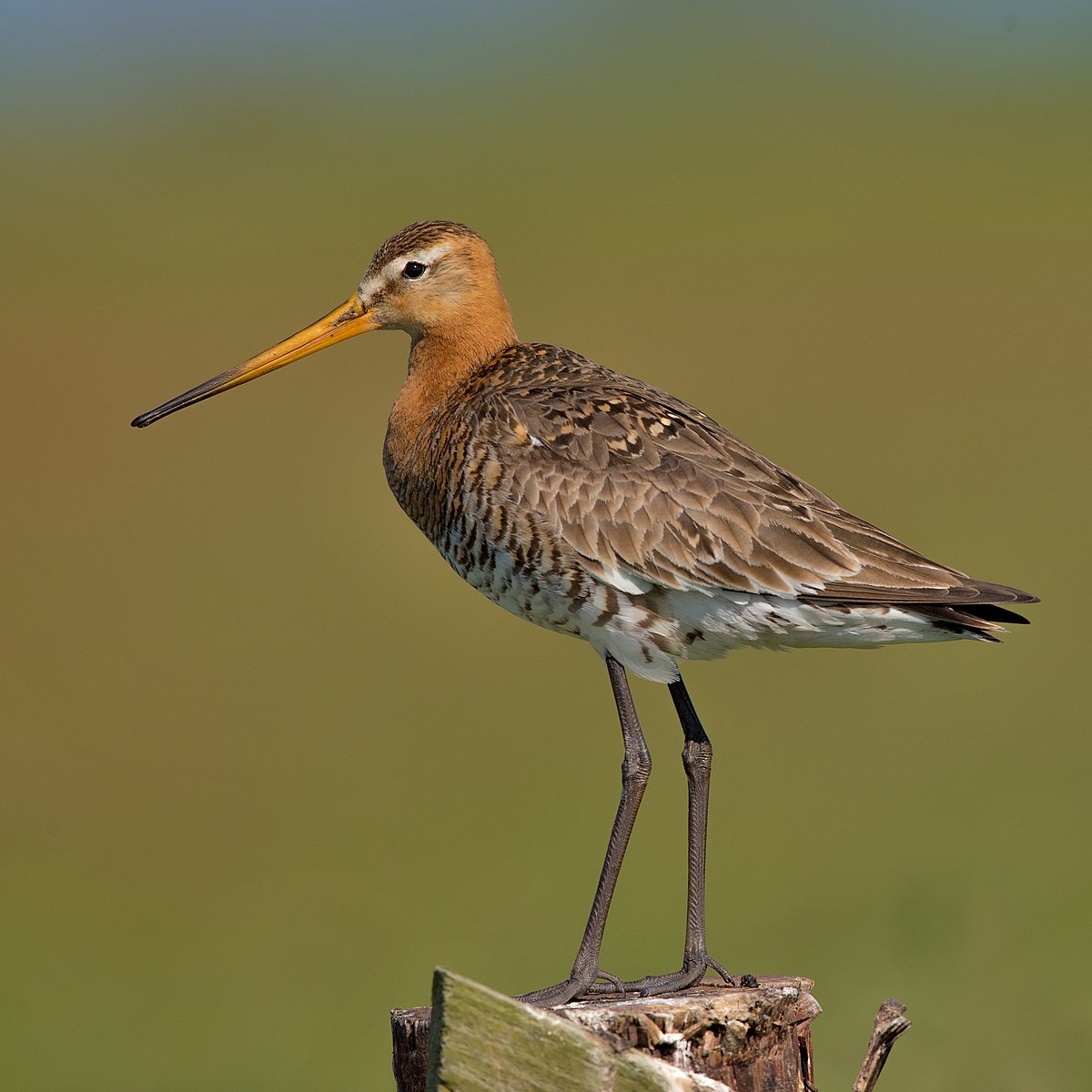
Wikipedia: Black-tailed godwit Source: OTHER
1200px-Black-tailed_Godwit_Uferschnepfe.jpg
This bird appears across the great seas in the following continents:
Europe, North America, Africa, Asia.
![]() The black-tailed godwit (Limosa limosa) is a large, long-legged, long-billed shorebird first described by Carl Linnaeus in 1758. It is a member of the godwit genus, Limosa. There are three subspecies, all with orange head, neck and chest in breeding plumage and dull grey-brown winter coloration, and distinctive black and white wingbar at all times.
[more]
The black-tailed godwit (Limosa limosa) is a large, long-legged, long-billed shorebird first described by Carl Linnaeus in 1758. It is a member of the godwit genus, Limosa. There are three subspecies, all with orange head, neck and chest in breeding plumage and dull grey-brown winter coloration, and distinctive black and white wingbar at all times.
[more]
Habitats:
Wetland
Lesser yellowlegs / Kleiner Gelbschenkel (Tringa flavipes)
Profile Wikipedia eBird Audubon AllAboutBirds Xeno-Canto

Wikipedia: Lesser yellowlegs Source: OTHER
1200px-Lesser_Yellowlegs.jpg
This bird appears across the great seas in the following continents:
North America, South America, Africa.
![]() The lesser yellowlegs (Tringa flavipes) is a medium-sized shorebird. The genus name Tringa is the New Latin name given to the green sandpiper by Aldrovandus in 1599 based on Ancient Greek trungas, a thrush-sized, white-rumped, tail-bobbing wading bird mentioned by Aristotle. The specific flavipes is from Latin flavus, "yellow", and pes, "foot".[2]
[more]
The lesser yellowlegs (Tringa flavipes) is a medium-sized shorebird. The genus name Tringa is the New Latin name given to the green sandpiper by Aldrovandus in 1599 based on Ancient Greek trungas, a thrush-sized, white-rumped, tail-bobbing wading bird mentioned by Aristotle. The specific flavipes is from Latin flavus, "yellow", and pes, "foot".[2]
[more]
Common redshank / Rotschenkel (Tringa totanus)
Profile Wikipedia eBird Vogelwarte BirdLife ZH ornitho.ch Xeno-Canto BirdID NABU
Common redshank plus common pochard. 2022-04-12 14.02.38 Mallorca
First observed in Mallorca on 2022-04-12.
![]() The common redshank or simply redshank (Tringa totanus) is a Eurasian wader in the large family Scolopacidae. The genus name Tringa is the New Latin name given to the green sandpiper by Aldrovandus in 1599 based on Ancient Greek trungas, a thrush-sized, white-rumped, tail-bobbing wading bird mentioned by Aristotle. The specific totanus is from Tótano, the Italian name for this bird.[2]
[more]
The common redshank or simply redshank (Tringa totanus) is a Eurasian wader in the large family Scolopacidae. The genus name Tringa is the New Latin name given to the green sandpiper by Aldrovandus in 1599 based on Ancient Greek trungas, a thrush-sized, white-rumped, tail-bobbing wading bird mentioned by Aristotle. The specific totanus is from Tótano, the Italian name for this bird.[2]
[more]
Vocalization: ![]() Generally a noisy and loud bird, especially at breeding ground. Most heard is a characteristic "tew-hoo", or "tew-hoo-hoo" with first syllable accentuated. No gap between the syllables like Greenshank, and usually with a marked falling pitch. [Link]
Generally a noisy and loud bird, especially at breeding ground. Most heard is a characteristic "tew-hoo", or "tew-hoo-hoo" with first syllable accentuated. No gap between the syllables like Greenshank, and usually with a marked falling pitch. [Link]
Song: ![]() Song similar to Wood Sandpiper, but with three accented notes in each cycle, not two. [Link]
Song similar to Wood Sandpiper, but with three accented notes in each cycle, not two. [Link]
Physical details: length=27-29 cm,
wingspan=59-66 cm,
weight=85-150 g
Habitats:
Wetland
Wood sandpiper / Bruchwasserläufer (Tringa glareola)
Profile Wikipedia eBird Vogelwarte BirdLife ZH ornitho.ch Audubon AllAboutBirds Xeno-Canto BirdID NABU

Wikipedia: Wood sandpiper Source: OTHER
1200px-Wood_Sandpiper_Safari_Park.jpg
First observed in 🇨🇭 on 2021-08-19.
This bird appears across the great seas in the following continents:
Europe, North America, Africa, Asia.
General: ![]() The wood sandpiper (Tringa glareola) is a small wader. This Eurasian species is the smallest of the shanks, which are mid-sized long-legged waders of the family Scolopacidae. The genus name Tringa is the New Latin name given to the green sandpiper by Aldrovandus in 1599 based on Ancient Greek trungas, a thrush-sized, white-rumped, tail-bobbing wading bird mentioned by Aristotle. The specific glareola is from Latin glarea, " gravel".[2]
[more]
The wood sandpiper (Tringa glareola) is a small wader. This Eurasian species is the smallest of the shanks, which are mid-sized long-legged waders of the family Scolopacidae. The genus name Tringa is the New Latin name given to the green sandpiper by Aldrovandus in 1599 based on Ancient Greek trungas, a thrush-sized, white-rumped, tail-bobbing wading bird mentioned by Aristotle. The specific glareola is from Latin glarea, " gravel".[2]
[more]
Vocalization: ![]() Totally different from Green Sandpiper. [Link]
Totally different from Green Sandpiper. [Link]
Calls: ![]() Flight call a soft, but explosive "whiff whiff" , sometimes with only one syllable. Display call similar to redshank but with only two accented beats; a fast melodious "dee-loo", repeated in cycles. [Link]
Flight call a soft, but explosive "whiff whiff" , sometimes with only one syllable. Display call similar to redshank but with only two accented beats; a fast melodious "dee-loo", repeated in cycles. [Link]
Physical details: length=19-21 cm,
wingspan=56-57 cm,
weight=50-80 g
Habitats:
Wetland
Song:
Automatically generated from Xeno-Canto recording
Song attributes:
Frequency:
♫ Source: BirdNet
20210819_082604 birdnet 1940 - Wood Sandpiper, saw a bird flying, check reports in Ornitho - Wood Sandpiper - Uznach.mp3
2021-08-19 08.26.04 Uznach (song)
Spotted redshank / Dunkler Wasserläufer (Tringa erythropus)
Profile Wikipedia eBird Vogelwarte BirdLife ZH ornitho.ch Xeno-Canto BirdID NABU
Dunkler Wasserlaeufer. 2021-10-24 10.25.42 Neeracherried
First observed in 🇨🇭 on 2021-10-24.
General: ![]() The spotted redshank (Tringa erythropus) is a wader (shorebird) in the large bird family Scolopacidae. The genus name Tringa is the New Latin name given to the green sandpiper by Aldrovandus in 1599 based on Ancient Greek trungas, a thrush-sized, white-rumped, tail-bobbing wading bird mentioned by Aristotle. The specific erythropus is from Ancient Greek eruthros, "red", and pous, "foot".[2]
[more]
The spotted redshank (Tringa erythropus) is a wader (shorebird) in the large bird family Scolopacidae. The genus name Tringa is the New Latin name given to the green sandpiper by Aldrovandus in 1599 based on Ancient Greek trungas, a thrush-sized, white-rumped, tail-bobbing wading bird mentioned by Aristotle. The specific erythropus is from Ancient Greek eruthros, "red", and pous, "foot".[2]
[more]
Calls: ![]() Flight call loud and diagnostic, and is often the first sign of the species' presence; a sharp and short, disyllabic "koo-eett", with the first syllable falling in pitch and the second rising sharply. Display call a squeaky, but melodic "krroo-lee-ooo" repeated in cycles. Alarm call a falcon-like "ke-ke-ke-ke". [Link]
Flight call loud and diagnostic, and is often the first sign of the species' presence; a sharp and short, disyllabic "koo-eett", with the first syllable falling in pitch and the second rising sharply. Display call a squeaky, but melodic "krroo-lee-ooo" repeated in cycles. Alarm call a falcon-like "ke-ke-ke-ke". [Link]
Physical details: length=29-31 cm,
wingspan=61-67 cm,
weight=125-210 g
Habitats:
Wetland
Green sandpiper / Waldwasserläufer (Tringa ochropus)
Profile Wikipedia eBird Vogelwarte BirdLife ZH ornitho.ch Xeno-Canto BirdID NABU
Waldwasserlaeufer. 2023-07-08 19.09.34 Neeracherried
First observed in 🇨🇭 on 2022-09-04.
General: ![]() The green sandpiper (Tringa ochropus) is a small wader (shorebird) of the Old World. The genus name Tringa is the New Latin name given to the green sandpiper by Aldrovandus in 1599 based on Ancient Greek trungas, a thrush-sized, white-rumped, tail-bobbing wading bird mentioned by Aristotle. The specific ochropus is from Ancient Greek okhros, "ochre", and pous, "foot".[2]
[more]
The green sandpiper (Tringa ochropus) is a small wader (shorebird) of the Old World. The genus name Tringa is the New Latin name given to the green sandpiper by Aldrovandus in 1599 based on Ancient Greek trungas, a thrush-sized, white-rumped, tail-bobbing wading bird mentioned by Aristotle. The specific ochropus is from Ancient Greek okhros, "ochre", and pous, "foot".[2]
[more]
Vocalization: ![]() Totally different from Wood Sandpiper. [Link]
Totally different from Wood Sandpiper. [Link]
Calls: ![]() Sharp, penetrating calls. Display call a high-pitched "kee-kleeoo-eet", continuously repeated with a wave-like motion in pitch. Other common calls have similar timbre and tone with different phrasing like; "klooeett -klee-klee-klee-klee-klee" and a rising pitch. [Link]
Sharp, penetrating calls. Display call a high-pitched "kee-kleeoo-eet", continuously repeated with a wave-like motion in pitch. Other common calls have similar timbre and tone with different phrasing like; "klooeett -klee-klee-klee-klee-klee" and a rising pitch. [Link]
Physical details: length=21-24 cm,
wingspan=57-61 cm,
weight=60-90 g
Habitats:
Wetland
Marsh sandpiper / Teichwasserläufer (Tringa stagnatilis)
Profile Wikipedia eBird Vogelwarte BirdLife ZH ornitho.ch Xeno-Canto BirdID NABU

Wikipedia: Marsh sandpiper Source: OTHER
1200px-Tringa_stagnatilis_2_-_Laem_Pak_Bia.jpg
General: ![]() The marsh sandpiper (Tringa stagnatilis) is a small wader. It is a rather small shank, and breeds in open grassy steppe and taiga wetlands from easternmost Europe to the Russian Far East. The genus name Tringa is the New Latin name given to the green sandpiper by Aldrovandus in 1599 based on Ancient Greek trungas, a thrush-sized, white-rumped, tail-bobbing wading bird mentioned by Aristotle. The specific stagnatilis is from Latin stagnum, "swamp".[2]
[more]
The marsh sandpiper (Tringa stagnatilis) is a small wader. It is a rather small shank, and breeds in open grassy steppe and taiga wetlands from easternmost Europe to the Russian Far East. The genus name Tringa is the New Latin name given to the green sandpiper by Aldrovandus in 1599 based on Ancient Greek trungas, a thrush-sized, white-rumped, tail-bobbing wading bird mentioned by Aristotle. The specific stagnatilis is from Latin stagnum, "swamp".[2]
[more]
Song: ![]() Song a slow, melancholic whistle "tu-lee-uu", with the middle part highest in pitch (and with falling glissando). Similar to Spotted Redshank in structure, but with a clear tone (little risk of confusion). [Link]
Song a slow, melancholic whistle "tu-lee-uu", with the middle part highest in pitch (and with falling glissando). Similar to Spotted Redshank in structure, but with a clear tone (little risk of confusion). [Link]
Calls: ![]() Flight call/contact call similar to singular instances of alarm call of Redshank, consisting of a single note rising abruptly in pitch in a split second and then falling; "kieew". Lingers a bit at the ending of the note, giving it a clearer glissando than in Redshank. [Link]
Flight call/contact call similar to singular instances of alarm call of Redshank, consisting of a single note rising abruptly in pitch in a split second and then falling; "kieew". Lingers a bit at the ending of the note, giving it a clearer glissando than in Redshank. [Link]
Physical details: length=22-24 cm,
wingspan=55-59 cm,
weight=50-85 g
Common greenshank / Grünschenkel (Tringa nebularia)
Profile Wikipedia eBird Vogelwarte BirdLife ZH ornitho.ch Audubon AllAboutBirds Xeno-Canto BirdID NABU
MerlinBirdID says common greenshank, probably non-breeding adult. 2022-04-12 14.52.08 Mallorca
First observed in Mallorca on 2022-04-12.
This bird appears across the great seas in the following continents:
Europe, North America, Africa, Asia.
General: ![]() The common greenshank (Tringa nebularia) is a wader in the large family Scolopacidae, the typical waders. The genus name Tringa is the New Latin name given to the green sandpiper by Aldrovandus in 1599 based on Ancient Greek trungas, a thrush-sized, white-rumped, tail-bobbing wading bird mentioned by Aristotle. The specific nebularia is from Latin nebula "mist". Like the Norwegian Skoddefoll, this refers to the greenshank's damp marshy habitat.[2]
[more]
The common greenshank (Tringa nebularia) is a wader in the large family Scolopacidae, the typical waders. The genus name Tringa is the New Latin name given to the green sandpiper by Aldrovandus in 1599 based on Ancient Greek trungas, a thrush-sized, white-rumped, tail-bobbing wading bird mentioned by Aristotle. The specific nebularia is from Latin nebula "mist". Like the Norwegian Skoddefoll, this refers to the greenshank's damp marshy habitat.[2]
[more]
Vocalization: ![]() Most heard is a characteristic, trisyllabic "tew-tew-tew" (sometimes two or four syllables). Can resemble redshank, but pitch more stable, and not falling notably. Each syllable is clearly separated and equally emphasized. [Link]
Most heard is a characteristic, trisyllabic "tew-tew-tew" (sometimes two or four syllables). Can resemble redshank, but pitch more stable, and not falling notably. Each syllable is clearly separated and equally emphasized. [Link]
Song: ![]() Song a clear disyllabic "cloo-eeee", repeated in cycles but each phrase clearly separated. At close range a short creaky sound is audible (between each phrase). Redshank may sing in a slightly similar way, but in continuous, linked phrases. [Link]
Song a clear disyllabic "cloo-eeee", repeated in cycles but each phrase clearly separated. At close range a short creaky sound is audible (between each phrase). Redshank may sing in a slightly similar way, but in continuous, linked phrases. [Link]
Physical details: length=30-33 cm,
wingspan=68-70 cm,
weight=130-270 g
Habitats:
Wetland
Terek sandpiper / Terekwasserläufer (Xenus cinereus)
Profile Wikipedia eBird Audubon AllAboutBirds Xeno-Canto NABU

Wikipedia: Terek sandpiper Source: OTHER
Xenus_cinereus_%28Alnus%29.jpg
This bird appears across the great seas in the following continents:
Europe, North America, Africa, Asia.
General: ![]() The Terek sandpiper (Xenus cinereus) is a small migratory Palearctic wader species and is the only member of the genus Xenus. It is named after the Terek River which flows into the west of the Caspian Sea, as it was first observed around this area.[2] The genus name Xenus is from Ancient Greek xenos stranger, and cinereus is Latin for "ash-grey" from cinis, cineris, "ashes".[3]
[more]
The Terek sandpiper (Xenus cinereus) is a small migratory Palearctic wader species and is the only member of the genus Xenus. It is named after the Terek River which flows into the west of the Caspian Sea, as it was first observed around this area.[2] The genus name Xenus is from Ancient Greek xenos stranger, and cinereus is Latin for "ash-grey" from cinis, cineris, "ashes".[3]
[more]
Common sandpiper / Flussuferläufer (Actitis hypoleucos)
MerlinBirdID meint Flussuferläufer. 2022-09-04 07.49.06 Neeracherried
First observed in 🇨🇭 on 2022-09-04.
This bird appears across the great seas in the following continents:
Europe, North America, Africa, Asia.
![]() The common sandpiper (Actitis hypoleucos) is a small Palearctic wader. This bird and its American sister species, the spotted sandpiper (A. macularia), make up the genus Actitis. They are parapatric and replace each other geographically; stray birds of either species may settle down with breeders of the other and hybridize. Hybridization has also been reported between the common sandpiper and the green sandpiper, a basal species of the closely related shank genus Tringa.
[more]
The common sandpiper (Actitis hypoleucos) is a small Palearctic wader. This bird and its American sister species, the spotted sandpiper (A. macularia), make up the genus Actitis. They are parapatric and replace each other geographically; stray birds of either species may settle down with breeders of the other and hybridize. Hybridization has also been reported between the common sandpiper and the green sandpiper, a basal species of the closely related shank genus Tringa.
[more]
Calls: ![]() Very vocal with characteristic repertoire of very high-pitched calls. Often heard is a disyllabic call, drawn out and slightly rising in pitch in the second part. This is often repeated in a series of rising tones in a cyclic manner, with approx 5 tones in each cycle. [Link]
Very vocal with characteristic repertoire of very high-pitched calls. Often heard is a disyllabic call, drawn out and slightly rising in pitch in the second part. This is often repeated in a series of rising tones in a cyclic manner, with approx 5 tones in each cycle. [Link]
Physical details: length=19-21 cm,
wingspan=38-41 cm,
weight=40-60 g
Habitats:
Wetland
Red phalarope / Thorshühnchen (Phalaropus fulicarius)

Wikipedia: Red phalarope Source: OTHER
1200px-Phalaropus_fulicarius_10.jpg
This bird appears across the great seas in the following continents:
Europe, North America, South America, Africa.
General: ![]() The red phalarope or grey phalarope (Phalaropus fulicarius) is a small wader. This phalarope breeds in the Arctic regions of North America and Eurasia. It is migratory, and, unusually for a wader, migrating mainly on oceanic routes and wintering at sea on tropical oceans.
[more]
The red phalarope or grey phalarope (Phalaropus fulicarius) is a small wader. This phalarope breeds in the Arctic regions of North America and Eurasia. It is migratory, and, unusually for a wader, migrating mainly on oceanic routes and wintering at sea on tropical oceans.
[more]
Calls: ![]() Flight-call a short and sharp, Coot-like "kit". Cleaner and higher pitched than Red-necked Phalarope. Display sound a rolling cooing, at stable pitch. Other calls: a hissing like the squeezing of a rubber duck, rising quickly in pitch and ending abruptly. [Link]
Flight-call a short and sharp, Coot-like "kit". Cleaner and higher pitched than Red-necked Phalarope. Display sound a rolling cooing, at stable pitch. Other calls: a hissing like the squeezing of a rubber duck, rising quickly in pitch and ending abruptly. [Link]
Physical details: length=20-22 cm,
wingspan=40-44 cm,
weight=40-75 g
Wilson's phalarope / Wilson-Wassertreter (Phalaropus tricolor)
Profile Wikipedia eBird Audubon AllAboutBirds Xeno-Canto
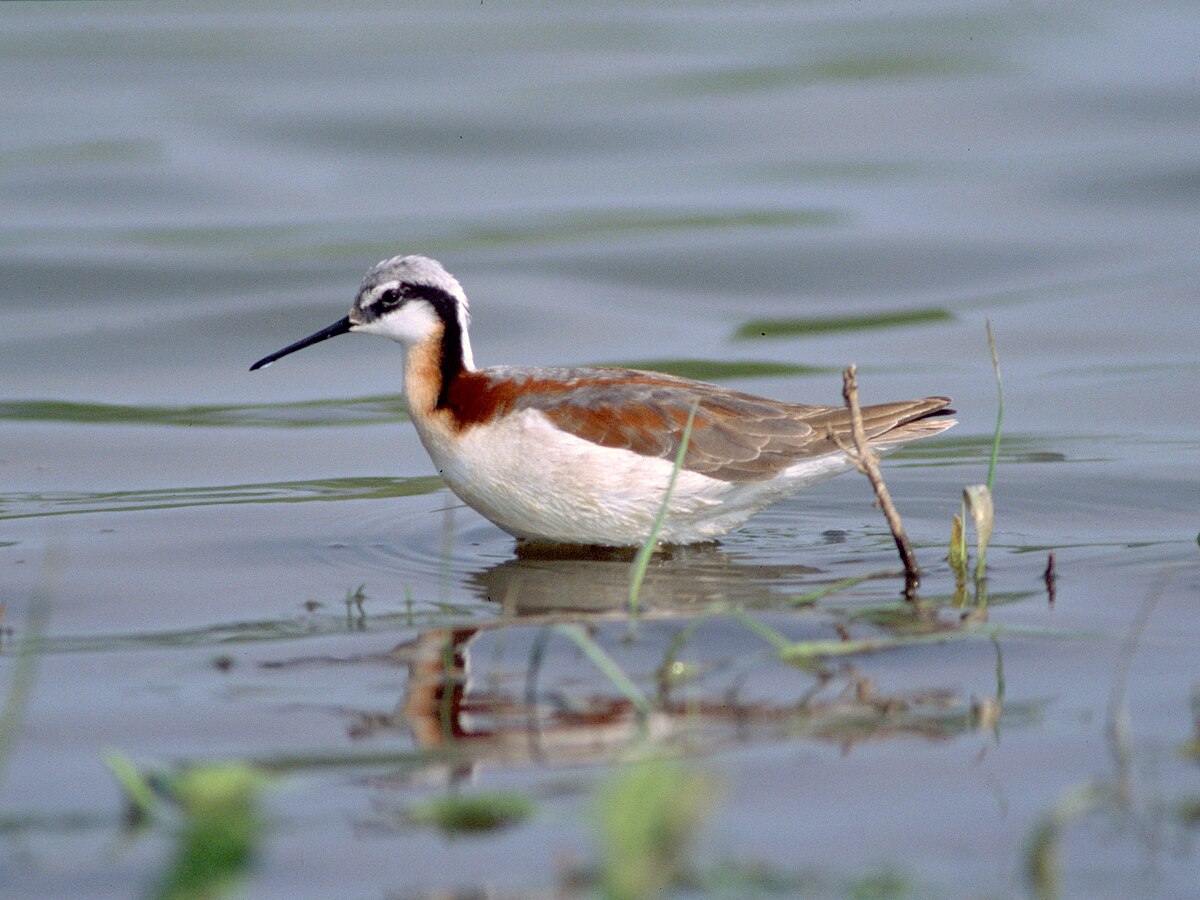
Wikipedia: Wilson's phalarope Source: OTHER
1200px-Phalaropus_tricolor_-_breeding_female.jpg
This bird appears across the great seas in the following continents:
North America, South America, Africa.
General: ![]() Wilson's phalarope (Phalaropus tricolor) is a small wader. This bird, the largest of the phalaropes, breeds in the prairies of North America in western Canada and the western United States. It is migratory, wintering in inland salt lakes near the Andes in Argentina.[2] They are passage migrants through Central America around March/April and again during September/October.[3] The species is a rare vagrant to western Europe.
[more]
Wilson's phalarope (Phalaropus tricolor) is a small wader. This bird, the largest of the phalaropes, breeds in the prairies of North America in western Canada and the western United States. It is migratory, wintering in inland salt lakes near the Andes in Argentina.[2] They are passage migrants through Central America around March/April and again during September/October.[3] The species is a rare vagrant to western Europe.
[more]
Red-necked phalarope / Odinshühnchen (Phalaropus lobatus)
Profile Wikipedia eBird Audubon AllAboutBirds Xeno-Canto NABU
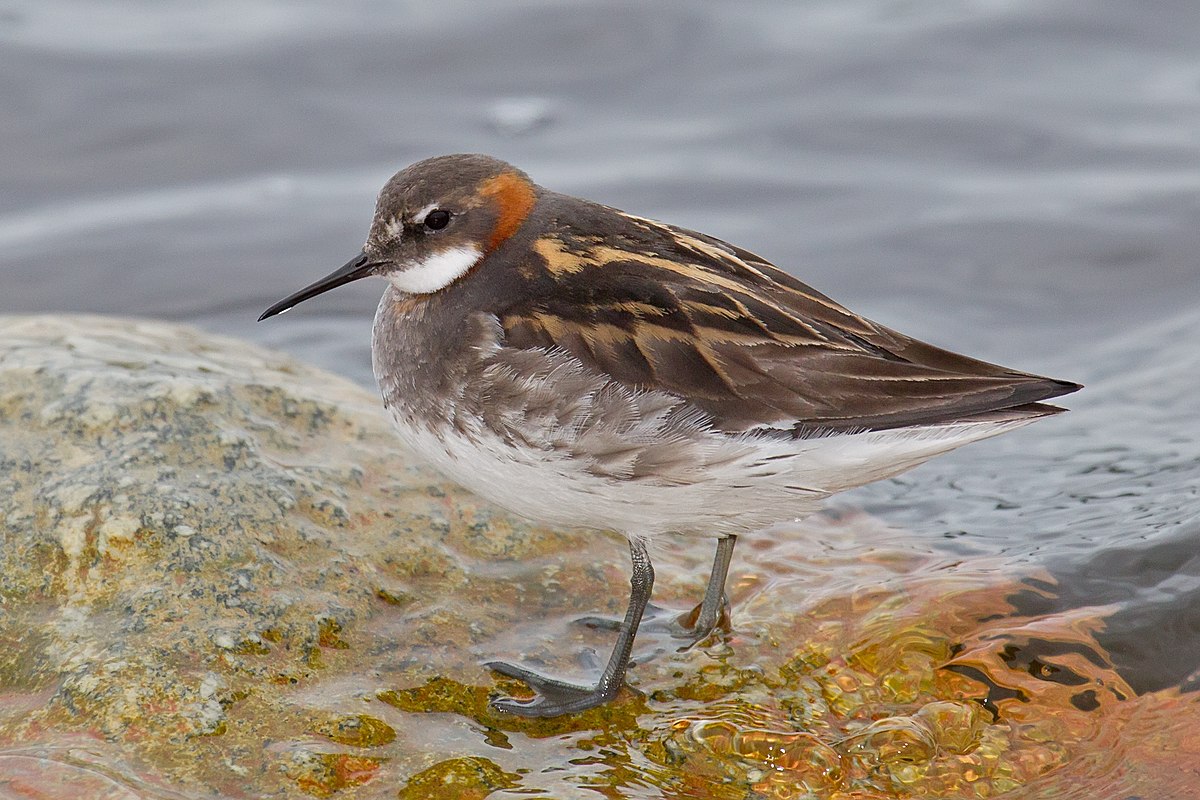
Wikipedia: Red-necked phalarope Source: OTHER
1200px-Red-necked_Phalarope.jpg
This bird appears across the great seas in the following continents:
Europe, North America, South America, Africa, Asia.
![]() The red-necked phalarope (Phalaropus lobatus), also known as the northern phalarope and hyperborean phalarope,[2] is a small wader. This phalarope breeds in the Arctic regions of North America and Eurasia. It is migratory, and, unusually for a wader, winters at sea on tropical oceans.
[more]
The red-necked phalarope (Phalaropus lobatus), also known as the northern phalarope and hyperborean phalarope,[2] is a small wader. This phalarope breeds in the Arctic regions of North America and Eurasia. It is migratory, and, unusually for a wader, winters at sea on tropical oceans.
[more]
Black-naped tern / Schwarznacken-Seeschwalbe (Sterna sumatrana)
Profile Wikipedia eBird Xeno-Canto
Wikipedia: Black-naped tern Source: OTHER
Black-naped_Tern_LEI.JPG
![]() The black-naped tern (Sterna sumatrana) is an oceanic tern mostly found in tropical and subtropical areas of the Pacific and Indian Oceans. It is rarely found inland.
[more]
The black-naped tern (Sterna sumatrana) is an oceanic tern mostly found in tropical and subtropical areas of the Pacific and Indian Oceans. It is rarely found inland.
[more]
White-cheeked tern / Weißwangenseeschwalbe (Sterna repressa)
Profile Wikipedia eBird Xeno-Canto

Wikipedia: White-cheeked tern Source: OTHER
1200px-White-cheeked_Tern.jpg
![]() The white-cheeked tern (Sterna repressa) is a species of tern in the family Laridae.
It is found around the coasts on the Red Sea, around the Horn of Africa to Kenya, in the Persian Gulf and along the Iranian coast to Pakistan and western India.[2]
[more]
The white-cheeked tern (Sterna repressa) is a species of tern in the family Laridae.
It is found around the coasts on the Red Sea, around the Horn of Africa to Kenya, in the Persian Gulf and along the Iranian coast to Pakistan and western India.[2]
[more]
Roseate tern / Rosenseeschwalbe (Sterna dougallii)
Profile Wikipedia eBird Audubon AllAboutBirds Xeno-Canto BirdID NABU

Wikipedia: Roseate tern Source: OTHER
1200px-Roseate_terns_Palometas.jpg
This bird appears across the great seas in the following continents:
Europe, North America, Africa, Asia.
![]() The roseate tern (Sterna dougallii) is a tern in the family Laridae. The genus name Sterna is derived from Old English "stearn", "tern",[2] and the specific dougallii refers to Scottish physician and collector Dr Peter McDougall (1777–1814).[3] "Roseate" refers to the bird's pink breast in breeding plumage.[4]
[more]
The roseate tern (Sterna dougallii) is a tern in the family Laridae. The genus name Sterna is derived from Old English "stearn", "tern",[2] and the specific dougallii refers to Scottish physician and collector Dr Peter McDougall (1777–1814).[3] "Roseate" refers to the bird's pink breast in breeding plumage.[4]
[more]
Calls: ![]() Extremely harsh calls. Like mix of Caspian and Arctic Tern. Very hard and raspy "kreeeet", harder and higher pitched than Caspian Tern, but equally harsh. Other calls include more Arctic/Common tern-like short "kek", and similar. [Link]
Extremely harsh calls. Like mix of Caspian and Arctic Tern. Very hard and raspy "kreeeet", harder and higher pitched than Caspian Tern, but equally harsh. Other calls include more Arctic/Common tern-like short "kek", and similar. [Link]
Physical details: length=33-38 cm,
wingspan=72-80 cm,
weight=92-133 g
Arctic tern / Kü̈stenseeschwalbe (Sterna paradisaea)
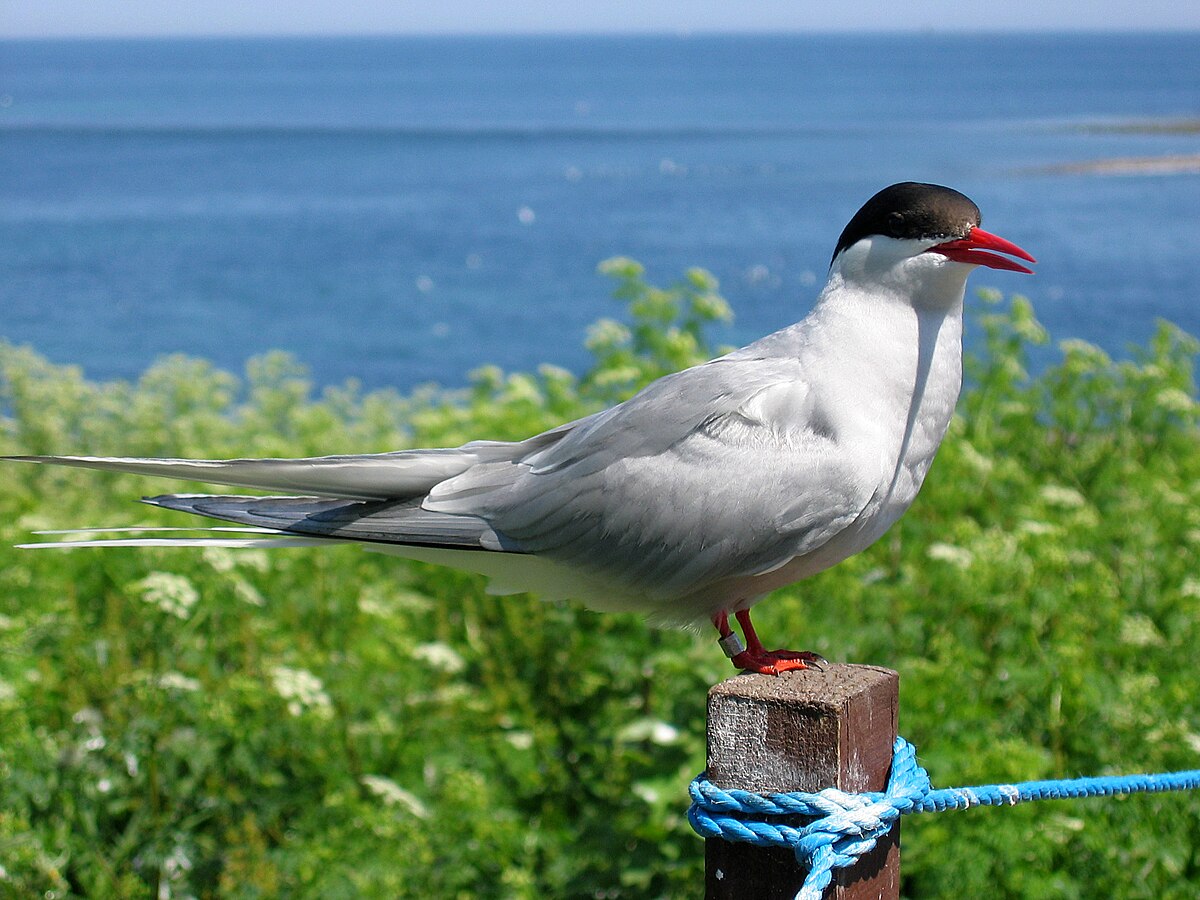
Wikipedia: Arctic tern Source: OTHER
1200px-2009_07_02_-_Arctic_tern_on_Farne_Islands_-_The_blue_rope_demarcates_the_visitors%27_path.JPG
This bird appears across the great seas in the following continents:
Europe, North America, South America, Africa.
General: ![]() The Arctic tern (Sterna paradisaea) is a tern in the family Laridae. This bird has a circumpolar breeding distribution covering the Arctic and sub-Arctic regions of Europe, Asia, and North America (as far south as Brittany and Massachusetts). The species is strongly migratory, seeing two summers each year as it migrates along a convoluted route from its northern breeding grounds to the Antarctic coast for the southern summer and back again about six months later. Recent studies have shown average annual roundtrip lengths of about 70,900 km (44,100 mi) for birds nesting in Iceland and Greenland[3] and about 90,000 km (56,000 mi) for birds nesting in the Netherlands.[4] These are by far the longest migrations known in the animal kingdom. The Arctic tern flies as well as glides through the air. It nests once every one to three years (depending on its mating cycle); once it has finished nesting it takes to the sky for another long southern migration.
[more]
The Arctic tern (Sterna paradisaea) is a tern in the family Laridae. This bird has a circumpolar breeding distribution covering the Arctic and sub-Arctic regions of Europe, Asia, and North America (as far south as Brittany and Massachusetts). The species is strongly migratory, seeing two summers each year as it migrates along a convoluted route from its northern breeding grounds to the Antarctic coast for the southern summer and back again about six months later. Recent studies have shown average annual roundtrip lengths of about 70,900 km (44,100 mi) for birds nesting in Iceland and Greenland[3] and about 90,000 km (56,000 mi) for birds nesting in the Netherlands.[4] These are by far the longest migrations known in the animal kingdom. The Arctic tern flies as well as glides through the air. It nests once every one to three years (depending on its mating cycle); once it has finished nesting it takes to the sky for another long southern migration.
[more]
Vocalization: ![]() Similar to Common Tern but higher pitched. [Link]
Similar to Common Tern but higher pitched. [Link]
Calls: ![]() Typical call a series of high pitched "tip-tip-tip", and longer, ringing, high-pitched "kriiiiii" calls. The drawn out "kree-aaahh" call falls less distinctly in pitch than Common Tern. [Link]
Typical call a series of high pitched "tip-tip-tip", and longer, ringing, high-pitched "kriiiiii" calls. The drawn out "kree-aaahh" call falls less distinctly in pitch than Common Tern. [Link]
Physical details: length=33-35 cm,
wingspan=75-85 cm,
weight=95-120 g
Antarctic tern (Sterna vittata)
Profile Wikipedia eBird Xeno-Canto

Wikipedia: Antarctic tern Source: OTHER
1200px-Sterna_vittata_-_Antarctica_I.jpg
General: ![]() The Antarctic tern (Sterna vittata) is a seabird in the family Laridae. It ranges throughout the southern oceans and is found on small islands around Antarctica as well as on the shores of the mainland. Its diet consists primarily of small fish and crustaceans. It is very similar in appearance to the closely related Arctic tern, but it is stockier, and it is in its breeding plumage in the southern summer, when the Arctic tern has shed old feathers to get its non-breeding plumage. The Antarctic tern does not migrate like the Arctic tern does, but it can still be found on a very large range. This tern species is actually more closely related to the South American tern.[2]
[more]
The Antarctic tern (Sterna vittata) is a seabird in the family Laridae. It ranges throughout the southern oceans and is found on small islands around Antarctica as well as on the shores of the mainland. Its diet consists primarily of small fish and crustaceans. It is very similar in appearance to the closely related Arctic tern, but it is stockier, and it is in its breeding plumage in the southern summer, when the Arctic tern has shed old feathers to get its non-breeding plumage. The Antarctic tern does not migrate like the Arctic tern does, but it can still be found on a very large range. This tern species is actually more closely related to the South American tern.[2]
[more]
Black-rumped buttonquail (Turnix nanus)
Profile Wikipedia eBird Xeno-Canto

Wikipedia: Black-rumped buttonquail Source: OTHER
1200px-TurnixNanaDavies.jpg
![]() The black-rumped buttonquail (Turnix nanus) is a small species of bird in the buttonquail genus.
[more]
The black-rumped buttonquail (Turnix nanus) is a small species of bird in the buttonquail genus.
[more]
African oystercatcher (Haematopus moquini)
Wikipedia: African oystercatcher Source: OTHER
African_Black_Oystercatcher_%282%29.JPG
![]() The African oystercatcher or African black oystercatcher (Haematopus moquini), is a large charismatic wader resident to the mainland coasts and offshore islands of southern Africa. This near-threatened oystercatcher has a population of over 6,000 adults, which breed between November and April.[9] The scientific name moquini commemorates the French naturalist Alfred Moquin-Tandon who discovered and named this species before Bonaparte.[10]
[more]
The African oystercatcher or African black oystercatcher (Haematopus moquini), is a large charismatic wader resident to the mainland coasts and offshore islands of southern Africa. This near-threatened oystercatcher has a population of over 6,000 adults, which breed between November and April.[9] The scientific name moquini commemorates the French naturalist Alfred Moquin-Tandon who discovered and named this species before Bonaparte.[10]
[more]
Collared pratincole / Rotflügel-Brachschwalbe (Glareola pratincola)
Profile Wikipedia eBird Xeno-Canto BirdID NABU

Wikipedia: Collared pratincole Source: OTHER
1200px-Collared_pratincole_%28Glareola_pratincola%29.jpg
![]() The collared pratincole (Glareola pratincola), also known as the common pratincole or red-winged pratincole, is a wader in the pratincole family, Glareolidae. As with other pratincoles, it is native to the Old World.[2]
[more]
The collared pratincole (Glareola pratincola), also known as the common pratincole or red-winged pratincole, is a wader in the pratincole family, Glareolidae. As with other pratincoles, it is native to the Old World.[2]
[more]
Vocalization: ![]() Quite vocal. [Link]
Quite vocal. [Link]
Calls: ![]() Nasal tern-like, far-carrying calls often betrays its presence before it is seen. Short and sharp "kiev" or "kip" frequently used. Most diagnostic call is a two-part, rolling "kivik-kirrrrrrr", with the latter part slightly descending. Easily confused with Black-winged Pratincole, but the hard parts are more resonant, and less clicking and staccato, while the more melodic components are less mewing. Also quite similar to Little Tern in timbre, but the two-part structure in the diagnostic call is different. [Link]
Nasal tern-like, far-carrying calls often betrays its presence before it is seen. Short and sharp "kiev" or "kip" frequently used. Most diagnostic call is a two-part, rolling "kivik-kirrrrrrr", with the latter part slightly descending. Easily confused with Black-winged Pratincole, but the hard parts are more resonant, and less clicking and staccato, while the more melodic components are less mewing. Also quite similar to Little Tern in timbre, but the two-part structure in the diagnostic call is different. [Link]
Physical details: length=25 cm,
wingspan=60-65 cm,
weight=70-95 g
Rock pratincole / Halsband-Brachschwalbe (Glareola nuchalis)
Profile Wikipedia eBird Xeno-Canto

Wikipedia: Rock pratincole Source: OTHER
Rock_Pratincole_%28Glareola_nuchalis%29.jpg
General: ![]() The rock pratincole (Glareola nuchalis) is a species of bird in the family Glareolidae.
[more]
The rock pratincole (Glareola nuchalis) is a species of bird in the family Glareolidae.
[more]
Black-winged pratincole / Schwarzflügel-Brachschwalbe (Glareola nordmanni)
Profile Wikipedia eBird Xeno-Canto

Wikipedia: Black-winged pratincole Source: OTHER
Tyrkyshka.jpg
![]() The black-winged pratincole (Glareola nordmanni) is a wader in the pratincole bird family, Glareolidae. The genus name is a diminutive of Latin glarea, "gravel", referring to a typical nesting habitat for pratincoles. The species name commemorates the Finnish-born zoologist and explorer Alexander von Nordmann.[2]
[more]
The black-winged pratincole (Glareola nordmanni) is a wader in the pratincole bird family, Glareolidae. The genus name is a diminutive of Latin glarea, "gravel", referring to a typical nesting habitat for pratincoles. The species name commemorates the Finnish-born zoologist and explorer Alexander von Nordmann.[2]
[more]
Burchell's courser (Cursorius rufus)
Profile Wikipedia eBird Xeno-Canto

Wikipedia: Burchell's courser Source: OTHER
Cursorius_rufus00a.jpg
![]() Burchell's courser (Cursorius rufus) is a wader in the pratincole and courser family, Glareolidae.[2] The name of this bird commemorates the English naturalist William John Burchell.[3]
[more]
Burchell's courser (Cursorius rufus) is a wader in the pratincole and courser family, Glareolidae.[2] The name of this bird commemorates the English naturalist William John Burchell.[3]
[more]
Temminck's courser (Cursorius temminckii)
Profile Wikipedia eBird Xeno-Canto

Wikipedia: Temminck's courser Source: OTHER
1200px-Temminck%27s_courser_-_Cursorius_temminckii.jpg
![]() Temminck's courser (Cursorius temminckii) is a bird in the pratincole and courser family, Glareolidae. It is a wader which lives in sub-Saharan Africa. It is noted for laying its dark colored ash-black eggs in the burnt bushes and grass of the African savannah.[2][3][4]
[more]
Temminck's courser (Cursorius temminckii) is a bird in the pratincole and courser family, Glareolidae. It is a wader which lives in sub-Saharan Africa. It is noted for laying its dark colored ash-black eggs in the burnt bushes and grass of the African savannah.[2][3][4]
[more]
Bronze-winged courser (Rhinoptilus chalcopterus)
Profile Wikipedia eBird Xeno-Canto

Wikipedia: Bronze-winged courser Source: OTHER
1200px-Bronze-winged_Courser_%28Rhinoptilus_chalcopterus%29_%2813950665425%29.jpg
![]() The bronze-winged courser or violet-tipped courser (Rhinoptilus chalcopterus) is a species of bird in the family Glareolidae. It is found throughout Sub-Saharan Africa.
[more]
The bronze-winged courser or violet-tipped courser (Rhinoptilus chalcopterus) is a species of bird in the family Glareolidae. It is found throughout Sub-Saharan Africa.
[more]
Three-banded courser (Rhinoptilus cinctus)
Profile Wikipedia eBird Xeno-Canto

Wikipedia: Three-banded courser Source: OTHER
Three-banded_%28_Heuglin%27s_%29_Courser.jpg
![]() The three-banded courser (Rhinoptilus cinctus) is a species of bird in the family Glareolidae.
It is found in Angola, Botswana, Ethiopia, Kenya, Namibia, Rwanda, Somalia, Somaliland, South Africa, South Sudan, Tanzania, Uganda, Zambia, and Zimbabwe.
[more]
The three-banded courser (Rhinoptilus cinctus) is a species of bird in the family Glareolidae.
It is found in Angola, Botswana, Ethiopia, Kenya, Namibia, Rwanda, Somalia, Somaliland, South Africa, South Sudan, Tanzania, Uganda, Zambia, and Zimbabwe.
[more]
South polar skua / Südpolarskua (Stercorarius maccormicki)

Wikipedia: South polar skua Source: OTHER
1200px-South_polar_skua.jpg
This bird appears across the great seas in the following continents:
North America, Africa.
![]() The south polar skua (Stercorarius maccormicki) is a large seabird in the skua family, Stercorariidae. An older name for the bird is MacCormick's skua, after explorer and naval surgeon Robert McCormick, who first collected the type specimen. This species and the other large Southern Hemisphere skuas, such as the great skua, are sometimes placed in a separate genus Catharacta.
[more]
The south polar skua (Stercorarius maccormicki) is a large seabird in the skua family, Stercorariidae. An older name for the bird is MacCormick's skua, after explorer and naval surgeon Robert McCormick, who first collected the type specimen. This species and the other large Southern Hemisphere skuas, such as the great skua, are sometimes placed in a separate genus Catharacta.
[more]
Pomarine jaeger / Spatelraubmöwe (Stercorarius pomarinus)
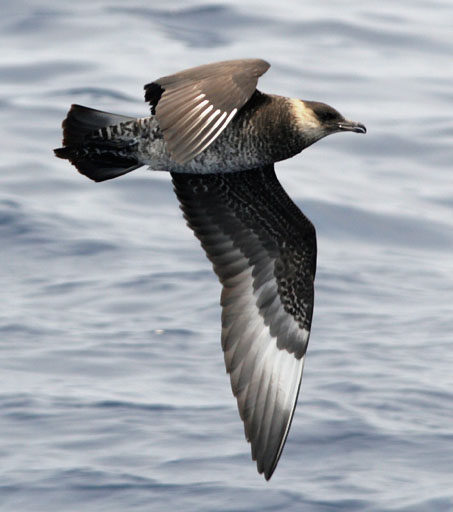
Wikipedia: Pomarine jaeger Source: OTHER
Stercorarius_pomarinusPCCA20070623-3985B.jpg
This bird appears across the great seas in the following continents:
Europe, North America, South America, Africa, Asia.
![]() The pomarine jaeger (Stercorarius pomarinus), pomarine skua, or pomatorhine skua,[2] is a seabird in the skua family Stercorariidae. It is a migrant, wintering at sea in the tropical oceans.
[more]
The pomarine jaeger (Stercorarius pomarinus), pomarine skua, or pomatorhine skua,[2] is a seabird in the skua family Stercorariidae. It is a migrant, wintering at sea in the tropical oceans.
[more]
Calls: ![]() Short "kea" or "ke", and various mewing calls, usually deeper pitched than Arctic Skua. Also a characteristic, laughing and vibrating "kayayayayaya", heard mostly on breeding ground. [Link]
Short "kea" or "ke", and various mewing calls, usually deeper pitched than Arctic Skua. Also a characteristic, laughing and vibrating "kayayayayaya", heard mostly on breeding ground. [Link]
Physical details: length=46-51 cm,
wingspan=125-138 cm,
weight=600-900 g
Long-tailed jaeger / Falkenraubmöwe (Stercorarius longicaudus)

Wikipedia: Long-tailed jaeger Source: OTHER
1200px-Long-tailed_Skua_%28js%29_26.jpg
This bird appears across the great seas in the following continents:
Europe, North America, Africa, Asia.
General: ![]() The long-tailed skua or long-tailed jaeger (Stercorarius longicaudus) is a seabird in the skua family Stercorariidae.
[more]
The long-tailed skua or long-tailed jaeger (Stercorarius longicaudus) is a seabird in the skua family Stercorariidae.
[more]
Southern skua (Stercorarius antarcticus)
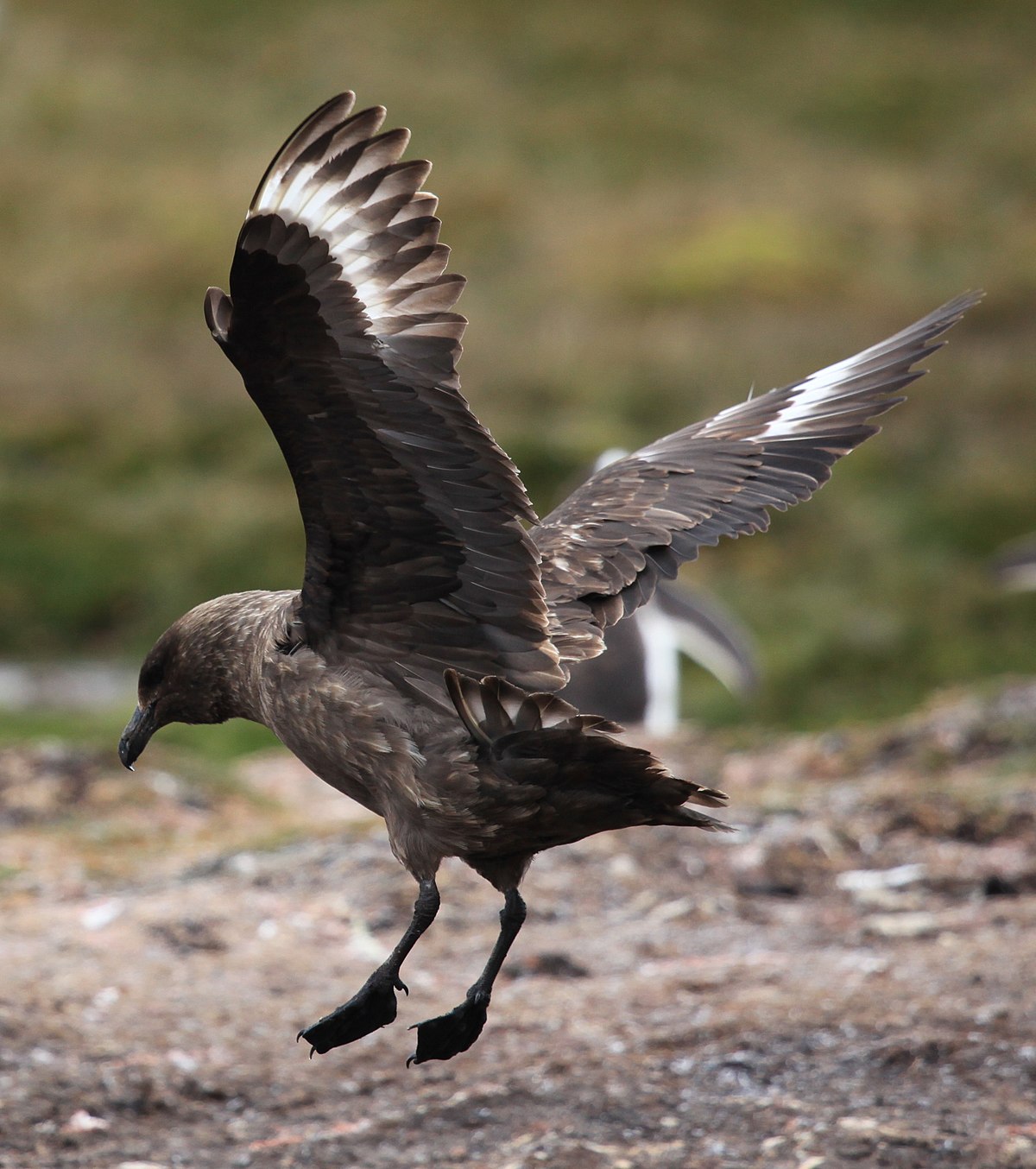
Wikipedia: Southern skua Source: OTHER
1200px-Stercorarius_antarcticus_-Godthul%2C_South_Georgia%2C_British_Overseas_Territories%2C_UK_-landing-8.jpg
![]() The brown skua (Stercorarius antarcticus), also known as the Antarctic skua, subantarctic skua, southern great skua, southern skua, or hākoakoa (Māori), is a large seabird that breeds in the subantarctic and Antarctic zones and moves further north when not breeding. Its taxonomy is highly complex and a matter of dispute, with some splitting it into two or three species: Falkland skua (S. antarcticus), Tristan skua (S. hamiltoni), and subantarctic skua (S. lönnbergi). To further confuse, it hybridizes with both the south polar and Chilean skuas, and the entire group has been considered to be a subspecies of the great skua, a species otherwise restricted to the Northern Hemisphere.
[more]
The brown skua (Stercorarius antarcticus), also known as the Antarctic skua, subantarctic skua, southern great skua, southern skua, or hākoakoa (Māori), is a large seabird that breeds in the subantarctic and Antarctic zones and moves further north when not breeding. Its taxonomy is highly complex and a matter of dispute, with some splitting it into two or three species: Falkland skua (S. antarcticus), Tristan skua (S. hamiltoni), and subantarctic skua (S. lönnbergi). To further confuse, it hybridizes with both the south polar and Chilean skuas, and the entire group has been considered to be a subspecies of the great skua, a species otherwise restricted to the Northern Hemisphere.
[more]
Parasitic jaeger / Schmarotzerraubmöwe (Stercorarius parasiticus)
Our guide raises his arm, which results in the Arctic Skua keeping a safe distance. 2015-06-10 15.13.04 Iceland
First observed in Iceland on 2015-06-10.
This bird appears across the great seas in the following continents:
Europe, North America, South America, Africa, Asia.
![]() The parasitic jaeger (Stercorarius parasiticus), also known as the Arctic skua, Arctic jaeger or parasitic skua, is a seabird in the skua family Stercorariidae. The word "jaeger" is derived from the German word Jäger, meaning "hunter".[2] The English "skua" comes from the Faroese name skúgvur [ˈskɪkvʊər] for the great skua, with the island of Skúvoy known for its colony of that bird. The general Faroese term for skuas is kjógvi [ˈtʃɛkvə].[3] The genus name Stercorarius is Latin and means "of dung"; the food disgorged by other birds when pursued by skuas was once thought to be excrement. The specific parasiticus is from Latin and means "parasitic".[4]
[more]
The parasitic jaeger (Stercorarius parasiticus), also known as the Arctic skua, Arctic jaeger or parasitic skua, is a seabird in the skua family Stercorariidae. The word "jaeger" is derived from the German word Jäger, meaning "hunter".[2] The English "skua" comes from the Faroese name skúgvur [ˈskɪkvʊər] for the great skua, with the island of Skúvoy known for its colony of that bird. The general Faroese term for skuas is kjógvi [ˈtʃɛkvə].[3] The genus name Stercorarius is Latin and means "of dung"; the food disgorged by other birds when pursued by skuas was once thought to be excrement. The specific parasiticus is from Latin and means "parasitic".[4]
[more]
Vocalization: ![]() Mostly heard at breeding ground. [Link]
Mostly heard at breeding ground. [Link]
Calls: ![]() Most characteristic call is a mewing, kittiwake-like "aeeeee-ah". First syllable drawn-out and rising in pitch, and followed by a deeper conclusive second syllable "ah". Lacks the introductory double accent of Kittiwakes ("kitti-wake"). [Link]
Most characteristic call is a mewing, kittiwake-like "aeeeee-ah". First syllable drawn-out and rising in pitch, and followed by a deeper conclusive second syllable "ah". Lacks the introductory double accent of Kittiwakes ("kitti-wake"). [Link]
Physical details: length=41-46 cm,
wingspan=110-125 cm,
weight=330-570 g
African jacana / Blaustirn-Blatthühnchen (Actophilornis africanus)

Wikipedia: African jacana Source: OTHER
1200px-African_jacana_%28Actophilornis_africanus%29_Kenya.jpg
General: ![]() The African jacana (Actophilornis africanus) is a wader in the family Jacanidae, identifiable by long toes and long claws that enable them to walk on floating vegetation in shallow lakes, their preferred habitat. Jacanas are found worldwide within the tropical zone, and this species is found in sub-saharan Africa. For the origin and pronunciation of the name, see Jacanidae.
[more]
The African jacana (Actophilornis africanus) is a wader in the family Jacanidae, identifiable by long toes and long claws that enable them to walk on floating vegetation in shallow lakes, their preferred habitat. Jacanas are found worldwide within the tropical zone, and this species is found in sub-saharan Africa. For the origin and pronunciation of the name, see Jacanidae.
[more]
Lesser jacana (Microparra capensis)
Profile Wikipedia eBird Xeno-Canto

Wikipedia: Lesser jacana Source: OTHER
1200px-Lesser_Jacana%2C_Microparra_capensis%2C_Chobe_River%2C_Botswana.jpg
![]() The lesser jacana (Microparra capensis) is a species of bird in the family Jacanidae. It is monotypic within the genus Microparra.[2]
[more]
The lesser jacana (Microparra capensis) is a species of bird in the family Jacanidae. It is monotypic within the genus Microparra.[2]
[more]
Family Burhinidae (Triele, Haematopodidae – Austernfischer und Recurvirostridae – Säbelschnäblerverwandte):
Spotted thick-knee (Burhinus capensis)

Wikipedia: Spotted thick-knee Source: OTHER
1200px-Dikkop_-_Burhinus_capensis%2C_crop.jpg
![]() The spotted thick-knee (Burhinus capensis), also known as the spotted dikkop or Cape thick-knee, is a wader in the family Burhinidae. It is native to tropical regions of central and southern Africa.
[more]
The spotted thick-knee (Burhinus capensis), also known as the spotted dikkop or Cape thick-knee, is a wader in the family Burhinidae. It is native to tropical regions of central and southern Africa.
[more]
Water thick-knee (Burhinus vermiculatus)

Wikipedia: Water thick-knee Source: OTHER
1200px-Water_Thick-knee_%28Burhinus_vermiculatus%29_close-up_%2816608927739%29.jpg
![]() The water thick-knee (Burhinus vermiculatus), or water dikkop is a species of bird in the thick-knee family Burhinidae. The species is found across sub-Saharan Africa, usually close to water.
[more]
The water thick-knee (Burhinus vermiculatus), or water dikkop is a species of bird in the thick-knee family Burhinidae. The species is found across sub-Saharan Africa, usually close to water.
[more]
Greater painted-snipe / Bunt-Goldschnepfe (Rostratula benghalensis)
Profile Wikipedia eBird Xeno-Canto NABU

Wikipedia: Greater painted-snipe Source: OTHER
Greater_Painted-snipe_%28Female%29_I2_IMG_9477.jpg
![]() The greater painted-snipe (Rostratula benghalensis) is a species of wader in the family Rostratulidae. It is found in marshes in Africa, South Asia and South-east Asia.[2]
[more]
The greater painted-snipe (Rostratula benghalensis) is a species of wader in the family Rostratulidae. It is found in marshes in Africa, South Asia and South-east Asia.[2]
[more]
Snowy sheathbill (Chionis albus)

Wikipedia: Snowy sheathbill Source: OTHER
Chionis_blanc_-_Pale-faced_Sheathbill.jpg
![]() The snowy sheathbill (Chionis albus), also known as the greater sheathbill, pale-faced sheathbill, and paddy, is one of two species of sheathbill. It is usually found on the ground. It is the only land bird native to the Antarctic continent.[3]
[more]
The snowy sheathbill (Chionis albus), also known as the greater sheathbill, pale-faced sheathbill, and paddy, is one of two species of sheathbill. It is usually found on the ground. It is the only land bird native to the Antarctic continent.[3]
[more]
Pied avocet / Säbelschnäbler (Recurvirostra avosetta)
Profile Wikipedia eBird Vogelwarte BirdLife ZH ornitho.ch Xeno-Canto BirdID NABU
Saebelschnaebler bei Ses Salines. 2022-04-08 17.01.38 Mallorca
First observed in Mallorca on 2022-04-08.
![]() The pied avocet (Recurvirostra avosetta) is a large black and white wader in the avocet and stilt family, Recurvirostridae. They breed in temperate Europe and across the Palearctic to Central Asia then on to the Russian Far East. It is a migratory species and most winter in Africa or southern Asia. Some remain to winter in the mildest parts of their range, for example in southern Spain and southern England. The pied avocet is one of the species to which the Agreement on the Conservation of African-Eurasian Migratory Waterbirds (AEWA) applies.
[more]
The pied avocet (Recurvirostra avosetta) is a large black and white wader in the avocet and stilt family, Recurvirostridae. They breed in temperate Europe and across the Palearctic to Central Asia then on to the Russian Far East. It is a migratory species and most winter in Africa or southern Asia. Some remain to winter in the mildest parts of their range, for example in southern Spain and southern England. The pied avocet is one of the species to which the Agreement on the Conservation of African-Eurasian Migratory Waterbirds (AEWA) applies.
[more]
Vocalization: ![]() Not very vocal away from breeding ground. [Link]
Not very vocal away from breeding ground. [Link]
Calls: ![]() Most common contact call a soft, short "kluitt" reminiscent of Ringed Plover, but harder and less varied. Also sometimes followed by repeated chattering: "kluitt-trt-trt-trt-trt-trt-trt". [Link]
Most common contact call a soft, short "kluitt" reminiscent of Ringed Plover, but harder and less varied. Also sometimes followed by repeated chattering: "kluitt-trt-trt-trt-trt-trt-trt". [Link]
Physical details: length=42-45 cm,
wingspan=77-80 cm,
weight=260-290 g
Habitats:
Wetland
Song:
Automatically generated from Xeno-Canto recording
Song attributes:
Frequency:
♫ Source: BirdNet
20220408_171858 birdnet - Säbelschnäbler - Säbelschnäbler - Campos.mp3
2022-04-08 17.18.58 Mallorca (song)
Black-winged stilt / Stelzenläufer (Himantopus himantopus)
Profile Wikipedia eBird Vogelwarte BirdLife ZH ornitho.ch Xeno-Canto NABU
Black winged stilt. 2024-02-24 09.29.24 Laos
First observed in Mallorca on 2022-04-12.
General: ![]() The black-winged stilt (Himantopus himantopus) is a widely distributed very long-legged wader in the avocet and stilt family (Recurvirostridae). The scientific name H. himantopus was formerly applied to a single, almost cosmopolitan species. It is now normally applied to the form that is widespread in Eurosiberia and Africa and which was formerly regarded as the nominate subspecies of Himantopus himantopus sensu lato. The scientific name Himantopus comes from the Greek meaning "strap foot" or "thong foot".[2] Most sources today accept 2–4 species.[3][4][5][6][7][8] It is sometimes called pied stilt, but that name is now reserved for the Australian species, Himantopus leucocephalus.
[more]
The black-winged stilt (Himantopus himantopus) is a widely distributed very long-legged wader in the avocet and stilt family (Recurvirostridae). The scientific name H. himantopus was formerly applied to a single, almost cosmopolitan species. It is now normally applied to the form that is widespread in Eurosiberia and Africa and which was formerly regarded as the nominate subspecies of Himantopus himantopus sensu lato. The scientific name Himantopus comes from the Greek meaning "strap foot" or "thong foot".[2] Most sources today accept 2–4 species.[3][4][5][6][7][8] It is sometimes called pied stilt, but that name is now reserved for the Australian species, Himantopus leucocephalus.
[more]
Habitats:
Wetland
Call:
Automatically generated from Xeno-Canto recording
♫ XC863470 - Black-winged Stilt - Himantopus himantopus - flight call, a squeaky yapping - Camargue, France. Source: XENOCANTO
XC863470 - Black-winged Stilt - Himantopus himantopus - flight call, a squeaky yapping - Camargue, France.mp3
(flight call)

Call attributes:
flight call Frequency: ,
Crab-plover (Dromas ardeola)
Profile Wikipedia eBird Xeno-Canto

Wikipedia: Crab-plover Source: OTHER
Reiherl%C3%A4ufer.jpg
![]() The crab-plover or crab plover (Dromas ardeola) is a bird related to the waders, but sufficiently distinctive to merit its own family Dromadidae. Its relationship within the Charadriiformes is unclear, some have considered it to be closely related to the thick-knees, or the pratincoles, while others have considered it closer to the auks and gulls. It is the only member of the genus Dromas and is unique among waders in making use of ground warmth to aid incubation of the eggs.
[more]
The crab-plover or crab plover (Dromas ardeola) is a bird related to the waders, but sufficiently distinctive to merit its own family Dromadidae. Its relationship within the Charadriiformes is unclear, some have considered it to be closely related to the thick-knees, or the pratincoles, while others have considered it closer to the auks and gulls. It is the only member of the genus Dromas and is unique among waders in making use of ground warmth to aid incubation of the eggs.
[more]
Red-knobbed coot (Fulica cristata)
Profile Wikipedia eBird Xeno-Canto NABU

Wikipedia: Red-knobbed coot Source: OTHER
1200px-Fulica_cristata_-Cape_Town%2C_South_Africa_-adult-8.jpg
![]() The red-knobbed coot or crested coot, (Fulica cristata), is a member of the rail and crake bird family, the Rallidae.
[more]
The red-knobbed coot or crested coot, (Fulica cristata), is a member of the rail and crake bird family, the Rallidae.
[more]
Kaffir rail (Rallus caerulescens)

Wikipedia: Kaffir rail Source: OTHER
African_Rail_%28Rallus_caerulescens%29.jpg
![]() The African rail (Rallus caerulescens) is a small wetland bird of the rail family.
[more]
The African rail (Rallus caerulescens) is a small wetland bird of the rail family.
[more]
African swamphen (Porphyrio madagascariensis)

Wikipedia: African swamphen Source: OTHER
1200px-African_Purple_Swamphen.jpg
![]() The African swamphen (Porphyrio madagascariensis) is a species of swamphen occurring in Egypt, Sub-Saharan Africa and Madagascar. It used to be considered a subspecies of the purple swamphen, which it resembles, but with bronze green or green-blue back and scapulars.
[more]
The African swamphen (Porphyrio madagascariensis) is a species of swamphen occurring in Egypt, Sub-Saharan Africa and Madagascar. It used to be considered a subspecies of the purple swamphen, which it resembles, but with bronze green or green-blue back and scapulars.
[more]
Allen's gallinule / Bronzesultanshuhn (Porphyrio alleni)

Wikipedia: Allen's gallinule Source: OTHER
Porphyrio_alleni_Martien_Brand.jpg
![]() Allen's gallinule (Porphyrio alleni), formerly known as the lesser gallinule, is a small waterbird of the family Rallidae. Its former binomial name is Porphyrula alleni. Porphyrio is the Latin for "swamphen", and alleni, like the English name, commemorates British naval officer Rear-Admiral William Allen (1792–1864).[2][3]
[more]
Allen's gallinule (Porphyrio alleni), formerly known as the lesser gallinule, is a small waterbird of the family Rallidae. Its former binomial name is Porphyrula alleni. Porphyrio is the Latin for "swamphen", and alleni, like the English name, commemorates British naval officer Rear-Admiral William Allen (1792–1864).[2][3]
[more]
Little crake / Kleinsumpfhuhn (Zapornia parva)
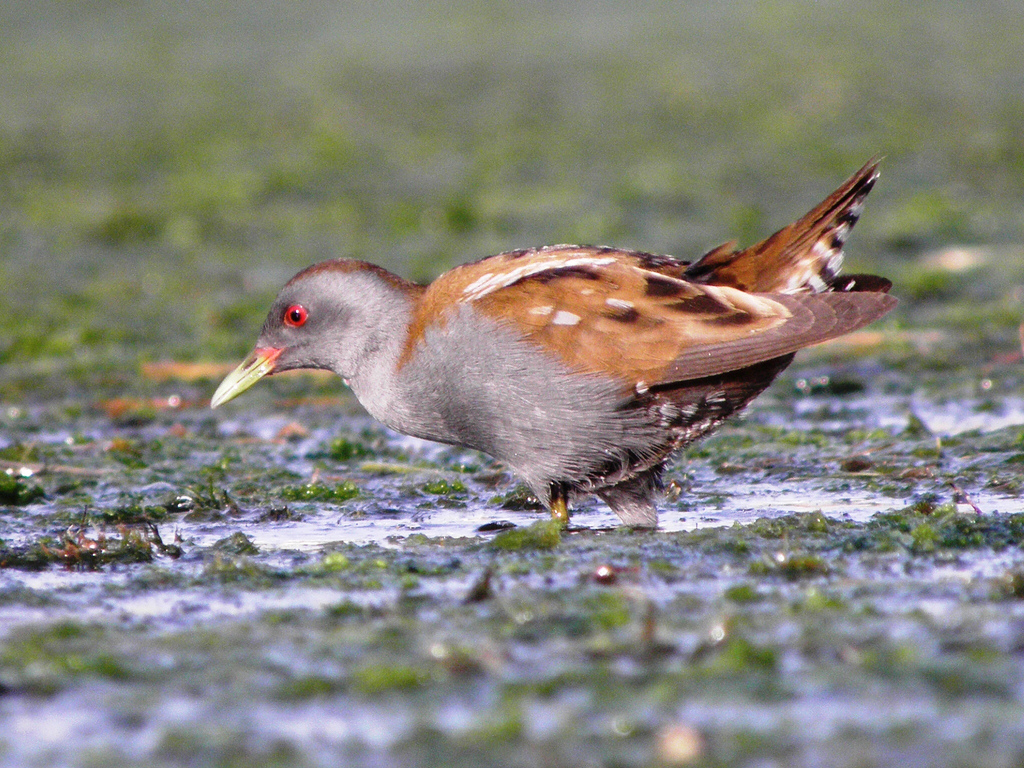
Wikipedia: Little crake Source: OTHER
Porzana_parva_%2850%29.jpg
![]() The little crake (Zapornia parva) is a very small waterbird of the family Rallidae. parva is Latin for "small".[2]
[more]
The little crake (Zapornia parva) is a very small waterbird of the family Rallidae. parva is Latin for "small".[2]
[more]
Song: ![]() Male song diagnostic. A loud series of short, nasal ascending "quek" repeated every one and a half seconds or so, before accelerating and descending at the same time to a more guttural voice. Female song with similar short "quek" but with less pure tone and in shorter series (sometimes just one call), immediately followed by a rolling trill. [Link]
Male song diagnostic. A loud series of short, nasal ascending "quek" repeated every one and a half seconds or so, before accelerating and descending at the same time to a more guttural voice. Female song with similar short "quek" but with less pure tone and in shorter series (sometimes just one call), immediately followed by a rolling trill. [Link]
Calls: ![]() Rich repertoire of calls used freely in breeding season. [Link]
Rich repertoire of calls used freely in breeding season. [Link]
Physical details: length=18-20 cm,
wingspan=34-39 cm,
weight=40-60 g
Habitats:
Wetland
Spotted crake / Tüpfelsumpfhuhn (Porzana porzana)
Profile Wikipedia eBird Vogelwarte BirdLife ZH ornitho.ch Xeno-Canto BirdID NABU

Wikipedia: Spotted crake Source: OTHER
Porzana_porzana_6_%28Marek_Szczepanek%29.jpg
General: ![]() The spotted crake (Porzana porzana) is a small waterbird of the family Rallidae. The scientific name is derived from Venetian terms for small rails.[2]
[more]
The spotted crake (Porzana porzana) is a small waterbird of the family Rallidae. The scientific name is derived from Venetian terms for small rails.[2]
[more]
Song: ![]() Loud and far reaching song uttered with relentless stamina for hours on end. A monosyllabic, resonant and drawn-out "huiiit". [Link]
Loud and far reaching song uttered with relentless stamina for hours on end. A monosyllabic, resonant and drawn-out "huiiit". [Link]
Calls: ![]() The pith rises towards the emphasized end of the call, which is repeated about once a second. Often compared to the dripping of water. Mostly heard at night, and often i duet with mate. The female answers the male with a slightly deeper and softer call, giving the impression of one bird giving a disyllabic call. [Link]
The pith rises towards the emphasized end of the call, which is repeated about once a second. Often compared to the dripping of water. Mostly heard at night, and often i duet with mate. The female answers the male with a slightly deeper and softer call, giving the impression of one bird giving a disyllabic call. [Link]
Physical details: length=22-24 cm,
wingspan=37-42 cm,
weight=70-110 g
Habitats:
Wetland
Striped crake (Amaurornis marginalis)
Profile Wikipedia eBird Xeno-Canto

Wikipedia: Striped crake Source: OTHER
Aenigmatolimnas_marginalis%2C_Kgomo-kgomo-vleiland%2C_Birding_Weto%2C_a.jpg
General: ![]() The striped crake (Aenigmatolimnas marginalis) is a species of bird in the family Rallidae. It is the only species in the genus Aenigmatolimnas, having formerly been included in Porzana or in the defunct genus Poliolimnas. Its precise relationships, however, are still enigmatic.
[more]
The striped crake (Aenigmatolimnas marginalis) is a species of bird in the family Rallidae. It is the only species in the genus Aenigmatolimnas, having formerly been included in Porzana or in the defunct genus Poliolimnas. Its precise relationships, however, are still enigmatic.
[more]
Striped flufftail (Sarothrura affinis)
Profile Wikipedia eBird Xeno-Canto

Wikipedia: Striped flufftail Source: OTHER
1200px-Sarothrura_affinis_affinis_1838.jpg
![]() The striped flufftail (Sarothrura affinis) is a species of bird in the flufftail family Sarothruridae. It is also known as the red-tailed flufftail. The species is closely related to the Madagascar flufftail.
The species has a disjunct distribution across the Afromontane of southeastern Africa, with two subspecies. The nominate subspecies S. a. affinis is found in eastern South Africa and Swaziland. S. a. antonii, named for German ornithologist Anton Reichenow, is found in eastern Zimbabwe and Mozambique, Malawi, southern Tanzania, Kenya and the south of South Sudan.[2]
[more]
The striped flufftail (Sarothrura affinis) is a species of bird in the flufftail family Sarothruridae. It is also known as the red-tailed flufftail. The species is closely related to the Madagascar flufftail.
The species has a disjunct distribution across the Afromontane of southeastern Africa, with two subspecies. The nominate subspecies S. a. affinis is found in eastern South Africa and Swaziland. S. a. antonii, named for German ornithologist Anton Reichenow, is found in eastern Zimbabwe and Mozambique, Malawi, southern Tanzania, Kenya and the south of South Sudan.[2]
[more]
Red-chested flufftail (Sarothrura rufa)
Profile Wikipedia eBird Xeno-Canto

Wikipedia: Red-chested flufftail Source: OTHER
1200px-Sarothrura_rufa_rufa_1838.jpg
![]() The red-chested flufftail (Sarothrura rufa) is a species of bird in the family Sarothruridae.
It is found in sub-Saharan Africa from Liberia to Ethiopia and south to South Africa.
[more]
The red-chested flufftail (Sarothrura rufa) is a species of bird in the family Sarothruridae.
It is found in sub-Saharan Africa from Liberia to Ethiopia and south to South Africa.
[more]
White-winged flufftail (Sarothrura ayresi)

Wikipedia: White-winged flufftail Source: OTHER
White-winged_Flufftail%2C_Middelpunt.jpg
![]() The white-winged flufftail (Sarothrura ayresi) is a very rare African bird in the family Sarothruridae. Its scientific name honours South African ornithologist Thomas Ayres, who discovered it at Potchefstroom.[n 1]
[more]
The white-winged flufftail (Sarothrura ayresi) is a very rare African bird in the family Sarothruridae. Its scientific name honours South African ornithologist Thomas Ayres, who discovered it at Potchefstroom.[n 1]
[more]
Buff-spotted flufftail (Sarothrura elegans)
Profile Wikipedia eBird Xeno-Canto

Wikipedia: Buff-spotted flufftail Source: OTHER
1200px-Male_Buff-spotted_Flufftail_in_Pigeon_Valley%2C_Durban%2C_South_Africa%2C_on_26_Jan_2014.jpg
![]() The buff-spotted flufftail (Sarothrura elegans) is a species of bird in the family Sarothruridae.
It is found in Angola, Botswana, Burundi, Cameroon, Republic of the Congo, Democratic Republic of the Congo, Ivory Coast, Equatorial Guinea, Ethiopia, Gabon, Guinea, Kenya, Liberia, Malawi, Mozambique, Nigeria, Rwanda, Sierra Leone, Somalia, South Africa, South Sudan, Swaziland, Tanzania, Uganda, Zambia, and Zimbabwe.
[more]
The buff-spotted flufftail (Sarothrura elegans) is a species of bird in the family Sarothruridae.
It is found in Angola, Botswana, Burundi, Cameroon, Republic of the Congo, Democratic Republic of the Congo, Ivory Coast, Equatorial Guinea, Ethiopia, Gabon, Guinea, Kenya, Liberia, Malawi, Mozambique, Nigeria, Rwanda, Sierra Leone, Somalia, South Africa, South Sudan, Swaziland, Tanzania, Uganda, Zambia, and Zimbabwe.
[more]
Corn crake / Wachtelkönig (Crex crex)
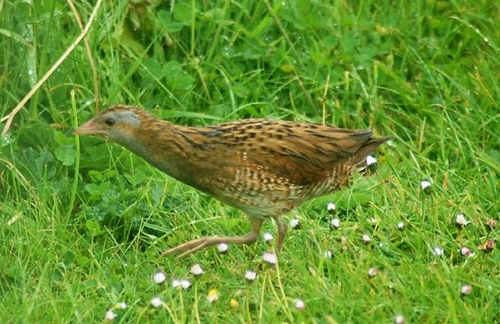
Wikipedia: Corn crake Source: OTHER
Corncrake2.jpg
![]() The corn crake, corncrake or landrail (Crex crex) is a bird in the rail family. It breeds in Europe and Asia as far east as western China, and migrates to Africa for the Northern Hemisphere's winter. It is a medium-sized crake with buff- or grey-streaked brownish-black upperparts, chestnut markings on the wings, and blue-grey underparts with rust-coloured and white bars on the flanks and undertail. The strong bill is flesh-toned, the iris is pale brown, and the legs and feet are pale grey. Juveniles are similar in plumage to adults, and downy chicks are black, as with all rails. There are no subspecies, although individuals from the east of the breeding range tend to be slightly paler than their western counterparts. The male's call is a loud krek krek, from which the scientific name is derived. The corn crake is larger than its closest relative, the African crake, which shares its wintering range; that species is also darker-plumaged, and has a plainer face.
[more]
The corn crake, corncrake or landrail (Crex crex) is a bird in the rail family. It breeds in Europe and Asia as far east as western China, and migrates to Africa for the Northern Hemisphere's winter. It is a medium-sized crake with buff- or grey-streaked brownish-black upperparts, chestnut markings on the wings, and blue-grey underparts with rust-coloured and white bars on the flanks and undertail. The strong bill is flesh-toned, the iris is pale brown, and the legs and feet are pale grey. Juveniles are similar in plumage to adults, and downy chicks are black, as with all rails. There are no subspecies, although individuals from the east of the breeding range tend to be slightly paler than their western counterparts. The male's call is a loud krek krek, from which the scientific name is derived. The corn crake is larger than its closest relative, the African crake, which shares its wintering range; that species is also darker-plumaged, and has a plainer face.
[more]
Song: ![]() Characteristic song can be heard at night. A rasping, hoarse "crex-crex" repeated about every second for long periods of time. [Link]
Characteristic song can be heard at night. A rasping, hoarse "crex-crex" repeated about every second for long periods of time. [Link]
Physical details: length=27-30 cm,
wingspan=46-53 cm,
weight=120-200 g
Habitats:
Agricultural
African crake / Savannenralle (Crex egregia)
Profile Wikipedia eBird Xeno-Canto

Wikipedia: African crake Source: OTHER
CrakeAfrican2%28byMarkTittley%29_cropped_and_mirrored.jpg
General: ![]() The African crake (Crecopsis egregia) is a small to medium-size ground-living bird in the rail family, found in most of central to southern Africa. It is seasonally common in most of its range other than the rainforests and areas that have low annual rainfall. This crake is a partial migrant, moving away from the equator as soon as the rains provide sufficient grass cover to allow it to breed elsewhere. There have been a few records of vagrant birds reaching Atlantic islands. This species nests in a wide variety of grassland types, and agricultural land with tall crops may also be used.
[more]
The African crake (Crecopsis egregia) is a small to medium-size ground-living bird in the rail family, found in most of central to southern Africa. It is seasonally common in most of its range other than the rainforests and areas that have low annual rainfall. This crake is a partial migrant, moving away from the equator as soon as the rains provide sufficient grass cover to allow it to breed elsewhere. There have been a few records of vagrant birds reaching Atlantic islands. This species nests in a wide variety of grassland types, and agricultural land with tall crops may also be used.
[more]
Baillon's crake / Zwergsumpfhuhn (alternate) (Zapornia pusilla)
Profile Wikipedia eBird Xeno-Canto NABU

Wikipedia: Baillon's crake Source: OTHER
1200px-Porzana_pusilla_-_Mount_Annan_Botanical_Garden.jpg
![]() Baillon's crake (Zapornia pusilla), also known as the marsh crake, is a small waterbird of the family Rallidae.
[more]
Baillon's crake (Zapornia pusilla), also known as the marsh crake, is a small waterbird of the family Rallidae.
[more]
Wattled crane (Grus carunculatus)

Wikipedia: Wattled crane Source: OTHER
Wattled_Crane_1400.jpg
![]() The wattled crane (Grus carunculata) is a large bird found in Africa, south of the Sahara Desert. It is sometimes placed in the monotypic genus Bugeranus.
[more]
The wattled crane (Grus carunculata) is a large bird found in Africa, south of the Sahara Desert. It is sometimes placed in the monotypic genus Bugeranus.
[more]
Grey crowned-crane / Südafrika-Kronenkranich (Balearica regulorum)

Wikipedia: Grey crowned-crane Source: OTHER
1200px-Grey_crowned_crane_at_Martin_Mere.JPG
![]() The grey crowned crane (Balearica regulorum), also known as the African crowned crane, golden crested crane, golden-crowned crane, East African crane, East African crowned crane, Eastern crowned crane, South African crane, is a bird in the crane family, Gruidae. It is found in eastern and southern Africa, and is the national bird of Uganda.
[more]
The grey crowned crane (Balearica regulorum), also known as the African crowned crane, golden crested crane, golden-crowned crane, East African crane, East African crowned crane, Eastern crowned crane, South African crane, is a bird in the crane family, Gruidae. It is found in eastern and southern Africa, and is the national bird of Uganda.
[more]
African finfoot / Afrikanische Binsenralle (Podica senegalensis)
Profile Wikipedia eBird Xeno-Canto

Wikipedia: African finfoot Source: OTHER
African_Finfoot_-_Lake_Mburu_-_Uganda.jpg
![]() The African finfoot (Podica senegalensis) is an aquatic bird from the family Heliornithidae (the finfoots and sungrebe). The species lives in the rivers and lakes of western, central, and southern Africa.
[more]
The African finfoot (Podica senegalensis) is an aquatic bird from the family Heliornithidae (the finfoots and sungrebe). The species lives in the rivers and lakes of western, central, and southern Africa.
[more]
Kori bustard / Riesentrappe (Ardeotis kori)

Wikipedia: Kori bustard Source: OTHER
1200px-Ardeotis_kori_Etosha.JPG
![]() The kori bustard (Ardeotis kori) is arguably the largest flying bird native to Africa. It is a member of the bustard family, which all belong to the order Otidiformes and are restricted in distribution to the Old World. It is one of the four species (ranging from Africa to India to Australia) in the large-bodied genus Ardeotis. In fact, the male kori bustard may be the heaviest living animal capable of flight.
[more]
The kori bustard (Ardeotis kori) is arguably the largest flying bird native to Africa. It is a member of the bustard family, which all belong to the order Otidiformes and are restricted in distribution to the Old World. It is one of the four species (ranging from Africa to India to Australia) in the large-bodied genus Ardeotis. In fact, the male kori bustard may be the heaviest living animal capable of flight.
[more]
White-bellied bustard (Eupodotis senegalensis)
Profile Wikipedia eBird Xeno-Canto

Wikipedia: White-bellied bustard Source: OTHER
1200px-White_bellied_bustard_calling.jpg
![]() The white-bellied bustard or white-bellied korhaan (Eupodotis senegalensis) is an African species of bustard. It is widespread in sub-Saharan Africa in grassland and open woodland habitats.[2]
[more]
The white-bellied bustard or white-bellied korhaan (Eupodotis senegalensis) is an African species of bustard. It is widespread in sub-Saharan Africa in grassland and open woodland habitats.[2]
[more]
Karoo bustard (Eupodotis vigorsii)

Wikipedia: Karoo bustard Source: OTHER
1200px-Karoo_Korhaan_%28Eupodotis_vigorsii%29_%2831800692824%29.jpg
![]() The karoo korhaan (Eupodotis vigorsii), also known as karoo bustard, is a species of bird in the bustard family, Otididae, from Southern Africa. The species is sometimes placed in the genus Heterotetrax. It is the sister-species to Rüppell's korhaan, and the two species are sometimes considered conspecific (the same species). There are two subspecies, the nominate race, from south-eastern South Africa, and E. v. namaqua (Roberts, 1932), from north-eastern South Africa and southern Namibia.[2]
[more]
The karoo korhaan (Eupodotis vigorsii), also known as karoo bustard, is a species of bird in the bustard family, Otididae, from Southern Africa. The species is sometimes placed in the genus Heterotetrax. It is the sister-species to Rüppell's korhaan, and the two species are sometimes considered conspecific (the same species). There are two subspecies, the nominate race, from south-eastern South Africa, and E. v. namaqua (Roberts, 1932), from north-eastern South Africa and southern Namibia.[2]
[more]
Blue bustard (Eupodotis caerulescens)
Profile Wikipedia eBird Xeno-Canto

Wikipedia: Blue bustard Source: OTHER
1200px-Blue_Korhaan_%28Eupodotis_caerulescens%29_male.jpg
![]() The blue korhaan or blue bustard (Eupodotis caerulescens) is a species of bird in the family Otididae which is native to South Africa. Its call is a series of frog-like croaks, usually uttered in flight. Its natural habitat is plateau grassland, dry shrubland, arable land and pastureland. Its preferred habitat is one with short grassland and flat topography.[2]
[more]
The blue korhaan or blue bustard (Eupodotis caerulescens) is a species of bird in the family Otididae which is native to South Africa. Its call is a series of frog-like croaks, usually uttered in flight. Its natural habitat is plateau grassland, dry shrubland, arable land and pastureland. Its preferred habitat is one with short grassland and flat topography.[2]
[more]
Denham's bustard (Neotis denhami)
Profile Wikipedia eBird Xeno-Canto

Wikipedia: Denham's bustard Source: OTHER
1200px-Denham%27s_Bustard_%28Neotis_denhami%29_%287083219537%29.jpg
![]() Denham's bustard, Stanley bustard or Stanley's bustard (Neotis denhami) is a large bird in the bustard family. It breeds in much of Sub-Saharan Africa. It is a species of open ground, including agricultural land, grassland, flood-plains and burnt fynbos. It is resident, but some inland populations move to lower altitudes in winter. The common names for this species refer to the English explorer, Major Dixon Denham, and the English naturalist Edward Smith-Stanley, 13th Earl of Derby.
[more]
Denham's bustard, Stanley bustard or Stanley's bustard (Neotis denhami) is a large bird in the bustard family. It breeds in much of Sub-Saharan Africa. It is a species of open ground, including agricultural land, grassland, flood-plains and burnt fynbos. It is resident, but some inland populations move to lower altitudes in winter. The common names for this species refer to the English explorer, Major Dixon Denham, and the English naturalist Edward Smith-Stanley, 13th Earl of Derby.
[more]
Ludwig's bustard (Neotis ludwigii)
Profile Wikipedia eBird Xeno-Canto

Wikipedia: Ludwig's bustard Source: OTHER
1200px-Neotis_ludwigii.jpg
![]() Ludwig's bustard (Neotis ludwigii) is a species of bird in the bustard family, and named after Baron von Ludwig. It is a medium-to-large sized species. It is found in Angola, Botswana, Lesotho, Namibia, and South Africa. Its habitats include semi-arid grasslands.
[more]
Ludwig's bustard (Neotis ludwigii) is a species of bird in the bustard family, and named after Baron von Ludwig. It is a medium-to-large sized species. It is found in Angola, Botswana, Lesotho, Namibia, and South Africa. Its habitats include semi-arid grasslands.
[more]
Black-bellied bustard / Schwarzbauchtrappe (Lissotis melanogaster)
Profile Wikipedia eBird Xeno-Canto

Wikipedia: Black-bellied bustard Source: OTHER
1200px-Black-bellied_bustard.jpg
![]() The black-bellied bustard (Lissotis melanogaster), also known as the black-bellied korhaan, is an African ground-dwelling bird in the bustard family.
[more]
The black-bellied bustard (Lissotis melanogaster), also known as the black-bellied korhaan, is an African ground-dwelling bird in the bustard family.
[more]
Red-crested bustard (Lophotis ruficrista)

Wikipedia: Red-crested bustard Source: OTHER
1200px-Red-crested_Korhaan_%28Lophotis_ruficrista%29_male_%2813799426305%29.jpg
![]() The red-crested korhaan or red-crested bustard (Lophotis ruficrista) is a species of bird in the family Otididae. It is found in Angola, Botswana, Mozambique, Namibia, South Africa, Swaziland, Zambia, and Zimbabwe.[1]
[more]
The red-crested korhaan or red-crested bustard (Lophotis ruficrista) is a species of bird in the family Otididae. It is found in Angola, Botswana, Mozambique, Namibia, South Africa, Swaziland, Zambia, and Zimbabwe.[1]
[more]
Profile Wikipedia eBird Xeno-Canto

Wikipedia: Forest buzzard Source: OTHER
1200px-Forest_Buzzard%2C_Buteo_trizonatus%2C_at_Hangklip_Forest%2C_Makhado%2C_Limpopo_Province%2C_South_Africa_%2820761505461%29.jpg
![]() The forest buzzard (Buteo trizonatus), is a species of bird of prey found in Africa, though some authorities have placed it as a subspecies of another species, the mountain buzzard, Buto oreophilus. This is a resident breeding species in woodlands in southern and eastern South Africa.
[more]
The forest buzzard (Buteo trizonatus), is a species of bird of prey found in Africa, though some authorities have placed it as a subspecies of another species, the mountain buzzard, Buto oreophilus. This is a resident breeding species in woodlands in southern and eastern South Africa.
[more]
Profile Wikipedia eBird Xeno-Canto
Possibly Red-necked buzzards in the desert. 2016-09-07 12.02.46 Namibia
First observed in Namibia on 2016-09-07.
![]() The red-necked buzzard (Buteo auguralis), also known as the African red-tailed buzzard,[2] is a species of buzzard in the family Accipitridae which is found in western and northern central Africa.
[more]
The red-necked buzzard (Buteo auguralis), also known as the African red-tailed buzzard,[2] is a species of buzzard in the family Accipitridae which is found in western and northern central Africa.
[more]

Wikipedia: Jackal buzzard Source: OTHER
Buteo_rufofuscus_-Itala_Game_Reserve%2C_KwaZulu-Natal%2C_South_Africa_-flying-6.jpg
![]() The jackal buzzard (Buteo rufofuscus) is a fairly large African bird of prey. The taxonomy of this species has caused some confusion in the past and it almost certainly belongs in a species complex with other African Buteo species. Some taxonomists have considered this species, the Archer's buzzard, and the augur buzzard to be the same superspecies.[2] Many taxonomists consider them all to be distinct, having different calls, different home ranges and variations in plumage. This is a species that lives among mountains, and on adjacent savanna and grassland. It is resident and non-migratory throughout its range.
[more]
The jackal buzzard (Buteo rufofuscus) is a fairly large African bird of prey. The taxonomy of this species has caused some confusion in the past and it almost certainly belongs in a species complex with other African Buteo species. Some taxonomists have considered this species, the Archer's buzzard, and the augur buzzard to be the same superspecies.[2] Many taxonomists consider them all to be distinct, having different calls, different home ranges and variations in plumage. This is a species that lives among mountains, and on adjacent savanna and grassland. It is resident and non-migratory throughout its range.
[more]

Wikipedia: Shikra Source: OTHER
1200px-Shikra1.jpg
![]() The shikra (Accipiter badius) is a small bird of prey in the family Accipitridae found widely distributed in Asia and Africa where it is also called the little banded goshawk. The African forms may represent a separate species but have usually been considered as subspecies of the shikra. The shikra is very similar in appearance to other sparrowhawk species including the Chinese goshawk and Eurasian sparrowhawk. They have a sharp two note call and have the typical flap and glide flight. Their calls are imitated by drongos and the common hawk-cuckoo resembles it in plumage.
[more]
The shikra (Accipiter badius) is a small bird of prey in the family Accipitridae found widely distributed in Asia and Africa where it is also called the little banded goshawk. The African forms may represent a separate species but have usually been considered as subspecies of the shikra. The shikra is very similar in appearance to other sparrowhawk species including the Chinese goshawk and Eurasian sparrowhawk. They have a sharp two note call and have the typical flap and glide flight. Their calls are imitated by drongos and the common hawk-cuckoo resembles it in plumage.
[more]
Profile Wikipedia eBird Xeno-Canto

Wikipedia: Rufous-breasted sparrowhawk Source: OTHER
Rufous-chested_Sparrowhawk_%28Accipiter_rufiventris%29.jpg
![]() The rufous-breasted sparrowhawk (Accipiter rufiventris), also known as the rufous-chested sparrowhawk and as the red-breasted sparrowhawk, is a species of bird of prey in the family Accipitridae. It is found in Angola, Democratic Republic of the Congo, Eritrea, Ethiopia, Kenya, Lesotho, Malawi, Mozambique, Rwanda, South Africa, South Sudan, Swaziland, Tanzania, Uganda, Zambia, and Zimbabwe.
[more]
The rufous-breasted sparrowhawk (Accipiter rufiventris), also known as the rufous-chested sparrowhawk and as the red-breasted sparrowhawk, is a species of bird of prey in the family Accipitridae. It is found in Angola, Democratic Republic of the Congo, Eritrea, Ethiopia, Kenya, Lesotho, Malawi, Mozambique, Rwanda, South Africa, South Sudan, Swaziland, Tanzania, Uganda, Zambia, and Zimbabwe.
[more]
Profile Wikipedia eBird Xeno-Canto
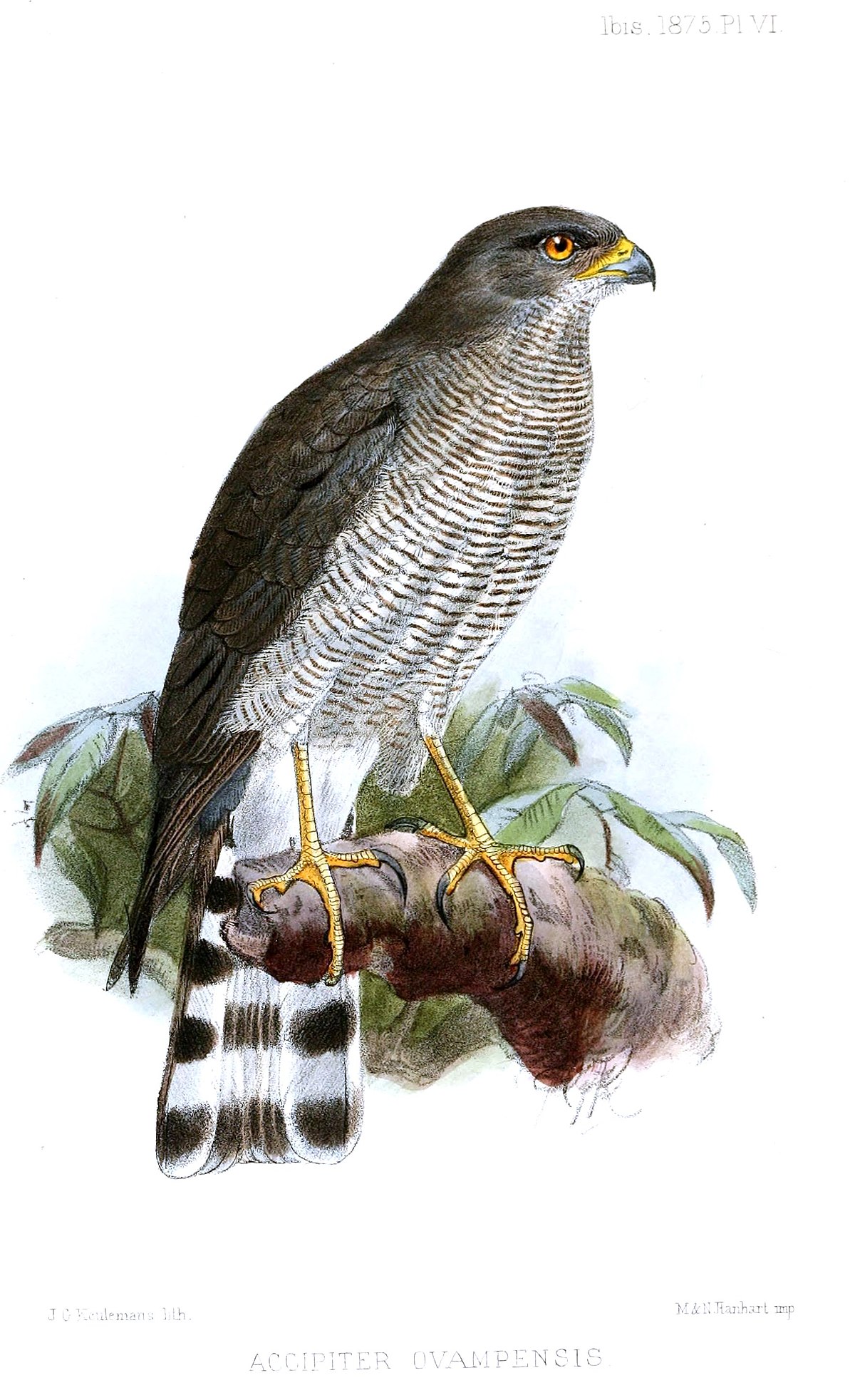
Wikipedia: Ovambo sparrowhawk Source: OTHER
1200px-AccipiterOvampensisKeulemans.jpg
![]() The Ovambo or Ovampo sparrowhawk, also known as Hilgert's sparrowhawk, (Accipiter ovampensis) is a species of sub-Saharan African bird of prey in the family Accipitridae. It takes its name from the Ovamboland in northern Namibia.
[more]
The Ovambo or Ovampo sparrowhawk, also known as Hilgert's sparrowhawk, (Accipiter ovampensis) is a species of sub-Saharan African bird of prey in the family Accipitridae. It takes its name from the Ovamboland in northern Namibia.
[more]
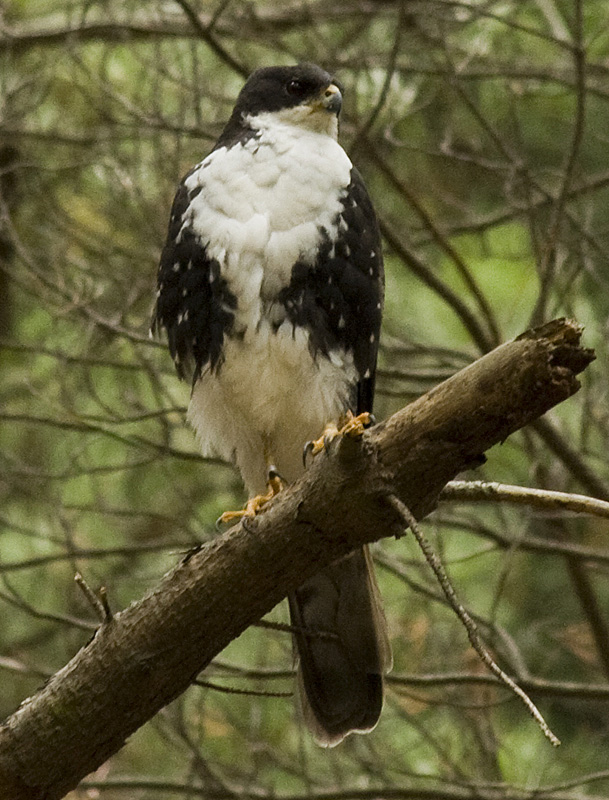
Wikipedia: Black goshawk Source: OTHER
Black_Sparrowhawk_white_morph_2_x.jpg
![]() The black sparrowhawk (Accipiter melanoleucus), sometimes known as the black goshawk or great sparrowhawk, is the largest African member of the genus Accipiter.[3] It occurs mainly in forest and non-desert areas south of the Sahara, particularly where there are large trees suitable for nesting; favored habitat includes suburban and human-altered landscapes.[3] It preys predominantly on birds of moderate size, such as pigeons and doves, in suburban areas.[4]
[more]
The black sparrowhawk (Accipiter melanoleucus), sometimes known as the black goshawk or great sparrowhawk, is the largest African member of the genus Accipiter.[3] It occurs mainly in forest and non-desert areas south of the Sahara, particularly where there are large trees suitable for nesting; favored habitat includes suburban and human-altered landscapes.[3] It preys predominantly on birds of moderate size, such as pigeons and doves, in suburban areas.[4]
[more]

Wikipedia: Little sparrowhawk Source: OTHER
1200px-Little_sparrowhawk_%28Accipiter_minullus%29_01%2C_crop.jpg
![]() The little sparrowhawk (Accipiter minullus) is a species of Afrotropical bird of prey in the family Accipitridae. It is the smallest member of the genus Accipiter and forms a superspecies with the red-thighed sparrowhawk (Accipiter erythropus).
[more]
The little sparrowhawk (Accipiter minullus) is a species of Afrotropical bird of prey in the family Accipitridae. It is the smallest member of the genus Accipiter and forms a superspecies with the red-thighed sparrowhawk (Accipiter erythropus).
[more]

Wikipedia: African goshawk Source: OTHER
1200px-African_Goshawk_RWD2.jpg
![]() The African goshawk (Accipiter tachiro) is a species of African bird of prey in the genus Accipiter which is the type genus of the family Accipitridae.
[more]
The African goshawk (Accipiter tachiro) is a species of African bird of prey in the genus Accipiter which is the type genus of the family Accipitridae.
[more]
Tawny-eagle. 2016-09-14 15.33.02 Namibia
First observed in Namibia on 2016-09-14.
![]() Der Raubadler oder Savannenadler (Aquila rapax) ist eine Vogelart aus der Familie der Habichtartigen (Accipitridae). Dieser mittelgroße Vertreter der Unterfamilie Aquilinae besiedelt weite Teile Afrikas südlich der Sahara sowie den indischen Subkontinent. Kleinflächig kommt die Art auch im nördlichen Afrika, auf der Arabischen Halbinsel sowie möglicherweise in Myanmar vor. Die Art bewohnt überwiegend trockene Landschaften mit lockerem Baumbestand; das Spektrum der besiedelten Lebensräume reicht von waldreichen Savannen, Trockenwäldern und Dornbuschwäldern bis hin zu Halbwüsten. Der Raubadler ernährt sich von kleinen bis mittelgroßen Wirbeltieren, Insekten und auch regelmäßig von Aas. Er parasitiert häufig auch bei anderen Greifvogelarten, Störchen oder Hornraben.
[more]
Der Raubadler oder Savannenadler (Aquila rapax) ist eine Vogelart aus der Familie der Habichtartigen (Accipitridae). Dieser mittelgroße Vertreter der Unterfamilie Aquilinae besiedelt weite Teile Afrikas südlich der Sahara sowie den indischen Subkontinent. Kleinflächig kommt die Art auch im nördlichen Afrika, auf der Arabischen Halbinsel sowie möglicherweise in Myanmar vor. Die Art bewohnt überwiegend trockene Landschaften mit lockerem Baumbestand; das Spektrum der besiedelten Lebensräume reicht von waldreichen Savannen, Trockenwäldern und Dornbuschwäldern bis hin zu Halbwüsten. Der Raubadler ernährt sich von kleinen bis mittelgroßen Wirbeltieren, Insekten und auch regelmäßig von Aas. Er parasitiert häufig auch bei anderen Greifvogelarten, Störchen oder Hornraben.
[more]
Profile Wikipedia eBird Xeno-Canto
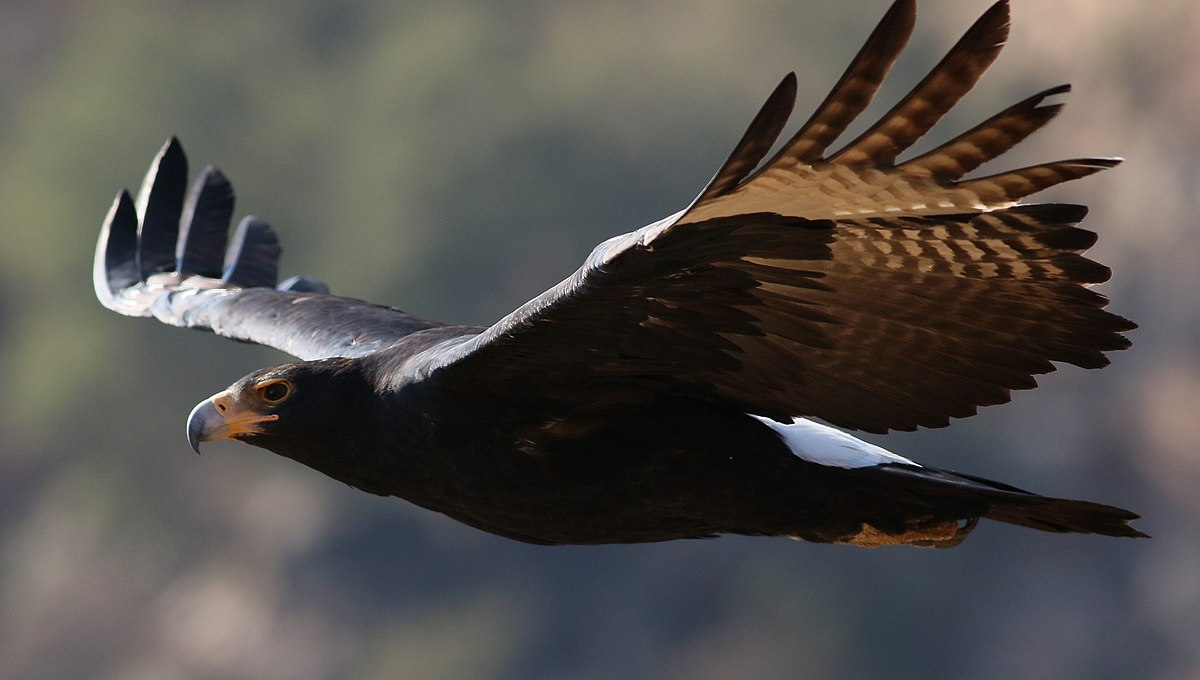
Wikipedia: Verreaux's eagle Source: OTHER
1200px-Verreaux%27s_Eagle_%28Black_Eagle%29%2C_Aquila_verreauxii%2C_at_Walter_Sisulu_National_Botanical_Garden%2C_Gauteng%2C_South_Africa_%2828825027073%29.jpg
![]() Verreaux's eagle (Aquila verreauxii) is a large, mostly African, bird of prey. It is also called the black eagle, especially in Southern Africa, leading to potential confusion with the Indian black eagle (Ictinaetus malayensis), which lives far to the east in Asia.[2] Verreaux's eagle lives in hilly and mountainous regions of southern and eastern Africa (extending marginally into Chad), and very locally in West Africa, the Arabian Peninsula and the southern Middle East. It is one of the most specialized species of accipitrid in the world, with its distribution and life history revolving around its favorite prey species, the rock hyraxes. When hyrax populations decline, the species have been shown to survive with mixed success on other prey, such as small antelopes, gamebirds, hares, monkeys and other assorted vertebrates. Despite a high degree of specialization, Verreaux's eagle has, from a conservation standpoint, been faring relatively well in historic times. One population of this species, in the Matobo Hills of Zimbabwe, is arguably the best studied eagle population in the world, having been subject to continuous detailed study since the late 1950s.[2][3] Like all eagles, this species belongs to the taxonomic order Accipitriformes (formerly included in Falconiformes) and the family Accipitridae, which may be referred to colloquially as accipitrids or raptors.
[more]
Verreaux's eagle (Aquila verreauxii) is a large, mostly African, bird of prey. It is also called the black eagle, especially in Southern Africa, leading to potential confusion with the Indian black eagle (Ictinaetus malayensis), which lives far to the east in Asia.[2] Verreaux's eagle lives in hilly and mountainous regions of southern and eastern Africa (extending marginally into Chad), and very locally in West Africa, the Arabian Peninsula and the southern Middle East. It is one of the most specialized species of accipitrid in the world, with its distribution and life history revolving around its favorite prey species, the rock hyraxes. When hyrax populations decline, the species have been shown to survive with mixed success on other prey, such as small antelopes, gamebirds, hares, monkeys and other assorted vertebrates. Despite a high degree of specialization, Verreaux's eagle has, from a conservation standpoint, been faring relatively well in historic times. One population of this species, in the Matobo Hills of Zimbabwe, is arguably the best studied eagle population in the world, having been subject to continuous detailed study since the late 1950s.[2][3] Like all eagles, this species belongs to the taxonomic order Accipitriformes (formerly included in Falconiformes) and the family Accipitridae, which may be referred to colloquially as accipitrids or raptors.
[more]

Wikipedia: African hawk-eagle Source: OTHER
1200px-African_hawk_eagle_%28Aquila_spilogaster%29.jpg
![]() The African hawk-eagle (Aquila spilogaster) is a large bird of prey. Like all eagles, it belongs to the family Accipitridae. The African hawk-eagle breeds in tropical Sub-Saharan Africa. It is a bird of wooded hills, building a stick nest about 3 feet (almost 1 metre) in diameter in the fork of a large tree. The clutch is generally one or two eggs. The African hawk-eagle hunts small mammals, reptiles, and birds. The call is a shrill kluu-kluu-kluu.[2]
[more]
The African hawk-eagle (Aquila spilogaster) is a large bird of prey. Like all eagles, it belongs to the family Accipitridae. The African hawk-eagle breeds in tropical Sub-Saharan Africa. It is a bird of wooded hills, building a stick nest about 3 feet (almost 1 metre) in diameter in the fork of a large tree. The clutch is generally one or two eggs. The African hawk-eagle hunts small mammals, reptiles, and birds. The call is a shrill kluu-kluu-kluu.[2]
[more]

Wikipedia: Steppe eagle Source: OTHER
1200px-Steppe_Eagle_Portrait.jpg
![]() The steppe eagle (Aquila nipalensis) is a large bird of prey. Like all eagles, it belongs to the family Accipitridae.[3] The steppe eagle's well-feathered legs illustrate it to be a member of the subfamily Aquilinae, also known as the "booted eagles".[4] This species was once considered to be closely related to the non-migratory tawny eagle (Aquila rapax) and the two forms have previously been treated as conspecific. They were split based on pronounced differences in morphology and anatomy;[5][6] two molecular studies, each based on a very small number of genes, indicate that the species are distinct but disagree over how closely related they are.[6][7][8]
[more]
The steppe eagle (Aquila nipalensis) is a large bird of prey. Like all eagles, it belongs to the family Accipitridae.[3] The steppe eagle's well-feathered legs illustrate it to be a member of the subfamily Aquilinae, also known as the "booted eagles".[4] This species was once considered to be closely related to the non-migratory tawny eagle (Aquila rapax) and the two forms have previously been treated as conspecific. They were split based on pronounced differences in morphology and anatomy;[5][6] two molecular studies, each based on a very small number of genes, indicate that the species are distinct but disagree over how closely related they are.[6][7][8]
[more]
Profile Wikipedia eBird Xeno-Canto
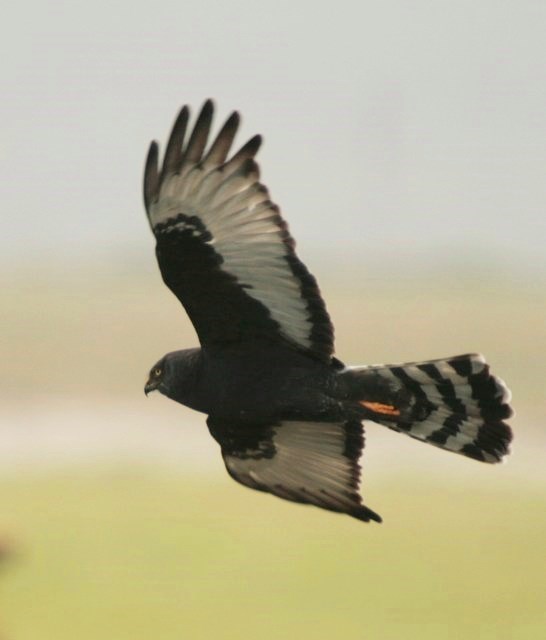
Wikipedia: Black harrier Source: OTHER
Circus_maurus.jpg
![]() The black harrier (Circus maurus) is a medium-sized African harrier whose range extends from South Africa to Botswana and Namibia. It has a wingspan of 105–115 cm (41–45 in) and a body length of 44–50 cm (17–20 in).[2] When perched, this bird appears all black. However, in flight a white rump and flight feathers become visible. Its morphology is comparable to that of other harriers, with a slim body, narrow wings and a long tail. Male and female plumages are similar. Juveniles have buff under-parts and heavily spotted breasts.
[more]
The black harrier (Circus maurus) is a medium-sized African harrier whose range extends from South Africa to Botswana and Namibia. It has a wingspan of 105–115 cm (41–45 in) and a body length of 44–50 cm (17–20 in).[2] When perched, this bird appears all black. However, in flight a white rump and flight feathers become visible. Its morphology is comparable to that of other harriers, with a slim body, narrow wings and a long tail. Male and female plumages are similar. Juveniles have buff under-parts and heavily spotted breasts.
[more]

Wikipedia: African marsh-harrier Source: OTHER
1200px-Circus_ranivorus.jpg
![]() The African marsh harrier (Circus ranivorus) is a bird of prey belonging to the harrier genus Circus. It is largely resident in wetland habitats in southern, central and eastern Africa from South Africa north to South Sudan.
[more]
The African marsh harrier (Circus ranivorus) is a bird of prey belonging to the harrier genus Circus. It is largely resident in wetland habitats in southern, central and eastern Africa from South Africa north to South Sudan.
[more]
MerlinBirdID meint Rohrweihe. 2022-05-21 16.00.56 Leuk and surroundings
First observed in 🇨🇭 on 2022-05-21.
![]() The western marsh harrier (Circus aeruginosus) is a large harrier, a bird of prey from temperate and subtropical western Eurasia and adjacent Africa. It is also known as the Eurasian marsh harrier. The genus name Circus is derived from the Ancient Greek kirkos, referring to a bird of prey named for its circling flight (kirkos, "circle"), probably the hen harrier. The specific aeruginosus is Latin for "rusty".[3]
[more]
The western marsh harrier (Circus aeruginosus) is a large harrier, a bird of prey from temperate and subtropical western Eurasia and adjacent Africa. It is also known as the Eurasian marsh harrier. The genus name Circus is derived from the Ancient Greek kirkos, referring to a bird of prey named for its circling flight (kirkos, "circle"), probably the hen harrier. The specific aeruginosus is Latin for "rusty".[3]
[more]
Calls: ![]() Call: A sharp "kwii-uuu" of about a seconds length, rapidly ascending in pitch, and ending on a falling tone. [Link]
Call: A sharp "kwii-uuu" of about a seconds length, rapidly ascending in pitch, and ending on a falling tone. [Link]
Physical details: length=48-56 cm,
wingspan=115-130 cm,
weight=405-800 g
Habitats:
Agricultural
Profile Wikipedia eBird Vogelwarte BirdLife ZH ornitho.ch Xeno-Canto BirdID NABU

Wikipedia: Pallid harrier Source: OTHER
1200px-Pallid_Harrier_Male.jpg
General: ![]() The pale or pallid harrier (Circus macrourus) is a migratory bird of prey of the harrier family. The scientific name is derived from the Ancient Greek. Circus is from kirkos, referring to a bird of prey named for its circling flight (kirkos, "circle"), probably the hen harrier and macrourus is "long-tailed", from makros, "long" and -ouros "-tailed".[2]
[more]
The pale or pallid harrier (Circus macrourus) is a migratory bird of prey of the harrier family. The scientific name is derived from the Ancient Greek. Circus is from kirkos, referring to a bird of prey named for its circling flight (kirkos, "circle"), probably the hen harrier and macrourus is "long-tailed", from makros, "long" and -ouros "-tailed".[2]
[more]
Calls: ![]() Some calls similar to Montagu's and Hen Harrier, but display call quite diagnostic. A thin, vibrating trill "peerrrrrrrr". [Link]
Some calls similar to Montagu's and Hen Harrier, but display call quite diagnostic. A thin, vibrating trill "peerrrrrrrr". [Link]
Physical details: length=40-48 cm,
wingspan=95-120 cm,
weight=300-550 g
Profile Wikipedia eBird Vogelwarte BirdLife ZH ornitho.ch Xeno-Canto NABU
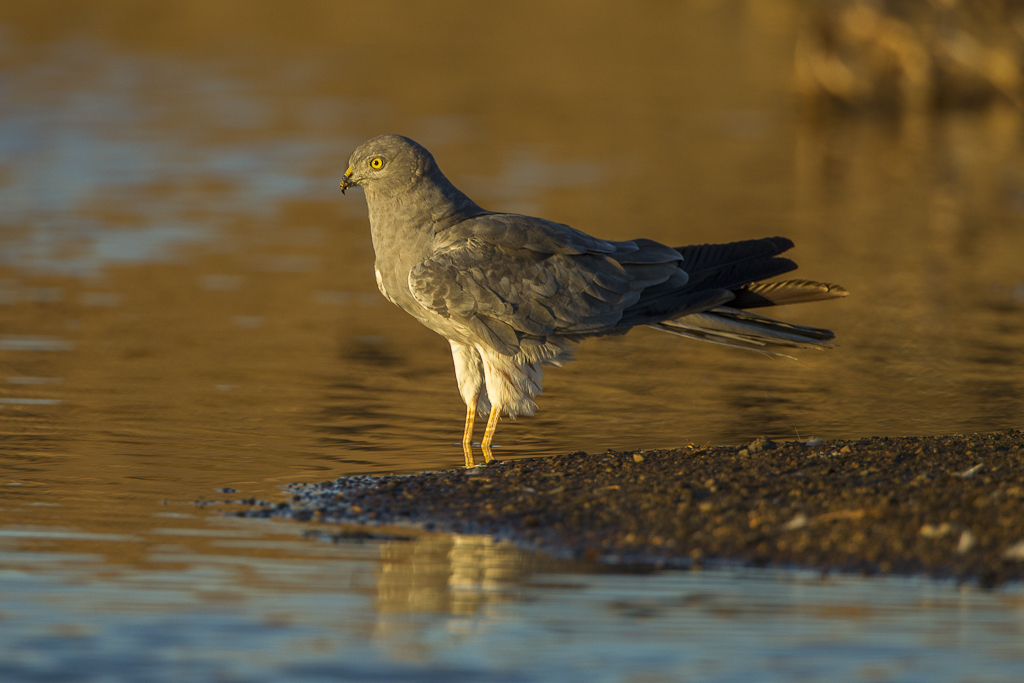
Wikipedia: Montagu's harrier Source: OTHER
Montagu%27s_harrier_%28Circus_pygargus%29.jpg
General: ![]() Montagu's harrier (Circus pygargus) is a migratory bird of prey of the harrier family. Its common name commemorates the British naturalist George Montagu.
[more]
Montagu's harrier (Circus pygargus) is a migratory bird of prey of the harrier family. Its common name commemorates the British naturalist George Montagu.
[more]
Habitats:
Agricultural
Profile Wikipedia eBird Xeno-Canto NABU

Wikipedia: White-backed vulture Source: OTHER
1200px-2012-white-backed-vulture.jpg
![]() The white-backed vulture (Gyps africanus) is an Old World vulture in the family Accipitridae, which also includes eagles, kites, buzzards and hawks. It is closely related to the European griffon vulture, G. fulvus. Sometimes it is called African white-backed vulture to distinguish it from the Oriental white-backed vulture — nowadays usually called white-rumped vulture — to which it was formerly believed to be closely related.
[more]
The white-backed vulture (Gyps africanus) is an Old World vulture in the family Accipitridae, which also includes eagles, kites, buzzards and hawks. It is closely related to the European griffon vulture, G. fulvus. Sometimes it is called African white-backed vulture to distinguish it from the Oriental white-backed vulture — nowadays usually called white-rumped vulture — to which it was formerly believed to be closely related.
[more]

Wikipedia: Rueppell's griffon Source: OTHER
1200px-R%C3%BCppell%27s_Vulture_%28Gyps_rueppelli%29_%2821160089681%29.jpg
![]() Rüppell's vulture (Gyps rueppelli), also called Rüppell's griffon vulture, named after Eduard Rüppell, is a large bird of prey, mainly native to the Sahel region and East Africa. The current population of 22,000 is decreasing due to loss of habitat, incidental poisoning, and other factors.[3] Known also as Rüppell's griffon, Rueppell's griffon, Rüppell's griffin vulture, Rueppell's vulture and other variants, it is not to be confused with a different species, the griffon vulture (Gyps fulvus).[4] Rüppell's vulture is considered to be the highest-flying bird, with confirmed evidence of a flight at an altitude of 11,300 m (37,000 ft) above sea level.[5]
[more]
Rüppell's vulture (Gyps rueppelli), also called Rüppell's griffon vulture, named after Eduard Rüppell, is a large bird of prey, mainly native to the Sahel region and East Africa. The current population of 22,000 is decreasing due to loss of habitat, incidental poisoning, and other factors.[3] Known also as Rüppell's griffon, Rueppell's griffon, Rüppell's griffin vulture, Rueppell's vulture and other variants, it is not to be confused with a different species, the griffon vulture (Gyps fulvus).[4] Rüppell's vulture is considered to be the highest-flying bird, with confirmed evidence of a flight at an altitude of 11,300 m (37,000 ft) above sea level.[5]
[more]

Wikipedia: Cape vulture Source: OTHER
1200px-Cape_Vulture-001.jpg
![]() The Cape vulture or Cape griffon (Gyps coprotheres), also known as "Kolbe's vulture", is an Old World vulture in the family Accipitridae. It is endemic to southern Africa, and is found mainly in South Africa, Lesotho, Botswana, and in some parts of northern Namibia. It nests on cliffs and lays one egg per year. Since 2015, it has been classified as Endangered.
[more]
The Cape vulture or Cape griffon (Gyps coprotheres), also known as "Kolbe's vulture", is an Old World vulture in the family Accipitridae. It is endemic to southern Africa, and is found mainly in South Africa, Lesotho, Botswana, and in some parts of northern Namibia. It nests on cliffs and lays one egg per year. Since 2015, it has been classified as Endangered.
[more]
Profile Wikipedia eBird Xeno-Canto
In Moremi, African fish eagles in tree. 2016-09-23 07.02.56 Botswana
First observed in Botswana on 2016-09-23.
![]() The African fish eagle (Haliaeetus vocifer)[2] or the African sea eagle, is a large species of eagle found throughout sub-Saharan Africa wherever large bodies of open water with an abundant food supply occur. It is the national bird of Namibia and Zambia. As a result of its large range, it is known in many languages.[3] Examples of names include:
nkwazi in Chewa, aigle pêcheur in French,[4] hungwe in Shona, inkwazi in isiZulu, and 'ntšhu' (pronounced "ntjhu") in Northern Sotho. This species may resemble the bald eagle in appearance; though related, each species occurs on different continents, with the bald eagle being resident in North America.
[more]
The African fish eagle (Haliaeetus vocifer)[2] or the African sea eagle, is a large species of eagle found throughout sub-Saharan Africa wherever large bodies of open water with an abundant food supply occur. It is the national bird of Namibia and Zambia. As a result of its large range, it is known in many languages.[3] Examples of names include:
nkwazi in Chewa, aigle pêcheur in French,[4] hungwe in Shona, inkwazi in isiZulu, and 'ntšhu' (pronounced "ntjhu") in Northern Sotho. This species may resemble the bald eagle in appearance; though related, each species occurs on different continents, with the bald eagle being resident in North America.
[more]
Profile Wikipedia eBird Xeno-Canto

Wikipedia: African harrier-hawk Source: OTHER
1200px-Polyboroides_typus_-near_Sand_River_Selous%2C_Selous_Game_Reserve%2C_Tanzania-8%2C_crop.jpg
![]() The African harrier-hawk, harrier hawk or gymnogene (Polyboroides typus) is a bird of prey. It is about 60–66 centimetres (24–26 in) in length. It breeds in most of Africa south of the Sahara. The only other member of the genus is the allopatric Madagascan harrier-hawk (Polyboroides radiatus).
[more]
The African harrier-hawk, harrier hawk or gymnogene (Polyboroides typus) is a bird of prey. It is about 60–66 centimetres (24–26 in) in length. It breeds in most of Africa south of the Sahara. The only other member of the genus is the allopatric Madagascan harrier-hawk (Polyboroides radiatus).
[more]

Wikipedia: White-headed vulture Source: OTHER
1200px-Trigonoceps_occipitalis_-Las_Aguilas_Jungle_Park%2C_Tenerife%2C_Spain-8a_%284%29.jpg
![]() The white-headed vulture (Trigonoceps occipitalis) is an Old World vulture endemic to Africa. Populations have been declining steeply in recent years due to habitat degradation and poisoning of vultures at carcasses. An extinct relative was also present in the Indonesian island of Flores, indicating that the genus was more widespread in the past.[2]
[more]
The white-headed vulture (Trigonoceps occipitalis) is an Old World vulture endemic to Africa. Populations have been declining steeply in recent years due to habitat degradation and poisoning of vultures at carcasses. An extinct relative was also present in the Indonesian island of Flores, indicating that the genus was more widespread in the past.[2]
[more]
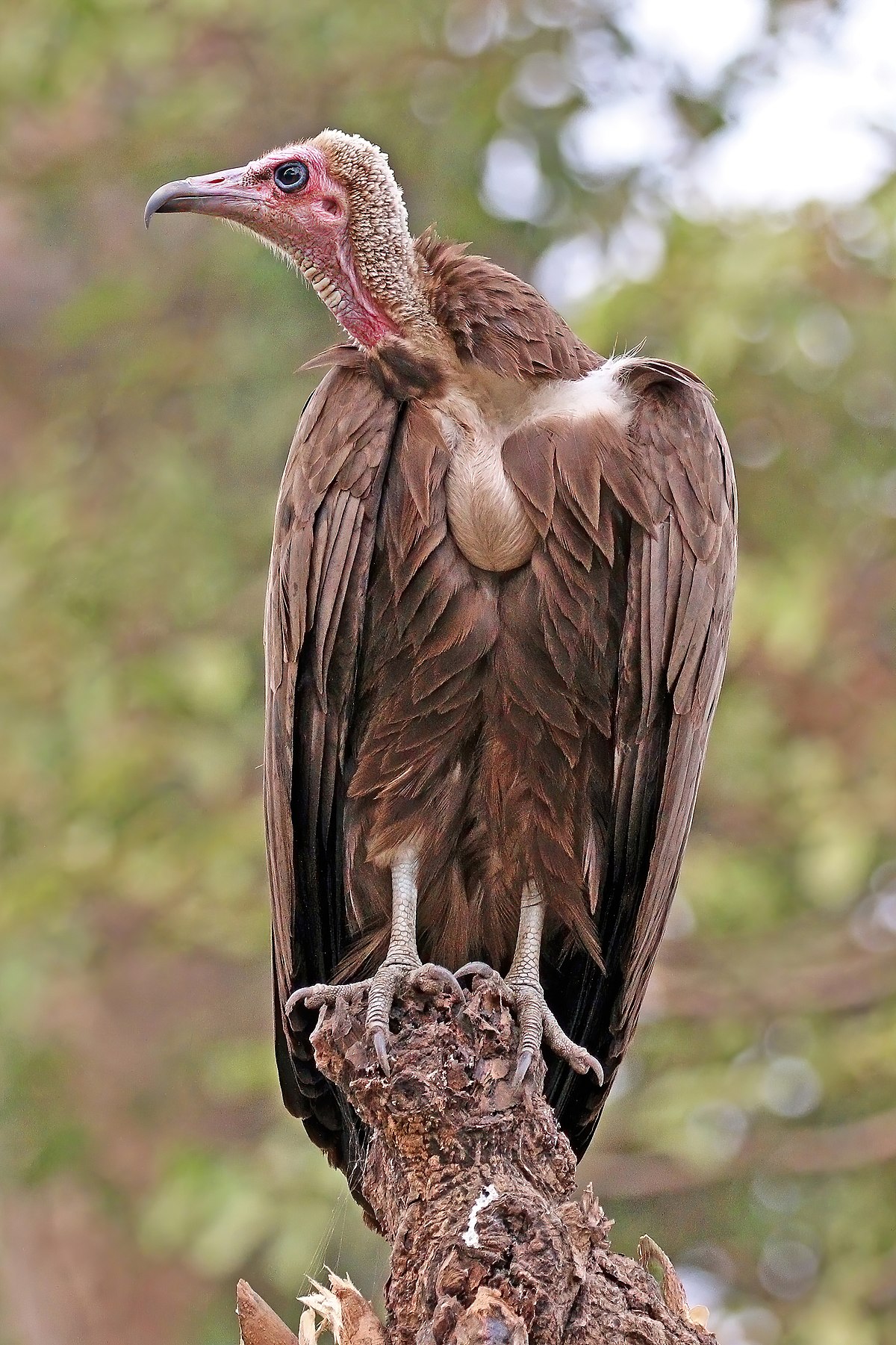
Wikipedia: Hooded vulture Source: OTHER
1200px-Hooded_vulture_%28Necrosyrtes_monachus%29.jpg
![]() The hooded vulture (Necrosyrtes monachus) is an Old World vulture in the order Accipitriformes, which also includes eagles, kites, buzzards and hawks. It is the only member of the genus Necrosyrtes, which is sister to the larger Gyps genus, both of which are a part of the Aegypiinae subfamily of Old World vultures.[2] It is native to sub-Saharan Africa, where it has a widespread distribution with populations in southern, East and West Africa.[3][4] It is a scruffy-looking, small vulture with dark brown plumage, a long thin bill, bare crown, face and fore-neck, and a downy nape and hind-neck. Its face is usually a light red colour. It typically scavenges on carcasses of wildlife and domestic animals. Although it remains a common species with a stable population in the lower region of Casamance, some areas of The Gambia, and Guinea-Bissau, other regions such as Dakar, Senegal, show more than 85% losses in population over the last 50 years.[4][5] Threats include poisoning, hunting, loss of habitat and collisions with electricity infrastructure, and the International Union for Conservation of Nature has rated its conservation status as "critically endangered" in their latest assessment (2017).[5] The highest current regional density of hooded vultures is in the western region of The Gambia.[6]
[more]
The hooded vulture (Necrosyrtes monachus) is an Old World vulture in the order Accipitriformes, which also includes eagles, kites, buzzards and hawks. It is the only member of the genus Necrosyrtes, which is sister to the larger Gyps genus, both of which are a part of the Aegypiinae subfamily of Old World vultures.[2] It is native to sub-Saharan Africa, where it has a widespread distribution with populations in southern, East and West Africa.[3][4] It is a scruffy-looking, small vulture with dark brown plumage, a long thin bill, bare crown, face and fore-neck, and a downy nape and hind-neck. Its face is usually a light red colour. It typically scavenges on carcasses of wildlife and domestic animals. Although it remains a common species with a stable population in the lower region of Casamance, some areas of The Gambia, and Guinea-Bissau, other regions such as Dakar, Senegal, show more than 85% losses in population over the last 50 years.[4][5] Threats include poisoning, hunting, loss of habitat and collisions with electricity infrastructure, and the International Union for Conservation of Nature has rated its conservation status as "critically endangered" in their latest assessment (2017).[5] The highest current regional density of hooded vultures is in the western region of The Gambia.[6]
[more]

Wikipedia: Lappet-faced vulture Source: OTHER
1200px-2012-lappet-faced-vulture.jpg
![]() The lappet-faced vulture or Nubian vulture (Torgos tracheliotos) is an Old World vulture belonging to the bird order Accipitriformes, which also includes eagles, kites, buzzards and hawks. It is the only member of the genus Torgos. It is not closely related to the superficially similar New World vultures, and does not share the good sense of smell of some members of that group.
[more]
The lappet-faced vulture or Nubian vulture (Torgos tracheliotos) is an Old World vulture belonging to the bird order Accipitriformes, which also includes eagles, kites, buzzards and hawks. It is the only member of the genus Torgos. It is not closely related to the superficially similar New World vultures, and does not share the good sense of smell of some members of that group.
[more]
Profile Wikipedia eBird Xeno-Canto
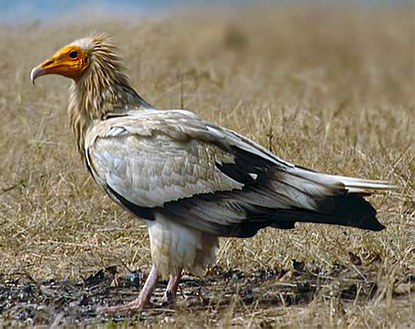
Wikipedia: Egyptian vulture Source: OTHER
Egyptian_vulture.jpg
![]() The Egyptian vulture (Neophron percnopterus), also called the white scavenger vulture or pharaoh's chicken, is a small Old World vulture and the only member of the genus Neophron. It is widely distributed from the Iberian Peninsula and North Africa to India. The contrasting underwing pattern and wedge-shaped tail make it distinctive in flight as it soars in thermals during the warmer parts of the day. Egyptian vultures feed mainly on carrion but are opportunistic and will prey on small mammals, birds, and reptiles. They also feed on the eggs of other birds, breaking larger ones by tossing a large pebble onto them.
[more]
The Egyptian vulture (Neophron percnopterus), also called the white scavenger vulture or pharaoh's chicken, is a small Old World vulture and the only member of the genus Neophron. It is widely distributed from the Iberian Peninsula and North Africa to India. The contrasting underwing pattern and wedge-shaped tail make it distinctive in flight as it soars in thermals during the warmer parts of the day. Egyptian vultures feed mainly on carrion but are opportunistic and will prey on small mammals, birds, and reptiles. They also feed on the eggs of other birds, breaking larger ones by tossing a large pebble onto them.
[more]
Vocalization: ![]() Almost never heard. May emit different grunting sounds and a slightly mallard-like "ga ga ga ga ga ga ga". [Link]
Almost never heard. May emit different grunting sounds and a slightly mallard-like "ga ga ga ga ga ga ga". [Link]
Physical details: length=60-70 cm,
wingspan=155-180 cm,
weight=1600-2200 g

Wikipedia: Bearded vulture Source: OTHER
1200px-Bartgeier_Gypaetus_barbatus_front_Richard_Bartz.jpg
General: ![]() The bearded vulture (Gypaetus barbatus), also known as the lammergeier and ossifrage, is a bird of prey and the only member of the genus Gypaetus. This bird is also identified as Huma bird or Homa bird in Iran and north west Asia. Traditionally considered an Old World vulture, it actually forms a minor lineage of Accipitridae together with the Egyptian vulture (Neophron percnopterus), its closest living relative. It is not much more closely related to the Old World vultures proper than to, for example, hawks, and differs from the former by its feathered neck. Although dissimilar, the Egyptian and bearded vulture each have a lozenge-shaped tail—unusual among birds of prey.
[more]
The bearded vulture (Gypaetus barbatus), also known as the lammergeier and ossifrage, is a bird of prey and the only member of the genus Gypaetus. This bird is also identified as Huma bird or Homa bird in Iran and north west Asia. Traditionally considered an Old World vulture, it actually forms a minor lineage of Accipitridae together with the Egyptian vulture (Neophron percnopterus), its closest living relative. It is not much more closely related to the Old World vultures proper than to, for example, hawks, and differs from the former by its feathered neck. Although dissimilar, the Egyptian and bearded vulture each have a lozenge-shaped tail—unusual among birds of prey.
[more]
Calls: ![]() Display call a thin whistling with several register breaks, reminiscent of Honey Buzzard (Pernis apivorus). A passerine-like trill is also sometimes heard, but generally not a vocal bird. [Link]
Display call a thin whistling with several register breaks, reminiscent of Honey Buzzard (Pernis apivorus). A passerine-like trill is also sometimes heard, but generally not a vocal bird. [Link]
Physical details: length=100-115 cm,
wingspan=266-282 cm,
weight=5000-7000 g
Habitats:
Agricultural
Profile Wikipedia eBird Xeno-Canto
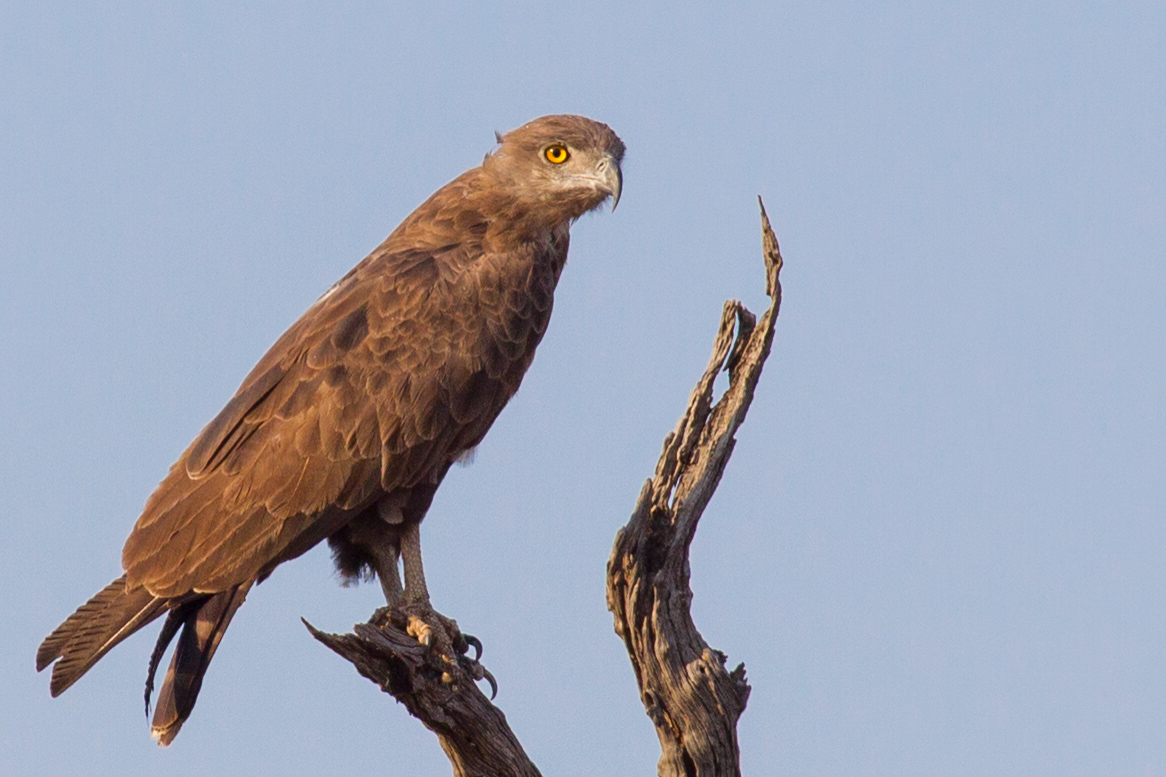
Wikipedia: Brown snake-eagle Source: OTHER
Brown_Snake_Eagle_%2811914065625%29.jpg
General: ![]() The brown snake eagle (Circaetus cinereus) is a fairly large species of bird of prey in the family Accipitridae. It is found in West, East and southern Africa. This species is an almost obligate predator of a variety of snakes. A very solitary bird, the brown snake eagle has a prolonged breeding cycle and raises a single eaglet. Although probably naturally scarce, it is classified as a Least concern species as it continues to occur over a very broad range.[1]
[more]
The brown snake eagle (Circaetus cinereus) is a fairly large species of bird of prey in the family Accipitridae. It is found in West, East and southern Africa. This species is an almost obligate predator of a variety of snakes. A very solitary bird, the brown snake eagle has a prolonged breeding cycle and raises a single eaglet. Although probably naturally scarce, it is classified as a Least concern species as it continues to occur over a very broad range.[1]
[more]

Wikipedia: Black-chested snake-eagle Source: OTHER
1200px-Black-chested_snake-eagle_%28Circaetus_pectoralis%29.jpg
![]() The black-chested snake eagle or black-breasted snake eagle (Circaetus pectoralis) is a large African bird of prey of the family Accipitridae. It resembles other snake eagles and was formerly considered conspecific with the short-toed and Beaudouin's snake eagles, to which it is closely related.[2][3]
[more]
The black-chested snake eagle or black-breasted snake eagle (Circaetus pectoralis) is a large African bird of prey of the family Accipitridae. It resembles other snake eagles and was formerly considered conspecific with the short-toed and Beaudouin's snake eagles, to which it is closely related.[2][3]
[more]
Profile Wikipedia eBird Xeno-Canto

Wikipedia: Fasciated snake-eagle Source: OTHER
Circaetus_fasciolatus%2C_Chiboma%2C_Sofala%2C_Birding_Weto%2C_a.jpg
![]() The southern banded snake eagle, also known as the East African snake eagle or fasciated snake eagle (Circaetus fasciolatus) is a species of snake eagle in the family Accipitridae which is found in eastern Sub-Saharan Africa.
[more]
The southern banded snake eagle, also known as the East African snake eagle or fasciated snake eagle (Circaetus fasciolatus) is a species of snake eagle in the family Accipitridae which is found in eastern Sub-Saharan Africa.
[more]
Profile Wikipedia eBird Xeno-Canto
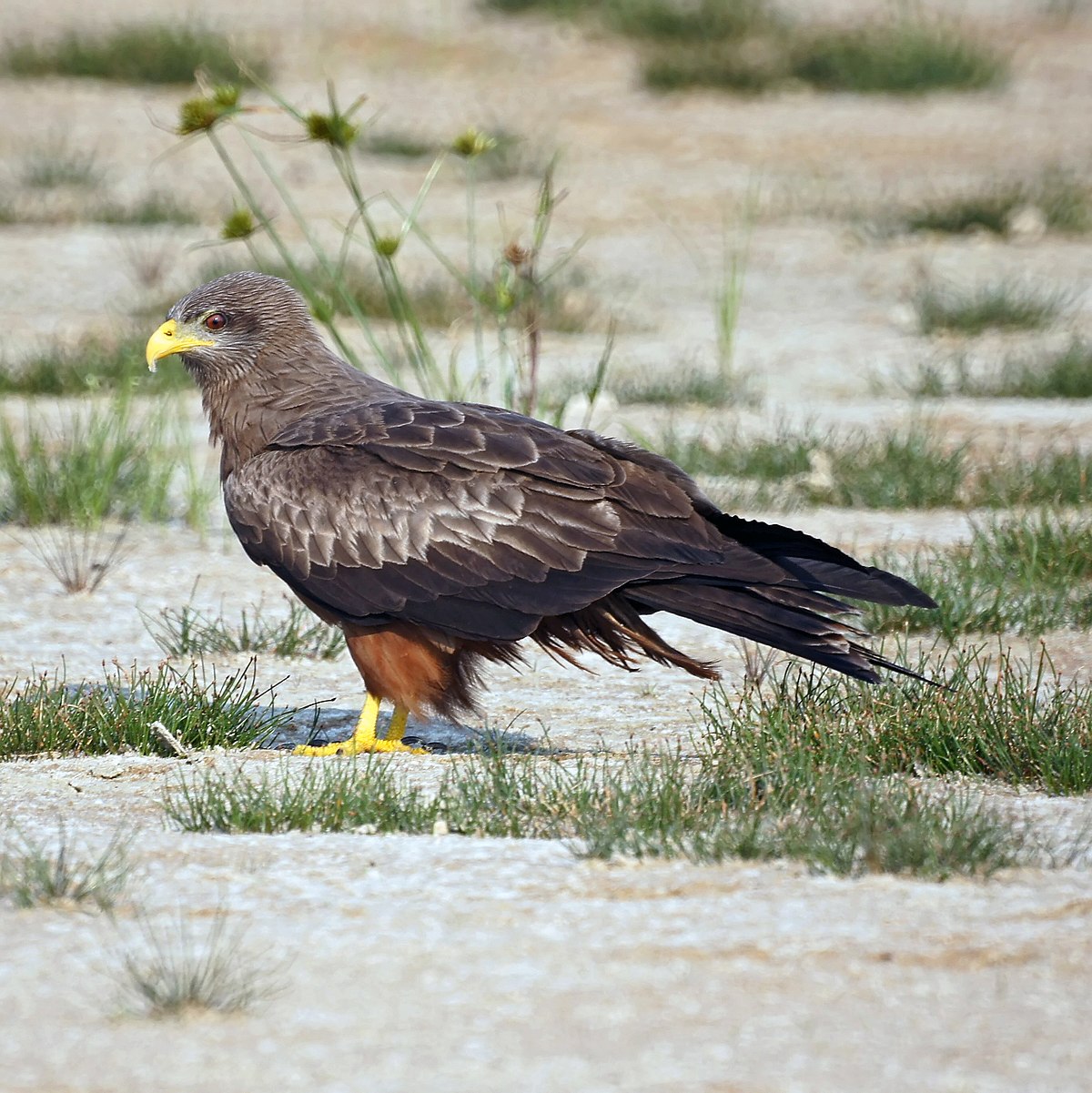
Wikipedia: Yellow-billed kite Source: OTHER
1200px-Milvus_aegyptius_-Limpopo%2C_South_Africa-8.jpg
![]() The yellow-billed kite (Milvus aegyptius) is the Afrotropic counterpart of the black kite (Milvus migrans), of which it is most often considered a subspecies. However, recent DNA studies suggest that the yellow-billed kite differs significantly from black kites in the Eurasian clade, and should be considered as a separate, allopatric species.[2]
[more]
The yellow-billed kite (Milvus aegyptius) is the Afrotropic counterpart of the black kite (Milvus migrans), of which it is most often considered a subspecies. However, recent DNA studies suggest that the yellow-billed kite differs significantly from black kites in the Eurasian clade, and should be considered as a separate, allopatric species.[2]
[more]

Wikipedia: European honey-buzzard Source: OTHER
1200px-Wespenbussard_European_honey_buzzard_Pernis_apivorus%2C_crop.jpg
![]() The European honey buzzard (Pernis apivorus), also known as the pern or common pern,[2] is a bird of prey in the family Accipitridae.
[more]
The European honey buzzard (Pernis apivorus), also known as the pern or common pern,[2] is a bird of prey in the family Accipitridae.
[more]
Calls: ![]() Call an ascending, then descending; "pjuuuuu" much thinner than buzzards, and with a distinct register break when changing pitch. May be confused with newly fledged Buzzard chicks. [Link]
Call an ascending, then descending; "pjuuuuu" much thinner than buzzards, and with a distinct register break when changing pitch. May be confused with newly fledged Buzzard chicks. [Link]
Physical details: length=52-60 cm,
wingspan=135-150 cm,
weight=360-1050 g
Habitats:
Agricultural

Wikipedia: Wahlberg's eagle Source: OTHER
Aquila_wahlbergi.jpg
General: ![]() Wahlberg's eagle (Hieraaetus wahlbergi) is a bird of prey that is native to sub-Saharan Africa, where it is a seasonal migrant in the woodlands and savannas.[1]
It is named after the Swedish naturalist Johan August Wahlberg. Like all eagles, it belongs to the family Accipitridae.
[more]
Wahlberg's eagle (Hieraaetus wahlbergi) is a bird of prey that is native to sub-Saharan Africa, where it is a seasonal migrant in the woodlands and savannas.[1]
It is named after the Swedish naturalist Johan August Wahlberg. Like all eagles, it belongs to the family Accipitridae.
[more]
Profile Wikipedia eBird Xeno-Canto

Wikipedia: Ayres's hawk-eagle Source: OTHER
Ayres%27s_Hawk-eagle_flight_mabira_jan06.jpg
![]() Ayres's hawk-eagle (Hieraaetus ayresii), also referred to as Ayres' eagle,[2] is a medium-sized bird of prey in the family Accipitridae. It is native to African woodlands. Its name honors South African ornithologist Thomas Ayres.[3]
[more]
Ayres's hawk-eagle (Hieraaetus ayresii), also referred to as Ayres' eagle,[2] is a medium-sized bird of prey in the family Accipitridae. It is native to African woodlands. Its name honors South African ornithologist Thomas Ayres.[3]
[more]
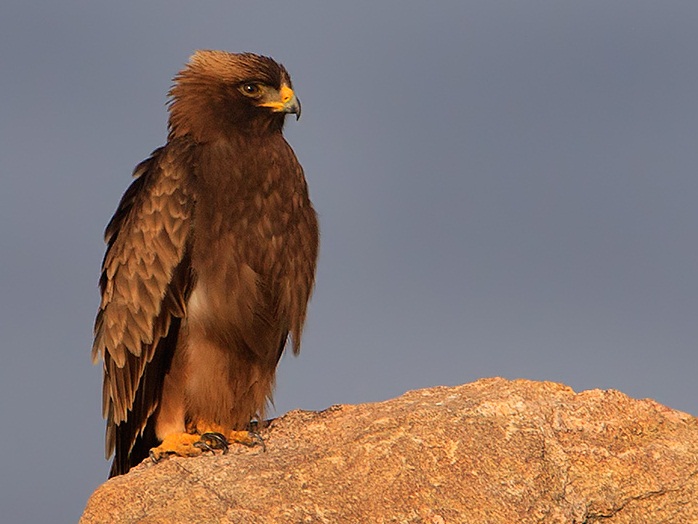
Wikipedia: Booted eagle Source: OTHER
MH_Booted.jpg
![]() The booted eagle (Hieraaetus pennatus, also classified as Aquila pennata) is a medium-sized mostly migratory bird of prey with a wide distribution in the Palearctic and southern Asia, wintering in the tropics of Africa and Asia, with a small, disjunct breeding population in south-western Africa. Like all eagles, it belongs to the family Accipitridae.
[more]
The booted eagle (Hieraaetus pennatus, also classified as Aquila pennata) is a medium-sized mostly migratory bird of prey with a wide distribution in the Palearctic and southern Asia, wintering in the tropics of Africa and Asia, with a small, disjunct breeding population in south-western Africa. Like all eagles, it belongs to the family Accipitridae.
[more]
Vocalization: ![]() Very vocal in breeding season. Most often heard is a quite soft, wader-like series of "kli-kli-kli-kli-kli-kli". [Link]
Very vocal in breeding season. Most often heard is a quite soft, wader-like series of "kli-kli-kli-kli-kli-kli". [Link]
Physical details: length=45-53 cm,
wingspan=100-121 cm,
weight=510-1250 g
Profile Wikipedia eBird Xeno-Canto
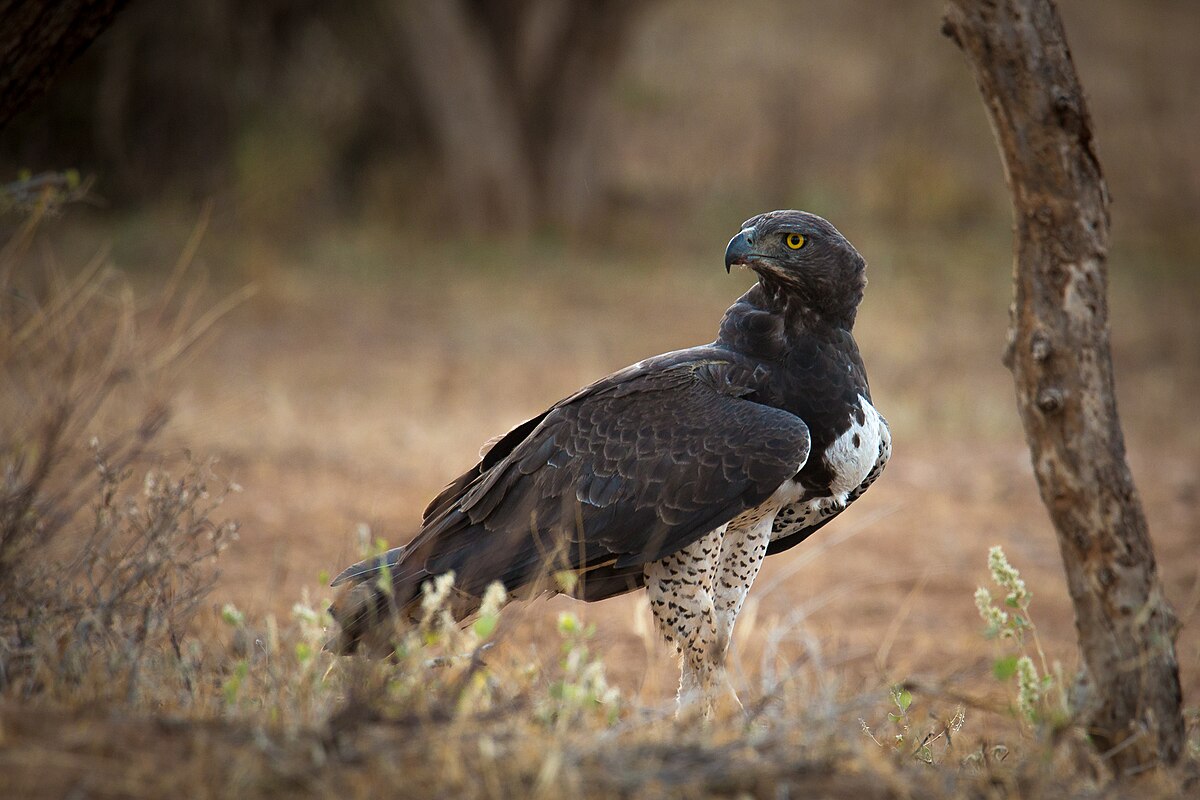
Wikipedia: Martial eagle Source: OTHER
1200px-Martial_Eagle_at_Samburu.jpg
General: ![]() The martial eagle (Polemaetus bellicosus) is a large eagle native to sub-Saharan Africa.[2] It is the only member of the genus Polemaetus. A species of the booted eagle subfamily (Aquilinae), it has feathering over its tarsus. One of the largest and most powerful species of booted eagle, it is a fairly opportunistic predator that varies its prey selection between mammals, birds and reptiles. Its hunting technique is unique as it is one of few eagle species known to hunt primarily from a high soar, by stooping on its quarry.[3] An inhabitant of wooded belts of otherwise open savanna, this species has shown a precipitous decline in the last few centuries due to a variety of factors. The martial eagle is one of the most persecuted bird species in the world. Due to its habit of taking livestock and regionally valuable game, local farmers and game wardens frequently seek to eliminate martial eagles, although the effect of eagles on this prey is almost certainly considerably exaggerated. Currently, the martial eagle is classified with the status of Endangered by the IUCN.[1][4][5]
[more]
The martial eagle (Polemaetus bellicosus) is a large eagle native to sub-Saharan Africa.[2] It is the only member of the genus Polemaetus. A species of the booted eagle subfamily (Aquilinae), it has feathering over its tarsus. One of the largest and most powerful species of booted eagle, it is a fairly opportunistic predator that varies its prey selection between mammals, birds and reptiles. Its hunting technique is unique as it is one of few eagle species known to hunt primarily from a high soar, by stooping on its quarry.[3] An inhabitant of wooded belts of otherwise open savanna, this species has shown a precipitous decline in the last few centuries due to a variety of factors. The martial eagle is one of the most persecuted bird species in the world. Due to its habit of taking livestock and regionally valuable game, local farmers and game wardens frequently seek to eliminate martial eagles, although the effect of eagles on this prey is almost certainly considerably exaggerated. Currently, the martial eagle is classified with the status of Endangered by the IUCN.[1][4][5]
[more]

Wikipedia: Crowned hawk-eagle Source: OTHER
1200px-Crowned_Eagle_%28Stephanoaetus_coronatus%29%2C_at_Ndumo_Nature_Reserve%2C_KwaZulu-Natal%2C_South_Africa_%2828842574882%29.jpg
![]() The crowned eagle, also known as the African crowned eagle or the crowned hawk-eagle (Stephanoaetus coronatus) is a large bird of prey found in sub-Saharan Africa; in Southern Africa it is restricted to eastern areas.[2] Its preferred habitats are principally riparian woodlands and various forests.[2] The crowned eagle is the only extant member of the genus Stephanoaetus. A second species, the Malagasy crowned eagle (Stephanoaetus mahery) became extinct after humans settled on Madagascar.[3]
[more]
The crowned eagle, also known as the African crowned eagle or the crowned hawk-eagle (Stephanoaetus coronatus) is a large bird of prey found in sub-Saharan Africa; in Southern Africa it is restricted to eastern areas.[2] Its preferred habitats are principally riparian woodlands and various forests.[2] The crowned eagle is the only extant member of the genus Stephanoaetus. A second species, the Malagasy crowned eagle (Stephanoaetus mahery) became extinct after humans settled on Madagascar.[3]
[more]

Wikipedia: African baza Source: OTHER
Aviceda_cuculoides00.jpg
![]() The African cuckoo-hawk, or African baza, (Aviceda cuculoides) is a medium-sized raptor in the family Accipitridae so named because it resembles the common cuckoo, which is found in sub-Saharan Africa and along the eastern parts of Southern Africa. It prefers dense woodland and forest of either indigenous or exotic trees.
[more]
The African cuckoo-hawk, or African baza, (Aviceda cuculoides) is a medium-sized raptor in the family Accipitridae so named because it resembles the common cuckoo, which is found in sub-Saharan Africa and along the eastern parts of Southern Africa. It prefers dense woodland and forest of either indigenous or exotic trees.
[more]
Profile Wikipedia eBird Xeno-Canto NABU
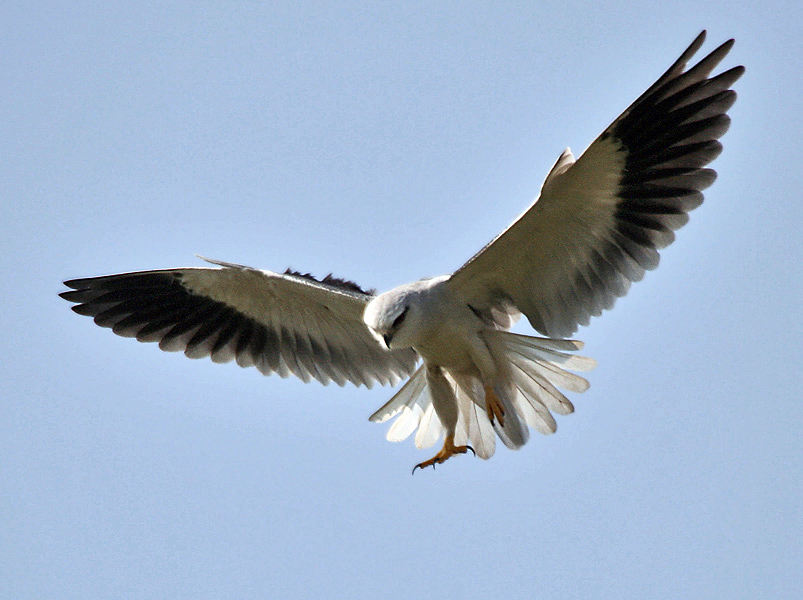
Wikipedia: Black-winged kite Source: OTHER
Black-shouldered_Kite_%28Elanus_caeruleus%29_in_Hyderabad_W_IMG_4418.jpg
![]() The black-winged kite (Elanus caeruleus), also known as the black-shouldered kite (not to be confused with the closely related Australian species with the same name), is a small diurnal bird of prey in the family Accipitridae best known for its habit of hovering over open grasslands in the manner of the much smaller kestrels. This Palearctic and Afrotropical species was sometimes combined with the Australian black-shouldered kite (Elanus axillaris) and the white-tailed kite (Elanus leucurus) of North and South America which together form a superspecies. This kite is distinctive, with long wings; white, grey and black plumage; and owl-like forward-facing eyes with red irises. The owl-like behaviour is even more pronounced in the letter-winged kite (Elanus scriptus), a nocturnal relative in Australia. Although mainly seen on plains, they are sometimes seen on grassy slopes of hills in the higher elevation regions of Asia. They are not migratory, but show nomadism in response to weather and food availability. They are well adapted to utilize periodic upsurges in rodent populations and can raise multiple broods in a single year unlike most birds of prey. Populations in southern Europe have grown in response to human activities, particularly agriculture and livestock rearing.
[more]
The black-winged kite (Elanus caeruleus), also known as the black-shouldered kite (not to be confused with the closely related Australian species with the same name), is a small diurnal bird of prey in the family Accipitridae best known for its habit of hovering over open grasslands in the manner of the much smaller kestrels. This Palearctic and Afrotropical species was sometimes combined with the Australian black-shouldered kite (Elanus axillaris) and the white-tailed kite (Elanus leucurus) of North and South America which together form a superspecies. This kite is distinctive, with long wings; white, grey and black plumage; and owl-like forward-facing eyes with red irises. The owl-like behaviour is even more pronounced in the letter-winged kite (Elanus scriptus), a nocturnal relative in Australia. Although mainly seen on plains, they are sometimes seen on grassy slopes of hills in the higher elevation regions of Asia. They are not migratory, but show nomadism in response to weather and food availability. They are well adapted to utilize periodic upsurges in rodent populations and can raise multiple broods in a single year unlike most birds of prey. Populations in southern Europe have grown in response to human activities, particularly agriculture and livestock rearing.
[more]
Profile Wikipedia eBird Xeno-Canto

Wikipedia: Palm-nut vulture Source: OTHER
Flickr_-_Rainbirder_-_Palm-nut_Vulture.jpg
![]() The palm-nut vulture (Gypohierax angolensis) or vulturine fish eagle, is a large bird of prey in the family Accipitridae (which also includes many other diurnal raptors such as kites, buzzards and harriers, vultures, and eagles). It is the only member of the genus Gypohierax.
[more]
The palm-nut vulture (Gypohierax angolensis) or vulturine fish eagle, is a large bird of prey in the family Accipitridae (which also includes many other diurnal raptors such as kites, buzzards and harriers, vultures, and eagles). It is the only member of the genus Gypohierax.
[more]
Profile Wikipedia eBird Xeno-Canto

Wikipedia: Bateleur Source: OTHER
Bateleur_Eagle_with_Kill.jpg
![]() The bateleur (Terathopius ecaudatus) is a medium-sized eagle in the family Accipitridae. Its closest relatives are the snake eagles. It is the only member of the genus Terathopius and may be the origin of the "Zimbabwe Bird", the national emblem of Zimbabwe.[2] It is native to Africa and small parts of Arabia. "Bateleur" is French for "street performer".[3]
[more]
The bateleur (Terathopius ecaudatus) is a medium-sized eagle in the family Accipitridae. Its closest relatives are the snake eagles. It is the only member of the genus Terathopius and may be the origin of the "Zimbabwe Bird", the national emblem of Zimbabwe.[2] It is native to Africa and small parts of Arabia. "Bateleur" is French for "street performer".[3]
[more]

Wikipedia: Long-crested eagle Source: OTHER
1200px-Long-crested_eagle_%28Lophaetus_occipitalis%29_Uganda.jpg
![]() The long-crested eagle (Lophaetus occipitalis) is an African bird of prey. Like all eagles, it is in the family Accipitridae. It is currently placed in a monotypic genus Lophaetus.
[more]
The long-crested eagle (Lophaetus occipitalis) is an African bird of prey. Like all eagles, it is in the family Accipitridae. It is currently placed in a monotypic genus Lophaetus.
[more]

Wikipedia: Dark chanting-goshawk Source: OTHER
1200px-Melierax_metabates_-Kapama_Game_Reserve%2C_South_Africa-8-4c.jpg
![]() The dark chanting goshawk (Melierax metabates) is a bird of prey in the family Accipitridae which is found across much of sub-Saharan Africa and southern Arabia, with an isolated and declining population in southern Morocco.
[more]
The dark chanting goshawk (Melierax metabates) is a bird of prey in the family Accipitridae which is found across much of sub-Saharan Africa and southern Arabia, with an isolated and declining population in southern Morocco.
[more]
Profile Wikipedia eBird Xeno-Canto

Wikipedia: Pale chanting-goshawk Source: OTHER
1200px-Melierax_canorus-01.jpg
![]() The (southern) pale chanting goshawk (Melierax canorus) is a bird of prey in the family Accipitridae.
This hawk breeds in southern Africa and is a resident species of dry, open semi-desert with 75 cm or less annual rainfall. It is commonly seen perched on roadside telephone poles.
[more]
The (southern) pale chanting goshawk (Melierax canorus) is a bird of prey in the family Accipitridae.
This hawk breeds in southern Africa and is a resident species of dry, open semi-desert with 75 cm or less annual rainfall. It is commonly seen perched on roadside telephone poles.
[more]
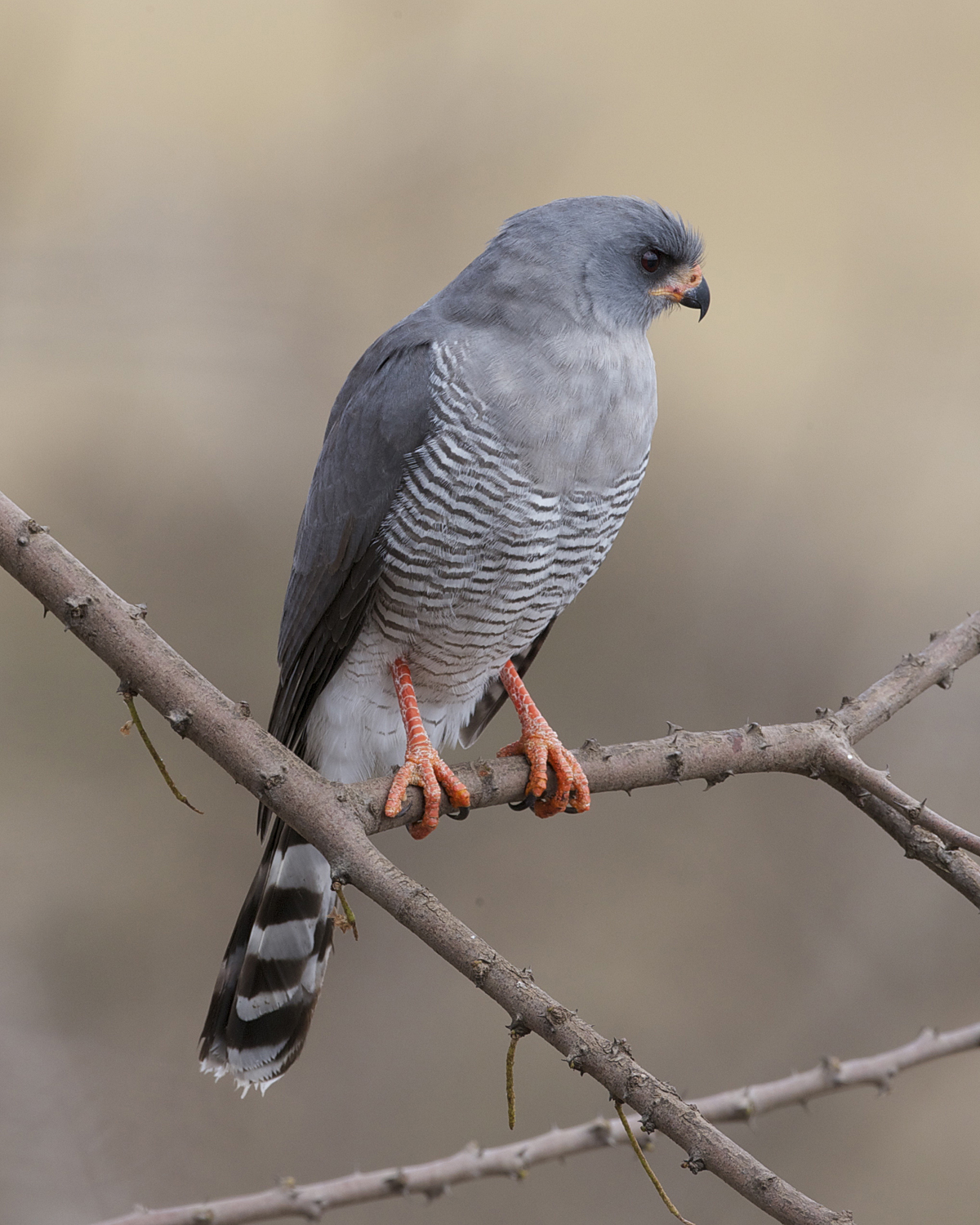
Wikipedia: Gabar goshawk Source: OTHER
Gabar_Goshawk_%28Micronisus_gabar%29.jpg
![]() The gabar goshawk (Micronisus gabar) is a small species of African and Arabian bird of prey in the family Accipitridae.
[more]
The gabar goshawk (Micronisus gabar) is a small species of African and Arabian bird of prey in the family Accipitridae.
[more]
Profile Wikipedia eBird Xeno-Canto

Wikipedia: Bat hawk Source: OTHER
1200px-MacheiramphusAlcinus.jpg
![]() The bat hawk (Macheiramphus alcinus) is a raptor found in sub-Saharan Africa and south Asia to New Guinea. It is named for its diet, which consists mainly of bats.[2] It requires open space in which to hunt, but will live anywhere from dense rainforest to semi-arid veld.
[more]
The bat hawk (Macheiramphus alcinus) is a raptor found in sub-Saharan Africa and south Asia to New Guinea. It is named for its diet, which consists mainly of bats.[2] It requires open space in which to hunt, but will live anywhere from dense rainforest to semi-arid veld.
[more]
Lizard buzzard / Sperberbussard (Kaupifalco monogrammicus)
Profile Wikipedia eBird Xeno-Canto

Wikipedia: Lizard buzzard Source: OTHER
Lizard_buzzard_%28Kaupifalco_monogrammicus%29.jpg
![]() The lizard buzzard (Kaupifalco monogrammicus) or lizard hawk, is a bird of prey in the family Accipitridae. It is native to Sub-Saharan Africa. Despite its name, it may be more closely related to the Accipiter hawks than the Buteo buzzards.
[more]
The lizard buzzard (Kaupifalco monogrammicus) or lizard hawk, is a bird of prey in the family Accipitridae. It is native to Sub-Saharan Africa. Despite its name, it may be more closely related to the Accipiter hawks than the Buteo buzzards.
[more]
Lesser spotted eagle / Schreiadler (Clanga pomarina)
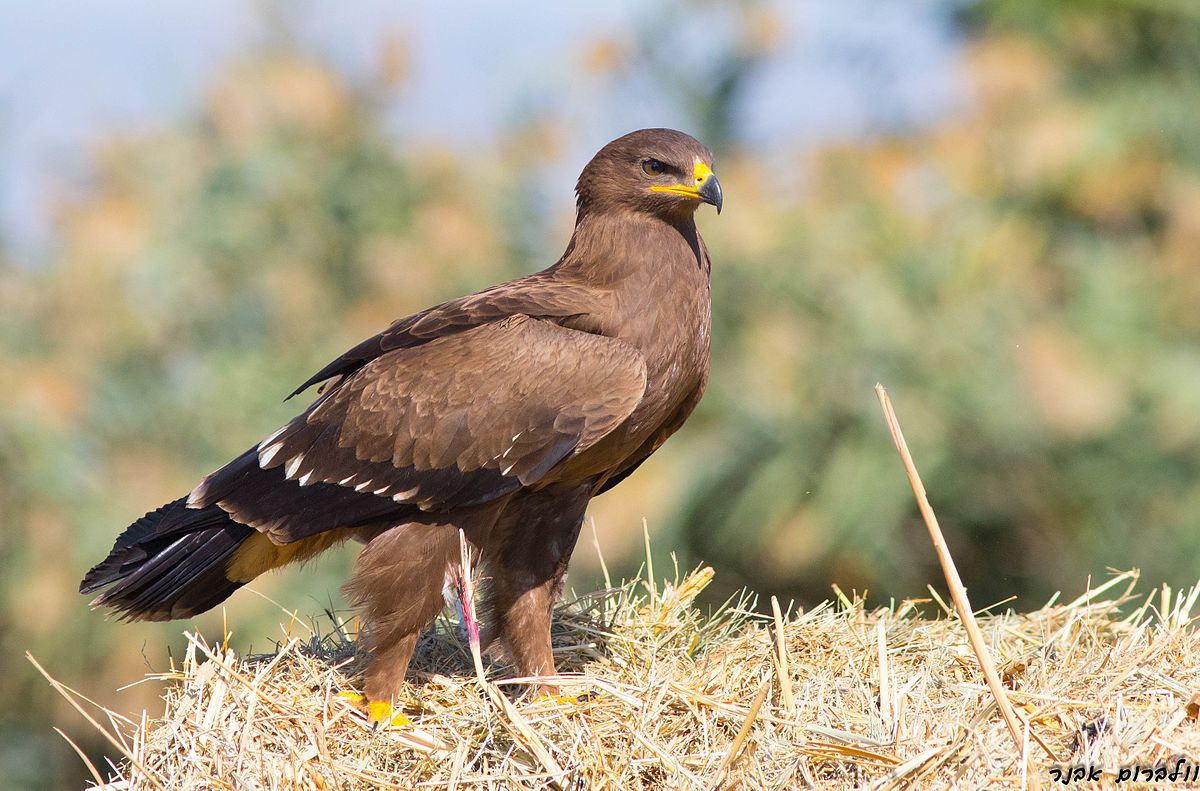
Wikipedia: Lesser spotted eagle Source: OTHER
1200px-%D7%A2%D7%99%D7%98_%D7%97%D7%95%D7%A8%D7%A9.jpg
![]() The lesser spotted eagle (Clanga pomarina) is a large Eastern European bird of prey. Like all typical eagles, it belongs to the family Accipitridae. The typical eagles are often united with the buteos, sea eagles, and other more heavy-set Accipitridae, but more recently it appears as if they are less distinct from the more slender accipitrine hawks than believed.
[more]
The lesser spotted eagle (Clanga pomarina) is a large Eastern European bird of prey. Like all typical eagles, it belongs to the family Accipitridae. The typical eagles are often united with the buteos, sea eagles, and other more heavy-set Accipitridae, but more recently it appears as if they are less distinct from the more slender accipitrine hawks than believed.
[more]
Vocalization: ![]() Vocal at breeding ground, and when courting. Short, barking, high-pitched whistles, not unlike a small dog. Slightly higher pitched than C. clanga and with a purer tone, but very similar. [Link]
Vocal at breeding ground, and when courting. Short, barking, high-pitched whistles, not unlike a small dog. Slightly higher pitched than C. clanga and with a purer tone, but very similar. [Link]
Physical details: length=60-65 cm,
wingspan=134-159 cm,
weight=1100-2000 g
Song:
Automatically generated from Xeno-Canto recording
Song attributes:
Frequency:
♫ Source: BirdNet
2020-07-01 08.18.50 four note call - birdnet suggested lesser spotted eagle which doesnt occur here, next song thrush.mp3
2020-07-01 08.18.50 Luppmen (song)
Secretarybird / Sekretär (Vogel) (Sagittarius serpentarius)
Profile Wikipedia eBird Xeno-Canto

Secretarybird 2. 2016-09-13 14.10.50 Namibia
First observed in Namibia on 2016-09-13.
General: ![]() The secretarybird or secretary bird (Sagittarius serpentarius) is a large, mostly terrestrial bird of prey. Endemic to Africa, it is usually found in the open grasslands and savanna of the sub-Saharan region. John Frederick Miller described the species in 1779. Although a member of the order Accipitriformes, which also includes many other diurnal birds of prey such as kites, hawks, vultures, and harriers, it is placed in its own family, Sagittariidae.
[more]
The secretarybird or secretary bird (Sagittarius serpentarius) is a large, mostly terrestrial bird of prey. Endemic to Africa, it is usually found in the open grasslands and savanna of the sub-Saharan region. John Frederick Miller described the species in 1779. Although a member of the order Accipitriformes, which also includes many other diurnal birds of prey such as kites, hawks, vultures, and harriers, it is placed in its own family, Sagittariidae.
[more]
Osprey / Fischadler (Pandion haliaetus)
Osprey in flight. 2023-09-27 12.22.08 Florida
First observed in Yucatan on 2023-04-21.
This bird appears across the great seas in the following continents:
Europe, North America, South America, Africa, Asia.
![]() Falco haliaetus Linnaeus, 1758
[more]
Falco haliaetus Linnaeus, 1758
[more]
Calls: ![]() Calls with sequences of short, soft and clear whistling notes. Often in series with rising pitch, then ending with a few lower pitched notes. [Link]
Calls with sequences of short, soft and clear whistling notes. Often in series with rising pitch, then ending with a few lower pitched notes. [Link]
Physical details: length=55-58 cm,
wingspan=145-170 cm,
weight=1120-2050 g
Habitats:
Agricultural
Song:
Automatically generated from Xeno-Canto recording
Song attributes:
Frequency:
♫ 2023-10-12 15 55 surprising sound of an osprey. 2023-10-12 15.55.00 New England (song)
Ostriches. 2016-09-14 16.29.48 Namibia
First observed in Gqeberha (former Port Elisabeth) on 2009-10-20.
General: ![]() Der Afrikanische Strauß (Struthio camelus) ist eine Vogelart aus der Familie der Strauße und ist nach dem eng verwandten Somalistrauß der größte lebende Vogel der Erde. Während er heute nur noch in Afrika südlich der Sahara heimisch ist, war er in früheren Zeiten auch in Westasien beheimatet. Für den Menschen war der Strauß wegen seiner Federn, seines Fleisches und seines Leders seit jeher von Interesse, was in vielen Regionen zur Ausrottung des Vogels führte.
[more]
Der Afrikanische Strauß (Struthio camelus) ist eine Vogelart aus der Familie der Strauße und ist nach dem eng verwandten Somalistrauß der größte lebende Vogel der Erde. Während er heute nur noch in Afrika südlich der Sahara heimisch ist, war er in früheren Zeiten auch in Westasien beheimatet. Für den Menschen war der Strauß wegen seiner Federn, seines Fleisches und seines Leders seit jeher von Interesse, was in vielen Regionen zur Ausrottung des Vogels führte.
[more]
Profile Wikipedia eBird Xeno-Canto
![]()
Wikipedia: Abdim's stork Source: OTHER
Ciconia_abdimii_-London_Zoo-8a.jpg
![]() Abdim's stork (Ciconia abdimii), also known as the white-bellied stork, is a stork belonging to the family Ciconiidae. The common name commemorates the Turkish Governor of Wadi Halfa in Sudan, Bey El-Arnaut Abdim (1780–1827).[2]
[more]
Abdim's stork (Ciconia abdimii), also known as the white-bellied stork, is a stork belonging to the family Ciconiidae. The common name commemorates the Turkish Governor of Wadi Halfa in Sudan, Bey El-Arnaut Abdim (1780–1827).[2]
[more]
![]()
Wikipedia: Woolly-necked stork Source: OTHER
Woolly-necked_Stork_%28Ciconia_episcopus%29_Photograph_By_Shantanu_Kuveskar.jpg
![]() The woolly-necked stork or white-necked stork (Ciconia episcopus) is a large wading bird in the stork family Ciconiidae. It breeds singly, or in small loose colonies. It is distributed in a wide variety of habitats including marshes in forests, agricultural areas, and freshwater wetlands across Asia and Africa.[2][3]
[more]
The woolly-necked stork or white-necked stork (Ciconia episcopus) is a large wading bird in the stork family Ciconiidae. It breeds singly, or in small loose colonies. It is distributed in a wide variety of habitats including marshes in forests, agricultural areas, and freshwater wetlands across Asia and Africa.[2][3]
[more]
Profile Wikipedia eBird Vogelwarte BirdLife ZH ornitho.ch Xeno-Canto BirdID NABU
Schwarzstorch zum ersten Mal gesehen bei Degersheim! 2024-04-27 10.50.00 Schachen, Tobel Wissbach till Degersheim
First observed in 🇨🇭 on 2024-04-27.
![]() The black stork (Ciconia nigra) is a large bird in the stork family Ciconiidae. It was first described by Carl Linnaeus in the 10th edition of his Systema Naturae. Measuring on average 95 to 100 cm (37 to 39 in) from beak tip to end of tail with a 145-to-155 cm (57-to-61 in) wingspan, the adult black stork has mainly black plumage, with white underparts, long red legs and a long pointed red beak. A widespread but uncommon species, it breeds in scattered locations across Europe (predominantly in Portugal and Spain, and central and eastern parts), and east across the Palearctic to the Pacific Ocean. It is a long-distance migrant, with European populations wintering in tropical Sub-Saharan Africa, and Asian populations in the Indian subcontinent. When migrating between Europe and Africa, it avoids crossing the Mediterranean Sea and detours via the Levant in the east or the Strait of Gibraltar in the west. An isolated, non-migratory, population occurs in Southern Africa.
[more]
The black stork (Ciconia nigra) is a large bird in the stork family Ciconiidae. It was first described by Carl Linnaeus in the 10th edition of his Systema Naturae. Measuring on average 95 to 100 cm (37 to 39 in) from beak tip to end of tail with a 145-to-155 cm (57-to-61 in) wingspan, the adult black stork has mainly black plumage, with white underparts, long red legs and a long pointed red beak. A widespread but uncommon species, it breeds in scattered locations across Europe (predominantly in Portugal and Spain, and central and eastern parts), and east across the Palearctic to the Pacific Ocean. It is a long-distance migrant, with European populations wintering in tropical Sub-Saharan Africa, and Asian populations in the Indian subcontinent. When migrating between Europe and Africa, it avoids crossing the Mediterranean Sea and detours via the Levant in the east or the Strait of Gibraltar in the west. An isolated, non-migratory, population occurs in Southern Africa.
[more]
Vocalization: ![]() Thin, disyllabic "ahhh-li" heard at nest and when courting. One syllable sounds like gasping intake of air, the other is a thin, piping sound. A bit like a cheap, manual, air-mattress pump. Bill-clattering used by juveniles in alarm. [Link]
Thin, disyllabic "ahhh-li" heard at nest and when courting. One syllable sounds like gasping intake of air, the other is a thin, piping sound. A bit like a cheap, manual, air-mattress pump. Bill-clattering used by juveniles in alarm. [Link]
Physical details: length=95-100 cm,
wingspan=145-155 cm,
weight=3000 g
Habitats:
Wetland
Profile Wikipedia eBird Xeno-Canto NABU

Wikipedia: Yellow-billed stork Source: OTHER
1200px-Yellow-billed_Stork_%28Mycteria_ibis%29_%286045310265%29.jpg
General: ![]() The yellow-billed stork (Mycteria ibis), sometimes also called the wood stork or wood ibis, is a large African wading stork species in the family Ciconiidae. It is widespread in regions south of the Sahara and also occurs in Madagascar.
[more]
The yellow-billed stork (Mycteria ibis), sometimes also called the wood stork or wood ibis, is a large African wading stork species in the family Ciconiidae. It is widespread in regions south of the Sahara and also occurs in Madagascar.
[more]
Marabu stork. 2016-09-23 17.48.46 Botswana
First observed in Botswana on 2016-09-23.
![]() The marabou stork (Leptoptilos crumenifer) is a large wading bird in the stork family Ciconiidae. It breeds in Africa south of the Sahara, in both wet and arid habitats, often near human habitation, especially landfill sites. It is sometimes called the "undertaker bird" due to its shape from behind: cloak-like wings and back, skinny white legs, and sometimes a large white mass of "hair".
[more]
The marabou stork (Leptoptilos crumenifer) is a large wading bird in the stork family Ciconiidae. It breeds in Africa south of the Sahara, in both wet and arid habitats, often near human habitation, especially landfill sites. It is sometimes called the "undertaker bird" due to its shape from behind: cloak-like wings and back, skinny white legs, and sometimes a large white mass of "hair".
[more]
Profile Wikipedia eBird Xeno-Canto

Wikipedia: Saddle-billed stork Source: OTHER
1200px-Ephippiorhynchus_senegalensis_-Kruger_National_Park%2C_Limpopo%2C_South_Africa-8.jpg
![]() The saddle-billed stork, or saddlebill (Ephippiorhynchus senegalensis) is a large wading bird in the stork family, Ciconiidae. It is a widespread species which is a resident breeder in sub-Saharan Africa from Sudan, Ethiopia and Kenya south to South Africa, and in The Gambia, Senegal, Côte d'Ivoire and Chad in west Africa.[3] It is considered endangered in South Africa.
[more]
The saddle-billed stork, or saddlebill (Ephippiorhynchus senegalensis) is a large wading bird in the stork family, Ciconiidae. It is a widespread species which is a resident breeder in sub-Saharan Africa from Sudan, Ethiopia and Kenya south to South Africa, and in The Gambia, Senegal, Côte d'Ivoire and Chad in west Africa.[3] It is considered endangered in South Africa.
[more]
Profile Wikipedia eBird Xeno-Canto
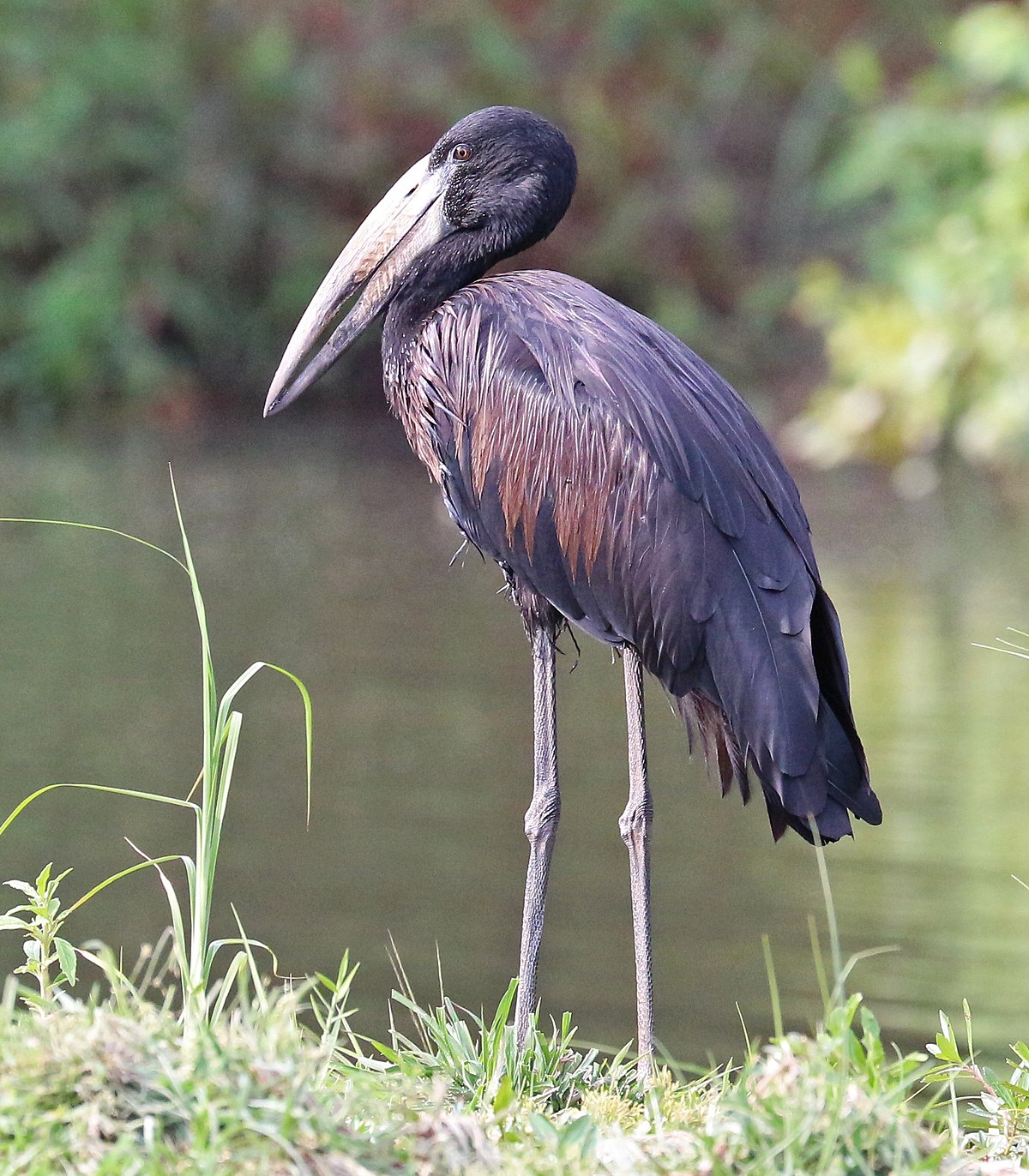
Wikipedia: African openbill Source: OTHER
1200px-African_openbill%2C_Zimbabwe%2C_crop.jpg
![]() The African openbill (Anastomus lamelligerus) is a species of stork in the family Ciconiidae. It is native to large parts of sub-Saharan Africa.
[more]
The African openbill (Anastomus lamelligerus) is a species of stork in the family Ciconiidae. It is native to large parts of sub-Saharan Africa.
[more]
Profile Wikipedia eBird Xeno-Canto
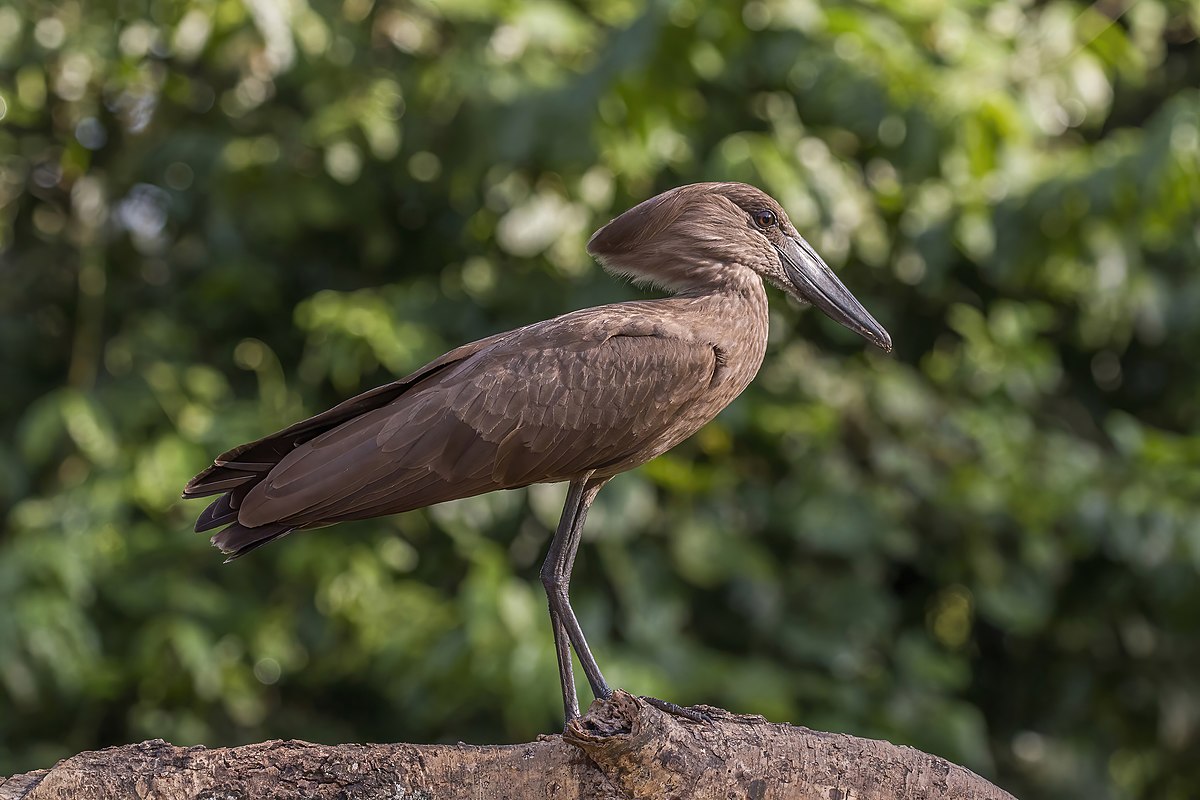
Wikipedia: Hamerkop Source: OTHER
1200px-Hamerkop_%28Scopus_umbretta_umbretta%29.jpg
![]() The hamerkop (Scopus umbretta), is a medium-sized wading bird. It is the only living species in the genus Scopus and the family Scopidae. The species and family was long thought to sit with the Ciconiiformes but is now placed with the Pelecaniformes, and its closest relatives are thought to be the pelicans and shoebill. The shape of its head with a long bill and crest at the back is reminiscent of a hammer, which has given this species its name after the Afrikaans word for hammerhead. It is a medium-sized waterbird with brown plumage. It is found in Africa, Madagascar and Arabia, living in a wide variety of wetlands, including estuaries, lakesides, fish ponds, riverbanks, and rocky coasts. The hamerkop is a sedentary bird that often shows local movements.
[more]
The hamerkop (Scopus umbretta), is a medium-sized wading bird. It is the only living species in the genus Scopus and the family Scopidae. The species and family was long thought to sit with the Ciconiiformes but is now placed with the Pelecaniformes, and its closest relatives are thought to be the pelicans and shoebill. The shape of its head with a long bill and crest at the back is reminiscent of a hammer, which has given this species its name after the Afrikaans word for hammerhead. It is a medium-sized waterbird with brown plumage. It is found in Africa, Madagascar and Arabia, living in a wide variety of wetlands, including estuaries, lakesides, fish ponds, riverbanks, and rocky coasts. The hamerkop is a sedentary bird that often shows local movements.
[more]
Profile Wikipedia eBird Xeno-Canto

Wikipedia: Namaqua sandgrouse Source: OTHER
1200px-2012-namaqua-sandgrouse-male.jpg
![]() The Namaqua sandgrouse (Pterocles namaqua), is a species of ground-dwelling bird in the sandgrouse family. It is found in arid regions of south-western Africa.
[more]
The Namaqua sandgrouse (Pterocles namaqua), is a species of ground-dwelling bird in the sandgrouse family. It is found in arid regions of south-western Africa.
[more]
Profile Wikipedia eBird Xeno-Canto

Wikipedia: Yellow-throated sandgrouse
![]() The yellow-throated sandgrouse (Pterocles gutturalis) is a species of bird in the family Pteroclidae.
[more]
The yellow-throated sandgrouse (Pterocles gutturalis) is a species of bird in the family Pteroclidae.
[more]
Profile Wikipedia eBird Xeno-Canto

Wikipedia: Burchell's sandgrouse Source: OTHER
Burchell%27s_Sandgrouse_-_Etosha_0010.jpg
![]() Burchell's sandgrouse (Pterocles burchelli) is a species of bird in the family Pteroclidae. It is found in arid and semi-arid regions of southern Africa. The name of this bird commemorates the English naturalist William John Burchell.[2]
[more]
Burchell's sandgrouse (Pterocles burchelli) is a species of bird in the family Pteroclidae. It is found in arid and semi-arid regions of southern Africa. The name of this bird commemorates the English naturalist William John Burchell.[2]
[more]
Profile Wikipedia eBird Xeno-Canto

Wikipedia: Double-banded sandgrouse Source: OTHER
1200px-Pterocles_bicinctus_-Kruger_National_Park%2C_South_Africa_-two-8.jpg
![]() The double-banded sandgrouse (Pterocles bicinctus) is a species of ground-living bird in the family Pteroclidae. It is found in arid parts of southern Africa.
[more]
The double-banded sandgrouse (Pterocles bicinctus) is a species of ground-living bird in the family Pteroclidae. It is found in arid parts of southern Africa.
[more]
Profile Wikipedia eBird Xeno-Canto
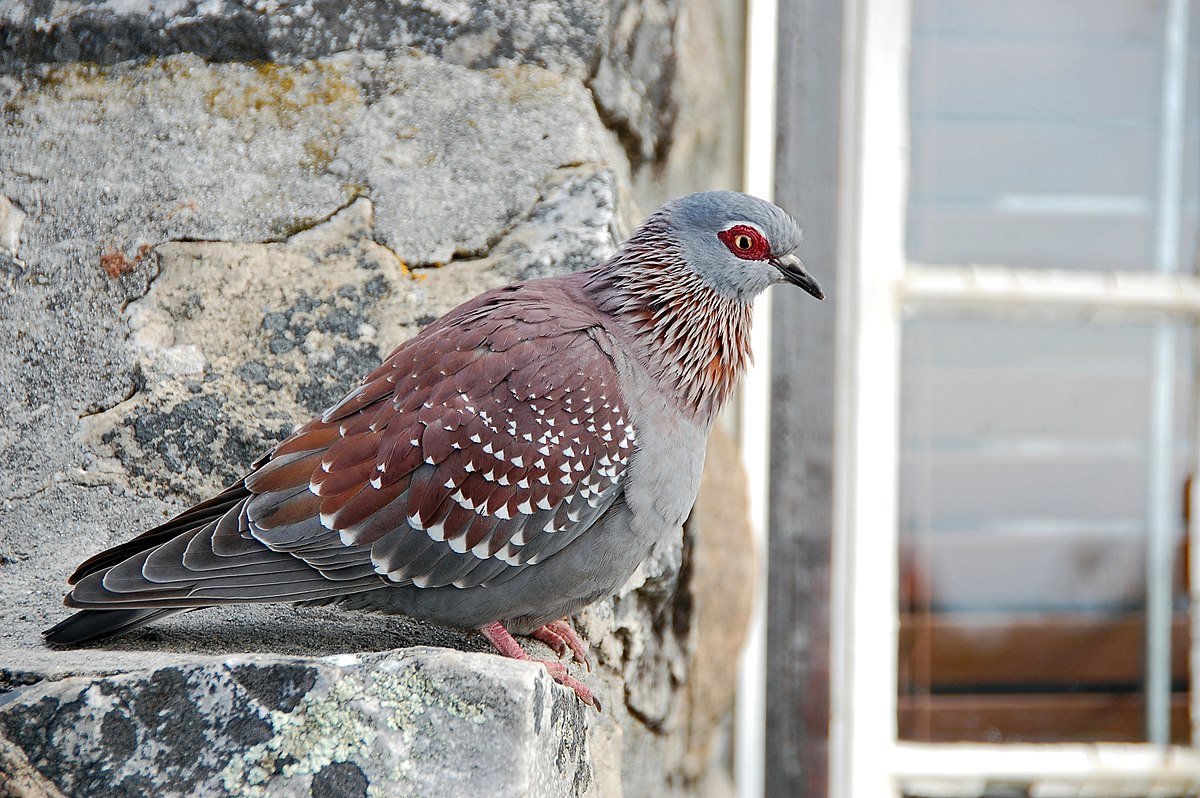
Wikipedia: Speckled pigeon Source: OTHER
1200px-Speckledpigeon.JPG
![]() The speckled pigeon (Columba guinea), or (African) rock pigeon, is a pigeon that is a resident breeding bird in much of Africa south of the Sahara. It is a common and widespread species in open habitats over much of its range, although there are sizable gaps in its distribution. It is sometimes referred to as the Guinea pigeon due to its similar coloring to some species of guineafowl.
[more]
The speckled pigeon (Columba guinea), or (African) rock pigeon, is a pigeon that is a resident breeding bird in much of Africa south of the Sahara. It is a common and widespread species in open habitats over much of its range, although there are sizable gaps in its distribution. It is sometimes referred to as the Guinea pigeon due to its similar coloring to some species of guineafowl.
[more]
Profile Wikipedia eBird Xeno-Canto

Wikipedia: Rameron pigeon Source: OTHER
Pigeon_African_Olive_2011_09_19_07_51_51_6049_crop.jpg
![]() The African olive pigeon or Rameron pigeon (Columba arquatrix) is a pigeon which is a resident breeding bird in much of eastern and southern Africa from Ethiopia to the Cape. Populations also are found in western Angola, southwestern Saudi Arabia and northern Yemen. It is locally common, although sizeable gaps in its distribution occur due to its habitat requirements.
[more]
The African olive pigeon or Rameron pigeon (Columba arquatrix) is a pigeon which is a resident breeding bird in much of eastern and southern Africa from Ethiopia to the Cape. Populations also are found in western Angola, southwestern Saudi Arabia and northern Yemen. It is locally common, although sizeable gaps in its distribution occur due to its habitat requirements.
[more]
Profile Wikipedia eBird Xeno-Canto
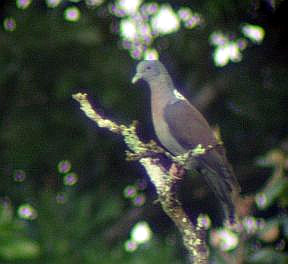
Wikipedia: Delegorgue's pigeon Source: OTHER
Delegorgues_Pigeon_%28Columba_delegorguei%29_in_tree.jpg
![]() The eastern bronze-naped pigeon (Columba delegorguei) is a species of bird in the family Columbidae. It is found in Angola, Kenya, Malawi, Mozambique, South Africa, South Sudan, Tanzania, Uganda, Zambia, and Zimbabwe. It is part of the Turturoena subgenus. The species is named after the collector, Adulphe Delegorgue.
[more]
The eastern bronze-naped pigeon (Columba delegorguei) is a species of bird in the family Columbidae. It is found in Angola, Kenya, Malawi, Mozambique, South Africa, South Sudan, Tanzania, Uganda, Zambia, and Zimbabwe. It is part of the Turturoena subgenus. The species is named after the collector, Adulphe Delegorgue.
[more]
Rock pigeons at bay in St Petersburg. 2023-09-23 19.15.24 Florida
First observed in 🇨🇭 on 2021-04-18.
This bird appears across the great seas in the following continents:
Europe, North America, South America, Africa, Asia.
![]() The rock dove, rock pigeon, or common pigeon (/ˈpɪdʒ.ən/ also /ˈpɪdʒ.ɪn/; Columba livia) is a member of the bird family Columbidae (doves and pigeons).[3]:624 In common usage, this bird is often simply referred to as the "pigeon".
[more]
The rock dove, rock pigeon, or common pigeon (/ˈpɪdʒ.ən/ also /ˈpɪdʒ.ɪn/; Columba livia) is a member of the bird family Columbidae (doves and pigeons).[3]:624 In common usage, this bird is often simply referred to as the "pigeon".
[more]
Vocalization: ![]() Not loud. [Link]
Not loud. [Link]
Song: ![]() Song a two-syllable, but continuous cooing. First a rolling ascending "orrrrrr" immediately followed by a short descending "oohh". Wings produce a quite audible whistling sound. [Link]
Song a two-syllable, but continuous cooing. First a rolling ascending "orrrrrr" immediately followed by a short descending "oohh". Wings produce a quite audible whistling sound. [Link]
Physical details: length=31-34 cm,
wingspan=63-70 cm,
weight=230-370 g
Habitats:
Settlement
Song:
Automatically generated from Xeno-Canto recording
Song attributes:
Frequency:
♫ Source: BirdNet
20210418_155851 birdnet 1445 - Rock Pigeon and Mistle Thrush clatter - Rock Pigeon - Fehraltorf.mp3
2021-04-18 15.58.51 Fehraltorf (song)

Wikipedia: Laughing dove Source: OTHER
1200px-Laughing_dove_%28Spilopelia_senegalensis_cambayensis%29.jpg
General: ![]() The laughing dove (Spilopelia senegalensis) is a small pigeon that is a resident breeder in Africa, the Middle East, the Indian Subcontinent, and Western Australia where it has established itself in the wild around Perth and Fremantle. This small long-tailed dove is found in dry scrub and semi-desert habitats where pairs can often be seen feeding on the ground. A rufous and black chequered necklace gives it a distinctive pattern and is also easily distinguished from other doves by its call. Other names include laughing turtle dove, palm dove and Senegal dove while in India the name of the little brown dove is often used.
[more]
The laughing dove (Spilopelia senegalensis) is a small pigeon that is a resident breeder in Africa, the Middle East, the Indian Subcontinent, and Western Australia where it has established itself in the wild around Perth and Fremantle. This small long-tailed dove is found in dry scrub and semi-desert habitats where pairs can often be seen feeding on the ground. A rufous and black chequered necklace gives it a distinctive pattern and is also easily distinguished from other doves by its call. Other names include laughing turtle dove, palm dove and Senegal dove while in India the name of the little brown dove is often used.
[more]
Profile Wikipedia eBird Xeno-Canto
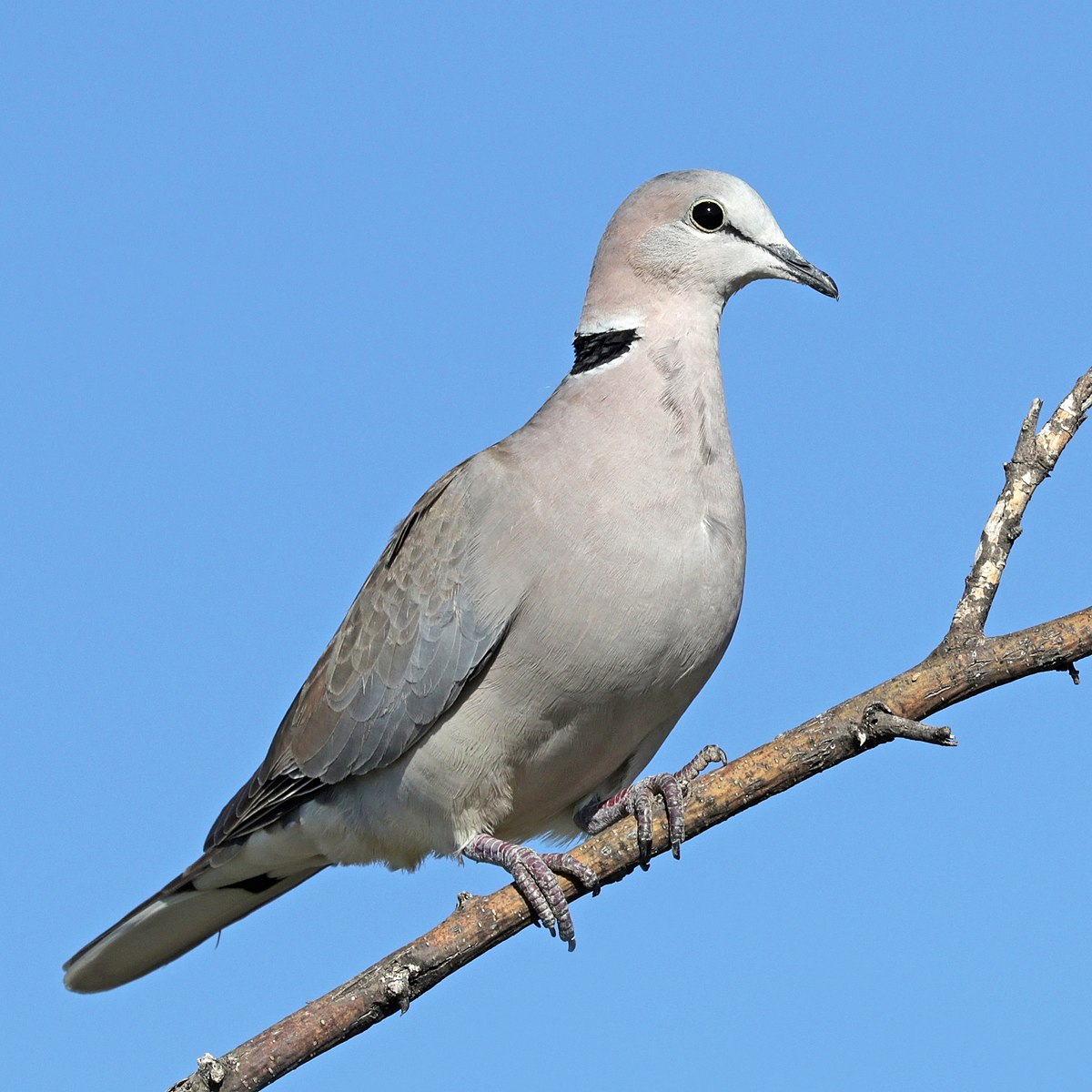
Wikipedia: Ring-necked dove Source: OTHER
1200px-Ring-necked_dove_%28Streptopelia_capicola_damarensis%29.jpg
![]() The ring-necked dove (Streptopelia capicola), also known as the Cape turtle dove or half-collared dove, is a widespread and often abundant dove species in East and southern Africa. It is a mostly sedentary bird,[2][3] found in a variety of open habitats. Within range, its penetrating and rhythmic, three-syllabled crooning is a familiar sound at any time of the year.[3] Its name is derived from the semi-collar of black feathers on the lower nape,[4] a feature shared with a number of Streptopelia species. Like all doves, they depend on surface water. They congregate in large flocks at waterholes in dry regions[2] to drink and bathe.[5]
[more]
The ring-necked dove (Streptopelia capicola), also known as the Cape turtle dove or half-collared dove, is a widespread and often abundant dove species in East and southern Africa. It is a mostly sedentary bird,[2][3] found in a variety of open habitats. Within range, its penetrating and rhythmic, three-syllabled crooning is a familiar sound at any time of the year.[3] Its name is derived from the semi-collar of black feathers on the lower nape,[4] a feature shared with a number of Streptopelia species. Like all doves, they depend on surface water. They congregate in large flocks at waterholes in dry regions[2] to drink and bathe.[5]
[more]
Profile Wikipedia eBird Xeno-Canto

Wikipedia: Mourning collared-dove Source: OTHER
1200px-African_mourning_dove_%28Streptopelia_decipiens_perspicillata%29.jpg
![]() The mourning collared dove or African mourning dove (Streptopelia decipiens) is a dove which is a widespread resident breeding bird in Africa south of the Sahara. Despite its name, it is not related to the North American mourning dove (Zenaida macroura). This species is common or abundant near water. They often mingle peacefully with other doves.
[more]
The mourning collared dove or African mourning dove (Streptopelia decipiens) is a dove which is a widespread resident breeding bird in Africa south of the Sahara. Despite its name, it is not related to the North American mourning dove (Zenaida macroura). This species is common or abundant near water. They often mingle peacefully with other doves.
[more]
Profile Wikipedia eBird Xeno-Canto

Wikipedia: Red-eyed dove Source: OTHER
1200px-Red-eyed_Dove_RWD.jpg
![]() The red-eyed dove (Streptopelia semitorquata) is a dove that is a widespread and common in Sub-Saharan Africa. It has been listed as Least Concern on the IUCN Red List since 2004.[1]
[more]
The red-eyed dove (Streptopelia semitorquata) is a dove that is a widespread and common in Sub-Saharan Africa. It has been listed as Least Concern on the IUCN Red List since 2004.[1]
[more]
Profile Wikipedia eBird Xeno-Canto

Wikipedia: Namaqua dove Source: OTHER
1200px-Oena_capensis_-near_Kambi_ya_Tembo%2C_Arusha%2C_Tanzania-8%2C_crop.jpg
![]() The Namaqua dove (Oena capensis) is a small pigeon. It is the only species in the genus Oena. It is found over much of Sub-Saharan Africa as well as Arabia and Madagascar.
[more]
The Namaqua dove (Oena capensis) is a small pigeon. It is the only species in the genus Oena. It is found over much of Sub-Saharan Africa as well as Arabia and Madagascar.
[more]

Wikipedia: African green-pigeon Source: OTHER
African_Green-Pigeon_%28Treron_calvus%29.jpg
![]() The African green pigeon (Treron calvus) is a species of bird in the family Columbidae, and one of 5 green pigeon species in the Afrotropics. The species has a wide range in Sub-Saharan Africa with around 17 accepted races.[2]
[more]
The African green pigeon (Treron calvus) is a species of bird in the family Columbidae, and one of 5 green pigeon species in the Afrotropics. The species has a wide range in Sub-Saharan Africa with around 17 accepted races.[2]
[more]
Profile Wikipedia eBird Xeno-Canto

Wikipedia: Emerald-spotted wood-dove Source: OTHER
1200px-Emerald-spotted_Wood_Dove_%28Turtur_chalcospilos%29_%2831377518065%29%2C_crop.jpg
![]() The emerald-spotted wood dove (Turtur chalcospilos) is a bird of the family Columbidae, resident across eastern and southern Africa. It is a species of open drier deciduous woodland and second growth. It is absent from evergreen rainforests and semidesert areas.
[more]
The emerald-spotted wood dove (Turtur chalcospilos) is a bird of the family Columbidae, resident across eastern and southern Africa. It is a species of open drier deciduous woodland and second growth. It is absent from evergreen rainforests and semidesert areas.
[more]
Profile Wikipedia eBird Xeno-Canto

Wikipedia: Tambourine dove
![]() The tambourine dove (Turtur tympanistria) is a pigeon which is a widespread resident breeding bird in woodlands and other thick vegetation in Africa south of the Sahara Desert. Its range extends from Senegal east to Ethiopia and Kenya and southwards through eastern Africa to south-eastern South Africa, but it is absent from the drier areas of south-western Africa. There is a population on the Comoros Islands.
[more]
The tambourine dove (Turtur tympanistria) is a pigeon which is a widespread resident breeding bird in woodlands and other thick vegetation in Africa south of the Sahara Desert. Its range extends from Senegal east to Ethiopia and Kenya and southwards through eastern Africa to south-eastern South Africa, but it is absent from the drier areas of south-western Africa. There is a population on the Comoros Islands.
[more]
Profile Wikipedia eBird Xeno-Canto

Wikipedia: Blue-spotted wood-dove Source: OTHER
Turtur_afer_-Gambia-8.jpg
![]() The blue-spotted wood dove (Turtur afer) is a species of bird in the family Columbidae.
It is abundantly present throughout Africa south of the Sahel; it is partially present in East Africa and absent in southern Africa.
[more]
The blue-spotted wood dove (Turtur afer) is a species of bird in the family Columbidae.
It is abundantly present throughout Africa south of the Sahel; it is partially present in East Africa and absent in southern Africa.
[more]
Profile Wikipedia eBird Xeno-Canto

Wikipedia: Half-collared kingfisher Source: OTHER
Half-collared_Kingfisher_-_Malawi_S4E4593.jpg
![]() The half-collared kingfisher (Alcedo semitorquata) is a kingfisher in the subfamily Alcedininae that is found in southern and eastern Africa. It feeds almost exclusively on fish and frequents streams, rivers and larger bodies of water.
[more]
The half-collared kingfisher (Alcedo semitorquata) is a kingfisher in the subfamily Alcedininae that is found in southern and eastern Africa. It feeds almost exclusively on fish and frequents streams, rivers and larger bodies of water.
[more]
Profile Wikipedia eBird Xeno-Canto
Our bed and breakfast host hand-feeding a striped kingfisher with mealworms. 2009-10-23 19.04.54 Gqeberha (former Port Elisabeth)
First observed in Gqeberha (former Port Elisabeth) on 2009-10-23.
![]() The striped kingfisher (Halcyon chelicuti) is a species of bird in the tree kingfisher subfamily. It was first described by Edward, Lord Stanley, in Salt's Voyage to Abyssinia[3] in 1814 as "Chelicut kingfisher" Alaudo Chelicuti.[4]
[more]
The striped kingfisher (Halcyon chelicuti) is a species of bird in the tree kingfisher subfamily. It was first described by Edward, Lord Stanley, in Salt's Voyage to Abyssinia[3] in 1814 as "Chelicut kingfisher" Alaudo Chelicuti.[4]
[more]
Profile Wikipedia eBird Xeno-Canto

Wikipedia: Mangrove kingfisher Source: OTHER
1200px-Halcyon_senegaloides_Saadani_NP%2C_Tanzania_1.jpg
![]() The mangrove kingfisher (Halcyon senegaloides) is a kingfisher in the genus Halcyon. It is similar in appearance to the woodland kingfisher. It is found along the eastern coastline of Sub-Saharan Africa, living in woodland, along rivers, and in estuaries and mangrove. The International Union for Conservation of Nature (IUCN) has assessed it as being of least concern.
[more]
The mangrove kingfisher (Halcyon senegaloides) is a kingfisher in the genus Halcyon. It is similar in appearance to the woodland kingfisher. It is found along the eastern coastline of Sub-Saharan Africa, living in woodland, along rivers, and in estuaries and mangrove. The International Union for Conservation of Nature (IUCN) has assessed it as being of least concern.
[more]

Wikipedia: Brown-hooded kingfisher Source: OTHER
Male_Brown-hooded_Kingfisher%2C_Halcyon_albiventris_caught_a_wasp%2C_Tzaneen_area%2C_Limpopo%2C_South_Africa_%2814710550180%29.jpg
![]() The brown-hooded kingfisher (Halcyon albiventris) is a species of bird in the subfamily Halcyoninae, the tree kingfishers. It has a brown head and blackish and turquoise wings. It is found in Sub-Saharan Africa, living in woodland, scrubland, forest edges, and also suburban areas. The International Union for Conservation of Nature (IUCN) has assessed it as being of least concern.
[more]
The brown-hooded kingfisher (Halcyon albiventris) is a species of bird in the subfamily Halcyoninae, the tree kingfishers. It has a brown head and blackish and turquoise wings. It is found in Sub-Saharan Africa, living in woodland, scrubland, forest edges, and also suburban areas. The International Union for Conservation of Nature (IUCN) has assessed it as being of least concern.
[more]
Profile Wikipedia eBird Xeno-Canto

Wikipedia: Woodland kingfisher Source: OTHER
1200px-Woodland_Kingfisher_%28Halcyon_senegalensis%29_South_Africa.jpg
![]() The woodland kingfisher (Halcyon senegalensis) is a tree kingfisher that is widely distributed in Africa south of the Sahara.
[more]
The woodland kingfisher (Halcyon senegalensis) is a tree kingfisher that is widely distributed in Africa south of the Sahara.
[more]

Wikipedia: Grey-headed kingfisher Source: OTHER
Flickr_-_Rainbirder_-_Grey-headed_Kingfisher_%28Halcyon_leucocephala%29%2C_crop.jpg
![]() The grey-headed kingfisher (Halcyon leucocephala) has a wide distribution from the Cape Verde Islands off the north-west coast of Africa to Mauritania, Senegal and Gambia, east to Ethiopia, Somalia and southern Arabia and south to South Africa.
[more]
The grey-headed kingfisher (Halcyon leucocephala) has a wide distribution from the Cape Verde Islands off the north-west coast of Africa to Mauritania, Senegal and Gambia, east to Ethiopia, Somalia and southern Arabia and south to South Africa.
[more]

Wikipedia: Malachite kingfisher Source: OTHER
1200px-Malachite_kingfisher_%28Corythornis_cristatus_cristatus%29.jpg
![]() The malachite kingfisher (Corythornis cristatus) is a river kingfisher which is widely distributed in Africa south of the Sahara. It is largely resident except for seasonal climate-related movements.
[more]
The malachite kingfisher (Corythornis cristatus) is a river kingfisher which is widely distributed in Africa south of the Sahara. It is largely resident except for seasonal climate-related movements.
[more]

Wikipedia: African pygmy-kingfisher Source: OTHER
Flickr_-_Rainbirder_-_African_pygmy-kingfisher_%28Ceyx_pictus%29.jpg
![]() The African pygmy kingfisher (Ispidina picta) is a small insectivorous kingfisher found in the Afrotropics, mostly in woodland habitats.
[more]
The African pygmy kingfisher (Ispidina picta) is a small insectivorous kingfisher found in the Afrotropics, mostly in woodland habitats.
[more]

Wikipedia: European roller Source: OTHER
1200px-Arrival_%2847961559816%29.jpg
![]() The European roller (Coracias garrulus) is the only member of the roller family of birds to breed in Europe. Its overall range extends into the Middle East, Central Asia and Morocco.
[more]
The European roller (Coracias garrulus) is the only member of the roller family of birds to breed in Europe. Its overall range extends into the Middle East, Central Asia and Morocco.
[more]
Vocalization: ![]() Various dry rasping, sometimes mewing, sounds and short clicks: "ahrahrahrahrahrahrahr" or pulse of clicks: "trrrtrrrrtrr". Also a clearer raptor- or jay-like descending "piiuu". [Link]
Various dry rasping, sometimes mewing, sounds and short clicks: "ahrahrahrahrahrahrahr" or pulse of clicks: "trrrtrrrrtrr". Also a clearer raptor- or jay-like descending "piiuu". [Link]
Physical details: length=30-32 cm,
wingspan=66-73 cm,
weight=120-160 g
Lilac-breasted roller on milestone. 2016-09-27 16.35.18 Botswana
First observed in Botswana on 2016-09-23.
General: ![]() The lilac-breasted roller (Coracias caudatus) is an African bird of the roller family, Coraciidae. It is widely distributed in sub-Saharan Africa, and is a vagrant to the southern Arabian Peninsula.[1] It prefers open woodland and savanna, and it is for the most part absent from treeless places. Usually found alone or in pairs, it perches conspicuously at the tops of trees, poles or other high vantage points from where it can spot insects, lizards, scorpions, snails, small birds and rodents moving about on the ground.[2] Nesting takes place in a natural hole in a tree where a clutch of 2–4 eggs are laid, and incubated by both parents, who are extremely aggressive in defence of their nest, taking on raptors and other birds. During the breeding season the male will rise to a fair height (69 to 144 metres), descending in swoops and dives,[3] while uttering harsh, discordant cries. The sexes are different in coloration, and juveniles lack the long tail streamers of adults. This species is officially considered the national bird of Kenya. Alternate names for the lilac-breasted roller include the fork-tailed roller, lilac-throated roller (also used for a subspecies of purple roller) and Mosilikatze's roller.
[more]
The lilac-breasted roller (Coracias caudatus) is an African bird of the roller family, Coraciidae. It is widely distributed in sub-Saharan Africa, and is a vagrant to the southern Arabian Peninsula.[1] It prefers open woodland and savanna, and it is for the most part absent from treeless places. Usually found alone or in pairs, it perches conspicuously at the tops of trees, poles or other high vantage points from where it can spot insects, lizards, scorpions, snails, small birds and rodents moving about on the ground.[2] Nesting takes place in a natural hole in a tree where a clutch of 2–4 eggs are laid, and incubated by both parents, who are extremely aggressive in defence of their nest, taking on raptors and other birds. During the breeding season the male will rise to a fair height (69 to 144 metres), descending in swoops and dives,[3] while uttering harsh, discordant cries. The sexes are different in coloration, and juveniles lack the long tail streamers of adults. This species is officially considered the national bird of Kenya. Alternate names for the lilac-breasted roller include the fork-tailed roller, lilac-throated roller (also used for a subspecies of purple roller) and Mosilikatze's roller.
[more]

Wikipedia: Racket-tailed roller Source: OTHER
Coracias_spatulatusPCCA20071227-8449B.jpg
![]() The racket-tailed roller (Coracias spatulatus) is a species of bird in the family Coraciidae. It is found in southern Africa from Angola, south-eastern Democratic Republic of Congo and southern Tanzania to northern Botswana, Zimbabwe, Malawi and Mozambique.
[more]
The racket-tailed roller (Coracias spatulatus) is a species of bird in the family Coraciidae. It is found in southern Africa from Angola, south-eastern Democratic Republic of Congo and southern Tanzania to northern Botswana, Zimbabwe, Malawi and Mozambique.
[more]
Profile Wikipedia eBird Xeno-Canto
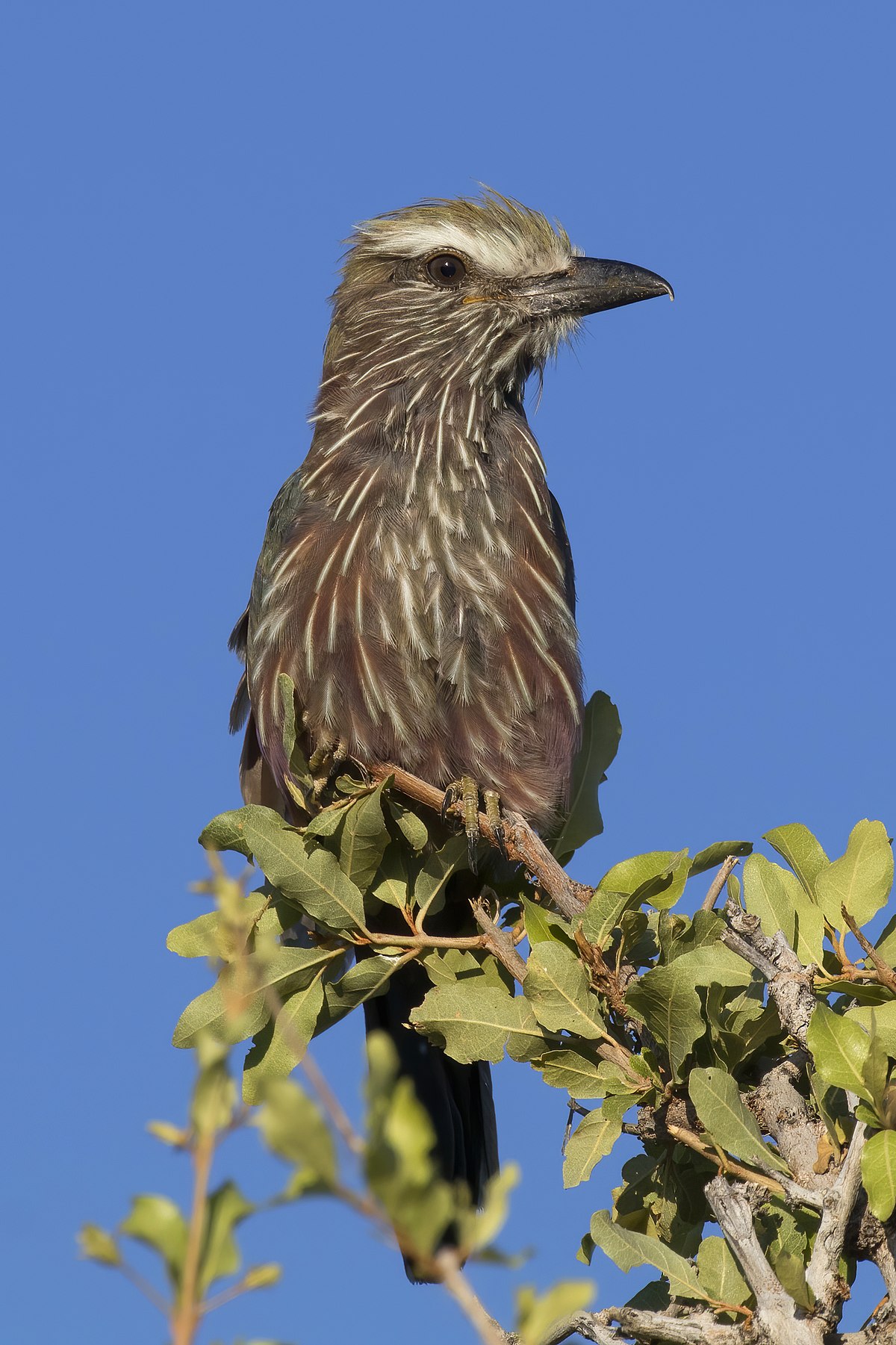
Wikipedia: Rufous-crowned roller Source: OTHER
1200px-Purple_roller_%28Coracias_naevius_mosambicus%29.jpg
![]() The purple roller (Coracias naevius), or rufous-crowned roller, is a medium-sized bird widespread in sub-Saharan Africa. Compared with other rollers its colours are rather dull and its voice rather harsh and grating.
[more]
The purple roller (Coracias naevius), or rufous-crowned roller, is a medium-sized bird widespread in sub-Saharan Africa. Compared with other rollers its colours are rather dull and its voice rather harsh and grating.
[more]
Profile Wikipedia eBird Xeno-Canto

Wikipedia: Broad-billed roller Source: OTHER
1200px-Broad-billed_Roller%2C_Ankarafantsika%2C_Madagascar%2C_crop.jpg
![]() The broad-billed roller (Eurystomus glaucurus) is a member of the roller family of birds which breeds across tropical Africa and Madagascar in all but the driest regions. It is a wet season breeder, which migrates from the northern and southern areas of its range towards the moister equatorial belt in the dry season.
[more]
The broad-billed roller (Eurystomus glaucurus) is a member of the roller family of birds which breeds across tropical Africa and Madagascar in all but the driest regions. It is a wet season breeder, which migrates from the northern and southern areas of its range towards the moister equatorial belt in the dry season.
[more]
Profile Wikipedia eBird Xeno-Canto
Pied kingfisher, most likely. 2016-09-23 09.15.24 Botswana
First observed in Botswana on 2016-09-21.
![]() The pied kingfisher (Ceryle rudis) is a species of water kingfisher widely distributed across Africa and Asia. Originally described by Carl Linnaeus in 1758, it has five recognised subspecies. Its black and white plumage and crest, as well as its habit of hovering over clear lakes and rivers before diving for fish, make it distinctive. Males have a double band across the breast, while females have a single gorget that is often broken in the middle. They are usually found in pairs or small family groups. When perched, they often bob their head and flick up their tail.
[more]
The pied kingfisher (Ceryle rudis) is a species of water kingfisher widely distributed across Africa and Asia. Originally described by Carl Linnaeus in 1758, it has five recognised subspecies. Its black and white plumage and crest, as well as its habit of hovering over clear lakes and rivers before diving for fish, make it distinctive. Males have a double band across the breast, while females have a single gorget that is often broken in the middle. They are usually found in pairs or small family groups. When perched, they often bob their head and flick up their tail.
[more]

Wikipedia: Giant kingfisher Source: OTHER
1200px-Giant_kingfisher_%28Megaceryle_maxima%29_male.jpg
![]() The giant kingfisher (Megaceryle maxima) is the largest kingfisher in Africa, where it is a resident breeding bird over most of the continent south of the Sahara Desert, other than the arid southwest.
[more]
The giant kingfisher (Megaceryle maxima) is the largest kingfisher in Africa, where it is a resident breeding bird over most of the continent south of the Sahara Desert, other than the arid southwest.
[more]
Profile Wikipedia eBird Xeno-Canto

Wikipedia: White-fronted bee-eater Source: OTHER
1200px-White-fronted_bee-eater_%28Merops_bullockoides%29_Namibia.jpg
![]() The white-fronted bee-eater (Merops bullockoides) is a species of bee-eater widely distributed in sub-equatorial Africa.
[more]
The white-fronted bee-eater (Merops bullockoides) is a species of bee-eater widely distributed in sub-equatorial Africa.
[more]
Profile Wikipedia eBird Xeno-Canto
Southern carmine bee-eaters. 2016-09-28 16.57.56 Botswana
First observed in Botswana on 2016-09-28.
![]() The southern carmine bee-eater (Merops nubicoides) (formerly carmine bee-eater) occurs across sub-equatorial Africa.
[more]
The southern carmine bee-eater (Merops nubicoides) (formerly carmine bee-eater) occurs across sub-equatorial Africa.
[more]
Profile Wikipedia eBird Xeno-Canto

Wikipedia: White-throated bee-eater Source: OTHER
White-throated_Bee-eater_-_Kenya_S4E4811_%2822024142954%29.jpg
![]() The white-throated bee-eater (Merops albicollis) is a near passerine bird in the bee-eater family, Meropidae. It breeds in semi-desert along the southern edge of the Sahara, Africa. The white-throated bee-eater is migratory, wintering in a completely different habitat in the equatorial rain forests of Africa from southern Senegal to Uganda.
[more]
The white-throated bee-eater (Merops albicollis) is a near passerine bird in the bee-eater family, Meropidae. It breeds in semi-desert along the southern edge of the Sahara, Africa. The white-throated bee-eater is migratory, wintering in a completely different habitat in the equatorial rain forests of Africa from southern Senegal to Uganda.
[more]
Profile Wikipedia eBird Xeno-Canto

Wikipedia: Madagascar bee-eater Source: OTHER
Madagascar_bee_eater.jpg
![]() The olive bee-eater or Madagascar bee-eater (Merops superciliosus) is a near passerine bee-eater species in the genus Merops. It is native to the southern half of Africa where it is present in Angola; Botswana; Burundi; Comoros; Democratic Republic of the Congo; Djibouti; Eritrea; Ethiopia; Kenya; Madagascar; Malawi; Mayotte; Mozambique; Namibia; Rwanda; Somalia; South Sudan; Sudan; Tanzania; Uganda; Zambia; Zimbabwe. It is a common species with a wide range so the International Union for Conservation of Nature has rated their conservation status as "least concern".[1]
[more]
The olive bee-eater or Madagascar bee-eater (Merops superciliosus) is a near passerine bee-eater species in the genus Merops. It is native to the southern half of Africa where it is present in Angola; Botswana; Burundi; Comoros; Democratic Republic of the Congo; Djibouti; Eritrea; Ethiopia; Kenya; Madagascar; Malawi; Mayotte; Mozambique; Namibia; Rwanda; Somalia; South Sudan; Sudan; Tanzania; Uganda; Zambia; Zimbabwe. It is a common species with a wide range so the International Union for Conservation of Nature has rated their conservation status as "least concern".[1]
[more]
Profile Wikipedia eBird Xeno-Canto

Wikipedia: Little bee-eater Source: OTHER
1200px-Little_bee-eater_%28Merops_pusillus_argutus%29_Namibia.jpg
![]() The little bee-eater (Merops pusillus) is a near passerine bird species in the bee-eater family, Meropidae. They are residents in much of Sub-Saharan Africa. They should not be confused with the little green bee-eater, Merops orientalis. Migration is limited to seasonal movements depending on rainfall patterns.
[more]
The little bee-eater (Merops pusillus) is a near passerine bird species in the bee-eater family, Meropidae. They are residents in much of Sub-Saharan Africa. They should not be confused with the little green bee-eater, Merops orientalis. Migration is limited to seasonal movements depending on rainfall patterns.
[more]
Profile Wikipedia eBird Xeno-Canto

Wikipedia: Blue-cheeked bee-eater Source: OTHER
1200px-Blue-cheeked_bee-eater_%28Merops_persicus_persicus%29_Namibia.jpg
![]() The blue-cheeked bee-eater (Merops persicus) is a near passerine bird in the bee-eater family, Meropidae. The genus name Merops is Ancient Greek for "bee-eater", and persicus is Latin for "Persian".[2]
[more]
The blue-cheeked bee-eater (Merops persicus) is a near passerine bird in the bee-eater family, Meropidae. The genus name Merops is Ancient Greek for "bee-eater", and persicus is Latin for "Persian".[2]
[more]
Profile Wikipedia eBird Xeno-Canto
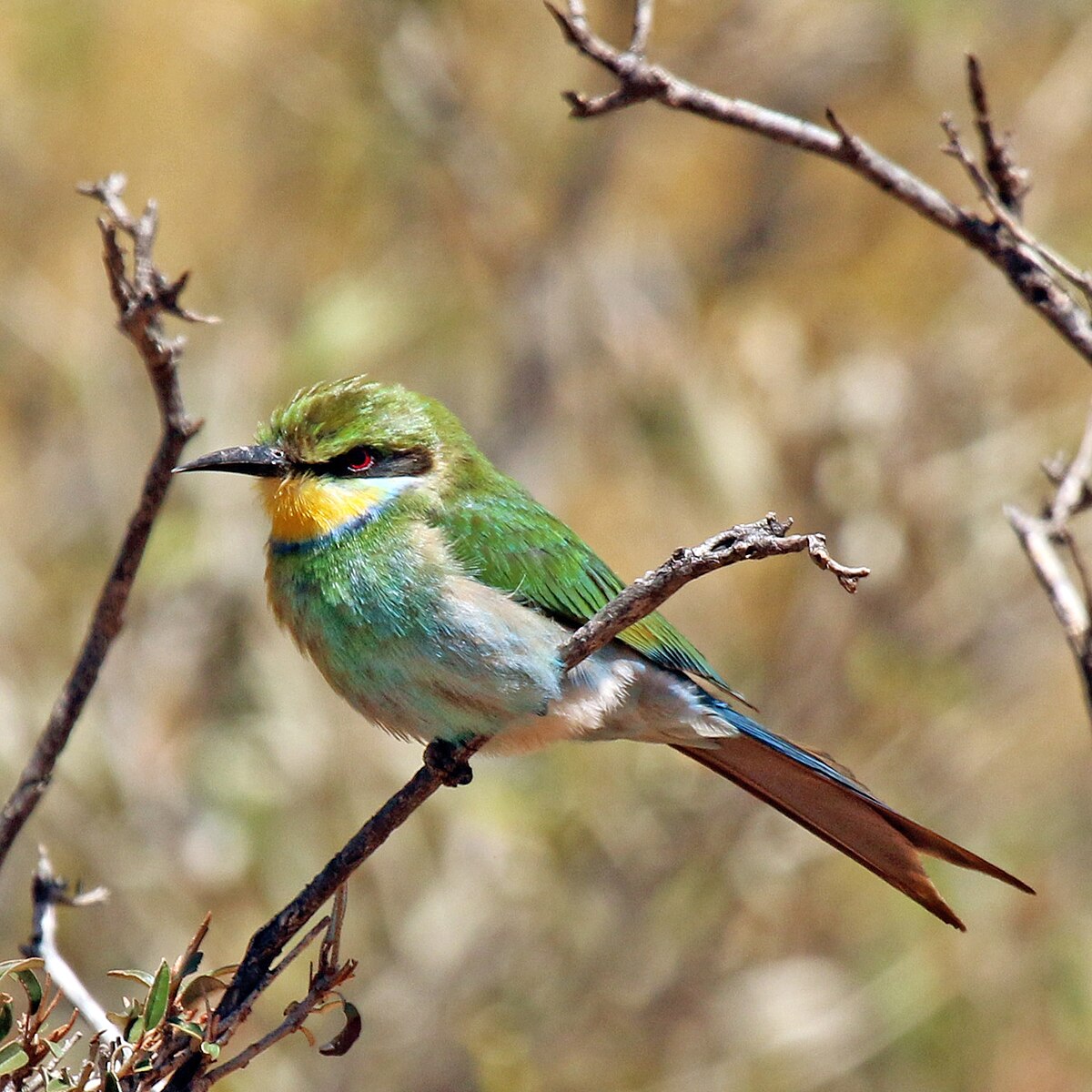
Wikipedia: Swallow-tailed bee-eater Source: OTHER
1200px-Swallow-tailed_bee-eater_%28Merops_hirundineus_hirundineus%29.jpg
![]() The swallow-tailed bee-eater (Merops hirundineus) is a near passerine bird in the bee-eater family, Meropidae. It breeds in savannah woodlands of sub-Saharan Africa. It is partially migratory, moving in response to rainfall patterns.
[more]
The swallow-tailed bee-eater (Merops hirundineus) is a near passerine bird in the bee-eater family, Meropidae. It breeds in savannah woodlands of sub-Saharan Africa. It is partially migratory, moving in response to rainfall patterns.
[more]
Profile Wikipedia eBird Xeno-Canto
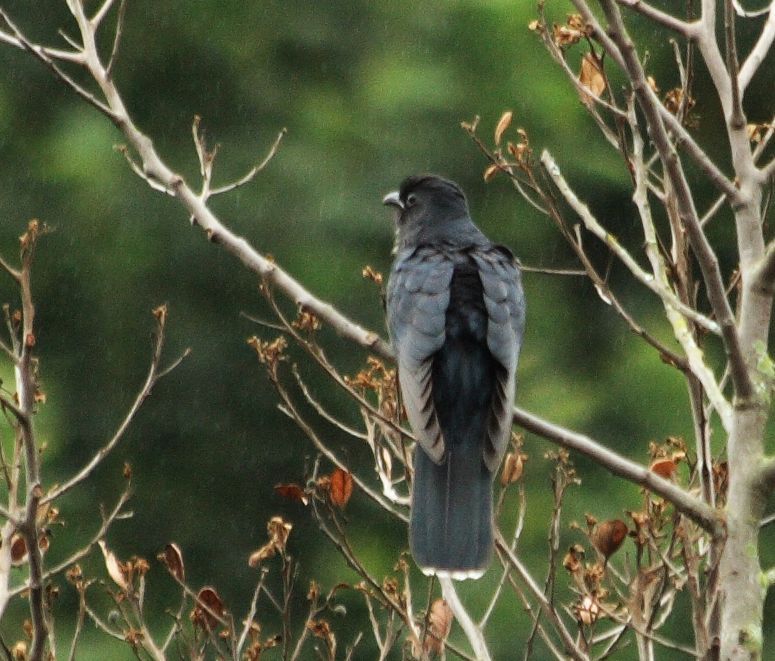
Wikipedia: Black cuckoo Source: OTHER
Black_Cuckoo_%28Cuculus_clamosus%29.jpg
![]() The black cuckoo (Cuculus clamosus) is a species of cuckoo in the family Cuculidae. The species is distributed widely across sub-Saharan Africa. There are two subspecies. This cuckoo has a very wide range and is quite common so it is classified as a least-concern species by the International Union for Conservation of Nature.[1]
[more]
The black cuckoo (Cuculus clamosus) is a species of cuckoo in the family Cuculidae. The species is distributed widely across sub-Saharan Africa. There are two subspecies. This cuckoo has a very wide range and is quite common so it is classified as a least-concern species by the International Union for Conservation of Nature.[1]
[more]
Profile Wikipedia eBird Xeno-Canto

Wikipedia: Madagascar cuckoo Source: OTHER
1200px-Cuculus_rochii.JPG
![]() The Madagascan cuckoo (Cuculus rochii), also known as the Madagascar lesser cuckoo, is a species of cuckoo in the family Cuculidae. Though it breeds only in Madagascar, it spends the non-breeding season in a number of countries in the African Great Lakes region and the Indian Ocean islands: Burundi, Democratic Republic of the Congo, Madagascar, Malawi, Rwanda, South Africa, Uganda and Zambia.
[more]
The Madagascan cuckoo (Cuculus rochii), also known as the Madagascar lesser cuckoo, is a species of cuckoo in the family Cuculidae. Though it breeds only in Madagascar, it spends the non-breeding season in a number of countries in the African Great Lakes region and the Indian Ocean islands: Burundi, Democratic Republic of the Congo, Madagascar, Malawi, Rwanda, South Africa, Uganda and Zambia.
[more]
Profile Wikipedia eBird Xeno-Canto

Wikipedia: Red-chested cuckoo Source: OTHER
Red-chested_Cuckoo_%28Cuculus_solitarius%29_in_tree_crop.jpg
![]() The red-chested cuckoo (Cuculus solitarius) is a species of cuckoo in the family Cuculidae. It is a medium-sized bird found in Africa south of the Sahara. In Afrikaans, it is known as "Piet-my-vrou", after its call.[2]
[more]
The red-chested cuckoo (Cuculus solitarius) is a species of cuckoo in the family Cuculidae. It is a medium-sized bird found in Africa south of the Sahara. In Afrikaans, it is known as "Piet-my-vrou", after its call.[2]
[more]
Profile Wikipedia eBird Xeno-Canto
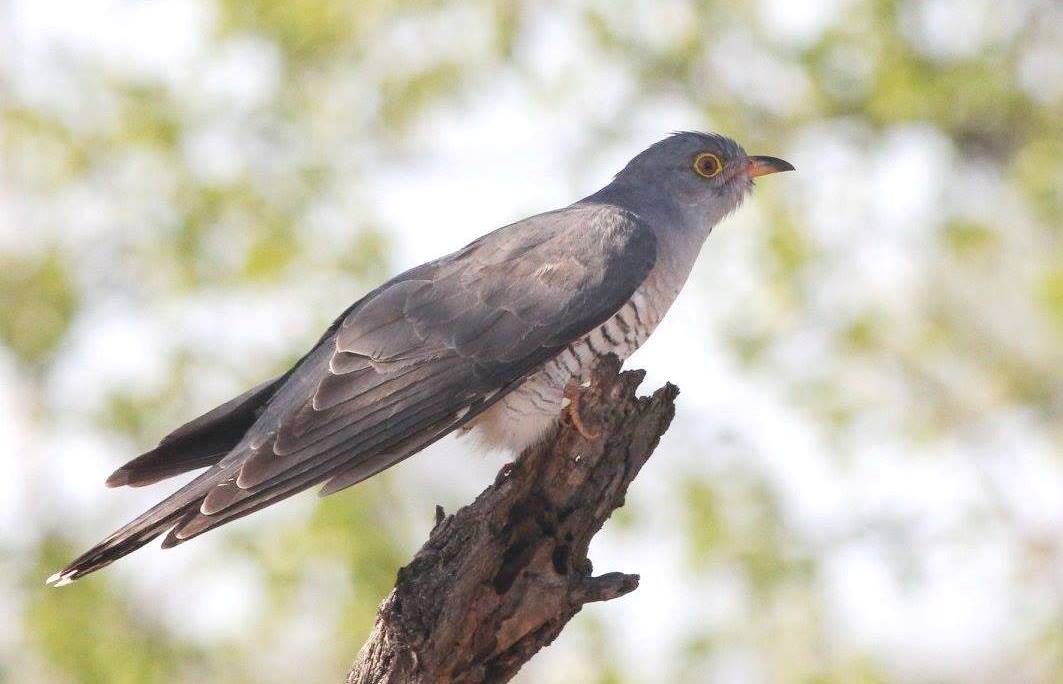
Wikipedia: African cuckoo Source: OTHER
Cuculus_gularis%2C_mannetjie%2C_Pretoriuskop%2C_Birding_Weto%2C_a.jpg
![]() The African cuckoo (Cuculus gularis) is a species of cuckoo in the family Cuculidae. It is found in Sub-Saharan Africa where it migrates within the continent, generally arriving and breeding in any one locality during the rainy season. A fairly common bird, the International Union for Conservation of Nature has rated its conservation status as being of "least concern".
[more]
The African cuckoo (Cuculus gularis) is a species of cuckoo in the family Cuculidae. It is found in Sub-Saharan Africa where it migrates within the continent, generally arriving and breeding in any one locality during the rainy season. A fairly common bird, the International Union for Conservation of Nature has rated its conservation status as being of "least concern".
[more]
Profile Wikipedia eBird Xeno-Canto

Wikipedia: African emerald cuckoo Source: OTHER
African_emerald_cuckoo_%28Chrysococcyx_cupreus%29_in_tree.jpg
![]() The African emerald cuckoo (Chrysococcyx cupreus) is a species of cuckoo that is native to Africa.
[more]
The African emerald cuckoo (Chrysococcyx cupreus) is a species of cuckoo that is native to Africa.
[more]
Profile Wikipedia eBird Xeno-Canto
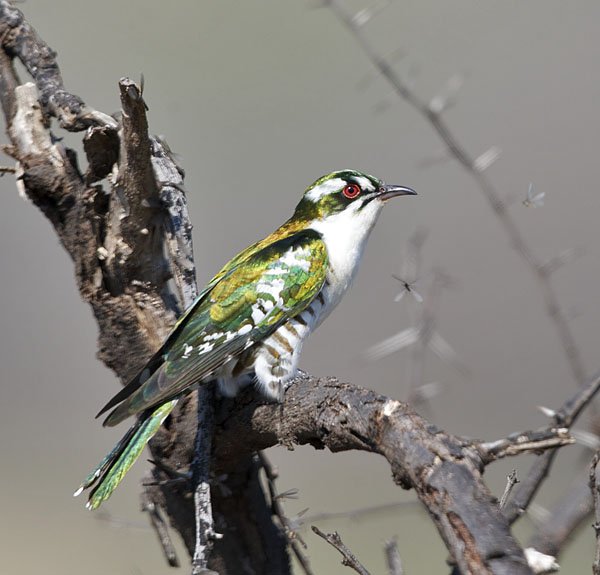
Wikipedia: Dideric cuckoo Source: OTHER
Chrysococcyx_caprius%2C_a%2C_Johann_Grobbelaar.jpg
![]() The diederik cuckoo (Chrysococcyx caprius), formerly dideric cuckoo or didric cuckoo is a member of the cuckoo order of birds, the Cuculiformes, which also includes the roadrunners and the anis.
[more]
The diederik cuckoo (Chrysococcyx caprius), formerly dideric cuckoo or didric cuckoo is a member of the cuckoo order of birds, the Cuculiformes, which also includes the roadrunners and the anis.
[more]
Profile Wikipedia eBird Xeno-Canto
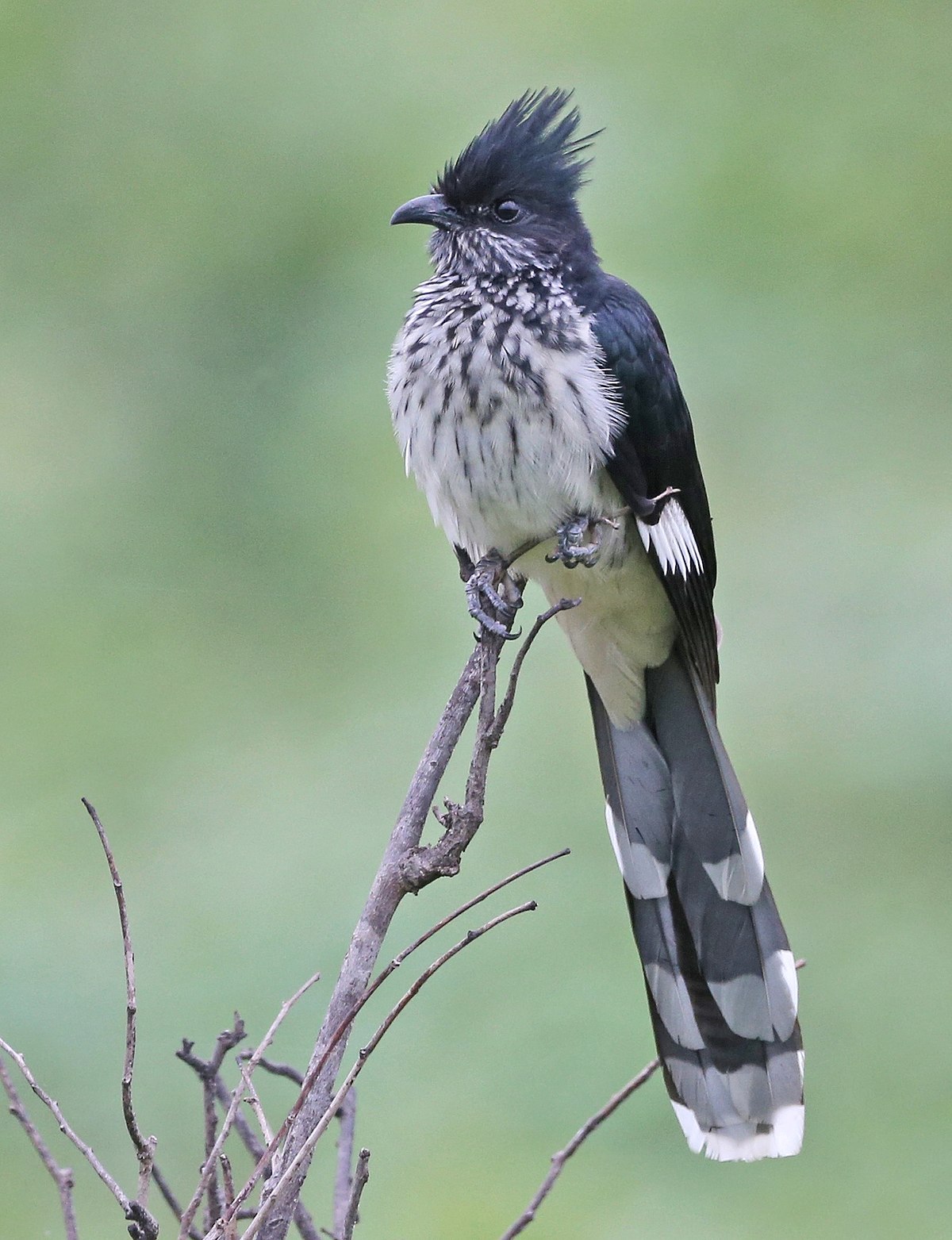
Wikipedia: Levaillant's cuckoo Source: OTHER
1200px-Clamator_levaillantii_%28Levaillant%27s_Cuckoo%29%2C_crop.jpg
![]() Levaillant's cuckoo (Clamator levaillantii) is a cuckoo which is a resident breeding species in Africa south of the Sahara. It is found in bushy habitats. It is a brood parasite, using the nests of bulbuls and babblers. It was named in honour of the French explorer, collector and ornithologist, François Le Vaillant.[2]
[more]
Levaillant's cuckoo (Clamator levaillantii) is a cuckoo which is a resident breeding species in Africa south of the Sahara. It is found in bushy habitats. It is a brood parasite, using the nests of bulbuls and babblers. It was named in honour of the French explorer, collector and ornithologist, François Le Vaillant.[2]
[more]
Profile Wikipedia eBird Xeno-Canto

Wikipedia: Pied cuckoo Source: OTHER
Jacobin_Cuckoo_%28Clamator_jacobinus%29_Photograph_By_Shantanu_Kuveskar.jpg
![]() The Jacobin cuckoo (Clamator jacobinus), pied cuckoo or the pied crested cuckoo, is a member of the cuckoo order of birds that is found in Africa and Asia. It is partially migratory and in India, it has been considered a harbinger of the monsoon rains due to the timing of its arrival.[2] It has been associated with a bird in Indian mythology and poetry, known as the chataka (Sanskrit: चातक) represented as a bird with a beak on its head that waits for rains to quench its thirst.
[more]
The Jacobin cuckoo (Clamator jacobinus), pied cuckoo or the pied crested cuckoo, is a member of the cuckoo order of birds that is found in Africa and Asia. It is partially migratory and in India, it has been considered a harbinger of the monsoon rains due to the timing of its arrival.[2] It has been associated with a bird in Indian mythology and poetry, known as the chataka (Sanskrit: चातक) represented as a bird with a beak on its head that waits for rains to quench its thirst.
[more]
Profile Wikipedia eBird Xeno-Canto NABU

Wikipedia: Great spotted cuckoo Source: OTHER
Clamator_glandarius_%28cropped_2%29.jpg
![]() The great spotted cuckoo (Clamator glandarius) is a member of the cuckoo order of birds, the Cuculiformes, which also includes the roadrunners, the anis and the coucals. The genus name clamator is Latin for "shouter" from clamare, "to shout". The specific glandarius is derived from Latin glans, glandis, "acorn".[2]
[more]
The great spotted cuckoo (Clamator glandarius) is a member of the cuckoo order of birds, the Cuculiformes, which also includes the roadrunners, the anis and the coucals. The genus name clamator is Latin for "shouter" from clamare, "to shout". The specific glandarius is derived from Latin glans, glandis, "acorn".[2]
[more]
Profile Wikipedia eBird Xeno-Canto
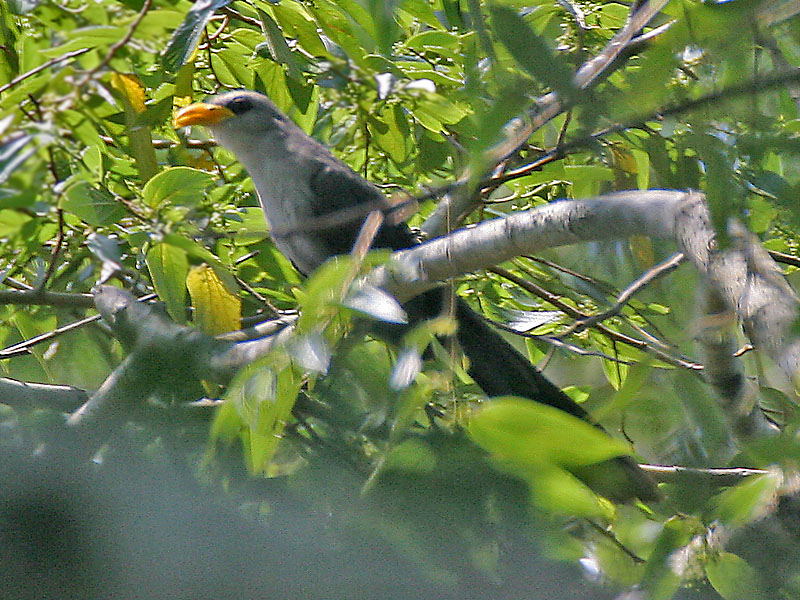
Wikipedia: Green malkoha Source: OTHER
Yellowbill.jpg
![]() The green malkoha or whistling yellowbill (Ceuthmochares australis) is a species of cuckoo in the family Cuculidae. This species and the blue malkoha were previously considered conspecific and together known as the yellowbill.
[more]
The green malkoha or whistling yellowbill (Ceuthmochares australis) is a species of cuckoo in the family Cuculidae. This species and the blue malkoha were previously considered conspecific and together known as the yellowbill.
[more]
Profile Wikipedia eBird Xeno-Canto
Coppery tailed coucal. 2016-09-23 08.14.20 Botswana
First observed in Botswana on 2016-09-23.
![]() The coppery-tailed coucal (Centropus cupreicaudus) is a species of cuckoo in the family Cuculidae. It is found in Angola, Botswana, the Democratic Republic of the Congo, Malawi, Namibia, Tanzania, Zambia, and Zimbabwe. It was first described by the German ornithologist Anton Reichenow in 1896.
[more]
The coppery-tailed coucal (Centropus cupreicaudus) is a species of cuckoo in the family Cuculidae. It is found in Angola, Botswana, the Democratic Republic of the Congo, Malawi, Namibia, Tanzania, Zambia, and Zimbabwe. It was first described by the German ornithologist Anton Reichenow in 1896.
[more]
Profile Wikipedia eBird Xeno-Canto

Wikipedia: Black coucal Source: OTHER
Centropus_grillii%2C_subvolwassene%2C_Menongue%2C_Birding_Weto%2C_a.jpg
![]() The black coucal (Centropus grillii) is a species of cuckoo in the family Cuculidae. It has a wide distribution in Africa south of the Sahara.
[more]
The black coucal (Centropus grillii) is a species of cuckoo in the family Cuculidae. It has a wide distribution in Africa south of the Sahara.
[more]
Profile Wikipedia eBird Xeno-Canto

Wikipedia: Senegal coucal Source: OTHER
1200px-Senegal_coucal_%28Centropus_senegalensis_senegalensis%29.jpg
![]() The Senegal coucal (Centropus senegalensis) is a member of the cuckoo order of birds, the Cuculiformes, which also includes the roadrunners, the anis, and the hoatzin. It is a medium-sized member of its genus and is found in lightly-wooded country and savannah in central and southern Africa.
[more]
The Senegal coucal (Centropus senegalensis) is a member of the cuckoo order of birds, the Cuculiformes, which also includes the roadrunners, the anis, and the hoatzin. It is a medium-sized member of its genus and is found in lightly-wooded country and savannah in central and southern Africa.
[more]
Profile Wikipedia eBird Xeno-Canto

Wikipedia: White-browed coucal Source: OTHER
1200px-Centropus_superciliosus_-Tanzania-8.jpg
![]() The white-browed coucal or lark-heeled cuckoo (Centropus superciliosus), is a species of cuckoo in the family Cuculidae. It is found in sub-Saharan Africa. It inhabits areas with thick cover afforded by rank undergrowth and scrub, including in suitable coastal regions. Burchell's coucal is sometimes considered a subspecies.
[more]
The white-browed coucal or lark-heeled cuckoo (Centropus superciliosus), is a species of cuckoo in the family Cuculidae. It is found in sub-Saharan Africa. It inhabits areas with thick cover afforded by rank undergrowth and scrub, including in suitable coastal regions. Burchell's coucal is sometimes considered a subspecies.
[more]
Profile Wikipedia eBird Vogelwarte BirdLife ZH ornitho.ch Xeno-Canto NABU

Wikipedia: Red-footed falcon Source: OTHER
Falco_vespertinus_3_%28Martin_Mecnarowski%29.jpg
![]() The red-footed falcon (Falco vespertinus), formerly the western red-footed falcon, is a bird of prey. It belongs to the family Falconidae, the falcons. This bird is found in eastern Europe and Asia although its numbers are dwindling rapidly due to habitat loss and hunting. It is migratory, wintering in Africa. It is a regular wanderer to western Europe, and in August 2004 a red-footed falcon was found in North America for the first time on the island of Martha's Vineyard, Massachusetts.[2]
[more]
The red-footed falcon (Falco vespertinus), formerly the western red-footed falcon, is a bird of prey. It belongs to the family Falconidae, the falcons. This bird is found in eastern Europe and Asia although its numbers are dwindling rapidly due to habitat loss and hunting. It is migratory, wintering in Africa. It is a regular wanderer to western Europe, and in August 2004 a red-footed falcon was found in North America for the first time on the island of Martha's Vineyard, Massachusetts.[2]
[more]
Habitats:
Agricultural
Profile Wikipedia eBird Xeno-Canto

Wikipedia: Amur falcon Source: OTHER
1200px-Amur_Falcon_%28male%29_%28vagrant%29.jpg
![]() The Amur falcon (Falco amurensis) is a small raptor of the falcon family. It breeds in south-eastern Siberia and Northern China before migrating in large flocks across India and over the Arabian Sea to winter in Southern Africa
[more]
The Amur falcon (Falco amurensis) is a small raptor of the falcon family. It breeds in south-eastern Siberia and Northern China before migrating in large flocks across India and over the Arabian Sea to winter in Southern Africa
[more]
Profile Wikipedia eBird Xeno-Canto
Wikipedia: Red-necked falcon Source: OTHER
Red-Necked_Falcon.JPG
![]() The red-necked falcon (Falco chicquera) is a bird of prey in the falcon family with two disjunct populations, one in India and the other in Africa. This medium-sized falcon has bluish grey wings and upper body, a chestnut red cap with short chin straps passing through the eye. The primary feathers of the wing are black and a single black band at the tip of the tail are distinctive. The Indian subspecies Falco chicquera chicquera also known as the red-headed merlin or red-headed falcon is found mainly in the open plains of the India Subcontinent although it is thought to have occurred further west in southeastern Iran. The subspecies Falco chicquera ruficollis found in sub-Saharan Africa is sometimes treated as a full species, the rufous-necked falcon (Falco ruficollis), on the basis of its well-separated geographic range and distinctive pattern. It appears very similar to the Indian form but has dark barring on the upperparts, a rufous breast band, and black moustachial and eye stripes. As in most falcons, the females are larger and falconers in India called the female turumti and the male as chatwa. They hunt in pairs mostly at dawn and dusk, capturing small birds, bats and squirrels.
[more]
The red-necked falcon (Falco chicquera) is a bird of prey in the falcon family with two disjunct populations, one in India and the other in Africa. This medium-sized falcon has bluish grey wings and upper body, a chestnut red cap with short chin straps passing through the eye. The primary feathers of the wing are black and a single black band at the tip of the tail are distinctive. The Indian subspecies Falco chicquera chicquera also known as the red-headed merlin or red-headed falcon is found mainly in the open plains of the India Subcontinent although it is thought to have occurred further west in southeastern Iran. The subspecies Falco chicquera ruficollis found in sub-Saharan Africa is sometimes treated as a full species, the rufous-necked falcon (Falco ruficollis), on the basis of its well-separated geographic range and distinctive pattern. It appears very similar to the Indian form but has dark barring on the upperparts, a rufous breast band, and black moustachial and eye stripes. As in most falcons, the females are larger and falconers in India called the female turumti and the male as chatwa. They hunt in pairs mostly at dawn and dusk, capturing small birds, bats and squirrels.
[more]

Wikipedia: African hobby Source: OTHER
African_Hobby_bwindi_jan06.jpg
![]() The African hobby (Falco cuvierii) is a small species of bird of prey in the family Falconidae.
[more]
The African hobby (Falco cuvierii) is a small species of bird of prey in the family Falconidae.
[more]
Profile Wikipedia eBird Xeno-Canto

Wikipedia: Taita falcon Source: OTHER
Taita_Falcon_at_the_World_Center_for_Birds_of_Prey%2C_Boise%2C_Idaho%2C_USA.jpg
![]() The Taita falcon (Falco fasciinucha) is a small falcon found in central and eastern Africa. It was first described from the Taita Hills of Kenya from which it derives its name.
[more]
The Taita falcon (Falco fasciinucha) is a small falcon found in central and eastern Africa. It was first described from the Taita Hills of Kenya from which it derives its name.
[more]
Profile Wikipedia eBird Xeno-Canto

Wikipedia: Dickinson's kestrel Source: OTHER
Dickinson%27s_Kestrel_%28Falco_dickinsoni%29_%2823164736424%29.jpg
![]() Dickinson's kestrel (Falco dickinsoni) is a bird of prey of southern and eastern Africa belonging to the falcon family Falconidae. It is named after John Dickinson, an English physician and missionary who collected the type specimen. It is also known as the white-rumped kestrel. Its closest relatives are the grey kestrel and banded kestrel and the three are sometimes placed in the subgenus Dissodectes.
[more]
Dickinson's kestrel (Falco dickinsoni) is a bird of prey of southern and eastern Africa belonging to the falcon family Falconidae. It is named after John Dickinson, an English physician and missionary who collected the type specimen. It is also known as the white-rumped kestrel. Its closest relatives are the grey kestrel and banded kestrel and the three are sometimes placed in the subgenus Dissodectes.
[more]
Profile Wikipedia eBird Xeno-Canto NABU

Wikipedia: Lanner falcon Source: OTHER
Lanner_Falcon_800.jpg
![]() The lanner falcon (Falco biarmicus) is a medium-sized bird of prey that breeds in Africa, southeast Europe and just into Asia. It prefers open habitat and is mainly resident, but some birds disperse more widely after the breeding season. A large falcon, it preys on birds and bats.[2]
[more]
The lanner falcon (Falco biarmicus) is a medium-sized bird of prey that breeds in Africa, southeast Europe and just into Asia. It prefers open habitat and is mainly resident, but some birds disperse more widely after the breeding season. A large falcon, it preys on birds and bats.[2]
[more]
Profile Wikipedia eBird Vogelwarte BirdLife ZH ornitho.ch Xeno-Canto BirdID NABU
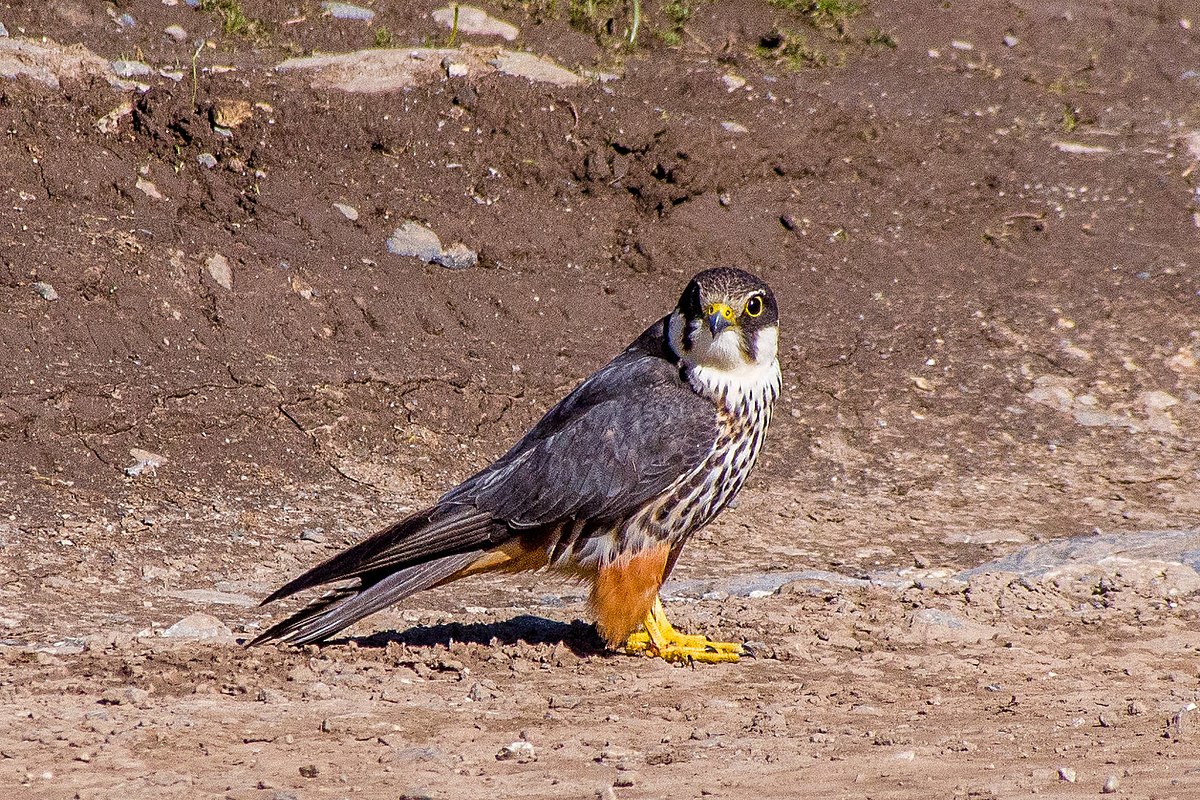
Wikipedia: Eurasian hobby Source: OTHER
1200px-Eurasian_Hobby_%2814574008925%29_%28cropped%29.jpg
![]() The Eurasian hobby (Falco subbuteo) or just simply hobby, is a small, slim falcon. It belongs to a rather close-knit group of similar falcons often considered a subgenus Hypotriorchis.[2][3][4]
[more]
The Eurasian hobby (Falco subbuteo) or just simply hobby, is a small, slim falcon. It belongs to a rather close-knit group of similar falcons often considered a subgenus Hypotriorchis.[2][3][4]
[more]
Vocalization: ![]() Varied, but not very vocal. [Link]
Varied, but not very vocal. [Link]
Calls: ![]() Calls when courting and at breeding ground. Most common sound a high-pitched "tew-tew-tew". Similar to Wryneck, but less pleading. Also a sneezing "ktcho". [Link]
Calls when courting and at breeding ground. Most common sound a high-pitched "tew-tew-tew". Similar to Wryneck, but less pleading. Also a sneezing "ktcho". [Link]
Physical details: length=30-36 cm,
wingspan=82-92 cm,
weight=131-340 g
Habitats:
Agricultural
Song:
Automatically generated from Xeno-Canto recording
Song attributes:
Frequency:
♫ Source: BirdNet
20200507_131403 birdnet 488 BirdNet guesses eurasian hobby or eurasian jay - No confident detection.mp3
2020-05-07 13.14.03 Hungerseeli (song)
Profile Wikipedia eBird Xeno-Canto NABU
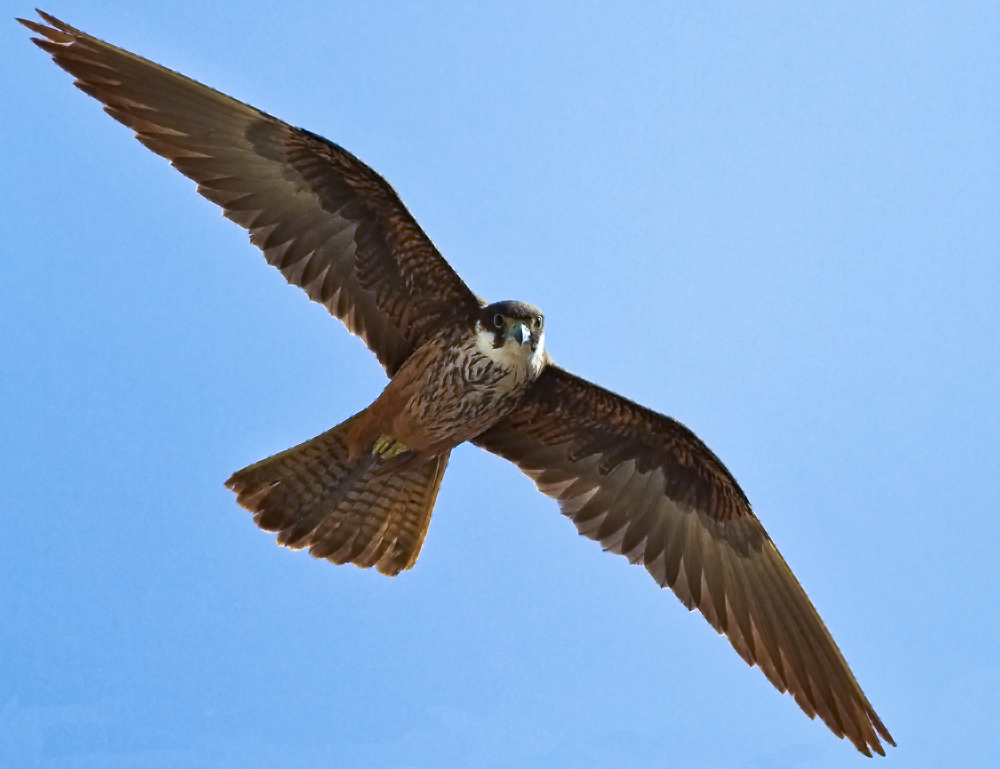
Wikipedia: Eleonora's falcon Source: OTHER
Eleonorenfalke1.jpg
General: ![]() Eleonora's falcon (Falco eleonorae) is a medium-sized falcon. It belongs to the hobby group, a rather close-knit number of similar falcons often considered a subgenus Hypotriorchis. The sooty falcon is sometimes considered its closest relative, but while they certainly belong to the same lineage, they do not seem to be close sister species.[2][3] The English name and the species name eleonorae commemorate Eleanor of Arborea, Queen or Lady-Judge (Juighissa) and national heroine of Sardinia, who in 1392, under the jurisdiction conferred by the Carta de Logu, became the first ruler in history to grant protection to hawk and falcon nests against illegal hunters.[4][5][6] The genus name falco is from Late Latin falx, falcis, a sickle, referring to the claws of the bird.[7]
[more]
Eleonora's falcon (Falco eleonorae) is a medium-sized falcon. It belongs to the hobby group, a rather close-knit number of similar falcons often considered a subgenus Hypotriorchis. The sooty falcon is sometimes considered its closest relative, but while they certainly belong to the same lineage, they do not seem to be close sister species.[2][3] The English name and the species name eleonorae commemorate Eleanor of Arborea, Queen or Lady-Judge (Juighissa) and national heroine of Sardinia, who in 1392, under the jurisdiction conferred by the Carta de Logu, became the first ruler in history to grant protection to hawk and falcon nests against illegal hunters.[4][5][6] The genus name falco is from Late Latin falx, falcis, a sickle, referring to the claws of the bird.[7]
[more]

Wikipedia: Peregrine falcon Source: OTHER
Falco_peregrinus_good_-_Christopher_Watson.jpg
This bird appears across the great seas in the following continents:
Europe, North America, South America, Africa, Asia.
![]() The peregrine falcon (Falco peregrinus), also known as the peregrine,[2] and historically as the duck hawk in North America,[3] is a widespread bird of prey (raptor) in the family Falconidae. A large, crow-sized falcon, it has a blue-grey back, barred white underparts, and a black head. The peregrine is renowned for its speed, reaching over 320 km/h (200 mph) during its characteristic hunting stoop (high-speed dive),[4] making it the fastest bird in the world, as well as the fastest member of the animal kingdom.[5][6][7] According to a National Geographic TV program, the highest measured speed of a peregrine falcon is 389 km/h (242 mph).[8][9] As is typical for bird-eating raptors, peregrine falcons are sexually dimorphic, with females being considerably larger than males.[10][11]
[more]
The peregrine falcon (Falco peregrinus), also known as the peregrine,[2] and historically as the duck hawk in North America,[3] is a widespread bird of prey (raptor) in the family Falconidae. A large, crow-sized falcon, it has a blue-grey back, barred white underparts, and a black head. The peregrine is renowned for its speed, reaching over 320 km/h (200 mph) during its characteristic hunting stoop (high-speed dive),[4] making it the fastest bird in the world, as well as the fastest member of the animal kingdom.[5][6][7] According to a National Geographic TV program, the highest measured speed of a peregrine falcon is 389 km/h (242 mph).[8][9] As is typical for bird-eating raptors, peregrine falcons are sexually dimorphic, with females being considerably larger than males.[10][11]
[more]
Vocalization: ![]() A harsh, drawn out "kiaaaa" with emphasised endings repeated in series. Much slower than Merlin, but higher pitched than Gyrfalcon. [Link]
A harsh, drawn out "kiaaaa" with emphasised endings repeated in series. Much slower than Merlin, but higher pitched than Gyrfalcon. [Link]
Calls: ![]() Also shorter, coarse warning-calls. [Link]
Also shorter, coarse warning-calls. [Link]
Physical details: length=36-48 cm,
wingspan=95-110 cm,
weight=582-1300 g
Habitats:
Agricultural
Profile Wikipedia eBird Xeno-Canto

Wikipedia: Greater kestrel Source: OTHER
Greater_Kestrel_Namibia.jpg
General: ![]() The greater kestrel (Falco rupicoloides) or white-eyed kestrel, is a bird of prey belonging to the falcon family Falconidae. It is one of the largest kestrels and is found in open country in southern and eastern Africa.
[more]
The greater kestrel (Falco rupicoloides) or white-eyed kestrel, is a bird of prey belonging to the falcon family Falconidae. It is one of the largest kestrels and is found in open country in southern and eastern Africa.
[more]
Profile Wikipedia eBird Xeno-Canto
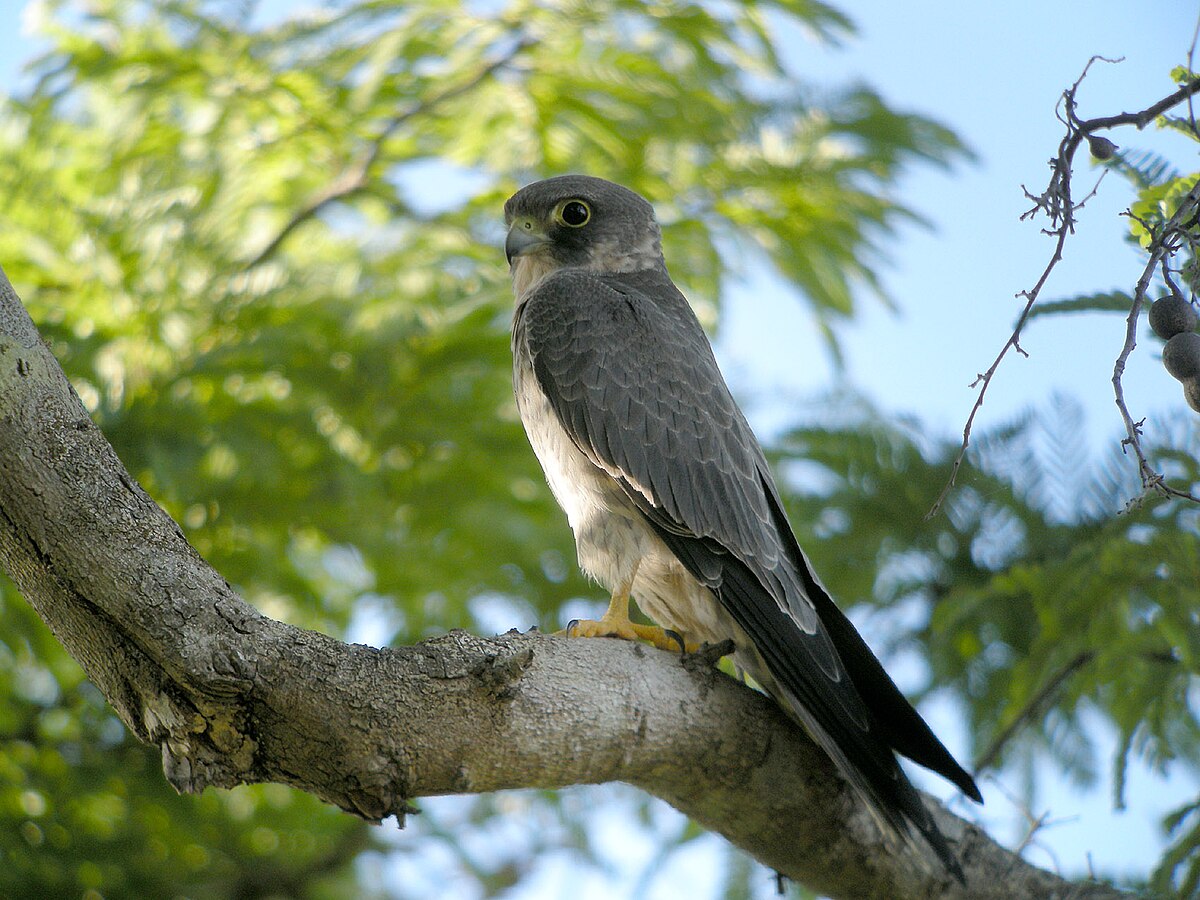
Wikipedia: Sooty falcon Source: OTHER
1200px-Sooty_Falcon%2C_All%C3%A9e_des_Baobabs_near_Morondava%2C_Madagascar.jpg
![]() The sooty falcon (Falco concolor) is a medium-sized falcon breeding from northeastern Africa to the southern Persian Gulf region.
[more]
The sooty falcon (Falco concolor) is a medium-sized falcon breeding from northeastern Africa to the southern Persian Gulf region.
[more]
Profile Wikipedia eBird Xeno-Canto BirdID NABU

Wikipedia: Lesser kestrel Source: OTHER
1200px-Lesser_Kestrel_%28Male%29.jpg
![]() The lesser kestrel (Falco naumanni) is a small falcon. This species breeds from the Mediterranean across Afghanistan and Central Asia, to China and Mongolia. It is a summer migrant, wintering in Africa and Pakistan and sometimes even to India and Iraq. It is rare north of its breeding range, and declining in its European range. The genus name derives from Late Latin falx, falcis, a sickle, referencing the claws of the bird,[2] and the species name commemorates the German naturalist Johann Friedrich Naumann.[3]
[more]
The lesser kestrel (Falco naumanni) is a small falcon. This species breeds from the Mediterranean across Afghanistan and Central Asia, to China and Mongolia. It is a summer migrant, wintering in Africa and Pakistan and sometimes even to India and Iraq. It is rare north of its breeding range, and declining in its European range. The genus name derives from Late Latin falx, falcis, a sickle, referencing the claws of the bird,[2] and the species name commemorates the German naturalist Johann Friedrich Naumann.[3]
[more]
Calls: ![]() Contact call diagnostic, and quite different from Kestrel. A di- or trisyllabic "che che che", resembling Partridge in timbre, with two first syllables accentuated. Frequently used in colonies an din flocks. Also a Kestrel-like, plaintive trill "vriiiiii". [Link]
Contact call diagnostic, and quite different from Kestrel. A di- or trisyllabic "che che che", resembling Partridge in timbre, with two first syllables accentuated. Frequently used in colonies an din flocks. Also a Kestrel-like, plaintive trill "vriiiiii". [Link]
Physical details: length=29-32 cm,
wingspan=58-72 cm,
weight=90-208 g
Profile Wikipedia eBird Xeno-Canto
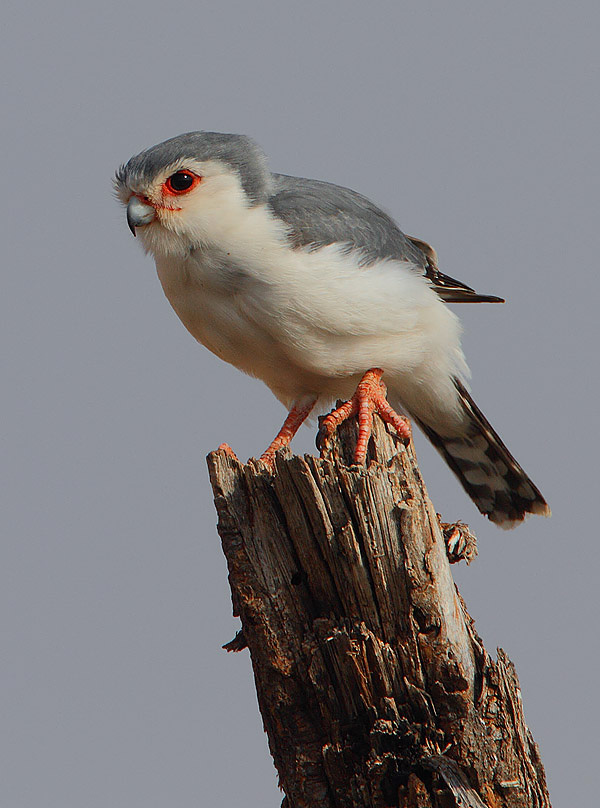
Wikipedia: Pygmy falcon Source: OTHER
Polihierax_semitorquatus_-Buffalo_Springs_National_Park%2C_Kenya-8.jpg
General: ![]() The pygmy falcon (Polihierax semitorquatus) or African pygmy falcon, is a bird species native to eastern and southern Africa. It is the smallest raptor on the continent. As a small falcon, only 19 to 20 cm long, it preys on insects, small reptiles, and small mammals.
[more]
The pygmy falcon (Polihierax semitorquatus) or African pygmy falcon, is a bird species native to eastern and southern Africa. It is the smallest raptor on the continent. As a small falcon, only 19 to 20 cm long, it preys on insects, small reptiles, and small mammals.
[more]

Bushman flamingo carving. 2016-09-09 17.16.22 Namibia
First observed in Namibia on 2016-09-09.
![]() The greater flamingo (Phoenicopterus roseus) is the most widespread and largest species of the flamingo family. It is found in Africa, the Indian subcontinent, the Middle East, and in southern Europe.
[more]
The greater flamingo (Phoenicopterus roseus) is the most widespread and largest species of the flamingo family. It is found in Africa, the Indian subcontinent, the Middle East, and in southern Europe.
[more]
Vocalization: ![]() Nasal, di-syllabic, gooselike honking. Sometimes pure and high-pitched, other times deep and with peculiar, raspy, frog-like quality. [Link]
Nasal, di-syllabic, gooselike honking. Sometimes pure and high-pitched, other times deep and with peculiar, raspy, frog-like quality. [Link]
Physical details: length=125-145 cm,
wingspan=105-155 cm,
weight=3000-4100 g
Lesser flamingos. 2016-09-07 14.44.58 Namibia
First observed in Namibia on 2016-09-07.
General: ![]() The lesser flamingo (Phoeniconaias minor) is a species of flamingo occurring in sub-Saharan Africa and northwestern India.[4] Birds are occasionally reported from further north, but these are generally considered vagrants.
[more]
The lesser flamingo (Phoeniconaias minor) is a species of flamingo occurring in sub-Saharan Africa and northwestern India.[4] Birds are occasionally reported from further north, but these are generally considered vagrants.
[more]
Profile Wikipedia eBird Xeno-Canto

Wikipedia: Rufous-necked wryneck Source: OTHER
Red-throated_Wryneck%2C_Jynx_ruficollis.jpg
![]() The red-throated wryneck (Jynx ruficollis) is a species of wryneck in the woodpecker family. It is also known as the rufous-necked wryneck, red-breasted wryneck, African wryneck or rufous-throated wryneck.
[more]
The red-throated wryneck (Jynx ruficollis) is a species of wryneck in the woodpecker family. It is also known as the rufous-necked wryneck, red-breasted wryneck, African wryneck or rufous-throated wryneck.
[more]
Profile Wikipedia eBird Xeno-Canto

Wikipedia: Golden-tailed woodpecker Source: OTHER
Golden-tailed_Woodpecker_-_MALE%2C_Campethera_abingoni%2C_at_Borakalalo_National_Park%2C_Northwest_Province%2C_South_Africa%2C_crop.jpg
![]() The golden-tailed woodpecker (Campethera abingoni) is a species of bird in the family Picidae. Its specific name commemorates the 5th Earl of Abingdon.[2] It belongs to a species complex that includes the Knysna woodpecker to the south of its range, and the mostly allopatric[3] Mombasa woodpecker to the northeast,[4] with which it perhaps hybridizes.
[more]
The golden-tailed woodpecker (Campethera abingoni) is a species of bird in the family Picidae. Its specific name commemorates the 5th Earl of Abingdon.[2] It belongs to a species complex that includes the Knysna woodpecker to the south of its range, and the mostly allopatric[3] Mombasa woodpecker to the northeast,[4] with which it perhaps hybridizes.
[more]
Profile Wikipedia eBird Xeno-Canto

Wikipedia: Bennett's woodpecker Source: OTHER
Bennett%27s_Woodpecker%2C_Campethera_bennettii_at_Marakele_National_Park%2C_Limpopo%2C_South_Africa_%28male%29_%2816094899547%29.jpg
![]() Bennett's woodpecker (Campethera bennettii) is a species of bird in the family Picidae. It is found in woodlands and bushes in Africa. The International Union for Conservation of Nature (IUCN) has assessed it as a least-concern species.
[more]
Bennett's woodpecker (Campethera bennettii) is a species of bird in the family Picidae. It is found in woodlands and bushes in Africa. The International Union for Conservation of Nature (IUCN) has assessed it as a least-concern species.
[more]
Profile Wikipedia eBird Xeno-Canto

Wikipedia: Knysna woodpecker Source: OTHER
1200px-Naturalis_Biodiversity_Center_-_ZMA.AVES.3046_-_Campethera_notata_Lichtenstein%2C_M.H.K.%2C_1823_-_Picidae_-_skin_specimen.jpeg
![]() The Knysna woodpecker (Campethera notata) is a species of bird in the family Picidae. It is endemic to South Africa, where its natural habitats are subtropical or tropical moist lowland forests, moist savanna, and subtropical or tropical moist shrubland. It is threatened by habitat loss. It belongs to a species complex that includes the golden-tailed and Mombasa woodpeckers.[3]
[more]
The Knysna woodpecker (Campethera notata) is a species of bird in the family Picidae. It is endemic to South Africa, where its natural habitats are subtropical or tropical moist lowland forests, moist savanna, and subtropical or tropical moist shrubland. It is threatened by habitat loss. It belongs to a species complex that includes the golden-tailed and Mombasa woodpeckers.[3]
[more]
Profile Wikipedia eBird Xeno-Canto

Wikipedia: Ground woodpecker Source: OTHER
Geocolaptes_olivaceus_-South_Africa-8.jpg
![]() The ground woodpecker (Geocolaptes olivaceus) is one of only three ground-dwelling woodpeckers in the world (the others are the Andean and campo flickers). It inhabits rather barren, steep, boulder-strewn slopes in relatively cool hilly and mountainous areas of South Africa, Lesotho and Swaziland and has yet to be recorded outside of Southern Africa. It is found in a broad swath running from southwest to northeast, from the Cape Peninsula and Namaqualand to Mpumalanga.[1] It is closely related to the woodpeckers of the genus Campethera, some of which also employ terrestrial foraging strategies.[2]
[more]
The ground woodpecker (Geocolaptes olivaceus) is one of only three ground-dwelling woodpeckers in the world (the others are the Andean and campo flickers). It inhabits rather barren, steep, boulder-strewn slopes in relatively cool hilly and mountainous areas of South Africa, Lesotho and Swaziland and has yet to be recorded outside of Southern Africa. It is found in a broad swath running from southwest to northeast, from the Cape Peninsula and Namaqualand to Mpumalanga.[1] It is closely related to the woodpeckers of the genus Campethera, some of which also employ terrestrial foraging strategies.[2]
[more]
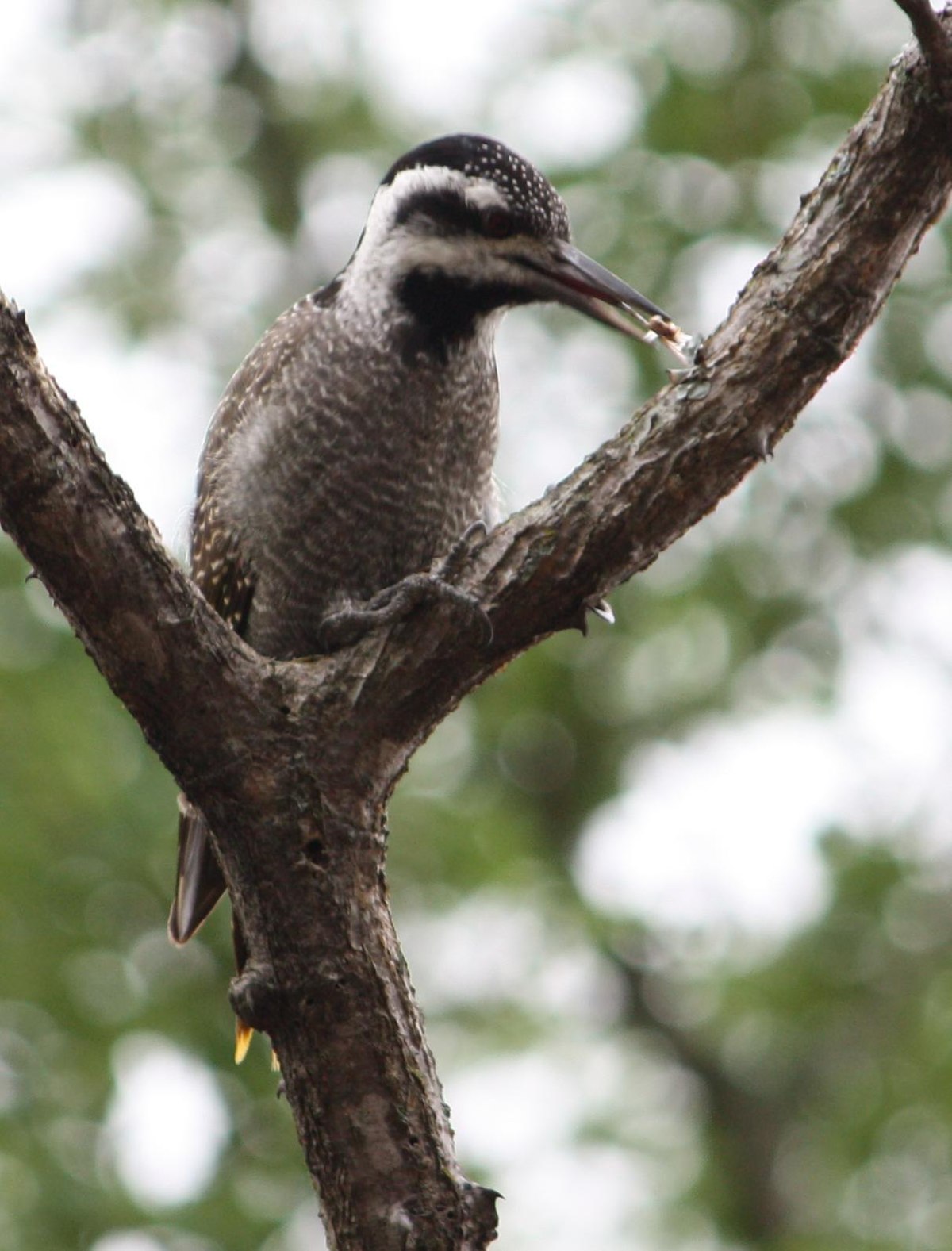
Wikipedia: Bearded woodpecker Source: OTHER
1200px-Thripias_namaquus_-Hlane_Royal_National_Park%2C_Swaziland-8.jpg
![]() The bearded woodpecker (Chloropicus namaquus) is a species of bird in the family Picidae. It has a distinctive black and white head and brownish barred body. It is native to tropical central Africa. It has an extremely wide range and is a fairly common species, and the International Union for Conservation of Nature has rated its conservation status as being of "least concern".[1] Some taxonomic authorities place this species in Dendropicos.
[more]
The bearded woodpecker (Chloropicus namaquus) is a species of bird in the family Picidae. It has a distinctive black and white head and brownish barred body. It is native to tropical central Africa. It has an extremely wide range and is a fairly common species, and the International Union for Conservation of Nature has rated its conservation status as being of "least concern".[1] Some taxonomic authorities place this species in Dendropicos.
[more]
Profile Wikipedia eBird Xeno-Canto

Wikipedia: Olive woodpecker Source: OTHER
1200px-Olive_Woodpecker%2C_Sakania%2C_DRC_%2812404103034%29%2C_crop.jpg
![]() The olive woodpecker (Dendropicos griseocephalus) is a species of bird in the woodpecker family Picidae.[2]
[more]
The olive woodpecker (Dendropicos griseocephalus) is a species of bird in the woodpecker family Picidae.[2]
[more]
Profile Wikipedia eBird Xeno-Canto

Wikipedia: Cardinal woodpecker Source: OTHER
Cardinal_Woodpecker_-_MALE%2C_Dendropicos_fuscescens_at_Pilanesberg_National_Park%2C_Northwest_Province%2C_South_Africa_%2814905279159%29.jpg
![]() The cardinal woodpecker (Dendropicos fuscescens) is a widespread and common resident breeder in much of Sub-Saharan Africa. It occurs in a wide range of habitats, ranging from dense forest to thorn bush. They are fairly vocal and are easily identified by their call notes. The sexes are distinguishable by their head patterns.
[more]
The cardinal woodpecker (Dendropicos fuscescens) is a widespread and common resident breeder in much of Sub-Saharan Africa. It occurs in a wide range of habitats, ranging from dense forest to thorn bush. They are fairly vocal and are easily identified by their call notes. The sexes are distinguishable by their head patterns.
[more]
Profile Wikipedia eBird Xeno-Canto
Black collared barbet. 2016-09-23 08.24.08 Botswana
First observed in Botswana on 2016-09-23.
![]() The black-collared barbet (Lybius torquatus) is a species of bird in the family Lybiidae which is native to sub-Saharan Africa. Indigenous names include isiKhulukhulu and isiQonQotho in isiZulu, and Isinagogo in isiXhosa.[2]
[more]
The black-collared barbet (Lybius torquatus) is a species of bird in the family Lybiidae which is native to sub-Saharan Africa. Indigenous names include isiKhulukhulu and isiQonQotho in isiZulu, and Isinagogo in isiXhosa.[2]
[more]
Profile Wikipedia eBird Xeno-Canto

Wikipedia: Yellow-fronted tinkerbird Source: OTHER
Yellow-fronted_tinkerbird%2C_Pogoniulus_chrysoconus%2C_at_Walter_Sisulu_National_Botanical_Garden%2C_South_Africa_%2815819114098%29%2C_crop.jpg
![]() The yellow-fronted tinkerbird (Pogoniulus chrysoconus) is a small African barbet formerly known as yellow-fronted tinker barbet. It is sometimes considered conspecific with its southern counterpart, the red-fronted tinkerbird, Pogoniulus pusillus. Barbets are near passerine birds with bristles around the base of the bill and a world-wide tropical distribution.
[more]
The yellow-fronted tinkerbird (Pogoniulus chrysoconus) is a small African barbet formerly known as yellow-fronted tinker barbet. It is sometimes considered conspecific with its southern counterpart, the red-fronted tinkerbird, Pogoniulus pusillus. Barbets are near passerine birds with bristles around the base of the bill and a world-wide tropical distribution.
[more]
Profile Wikipedia eBird Xeno-Canto
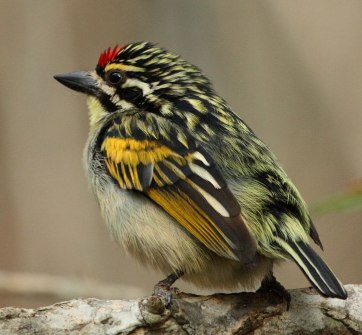
Wikipedia: Red-fronted tinkerbird Source: OTHER
Tinkerbird_Red-fronted_2010_10_08_16_Alan_Manson_Ithala_GR.jpg
![]() The red-fronted tinkerbird, (Pogoniulus pusillus) is a small African barbet. Barbets are near-passerine birds with bristles around the base of the bill. They have a world-wide tropical distribution.
[more]
The red-fronted tinkerbird, (Pogoniulus pusillus) is a small African barbet. Barbets are near-passerine birds with bristles around the base of the bill. They have a world-wide tropical distribution.
[more]
Profile Wikipedia eBird Xeno-Canto

Wikipedia: Yellow-rumped tinkerbird Source: OTHER
1200px-Yellow-rumped_Tinkerbird.jpg
![]() The yellow-rumped tinkerbird (Pogoniulus bilineatus) is a bird species in the family Lybiidae (African barbets), which is native to the moist tropical and subtropical regions of sub-Saharan Africa.
[more]
The yellow-rumped tinkerbird (Pogoniulus bilineatus) is a bird species in the family Lybiidae (African barbets), which is native to the moist tropical and subtropical regions of sub-Saharan Africa.
[more]
Profile Wikipedia eBird Xeno-Canto

Wikipedia: Crested barbet Source: OTHER
1200px-Trachyphonus_vaillantii_-near_Sand_River_Selous%2C_Selous_Game_Reserve%2C_Tanzania-8.jpg
![]() The crested barbet (Trachyphonus vaillantii) ('trachys'=rough, 'phone'=voice, sound') is a sub-Saharan bird in the Lybiidae family. Its specific name commemorates François Levaillant, a famed French naturalist.
[more]
The crested barbet (Trachyphonus vaillantii) ('trachys'=rough, 'phone'=voice, sound') is a sub-Saharan bird in the Lybiidae family. Its specific name commemorates François Levaillant, a famed French naturalist.
[more]
Profile Wikipedia eBird Xeno-Canto
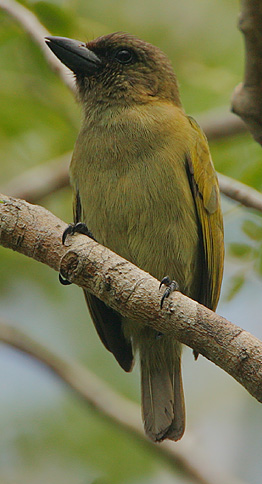
Wikipedia: Green barbet Source: OTHER
Flickr_-_Rainbirder_-_Green_Barbet_%28Stactolaema_olivacea%29_%28cropped%29.jpg
![]() The green barbet (Stactolaema olivacea) is a species of bird in the Lybiidae family (African barbets). It is found in Kenya, Tanzania, Malawi, Mozambique and South Africa.[1] It occurs in forests from sea level to 1,800 metres (5,900 ft).[2] Its isolated populations are vulnerable to forest clearing.[3]
[more]
The green barbet (Stactolaema olivacea) is a species of bird in the Lybiidae family (African barbets). It is found in Kenya, Tanzania, Malawi, Mozambique and South Africa.[1] It occurs in forests from sea level to 1,800 metres (5,900 ft).[2] Its isolated populations are vulnerable to forest clearing.[3]
[more]
Profile Wikipedia eBird Xeno-Canto

Wikipedia: White-eared barbet Source: OTHER
1200px-White-eared_Barbet_RWD.jpg
![]() The white-eared barbet (Stactolaema leucotis) is a species of bird in the family Lybiidae (African barbets).
It is found in Kenya, Malawi, Mozambique, South Africa, Swaziland, Tanzania, and Zimbabwe.
[more]
The white-eared barbet (Stactolaema leucotis) is a species of bird in the family Lybiidae (African barbets).
It is found in Kenya, Malawi, Mozambique, South Africa, Swaziland, Tanzania, and Zimbabwe.
[more]
Profile Wikipedia eBird Xeno-Canto

Wikipedia: Pied barbet Source: OTHER
1200px-Acacia_pied_barbet_%28Tricholaema_leucomelas_centralis%29.jpg
![]() The acacia pied barbet or pied barbet (Tricholaema leucomelas) is a species of bird in the family Lybiidae.
[more]
The acacia pied barbet or pied barbet (Tricholaema leucomelas) is a species of bird in the family Lybiidae.
[more]
Profile Wikipedia eBird Xeno-Canto
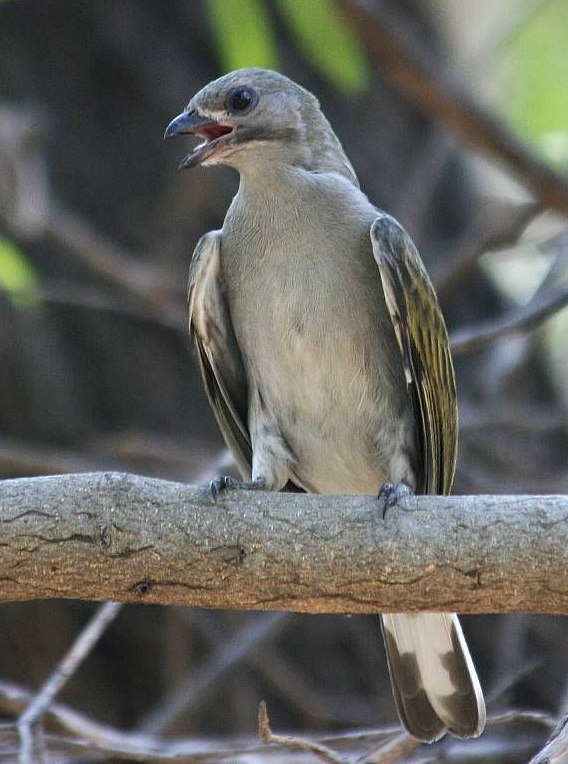
Wikipedia: Lesser honeyguide
![]() The lesser honeyguide (Indicator minor) is a species of bird in the family Indicatoridae.
[more]
The lesser honeyguide (Indicator minor) is a species of bird in the family Indicatoridae.
[more]
Profile Wikipedia eBird Xeno-Canto

Wikipedia: Greater honeyguide Source: OTHER
1200px-Greater_Honeyguide%2C_Gambia.jpg
![]() The greater honeyguide (Indicator indicator) is a bird in the family Indicatoridae, paleotropical near passerine birds related to the woodpeckers. Its English and scientific names refer to its habit of guiding people to bee colonies. Claims that it also guides non-human animals are disputed.
[more]
The greater honeyguide (Indicator indicator) is a bird in the family Indicatoridae, paleotropical near passerine birds related to the woodpeckers. Its English and scientific names refer to its habit of guiding people to bee colonies. Claims that it also guides non-human animals are disputed.
[more]
Profile Wikipedia eBird Xeno-Canto

Wikipedia: Scaly-throated honeyguide Source: OTHER
Flickr_-_Rainbirder_-_Scaly-throated_Honeyguide_%28Indicator_variegatus%29.jpg
![]() The scaly-throated honeyguide (Indicator variegatus) is a species of bird in the family Indicatoridae.
[more]
The scaly-throated honeyguide (Indicator variegatus) is a species of bird in the family Indicatoridae.
[more]
Profile Wikipedia eBird Xeno-Canto

Wikipedia: Wahlberg's honeyguide Source: OTHER
Wahlberg%27s_Honeyguide_%28Prodotiscus_regulus%29.jpg
![]() The brown-backed honeybird (Prodotiscus regulus), also known as Wahlberg's honeybird, Wahlberg's honeyguide and sharp-billed honeyguide, is a species of bird in the family Indicatoridae. This bird is named after the Swedish naturalist Johan August Wahlberg.
[more]
The brown-backed honeybird (Prodotiscus regulus), also known as Wahlberg's honeybird, Wahlberg's honeyguide and sharp-billed honeyguide, is a species of bird in the family Indicatoridae. This bird is named after the Swedish naturalist Johan August Wahlberg.
[more]

Wikipedia: Rose-ringed parakeet Source: OTHER
1200px-Rose-ringed_parakeet_%28Psittacula_krameri_borealis%29_male_Jaipur_2.jpg
This bird appears across the great seas in the following continents:
Europe, North America, Africa.
![]() The rose-ringed parakeet (Psittacula krameri), also known as the ring-necked parakeet, is a medium-sized parrot in the genus Psittacula, of the family Psittacidae. It has disjunct native ranges in Africa and the Indian Subcontinent, and is now introduced into many other parts of the world where feral populations have established themselves and are bred for the exotic pet trade.
[more]
The rose-ringed parakeet (Psittacula krameri), also known as the ring-necked parakeet, is a medium-sized parrot in the genus Psittacula, of the family Psittacidae. It has disjunct native ranges in Africa and the Indian Subcontinent, and is now introduced into many other parts of the world where feral populations have established themselves and are bred for the exotic pet trade.
[more]

Wikipedia: Peach-faced lovebird Source: OTHER
1200px-Rosy-faced_lovebird_%28Agapornis_roseicollis_roseicollis%29.jpg
This bird appears across the great seas in the following continents:
North America, Africa.
![]() The rosy-faced lovebird (Agapornis roseicollis), also known as the rosy-collared or peach-faced lovebird, is a species of lovebird native to arid regions in southwestern Africa such as the Namib Desert. A loud and constant chirper, these birds are very social animals and often congregate in small groups in the wild. They eat throughout the day and take frequent baths. Coloration can vary widely among populations. Plumage is identical in males and females. Lovebirds are renowned for their sleep position in which they sit side-by-side and turn their faces in towards each other. Also, females are well noted to tear raw materials into long strips, "twisty-tie" them onto their backs, and fly substantial distances back to make a nest. They are common in the pet industry.
[more]
The rosy-faced lovebird (Agapornis roseicollis), also known as the rosy-collared or peach-faced lovebird, is a species of lovebird native to arid regions in southwestern Africa such as the Namib Desert. A loud and constant chirper, these birds are very social animals and often congregate in small groups in the wild. They eat throughout the day and take frequent baths. Coloration can vary widely among populations. Plumage is identical in males and females. Lovebirds are renowned for their sleep position in which they sit side-by-side and turn their faces in towards each other. Also, females are well noted to tear raw materials into long strips, "twisty-tie" them onto their backs, and fly substantial distances back to make a nest. They are common in the pet industry.
[more]

Wikipedia: Brown-necked parrot Source: OTHER
Kapsky.jpg
![]() The brown-necked parrot (Poicephalus fuscicollis), sometimes known in aviculture as the uncape parrot,[2] is a large Poicephalus parrot species endemic to Africa consisting of the savanna-dwelling brown-necked parrot (P. fuscicollis fuscicollis) and grey-headed parrot (P. f. suahelicus) subspecies. It formerly included the Cape parrot (now Poicephalus robustus) as a subspecies before the Cape parrot was re-classified as a distinct species.[3]
[more]
The brown-necked parrot (Poicephalus fuscicollis), sometimes known in aviculture as the uncape parrot,[2] is a large Poicephalus parrot species endemic to Africa consisting of the savanna-dwelling brown-necked parrot (P. fuscicollis fuscicollis) and grey-headed parrot (P. f. suahelicus) subspecies. It formerly included the Cape parrot (now Poicephalus robustus) as a subspecies before the Cape parrot was re-classified as a distinct species.[3]
[more]
Profile Wikipedia eBird Xeno-Canto

Wikipedia: Brown-headed parrot Source: OTHER
1200px-Brown-headed_Parrot_%28Poicephalus_cryptoxanthus%29_%2811688869593%29.jpg
![]() The brown-headed parrot (Poicephalus cryptoxanthus) is a south-eastern African parrot.
[more]
The brown-headed parrot (Poicephalus cryptoxanthus) is a south-eastern African parrot.
[more]
Profile Wikipedia eBird Xeno-Canto

Wikipedia: Cape parrot Source: OTHER
Poicephalus_robustus_-South_Africa-6a.jpg
![]() The Cape parrot (Poicephalus robustus) or Levaillant's parrot is a large, temperate forest dwelling parrot of the genus Poicephalus endemic to South Africa. It was formerly grouped as a subspecies along with the savanna-dwelling brown-necked parrot (P. fuscicollis fuscicollis) and grey-headed parrot (P. f. suahelicus), but is now considered a distinct species.
[more]
The Cape parrot (Poicephalus robustus) or Levaillant's parrot is a large, temperate forest dwelling parrot of the genus Poicephalus endemic to South Africa. It was formerly grouped as a subspecies along with the savanna-dwelling brown-necked parrot (P. fuscicollis fuscicollis) and grey-headed parrot (P. f. suahelicus), but is now considered a distinct species.
[more]
Profile Wikipedia eBird Xeno-Canto
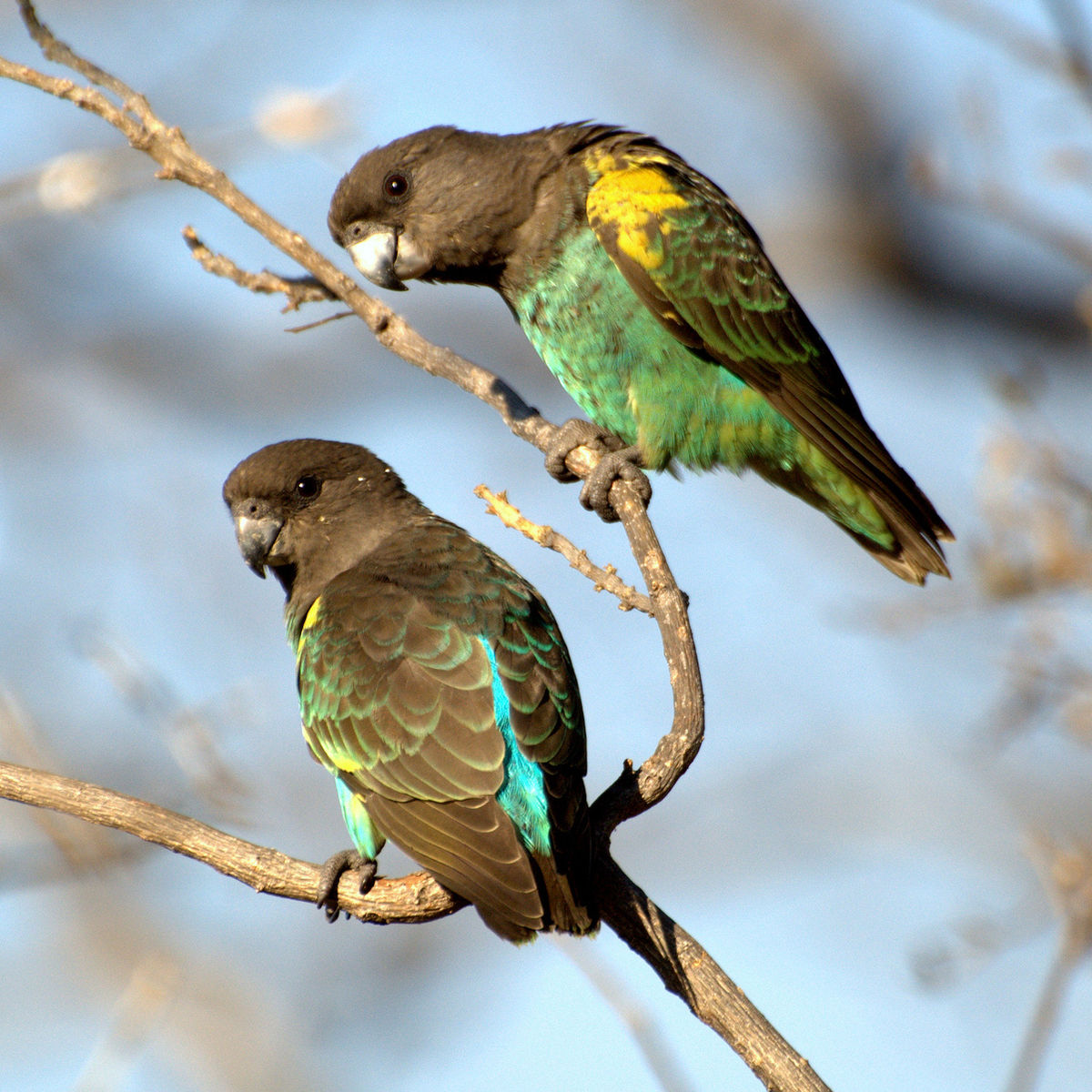
Wikipedia: Meyer's parrot Source: OTHER
1200px-Poicephalus_meyeri_-Zimbabwe_-two-8-3c.jpg
![]() Meyer's parrot (Poicephalus meyeri), also known as the brown parrot,[2] is a species of parrot native to Africa. A Meyer's parrot has black feathers, turquoise belly, blue rump, and bright yellow markings on the carpal joint of the wings. Most subspecies have some yellow on the top of the head as well. Forshaw (1989) recognizes six subspecies of P. meyeri which vary in home range, size and in markings, including the extent of yellow markings to the head and wings and the intense of turquoise markings on the belly and rump.
[more]
Meyer's parrot (Poicephalus meyeri), also known as the brown parrot,[2] is a species of parrot native to Africa. A Meyer's parrot has black feathers, turquoise belly, blue rump, and bright yellow markings on the carpal joint of the wings. Most subspecies have some yellow on the top of the head as well. Forshaw (1989) recognizes six subspecies of P. meyeri which vary in home range, size and in markings, including the extent of yellow markings to the head and wings and the intense of turquoise markings on the belly and rump.
[more]

Wikipedia: King penguin Source: OTHER
1200px-SGI-2016-South_Georgia_%28Fortuna_Bay%29%E2%80%93King_penguin_%28Aptenodytes_patagonicus%29_04.jpg
![]() Yellow: Aptenodytes patagonicus halli
Yellow: Aptenodytes patagonicus halli
Green: breeding areas
[more]

Wikipedia: Northern rockhopper penguin Source: OTHER
1200px-Eudyptes_moseleyi_-Zoologischer_Garten_Berlin%2C_Germany-8a.jpg
![]() The northern rockhopper penguin, Moseley's rockhopper penguin, or Moseley's penguin (Eudyptes moseleyi) is a penguin species native to the southern Indian and Atlantic Oceans. It was described as distinct from the southern rockhopper penguin.
[more]
The northern rockhopper penguin, Moseley's rockhopper penguin, or Moseley's penguin (Eudyptes moseleyi) is a penguin species native to the southern Indian and Atlantic Oceans. It was described as distinct from the southern rockhopper penguin.
[more]

Wikipedia: Macaroni penguin Source: OTHER
1200px-SGI-2016-South_Georgia_%28Cooper_Bay%29%E2%80%93Macaroni_penguin_%28Eudyptes_chrysolophus%29_01.jpg
![]() The macaroni penguin (Eudyptes chrysolophus) is a species of penguin found from the Subantarctic to the Antarctic Peninsula. One of six species of crested penguin, it is very closely related to the royal penguin, and some authorities consider the two to be a single species. It bears a distinctive yellow crest, and the face and upperparts are black and sharply delineated from the white underparts. Adults weigh on average 5.5 kg (12 lb) and are 70 cm (28 in) in length. The male and female are similar in appearance; the male is slightly larger and stronger with a relatively larger bill. Like all penguins, it is flightless, with a streamlined body and wings stiffened and flattened into flippers for a marine lifestyle.
[more]
The macaroni penguin (Eudyptes chrysolophus) is a species of penguin found from the Subantarctic to the Antarctic Peninsula. One of six species of crested penguin, it is very closely related to the royal penguin, and some authorities consider the two to be a single species. It bears a distinctive yellow crest, and the face and upperparts are black and sharply delineated from the white underparts. Adults weigh on average 5.5 kg (12 lb) and are 70 cm (28 in) in length. The male and female are similar in appearance; the male is slightly larger and stronger with a relatively larger bill. Like all penguins, it is flightless, with a streamlined body and wings stiffened and flattened into flippers for a marine lifestyle.
[more]
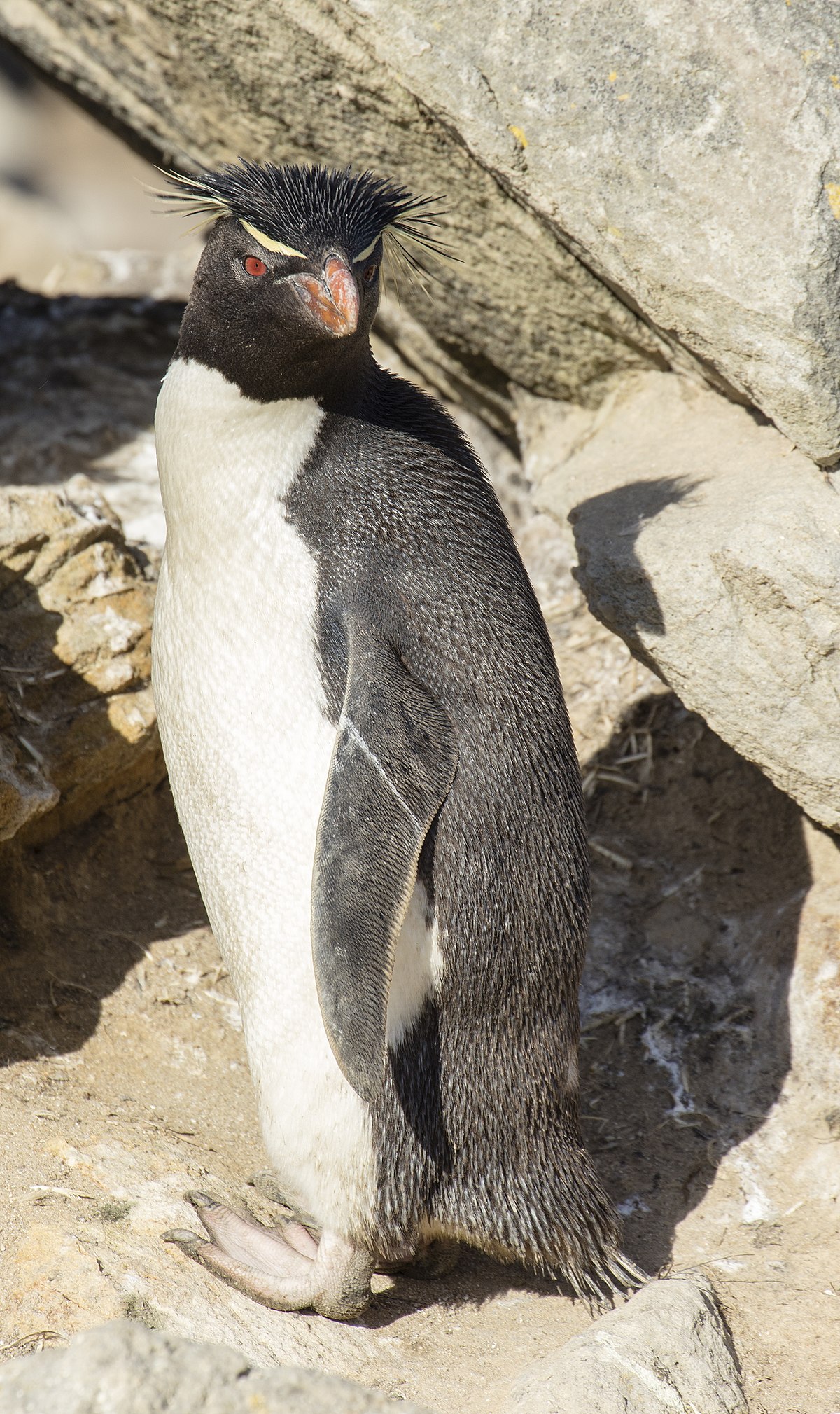
Wikipedia: Rockhopper penguin Source: OTHER
1200px-FAL-2016-New_Island%2C_Falkland_Islands-Rockhopper_penguin_%28Eudyptes_chrysocome%29_05.jpg
African penguin. 2009-11-03 11.56.42 Gqeberha (former Port Elisabeth)
First observed in Gqeberha (former Port Elisabeth) on 2009-11-03.
![]() The African penguin (Spheniscus demersus), also known as the Cape penguin or South African penguin, is a species of penguin confined to southern African waters. Like all extant penguins, it is flightless, with a streamlined body and wings stiffened and flattened into flippers for a marine habitat. Adults weigh an average of 2.2–3.5 kg (4.9–7.7 lb) and are 60–70 cm (24–28 in) tall. The species has distinctive pink patches of skin above the eyes and a black facial mask. The body upperparts are black and sharply delineated from the white underparts, which are spotted and marked with a black band. The pink glands above their eyes help them with thermoregulation. To cope with changing temperatures, blood is sent to the glands to be cooled by the air.[2]
[more]
The African penguin (Spheniscus demersus), also known as the Cape penguin or South African penguin, is a species of penguin confined to southern African waters. Like all extant penguins, it is flightless, with a streamlined body and wings stiffened and flattened into flippers for a marine habitat. Adults weigh an average of 2.2–3.5 kg (4.9–7.7 lb) and are 60–70 cm (24–28 in) tall. The species has distinctive pink patches of skin above the eyes and a black facial mask. The body upperparts are black and sharply delineated from the white underparts, which are spotted and marked with a black band. The pink glands above their eyes help them with thermoregulation. To cope with changing temperatures, blood is sent to the glands to be cooled by the air.[2]
[more]
Profile Wikipedia eBird Vogelwarte BirdLife ZH ornitho.ch bird-song.ch Xeno-Canto BirdID NABU
Zwergtaucher. 2022-06-25 12.07.24 La Sauge
First observed in Gqeberha (former Port Elisabeth) on 2009-10-22.
![]() The little grebe (Tachybaptus ruficollis), also known as dabchick, is a member of the grebe family of water birds. The genus name is from Ancient Greek takhus "fast" and bapto "to sink under". The specific ruficollis is from Latin rufus "red" and Modern Latin -collis, "-necked", itself derived from Latin collum "neck".[2]
[more]
The little grebe (Tachybaptus ruficollis), also known as dabchick, is a member of the grebe family of water birds. The genus name is from Ancient Greek takhus "fast" and bapto "to sink under". The specific ruficollis is from Latin rufus "red" and Modern Latin -collis, "-necked", itself derived from Latin collum "neck".[2]
[more]
Vocalization: ![]() Relatively vocal compared to many other grebes. [Link]
Relatively vocal compared to many other grebes. [Link]
Calls: ![]() Call; sometimes a single quite clear high pitched "dydlylyyt". More often combined into longer phrases with harsher quality, oscillating like laughter and travelling up and down in pitch in agitated motion. Reminiscent of female Cuckoo. [Link]
Call; sometimes a single quite clear high pitched "dydlylyyt". More often combined into longer phrases with harsher quality, oscillating like laughter and travelling up and down in pitch in agitated motion. Reminiscent of female Cuckoo. [Link]
Physical details: length=25-29 cm,
wingspan=40-45 cm,
weight=140-193 g
Habitats:
River and lake
Profile Wikipedia eBird Audubon AllAboutBirds Xeno-Canto BirdID NABU
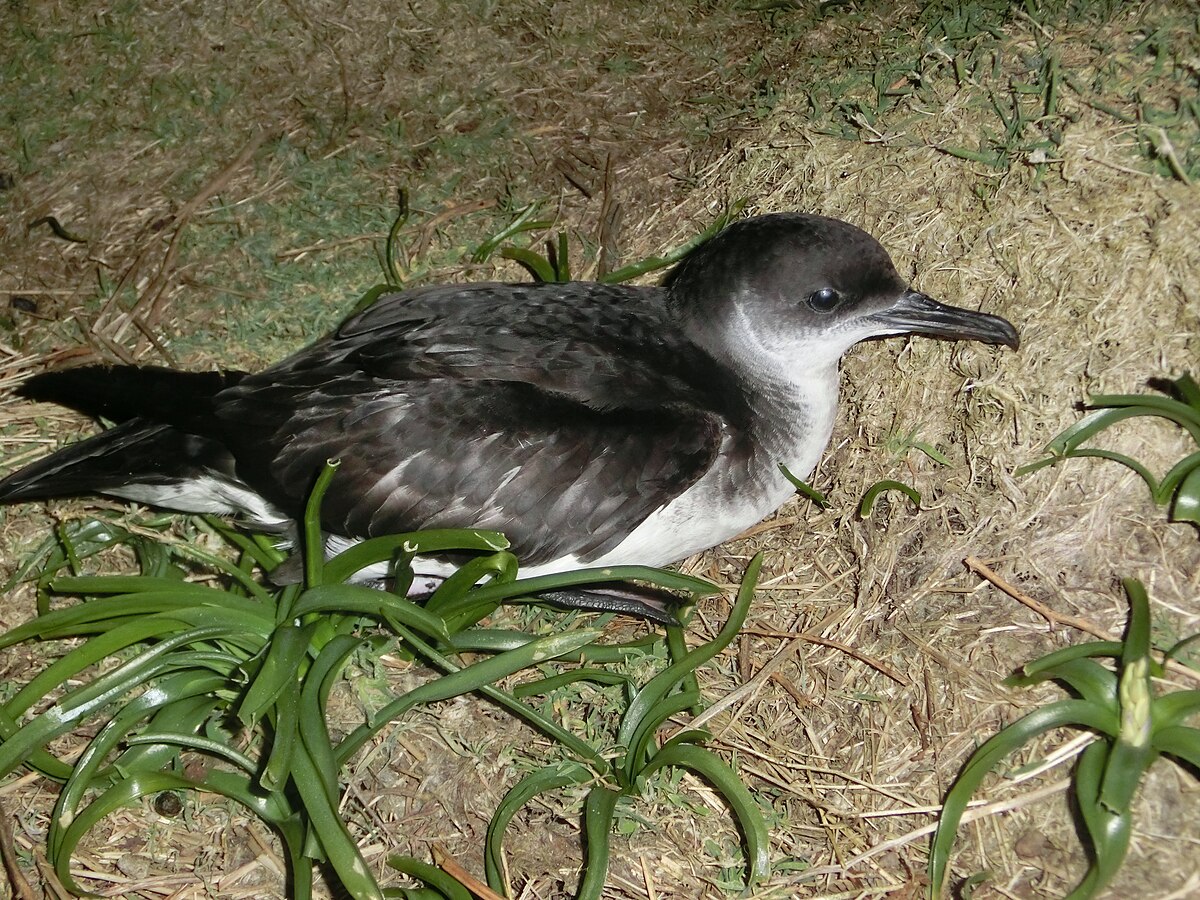
Wikipedia: Manx shearwater Source: OTHER
1200px-Manx_Shearwater.JPG
This bird appears across the great seas in the following continents:
Europe, North America, Africa.
General: ![]() The Manx shearwater (Puffinus puffinus) is a medium-sized shearwater in the seabird family Procellariidae. The scientific name of this species records a name shift: Manx shearwaters were called Manks puffins in the 17th century. Puffin is an Anglo-Norman word (Middle English pophyn) for the cured carcasses of nestling shearwaters. The Atlantic puffin acquired the name much later, possibly because of its similar nesting habits.
[more]
The Manx shearwater (Puffinus puffinus) is a medium-sized shearwater in the seabird family Procellariidae. The scientific name of this species records a name shift: Manx shearwaters were called Manks puffins in the 17th century. Puffin is an Anglo-Norman word (Middle English pophyn) for the cured carcasses of nestling shearwaters. The Atlantic puffin acquired the name much later, possibly because of its similar nesting habits.
[more]
Vocalization: ![]() Vocal at breeding ground. [Link]
Vocal at breeding ground. [Link]
Calls: ![]() The call is sharp and wailing, and consist of two parts. A drawn, "inhalation", is immediately followed by a trisyllabic "ka-ya-ya". [Link]
The call is sharp and wailing, and consist of two parts. A drawn, "inhalation", is immediately followed by a trisyllabic "ka-ya-ya". [Link]
Physical details: length=31-36 cm,
wingspan=76-88 cm,
weight=375-459 g

Wikipedia: Subantarctic shearwater Source: OTHER
PuffinusElegansKeulemans.jpg
General: ![]() The subantarctic shearwater (Puffinus elegans) is a small bird species which breeds in Tristan da Cunha, islands of the southern Indian Ocean and New Zealand Subantarctic Islands.
[more]
The subantarctic shearwater (Puffinus elegans) is a small bird species which breeds in Tristan da Cunha, islands of the southern Indian Ocean and New Zealand Subantarctic Islands.
[more]

Wikipedia: Tropical shearwater Source: OTHER
P%C3%A9trel_de_Barau_.jpg
This bird appears across the great seas in the following continents:
North America, Africa.
![]() The tropical shearwater (Puffinus bailloni) is a seabird in the family Procellariidae formerly considered conspecific with Audubon's shearwater (Puffinus lherminieri).[2]
[more]
The tropical shearwater (Puffinus bailloni) is a seabird in the family Procellariidae formerly considered conspecific with Audubon's shearwater (Puffinus lherminieri).[2]
[more]
Profile Wikipedia eBird Xeno-Canto

Wikipedia: Southern fulmar Source: OTHER
1200px-Fulmarus_glacialoides_-_SE_Tasmania.jpg
![]() The southern fulmar (Fulmarus glacialoides) is a seabird of the Southern Hemisphere. Along with the northern fulmar, F. glacialis, it belongs to the fulmar genus Fulmarus in the family Procellariidae, the true petrels. It is also known as the Antarctic fulmar[1] or silver-grey fulmar.[2]
[more]
The southern fulmar (Fulmarus glacialoides) is a seabird of the Southern Hemisphere. Along with the northern fulmar, F. glacialis, it belongs to the fulmar genus Fulmarus in the family Procellariidae, the true petrels. It is also known as the Antarctic fulmar[1] or silver-grey fulmar.[2]
[more]
Profile Wikipedia eBird Xeno-Canto

Wikipedia: Cape petrel Source: OTHER
1200px-Daption_capense_in_flight_2_-_SE_Tasmania.jpg
![]() The Cape petrel (Daption capense), also called the Cape pigeon, pintado petrel, or Cape fulmar,[4] is a common seabird of the Southern Ocean from the family Procellariidae. It is the only member of the genus Daption, and is allied to the fulmarine petrels, and the giant petrels. They are extremely common seabirds with an estimated population of around 2 million.[citation needed]
[more]
The Cape petrel (Daption capense), also called the Cape pigeon, pintado petrel, or Cape fulmar,[4] is a common seabird of the Southern Ocean from the family Procellariidae. It is the only member of the genus Daption, and is allied to the fulmarine petrels, and the giant petrels. They are extremely common seabirds with an estimated population of around 2 million.[citation needed]
[more]
Profile Wikipedia eBird Xeno-Canto
In flight is perhaps a southern giant petrel. 2019-02-07 09.34.10 Patagonia
First observed in Patagonia on 2019-02-07.
![]() The southern giant petrel (Macronectes giganteus), also known as the Antarctic giant petrel, giant fulmar, stinker, and stinkpot, is a large seabird of the southern oceans. Its distribution overlaps broadly with the similar northern giant petrel, though it overall is centered slightly further south. Adults of the two species can be distinguished by the colour of their bill-tip: greenish in the southern and reddish in the northern.
[more]
The southern giant petrel (Macronectes giganteus), also known as the Antarctic giant petrel, giant fulmar, stinker, and stinkpot, is a large seabird of the southern oceans. Its distribution overlaps broadly with the similar northern giant petrel, though it overall is centered slightly further south. Adults of the two species can be distinguished by the colour of their bill-tip: greenish in the southern and reddish in the northern.
[more]
Profile Wikipedia eBird Xeno-Canto

Wikipedia: Northern giant-petrel Source: OTHER
1200px-Macronectes_halli_-Godthul%2C_South_Georgia%2C_British_Overseas_Territories%2C_UK_-flying-8.jpg
![]() The northern giant petrel (Macronectes halli), also known as Hall's giant petrel, is a large predatory seabird of the southern oceans. Its distribution overlaps broadly, but is slightly north of, the similar southern giant petrel (Macronectes giganteus).
[more]
The northern giant petrel (Macronectes halli), also known as Hall's giant petrel, is a large predatory seabird of the southern oceans. Its distribution overlaps broadly, but is slightly north of, the similar southern giant petrel (Macronectes giganteus).
[more]
Profile Wikipedia eBird Xeno-Canto

Wikipedia: Antarctic prion Source: OTHER
Pachyptila_desolata_-South_Atlantic_-flying-8.jpg
![]() The Antarctic prion (Pachyptila desolata) also known as the dove prion, or totorore in Māori, is the largest of the prions,[2] a genus of small petrels of the Southern Ocean.
[more]
The Antarctic prion (Pachyptila desolata) also known as the dove prion, or totorore in Māori, is the largest of the prions,[2] a genus of small petrels of the Southern Ocean.
[more]
Profile Wikipedia eBird Xeno-Canto

Wikipedia: Salvin's prion Source: OTHER
Medium-billed_Prion.jpg
![]() Salvin's prion (Pachyptila salvini), also known as the medium-billed prion, is a species of seabird in the petrel family Procellariidae.
[more]
Salvin's prion (Pachyptila salvini), also known as the medium-billed prion, is a species of seabird in the petrel family Procellariidae.
[more]
Profile Wikipedia eBird Xeno-Canto

Wikipedia: Slender-billed prion Source: OTHER
1200px-Slender-billed_Prion_Close.jpg
![]() The slender-billed prion (Pachyptila belcheri) or thin-billed prion, is a species of petrel, a seabird in the family Procellariidae. It is found in the southern oceans.
[more]
The slender-billed prion (Pachyptila belcheri) or thin-billed prion, is a species of petrel, a seabird in the family Procellariidae. It is found in the southern oceans.
[more]
Profile Wikipedia eBird Xeno-Canto
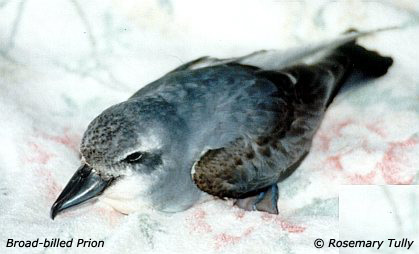
Wikipedia: Broad-billed prion Source: OTHER
Broad_billed_prion.jpg
![]() The broad-billed prion (Pachyptila vittata) is a small seabird, but the largest prion, with grey upperparts plumage, and white underparts. It has many other names that have been used such as blue-billed dove-petrel, broad-billed dove-petrel, long-billed prion, common prion, icebird, and whalebird.[2]
[more]
The broad-billed prion (Pachyptila vittata) is a small seabird, but the largest prion, with grey upperparts plumage, and white underparts. It has many other names that have been used such as blue-billed dove-petrel, broad-billed dove-petrel, long-billed prion, common prion, icebird, and whalebird.[2]
[more]
Profile Wikipedia eBird Xeno-Canto

Wikipedia: Fairy prion Source: OTHER
1200px-Fairy_Prion_with_egg.jpg
![]() The fairy prion (Pachyptila turtur) is a small seabird with the standard prion plumage of black upperparts and white underneath with an "M" wing marking.
[more]
The fairy prion (Pachyptila turtur) is a small seabird with the standard prion plumage of black upperparts and white underneath with an "M" wing marking.
[more]
Profile Wikipedia eBird Xeno-Canto

Wikipedia: White-chinned petrel Source: OTHER
1200px-Procellaria_aequinoctialis_1_-_SE_Tasmania.jpg
![]() The white-chinned petrel (Procellaria aequinoctialis) or Cape hen,[3] is a large shearwater in the family Procellariidae. It ranges around the Southern Ocean as far north as southern Australia, Peru and Namibia, and breeds colonially on scattered islands.
[more]
The white-chinned petrel (Procellaria aequinoctialis) or Cape hen,[3] is a large shearwater in the family Procellariidae. It ranges around the Southern Ocean as far north as southern Australia, Peru and Namibia, and breeds colonially on scattered islands.
[more]
Profile Wikipedia eBird Xeno-Canto

Wikipedia: Spectacled petrel Source: OTHER
Spectacled_Petrel%2C_Procellaria_conspicillata_Cropped.jpg
![]() The spectacled petrel (Procellaria conspicillata) is a rare seabird that nests only on the high western plateau of Inaccessible Island in the South Atlantic Tristan da Cunha group. It is one of the largest petrels that nests in burrows.
[more]
The spectacled petrel (Procellaria conspicillata) is a rare seabird that nests only on the high western plateau of Inaccessible Island in the South Atlantic Tristan da Cunha group. It is one of the largest petrels that nests in burrows.
[more]

Wikipedia: Grey petrel Source: OTHER
1200px-Procellaria_cinerea_-_SE_Tasmania.jpg
![]() The grey petrel (Procellaria cinerea), also called the brown petrel, pediunker or grey shearwater is a species of seabird in the Procellariidae, or petrel family. It occurs in the open seas of the Southern Hemisphere, mainly between 58°S and 32°S.[2]
[more]
The grey petrel (Procellaria cinerea), also called the brown petrel, pediunker or grey shearwater is a species of seabird in the Procellariidae, or petrel family. It occurs in the open seas of the Southern Hemisphere, mainly between 58°S and 32°S.[2]
[more]
Profile Wikipedia eBird Xeno-Canto

Wikipedia: Soft-plumaged petrel Source: OTHER
1200px-Pterodroma_mollis_light_morph_-_SE_Tasmania_2019.jpg
![]() The soft-plumaged petrel (Pterodroma mollis) is a species of seabird in the family Procellariidae.
[more]
The soft-plumaged petrel (Pterodroma mollis) is a species of seabird in the family Procellariidae.
[more]

Wikipedia: Barau's petrel Source: OTHER
Pterodroma_baraui%2C_Durban%2C_Birding_Weto%2C_b.jpg
![]() Barau's petrel (Pterodroma baraui) is a medium-sized gadfly petrel from the family Procellariidae. Its main breeding site is the island of Réunion in the Indian Ocean.
[more]
Barau's petrel (Pterodroma baraui) is a medium-sized gadfly petrel from the family Procellariidae. Its main breeding site is the island of Réunion in the Indian Ocean.
[more]

Wikipedia: White-headed petrel Source: OTHER
1200px-File-Pterodroma_lessonii_in_flight_1_-_SE_Tasmania_2019.jpg
![]() The white-headed petrel (Pterodroma lessonii), also known as the white-headed fulmar is a species of seabird in the petrel family, or Procellariidae. Its length is about 400 mm.[2]
[more]
The white-headed petrel (Pterodroma lessonii), also known as the white-headed fulmar is a species of seabird in the petrel family, or Procellariidae. Its length is about 400 mm.[2]
[more]
Profile Wikipedia eBird Xeno-Canto

Wikipedia: Atlantic petrel Source: OTHER
PterodromaIncerta.jpg
![]() The Atlantic petrel (Pterodroma incerta) is a gadfly petrel endemic to the South Atlantic Ocean. It breeds in enormous colonies on Tristan da Cunha and Gough Island, and ranges at sea from Brazil to Namibia, with most records at sea being to the west of the breeding islands, and along the subtropical convergence.
[more]
The Atlantic petrel (Pterodroma incerta) is a gadfly petrel endemic to the South Atlantic Ocean. It breeds in enormous colonies on Tristan da Cunha and Gough Island, and ranges at sea from Brazil to Namibia, with most records at sea being to the west of the breeding islands, and along the subtropical convergence.
[more]
Profile Wikipedia eBird Xeno-Canto

Wikipedia: Great-winged petrel Source: OTHER
1200px-Pterodroma_macroptera_in_flight_3_-_SE_Tasmania.jpg
![]() The great-winged petrel (Pterodroma macroptera) is a petrel.
[more]
The great-winged petrel (Pterodroma macroptera) is a petrel.
[more]

Wikipedia: Streaked shearwater Source: OTHER
1200px-Streaked_shearwater_sitting.jpg
![]() The streaked shearwater (Calonectris leucomelas) is a species of seabird. The adult bird averages 48 cm (19 in) in length, with a 122 cm (48 in) wingspan.
[more]
The streaked shearwater (Calonectris leucomelas) is a species of seabird. The adult bird averages 48 cm (19 in) in length, with a 122 cm (48 in) wingspan.
[more]

Wikipedia: Tahiti petrel Source: OTHER
Tahitipetrel1.jpg
This bird appears across the great seas in the following continents:
South America, Africa.
![]() The Tahiti petrel (Pseudobulweria rostrata) is a species of seabird in the family Procellariidae. It is found in American Samoa, Australia, Fiji, French Polynesia, Mexico, New Caledonia, New Zealand, the Solomon Islands, Tonga, Vanuatu, and possibly the Cook Islands. It is a pelagic bird of the open seas, but nests in subtropical or tropical moist lowland forest, subtropical or tropical moist montane forest, subtropical or tropical moist shrubland and subtropical or tropical high-altitude shrubland. It has been recorded as a vagrant in Hawaii, Taiwan, Baja California, and, most surprisingly, in North Carolina.
[more]
The Tahiti petrel (Pseudobulweria rostrata) is a species of seabird in the family Procellariidae. It is found in American Samoa, Australia, Fiji, French Polynesia, Mexico, New Caledonia, New Zealand, the Solomon Islands, Tonga, Vanuatu, and possibly the Cook Islands. It is a pelagic bird of the open seas, but nests in subtropical or tropical moist lowland forest, subtropical or tropical moist montane forest, subtropical or tropical moist shrubland and subtropical or tropical high-altitude shrubland. It has been recorded as a vagrant in Hawaii, Taiwan, Baja California, and, most surprisingly, in North Carolina.
[more]

Wikipedia: Kerguelen petrel Source: OTHER
LugensaBrevirostris.jpg
![]() The Kerguelen petrel (Aphrodroma brevirostris) is a small (36 cm long) slate-grey seabird in the family Procellariidae. The species has been described as a "taxonomic oddball", being placed for a long time in Pterodroma (the gadfly petrels) before being split out in 1942 into its own genus Aphrodroma. The position within the procellariids is still a matter of debate; when it was split away from the Pterodroma petrels it was suggested that it may be a fulmarine petrel, whereas a 1998 study placed the species close to the shearwaters and the genus Bulweria.[2]
[more]
The Kerguelen petrel (Aphrodroma brevirostris) is a small (36 cm long) slate-grey seabird in the family Procellariidae. The species has been described as a "taxonomic oddball", being placed for a long time in Pterodroma (the gadfly petrels) before being split out in 1942 into its own genus Aphrodroma. The position within the procellariids is still a matter of debate; when it was split away from the Pterodroma petrels it was suggested that it may be a fulmarine petrel, whereas a 1998 study placed the species close to the shearwaters and the genus Bulweria.[2]
[more]
Profile Wikipedia eBird Xeno-Canto
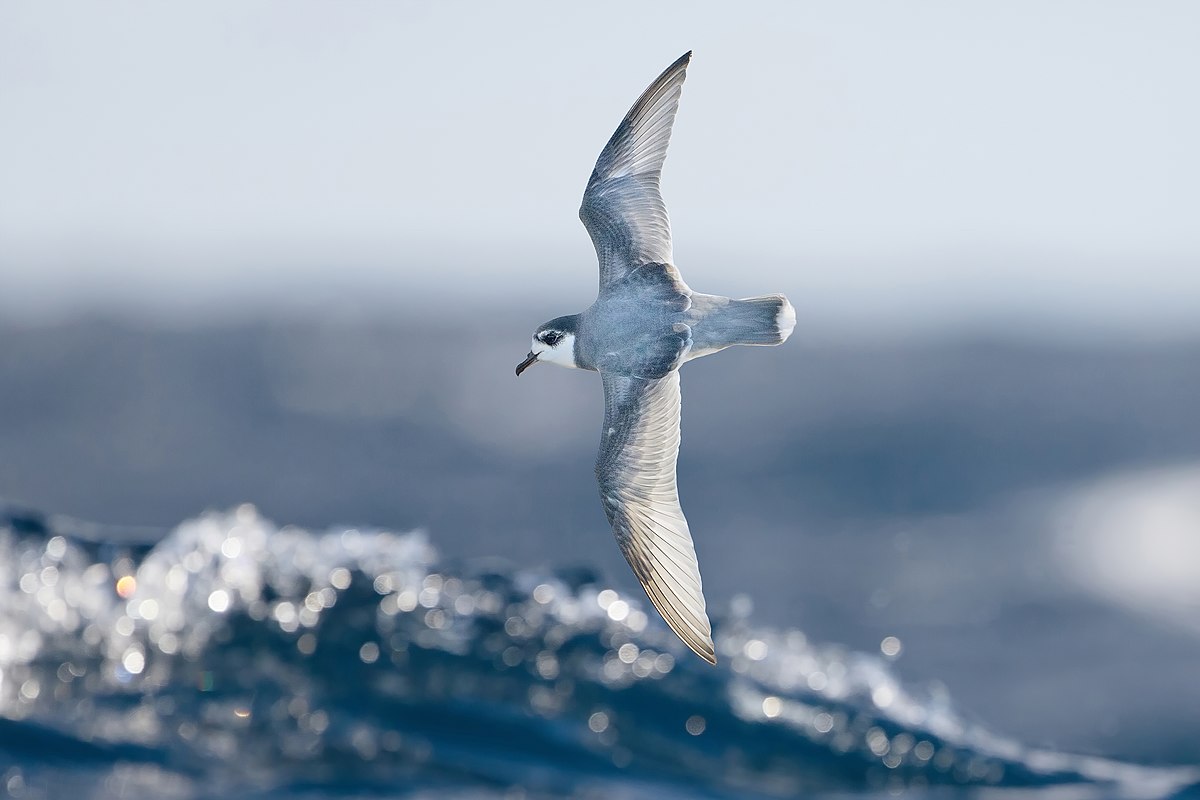
Wikipedia: Blue petrel Source: OTHER
1200px-Halobaena_caerulea_in_flight_-_SE_Tasmania.jpg
![]() The blue petrel (Halobaena caerulea) is a small seabird in the shearwater and petrel family, Procellariidae. This small petrel is the only member of the genus Halobaena, but is closely allied to the prions.[3] It is distributed across the Southern Ocean but breeds at only six known sites, all close to the Antarctic Convergence zone.[4]
[more]
The blue petrel (Halobaena caerulea) is a small seabird in the shearwater and petrel family, Procellariidae. This small petrel is the only member of the genus Halobaena, but is closely allied to the prions.[3] It is distributed across the Southern Ocean but breeds at only six known sites, all close to the Antarctic Convergence zone.[4]
[more]
Profile Wikipedia eBird Xeno-Canto

Wikipedia: Antarctic petrel Source: OTHER
1200px-Antarctic_Petrel%2C_Antarctic_Peninsula_%285940362516%29.jpg
![]() The Antarctic petrel (Thalassoica antarctica) is a boldly marked dark brown and white petrel, found in Antarctica, most commonly in the Ross and Weddell Seas. They eat Antarctic krill, fish, and small squid. They feed while swimming but can dive from both the surface and the air.[3]
[more]
The Antarctic petrel (Thalassoica antarctica) is a boldly marked dark brown and white petrel, found in Antarctica, most commonly in the Ross and Weddell Seas. They eat Antarctic krill, fish, and small squid. They feed while swimming but can dive from both the surface and the air.[3]
[more]
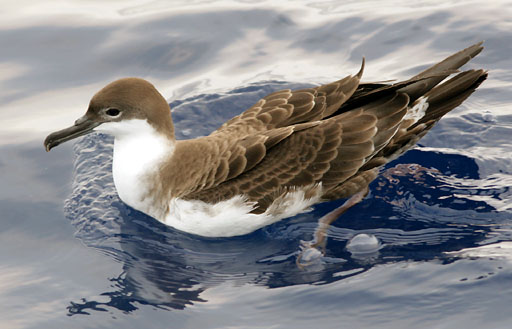
Wikipedia: Great shearwater Source: OTHER
Puffinus_gravisPCCA20070623-3641B.jpg
This bird appears across the great seas in the following continents:
Europe, North America, Africa.
![]() The great shearwater (Ardenna gravis) is a large shearwater in the seabird family Procellariidae. Ardenna was first used to refer to a seabird by Italian naturalist Ulisse Aldrovandi in 1603, and gravis is Latin for "heavy".[3]
[more]
The great shearwater (Ardenna gravis) is a large shearwater in the seabird family Procellariidae. Ardenna was first used to refer to a seabird by Italian naturalist Ulisse Aldrovandi in 1603, and gravis is Latin for "heavy".[3]
[more]
Calls: ![]() Calls at breeding ground a deep, soft, moaning "oooh-aahh" ("surprised or shocked old lady"). Tone fairly clear, and pitch rising and falling. [Link]
Calls at breeding ground a deep, soft, moaning "oooh-aahh" ("surprised or shocked old lady"). Tone fairly clear, and pitch rising and falling. [Link]
Physical details: length=43-51 cm,
wingspan=100-118 cm,
weight=715-950 g

Wikipedia: Sooty shearwater Source: OTHER
1200px-Puffinus_griseus_in_flight_-_SE_Tasmania.jpg
This bird appears across the great seas in the following continents:
Europe, South America, Africa.
General: ![]() The sooty shearwater (Ardenna grisea) is a medium-large shearwater in the seabird family Procellariidae. Ardenna was first used to refer to a seabird by Italian naturalist Ulisse Aldrovandi in 1603, and grisea is medieval Latin for "grey".[2]
[more]
The sooty shearwater (Ardenna grisea) is a medium-large shearwater in the seabird family Procellariidae. Ardenna was first used to refer to a seabird by Italian naturalist Ulisse Aldrovandi in 1603, and grisea is medieval Latin for "grey".[2]
[more]
Vocalization: ![]() Mostly heard at breeding ground. A peculiar, rhythmic, coarse moaning, with a disyllabic attack, followed by a deeper, cooing "in-breath". [Link]
Mostly heard at breeding ground. A peculiar, rhythmic, coarse moaning, with a disyllabic attack, followed by a deeper, cooing "in-breath". [Link]
Physical details: length=40-51 cm,
wingspan=94-109 cm,
weight=666-978 g
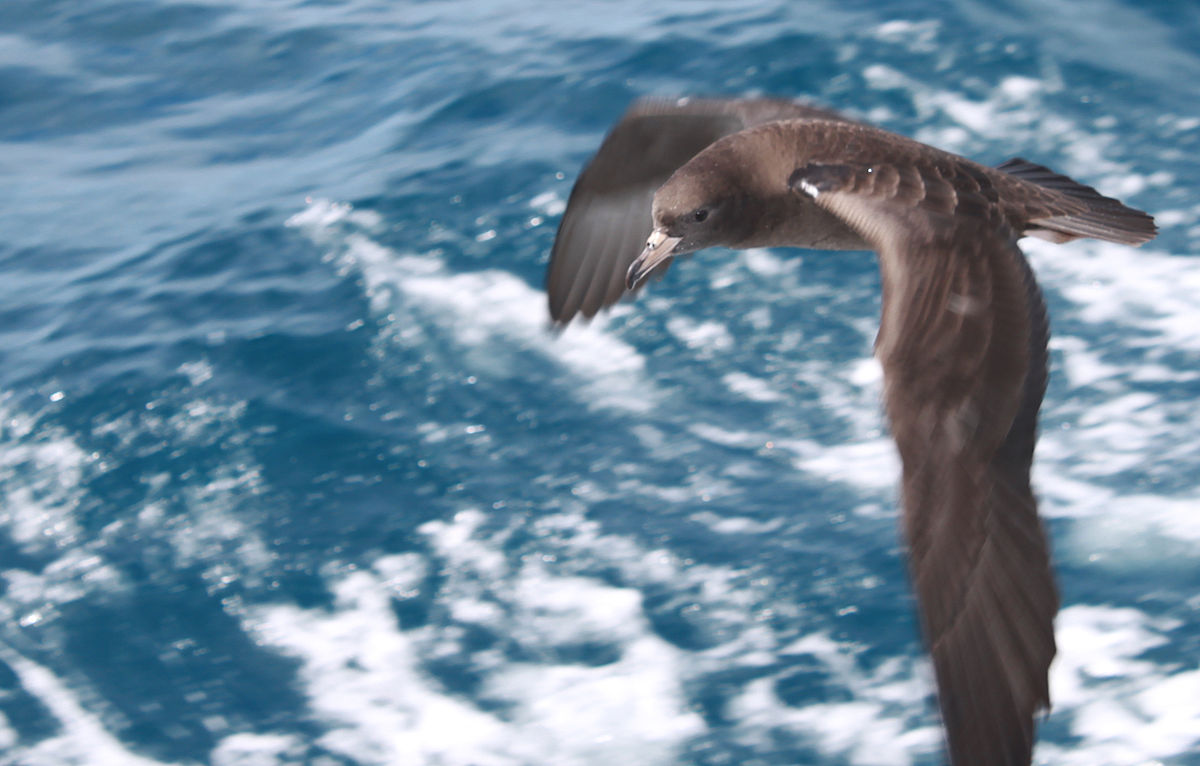
Wikipedia: Flesh-footed shearwater Source: OTHER
1200px-Puffinus_carneipes_-New_Zealand_-flying-8b.jpg
This bird appears across the great seas in the following continents:
North America, Africa.
General: ![]() The flesh-footed shearwater (Ardenna carneipes; formerly Puffinus carneipes) is a medium-sized shearwater. Its plumage is black. It has pale pinkish feet, and a pale bill with a distinct black tip. Together with the equally light-billed pink-footed shearwater, it forms the Hemipuffinus group, a superspecies which may or may not have an Atlantic relative in the great shearwater.[2][3] These large shearwaters are among those that have been separated into the genus Ardenna.[4] Recent genetic analysis indicates evidence of strong divergence between Pacific colonies relative to those in South and Western Australia, thought to be explained by philopatry and differences in foraging strategies during the breeding season.[5]
[more]
The flesh-footed shearwater (Ardenna carneipes; formerly Puffinus carneipes) is a medium-sized shearwater. Its plumage is black. It has pale pinkish feet, and a pale bill with a distinct black tip. Together with the equally light-billed pink-footed shearwater, it forms the Hemipuffinus group, a superspecies which may or may not have an Atlantic relative in the great shearwater.[2][3] These large shearwaters are among those that have been separated into the genus Ardenna.[4] Recent genetic analysis indicates evidence of strong divergence between Pacific colonies relative to those in South and Western Australia, thought to be explained by philopatry and differences in foraging strategies during the breeding season.[5]
[more]

Wikipedia: Wedge-tailed shearwater Source: OTHER
Wedge_tailed_shearwater2.jpg
This bird appears across the great seas in the following continents:
South America, Africa, Asia.
![]() The wedge-tailed shearwater (Ardenna pacifica) is a medium-large shearwater in the seabird family Procellariidae. It is one of the shearwater species that is sometimes referred to as a muttonbird, like the sooty shearwater of New Zealand and the short-tailed shearwater of Australia. It ranges throughout the tropical Pacific and Indian Oceans, roughly between latitudes 35°N and 35°S. It breeds on islands off Japan, on the Islas Revillagigedo, the Hawaiian Islands, the Seychelles, the Northern Mariana Islands, and off Eastern and Western Australia.
[more]
The wedge-tailed shearwater (Ardenna pacifica) is a medium-large shearwater in the seabird family Procellariidae. It is one of the shearwater species that is sometimes referred to as a muttonbird, like the sooty shearwater of New Zealand and the short-tailed shearwater of Australia. It ranges throughout the tropical Pacific and Indian Oceans, roughly between latitudes 35°N and 35°S. It breeds on islands off Japan, on the Islas Revillagigedo, the Hawaiian Islands, the Seychelles, the Northern Mariana Islands, and off Eastern and Western Australia.
[more]
Profile Wikipedia eBird Xeno-Canto

Wikipedia: Wandering albatross Source: OTHER
1200px-Diomedea_exulans_-_SE_Tasmania.jpg
![]() The wandering albatross, snowy albatross, white-winged albatross or goonie[3] (Diomedea exulans) is a large seabird from the family Diomedeidae, which has a circumpolar range in the Southern Ocean. It was the last species of albatross to be described, and was long considered the same species as the Tristan albatross and the Antipodean albatross. A few authors still consider them all subspecies of the same species.[4] The SACC has a proposal on the table to split this species,[5] and BirdLife International has already split it. Together with the Amsterdam albatross, it forms the wandering albatross species complex. The wandering albatross is one of the two largest members of the genus Diomedea (the great albatrosses), being similar in size to the southern royal albatross. It is one of the largest, best known, and most studied species of bird in the world. It has the greatest known wingspan of any living bird, and is also one of the most far-ranging birds. Some individual wandering albatrosses are known to circumnavigate the Southern Ocean three times, covering more than 120,000 km (75,000 mi), in one year.[6]
[more]
The wandering albatross, snowy albatross, white-winged albatross or goonie[3] (Diomedea exulans) is a large seabird from the family Diomedeidae, which has a circumpolar range in the Southern Ocean. It was the last species of albatross to be described, and was long considered the same species as the Tristan albatross and the Antipodean albatross. A few authors still consider them all subspecies of the same species.[4] The SACC has a proposal on the table to split this species,[5] and BirdLife International has already split it. Together with the Amsterdam albatross, it forms the wandering albatross species complex. The wandering albatross is one of the two largest members of the genus Diomedea (the great albatrosses), being similar in size to the southern royal albatross. It is one of the largest, best known, and most studied species of bird in the world. It has the greatest known wingspan of any living bird, and is also one of the most far-ranging birds. Some individual wandering albatrosses are known to circumnavigate the Southern Ocean three times, covering more than 120,000 km (75,000 mi), in one year.[6]
[more]
Profile Wikipedia eBird Xeno-Canto

Wikipedia: Sooty albatross Source: OTHER
Sooty_Albatross_CW.jpg
![]() The sooty albatross, dark-mantled sooty albatross or dark-mantled albatross,[3] (Phoebetria fusca), is a species of bird in the albatross family. They breed on sub-Antarctic islands and range at sea across the Southern Ocean from South America to Australia.[4]
[more]
The sooty albatross, dark-mantled sooty albatross or dark-mantled albatross,[3] (Phoebetria fusca), is a species of bird in the albatross family. They breed on sub-Antarctic islands and range at sea across the Southern Ocean from South America to Australia.[4]
[more]
Profile Wikipedia eBird Xeno-Canto

Wikipedia: Light-mantled albatross Source: OTHER
Light_sooty_albatross_flying.jpg
![]() The light-mantled albatross (Phoebetria palpebrata) also known as the grey-mantled albatross or the light-mantled sooty albatross, is a small albatross in the genus Phoebetria, which it shares with the sooty albatross. The light-mantled albatross was first described as Phoebetria palpebrata by Johann Reinhold Forster, in 1785, based on a specimen from south of the Cape of Good Hope.[4]
[more]
The light-mantled albatross (Phoebetria palpebrata) also known as the grey-mantled albatross or the light-mantled sooty albatross, is a small albatross in the genus Phoebetria, which it shares with the sooty albatross. The light-mantled albatross was first described as Phoebetria palpebrata by Johann Reinhold Forster, in 1785, based on a specimen from south of the Cape of Good Hope.[4]
[more]

Wikipedia: Buller's albatross Source: OTHER
1200px-Thalassarche_bulleri_in_flight_6_-_SE_Tasmania.jpg
![]() Buller's albatross (Thalassarche bulleri) or Buller's mollymawk, is a small mollymawk in the albatross family.
[more]
Buller's albatross (Thalassarche bulleri) or Buller's mollymawk, is a small mollymawk in the albatross family.
[more]

Wikipedia: Grey-headed albatross Source: OTHER
1200px-Thalassarche_chrysostoma_-_SE_Tasmania.jpg
![]() The grey-headed albatross (Thalassarche chrysostoma) also known as the grey-headed mollymawk, is a large seabird from the albatross family. It has a circumpolar distribution, nesting on isolated islands in the Southern Ocean and feeding at high latitudes, further south than any of the other mollymawks. Its name derives from its ashy-grey head, throat and upper neck.
[more]
The grey-headed albatross (Thalassarche chrysostoma) also known as the grey-headed mollymawk, is a large seabird from the albatross family. It has a circumpolar distribution, nesting on isolated islands in the Southern Ocean and feeding at high latitudes, further south than any of the other mollymawks. Its name derives from its ashy-grey head, throat and upper neck.
[more]

Wikipedia: Atlantic yellow-nosed albatross Source: OTHER
Thalassarche_chlororhynchos.png
![]() The Atlantic yellow-nosed albatross (Thalassarche chlororhynchos) is a large seabird in the albatross family. The scientific name is from Ancient Greek. Thalassarche is from thalassa, "sea" and arkhe, "command", and chlororhynchos is from khloros, "yellow", and rhunkhos, "bill".[3]
[more]
The Atlantic yellow-nosed albatross (Thalassarche chlororhynchos) is a large seabird in the albatross family. The scientific name is from Ancient Greek. Thalassarche is from thalassa, "sea" and arkhe, "command", and chlororhynchos is from khloros, "yellow", and rhunkhos, "bill".[3]
[more]

Wikipedia: White-capped albatross Source: OTHER
White-capped_Albatross_%288076884678%29.jpg
![]() The white-capped albatross (Thalassarche cauta steadi) is a mollymawk that breeds on the islands off of New Zealand. Not all experts agree that this form should be recognized as a separate species from the shy albatross, Thalassarche cauta. It is a medium-sized black, slate gray, and white albatross and is the largest of the mollymawks.[citation needed]
[more]
The white-capped albatross (Thalassarche cauta steadi) is a mollymawk that breeds on the islands off of New Zealand. Not all experts agree that this form should be recognized as a separate species from the shy albatross, Thalassarche cauta. It is a medium-sized black, slate gray, and white albatross and is the largest of the mollymawks.[citation needed]
[more]
Profile Wikipedia eBird Xeno-Canto

Wikipedia: Chatham albatross Source: OTHER
Chatham_albatross_%28Thalassarche_eremita%29.jpg
![]() The Chatham albatross (Thalassarche eremita), also known as the Chatham mollymawk or Chatham Island mollymawk,[4] is a medium-sized black-and-white albatross which breeds only on The Pyramid, a large rock stack in the Chatham Islands, New Zealand. It is sometimes treated as a subspecies of the shy albatross Thalassarche cauta. It is the smallest of the shy albatross group.
[more]
The Chatham albatross (Thalassarche eremita), also known as the Chatham mollymawk or Chatham Island mollymawk,[4] is a medium-sized black-and-white albatross which breeds only on The Pyramid, a large rock stack in the Chatham Islands, New Zealand. It is sometimes treated as a subspecies of the shy albatross Thalassarche cauta. It is the smallest of the shy albatross group.
[more]
Profile Wikipedia eBird Xeno-Canto

Wikipedia: Salvin's albatross Source: OTHER
1200px-Thalassarche_salvini_-_SE_Tasmania.jpg
![]() Salvin's albatross (Thalassarche salvini) or Salvin's mollymawk, is a large seabird that breeds only in islands in New Zealand's realm. A medium-sized mollymawk in the albatross family, it was long considered to be a subspecies of the shy albatross. It is a medium-sized black and white albatross.
[more]
Salvin's albatross (Thalassarche salvini) or Salvin's mollymawk, is a large seabird that breeds only in islands in New Zealand's realm. A medium-sized mollymawk in the albatross family, it was long considered to be a subspecies of the shy albatross. It is a medium-sized black and white albatross.
[more]
Profile Wikipedia eBird Xeno-Canto

Wikipedia: Indian yellow-nosed albatross Source: OTHER
1200px-Thalassarche_carteri_-_SE_Tasmania.jpg
![]() The Indian yellow-nosed albatross (Thalassarche carteri) is a member of the albatross family, and is the smallest of the mollymawks. In 2004, BirdLife International[2] split this species from the Atlantic yellow-nosed albatross; however Clements[3] has not split it yet, and the SACC has not either, but recognises the need for a proposal.[4]
[more]
The Indian yellow-nosed albatross (Thalassarche carteri) is a member of the albatross family, and is the smallest of the mollymawks. In 2004, BirdLife International[2] split this species from the Atlantic yellow-nosed albatross; however Clements[3] has not split it yet, and the SACC has not either, but recognises the need for a proposal.[4]
[more]

Wikipedia: Black-browed albatross Source: OTHER
1200px-Thalassarche_melanophrys_-_SE_Tasmania.jpg
![]() The black-browed albatross (Thalassarche melanophris), also known as the black-browed mollymawk,[3] is a large seabird of the albatross family Diomedeidae; it is the most widespread and common member of its family.
[more]
The black-browed albatross (Thalassarche melanophris), also known as the black-browed mollymawk,[3] is a large seabird of the albatross family Diomedeidae; it is the most widespread and common member of its family.
[more]
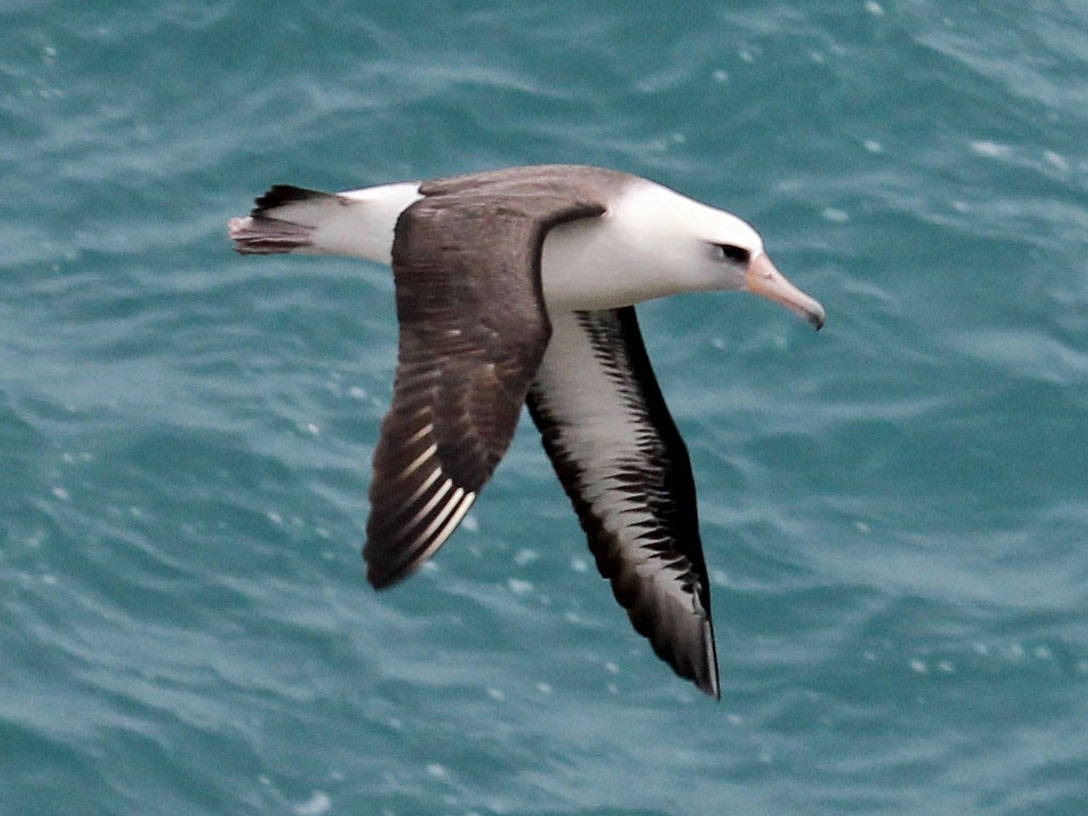
Wikipedia: Laysan albatross Source: OTHER
Laysan_Albatross_RWD2.jpg
This bird appears across the great seas in the following continents:
North America, Africa.
![]() The Laysan albatross (Phoebastria immutabilis) is a large seabird that ranges across the North Pacific. The Northwestern Hawaiian Islands are home to 99.7% of the population. This small (for its family) gull-like albatross is the second-most common seabird in the Hawaiian Islands, with an estimated population of 2.5 million birds, and is currently expanding (or possibly re-expanding) its range to new islands. The Laysan albatross was first described as Diomedea immutabilis by Lionel Walter Rothschild, in 1893, on the basis of a specimen from Laysan Island.[3]
[more]
The Laysan albatross (Phoebastria immutabilis) is a large seabird that ranges across the North Pacific. The Northwestern Hawaiian Islands are home to 99.7% of the population. This small (for its family) gull-like albatross is the second-most common seabird in the Hawaiian Islands, with an estimated population of 2.5 million birds, and is currently expanding (or possibly re-expanding) its range to new islands. The Laysan albatross was first described as Diomedea immutabilis by Lionel Walter Rothschild, in 1893, on the basis of a specimen from Laysan Island.[3]
[more]

Wikipedia: Black-bellied storm-petrel Source: OTHER
Fregetta_tropica%2C_Kaapse_waters%2C_Birding_Weto%2C_a.jpg
![]() The black-bellied storm petrel (Fregetta tropica) is a species of seabird in the family Oceanitidae.
[more]
The black-bellied storm petrel (Fregetta tropica) is a species of seabird in the family Oceanitidae.
[more]

Wikipedia: White-bellied storm-petrel Source: OTHER
1200px-White-bellied_Storm-Petrel-Lord_Howe_Island-26March2013.jpg
![]() The white-bellied storm petrel (Fregetta grallaria) is a species of seabird in the family Oceanitidae. It is found in Angola, Argentina, Australia, Brazil, Chile, Ecuador, French Polynesia, French Southern Territories, Maldives, Namibia, New Zealand, Perú, Saint Helena, and South Africa. Its natural habitat is open seas.
[more]
The white-bellied storm petrel (Fregetta grallaria) is a species of seabird in the family Oceanitidae. It is found in Angola, Argentina, Australia, Brazil, Chile, Ecuador, French Polynesia, French Southern Territories, Maldives, Namibia, New Zealand, Perú, Saint Helena, and South Africa. Its natural habitat is open seas.
[more]
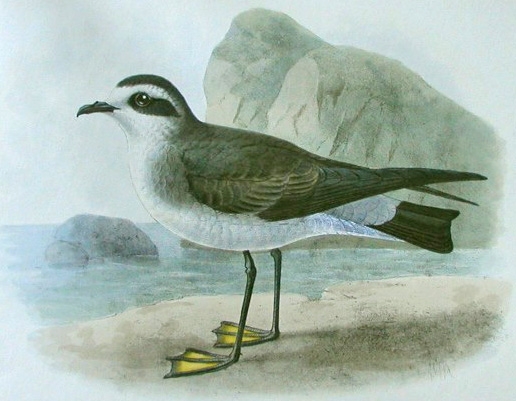
Wikipedia: White-faced storm-petrel Source: OTHER
Godmanstormlg.jpg
This bird appears across the great seas in the following continents:
Europe, North America, South America, Africa.
![]() The white-faced storm petrel (Pelagodroma marina), also known as white-faced petrel is a small seabird of the austral storm petrel family Oceanitidae. It is the only member of the monotypic genus Pelagodroma.
[more]
The white-faced storm petrel (Pelagodroma marina), also known as white-faced petrel is a small seabird of the austral storm petrel family Oceanitidae. It is the only member of the monotypic genus Pelagodroma.
[more]

Wikipedia: Leach's storm-petrel Source: OTHER
1200px-Lesp1.jpg
![]() Leach's storm petrel or Leach's petrel (Oceanodroma leucorhoa) is a small seabird of the tubenose order. It is named after the British zoologist William Elford Leach. The scientific name is derived from Ancient Greek. Oceanodroma is from okeanos, "ocean" and dromos, "runner", and leucorhoa is from leukos, "white" and orrhos, "rump".[2]
[more]
Leach's storm petrel or Leach's petrel (Oceanodroma leucorhoa) is a small seabird of the tubenose order. It is named after the British zoologist William Elford Leach. The scientific name is derived from Ancient Greek. Oceanodroma is from okeanos, "ocean" and dromos, "runner", and leucorhoa is from leukos, "white" and orrhos, "rump".[2]
[more]
Profile Wikipedia eBird Audubon AllAboutBirds Xeno-Canto

Wikipedia: Matsudaira's storm-petrel Source: OTHER
012016-IMG_5713_Matsudaira%27s_Storm-Petrel_%28Oceanodroma_matsudairae%29_%288005427860%29.jpg
This bird appears across the great seas in the following continents:
North America, Africa.
![]() Matsudaira's storm petrel (Oceanodroma matsudairae) is a species of seabird in the family Hydrobatidae.
[more]
Matsudaira's storm petrel (Oceanodroma matsudairae) is a species of seabird in the family Hydrobatidae.
[more]
Profile Wikipedia eBird Xeno-Canto

Wikipedia: Grey-backed storm-petrel Source: OTHER
1200px-Garrodia_nereis_1_-_SE_Tasmania.jpg
![]() The grey-backed storm petrel (Garrodia nereis) is a species of seabird in the austral storm petrel family Oceanitidae. It is monotypic within the genus Garrodia.[2] It is found in Antarctica, Argentina, Australia, Chile, Falkland Islands, French Southern Territories, New Zealand, Saint Helena, South Africa, and South Georgia and the South Sandwich Islands. Its natural habitat is open seas.[1]
[more]
The grey-backed storm petrel (Garrodia nereis) is a species of seabird in the austral storm petrel family Oceanitidae. It is monotypic within the genus Garrodia.[2] It is found in Antarctica, Argentina, Australia, Chile, Falkland Islands, French Southern Territories, New Zealand, Saint Helena, South Africa, and South Georgia and the South Sandwich Islands. Its natural habitat is open seas.[1]
[more]

Wikipedia: European storm-petrel Source: OTHER
1200px-European_Storm_Petrel_From_The_Crossley_ID_Guide_Eastern_Birds.jpg
![]() The European storm petrel, British storm petrel, or just storm petrel (Hydrobates pelagicus) is a seabird in the northern storm petrel family, Hydrobatidae. It is the only member of the genus Hydrobates. The small, square-tailed bird is entirely black except for a broad, white rump and a white band on the under wings, and it has a fluttering, bat-like flight. The large majority of the population breeds on islands off the coasts of Europe, with the greatest numbers in the Faroe Islands, United Kingdom, Ireland, and Iceland. The Mediterranean population is a separate subspecies, but is inseparable at sea from its Atlantic relatives; its strongholds are Filfla Island (Malta), Sicily, and the Balearic Islands.
[more]
The European storm petrel, British storm petrel, or just storm petrel (Hydrobates pelagicus) is a seabird in the northern storm petrel family, Hydrobatidae. It is the only member of the genus Hydrobates. The small, square-tailed bird is entirely black except for a broad, white rump and a white band on the under wings, and it has a fluttering, bat-like flight. The large majority of the population breeds on islands off the coasts of Europe, with the greatest numbers in the Faroe Islands, United Kingdom, Ireland, and Iceland. The Mediterranean population is a separate subspecies, but is inseparable at sea from its Atlantic relatives; its strongholds are Filfla Island (Malta), Sicily, and the Balearic Islands.
[more]
Vocalization: ![]() Heard at breeding ground. Dry, cyclic, rattling and cooing, interrupted by deeper nasal moaning or a higher pitched "kee-ee-kee", with emphasis on second syllable. [Link]
Heard at breeding ground. Dry, cyclic, rattling and cooing, interrupted by deeper nasal moaning or a higher pitched "kee-ee-kee", with emphasis on second syllable. [Link]
Physical details: length=14-18 cm,
wingspan=36-39 cm,
weight=23-30 g

Wikipedia: Wilson's storm-petrel Source: OTHER
1200px-Oceanites_oceanicus_-_SE_Tasmania.jpg
This bird appears across the great seas in the following continents:
Europe, North America, South America, Africa, Asia.
General: ![]() Wilson's storm petrel (Oceanites oceanicus), also known as Wilson's petrel, is a small seabird of the austral storm petrel family Oceanitidae. It is one of the most abundant bird species in the world and has a circumpolar distribution mainly in the seas of the southern hemisphere but extending northwards during the summer of the northern hemisphere. The world population has been estimated to be more than 50 million pairs.[2] The name commemorates the Scottish-American ornithologist Alexander Wilson. The genus name Oceanites refers to the mythical Oceanids, the three thousand daughters of Tethys. The species name is from Latin oceanus, "ocean".[3]
[more]
Wilson's storm petrel (Oceanites oceanicus), also known as Wilson's petrel, is a small seabird of the austral storm petrel family Oceanitidae. It is one of the most abundant bird species in the world and has a circumpolar distribution mainly in the seas of the southern hemisphere but extending northwards during the summer of the northern hemisphere. The world population has been estimated to be more than 50 million pairs.[2] The name commemorates the Scottish-American ornithologist Alexander Wilson. The genus name Oceanites refers to the mythical Oceanids, the three thousand daughters of Tethys. The species name is from Latin oceanus, "ocean".[3]
[more]
Profile Wikipedia eBird Xeno-Canto

Wikipedia: Cape eagle-owl Source: OTHER
1200px-Bubo_capensis%2C_Sossusvlei_1.jpg
![]() The Cape eagle-owl (Bubo capensis) is a species of owl in the family Strigidae.[2] It is one of several large species of the eagle-owl genus Bubo.
[more]
The Cape eagle-owl (Bubo capensis) is a species of owl in the family Strigidae.[2] It is one of several large species of the eagle-owl genus Bubo.
[more]
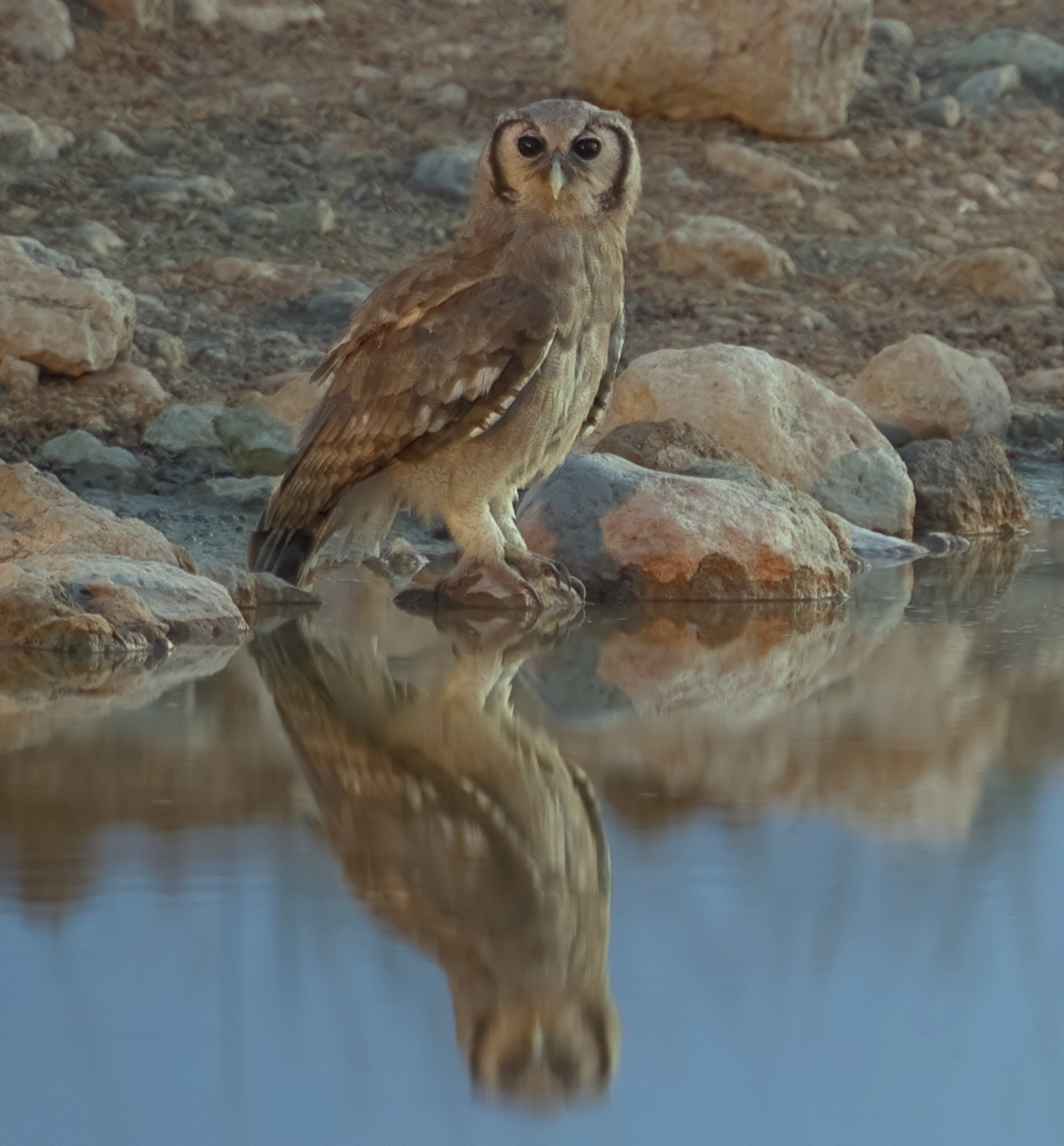
Wikipedia: Verreaux's eagle-owl
![]() Verreaux's eagle-owl (Bubo lacteus), also commonly known as the milky eagle owl or giant eagle owl,[2] is a member of the family Strigidae. This species is widespread in sub-Saharan Africa. A member of the genus Bubo, it is the largest African owl, measuring up to 66 cm (26 in) in total length. This eagle-owl is a resident primarily of dry, wooded savanna. Verreaux's eagle-owl is mainly grey in color and is distinguishable from other large owls by its bright pink eyelids, a feature shared with no other owl species in the world.[3]
[more]
Verreaux's eagle-owl (Bubo lacteus), also commonly known as the milky eagle owl or giant eagle owl,[2] is a member of the family Strigidae. This species is widespread in sub-Saharan Africa. A member of the genus Bubo, it is the largest African owl, measuring up to 66 cm (26 in) in total length. This eagle-owl is a resident primarily of dry, wooded savanna. Verreaux's eagle-owl is mainly grey in color and is distinguishable from other large owls by its bright pink eyelids, a feature shared with no other owl species in the world.[3]
[more]

Wikipedia: Spotted eagle-owl Source: OTHER
1200px-Spotted_eagle_owl_bubo_africanus.jpg
![]() The spotted eagle-owl (Bubo africanus; also known as the African spotted eagle-owl and the African eagle-owl) is a medium-sized species of owl, one of the smallest of the eagle owls. Its length is 45 centimetres (18 in) and its weight is from 454 to 907 grams (1.0 to 2.0 lb). It has a 100 to 140 centimetres (39 to 55 in) wingspan.[2] The facial disk is off white to pale ochre and the eyes are yellow. It has prominent ear tufts, and the upper body is dusky brown, the lower parts off-white with brown bars. Prior to 1999 the spotted eagle-owl was considered conspecific with the greyish eagle-owl, but now it is classed as a separate species.
[more]
The spotted eagle-owl (Bubo africanus; also known as the African spotted eagle-owl and the African eagle-owl) is a medium-sized species of owl, one of the smallest of the eagle owls. Its length is 45 centimetres (18 in) and its weight is from 454 to 907 grams (1.0 to 2.0 lb). It has a 100 to 140 centimetres (39 to 55 in) wingspan.[2] The facial disk is off white to pale ochre and the eyes are yellow. It has prominent ear tufts, and the upper body is dusky brown, the lower parts off-white with brown bars. Prior to 1999 the spotted eagle-owl was considered conspecific with the greyish eagle-owl, but now it is classed as a separate species.
[more]
Profile Wikipedia eBird Xeno-Canto

Wikipedia: African wood-owl Source: OTHER
1200px-African_Wood_Owl.jpg
![]() The African wood owl (Strix woodfordii) or Woodford's owl, is a typical owl from the genus Strix in the family Strigidae which is widespread in sub-Saharan Africa.
[more]
The African wood owl (Strix woodfordii) or Woodford's owl, is a typical owl from the genus Strix in the family Strigidae which is widespread in sub-Saharan Africa.
[more]

Wikipedia: Marsh owl Source: OTHER
1200px-Asio_capensis%2C_Tweeling%2C_a.jpg
![]() Medium-sized, dark brown with a pumpkin shaped head with small 'ear' tufts.[2] The facial disc is pale buff, with a distinct dark brown rim with buff speckles. There is a dark brown area around the eyes, which are also dark brown.[3] Its ear-tufts are earth-brown and quite small, often not visible, and set near the centre of the forehead.[3] The tail is dark brown, barred pale buff with a whitish tip. Tarsi are feathered pale tawny-buff and toes are covered with pale buffish plumes, leaving the dark brown tips bare. Claws are blackish.[3]
[more]
Medium-sized, dark brown with a pumpkin shaped head with small 'ear' tufts.[2] The facial disc is pale buff, with a distinct dark brown rim with buff speckles. There is a dark brown area around the eyes, which are also dark brown.[3] Its ear-tufts are earth-brown and quite small, often not visible, and set near the centre of the forehead.[3] The tail is dark brown, barred pale buff with a whitish tip. Tarsi are feathered pale tawny-buff and toes are covered with pale buffish plumes, leaving the dark brown tips bare. Claws are blackish.[3]
[more]
Profile Wikipedia eBird Xeno-Canto

Wikipedia: African scops-owl Source: OTHER
1200px-African-scops_owl_%28Otus_senegalensis%29_male.jpg
![]() The African scops owl (Otus senegalensis) is a small owl which is widespread in sub-Saharan Africa.
[more]
The African scops owl (Otus senegalensis) is a small owl which is widespread in sub-Saharan Africa.
[more]
Profile Wikipedia eBird Xeno-Canto

Wikipedia: Pearl-spotted owlet Source: OTHER
1200px-Pearl-spotted_owlet_%28Glaucidium_perlatum_diurnum%29.jpg
![]() The pearl-spotted owlet (Glaucidium perlatum) is an owl that breeds in Sub-Saharan Africa. This species is a part of the larger grouping of owls known as typical owls, Strigidae, which contains most species of owl. The other grouping is the barn owls, Tytonidae.
[more]
The pearl-spotted owlet (Glaucidium perlatum) is an owl that breeds in Sub-Saharan Africa. This species is a part of the larger grouping of owls known as typical owls, Strigidae, which contains most species of owl. The other grouping is the barn owls, Tytonidae.
[more]
Profile Wikipedia eBird Xeno-Canto

Wikipedia: African barred owlet Source: OTHER
1200px-Glaucidium_capense_-Kruger_National_Park%2C_South_Africa-8.jpg
![]() The African barred owlet (Glaucidium capense) is a species of small owl in the family Strigidae found in much of southern, central and eastern Africa. The taxon may be four species rather than a single species.
[more]
The African barred owlet (Glaucidium capense) is a species of small owl in the family Strigidae found in much of southern, central and eastern Africa. The taxon may be four species rather than a single species.
[more]
Profile Wikipedia eBird Xeno-Canto
Owl, perhaps southern white-faced owl. 2016-09-24 18.37.18 Botswana
First observed in Botswana on 2016-09-24.
![]() The southern white-faced owl (Ptilopsis granti) is a fairly small owl in the family Strigidae. It is native to the southern half of Africa. It was formerly regarded as a subspecies of the northern white-faced owl (P. leucopsis) but the two are now commonly treated as separate species.
[more]
The southern white-faced owl (Ptilopsis granti) is a fairly small owl in the family Strigidae. It is native to the southern half of Africa. It was formerly regarded as a subspecies of the northern white-faced owl (P. leucopsis) but the two are now commonly treated as separate species.
[more]

Wikipedia: Pel's fishing-owl Source: OTHER
Pel%27s_fishing_owl%2C_Scotopelia_pel.jpg
![]() Pel's fishing owl (Scotopelia peli) is a large species of owl in the family Strigidae. The species is found in Africa and lives near rivers and lakes. It feeds nocturnally on fish and frogs snatched from the surface of lakes and rivers. The species prefers slow moving rivers with large overhanging trees to roost and forage from.[2] It nests in hollows and the forks of large trees. Though as many as two eggs are laid, often only one chick is raised.
[more]
Pel's fishing owl (Scotopelia peli) is a large species of owl in the family Strigidae. The species is found in Africa and lives near rivers and lakes. It feeds nocturnally on fish and frogs snatched from the surface of lakes and rivers. The species prefers slow moving rivers with large overhanging trees to roost and forage from.[2] It nests in hollows and the forks of large trees. Though as many as two eggs are laid, often only one chick is raised.
[more]
Profile Wikipedia eBird Xeno-Canto

Wikipedia: African grass-owl Source: OTHER
Grass_Owl_adult.jpg
![]() The African grass owl (Tyto capensis) is a species of owl in the barn owl family, Tytonidae.
[more]
The African grass owl (Tyto capensis) is a species of owl in the barn owl family, Tytonidae.
[more]

Wikipedia: Barn owl Source: OTHER
1200px-Tyto_alba_-British_Wildlife_Centre%2C_Surrey%2C_England-8a_%281%29.jpg
This bird appears across the great seas in the following continents:
Europe, North America, South America, Africa, Asia.
![]() The barn owl (Tyto alba) is the most widely distributed species of owl in the world and one of the most widespread of all species of birds, being found almost everywhere in the world except for the polar and desert regions, Asia north of the Himalayas, most of Indonesia, and some Pacific Islands. It is also known as the common barn owl, to distinguish it from the other species in its family, Tytonidae, which forms one of the two main lineages of living owls, the other being the typical owls (Strigidae).
[more]
The barn owl (Tyto alba) is the most widely distributed species of owl in the world and one of the most widespread of all species of birds, being found almost everywhere in the world except for the polar and desert regions, Asia north of the Himalayas, most of Indonesia, and some Pacific Islands. It is also known as the common barn owl, to distinguish it from the other species in its family, Tytonidae, which forms one of the two main lineages of living owls, the other being the typical owls (Strigidae).
[more]
Vocalization: ![]() Large repertoire of mainly hissing and screeching sounds. [Link]
Large repertoire of mainly hissing and screeching sounds. [Link]
Song: ![]() Song consists of a single, drawn screech, lasting about a second and is often performed in flight. Starting in a very hoarse tone, then progressing with a rising pitch into a more burbling sound, before suddenly ending. [Link]
Song consists of a single, drawn screech, lasting about a second and is often performed in flight. Starting in a very hoarse tone, then progressing with a rising pitch into a more burbling sound, before suddenly ending. [Link]
Physical details: length=33-35 cm,
wingspan=80-95 cm,
weight=240-350 g
Habitats:
Agricultural

Wikipedia: Knysna turaco Source: OTHER
1200px-Knysna_Turacos.JPG
General: ![]() The Knysna turaco (Tauraco corythaix), or, in South Africa, Knysna loerie, is a large turaco, one of a group of African musophagidae birds. It is a resident breeder in the mature evergreen forests of southern and eastern South Africa, and Swaziland. It was formerly sometimes considered to be a subspecies of the green turaco of West Africa. The Livingstone's and Schalow's turacos were once considered subspecies.[2]
[more]
The Knysna turaco (Tauraco corythaix), or, in South Africa, Knysna loerie, is a large turaco, one of a group of African musophagidae birds. It is a resident breeder in the mature evergreen forests of southern and eastern South Africa, and Swaziland. It was formerly sometimes considered to be a subspecies of the green turaco of West Africa. The Livingstone's and Schalow's turacos were once considered subspecies.[2]
[more]
Gray loris, nicknamed the Go away bird for its call. 2016-09-23 17.46.16 Botswana
First observed in Botswana on 2016-09-23.
![]() The grey go-away-bird (Crinifer concolor), also known as grey lourie, grey loerie, or kwêvoël, is a bold and common bird of the southern Afrotropics. They are present in arid to moist, open woodlands and thorn savanna, especially near surface water.[2] They regularly form groups and parties that forage in tree tops, or dust bathe on the ground. Especially when disturbed, they make their presence known by their characteristically loud and nasal "kweh" or "go-way" calls,[3] with the last syllable typically a descending drawl.[4] Within range, their unique combination of appearance and habits precludes confusion with other bird species.
[more]
The grey go-away-bird (Crinifer concolor), also known as grey lourie, grey loerie, or kwêvoël, is a bold and common bird of the southern Afrotropics. They are present in arid to moist, open woodlands and thorn savanna, especially near surface water.[2] They regularly form groups and parties that forage in tree tops, or dust bathe on the ground. Especially when disturbed, they make their presence known by their characteristically loud and nasal "kweh" or "go-way" calls,[3] with the last syllable typically a descending drawl.[4] Within range, their unique combination of appearance and habits precludes confusion with other bird species.
[more]

Wikipedia: Purple-crested turaco Source: OTHER
1200px-Purple-crested_Turaco_%28Gallirex_porphyreolophus%29_%2832424422866%29.jpg
![]() The purple-crested turaco (Gallirex porphyreolophus) is a species of bird in the family Musophagidae. It is the National Bird of the Kingdom of Swaziland, and the crimson flight feathers of this and related turaco species are important in the ceremonial regalia of the Swazi royal family.
[more]
The purple-crested turaco (Gallirex porphyreolophus) is a species of bird in the family Musophagidae. It is the National Bird of the Kingdom of Swaziland, and the crimson flight feathers of this and related turaco species are important in the ceremonial regalia of the Swazi royal family.
[more]

Wikipedia: Narina trogon Source: OTHER
Narina_Trogon%2C_Apaloderma_narina_MALE_at_Lekgalameetse_Provincial_Reserve%2C_Limpopo%2C_South_Africa_%2814654439002%29.jpg
![]() The Narina trogon (Apaloderma narina) is a largely green and red, medium-sized (32–34 cm long), bird of the family Trogonidae. It is native to forests and woodlands of the Afrotropics. Though it is the most widespread and catholic in habitat choice of the three Apaloderma species, their numbers are locally depleted due to deforestation.[2] Some populations are sedentary while others undertake regular movements. The species name commemorates Narina, mistress of French ornithologist François Levaillant, whose name he derived from a Khoikhoi word for "flower",[3] as her given name was difficult to pronounce.
[more]
The Narina trogon (Apaloderma narina) is a largely green and red, medium-sized (32–34 cm long), bird of the family Trogonidae. It is native to forests and woodlands of the Afrotropics. Though it is the most widespread and catholic in habitat choice of the three Apaloderma species, their numbers are locally depleted due to deforestation.[2] Some populations are sedentary while others undertake regular movements. The species name commemorates Narina, mistress of French ornithologist François Levaillant, whose name he derived from a Khoikhoi word for "flower",[3] as her given name was difficult to pronounce.
[more]
Profile Wikipedia eBird Xeno-Canto
Southern yellow-billed hornbill. 2016-09-25 09.17.32 Botswana
First observed in Botswana on 2016-09-25.
![]() The southern yellow-billed hornbill (Tockus leucomelas) is a hornbill found in southern Africa. Yellow-billed hornbills feed mainly on the ground, where they forage for seeds, small insects, spiders and scorpions. This hornbill species is a common and widespread resident of dry thornveldt and broad-leafed woodlands. They can often be seen along roads and water courses.
[more]
The southern yellow-billed hornbill (Tockus leucomelas) is a hornbill found in southern Africa. Yellow-billed hornbills feed mainly on the ground, where they forage for seeds, small insects, spiders and scorpions. This hornbill species is a common and widespread resident of dry thornveldt and broad-leafed woodlands. They can often be seen along roads and water courses.
[more]

Wikipedia: Southern red-billed hornbill Source: OTHER
1200px-Southern_red-billed_hornbill_%28Tockus_rufirostris%29_male.jpg
![]() The southern red-billed hornbill (Tockus rufirostris) is a species of hornbill in the family Bucerotidae, which is native to the savannas and dryer bushlands of southern Africa. It is replaced by a near-relative, the Damara red-billed hornbill, in the arid woodlands of western Namibia. All five red-billed hornbills were formerly considered conspecific.
[more]
The southern red-billed hornbill (Tockus rufirostris) is a species of hornbill in the family Bucerotidae, which is native to the savannas and dryer bushlands of southern Africa. It is replaced by a near-relative, the Damara red-billed hornbill, in the arid woodlands of western Namibia. All five red-billed hornbills were formerly considered conspecific.
[more]

Wikipedia: Trumpeter hornbill Source: OTHER
1200px-Bycanistes_bucinator_-Lowry_Park_Zoo%2C_Tampa%2C_Florida%2C_USA-8a.jpg
![]() The trumpeter hornbill (Bycanistes bucinator) is a medium-sized hornbill, with length between 58 and 65 cm (23 and 26 in), characterized by a large grey casque on the bill, smaller in females. The eyes are brown or red, with pink surrounding skin. Body mass is between 0.45 and 1 kg (0.99 and 2.20 lb).[2] It is similar to silvery-cheeked hornbill. Distinguishing features include an all-black back, white belly and white underwing coverts (in flight, wings present white tips), and red facial skin.
[more]
The trumpeter hornbill (Bycanistes bucinator) is a medium-sized hornbill, with length between 58 and 65 cm (23 and 26 in), characterized by a large grey casque on the bill, smaller in females. The eyes are brown or red, with pink surrounding skin. Body mass is between 0.45 and 1 kg (0.99 and 2.20 lb).[2] It is similar to silvery-cheeked hornbill. Distinguishing features include an all-black back, white belly and white underwing coverts (in flight, wings present white tips), and red facial skin.
[more]
Southern ground hornbill. 2016-09-26 07.39.52 Botswana
First observed in Botswana on 2016-09-26.
![]() The southern ground hornbill (Bucorvus leadbeateri; formerly known as Bucorvus cafer), is one of two species of ground hornbill, which are both found solely within Africa, and is the largest species of hornbill worldwide. It can be found in the southern regions of Africa, ranging from Kenya to South Africa.[2] Within these regions, they inhabit both woodlands and savannas.[3] The other species of the genus Bucorvus found in Africa is the Abyssinian ground hornbill, B. abyssinicus.
[more]
The southern ground hornbill (Bucorvus leadbeateri; formerly known as Bucorvus cafer), is one of two species of ground hornbill, which are both found solely within Africa, and is the largest species of hornbill worldwide. It can be found in the southern regions of Africa, ranging from Kenya to South Africa.[2] Within these regions, they inhabit both woodlands and savannas.[3] The other species of the genus Bucorvus found in Africa is the Abyssinian ground hornbill, B. abyssinicus.
[more]
Profile Wikipedia eBird Xeno-Canto

Wikipedia: Speckled mousebird Source: OTHER
1200px-Colius_striatus_-_W%C3%BCstenhaus.jpg
![]() The speckled mousebird (Colius striatus) is the largest species of mousebird, as well as one of the most common. It is found throughout most of Central, Eastern and Southern Africa.
[more]
The speckled mousebird (Colius striatus) is the largest species of mousebird, as well as one of the most common. It is found throughout most of Central, Eastern and Southern Africa.
[more]
Profile Wikipedia eBird Xeno-Canto

Wikipedia: White-backed mousebird Source: OTHER
Colius_White-backed_mousebird_feeding_on_Duranta_berries_9860s.jpg
![]() The white-backed mousebird (Colius colius) is a large species of mousebird. It is distributed in western and central regions of southern Africa from Namibia and southern Botswana eastwards to Central Transvaal and the eastern Cape.
[more]
The white-backed mousebird (Colius colius) is a large species of mousebird. It is distributed in western and central regions of southern Africa from Namibia and southern Botswana eastwards to Central Transvaal and the eastern Cape.
[more]

Wikipedia: Red-faced mousebird Source: OTHER
1200px-Red-faced_Mousebird_%28Urocolius_indicus%29_hanging_in_tree%2C_front_view.jpg
![]() The red-faced mousebird (Urocolius indicus) is a species of mousebird or coly. It is a common in southern Africa from Zaire, Zambia and Tanzania south to the Cape. Its habitat is savanna with thickets, fynbos scrub, other open woodland, gardens and orchards.[2]
[more]
The red-faced mousebird (Urocolius indicus) is a species of mousebird or coly. It is a common in southern Africa from Zaire, Zambia and Tanzania south to the Cape. Its habitat is savanna with thickets, fynbos scrub, other open woodland, gardens and orchards.[2]
[more]
Profile Wikipedia eBird Xeno-Canto

Wikipedia: Green woodhoopoe Source: OTHER
1200px-Green_wood_hoopoe_%28Phoeniculus_purpureus_angolensis%29.jpg
![]() The green wood hoopoe (Phoeniculus purpureus) is a large, up to 44 cm (17 in) long, near-passerine tropical bird native to Africa. It is a member of the family Phoeniculidae, the wood hoopoes, and was formerly known as the red-billed wood hoopoe.
[more]
The green wood hoopoe (Phoeniculus purpureus) is a large, up to 44 cm (17 in) long, near-passerine tropical bird native to Africa. It is a member of the family Phoeniculidae, the wood hoopoes, and was formerly known as the red-billed wood hoopoe.
[more]
Probably a cormorant, as these have a light belly when immature and have no yellow on the bill like the shag. 2022-04-12 14.28.50 Mallorca
First observed in Mallorca on 2022-04-12.
![]() The common scimitarbill (Rhinopomastus cyanomelas) is a species of bird in the family Phoeniculidae.
It is found in Angola, Botswana, Burundi, Democratic Republic of the Congo, Kenya, Malawi, Mozambique, Namibia, Rwanda, Somalia, South Africa, Swaziland, Tanzania, Uganda, Zambia, and Zimbabwe.
[more]
The common scimitarbill (Rhinopomastus cyanomelas) is a species of bird in the family Phoeniculidae.
It is found in Angola, Botswana, Burundi, Democratic Republic of the Congo, Kenya, Malawi, Mozambique, Namibia, Rwanda, Somalia, South Africa, Swaziland, Tanzania, Uganda, Zambia, and Zimbabwe.
[more]
Song:
Automatically generated from Xeno-Canto recording
Song attributes:
Frequency:
♫ Bill laeuft Richtung Singdrossel bei der Waldhuette in Fehraltorf. ![]() Source: Zoom H6 2023-02-22 17.02.58 Forsthaus (song)
Source: Zoom H6 2023-02-22 17.02.58 Forsthaus (song)
Profile Wikipedia eBird Xeno-Canto NABU

Wikipedia: Helmeted guineafowl Source: OTHER
1200px-Numida_meleagris_-Serengeti_National_Park%2C_Tanzania-8_%281%29.jpg
![]() Phasianus meleagris Linnaeus, 1758
[more]
Phasianus meleagris Linnaeus, 1758
[more]
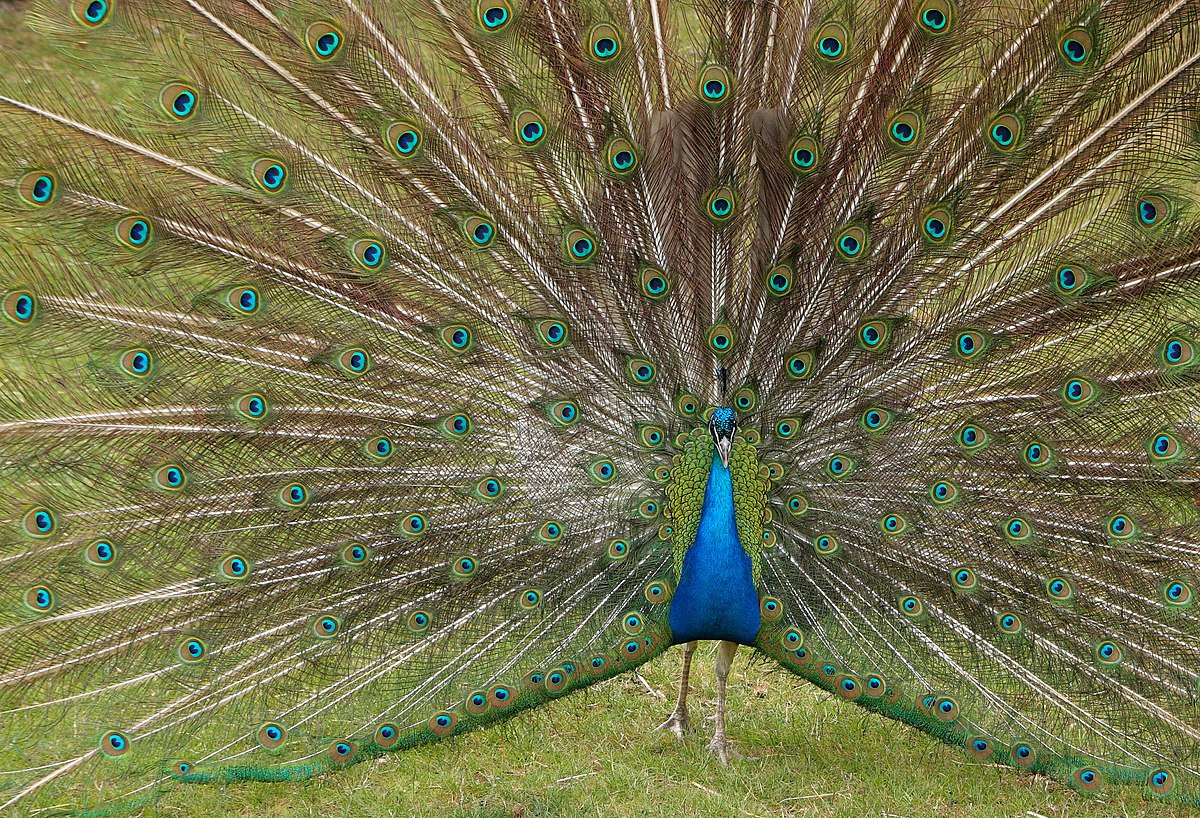
Wikipedia: Indian peafowl Source: OTHER
1200px-Peacock%2C_East_Park%2C_Hull_-_panoramio.jpg
This bird appears across the great seas in the following continents:
North America, Africa.
![]() The Indian peafowl (Pavo cristatus), also known as the common peafowl, and blue peafowl, is a peafowl species native to the Indian subcontinent. It has been introduced to many other countries.
[more]
The Indian peafowl (Pavo cristatus), also known as the common peafowl, and blue peafowl, is a peafowl species native to the Indian subcontinent. It has been introduced to many other countries.
[more]

Wikipedia: Chukar partridge Source: OTHER
Alectoris-chukar-001.jpg
This bird appears across the great seas in the following continents:
Europe, North America, Africa.
![]() The chukar partridge (Alectoris chukar), or simply chukar, is a Palearctic upland gamebird in the pheasant family Phasianidae. It has been considered to form a superspecies complex along with the rock partridge, Philby's partridge and Przevalski's partridge and treated in the past as conspecific particularly with the first. This partridge has well marked black and white bars on the flanks and a black band running from the forehead across the eye and running down the head to form a necklace that encloses a white throat. Native to Asia, the species has been introduced into many other places and feral populations have established themselves in parts of North America and New Zealand. This bird can be found in parts of the Middle East and temperate Asia.
[more]
The chukar partridge (Alectoris chukar), or simply chukar, is a Palearctic upland gamebird in the pheasant family Phasianidae. It has been considered to form a superspecies complex along with the rock partridge, Philby's partridge and Przevalski's partridge and treated in the past as conspecific particularly with the first. This partridge has well marked black and white bars on the flanks and a black band running from the forehead across the eye and running down the head to form a necklace that encloses a white throat. Native to Asia, the species has been introduced into many other places and feral populations have established themselves in parts of North America and New Zealand. This bird can be found in parts of the Middle East and temperate Asia.
[more]
Profile Wikipedia eBird Xeno-Canto

Wikipedia: Harlequin quail Source: OTHER
1200px-Harlequin_Quail_%28Coturnix_delegorguei%29_%286035291347%29.jpg
![]() The harlequin quail (Coturnix delegorguei) is a species of bird in the family Phasianidae. It occurs in Africa and in the Arabian Peninsula.[4] The species is named after the collector, Adulphe Delegorgue.
[more]
The harlequin quail (Coturnix delegorguei) is a species of bird in the family Phasianidae. It occurs in Africa and in the Arabian Peninsula.[4] The species is named after the collector, Adulphe Delegorgue.
[more]
Profile Wikipedia eBird Vogelwarte BirdLife ZH ornitho.ch bird-song.ch Xeno-Canto BirdID NABU

Wikipedia: Common quail Source: OTHER
1200px-A_common_quail_in_Lebanon.jpg
![]() The common quail (Coturnix coturnix), or European quail, is a small ground-nesting game bird in the pheasant family Phasianidae. It is mainly migratory, breeding in the western Palearctic and wintering in Africa and southern India.
[more]
The common quail (Coturnix coturnix), or European quail, is a small ground-nesting game bird in the pheasant family Phasianidae. It is mainly migratory, breeding in the western Palearctic and wintering in Africa and southern India.
[more]
Vocalization: ![]() Other sounds: A nasal disyllabic mewing "mau-au", and a wader-like rolling "wreee". [Link]
Other sounds: A nasal disyllabic mewing "mau-au", and a wader-like rolling "wreee". [Link]
Song: ![]() Song a very characteristic, short, tri-syllabic whistling, with each syllable ending with a sharp rise in pitch "weet weet-weet". The two last syllable linked together. [Link]
Song a very characteristic, short, tri-syllabic whistling, with each syllable ending with a sharp rise in pitch "weet weet-weet". The two last syllable linked together. [Link]
Physical details: length=16-18 cm,
wingspan=32-35 cm,
weight=75-135 g
Habitats:
Agricultural

Wikipedia: Crested francolin Source: OTHER
1200px-Crested_Francolin_RWD.jpg
General: ![]() The crested francolin (Dendroperdix sephaena) is a bird species in the family Phasianidae.
It is found in Angola, Botswana, Democratic Republic of the Congo, Eswatini, Ethiopia, Kenya, Malawi, Mozambique, Namibia, Somalia, South Africa, South Sudan, Tanzania, Uganda, Zambia, and Zimbabwe. One of its subspecies, Dendroperdix sephaena rovuma, is sometimes considered a separate species, Kirk's francolin.
[more]
The crested francolin (Dendroperdix sephaena) is a bird species in the family Phasianidae.
It is found in Angola, Botswana, Democratic Republic of the Congo, Eswatini, Ethiopia, Kenya, Malawi, Mozambique, Namibia, Somalia, South Africa, South Sudan, Tanzania, Uganda, Zambia, and Zimbabwe. One of its subspecies, Dendroperdix sephaena rovuma, is sometimes considered a separate species, Kirk's francolin.
[more]

Wikipedia: Coqui francolin Source: OTHER
1200px-CoquiFrancolin_MasaiMara.jpg
![]() The Coqui francolin (Peliperdix coqui) is a species of bird in the family Phasianidae.
[more]
The Coqui francolin (Peliperdix coqui) is a species of bird in the family Phasianidae.
[more]

Wikipedia: Shelley's francolin Source: OTHER
FrancolinusShelleyiKeulemans.jpg
![]() Shelley's francolin (Scleroptila shelleyi) is a species of bird in the family Phasianidae. The species is named after Sir Edward Shelley, cousin of George Ernest Shelley.
[more]
Shelley's francolin (Scleroptila shelleyi) is a species of bird in the family Phasianidae. The species is named after Sir Edward Shelley, cousin of George Ernest Shelley.
[more]

Wikipedia: Grey-winged francolin Source: OTHER
Bergpatrys_%28Scleroptila_afra%29_in_KwaZulu-Natal%2C_Francesco_Veronesi.jpg
![]() The grey-winged francolin (Scleroptila afra) is a species of bird in the family Phasianidae.
It is found in Lesotho and South Africa.
[more]
The grey-winged francolin (Scleroptila afra) is a species of bird in the family Phasianidae.
It is found in Lesotho and South Africa.
[more]

Wikipedia: Red-winged francolin Source: OTHER
Red-winged_Francolin_%28Francolinus_levaillantii%29_from_side%2C_b.jpg
![]() The red-winged francolin (Scleroptila levaillantii) is a species of bird in the family Phasianidae. It is found in Angola, Burundi, Democratic Republic of the Congo, Kenya, Lesotho, Malawi, Rwanda, South Africa, Swaziland, Tanzania, Uganda, and Zambia.
[more]
The red-winged francolin (Scleroptila levaillantii) is a species of bird in the family Phasianidae. It is found in Angola, Burundi, Democratic Republic of the Congo, Kenya, Lesotho, Malawi, Rwanda, South Africa, Swaziland, Tanzania, Uganda, and Zambia.
[more]

Wikipedia: Red-necked spurfowl Source: OTHER
1200px-Red-necked_spurfowl_%28Pternistis_afer_cranchii%29%2C_crop.jpg
![]() The red-necked spurfowl or red-necked francolin (Pternistis afer), is a gamebird in the pheasant family Phasianidae that is a resident species in southern Africa.
[more]
The red-necked spurfowl or red-necked francolin (Pternistis afer), is a gamebird in the pheasant family Phasianidae that is a resident species in southern Africa.
[more]

Wikipedia: Red-billed francolin
![]() The red-billed spurfowl (Pternistis adspersus), also known as the red-billed francolin, is a species of bird in the family Phasianidae. It is found in Southern Africa, including Angola, Botswana, Namibia, South Africa, Zambia, and Zimbabwe.
[more]
The red-billed spurfowl (Pternistis adspersus), also known as the red-billed francolin, is a species of bird in the family Phasianidae. It is found in Southern Africa, including Angola, Botswana, Namibia, South Africa, Zambia, and Zimbabwe.
[more]

Wikipedia: Natal francolin Source: OTHER
1200px-Natal_Spurfowl_%28Pternistes_natalensis%29_%286041759562%29.jpg
![]() The Natal spurfowl or Natal francolin (Pternistis natalensis) is a species of bird in the family Phasianidae.
It is found in Botswana, Eswatini, Mozambique, South Africa, Zambia, and Zimbabwe.
[more]
The Natal spurfowl or Natal francolin (Pternistis natalensis) is a species of bird in the family Phasianidae.
It is found in Botswana, Eswatini, Mozambique, South Africa, Zambia, and Zimbabwe.
[more]

Wikipedia: Cape francolin Source: OTHER
Francolinus_capensis_-Kirstenbosch_National_Botanical_Garden%2C_South_Africa-8%2C_crop.jpg
![]() The Cape spurfowl or Cape francolin (Pternistis capensis) is a gamebird in the pheasant family Phasianidae. It is endemic to southern Africa, where it is the largest francolin. It occurs in the Western Cape province of South Africa, and locally northwards to southern Namibia. It has adapted to alien vegetation and a variety of human-altered habitats, but scrubby roosting and nesting space is a prerequisite.[2] The species is not threatened.
[more]
The Cape spurfowl or Cape francolin (Pternistis capensis) is a gamebird in the pheasant family Phasianidae. It is endemic to southern Africa, where it is the largest francolin. It occurs in the Western Cape province of South Africa, and locally northwards to southern Namibia. It has adapted to alien vegetation and a variety of human-altered habitats, but scrubby roosting and nesting space is a prerequisite.[2] The species is not threatened.
[more]

Wikipedia: Swainson's spurfowl Source: OTHER
1200px-Swainson%27s_Spurfowl_%28Pternistes_swainsonii%29_%286041396322%29.jpg
![]() Swainson's spurfowl or Swainson's francolin (Pternistis swainsonii) is a species of bird in the family Phasianidae.
It is found in Angola, Botswana, Lesotho, Malawi, Mozambique, Namibia, South Africa, Swaziland, Zambia, and Zimbabwe. In the Shona language in Zimbabwe, this bird is called the chikwari and is considered a delicacy by outdoor and hunting enthusiasts.
[more]
Swainson's spurfowl or Swainson's francolin (Pternistis swainsonii) is a species of bird in the family Phasianidae.
It is found in Angola, Botswana, Lesotho, Malawi, Mozambique, Namibia, South Africa, Swaziland, Zambia, and Zimbabwe. In the Shona language in Zimbabwe, this bird is called the chikwari and is considered a delicacy by outdoor and hunting enthusiasts.
[more]

Wikipedia: Little swift Source: OTHER
House_swift_I_IMG_3260.jpg
![]() The little swift (Apus affinis), is a small species of swift found in Africa and southwestern Asia, and are vagrants and local breeders in southern Europe. They are found both in urban areas and at rocky cliffs where they build nests in a way typical of all members of the order Apodiformes. The genus name Apus is Latin for a swift, thought by the ancients to be a type of swallow without feet (from Ancient Greek α, a, "without", and πούς, pous, "foot"). The Latin specific affinis means similar to or related to, but in this case the species that the little swift supposedly resembles is not clear from the description.[3] A population formerly considered to be an eastern subspecies of little swift is now separated as a distinct species, the house swift (Apus nipalensis).
[more]
The little swift (Apus affinis), is a small species of swift found in Africa and southwestern Asia, and are vagrants and local breeders in southern Europe. They are found both in urban areas and at rocky cliffs where they build nests in a way typical of all members of the order Apodiformes. The genus name Apus is Latin for a swift, thought by the ancients to be a type of swallow without feet (from Ancient Greek α, a, "without", and πούς, pous, "foot"). The Latin specific affinis means similar to or related to, but in this case the species that the little swift supposedly resembles is not clear from the description.[3] A population formerly considered to be an eastern subspecies of little swift is now separated as a distinct species, the house swift (Apus nipalensis).
[more]

Wikipedia: African swift Source: OTHER
ApusBarbatus_TrevorHardaker1.jpg
![]() The African black swift (Apus barbatus), also known as the African swift or black swift, is a medium-sized bird in the swift family. It breeds in Africa discontinuously from Liberia, Cameroon, Zaire, Uganda and Kenya southwards to South Africa. The "black swifts" of Madagascar and the Comoros are either taken as two subspecies of the African black swift, or otherwise deemed a full species, the Malagasy black swift.
[more]
The African black swift (Apus barbatus), also known as the African swift or black swift, is a medium-sized bird in the swift family. It breeds in Africa discontinuously from Liberia, Cameroon, Zaire, Uganda and Kenya southwards to South Africa. The "black swifts" of Madagascar and the Comoros are either taken as two subspecies of the African black swift, or otherwise deemed a full species, the Malagasy black swift.
[more]
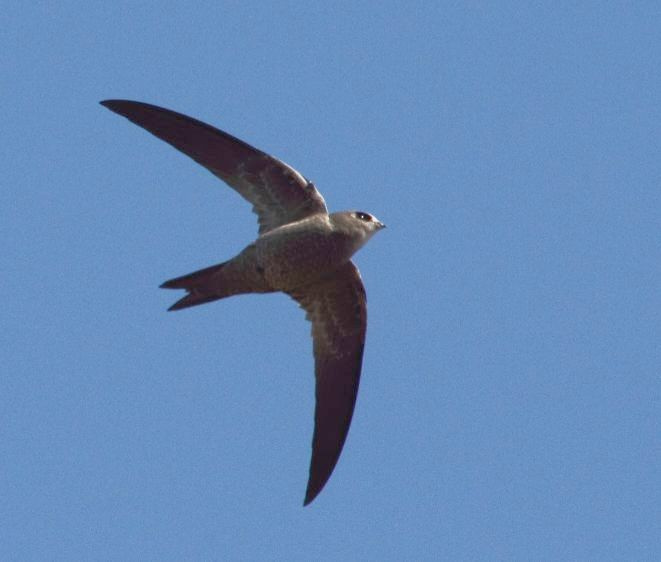
Wikipedia: Bradfield's swift Source: OTHER
Apus_bradfieldi_-Pofadder%2C_Northern_Cape%2C_South_Africa_-flying-8.jpg
![]() Bradfield's swift (Apus bradfieldi) is a species of swift in the family Apodidae.
[more]
Bradfield's swift (Apus bradfieldi) is a species of swift in the family Apodidae.
[more]

Wikipedia: White-rumped swift Source: OTHER
Swift_White-rumped_2015_12_18_07_36_42_1782.jpg
![]() The white-rumped swift (Apus caffer) is a species of swift. Although this small bird is superficially similar to a house martin, it is not closely related to that passerine species. The resemblances between the swallows and swifts are due to convergent evolution reflecting similar life styles.
[more]
The white-rumped swift (Apus caffer) is a species of swift. Although this small bird is superficially similar to a house martin, it is not closely related to that passerine species. The resemblances between the swallows and swifts are due to convergent evolution reflecting similar life styles.
[more]

Wikipedia: Horus swift Source: OTHER
ApusHorus_RobertWienand.jpg
![]() The Horus swift (Apus horus) is a small bird in the swift family. It breeds in sub-Saharan Africa. It has an extensive continuous distribution from eastern and southern South Africa north to southern Zambia and central Mozambique, and has recently colonised the De Hoop Nature Reserve area of the Western Cape.
[more]
The Horus swift (Apus horus) is a small bird in the swift family. It breeds in sub-Saharan Africa. It has an extensive continuous distribution from eastern and southern South Africa north to southern Zambia and central Mozambique, and has recently colonised the De Hoop Nature Reserve area of the Western Cape.
[more]
Profile Wikipedia eBird Xeno-Canto

Wikipedia: African palm-swift Source: OTHER
African_Palm_Swift_in_flight.jpg
![]() The African palm swift (Cypsiurus parvus) is a small swift. It is very similar to the Asian palm swift, Cypsiurus balasiensis, and was formerly considered to be the same species. The Malagasy palm swift was also recently split from this species. This is a common species with a very wide distribution which faces no obvious threats and may be increasing in numbers as a result of the cultivation of the exotic Washington palm, so the International Union for Conservation of Nature has rated its conservation status as being of "least concern".[1]
[more]
The African palm swift (Cypsiurus parvus) is a small swift. It is very similar to the Asian palm swift, Cypsiurus balasiensis, and was formerly considered to be the same species. The Malagasy palm swift was also recently split from this species. This is a common species with a very wide distribution which faces no obvious threats and may be increasing in numbers as a result of the cultivation of the exotic Washington palm, so the International Union for Conservation of Nature has rated its conservation status as being of "least concern".[1]
[more]
Profile Wikipedia eBird Xeno-Canto
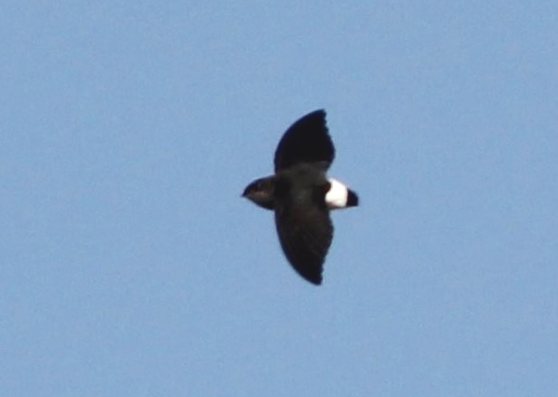
Wikipedia: Bat-like spinetail Source: OTHER
Neafrapus_boehmi_subsp_sheppardi%2C_Panda%2C_Birding_Weto%2C_a.jpg
![]() Böhm's spinetail (Neafrapus boehmi), also known as the bat-like spinetail, is a species of swift in the family Apodidae.
[more]
Böhm's spinetail (Neafrapus boehmi), also known as the bat-like spinetail, is a species of swift in the family Apodidae.
[more]

Wikipedia: Alpine swift Source: OTHER
1200px-%CE%92%CE%BF%CF%85%CE%BD%CE%BF%CF%83%CF%84%CE%B1%CF%87%CF%84%CE%AC%CF%81%CE%B1_Alpine_Swift_Tachymarptis_melba.jpg
First observed in 🇨🇭 on 2020-06-20.
![]() The Alpine swift (Tachymarptis melba) formerly Apus melba, is a species of swift. The genus name is from the Ancient Greek takhus, "fast", and marptis, "seizer". The specific name melba comes from ‘melano-alba’ or ‘mel-alba’; Eigenhuis & Swaab (1992) posited that ‘melba’ might be a short form for ‘melano-alba’ or ‘mel-alba’ (Gr. melas, melanos = black; L. albus = white). Linnaeus certainly referred to these two colors in his diagnosis.[2]
[more]
The Alpine swift (Tachymarptis melba) formerly Apus melba, is a species of swift. The genus name is from the Ancient Greek takhus, "fast", and marptis, "seizer". The specific name melba comes from ‘melano-alba’ or ‘mel-alba’; Eigenhuis & Swaab (1992) posited that ‘melba’ might be a short form for ‘melano-alba’ or ‘mel-alba’ (Gr. melas, melanos = black; L. albus = white). Linnaeus certainly referred to these two colors in his diagnosis.[2]
[more]
Habitats:
Settlement
Song:
Automatically generated from Xeno-Canto recording
Song attributes:
Frequency:
♫ Source: BirdNet
20200620_121816 birdnet 688 - Alpine swift.mp3
2020-06-20 12.18.16 Luppmen (song)
Profile Wikipedia eBird Xeno-Canto

Wikipedia: Pennant-winged nightjar Source: OTHER
1200px-The_American_Museum_journal_%28c1900-%281918%29%29_%2817974546639%29.jpg
![]() The pennant-winged nightjar (Caprimulgus vexillarius) is a species of nightjar that occurs from Nigeria to northern South Africa. It is an intra-African migrant and displays remarkable sexual dimorphism in the breeding season.
[more]
The pennant-winged nightjar (Caprimulgus vexillarius) is a species of nightjar that occurs from Nigeria to northern South Africa. It is an intra-African migrant and displays remarkable sexual dimorphism in the breeding season.
[more]
Profile Wikipedia eBird Xeno-Canto

Wikipedia: Fiery-necked nightjar Source: OTHER
Caprimulgus_pectoralis%2C_Limpopo_Prov%2C_Maguire.jpg
![]() The fiery-necked nightjar (Caprimulgus pectoralis) is a species of nightjar in the family Caprimulgidae, which occurs in Africa south of the equator. Its distinctive and frequently uttered call is rendered as 'good-lord-deliver-us'. It is replaced in the tropics by a near relative, the black-shouldered nightjar. In addition to the latter, it forms a species complex with the Montane and Ruwenzori nightjars.[2]
[more]
The fiery-necked nightjar (Caprimulgus pectoralis) is a species of nightjar in the family Caprimulgidae, which occurs in Africa south of the equator. Its distinctive and frequently uttered call is rendered as 'good-lord-deliver-us'. It is replaced in the tropics by a near relative, the black-shouldered nightjar. In addition to the latter, it forms a species complex with the Montane and Ruwenzori nightjars.[2]
[more]
Profile Wikipedia eBird Xeno-Canto
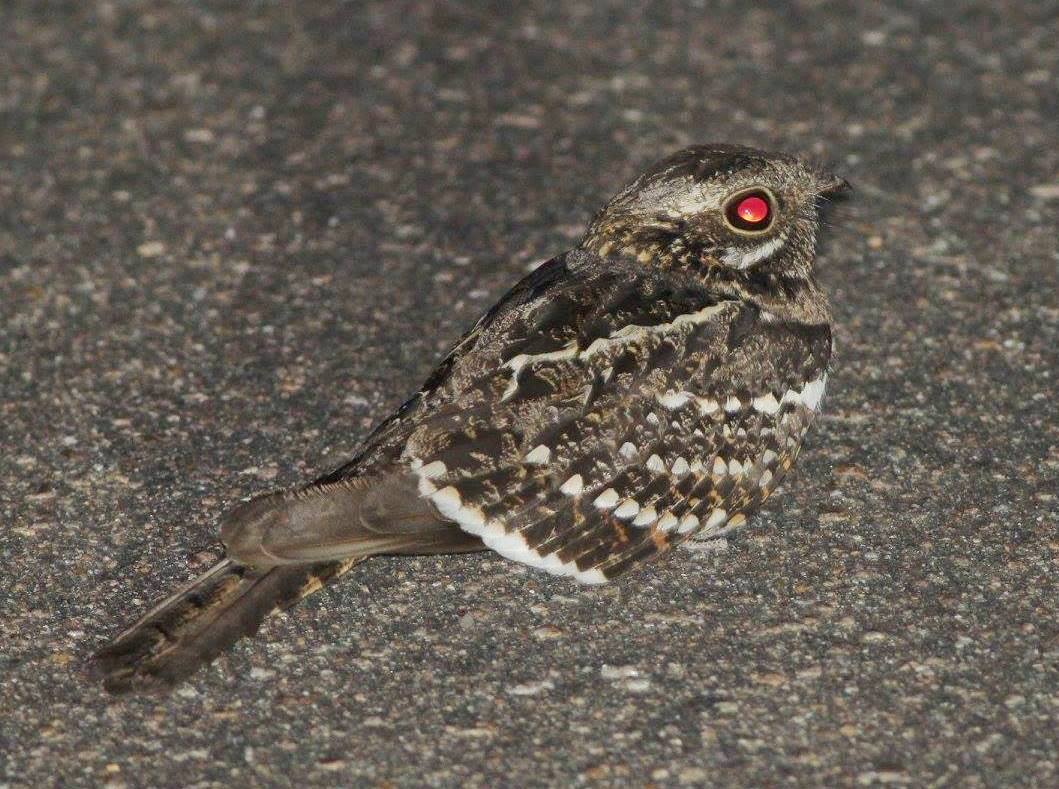
Wikipedia: Square-tailed nightjar Source: OTHER
Caprimulgus_fossii_subsp_mossambicus%2C_Pretoriuskop%2C_Birding_Weto%2C_a.jpg
![]() The square-tailed nightjar (Caprimulgus fossii) is a species of nightjar in the family Caprimulgidae which is native to tropical and subtropical woodlands of the Afrotropics. It has an extensive range south of the African equator. Despite not having a completely "square tail", its naming highlights a distinguishing field mark. The similarly plumaged slender-tailed nightjar, found in dry bush country of the tropics, differs namely by its protruding central tail feathers. It is alternatively known as the Gabon nightjar or Mozambique nightjar.
[more]
The square-tailed nightjar (Caprimulgus fossii) is a species of nightjar in the family Caprimulgidae which is native to tropical and subtropical woodlands of the Afrotropics. It has an extensive range south of the African equator. Despite not having a completely "square tail", its naming highlights a distinguishing field mark. The similarly plumaged slender-tailed nightjar, found in dry bush country of the tropics, differs namely by its protruding central tail feathers. It is alternatively known as the Gabon nightjar or Mozambique nightjar.
[more]
Profile Wikipedia eBird Xeno-Canto

Wikipedia: Rufous-cheeked nightjar Source: OTHER
1200px-Caprimulgus_rufigena_1838.jpg
![]() The rufous-cheeked nightjar (Caprimulgus rufigena) is a species of nightjar in the family Caprimulgidae. It is an intra-African migrant that breeds in the south of its range. It spends the non-breeding season in eastern Nigeria, Cameroon, southern Chad and Sudan, the Republic of the Congo, the D.R.C. and western Central African Republic. During the southern hemisphere summer it is found in Angola, Botswana, Mozambique, Namibia, South Africa, Zambia and Zimbabwe.
[more]
The rufous-cheeked nightjar (Caprimulgus rufigena) is a species of nightjar in the family Caprimulgidae. It is an intra-African migrant that breeds in the south of its range. It spends the non-breeding season in eastern Nigeria, Cameroon, southern Chad and Sudan, the Republic of the Congo, the D.R.C. and western Central African Republic. During the southern hemisphere summer it is found in Angola, Botswana, Mozambique, Namibia, South Africa, Zambia and Zimbabwe.
[more]
Profile Wikipedia eBird Xeno-Canto

Wikipedia: Freckled nightjar Source: OTHER
1200px-Freckled_nightjar_%28Caprimulgus_tristigma%29_male.jpg
![]() The freckled nightjar (Caprimulgus tristigma) is a species of nightjar in the family Caprimulgidae. It has a wide yet patchy distribution throughout the Afrotropics.
[more]
The freckled nightjar (Caprimulgus tristigma) is a species of nightjar in the family Caprimulgidae. It has a wide yet patchy distribution throughout the Afrotropics.
[more]
Profile Wikipedia eBird Xeno-Canto

Wikipedia: Swamp nightjar Source: OTHER
1200px-CaprimulgusAccraeGronvold.jpg
![]() The swamp nightjar (Caprimulgus natalensis) is a crepuscular and nocturnal bird in the nightjar family found in Africa.
[more]
The swamp nightjar (Caprimulgus natalensis) is a crepuscular and nocturnal bird in the nightjar family found in Africa.
[more]
Classification errors:
Blue crane / Paradieskranich (Anthropoides paradiseus)
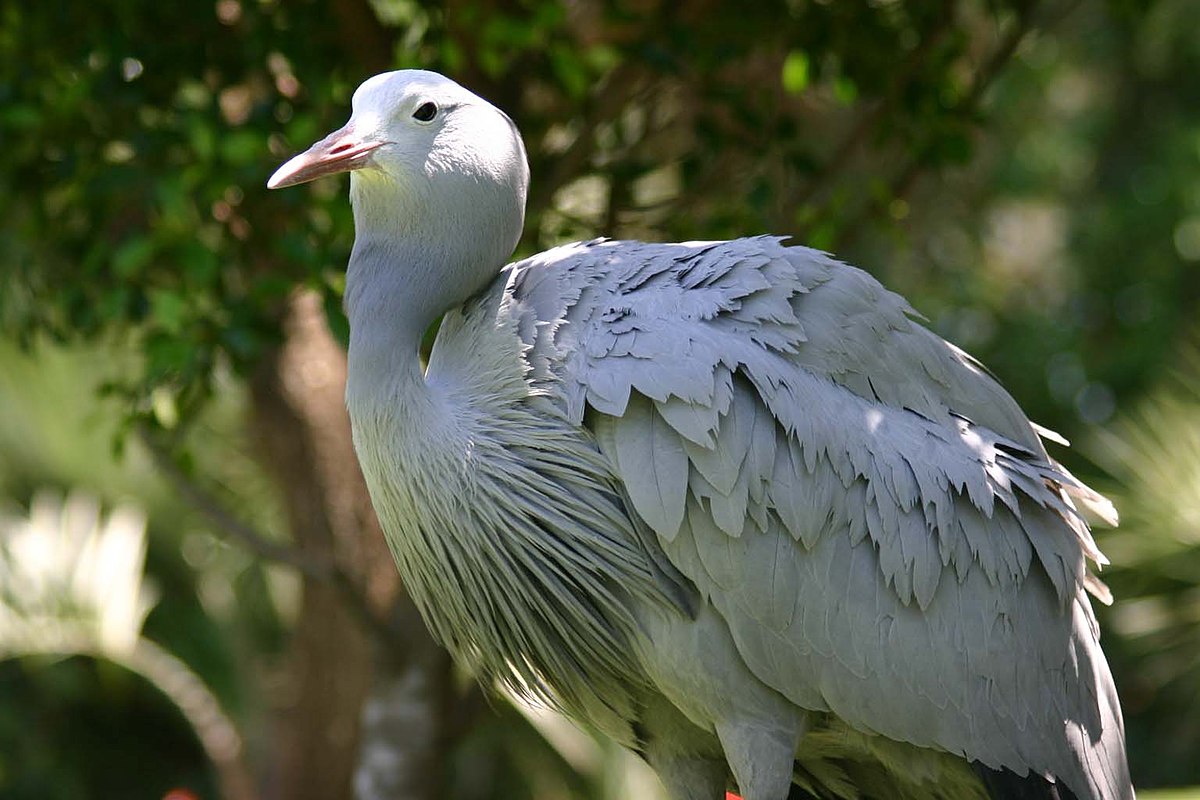
Wikipedia: Blue crane Source: OTHER
1200px-Blue_Crane_South_Africa.jpg
![]() The blue crane (Grus paradisea), also known as the Stanley crane and the paradise crane, is the national bird of South Africa. The species is listed as Vulnerable by the IUCN.
[more]
The blue crane (Grus paradisea), also known as the Stanley crane and the paradise crane, is the national bird of South Africa. The species is listed as Vulnerable by the IUCN.
[more]